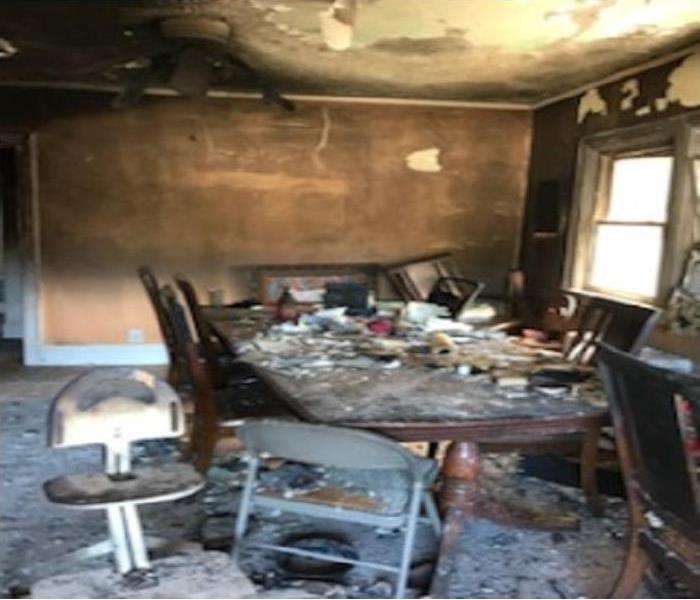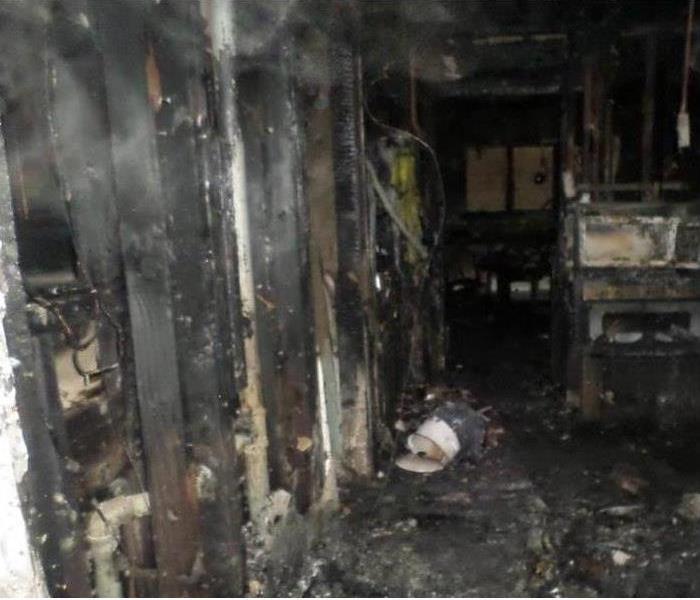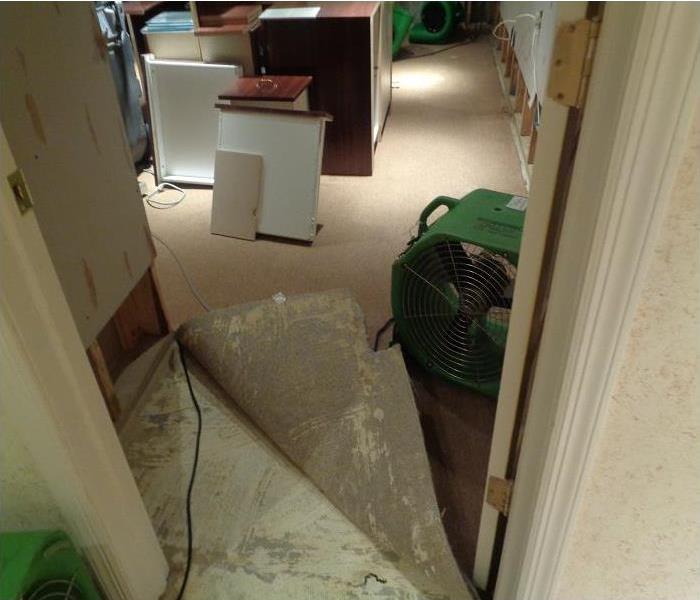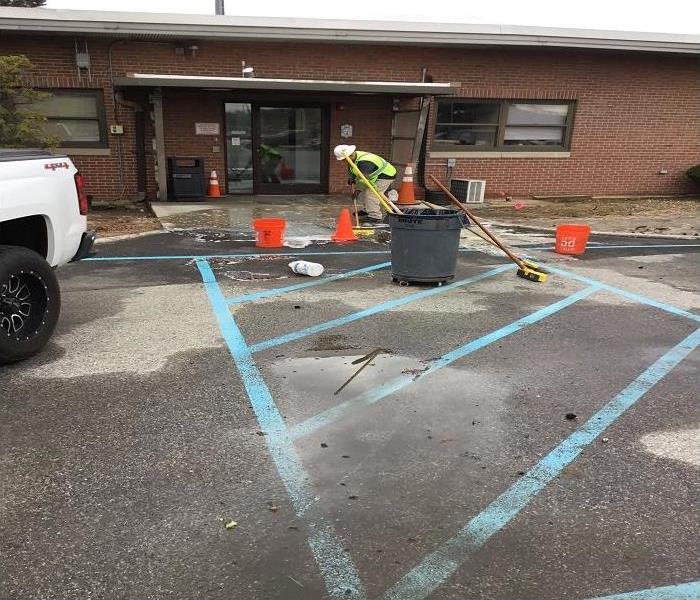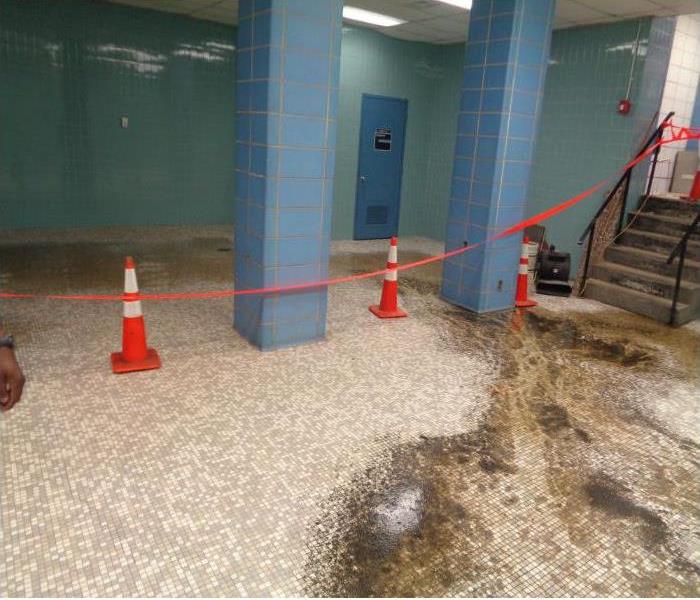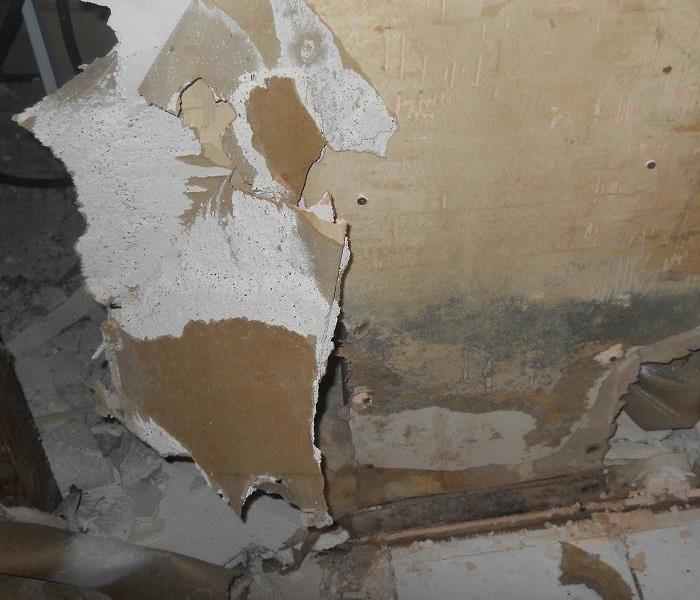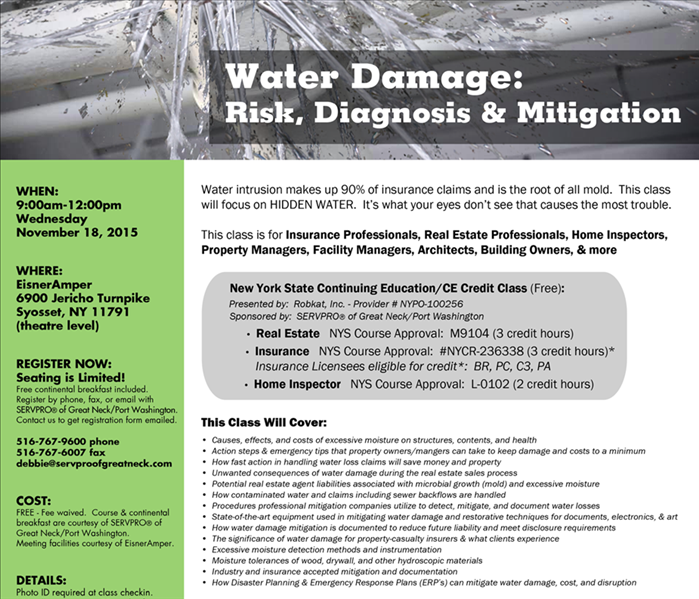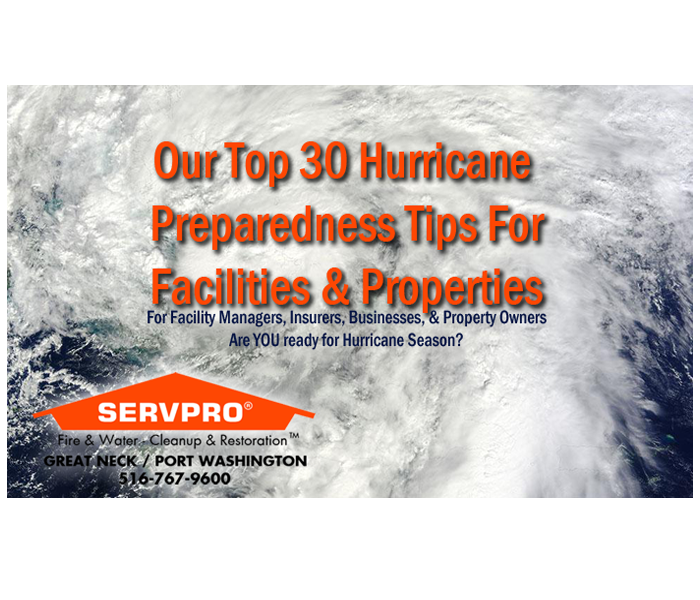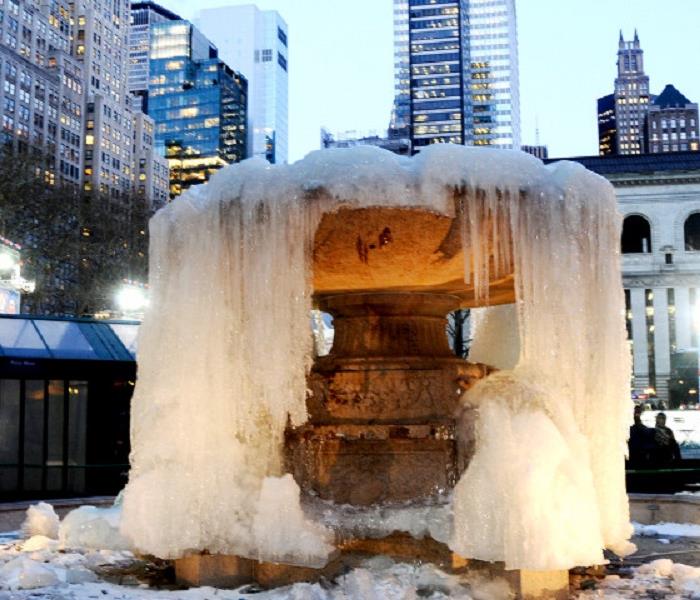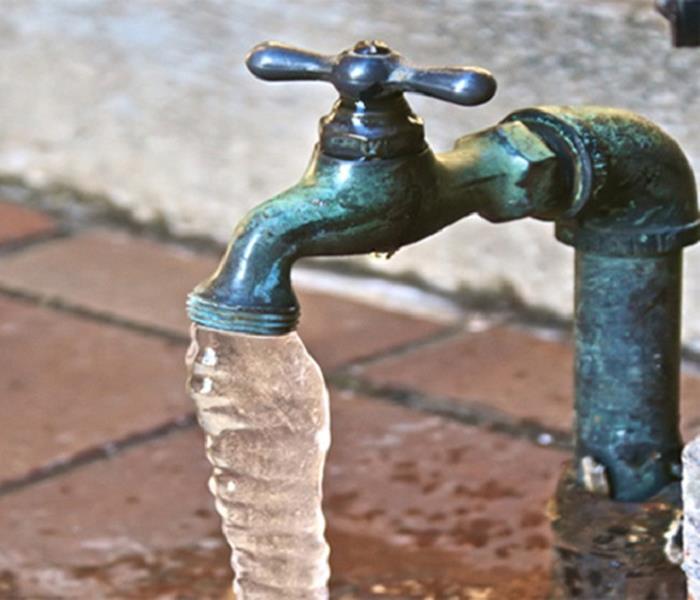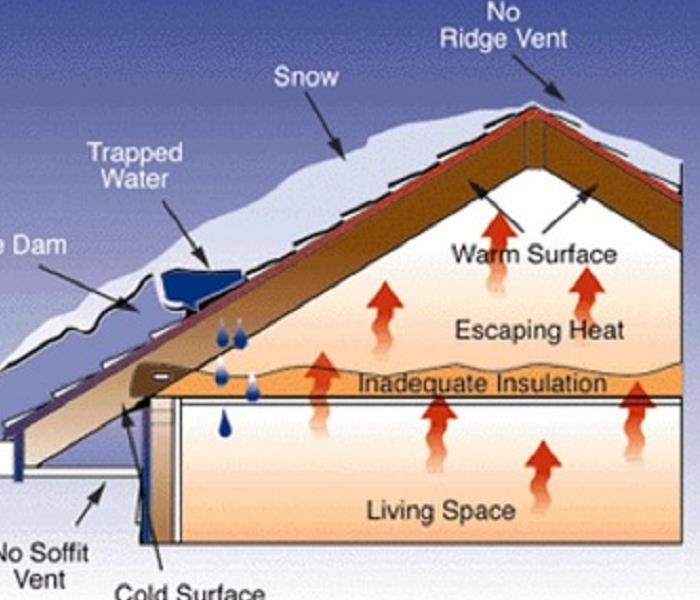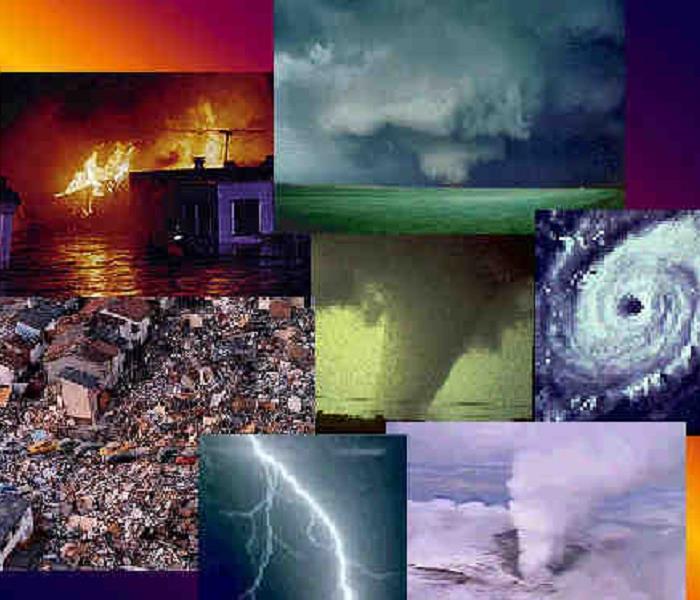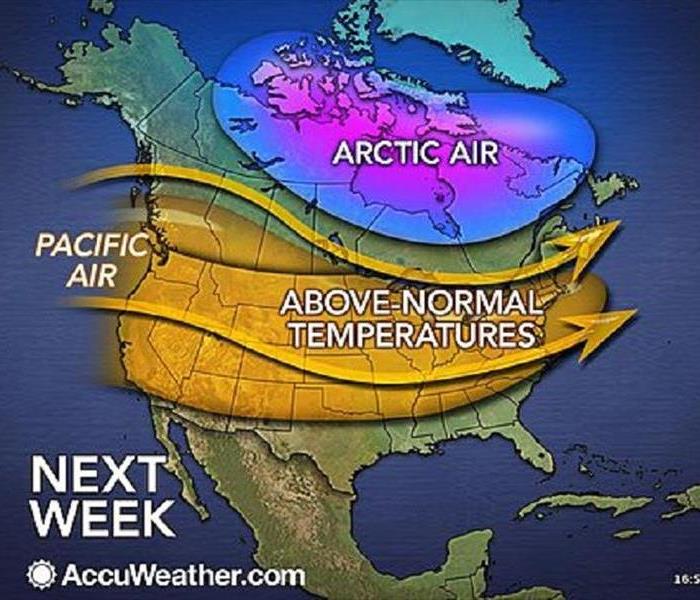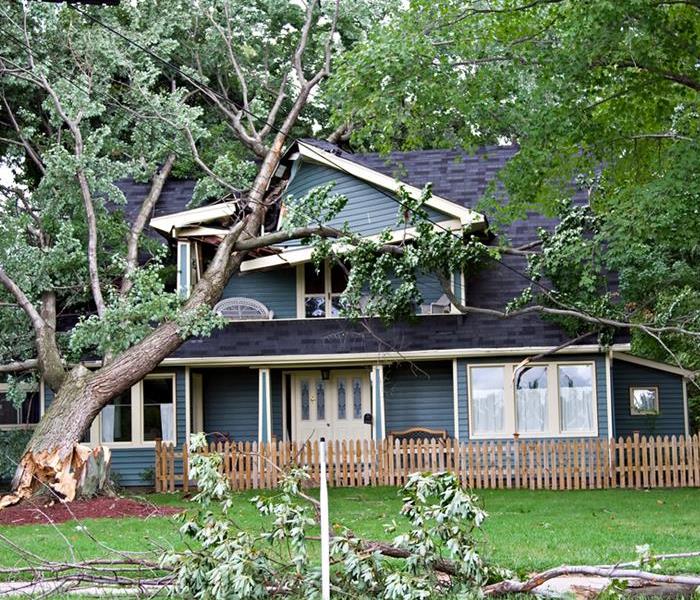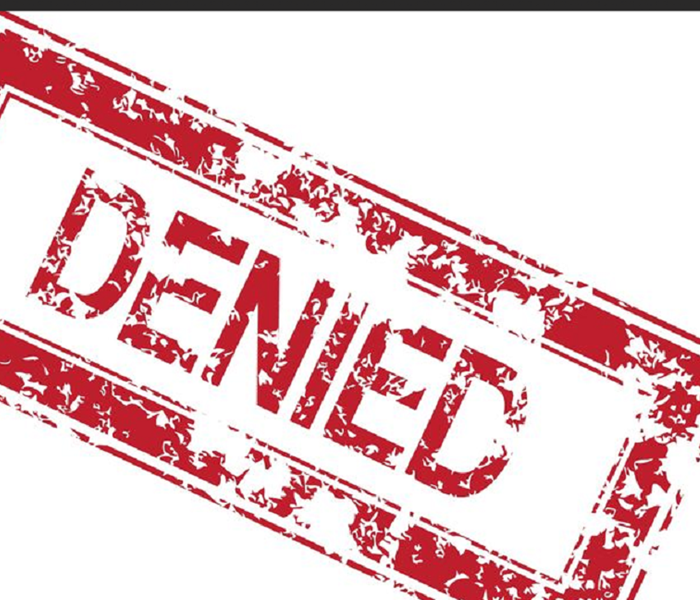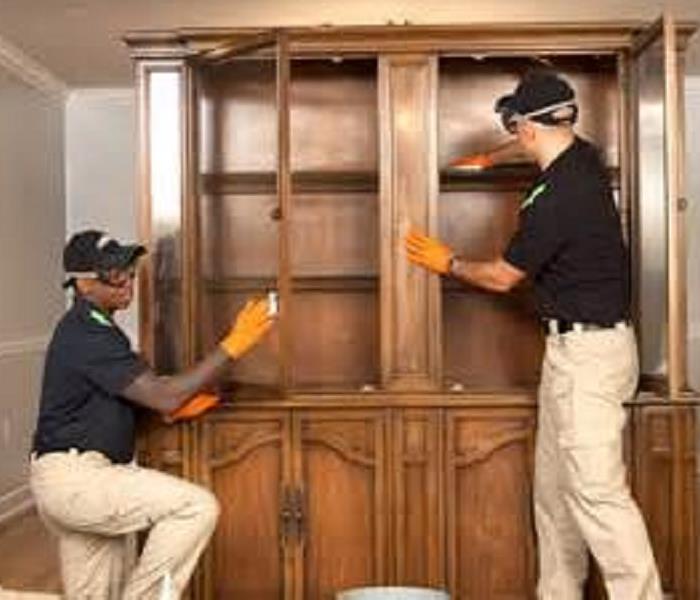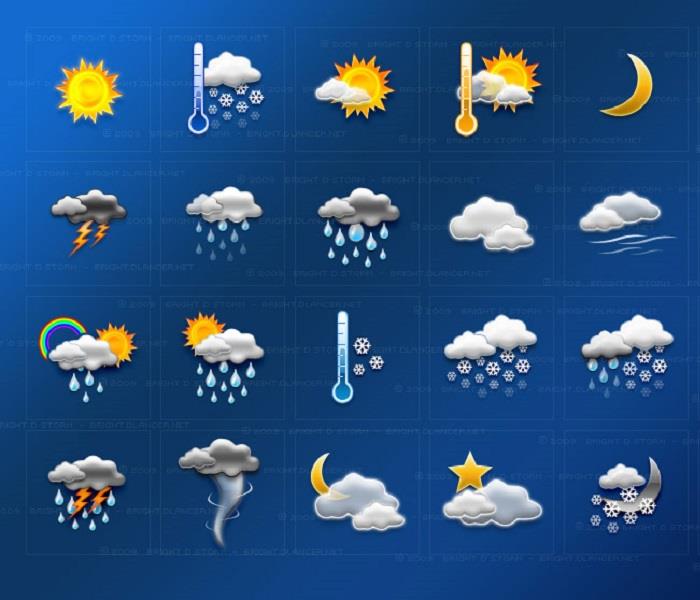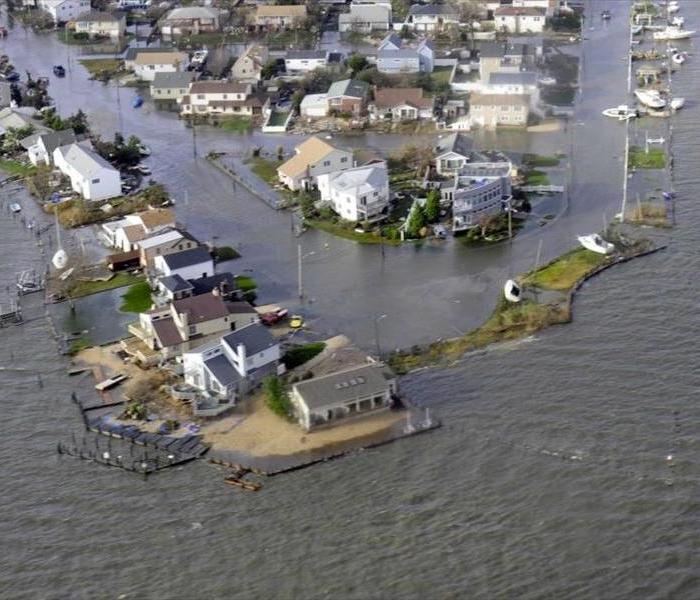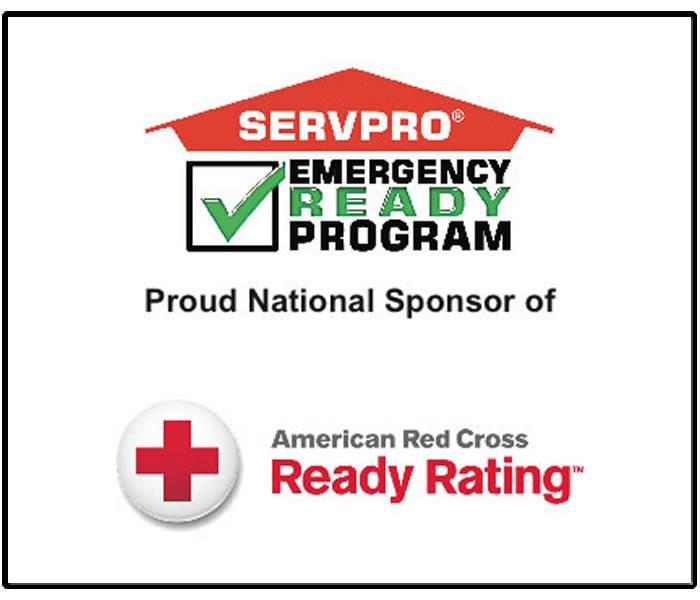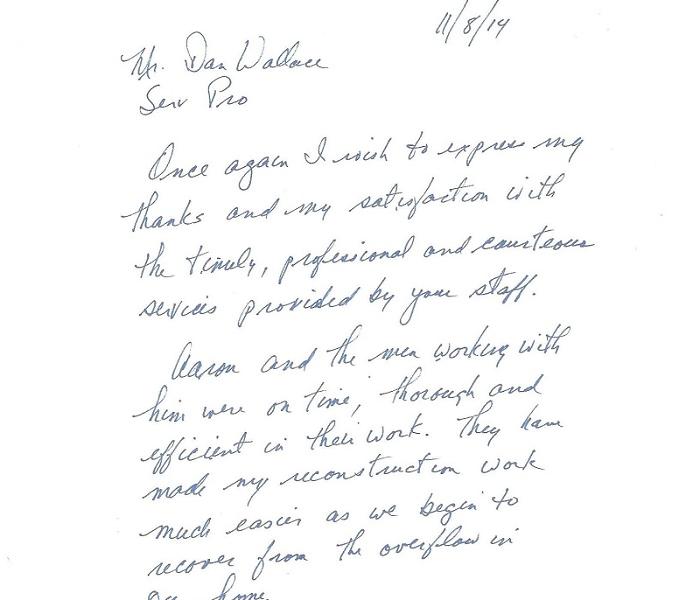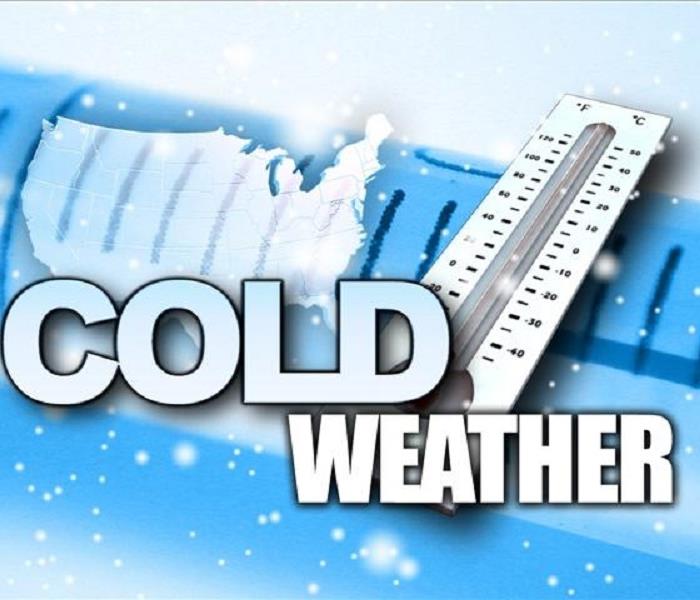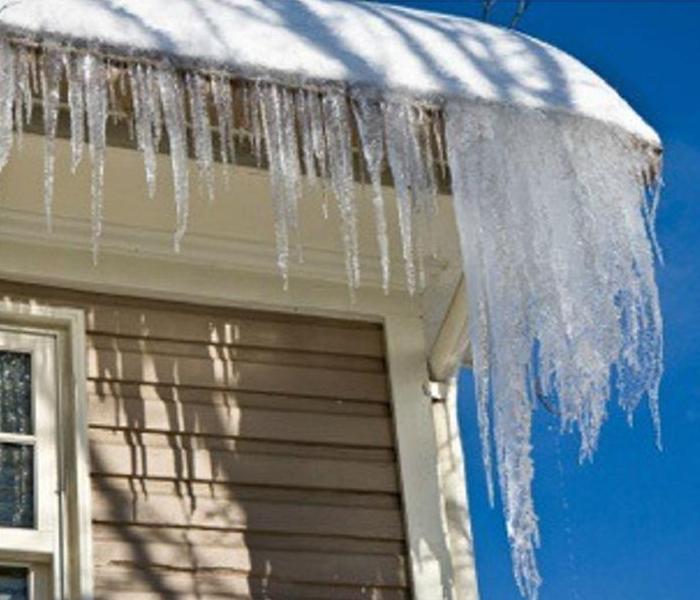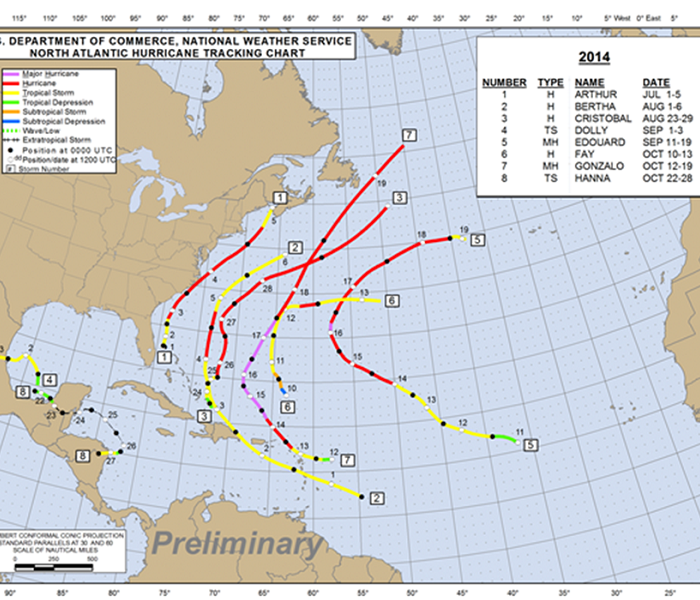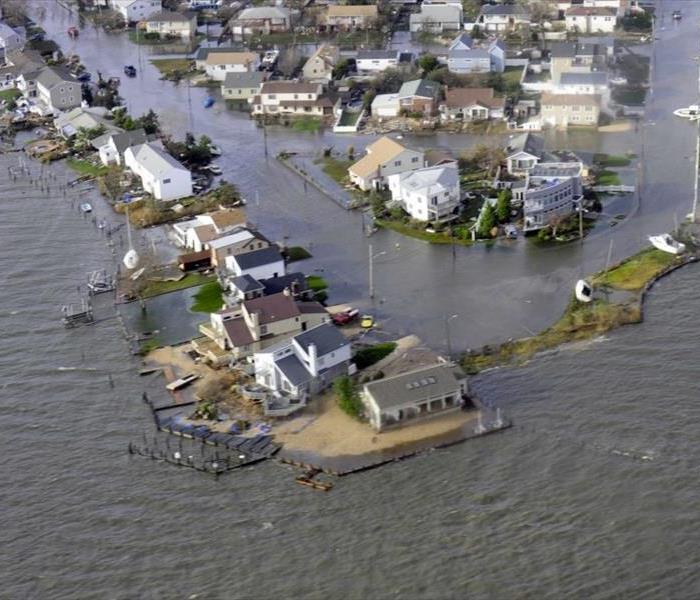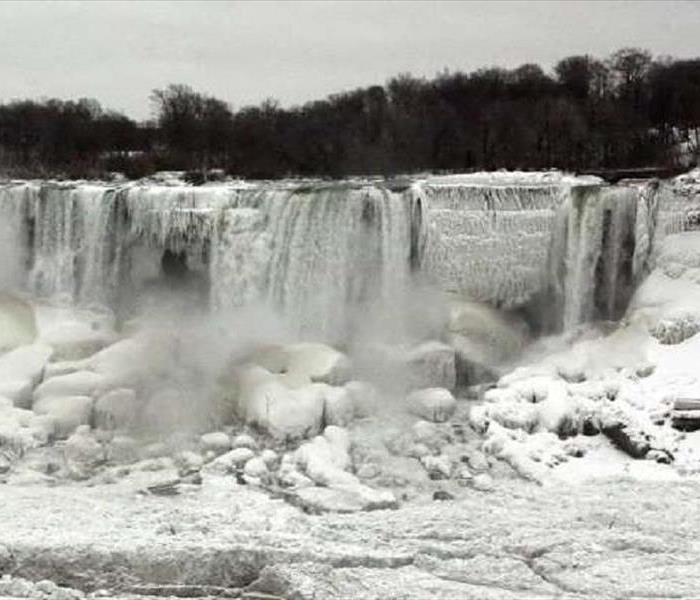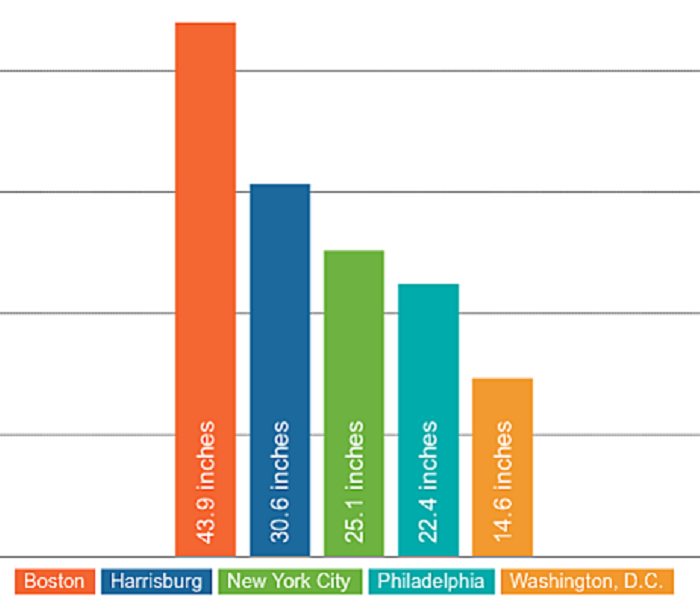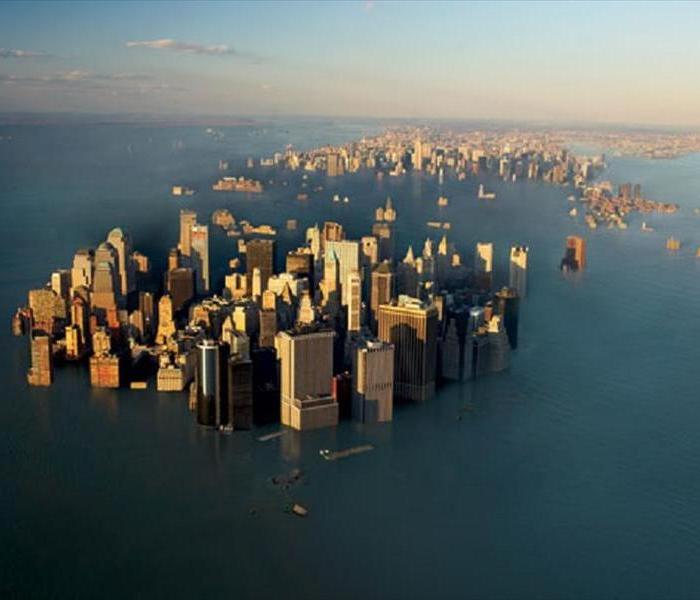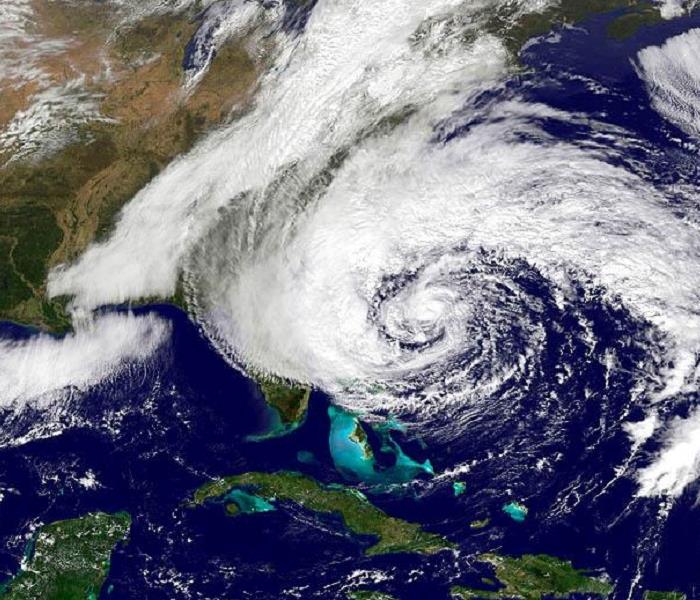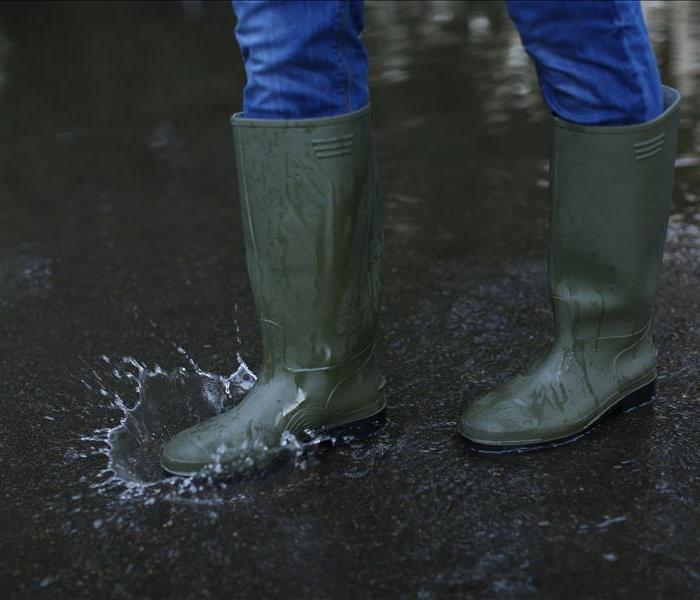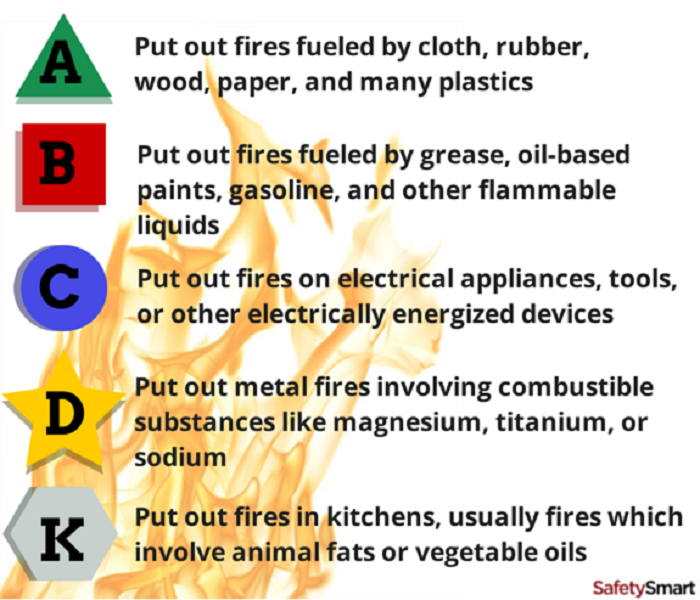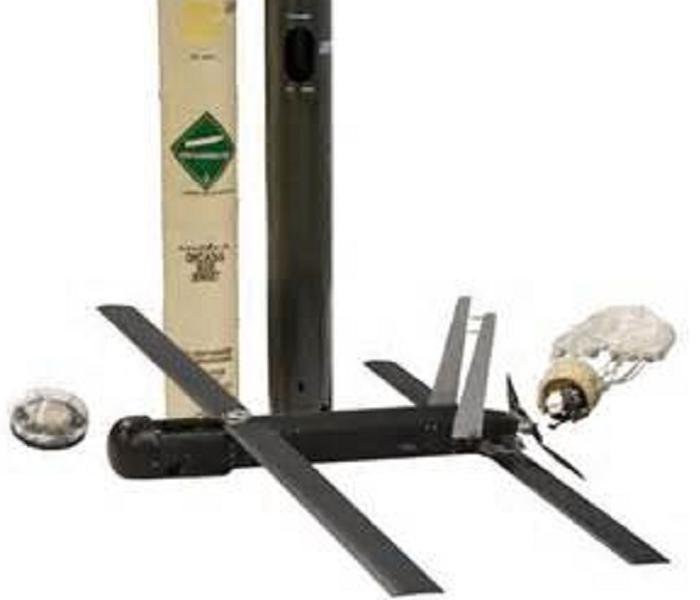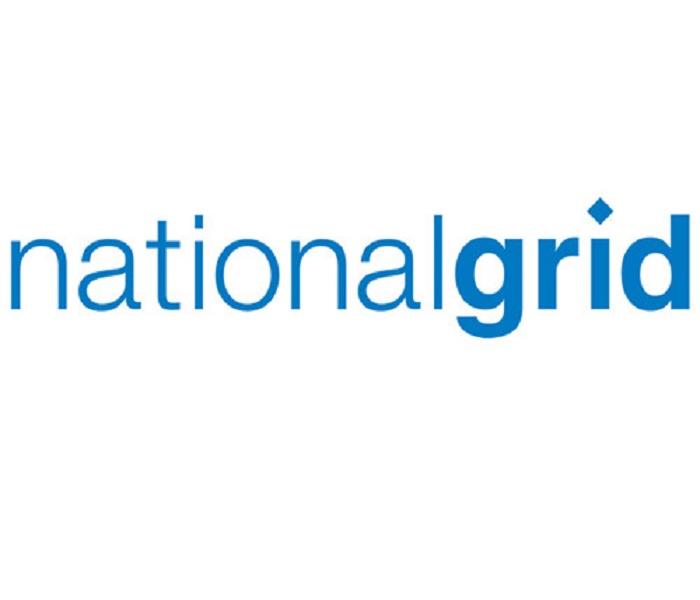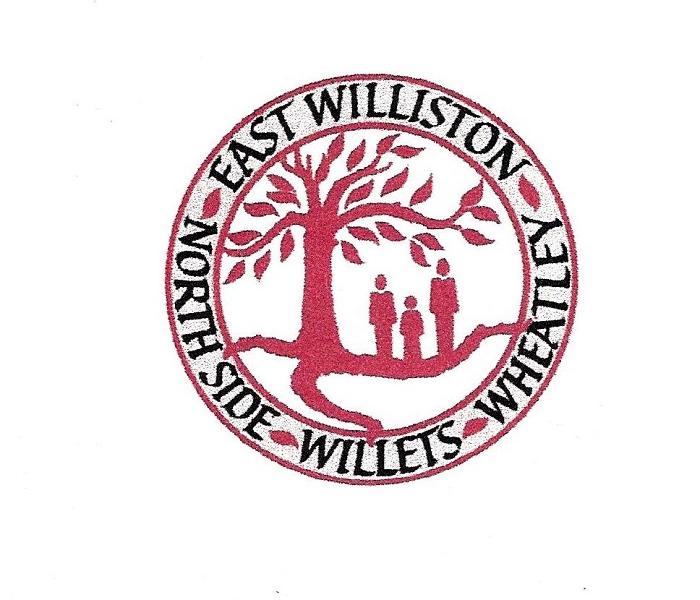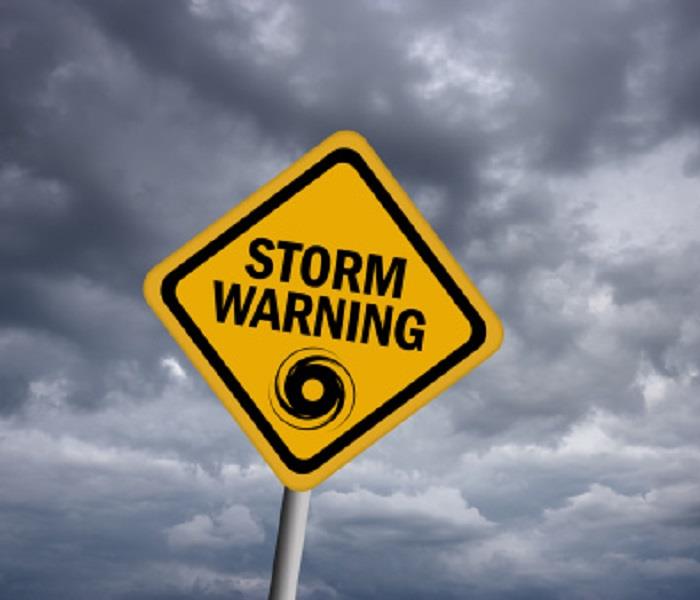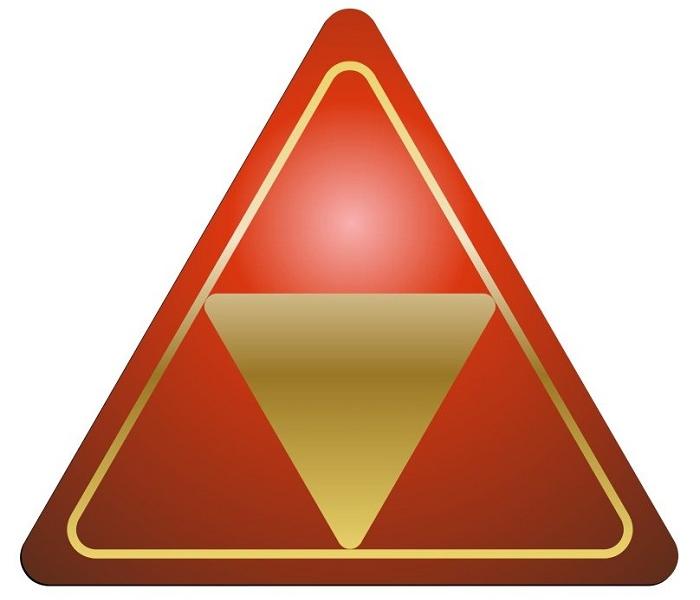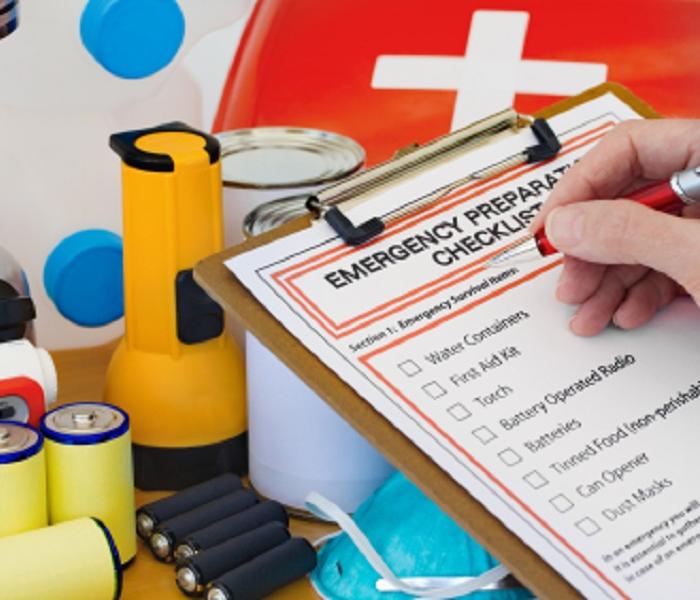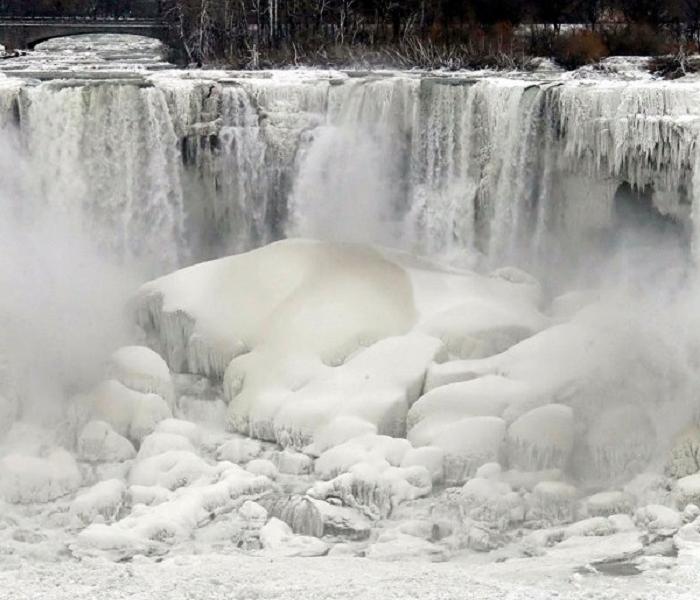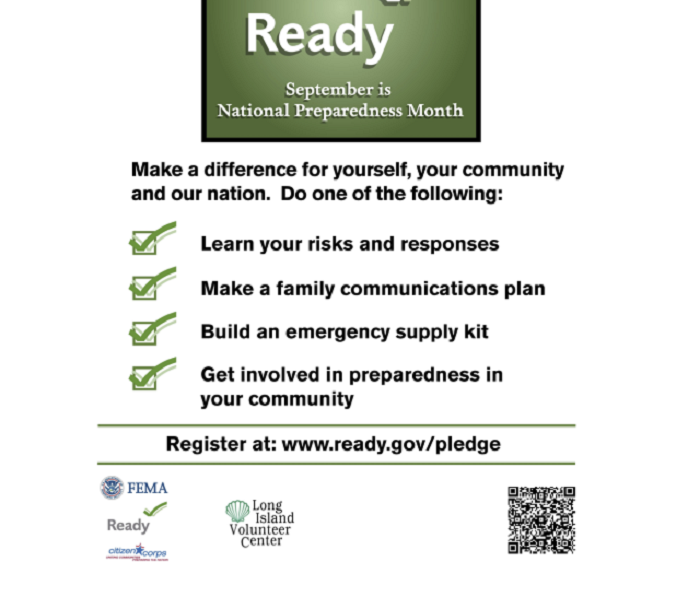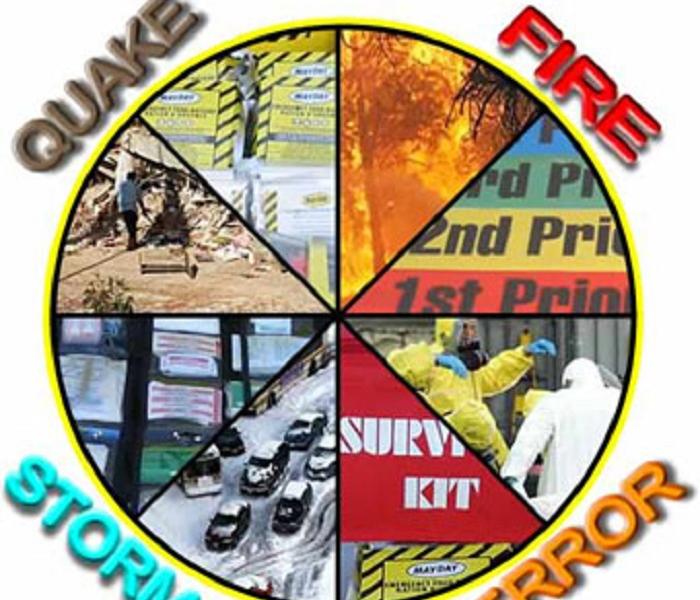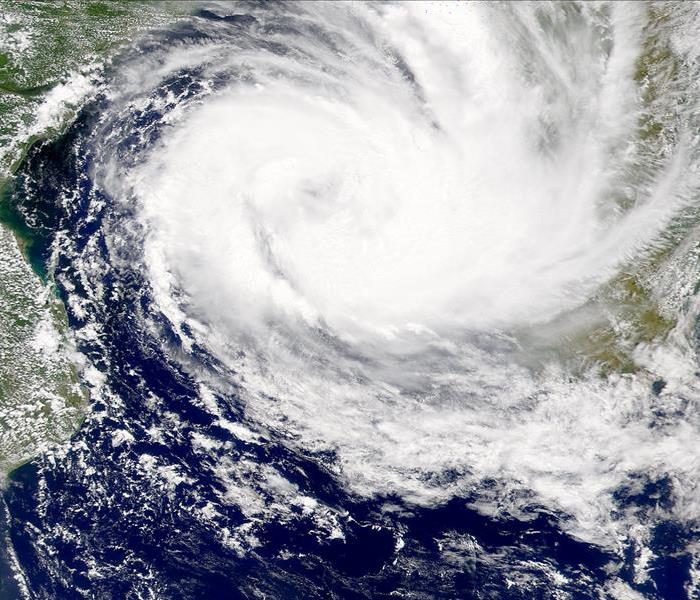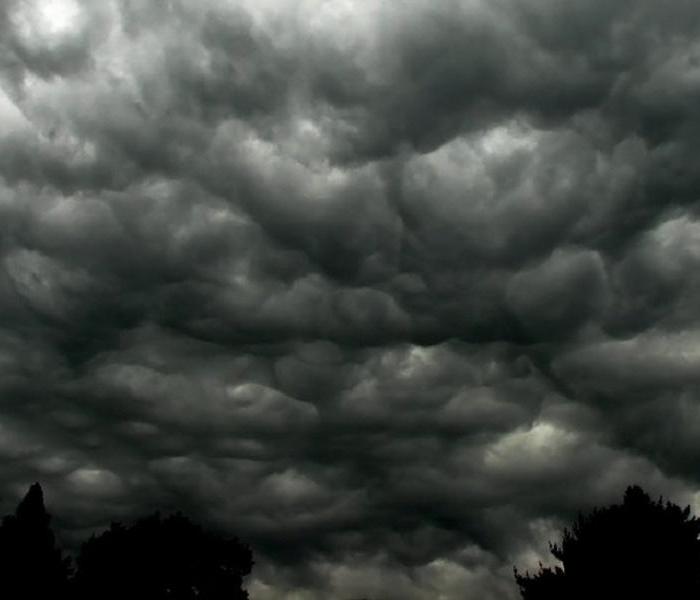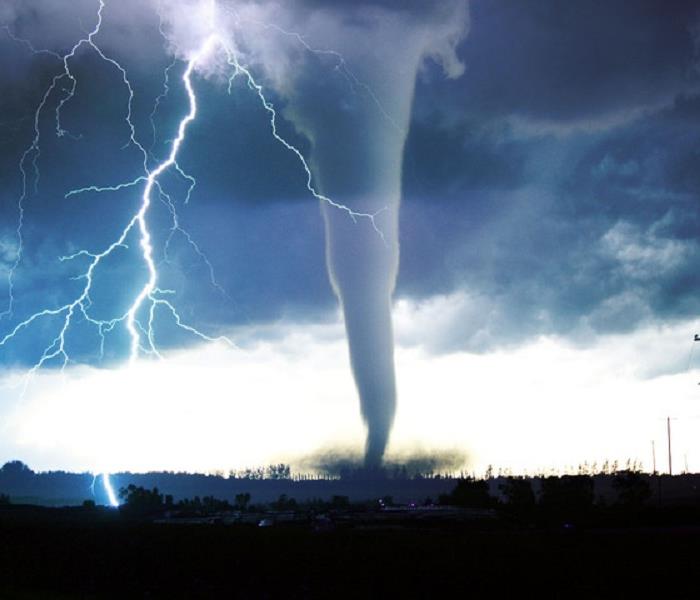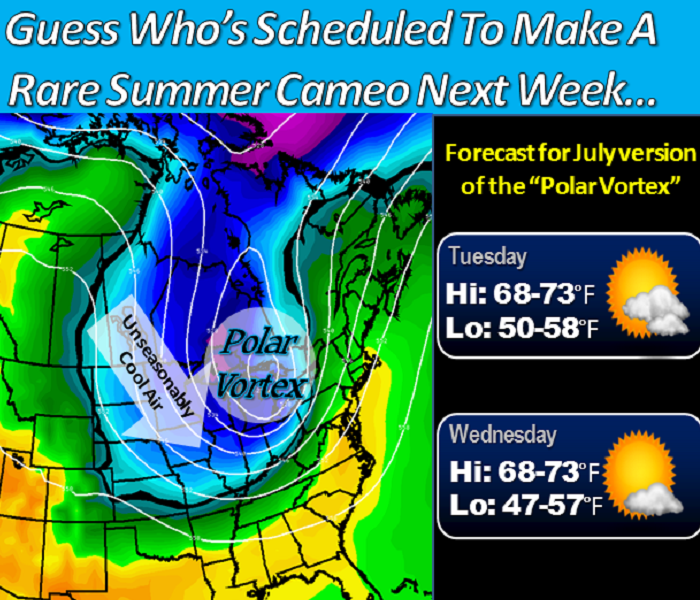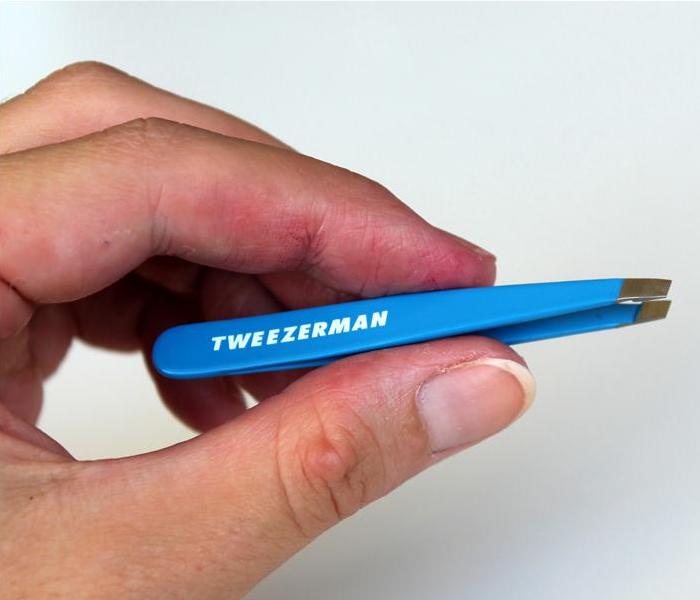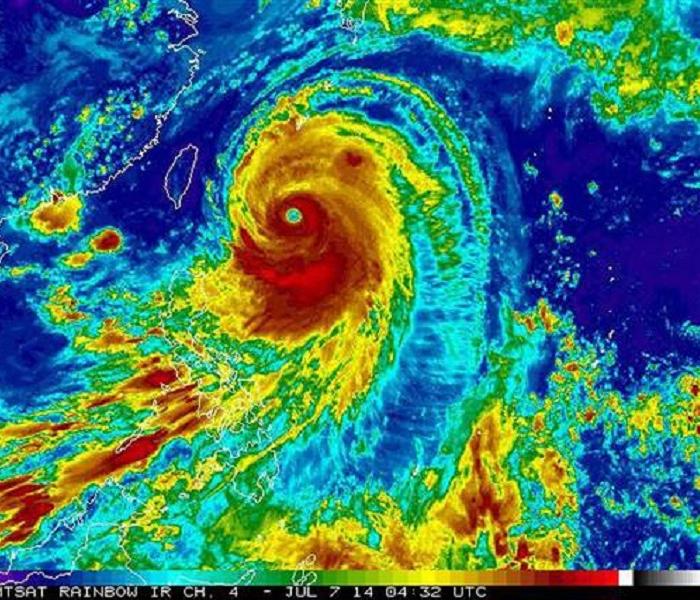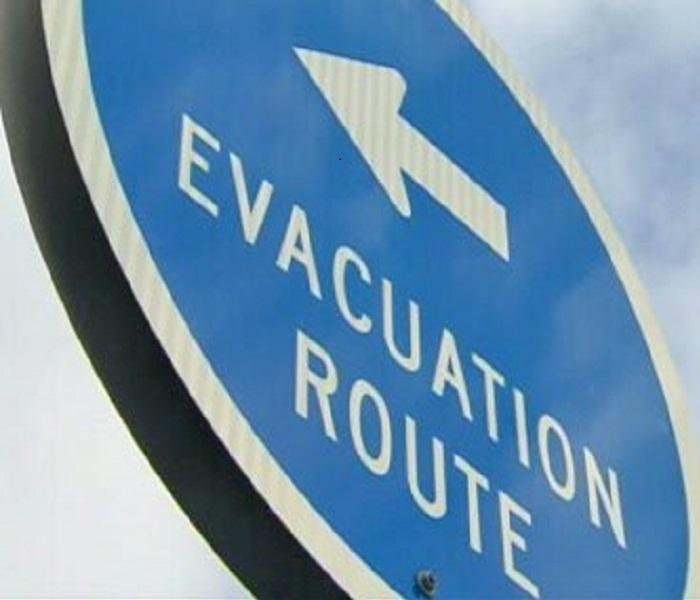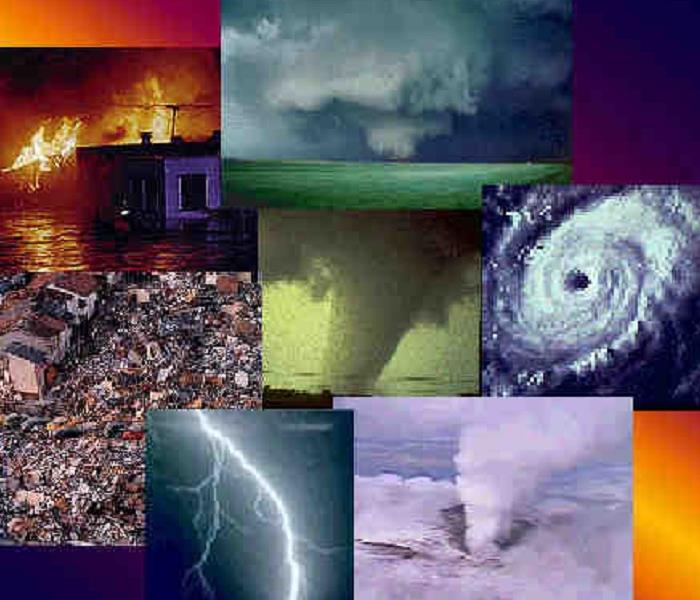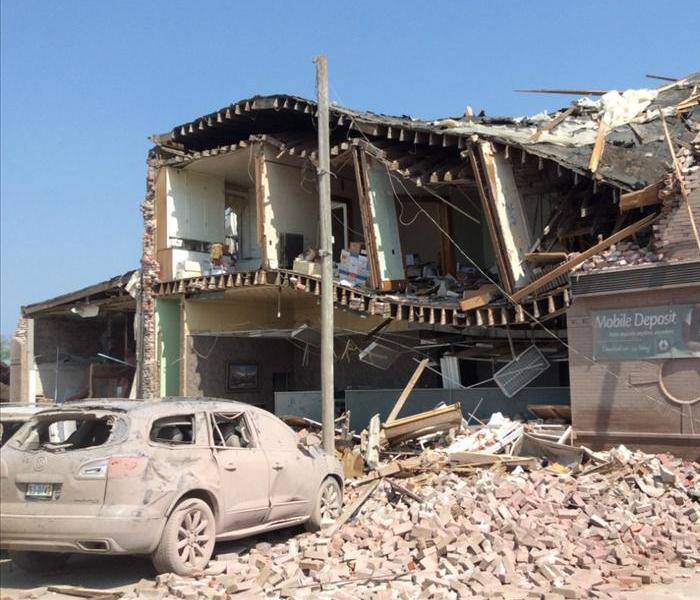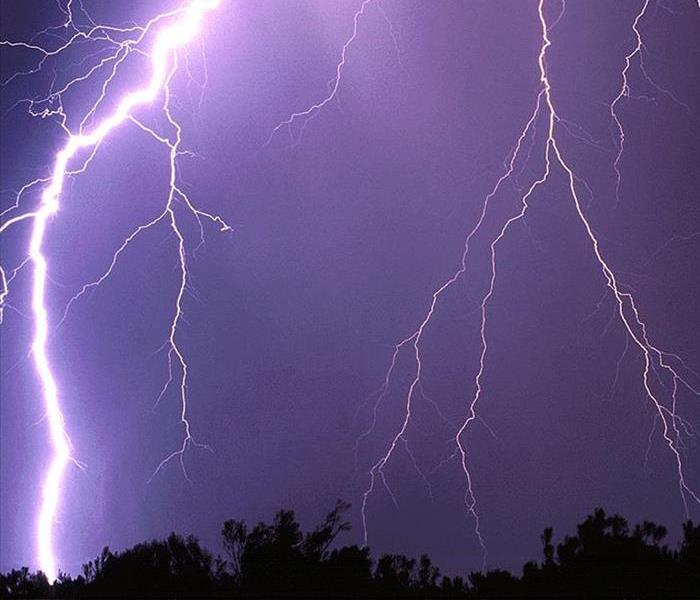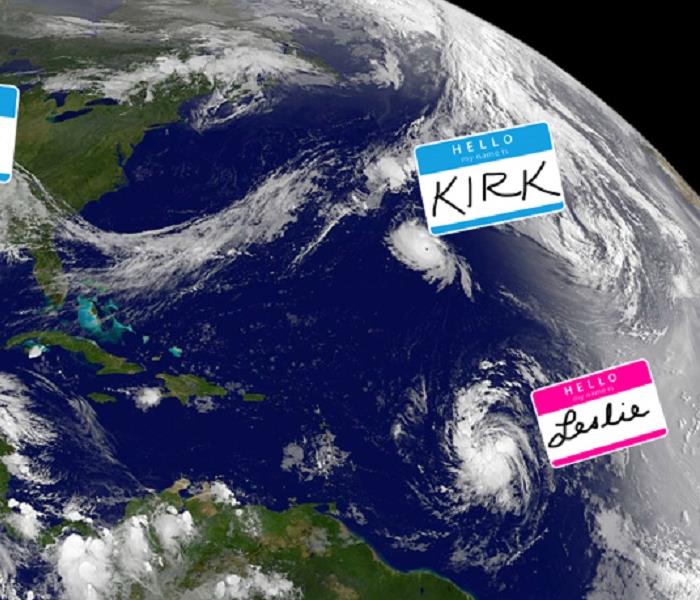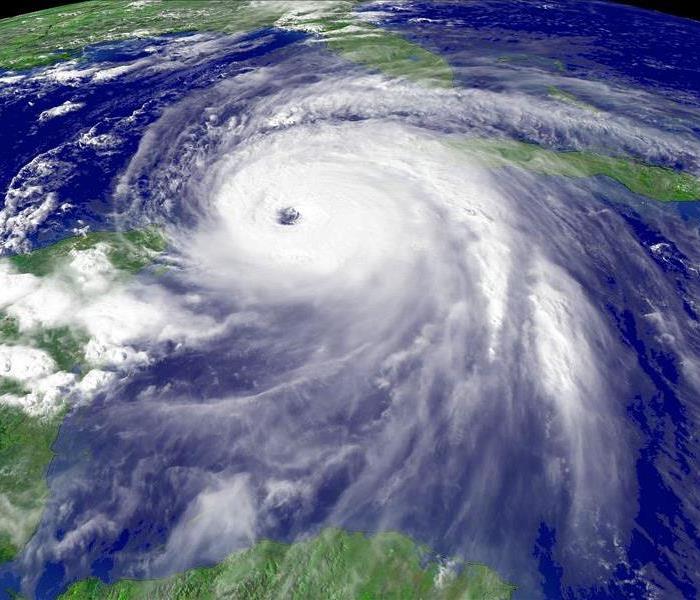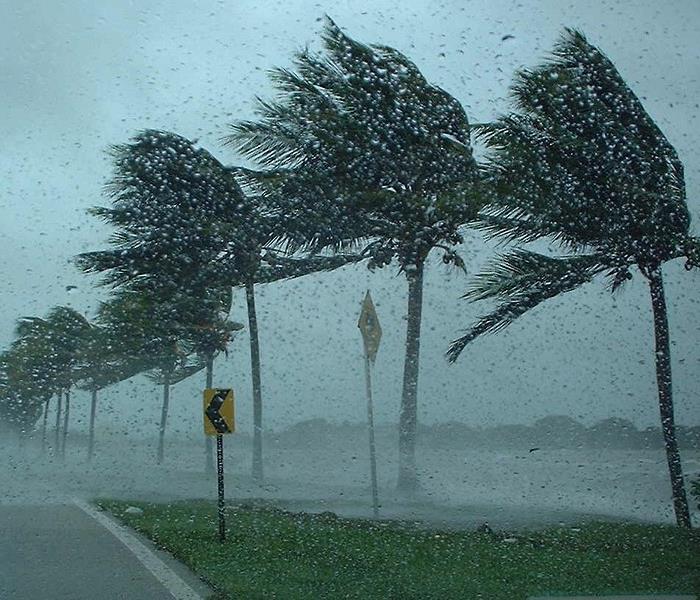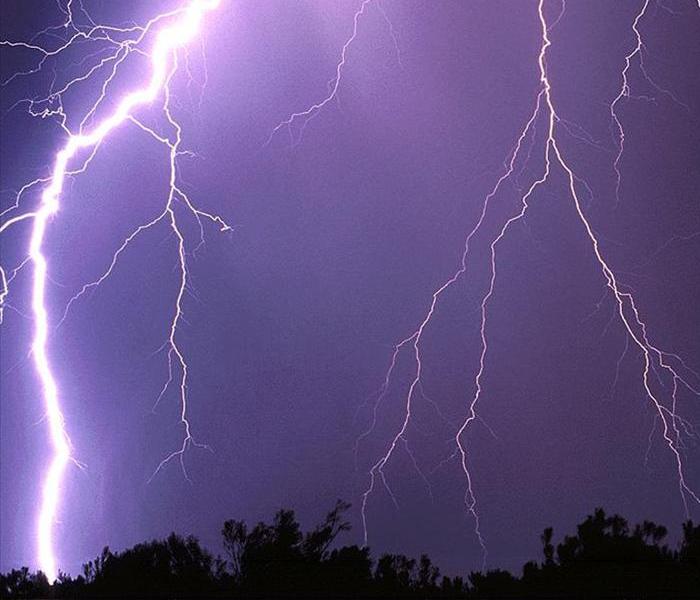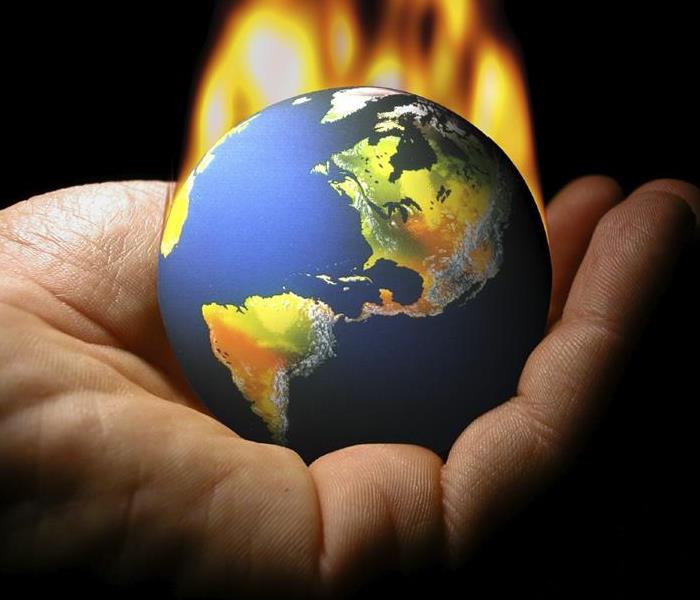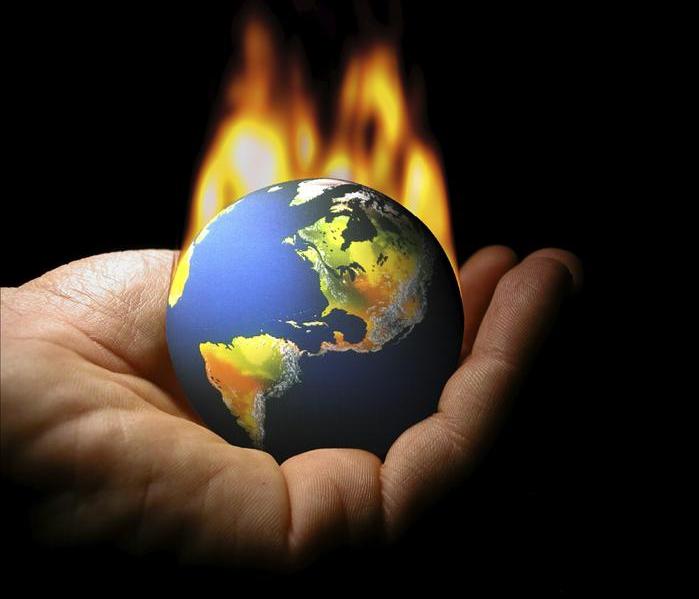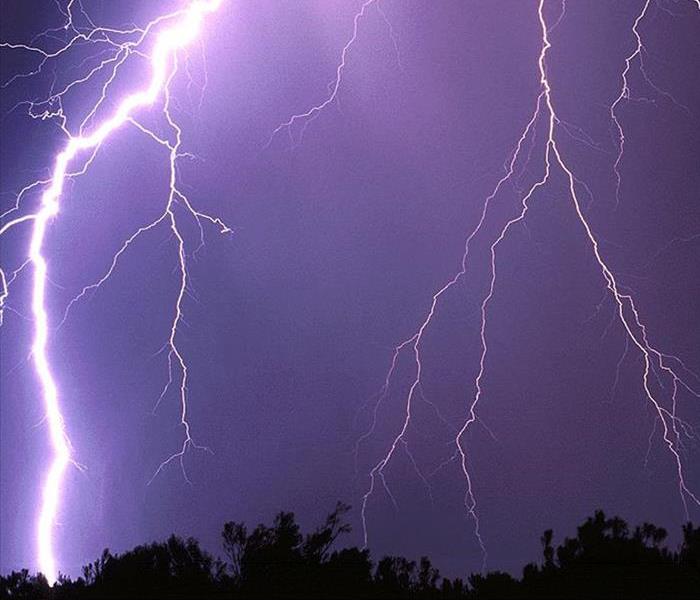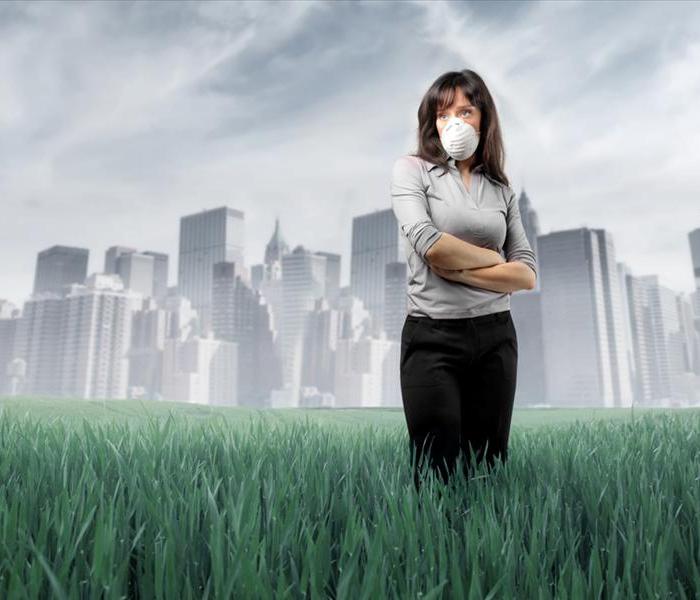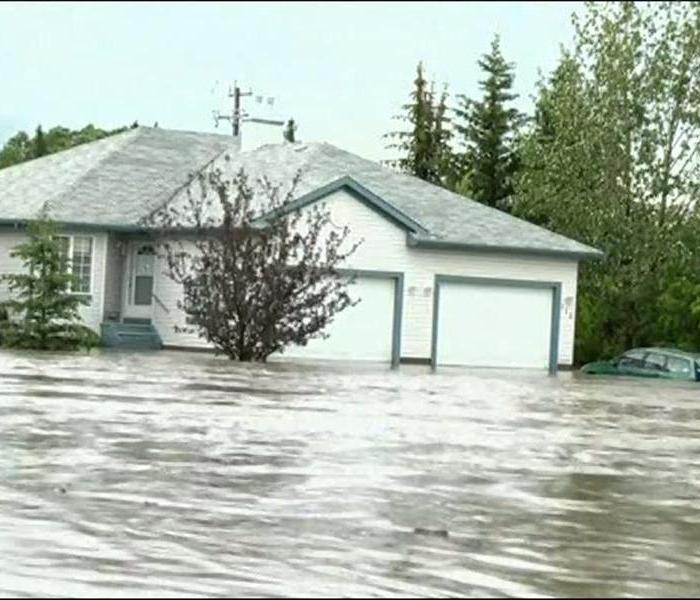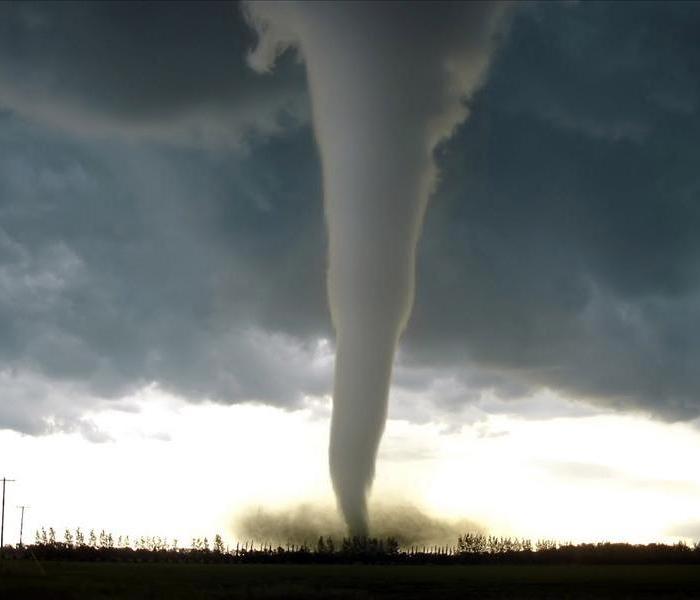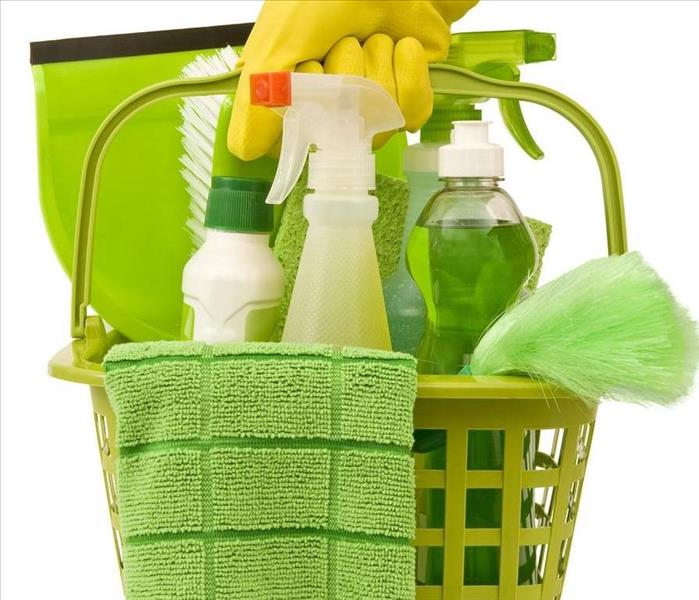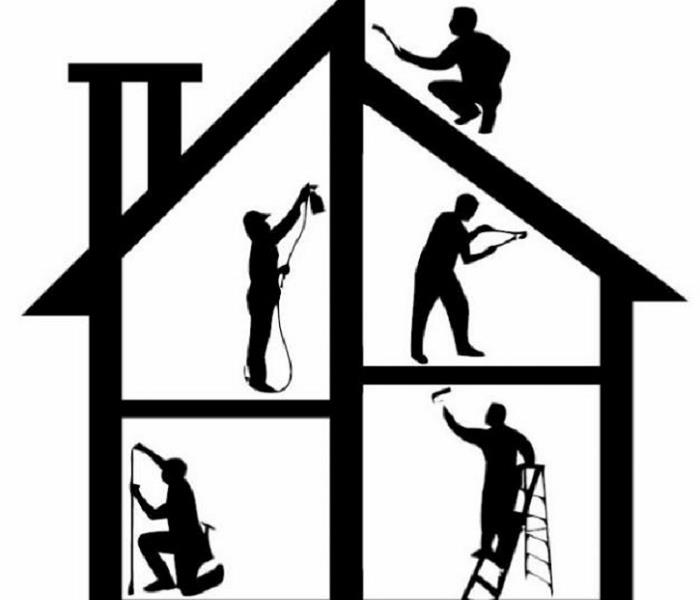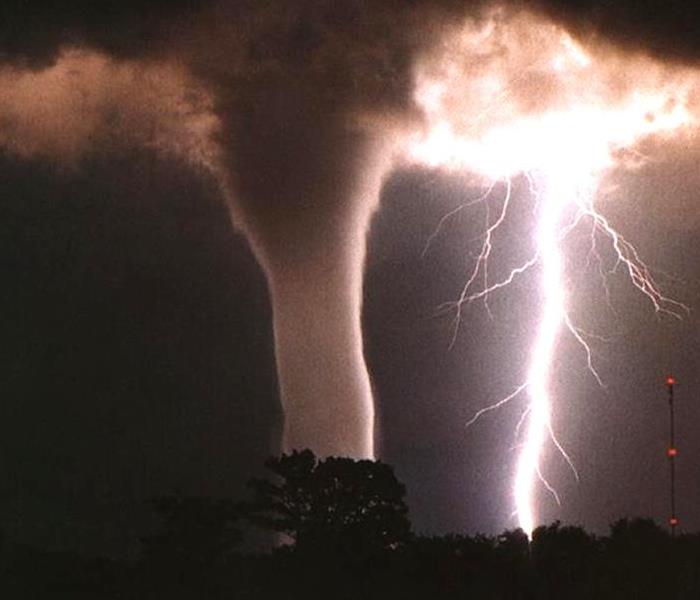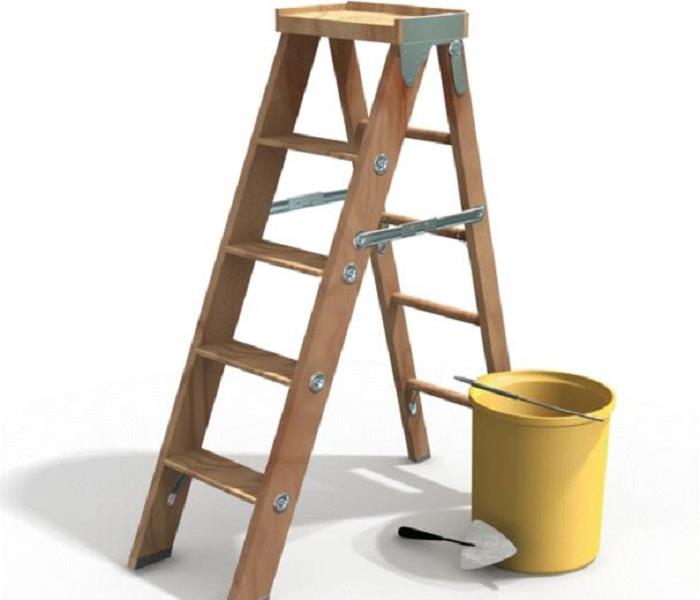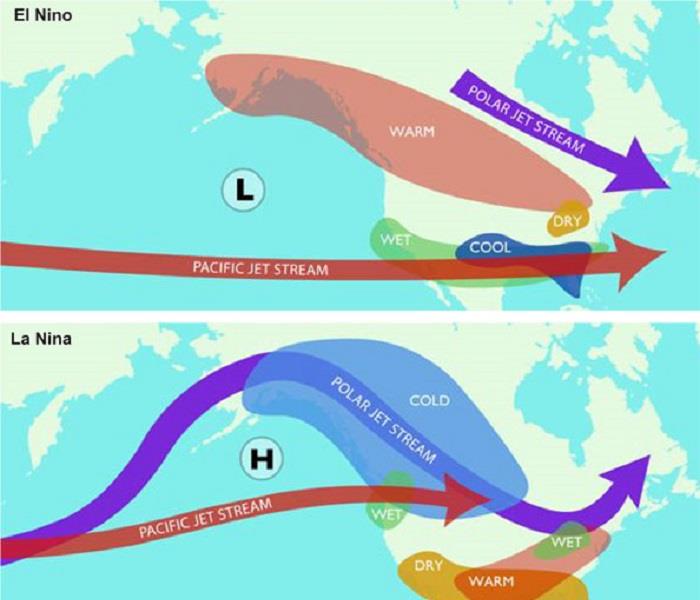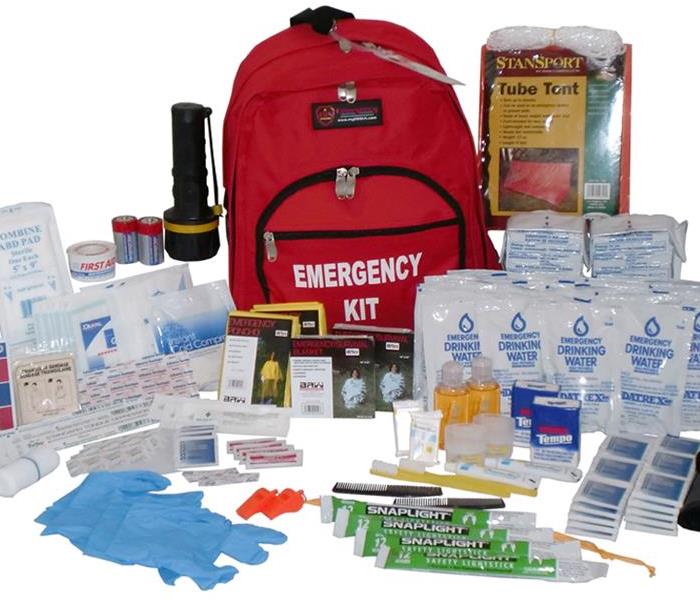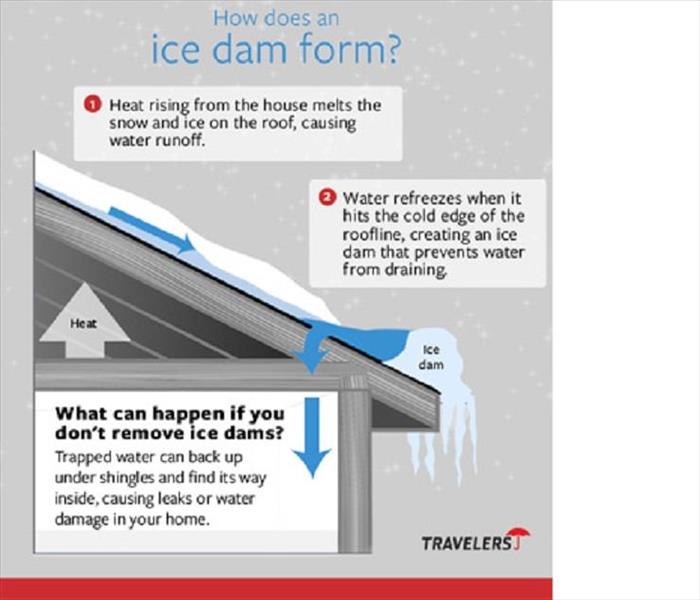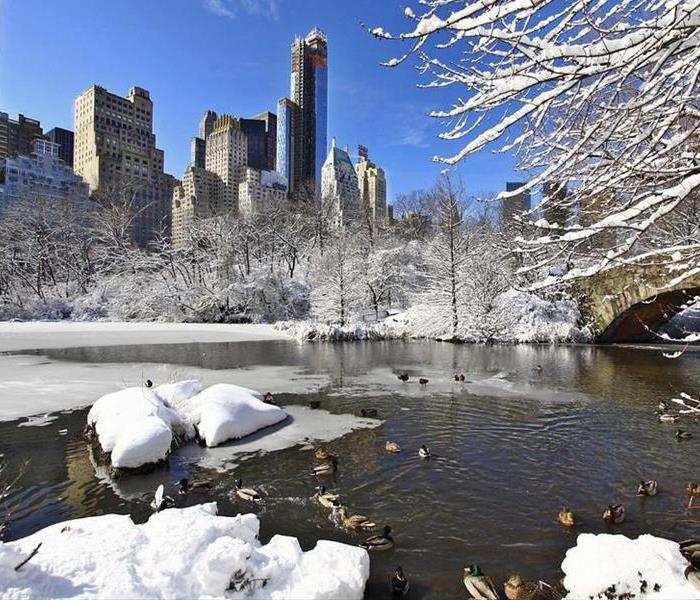Archived Blog Posts
Flooded basement in Great Neck/Port Washington
7/5/2023 (Permalink)
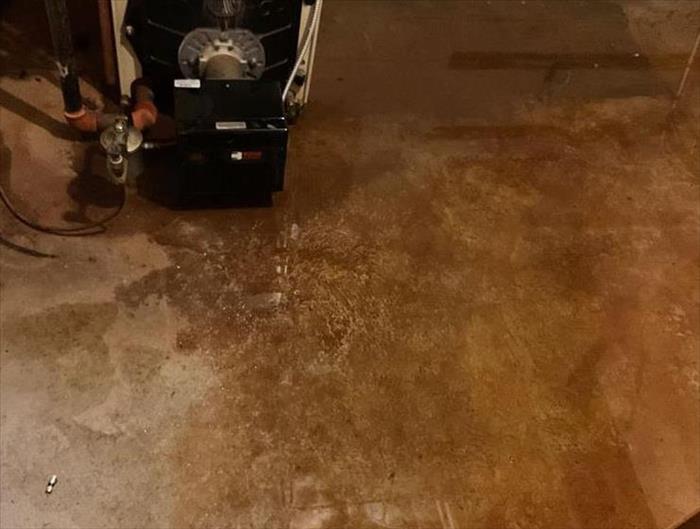 Flooded basement was caused by old expansion tank
Flooded basement was caused by old expansion tank
Customers expansion tank on the boiler blew.
This left her basement floor and walls to take on water damage.
Being that the basement had no dehumidifier prior to the event this caused mold growth, and condensation all around the basement walls and ceiling.
SERVPRO came in and removed all wet contents. We set up air scrubbers and a dehumidifier to dry out the remaining moisture. This elderly customer who never goes into her basement has terrible health and she was so concerned over the mold. We worked quick and made sure to take care of all her concerns.
Team Luzzi Employee Spotlight
6/20/2023 (Permalink)
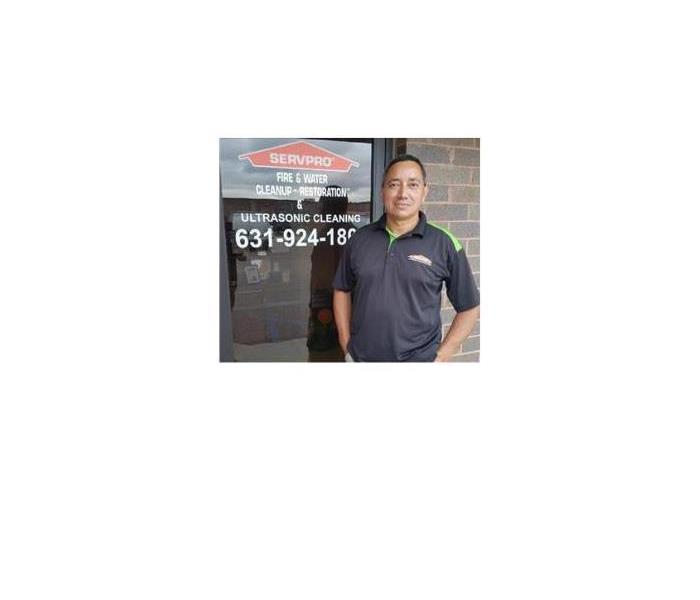 Shining the spotlight on our veteran technician
Shining the spotlight on our veteran technician
We are thrilled to shine a spotlight on one of our valued team members, Jose Turcios. Serving as a Technician in our SERVPRO franchise, Jose has been an integral part of our team since he joined.
It has been an exciting 13-year journey for Jose at SERVPRO, during which he has witnessed and contributed to the substantial growth and change within the company. He looks forward to being a part of our future journey and seeing where we go next.
The Basics of Electrical Fire Safety | SERVPRO of Great Neck/Port Washington
6/16/2023 (Permalink)
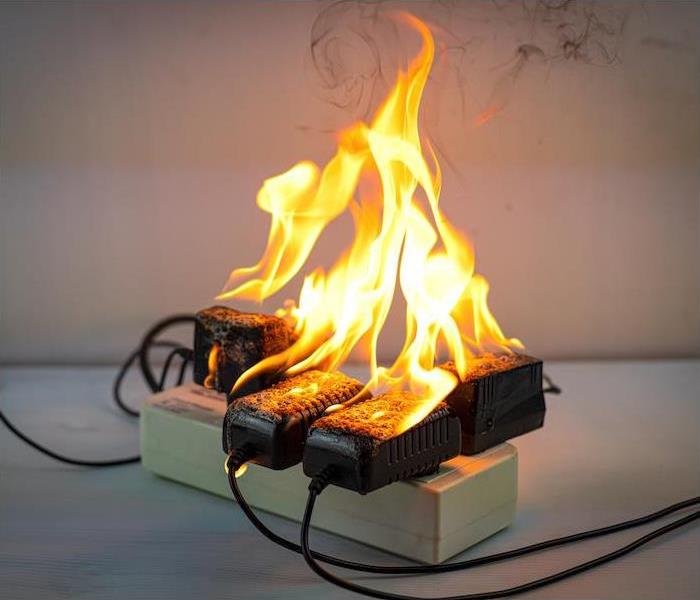 Disasters can happen at anytime. That's why SERVPRO of Great Neck/Port Washington is available 24/7 to help you recover from any disaster.
Disasters can happen at anytime. That's why SERVPRO of Great Neck/Port Washington is available 24/7 to help you recover from any disaster.
Fires in a home or business can be a completely devastating, overwhelming event. Regardless of how they started, they can leave you sifting through ashes and facing smoke, soot and lingering odors for what feels like will be the rest of your days.
Electrical fires account for nearly 34,000 house fires every year. Nearly $1.3 billion in damages are counted as a result of electrical fires, and death is often a result when this terrible disaster strikes.
The good news is that there are steps you can take to protect your home from electrical fires. You can both put action in place that will help prevent a fire from beginning as well as learn the warning signs to look for to stop issues before they become a disaster.
Watching for the SignsIn order to prevent electrical fires, you need to first understand some of the most common ways they start. Some of the top causes of electrical fires include improperly installed or faulty wiring, overloaded extension cords or outlets, and the misuse of lighting.
When you plug something in, there is a good possibility you aren’t thinking of anything except powering/charging/starting whatever it is that requires electricity. Faulty wiring does have some warning signs you should look for every time you use an outlet, though. Flickering lights, hot outlets and switches, or discoloration on the plate around a switch or outlet are all signs that something is going wrong.
Don’t dismiss having to wiggle chargers around to get them to work or that strange smell when you turn the light on! If these signs are evident in your home or corporate building, call an electrician and have your wiring checked by a professional.
Preventing a DisasterAs much as it sounds like a pun, electricity literally powers our life. Think about the groans your entire family emits when a storm knocks out power as they have to slow their device usage to conserve their batteries. Electricity makes our life more convenient, but it isn’t without dangers.
Start using your electricity in safer ways to prevent a disaster in your home. Never run extension cords under carpets or rugs, and always use the correct length in order to avoid connecting more than one extension cord at a time.
If your surge protectors have enough cords coming out of them to look like an octopus, unplug some items and relocate them to another location. Use the correct wattage bulb in every light, and opt for LED versions to both cut down on heat output and save a little on your bill.
Never DIY electrical upgrades or corrections. Always call in a professional, and keep SERVPRO of Great Neck/Port Washington on your emergency contacts in the event that even the smallest fire starts. We can respond day or night to get things restored quickly.
Have you experienced a fire in your home? Contact us and get things cleaned up fast.
Great Neck Water Damage Tools and Approaches
12/14/2022 (Permalink)
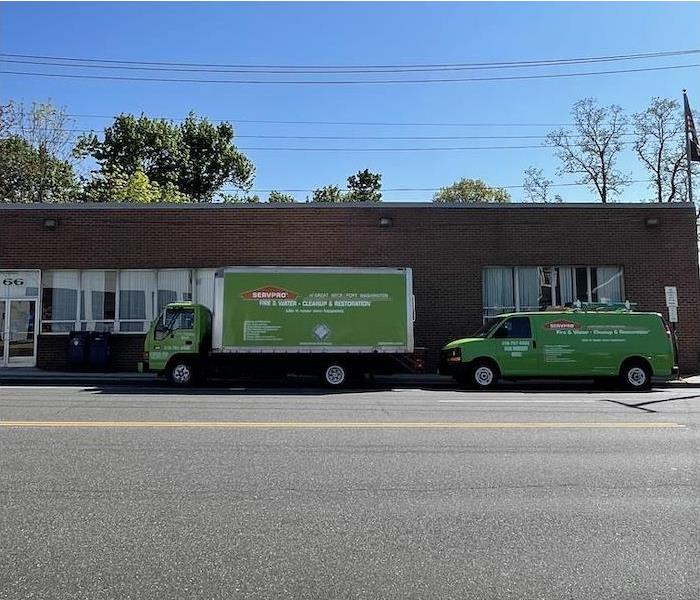 Day or night, SERVPRO is always on call to handle your water damage emergencies in Great Neck!
Day or night, SERVPRO is always on call to handle your water damage emergencies in Great Neck!
SERVPRO Helps Quickly After Water Damage
The water restoration process requires several actions to return the damaged property to its original condition. Our professionals are among the most heavily trained and educated as WRT-certified technicians through the IICRC and strictly adhering to the recognized standards of ANSI regulations for:
- Water removal
- Drying
- Content cleaning
- Structural repair
- Mold prevention
- Deodorization
We’re Faster To Any Size Disaster – this is more than a slogan to our team for Great Neck water damage incidents. It is a commitment we uphold every day through every project that we begin or continue through completion. We want customers to understand that they are the priority, and our objective is to return to normal living conditions as swiftly as possible. Proper restoration involves multiple focuses by our responding team.
Priorities of Water Damage Restoration
Our SERVPRO of Great Neck / Port Washington team must prioritize several restorative and mitigative actions beginning as soon as our response team arrives. With a consistent and focused progression through these phases, we can return properties to their preloss condition in reasonable timelines:
Extraction
Water removal services are a critical element of the mitigation process. Any standing water concerns become threatening presences to the exposed building materials involved, especially porous construction like carpets, drywall, and more. Pooling can be removed using several devices from our inventory, ranging in selected use by the depth of the damage and where trapped water exists. This can include:
- Submersible Pumps
- Wet Vacuums
- Carpet Wands
Drying
Drying is a necessary element of every water restoration process. Removing moisture is vital to the recovery of a household because lingering damp pockets and water caches in wall systems or on surface materials can support secondary damages like mold development or structural degradation. Evaporation and moisture content removal involves several specific devices from our stock, including:
These machines introduce focused airflow across moist surfaces and within damp environments. There are several types capable of managing specific conditions like low-profile centrifugal options.
Warming materials and the drying areas help amplify the production of evaporation and other needed chemical processes used for moisture removal, cleaning, and deodorization.
Evaporation increases water vapor in the environment, requiring several dehumidification units to be placed on the property to help. These machines act through condensation and absorption to lower humidity to acceptable parameters.
Trapped water in materials like hardwood and engineered wood flooring requires special drying tools to remove moisture through capillary suction.
Surface Cleaning
Cleaning up after a water damage issue involves the elimination of residues, microbes, and bacteria that might form on surfaces after prolonged water exposure. We must also present a suitable solution for deep cleaning carpeting throughout a property, as these fibrous flooring options can be heavily soiled.
Mold Prevention
Moisture continues to more than the destruction of exposed building materials. Damp conditions facilitate mold colonization and organism growth. There are early actions to be taken to help reduce, remove, and remediate mold damage, such as:
- Antimicrobial Products – Sporicidal and biocide sprays and solutions eradicate mold organisms and spores on contact.
- Managing Moisture – SERVPRO works to ensure water damage is resolved quickly to prevent lingering moisture that facilitates growth. We can also rebuild and repair vulnerabilities that allow recurring water infiltration.
- Third-Party Inspections and Testing – Third-party professionals can inspect and document impacted areas to identify if mold exists and the appropriate response of remediation professionals like our team to help.
Great Neck water damage incidents require fast and deliberate actions from trained professionals like our SERVPRO of Great Neck / Port Washington team. We are ready to help 24/7 at (516) 767-9600.
The Great Neck Fire Damage Restoration Timeline
12/14/2022 (Permalink)
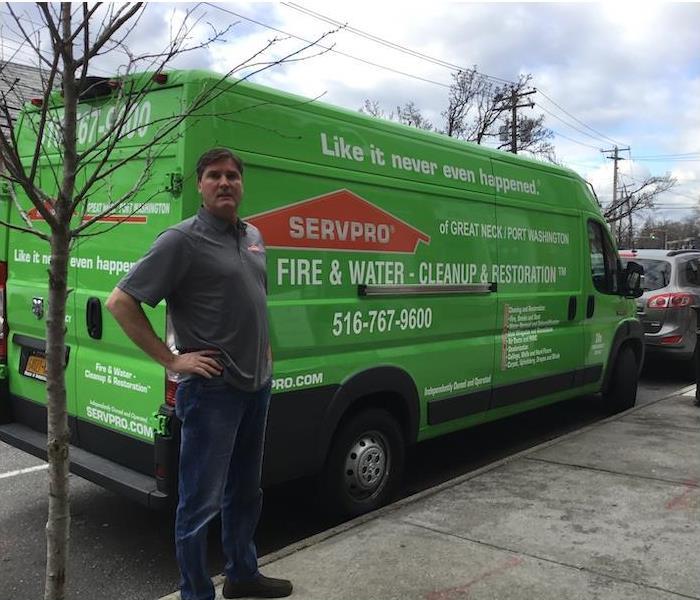 Great Neck property owners breathe a sigh of relief when SERVPRO arrives for fire damage cleanup and restoration.
Great Neck property owners breathe a sigh of relief when SERVPRO arrives for fire damage cleanup and restoration.
SERVPRO Works Fast to Mitigate Fire Damage
From electrical accidents to grease fires, the causes of these disasters are widespread and ultimately need several steps to mitigate and restore. SERVPRO of Great Neck / Port Washington has a fast response to these emergencies, incorporating multiple vehicles from our fleet stocked with needed equipment. We can rapidly focus our efforts on mitigation and emergency services to protect the property.
Emergency Services After Fire Damage
Fire damage to Great Neck homes requires fast and intentional actions taken as early as possible. Once the fire gets extinguished, professionals like ours must begin the required restoration and recovery steps to overcome the most pressing structural and safety concerns. One of the practical actions of this process is removing the debris and bulk materials damaged by widespread combustion and smoke damage.
What Must Be Done After Fire Damage?
It is crucial to identify the full extent of the damage to your household or business after the disaster. Widespread effects could exist, especially at the ignition points. Production management, our most experienced field team members, walk through the property and catalog loss and begin forming the restoration plan to come. Early efforts for recovery include steps to make the property safe for technicians and house occupants alike.
Making the Environment Safe
A safer workspace for technicians involves several necessary steps to protect the exposed structural elements, environments, and responding team members. Much of the dangers have to do with circulating airborne particles such as smoke solids and soot, which can be avoided with the appropriate personal protective equipment. Our team can overcome these airborne threats with well-placed HEPA 500 air scrubbers and hydroxyl machines.
Cleaning Surfaces and Contents
Soot management is a considerable concern, as these particles can cause additional damage. Cleaning should be carefully considered to prevent more particles from becoming airborne and protect the underlying substrate affected by the smoke solids and soils heaping up on horizontal surfaces.
Managing Offensive Fire Damage Malodors
Odors are a common concern for those contending with fire loss events. Combustion impacts hundreds of materials throughout a household, many of which can generate offensive malodors. Strong smells become a formidable obstacle in restoration, so our professionals respond with the deodorization products and equipment available in our supply.
What Makes SERVPRO a Top Choice?
There are no shortages of restoration companies, but few have the accolades and acknowledgments that our SERVPRO team does from the parent brand, former customers, and the insurance providers in the area that allowed us to become a preferred vendor. Choosing our roster is a conscious decision for:
- Experience – With training and coursework through the IICRC and continued education in-house for our technicians, few have the hands-on experience and knowledge of industry standards like our SERVPRO fire recovery professionals.
- Leading Equipment – We continue to pour our resources into the equipment, machines, products, and tools needed to complete facets of fire recovery and restoration services. Cutting-edge gear makes restoration happen at a faster rate.
- Customer Satisfaction – Few parent companies emphasize the customer like SERVPRO. Each franchise focuses on the needed steps to keep homeowners comfortable during fire restoration services and answer any occupants' questions.
Great Neck fire damage events require the top trained professionals of our roster to deploy cutting-edge equipment and technologies to help. Our SERVPRO of Great Neck / Port Washington team works fast to get your house back to normal after disasters like fires. Give us a call today at (516) 767-9600.
Great Neck Mold Damage Remediation Solutions
12/14/2022 (Permalink)
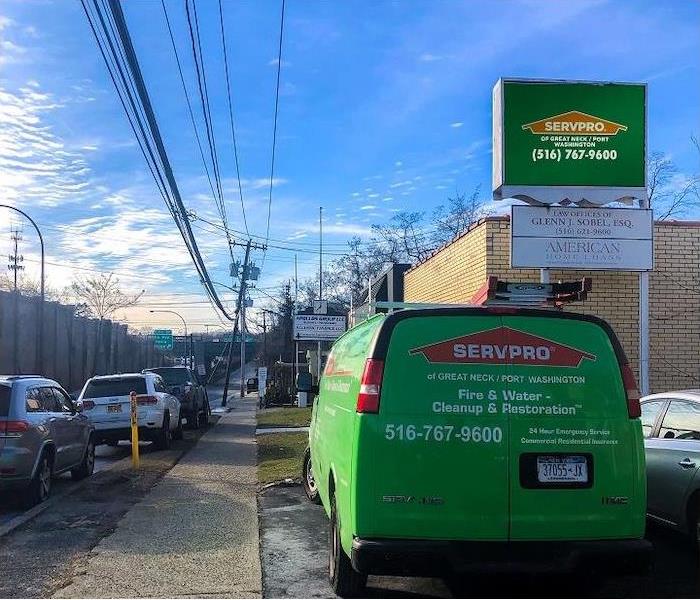 SERVPRO uses the latest technology and equipment for every mold remediation project in Great Neck. Call now for fast and immediate service.
SERVPRO uses the latest technology and equipment for every mold remediation project in Great Neck. Call now for fast and immediate service.
SERVPRO Uses Many Mold Damage Removal Techniques
SERVPRO professionals lead Nassau County in mold remediation and subsequent cleanup and repairs. Because mold can form so readily in the moist environments common to Long Island, it is a situation that many structures must face in their lifetimes. Property owners look to the expertise of our accredited technicians because we are:
- AMRT-Certified
- Experienced
- Fast-Responding
- Empathetic
Starting the cleanup and remediation of mold damage in Great Neck homes and businesses should begin as soon as possible. We understand the urgency of these scenarios and have enough trained AMRT specialists to dispatch required personnel 24/7 when threats arise and impact your property.
Evaluating the Extent of the Damage
We adhere to strict New York regulations regarding handling potential mold situations, the disposal of impacted materials, and the repairs and reconstruction necessary after recovery. This process begins with a third-party mold inspection team determining the severity of mold colonization in your home. Their recommendations on how to proceed then get passed to our SERVPRO professionals. We provide honest results that independent hygienists can test.
Types of Mold Damage Remediation
Because many types of mold can impact multiple kinds of hosting materials, there is no set solution for removal and remediation. We determine results from several factors like the severity of the damage, location, and the impacted elements. Some of the standard options considered include:
Our technicians' initial option is applying biocides such as chlorines to the organism. These products are often able to kill microbes on contact. This is only effective when the damage has not moved beyond the outermost layer of the impacted surface
- Abrasive Mechanical Action
Removing mold growth from the surface is often more than applying sporicidal products to the organism. Combining these efforts with sanding, steel wool, and other abrasive scrubbing helps amplify antimicrobial solutions.
Using forms of media like crushed walnuts, sodium bicarbonate, and other abrasives combined with pressurized air, SERVPRO professionals can eradicate active colonies without immensely damaging the affected substrate.
This is one of the final remediation measures but an effective strategy in removing active colonies and the impacted hosting material. Our license allows us to complete this work without requiring a secondary company.
Does Mold Damage Die-Off Naturally?
Combating misinformation about mold is one of the most challenging steps our SERVPRO AMRT-Certified remediators face. If microbial growth is left unchallenged, it can continue to spread and impact more of a residence until the situation is out of control.
When Are Mold Damage Repairs Needed?
Repairs are more of a common need for remediation than it might initially seem. The most definitive method of mold removal is controlled demolition, and while this is often a last resort compared to restorative measures, it comes with the need for build-back services. As a trusted team with a general contractor license, our SERVPRO professionals provide a full-service solution for post-mold recovery.
Mold damage in Great Neck homes and businesses should be handled more urgently than most property owners often show. As leading remediators for the area, we appreciate the necessary actions to protect a residence and its contents from irreparable damage. Give our SERVPRO of Great Neck / Port Washington rapid responders a call now at (516) 767-9600.
Mold Removal in Great Neck Ceiling Assemblies Requires Proper Drying
12/12/2022 (Permalink)
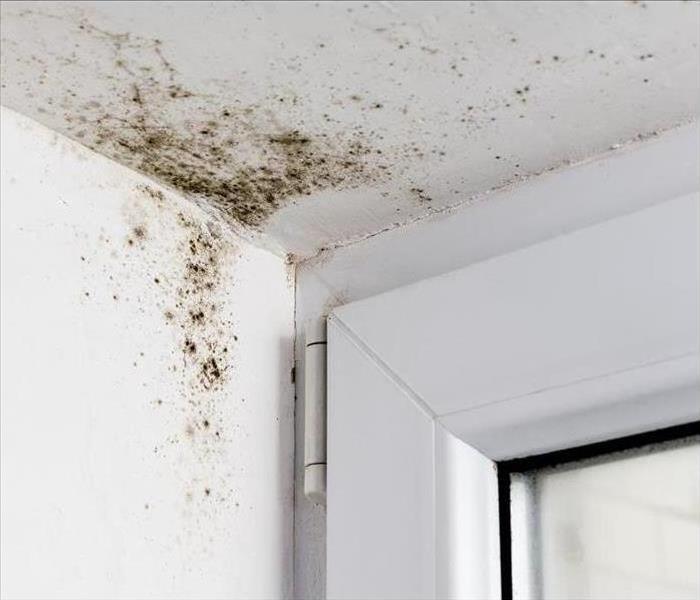 Trapped water in ceilings can lead to mold damage. Our IICRC trained team is always on call to remediate to the damage.
Trapped water in ceilings can lead to mold damage. Our IICRC trained team is always on call to remediate to the damage.
Remediating Mold Growth in Great Neck Ceilings
Water trapped within the ceiling and wall assemblies in buildings could be retained for an extended period as these assemblies directly impede airflow, consequently slowing the drying rate. The studs, plates, firestops, and drywall form sealed pockets within the structure, thus limiting air movement. Therefore, the possibility for a mold infestation rises since moisture and warmth are present.
Proper mold removal in your Great Neck home requires professional intervention. A small patch of colonies on the underside of your ceiling can signify significant colonization on the other side. If the small patch on the bottom is removed, but the rest is not dealt with, it simply grows back. Professionals such as SERVPRO can identify the presence of mold in such areas and advise on the right approach to prevent a comeback.
Signs of Mold on The Ceiling:
- Brown or gray discoloration
- A musty odor
- Visible mold growth, mostly dark green, brown, or black
How to Clean Ceiling Mold:
Professionals may face unique challenges when handling an infestation in the ceiling area, particularly in specialized building sections. For example, while a dedicated home theater room may be entertaining to a homeowner, it presents difficulties when there is an infestation due to the soundproofing materials used in the walls or ceiling. Or IICRC trained SERVPRO team checks a ceiling area for insulating material and whether it is salvageable.
Helpful Tools When Inspecting for Mold
- The borescope help explore concealed areas
- Thermal cameras reveal hidden moisture
- Hard tools like screwdrivers to probe surfaces
Removing the ceiling material can introduce a tremendous amount of mold spores into the indoor air; thus, containment is necessary. Mechanical drying techniques, such as dehumidification and air moving, are essential since air currents exponentially improve evaporation and drying. However, this ought to be done sparingly to avoid spreading debris.
SERVPRO of Great Neck / Port Washington helps to identify the right corrective actions for mold removal in your home. Call us at (516) 767-9600. We're Faster To Any Size Disaster.
Hiring Pro Flood Damage Repair After Great Neck Storms
11/8/2022 (Permalink)
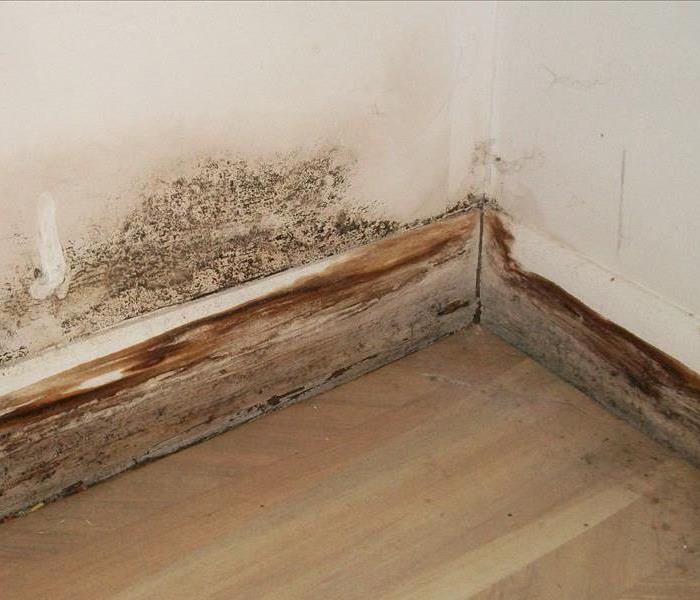 SERVPRO of Great Neck/Port Washington is here for you.
SERVPRO of Great Neck/Port Washington is here for you.
SERVPRO is Here 24/7 for Great Neck Properties with Flood Damage
You have plenty to remember daily as a homeowner, but you should also have a checklist of what to do in a weather-related emergency. Should your home encounter flood damage after recent storms in the Great Neck area, being prepared will help to cut down stress and eventual costs with restoration. Calling SERVPRO for emergency response and water removal services helps you recover faster and safer than any DIY cleanup method ever could. We’re Faster to Any Size Disaster.
Countless US homeowners get impacted by flooding each year, generating billions in repair costs and damage. If your Great Neck property suffers from flood damage, timing is everything. SERVPRO arrives fast and gets to work as soon as possible to limit contamination, thwart the onset of mold, and salvage your belongings and interior building materials.
What do I need to remember if I have flooding in my home?
- DIY methods leave your home vulnerable to hidden moisture, which translates into possible mold hazards, costly secondary damage, and structural concerns.
- Wood, rugs, drywall, furnishings, and other porous items become saturated with floodwater fast.
- Most floodwaters entering your interior will have various contaminants like vermin, feces, chemicals, silt, and more. It is best to have skilled restoration technicians handle containment, muck-out services, and water removals.
Our Green Fleet
SERVPRO arrives prepared at each flood damage project with truck-mounted extractors, drying equipment, dehumidifiers, and specialized cleaning agents. If your property suffered storm damage like a leaking roof, broken windows, and more, we also perform board-up and tarping services to protect your interior from the elements. Our crew also looks for hidden moisture throughout the project with the help of:
- Moisture detectors, sensors, and meters
- Borescopes
- Thermal imaging/infrared technology
No flooding event is too big for SERVPRO to handle. Call our team at SERVPRO of Great Neck/Port Washington at (516) 767-9600. We can send a crew out quickly to begin the repair and restoration process.
A Fire Has Destroyed Various Parts of My Manhasset Property. Where Should I Seek Help to Restore it?
9/14/2022 (Permalink)
 SERVPRO gives you access to expertly trained fire remediation specialists that put vast resources and years of experience to work for you.
SERVPRO gives you access to expertly trained fire remediation specialists that put vast resources and years of experience to work for you.
Hire SERVPRO Technicians in Manhasset to Handle the Fire Damage on Your Property.
After a fire, what follows can overwhelm property owners. However, taking action immediately by working with fire restoration professionals can halt further damage in your Manhasset home. SERVPRO professionals have the skills and expertise to restore homes after fire loss incidents of any size or scope.
How Can I Help in the Restoration Process?
Most homeowners might want to begin the restoration process and do what they can to make it efficient. However, handling fire damage in your Manhasset property using household cleaning agents can worsen the situation. You may smear the residues and cause them to seep further into the affected surfaces.
Therefore, it is essential to wait for restoration experts to handle the restoration process. We have the proper equipment, tools, resources, and products to restore building materials and items safely. You can help in the restoration process by setting salvageable items aside. That can enable our technicians to be more efficient during recovery.
Do I Need Professional Restorers After a Small Fire?
Regardless of the size of the fire, cleaning the smoke and soot residues is difficult without proper skills and equipment. Small fires can cause significant damage in a short while and leave persisting odor if not cleaned effectively. Also, soot and smoke residues can leave permanent damage if ignored for over 48 hours. SERVPRO’s team of technicians has decades of experience that help us restore homes in a brief period.
Do I Have to Move Out During Restoration?
This decision depends on the severity of the damage. If we find out that the structure is not stable, you should move out temporarily. However, if the fire only affected a small portion of the house, you can stay.
Which Items Should I Take When Moving Out?
We advise our customers to take personal or valuable items with them when moving out. They include items like:
- Personal documents
- Medications
- Family valuables and artwork
- Cash and credit cards
How do you Clean Smoke and Soot on Furniture and Shelves?
Furniture and shelves can be challenging to clean. However, our technicians can use mild detergents such as wood oil soap that do not contain harsh alkalis. We can use concentrated wood oil soap to clean your finished wood surfaces. We can apply the product to the no-wax floor finishes, leather, ceramic tile, countertops, and walls. After cleaning, we can polish the surfaces using an all-purpose wax polish. We can use furniture polish on your kitchen cabinets and furniture to provide more luster, shine, and protection.
Do not expose your family to the secondary damage of a fire. Contact SERVPRO of Great Neck / Port Washington today at (516) 767-9600 to restore your property quickly. We can make the fire loss appear “Like it never even happened.”
Fire Damage Restoration of a Charred Roller Rink in Great Neck
8/11/2022 (Permalink)
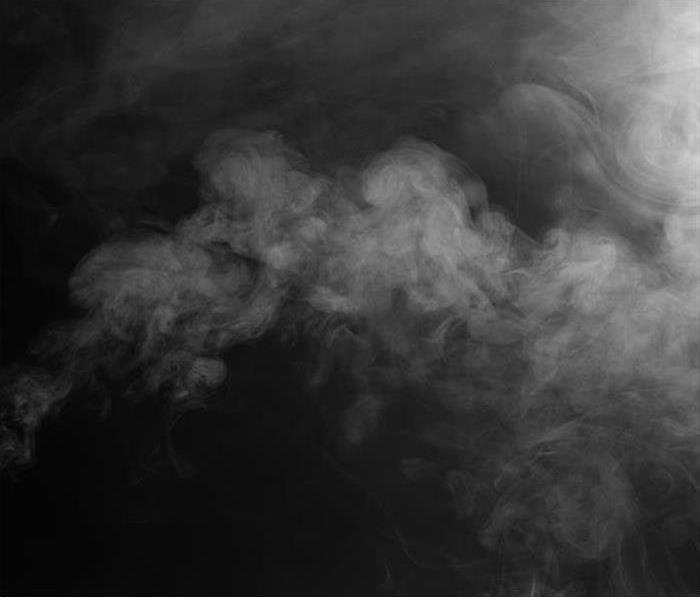 SERVPRO of Great Neck / Port Washington understands how important your business is. Let us help you out.
SERVPRO of Great Neck / Port Washington understands how important your business is. Let us help you out.
Arson or Smoking Leads to Fire Damage Restoration
Fire leaves structures of all sizes in need of fire damage restoration. Otherwise, businesses in Great Neck would sustain severe losses with a regular frequency. SERVPRO handles the cleanup and the rebuilding involved in a thorough restoration process. We scale our services to our customers’ precise situations, eliminating unnecessary procedures and costs.
Roller rinks are a long-standing icon that provides area youth with entertainment and exercise in an affordable way. When a rink gets fire damaged in Great Neck, fire damage restoration crews can reduce the time your facility can’t operate. SERVPRO’s crews know how to provide excellent results and make everything “Like it never even happened.”
Our crew wants to help you take a damaged area that looks hopeless and make it functional again with fire damage restoration work. We look at:
- Sheet metal fabrications,
- The ventilation system, and
- Open spaces and lounges.
Lockers are almost as crucial as bathroom stalls, but intense heat can cause these to warp. Paint can also bubble and require sanding and reapplication. We work with you to keep replacements down and restore the rest.
Getting all the soot out of your building is a must before reopening. Patrons do not want to smell foul scents nor breathe in soot particles. We clean HVAC systems and ensure they are now spreading soot and other particles. We set up air scrubbers to pull soot from the air, also. Thermal fogging can significantly eliminate the amount of soot released as it breaks down.
Skaters expect to have clean floors, and we can help. Carpet cleaning is an essential service, but we also perform sanding and buffing hard flooring. Our general contracting team can also help rebuild any damaged areas in any concrete section of flooring. Painting and rebuilding wooden structures are all part of how we help other businesses keep their doors open.
Rink owners and managers can call SERVPRO of Great Neck / Port Washington at (516) 767-9600 to get started with jobs ranging from smoke cleanup to entire building reconstruction.
How Can I Remove Water Trapped Behind My Manhasset Fireplace Built-In Bookcases?
8/11/2022 (Permalink)
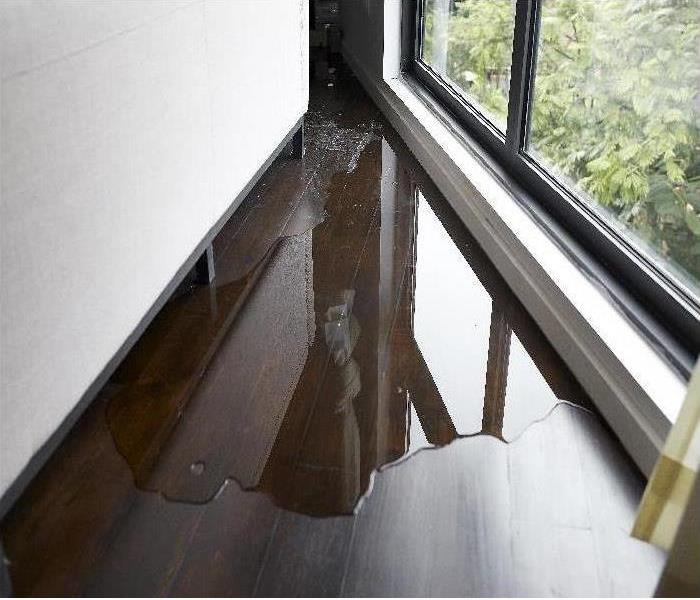 Count on the expertise of SERVPRO of Great Neck / Port Washington to solve challenging water damage scenarios.
Count on the expertise of SERVPRO of Great Neck / Port Washington to solve challenging water damage scenarios.
Research-Based Strategies at the Heart of Remediating Water Damage in Your Manhasset Home
Elegant, historic homes line the streets and estates in Manhasset, many featuring at least one fireplace framed by integrated bookcases and other beautiful woodwork. If the flashing, masonry, or brickwork around the top of the fireplace’s chimney develops leaking, the water can affect all building materials and fixtures below. Professional water removal and structural drying are a must to retain the integrity of your home.
My Books Are Wet! What Happened?
Water damage to Manhasset’s built-in shelves and bookcases is unexpected but always has a source, sometimes far away from the wet objects. Leaky roofs send water on rambling pathways through your home, and leaks near a chimney can permit moisture to percolate down several stories. You might hear dripping in the firebox or the lovely cabinets guarding each side of the fireplace absorb moisture. Books, china, and knick-knacks can all become wet while you scratch your head, trying to figure out why.
Are SERVPRO Crews Experienced in Chimney Leaking and Water Migration?
Our crew members master a comprehensive catalog of research-based best practices through the Institute of Inspection Cleaning and Restoration Certification (IICRC). SERVPRO is proficient at testing for water migration from the original leak to indirect damage or damage “upstream” to the leak. We use thermal imaging and moisture detectors and meters to map out the contours of the water incursion and gather data on where to focus extraction and structural drying.
How Do You Reach the Trapped Moisture that Is Damaging Fixtures and Personal Possessions?
Technicians look at the construction of the built-in shelving and cabinets, seeking the least disruptive way to remove toe kicks or baseboards to gain access to the interior. Often this shelving has bead-board as a backing which can be pried out to release water and allow for dry, warm air to reach wet materials to accelerate the evaporation of moisture. We try multiple approaches until one works.
Count on the expertise of SERVPRO of Great Neck / Port Washington to solve challenging water damage scenarios. Call (516) 767-9600 to schedule an assessment and planning session.
Your Home in Need of Mitigation from Structural or Cosmetic Damage? SERVPRO Provides Professional Remediation
8/11/2022 (Permalink)
 When mold appears on your property, you need to call the technicians at SERVPRO.
When mold appears on your property, you need to call the technicians at SERVPRO.
Great Neck Homeowners Rely Upon SERVPRO for Comprehensive Property Damage Cleanup, Restoration, and Repair
Restoration services are not something that Great Neck residences need every day, but having a reliable team of professionals to call 24/7 can make a difference in an emergency. From water and fire losses to mold and storm damage, we have qualified technicians trained to give you a positive and efficient response to your situation. In addition to remedial actions after loss incidents, we also have a full-service team of contractors to perform controlled demolition, emergency services, and full-scale reconstruction after our mitigation approach.
Mold
Inadequate management of water loss and flooding situations can lead to mold damage in Great Neck homes. These situations can also develop when humidity levels get above an acceptable threshold in the house, as well. From the time that this organism first gets discovered in your residence, the active spores are already reaching out for new host materials and spreading the threat to nearby surfaces. Assessing this migration and establishing a defense against it is one of our top priorities upon arrival. Remediation is unsuccessful when all of the active colonization does not get addressed.
Containment is a vital part of this process, as it can prevent the spread of these active spores and immediately convert the sealed area into a space our Applied Microbial Remediation Technicians (AMRT) can regulate. We can monitor air flow, filtration, drying efforts, and other factors that can reduce the severity of mold effects so that we can determine if controlled demolition is necessary for this damaged area of your Great Neck house.
We have a full-service team of general contractors that can remove wood, drywall, carpeting, and other susceptible materials. We assess the costs and time involved in other remediation strategies like soda blasting, sanding, the application of antimicrobial agents, and more before deciding on demolition. We use a combination of nearly all of these approaches to managing the microbial threat in Great Neck residences.
Water
Water loss incidents provide a quickly escalating damage situation for Great Neck homes that demand immediate attention. Even in the early scoping stages, where our management team works with customers to determine loss and pre-existing conditions, we must implement advanced tools and technologies to get readings throughout the property. We have moisture monitoring equipment capable of determining both the concentration and the location of dampness to establish the appropriate response to the migrating effects. This information is vital to prevent the water loss situation from getting worse.
From this initial scoping phase through every step of the restoration and potential reconstruction, our SERVPRO professionals document the drying and recovery process through our brand-specific DryBook software. This application can detail atmospheric conditions and the severity of water saturation through every affected portion of the house. This baseline for moisture content can help our team to gauge successes in drying and restoration while we work in Great Neck homes.
Through the manipulation of environmental conditions, we can increase the output and efficiency of our drying machines. We can regulate the temperature of a water-damaged space, the airflow through this portion of the property, and the placement and frequency of air movers and dehumidifiers to reduce the humidity that can slow the drying process. No matter how severe or widespread water damage in Great Neck homes might be, we can help.
Fire
One of the best reasons for our 24/7 availability is our faster response to provide emergency services in Great Neck homes after a fire loss. The purpose of these initial actions is to limit the continued destructive damages that can spread after extinguishment, including the migration of soot and smoke residues and the severity of noxious odors that can infiltrate construction materials and contents. We can utilize controlled demolition, advanced surface cleaning techniques, and preliminary deodorization to reduce the severity of conditions that allow for more straightforward mitigation and restoration work to follow.
We can take early action to protect your personal belongings from the threat of soot and smoke effects is to remove them with our pack-out process. Our content management team can oversee the safe packing and transport of lightly damaged or at-risk possessions to our nearby facility for focused cleaning, deodorization, and storage. We can prepare days in advance for their return to your Great Neck home after fire restoration to ensure that each removed item gets returned to its proper location.
Controlled demolition can help with soot residues and smoke odors, as this cuts into the restoration time when the materials are too severely affected to save. When installed elements can get cleaned and deodorized, we have advanced recovery solutions, from soda blasting and chemical sponges for soot to thermal fogging and hydroxyl generators for odors. We have the experience and equipment to help you through even challenging fire loss situations in Great Neck residences.
Storm
Waiting for any recovery project is ill-advised, especially when your home has suffered from severe weather systems. In Great Neck, powerful storms can move quickly through the area, causing structural vulnerabilities that water and runoff from the storms can use to get inside the property. Our SERVPRO professionals have dedicated restoration services ready to mobilize 24/7 because We’re Faster To Any Size Disaster. The emergency building services we can provide can stop the intrusion of floodwater so that our team can effectively deploy mitigation strategies to begin drying the house.
Though we have fast extraction solutions, including dedicated electric submersible pumps and self-priming trash pumps for continual water removal, we also have advanced drying techniques designed to protect the belongings of your Great Neck home amid flooding. Standing water can be devastating to essential documents, books, and records. Still, our freeze-drying technology can help to preserve these items on-site.
We focus on reducing loss during flood damage to Great Neck homes, which can often start with the movement of at-risk contents. Our technicians can store some undamaged belongings on-site in a dry area, while others must get packed up and transported to our nearby facility for drying, deodorization, disinfection, and storage in our climate-controlled facility.
No matter what threat your home faces, you can count on the experience of our SERVPRO of Great Neck / Port Washington team. We can arrive quickly to help make loss incidents “Like it never even happened.” Give us a call today at (516) 767-9600.
Storms Can Bring Unwanted Water to Manhasset Properties--Swift Removal by SERVPRO Mitigates the Damages
7/17/2022 (Permalink)
 Team SERVPRO can help with many aspects of the storm damage that affected your home including providing information for the insurance company.
Team SERVPRO can help with many aspects of the storm damage that affected your home including providing information for the insurance company.
Preparing for Flood Recovery in Your Manhasset Home
Because so many decisions can shape the speed and efficiency of professional flood restoration efforts in Manhasset homes, we rarely begin full-scale mitigation without a thorough assessment of a property and its damages. We always provide our customers with a detailed plan of attack. Our project manager and crew chief work alongside customers and possibly insurance providers to determine how extensive and severe water loss has become.
Part of the scoping process takes shape around the presence of moisture and standing water. To address flood damage in Manhasset homes, there are necessary steps our SERVPRO technicians must take. We notate the concentration and positioning of floodwater beyond the surface damage. Our estimator utilizes detection tools like probing moisture meters, infrared thermography, and other advanced technologies. Each potential problem gets documented of what to address when proper mitigation and restoration work starts.
Exclusive software allows SERVPRO to organize better information we collect about the floodwater during the initial inspection and assessment. Environmental and atmospheric readings get recorded in a pre-job log. These readings set the bar for the success of later drying and moisture removal efforts. Establishing baselines ensures when we reach targeted goals, the structure dries to standard levels. Our documentation also notes areas of the house that were damaged before the flooding occurred. That way, technicians can focus on returning the property to preloss conditions.
One of the most significant preparation measures we take is coordinating efforts with your insurance company. While not all residents have flood insurance, the preliminary cleaning and emergency services provided by our team may be covered under your general policy headings. We communicate directly with your provider to keep restoration costs as low as possible before work officially begins. Though we are not in the insurance industry, we interface with adjusters to help simplify claim forms.
Several steps are in place to offer our customers the most efficient and well-designed flood restoration possible for their individual property. No matter when these losses occur, our SERVPRO of Great Neck / Port Washington team tries to make it “Like it never even happened.” Call us anytime at (516) 767-9600.
Fire Damage In Your Great Neck Home
7/17/2022 (Permalink)
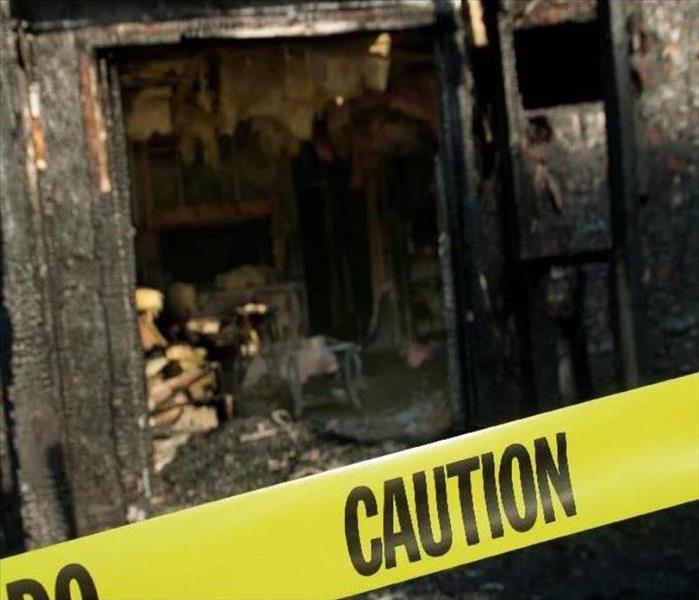 When your home has fire damage, there is a great urgency to get it back to like it was before. Contact SERVPRO to assess and remediate the damage.
When your home has fire damage, there is a great urgency to get it back to like it was before. Contact SERVPRO to assess and remediate the damage.
Efficiently Restore Your Great Neck Home to Like-New Condition After Suffering Fire Damage
A range of emotions come over you the moment that you set your eyes upon the devastation after a house fire. The interior of your home is left with a pile of saturated possessions from extinguishing the fire, and all of the debris is charred and dirty. SERVPRO understands how important it is for you to get your home back to normal, so we employ the use of a variety of tried-and-true methods and start working quickly.
Once we arrive at your property to clean up fire damage in Great Neck, we assess the overall fallout from the fire to put into motion the best steps to take for cleanup and restoration. Charred building materials and personal belongings get moved out, and everything is examined thoroughly to determine what is salvageable and what is not.
Inspection
Skilled SERVPRO technicians go through fire loss areas of your home, looking for all salvageable items. Porous materials have the least chance of restoration due to high soot and smoke absorption levels. Non-porous materials have a high salvageability rate, especially with the use of our advanced cleaning methods.
Cleaning Methods
The process for cleaning up fire damage is unique to every situation, so there is no such thing as a one-size-fits-all approach. Technicians test items and surfaces to determine the proper cleaning agents and methods to provide the best results for soot and smoke residue removal. We also provide pack-out services with full cleaning at our facility with a process known as immersion cleaning.
Immersion is a cleaning method for non-porous items that utilizes high-frequency sound waves that generate millions of bubbles that scrub and agitate all contaminants from contents placed within the tank. We also provide wet cleaning, dry cleaning, foam cleaning, and abrasive cleaning based on the contents and the level of residue removal required.
Repairs
After the cleanup of the fire loss event is complete, SERVPRO compiles a report assisting you with filing the claim with your insurance provider. This report includes all restoration actions taken as well as the suggested repairs to complete the restoration process fully. With such attention to detail, SERVPRO technicians save you the stress of having to take care of these details at such a difficult time.
Call us whenever you require fast, efficient help with fire damage to your home. You can reach the team at SERVPRO of Great Neck / Port Washington by calling (516) 767-9600.
Great Neck Businesses – Don’t Wait to Handle Water Removal
7/17/2022 (Permalink)
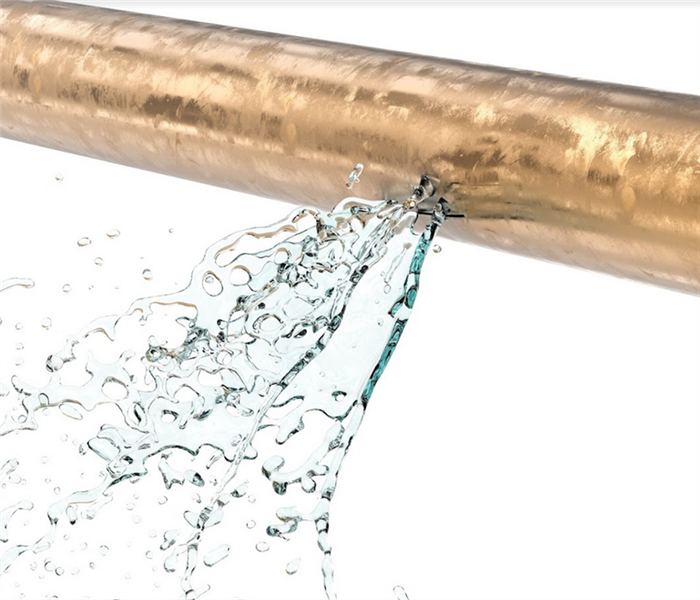 When a pipe bursts in your commercial kitchen or bathroom, the damage can certainly seem overwhelming. Contact SERVPRO for effective water removal.
When a pipe bursts in your commercial kitchen or bathroom, the damage can certainly seem overwhelming. Contact SERVPRO for effective water removal.
SERVPRO Water Removal and Restoration to the Rescue in Great Neck
It would be best to keep everything running smoothly, no matter what business you have; factory, retail space, rental property, bakery, or another commercial space. The last thing any Great Neck business owner wants to deal with is water damage from a sewage backup in the employee bathroom, a burst pipe leading to a commercial kitchen, etc. Rather than turning away customers or causing stress from having to clean it up with your staff, SERVPRO is there to ensure you have as little disruption as possible. We’re here 24/7 to provide area customers with the rapid water removal services they need!
SERVPRO is locally owned and operated, so we know how important it is for area businesses to handle water removal in Great Neck before it hurts their bottom line. We respond quickly to begin water mitigation efforts, so your bakery, office, or factory sees little or no downtime.
Addressing areas of moisture migration
Water follows along the path of least resistance into dry spaces. This means our team carefully inspects areas under cabinetry, office partitions, and around equipment to ensure no moisture is left to fester. Areas we look at include:
- Moisture bogged drywall or ceiling tiles
- Contents in the water loss zone exposed to moisture
- Possible hazards with slip and fall or electrical outlets
SERVPRO’s water restoration technicians (WRT) clean up all unsalvageable debris for safe disposal. We initiate drying with air movers and dehumidifiers as all standing water gets pulled up with pumps, extractors, or wet/dry vacuums. Our restore versus replace methodology also helps you to save time and money on your restoration. We even handle your paperwork, so you have the proper documentation for your commercial water loss insurance claim!
There is no better team to have in your corner for commercial water removal than SERVPRO of Great Neck/Port Washington. Contact us 24/7 to mobilize our Green Fleet at (516) 767-9600.
Professionals Should Handle Water Damage Repair in Great Neck
6/11/2022 (Permalink)
 From Great Neck water damage cleanup and restoration through the build back--SERVPRO has your back.
From Great Neck water damage cleanup and restoration through the build back--SERVPRO has your back.
Great Neck Water Damage Done Right
Water from leaks can disrupt your daily routine and damage your home. After a water intrusion incident, you need an experienced water restoration firm to deliver custom cleanup and restoration services.
SERVPRO can perform water damage repair on your Great Neck property. We know that time is a critical factor when recovering from water damage. That’s why we provide emergency response services around the clock.
You can count on SERVPRO to deliver high-quality work as a reliable water damage restoration firm. We can design a customized recovery and restoration plan for your home. Our water damage repair services may include the following steps:
- Finding and stopping the leak
- Water removal
- Drying and dehumidification
- Cleaning and disinfection
- Repairs and reconstruction
Finding and stopping the leak
Water can find its way through your residence’s walls, floors, ceilings, furniture, and other structures and contents. Our team can locate the leak and stop it.
Water removal
Effective water cleanup involves removing excess water from your home as fast as possible. Suppose the standing water in your property is two inches or deeper and does not have solid materials. In that case, we can extract it using submersible pumps with adequate volume capacity and lift capability.
Drying and dehumidification
Mold infestation can occur quickly in humid and damp conditions. Our SERVPRO technicians can implement a drying and dehumidification strategy to restore your home to a preloss state. We can use air movers to increase evaporation at the surface level and dehumidifiers to eliminate moisture from the air.
Cleaning and disinfection
Microbes can infest your property following water damage and degrade it. SERVPRO’s water damage cleanup technicians clean and disinfect the affected areas.
Repairs and reconstruction
After performing water removal, drying, and dehumidification, we begin the repairs and reconstruction phase. We can perform repairs like replacing damaged drywall or wood flooring or even a full-scale reconstruction of damaged areas.
It is normal to feel overwhelmed after an unexpected water leak in your home. You can trust SERVPRO of Great Neck / Port Washington to repair your property when that happens. Contact us at (516) 767-9600.
Deodorizing Your Home in Great Neck After a Fire
6/11/2022 (Permalink)
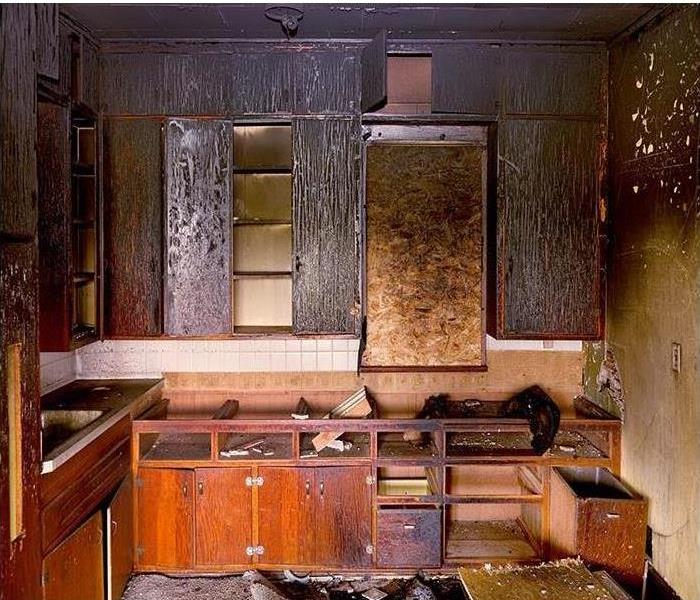 Pungent Protein fires after a kitchen blaze in Great Neck need professional restoration for good indoor air quality--Call SERVPRO
Pungent Protein fires after a kitchen blaze in Great Neck need professional restoration for good indoor air quality--Call SERVPRO
After Fire Damage to Your Great Neck Home
Fires can occur any time of year but can be more of a challenge during a cold New York winter. When the temperature outside quickly cools the contents of your home, it may be more challenging to recuperate afterward if the thick smoke residue settles throughout the structure. It is crucial to deal with the aftermath of a fire quickly and expertly to ensure your home and its contents are restored to their pre-fire condition.
If you are dealing with fire damage in your Great Neck home, contact SERVPRO immediately and have our trained technicians create a restoration plan specifically to suit your situation. Attacking odors after a fire can be one of the most challenging aspects of restoring your home.
Technicians remove valuable contents to have them cleaned by specialists or to ensure that smoke odors do not penetrate further into porous surfaces. After removing of contents, the SERVPRO team searches for the source of the smoke odor. Typically, it is wherever the fire started within the home. The team removes the appliance or heat source that originally emanated the offensive odors; this way, no remaining odors are coming from the source.
Odor Removal
SERVPRO technicians often use thermal foggers to dispense solvent-based deodorants. The deodorants go through a heated area in the machine that combusts the solution, breaking it down into microscopic particles that can disburse anywhere throughout the home. These one-half micron-sized particles pair with the offensive odor, neutralizing it by changing its composition. During the fogging process, technicians wear personal protective gear and make sure that residents, pets, and plants are not in the home. Residents may return to the home after the fogged area airs out, and it is easy to breathe.
Another deodorization technique is vapor odor control. The goal here is to attack vapors found within the air. Technicians release products created to release deodorant vapors into the air, counteracting the malodor vapors upon contact. Vapor odor control and thermal fogging work together to combat odors since SERVPRO technicians use a combination of techniques.
SERVPRO of Great Neck / Port Washington is available to assist 24/7 after fire damage. We’re Faster to Any Size Disaster. Contact us at (516) 767-9600.
Swift Mold Remediation Is Vital for a Great Neck Warehouse
6/11/2022 (Permalink)
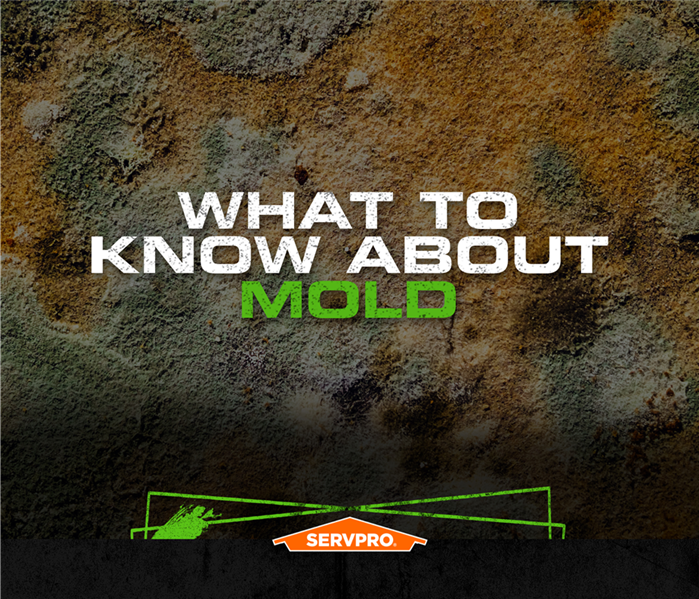 Don't Let Mold close down your Great Neck warehouse. Call SERVPRO for remediation. Our business is to keep you in business.
Don't Let Mold close down your Great Neck warehouse. Call SERVPRO for remediation. Our business is to keep you in business.
The Great Neck Business Community Needs Mold Remediation in a Hurry
SERVPRO understands how easy it is to overlook a little fungal growth in a Great Neck warehouse. It does not seem like a big problem, so you decide to take care of it later. However, it is never a good idea to leave fungal growth untreated.
If you see signs of fungus, that means you need mold remediation in your Great Neck warehouse. What seems like a small patch of mold had the potential to release two kinds of compounds into the air. The first type of compound is mycotoxins. The other type of compound is microbial volatile organic compounds (mVOCs). Molds produce mVOCs when actively growing, and the mVOCs can produce unpleasant moldy smells.
Why is it better to act sooner rather than later?
Many species of mold are fast-growing. When you see a patch of mold, it means:
• The fungus has already formed a network of cells known as mycelium
• The mycelium is consuming the substance it is growing on
• The mold is in a growing stage and is capable of producing spores, which can travel and settle elsewhere in your warehouse
Damage to stored cartons, inventory, and equipment can occur with mold proliferation.
Is it possible to prevent spores from spreading?
Mold spores are microscopic, which makes stopping them a challenge. However, our team can:
• Set up containment around the affected area to discourage spores from spreading (poly sheeting)
• Use negative air machines to prevent the flow of contaminated air into uncontaminated areas
• Use HEPA filters and air scrubbers to capture mold spores
We remove visible fungi and deodorize the area to leave your business Certified: SERVPRO Cleaned. We understand that you need to get back to business as soon as possible, which is why We’re Faster To Any Size Disaster.
Act quickly to prevent a mold problem from getting worse. Call SERVPRO of Great Neck / Port Washington at (516) 767-9600.
Water Damage In Your Manhasset Home
5/15/2022 (Permalink)
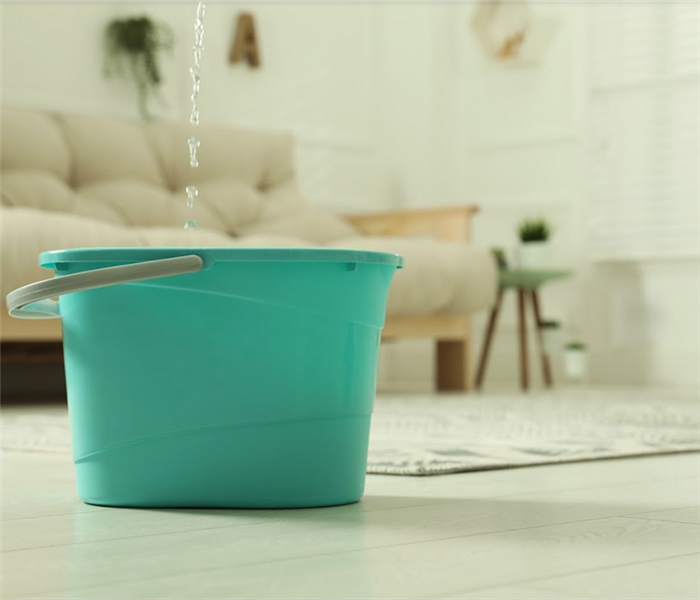 When a pipe bursts behind walls, excess water can quickly cause water damage. Contact our team to investigate the cause and then formulate a plan.
When a pipe bursts behind walls, excess water can quickly cause water damage. Contact our team to investigate the cause and then formulate a plan.
How We Handled Different Materials after Water Damage in a Manhasset Home
Water loss incidents can happen any time originating from any part of the home, including the obvious ones such as the bathroom or kitchen, but sometimes it starts from unexpected areas. For a homeowner in Manhasset, a pipe in the wall leaked at the joint, releasing gallons of water into the living room and spreading to other sections of the property affecting various materials.
Wet Carpet
Like in other water damage incidents in Manhasset, the water leaking from the walls collected on the floor, posing a significant threat to the floor materials. The sections with tiles could withstand exposure, but carpeted areas were more vulnerable to different issues, including matting of fibers, staining, delaminating, and even mold if left submerged for days. Our SERVPRO technicians opted to remove the carpet for better drying and to access the pad, which was unsalvageable.
Baseboards
Before removing the carpet, there was a need to remove some fixtures such as the baseboards and door trims, which would hinder the convenient or safe removal of the carpet. The trim is salvageable after water damage, so there is a need to remove it without causing damages. The good news is that it requires simple tools such as pry bars and crowbars to accomplish this, and our SERVPRO IICRC-certified technicians bring assorted tools in our production vehicles to every loss site. Other tools like knee kickers and carpet awls proved handy in dislodging the carpet faster once the baseboards and other trims were out of the way.
Engineered Wood
Despite our best effort, some materials could not be saved since they have adverse reactions when exposed to significant amounts of water. At the house, there were fixtures such as closets made of engineered wood affected by the water. Luckily, we could pry off the bottom panels using toe-kick removal without affecting other parts of the fixtures.
Saving materials affected by water damage is crucial. Call SERVPRO of Great Neck / Port Washington at (516) 767-9600 to help. We’re Faster to Any Size Disaster.
Our Experts Discuss Cleaning Grout After A Flood In Great Neck
5/15/2022 (Permalink)
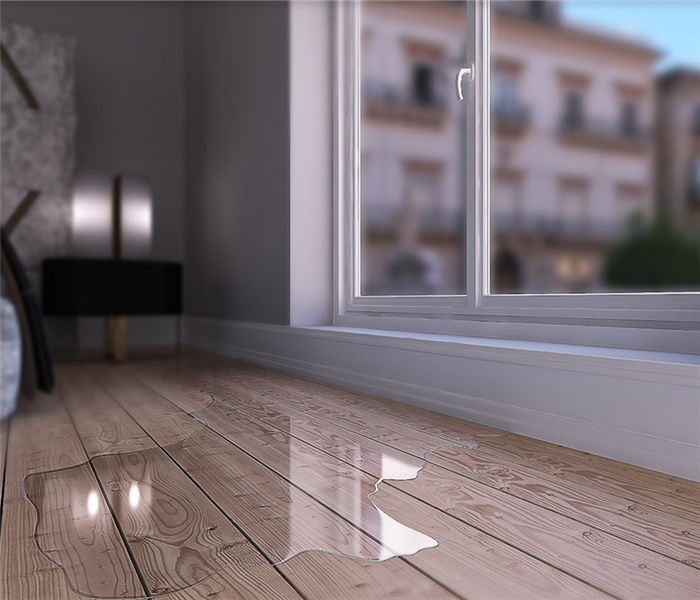 Regardless of how the flooding entered your home, team SERVPRO can help. Contact our technicians for storm damage remediation efforts. Call 24/7.
Regardless of how the flooding entered your home, team SERVPRO can help. Contact our technicians for storm damage remediation efforts. Call 24/7.
Flood Damage Experts In Great Neck Discuss Cleaning Grout
When a severe thunderstorm strikes the Great Neck region, there is a chance that water could find its way into your residence. Once moisture coming from the outdoors enters the interior of your home, you may be forced to contact a professional restoration company such as SERVPRO. Water coming from outside can bring other things into your house with it, including dirt and possibly contaminants like harmful parasites, bacteria, and fungi.
When dealing with flood damage situations in Great Neck, our SERVPRO technicians treat the situation as either a category two or category three scenario. Category two problems deal with what is considered "grey" water because there is a chance that it is contaminated. For example, if the source of a leak is a kitchen sink or rainwater coming from the outside, it is possible the water contains harmful microorganisms because the source is not clean or freshwater. Moisture-related issues that are caused by muddy water or a leaky toilet get labeled as "black" water and most likely do have some amount of harmful microorganisms inside them, so they get classified as category three problems.
Whenever liquid H2O that builds up outside after a storm finds its way into your structure, it can bring in large amounts of dirt with it. Once the moisture that got onto your tile floors dries, the dirt can settle and leave your tile and grout soiled. In most cases, tile can be cleaned by mopping or scrubbing with a detergent and squeezing it into a floor drain.
However, cleaning the grout that sits in between each tile can involve specific chemicals and techniques. Whenever our SERVPRO team cleans grout, we start by applying an alkaline cleaning solution. For small areas, we can apply the detergent with a tile and grout brush. When working with larger spaces, we can use a rotary floor machine to apply and agitate the alkaline cleaning compound.
Next, we can rinse the affected area with a mop and a chemical called Bright-N-Neutral. After that, we can apply an acidic cleaning agent like a tile and grout cleaner to reduce any blotchy areas. We then can rinse the affected area again before cleaning it with the alkaline compound a second time to counteract the etching caused by the acidic detergent.
Cleaning stained grout after storm-related damage can be a chore that is best handled by the pros. For professional assistance after a storm wreaks havoc on your property, call SERVPRO of Great Neck / Port Washington at (516) 767-9600 24/7.
Going Through Commercial Water Removal in Great Neck
4/27/2022 (Permalink)
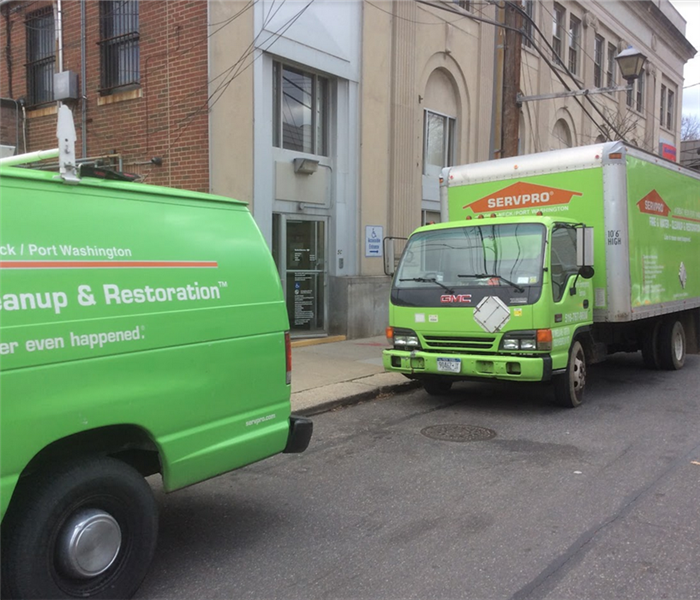 Regardless of the size of your boutique, dealing with any type of water damage can present issues. Call our experienced SERVPRO team for solutions.
Regardless of the size of your boutique, dealing with any type of water damage can present issues. Call our experienced SERVPRO team for solutions.
Water Removal and Remediation In Great Neck Boutique After Water Leak
Walking into your boutique and seeing that you've had a water leak can be devastating. The first thought on your mind is to protect your merchandise. With this in mind, wet items should be removed, cleaned, and dried. At the same time, you should transfer unaffected items to a safe area to keep them dry and unexposed to cleaning solutions and higher relative humidity (RH).
When faced with commercial water removal in Great Neck, first you consider your merchandise, then contact the insurance company. Next, you need to remove the excess liquid from the impacted floors and bring down the RH within the structure to ensure you avoid secondary damage like excess humidity condensing on and ruining electronics or warping wallpaper.
SERVPRO restoration technicians remove excess water by using portable extractors. Tile and wood floorings usually can repel water and not suffer damage if caught quickly enough. If the water stood for any period, and there are cracks in the wood or tile grout is not sealed correctly, water may seep through flooring and become more challenging to extract. However, technicians strategically place air movers to blow dry air over the surface while dehumidifiers draw moisture out of the air and exhaust warm, dry air, effectively dry the flooring.
Sometimes portable electric heaters speed up the process by blowing warm air over the flooring. SERVPRO team members can contain the affected area by placing 6-mil plastic over the floor, holding it down with sandbags or painters tape while the heated air balloons up the plastic, keeping the covered space warm and dry. This “tenting” action concentrates the air movement to a targeted area to maximize the effectiveness of the drying. Technicians monitor the electric heaters carefully throughout the heating and drying process to ensure the floor is not overly-dry, which can create further damage.
If there are carpeted areas in your boutique, technicians may opt to use deep extraction tools that are self-propelled or stationary. These tools use body weight to compress the carpet and pad, squeeze out excess water, and then remove the water through extraction equipment.
It is essential to bring down the interior humidity to below 60%, so your merchandise is not exposed to potentially damaging rusting or contamination to the beauty products.
We understand the need to keep your clients’ scheduled appointments. Weddings and special occasions cannot be postponed, so we do our best to complete the cleanup and water removal as quickly as possible. We must live up to our slogan. We’re Faster To Any Size Disaster.
For assistance, contact SERVPRO of Great Neck / Port Washington 24/7 at (516) 767-9600 to keep your doors open for business.
Mold Infestations Can Damage the Home of Great Neck Residents
4/22/2022 (Permalink)
 If mold has affected your family home, you need a fast solution. Contact SERVPRO right away for an effective assessment and mold damage remediation.
If mold has affected your family home, you need a fast solution. Contact SERVPRO right away for an effective assessment and mold damage remediation.
SERVPRO of Greatneck / Port Washington Can Provide Expert Advice and Guidance on Remediating your Home from Mold Infestation
On the Southeast of New York State is Great Neck, a small town on Long Island. The island is home to some of the most prominent business leaders, thinkers, and writers in the United States. The Gold Coast Mansions are a regular tourist attraction alongside the boardwalks, wineries, and, of course, the Long Island Iced Tea, which has a heritage dating back to prohibition America. The island expands over 100 miles along the coast and comprises four counties: Sussex, Nassau, Kings, and Queens. Great Neck is situated in Nassau County, which has 1,339,532 residents. Great Neck itself is a smaller village community of under 10,000 people. Despite its small size, the town is affectionately known as the 'old village,' which has a rich history and heritage. The proximity of Great Neck to New York City makes it an ideal suburban getaway for those moving out of the big city.
While Great Neck has fewer tourist destinations than its neighbors, there remains a rich history with some buildings like the Saddle Rock Grist Mill dating back to the 18th century and listed with the Register of Historic Places. Crampton Avenue, the Wychwood Apartments, and Barstow Road are fantastic architectural examples of modernist, art-deco design during the pre-war boom in the early twentieth century. Kings Point represented the more affluent Great Neck region and was immortalized in Scott Fitzgerald's seminal novel The Great Gatsby. This region is also home to the United States Merchant Marine Academy (USMMA) and Kings Point LightHouse. Typically training for US servicemen and women covers marine engineering, maritime law, international customs, and many other disciplines available for the USMMA's Midshipmen.
Great Neck's two high schools are among the top 100 in the United States. The Great Neck North High School was commemorated after John L. Miller, a Havard Doctorate who was a distinguished superintendent for the Great Neck School system. After serving the school system for 28 years, the North High School was renamed in his honor and has carried his name from 1970 onwards. The building was constructed in 1926 on Polo Road and is a shining example of the Collegiate Gothic style in vogue during the early twentieth century. Architects Guilbert and Betelle designed Great Neck North alongside hundreds of municipal buildings in New Jersey, New York, and Pennsylvania. Gifted students are frequently picked up by the Intel innovation program, while famous alumni include Nobel prizewinner David Baltimore and screenplay writer David Seidler.
- The village of Great Neck has a diverse community of people with wealthy residents situated in the North at Kings Point but pulls many families from all over the US and the world thanks to its excellent public school system.
- The Gold Coast Arts Center on Middle Neck Road is a not-for-profit organization that runs international film festivals, performances, an art gallery, and educational outreach. The organization has strong ties with Great Neck Village alternative schools and supports art in education programs throughout the year.
- Great Neck Plaza on Bond Street is a downtown shopping district with over 250 shops and restaurants catering to boutique tastes and fine-dining experiences. The plaza was created as far back as 1930 and is close to Long Island Railroad's Great Neck Station. The proximity to the rail station gave the plaza a reputation for boutique, upscale and diverse products.
- Walter Chrysler of the automotive industry initially owned stepping stone Park. The 12.8-acre public park has docks for boating, picnic areas as well as a selection of gardens. During the summer months, Steppingstone plays host to music concerts that cover popular music, philharmonic orchestras, jazz, and theater production.
Commuting from Great Neck
- Great Neck is connected to New York and New Jersey via the Long Island Railroad, which carries 354,800 passengers weekly. The rail system was initially set up as early as the nineteenth century.
- The average commute time from Great Neck to Manhattan is between 25 and 35 minutes. The four counties of Long Island are connected by the Inter-county express, which allows fast transport between Great Neck and Queens.
- Great Neck Station is on Middle Neck Road, serves the Port Washington Branch, and has been running in its current incarnation since 1898. Fitzgerald referenced the station as West Egg in The Great Gatsby.
How Can SERVPRO of Great Neck / Port Washington Help Remediate your Home from Mold Growth
Microbial organisms thrive in warm indoor environments. Microscopic spores can quickly reproduce under moisture and spread from one area of the home to another. Many methods for remediating mold issues involve aggressive agitation that aims to detach the hyphae- small parts of the organism that penetrate surfaces- from the material. In some situations, aggressive agitation can lead to microscopic mold spores becoming airborne. These airborne spores are microscopic and can spread throughout the home while remaining invisible to the naked eye. When clearing a house with mold, it is vital to set up professional containment in the affected area to control the problem's source. SERVPRO IICRC-certified technicians have expertise in analyzing and remediating moldy materials to prevent cross-contamination.
- Our technicians can cordon off areas of the home using plastic sheeting. These areas can allow for decontamination of equipment, clothing, and personnel during the mold damage restoration process in Great Neck.
- Negative air pressure machines can be used in an indoor environment to capture any airborne spores resulting from sand or soda blasting. These filter microscopic spores from the indoor climate and prevent spreading.
- Any infested materials can be double sealed in biohazard waste bags for disposal at a designated waste facility once your home is correctly remediated. We can remove any non-salvageable materials and replace them with clean building assembly.
Containing mold during remediation is essential to the proper removal and remediation of the issue. Contact SERVPRO of Great Neck / Port Washington at (516) 767-9600.
Drying Unfinished Flooded Basements in Great Neck Homes
4/17/2022 (Permalink)
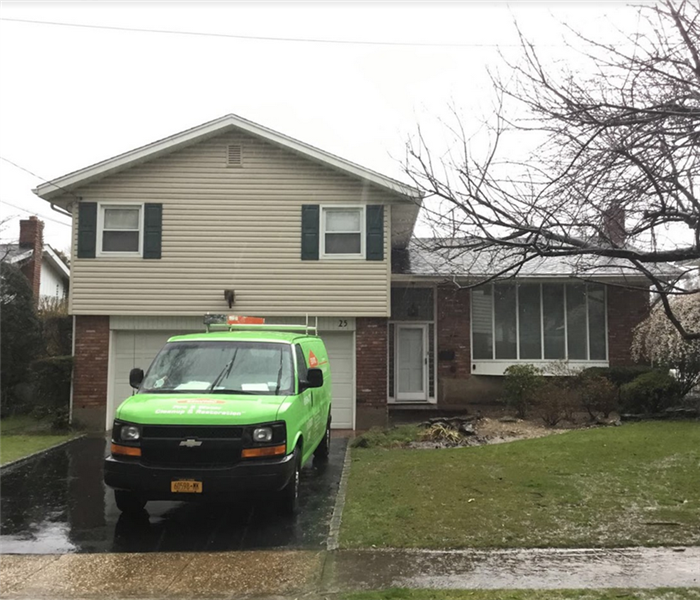 Flooded basements can quickly cause damage to the contents and structure of your family home. Contact SERVPRO for a fast response 24/7.
Flooded basements can quickly cause damage to the contents and structure of your family home. Contact SERVPRO for a fast response 24/7.
Drying Flood Damage in Great Neck Basements Requires Direct Action
Effectively drying flooding from the lowest levels of your property is a considerable undertaking. Even without substantial standing water concerns, the exposure to potential contaminants requires a delicate approach to protect the structure and its occupants as much as possible.
Scoping the Water Damage
Flood damage in Great Neck homes can be overwhelming and threatening to the household if not rapidly managed. Management works fast to determine the extent of the flooding and what specific efforts are necessary to restore and mitigate loss. Inspections determine:
- Depth of water penetration
- Size of work area
- Needed tools and approaches
Centrifugal Air Movers
One of the fundamental tools of effective drying and restoration is the air mover. Centrifugal air movers, specifically, target moist surface materials and penetrate the cooling barrier created by the drying process. Blasting warm, dry air at materials continues to eliminate trapped water in porous elements like drywall.
Low-Grain Refrigerant Dehumidifiers
Several drying units are necessary to achieve full evaporation and moisture removal of the affected basement after flood damage. While air movers play a significant role in the elevations of relative humidity for this room of the house, the application of dehumidifiers regulates the successes of air movers by extracting the moisture from the environment and exhausting it outside.
Fixing the Structural Damages
Yet another consideration is the structural repairs necessary after flood damage exposures. Unfinished basements often feature exposed subflooring for the main level of the house and framing for rooms that were never installed or intended to be further structural support for the residence. After direct contaminant exposure, our licensed contractors must remove and replace these.
Flooding in the basement of your residence requires many powerful processes to restore. As trusted restoration and recovery professionals for Nassau County, we can arrive fast to help clean up and dry impacted basements after flooding situations of all types. Our SERVPRO of Great Neck / Port Washington team is ready to help 24/7 at (516) 767-9600.
Water Damage In Your Manhasset Home
3/21/2022 (Permalink)
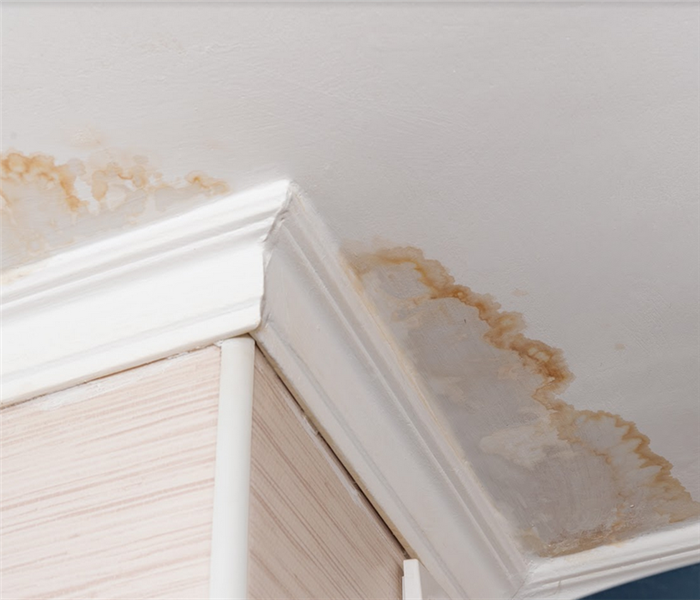 Whether water damage affects your home from above or below, team SERVPRO can remediate. Contact our technicians 24/7 - 365 days a year.
Whether water damage affects your home from above or below, team SERVPRO can remediate. Contact our technicians 24/7 - 365 days a year.
How We Handled Different Materials after Water Damage in a Manhasset Home
Water loss incidents can happen any time originating from any part of the home, including the obvious ones such as the bathroom or kitchen, but sometimes it starts from unexpected areas. For a homeowner in Manhasset, a pipe in the wall leaked at the joint, releasing gallons of water into the living room and spreading to other sections of the property affecting various materials.
Wet Carpet
Like in other water damage incidents in Manhasset, the water leaking from the walls collected on the floor, posing a significant threat to the floor materials. The sections with tiles could withstand exposure, but carpeted areas were more vulnerable to different issues, including matting of fibers, staining, delaminating, and even mold if left submerged for days. Our SERVPRO technicians opted to remove the carpet for better drying and to access the pad, which was unsalvageable.
Baseboards
Before removing the carpet, there was a need to remove some fixtures such as the baseboards and door trims, which would hinder the convenient or safe removal of the carpet. The trim is salvageable after water damage, so there is a need to remove it without causing damages. The good news is that it requires simple tools such as pry bars and crowbars to accomplish this, and our SERVPRO technicians bring assorted tools in our production vehicles to every loss site. Other tools like knee kickers and carpet awls proved handy in dislodging the carpet faster once the baseboards and other trims were out of the way.
Engineered Wood
Despite our best effort, some materials could not be saved since they have adverse reactions when exposed to significant amounts of water. At the house, there were fixtures such as closets made of engineered wood affected by the water. Luckily, we could pry off the bottom panels using toe-kick removal without affecting other parts of the fixtures.
Saving materials affected by water damage is crucial. Call SERVPRO of Great Neck / Port Washington at (516) 767-9600 to help. We’re Faster to Any Size Disaster.
Deodorizing Your Home In Great Neck After A Fire
3/16/2022 (Permalink)
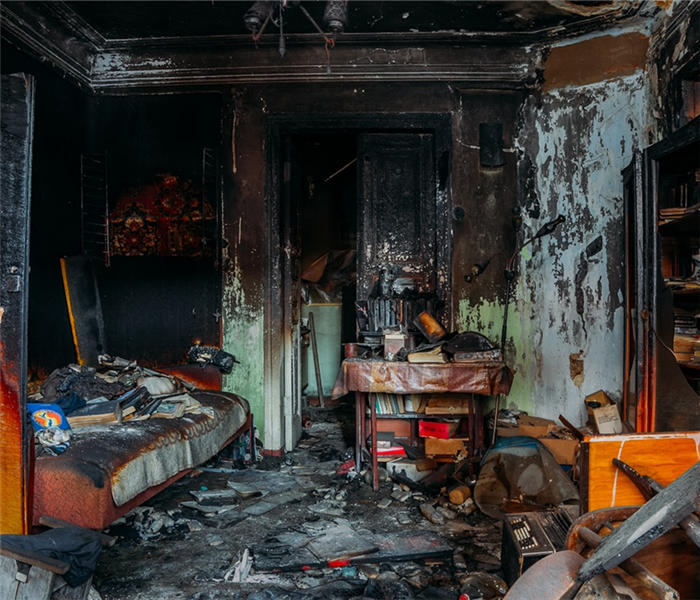 SERVPRO technicians can tackle fire damage and remaining odor related issues. Our technicians are standing by 24/7 to take your emergency call.
SERVPRO technicians can tackle fire damage and remaining odor related issues. Our technicians are standing by 24/7 to take your emergency call.
Deodorizing After Fire Damage to Your Great Neck Home
Fires can occur any time of year but can be more of a challenge during a cold New York winter. When the temperature outside quickly cools the contents of your home, it may be more challenging to recuperate afterward if the thick smoke residue settles throughout the structure. It is crucial to deal with the aftermath of a fire quickly and expertly to make sure your home and its contents are restored to their pre-fire condition.
If you find yourself dealing with fire damage in your Great Neck home, contact SERVPRO right away and have our trained technicians create a restoration plan specifically to suit your situation. Attacking odors after a fire can be one of the most challenging aspects of restoring your home.
Technicians remove valuable contents to have them cleaned by specialists or to ensure that smoke odors do not penetrate further into porous surfaces. After the removal of contents, the SERVPRO team searches for the source of the smoke odor. Typically, it is wherever the fire started within the home. The team removes the appliance or heat source that originally emanated the offensive odors; this way, no remaining odors are coming from the source.
SERVPRO IICRC-certified technicians often use thermal foggers to dispense solvent-based deodorants. The deodorants go through a heated area in the machine that combusts the solution, breaking it down into microscopic particles that can disburse anywhere throughout the home. These one-half micron-sized particles pair with the offensive odor, neutralizing it by changing its composition. During the fogging process, technicians wear personal protective gear and make sure that residents, pets, and plants are not in the home. Residents may return to the home after the fogged area airs out, and it is easy to breathe.
Another deodorization technique is vapor odor control. The goal here is to attack vapors found within the air. Technicians release products created to release deodorant vapors into the air, counteracting the malodor vapors upon contact. Vapor odor control and thermal fogging work together to combat odors since SERVPRO technicians use a combination of techniques.
SERVPRO of Great Neck / Port Washington is available to assist 24/7 after fire damage. We’re Faster to Any Size Disaster. Contact us at (516) 767-9600.
Drop Ceiling Damage After Leaks Above Manhasset Offices
3/16/2022 (Permalink)
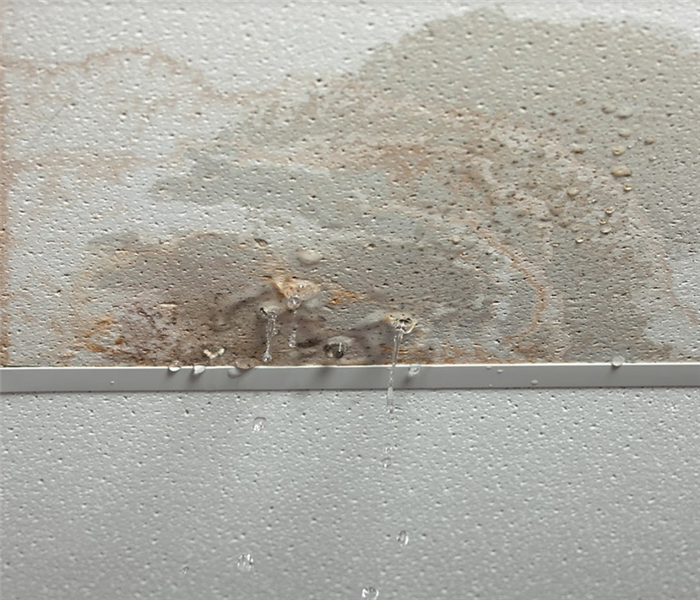 When your office space faces damage, the situation can escalate quickly. Contact SERVPRO at the first sight of water damage for effective remediation.
When your office space faces damage, the situation can escalate quickly. Contact SERVPRO at the first sight of water damage for effective remediation.
SERVPRO helps Manhasset offices recover after water damage
It can be a destructive situation when water damage occurs in your business. Especially open spaces like office buildings. Burst pipes or plumbing leaks rampantly impact ceiling assembly materials and overcome these porous elements to produce severe structural damage as well as standing water concerns. We must act quickly to repair ceiling damage and remove pressing water concerns.
Removing Ruined Materials
Water restoration companies in Manhasset, like our SERVPRO team, understand the importance of rapid response and restoration solutions for your business. The longer your structure goes without restoration and recovery services, the more damage that ultimately occurs, and the more it costs. Our process begins with removing ruined materials from the damaged drop ceiling system. Impacted materials from leaks can include:
- Ceiling tiles
- Framework
- Insulation
- Carpeting
Repairing the Damaged Plumbing
With the material out of the way and the cavity exposed, we can repair the plumbing impacted. Whether it was a burst pipe or separation of connectors, it is important to fix compromised plumbing portions to reestablish this vital utility service supplying your building. We can assess where repairs are needed and get these actions underway as soon as possible.
Cleaning Up the Water Damage
Next, we must overcome any water damage to the structure. Sometimes, this means clearing out trapped water in ceiling tiles that were not removed or drying up water damage on the flooring materials directly surrounding the impacted areas.
Replacing Missing Materials
Because we have a contractor license, we can provide the repairs and reconstruction necessary after severe water damage. In many cases, large portions of a drop ceiling system must be replaced after water damage because the weight of saturated tiles can damage the framework. We can re-install parts of this system as necessary, along with other structural elements.
Your home or business can be rapidly damaged by water. We are a full-service solution for restoration and recovery. Give our SERVPRO of Great Neck / Port Washington team a call today at (516) 767-9600.
How Crucial is Fast Professional Flood Damage Cleanup in Great Neck?
2/25/2022 (Permalink)
 There is no job too big or small for your local SERVPRO of Great Neck / Port Washington. Call today (516) 767-9600.
There is no job too big or small for your local SERVPRO of Great Neck / Port Washington. Call today (516) 767-9600.
SERVPRO Technicians Serve the Great Neck Area with Professional Water Mitigation Services
Great Neck homes with any water damage need assistance with extraction and drying. Some challenges come with the cleanup of floodwater that is different from a regular clean water restoration service.
Flood damage in a Great Neck home may happen due to heavy storms, snowmelt, or flash flooding in the vicinity. Another serious cause can come from overloaded or clogged sewer systems backing up into homes. This type of water in the house is much more hazardous as it can carry many diseases and pathogens. The risks from this type of structural damage are many, including:
- Health effects
- Water damage to the property
- Debris in the water
A single inch of floodwater within a home can leave behind thousands in structure and contents damage. This can affect a home from floor to ceiling. SERVPRO technicians have the training to inspect the property and determine any immediate safety issues to address. This may include treating water to make it safer for extraction and disposal by rendering harmful elements inert or cleaning up debris carried in by the water.
The biggest problem with groundwater is that it can contaminate anything it comes into contact with. SERVPRO technicians use equipment to clean and sanitize some articles within the home. In particular, textiles and clothing that can withstand washing can benefit from a single cycle in the Esporta Washing System.
SERVPRO of Great Neck / Port Washington at (516) 767-9600 is the trusted name for flood damage cleanup and restoration in the Great Neck area. The trained, certified technicians work to make water damage in local properties, "Like it never even happened."
What Should Manhasset Residents Look For in a Fire Damage Restoration Service?
2/17/2022 (Permalink)
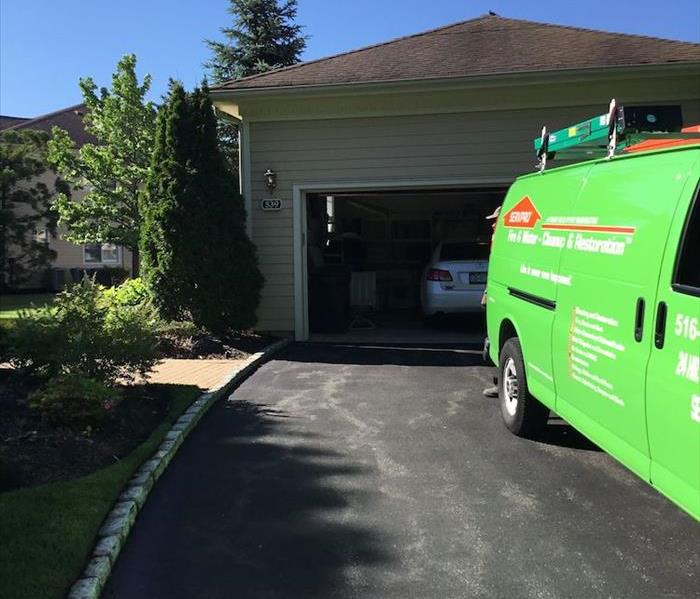 Don’t let fire damage overwhelm you, call the professionals at SERVPRO of Great Neck / Port Washington.
Don’t let fire damage overwhelm you, call the professionals at SERVPRO of Great Neck / Port Washington.
SERVPRO Serves the Manhasset Area with Fire Cleanup Available 24/7
When the need for house fire cleanup arises, the situation is already stressful for Manhasset property owners. There are several good points to consider to drill down to the best choice for a restoration company.
One of the first things homeowners with a post-fire property should look for in Manhasset fire damage restoration service is availability. SERVPRO techs never make property owners wait until the next business day. The team takes calls around the clock, including holidays, and arrives within a few hours to begin the cleanup. Some of the other things to notice about a company is:
- Whether or not the team members have training in handling fire damage
- The use of safety equipment
- Securing of the property
- Confirmation from the fire department, it is safe to enter
- Communicating with the adjuster as needed
- Ability to handle water damage
Extensive Ongoing Training
SERVPRO techs undergo rigorous training and continue their education as advances happen in the restoration services industry. When the techs arrive to perform the mitigation, they use the latest equipment and methods for the best possible outcome.
Safety and Security
Soot is unhealthy to breathe or come into contact with, and SERVPRO techs use safety equipment and secure the property. They board up the windows and door as needed to keep unauthorized individuals out of the worksite. Additionally, any temporary repairs such as covering broken windows or holes in the roof with a tarp get done.
Assistance with Insurance Claims
SERVPRO can help homeowners make the insurance claims process go smoother by communicating directly with the insurance adjuster assigned with the claim. This keeps both the property owner and the adjuster in the loop for the fire cleanup job as it progresses.
When they need fire damage restoration services, Manhasset residents call SERVPRO of Great Neck / Port Washington at (516) 767-9600. The techs can handle all sizes, from a single room to a multistory structure.
Can Water Damage Restoration Help a Great Neck Crawlspace?
2/8/2022 (Permalink)
 Looking for a restoration company? Look no further, SERVPRO is just a call away at (516) 767-9600
Looking for a restoration company? Look no further, SERVPRO is just a call away at (516) 767-9600
SERVPRO Techs Have the Training to Remediate Great Neck Crawlspace Issues
Crawlspaces began as a way to buffer homes from the damp earth and have three advantages over a basement, including:
- Raises the house off the ground and assists in inhibiting moisture and termites
- More cost-effective than a basement
- The ductwork and mechanicals can run through the crawlspace, making them easy to service.
The problem with a Great Neck crawlspace is when it needs water damage restoration. When this home area takes on moisture, the result can be inviting a mold infestation.
The minute water gets discovered in a crawlspace, it needs attention, or substantial damage may occur. Knowing how the water enters can allow homeowners to take preventative measures to prevent this situation from occurring.
Grade
Water that runs towards the home rather than away can wind up inside the crawlspace. Hints that there is an issue with the grade around the house include pooling water after rains instead of positive drainage sloping away from the structure.
Flood damage
Residents who live near Little Neck Bay or Manhasset Bay may risk flooding. Large amounts of run-off may cause water to enter a crawlspace, and in these cases, professional extraction is the best option.
Plumbing Leaks
Plumbing for the home routinely runs through the crawlspace, and when there is a leak, it may be a long period before it gets noticed. Often a raised water bill is the first clue there is an issue in the house that starts the homeowner looking. Inspecting the crawlspace on a regular monthly schedule can avoid this issue becoming a huge problem. SERVPRO technicians can extract the water, dry crawlspaces, and perform encapsulation as needed to ensure none of these issues is a problem for the home in the future.
SERVPRO of Great Neck / Port Washington at (516) 767-9600 brings professional water damage restoration to the Great Neck community available 24/7.
What Does Mold Removal in Manhasset Entail?
1/27/2022 (Permalink)
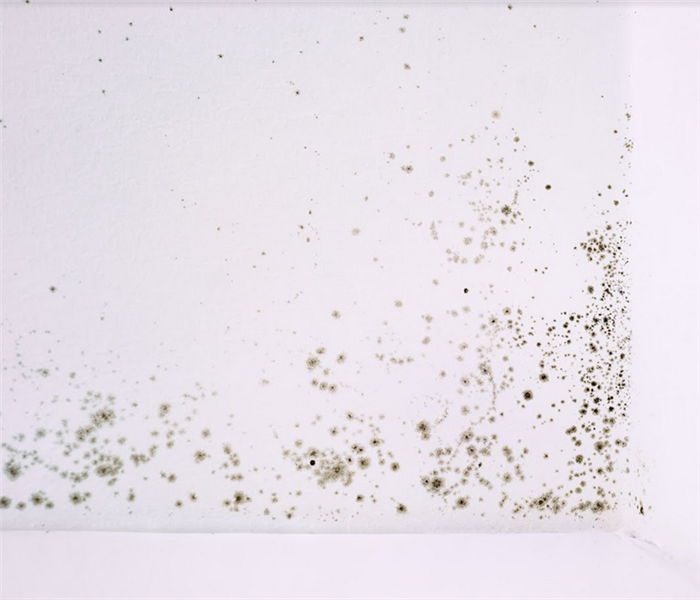 When slow leaks behind walls leave mold on the surfaces of your home, it’s time to call SERVPRO. We are standing by 24/7 - 365 days a year for you.
When slow leaks behind walls leave mold on the surfaces of your home, it’s time to call SERVPRO. We are standing by 24/7 - 365 days a year for you.
SERVPRO Is Available for Mold Remediation in Manhasset
Over time the seals in your water valves wear, and sometimes, when you think you shut the water off in your shower, it still leaks. Many people probably have been in a situation where they hear their faucets drip after they are done with their shower or bath. These drips or slow leaks can cause moisture to leak into your bath or shower or cause water to flow down the outside of your supply lines.
Our SERVPRO technicians often find that a slow leak is a source when we conduct mold removal in Manhasset. If there is a small drip coming from your faucet, it could flow down your pipes and get the backside of your drywall wet. Since drywall has paper as its backing, fungi could develop on it.
As time goes on, the mold can grow through your drywall and start to contaminate the surfaces of your shower or bath. If steps to remediate do not get taken soon, the spores released by the mold can contaminate previously unaffected areas. However, our SERVPRO technicians can conduct the following procedures to help prevent the fungus from spreading:
- Emergency Services for Water Damage
- Attic Mold Remediation
- Bathroom Mold Remediation
- Kitchen Mold Remediation
- Black Mold Inspections
We can provide fast, 24/7 service, and we have access to the industry's most advanced technology that we can utilize from start to finish. Our highly trained team knows that containment during work operations is vital in preventing future mold growth. Before any procedures get conducted, we can seal off the affected area with plastic and set up an air scrubber to provide negative pressure.
If you ever notice mold growing in your bath or shower, call SERVPRO of Great Neck / Port Washington at (516) 767-9600.
What Is Involved in Conducting Water Removal in Great Neck?
1/20/2022 (Permalink)
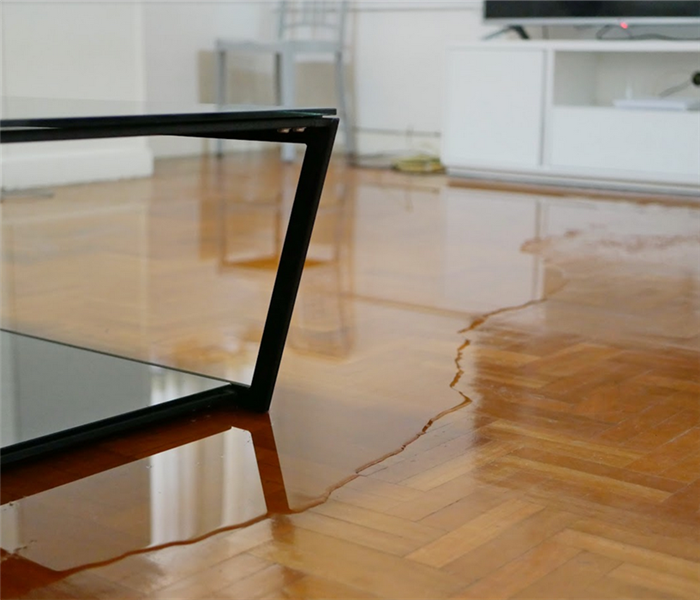 Team SERVPRO has the expertise and equipment to help with any type of water removal situation. Start the process right away for best results.
Team SERVPRO has the expertise and equipment to help with any type of water removal situation. Start the process right away for best results.
SERVPRO Provides Emergency Services for Water Damages in Great Neck
When most people think of removing water from a building, they think about a crew setting up pumps to pull out liquid H2O. Or, they may think that water extraction only involves mopping up moisture or vacuuming saturated carpets. However, whenever water makes its way into your dwelling, it not only builds up on your flooring it also can soak into your contents and building materials. And, due to the natural evaporation process, a water leak in your house can also raise your indoor relative humidity level.
When conducting water removal in Great Neck, our SERVPRO technicians know that the extraction process is just one of the steps involved in restoring your home to its preloss state. After we extract all of the liquids present in your home, we can then conduct the Applied Structural Drying (ASD) process.
During ASD procedures, we set up a combination of air movers and dehumidifiers. Since items in nature always want to move to equilibrium, setting up air movers so that they push air against your walls at a 45-degree angle will help water evaporate into the air from your wet items. The dehumidifiers then pull H2O out of the air and dispense it into liquid form.
Drying may take several days, depending on the severity of the issues. But, our SERVPRO team will keep returning until the moisture levels in your contents and building materials are normal. When restoring your property, we can provide the following:
- Heavy-Duty Water Extraction
- Water Clean Up
- Emergency Services After a Water Damage
- Water Damage Repairs
If you ever notice moisture sitting on your floors where it is not meant to be, call SERVPRO of Great Neck / Port Washington at (516) 767-9600.
Exploring Fire Damage Restoration Techniques in Roslyn
1/15/2022 (Permalink)
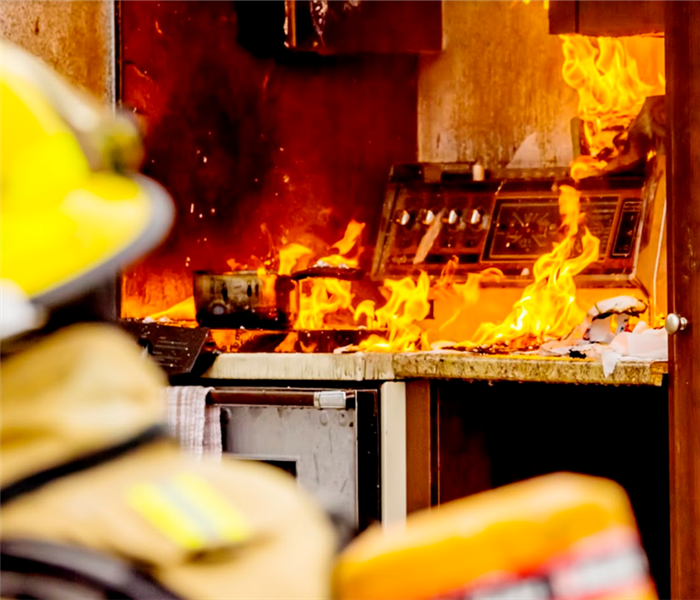 Fires can happen very quickly in residential kitchens. Contact SERVPRO 24/7 to assess and remediate the fire damage situation in your home.
Fires can happen very quickly in residential kitchens. Contact SERVPRO 24/7 to assess and remediate the fire damage situation in your home.
SERVPRO Can Help with House Fire Clean Ups in Roslyn
Most experienced home cooks know that it is essential to pay attention while cooking and not leave the kitchen. However, since not everyone is perfect, we have probably all not followed the basic rules of home cooking from time to time and got distracted. One minute you could be cooking your dinner, and then the next thing you know, your phone rings, and whatever you were cooking starts to burn.
In some cases, conducting fire damage restoration in Roslyn comes about after a cooking mishap results in a kitchen blaze. And even if the fire did not grow to where it was huge, the smoke coming from it could still cause you problems with your house.
For example, say you put a chicken breast or a pork chop in the oven and then forgot about it. The meat will eventually be set on fire, but the flames will likely stay confined in the oven. However, the smoke coming from the burnt protein could get excessive. The smoke might become too much for your kitchen hoods to suck up, causing the smoke to travel throughout your home.
Smoke damage can cause soot residues to build up on surfaces in your home when the smoke touches cooler surfaces. The smoke can also cause foul, burnt aromas to linger when it penetrates porous material deeply. Luckily, our SERVPRO IICRC-certified technicians can provide fast 24/7 service. Our highly trained team can utilize the industry's most advanced technology to assist you with the following:
- House Fire Clean Ups
- Water and Fire Damage Restorations
- Fire Debris Removal
- Smoke Remediation
- Structural Deodorization
If you ever make a mistake while cooking your dinner and your house gets smoked out by burnt meat, call SERVPRO of Great Neck / Port Washington at (516) 767-9600.
What Are Some Expected Challenges of Groundwater Flooding for Great Neck Homes?
12/30/2021 (Permalink)
 If you are faced with flood damage, call on our experts for help. We are available to assist you 24/7.
If you are faced with flood damage, call on our experts for help. We are available to assist you 24/7.
SERVPRO Relies on Past Experiences to Identify and Resolve Challenging Issues During Flood Restoration
Different situations can leave your Great neck home flooded. Inundation by groundwater is one such situation, and unlike the other flooding situations, it presents some unique challenges that can interfere with the restoration processes. Professional restorers are used to handling all kinds of flooding situations and can help you recover faster.
Like any other incident, each case of groundwater flooding in Great Neck is unique. Therefore, the level of damage and the challenges involved in the restoration differ. For an experienced team like SERVPRO, it is easier to anticipate some challenges based on the situations we have addressed in the past.
Most of the Challenges Arising After Such a Flood Incident can be Tied to:
- Contamination
- Presence of solid residues
- The volume of water involved
In most cases where groundwater breaches property, vast areas surrounding the property are usually covered in water which creates a challenge for the restoration since it is impossible to extract the water from the home until the water in the surrounding areas recedes. Fast action is one crucial step in resolving flooding, so alternative solutions are necessary.
Since groundwater moves over vast areas, it collects contaminants ranging from chemicals to biohazards. The water also contains various dissolved residues. All these materials end up in your house once the water breaches.
Resolving the Different Problems Caused by Groundwater Flooding Requires:
- Allocating enough time
- Sufficient human resource
- Use of specialized equipment
Quickly resolving any flooding situation is essential. However, doing it in great haste creates unnecessary challenges. For instance, extracting water before flooding in the surrounding recedes would necessitate additional measures such as creating barriers around the house to block more water from filtering in. Our SERVPRO teams choose to move contents from submerged areas as we wait for the flooding to subside. We also send fully staffed teams equipped with standard and advanced equipment such as self-priming trash pumps to help remove residue-filled water.
SERVPRO of Great Neck / Port Washington can help you overcome any challenges caused by groundwater flooding. Call us at (516) 767-9600. We’re Faster To Any Size Disaster.
What Is the Best Way to Manage Contents During Fire Restoration in Port Washington Facilities?
12/24/2021 (Permalink)
 SERVPRO is here for you every step of the way after a fire strikes. Just give us a call at (516) 767-9600.
SERVPRO is here for you every step of the way after a fire strikes. Just give us a call at (516) 767-9600.
SERVPRO Evaluates the Level of Fire Damage and Determines Whether to Move Items or Not
Contents can stand in the way of fire restoration. When heavily damaged, they must be removed for cleaning or disposal. If undamaged, they can hamper some restorative action or risk being damaged. Having a sound plan for managing various items helps improve the restoration process.
The thought of packing out all items to facilitate fire restoration at your Port Washington business premises can be quite demoralizing since you already have other issues to address, including footing the cost of restoration. However, a professional team from SERVPRO is used to handling such tasks and can find appropriate ways to manage the situation. Since move-outs can be costly, we consider all viable alternatives before starting pack-outs.
Other Useful Approaches That Help Safeguard Contents Include:
- Manipulating contents to unaffected sections of the property
- Leaving contents in place and protecting them with a drop cloth
- Sealing off unaffected rooms with airtight barriers to protect the contents within
Deciding what to do with the contents or stock items in your premises is just the first step. Other actions are necessary to facilitate the restoration. Because of the varied nature of various contents and the levels of damages, the items may require special handling.
Essential Steps to Guarantee Proper Item Handling Include:
- Loss documentation
- Inventory taking
- Quality control
Documentation can involve recording the number of items in the facility or the level of damage inflicted on them by the fire. Our SERVPRO technicians take several photos which help capture the damage extent. We also use stickers to label items, especially the unsalvageable ones. That way, it is easier to remove them for disposal. Clearing and setting a designated work area and an inventory station is also helpful in handling all the items you have safely.
SERVPRO of Great Neck / Port Washington takes care of all the challenges you might face during fire restoration. You can reach us at (516) 767-9600 when you need assistance. We’re Faster To Any Size Disaster.
Can One Limit Damage From Frozen Pipes and Ice Damming in Great Neck Homes?
12/16/2021 (Permalink)
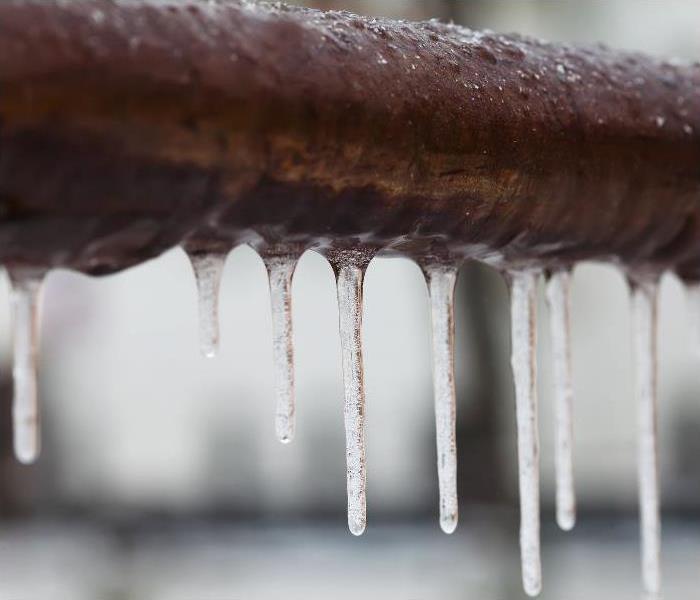 Severe winter weather can cause ice damming, frozen pipes and many other disasters for your home. We are Here to Help!
Severe winter weather can cause ice damming, frozen pipes and many other disasters for your home. We are Here to Help!
SERVPRO Believes Simple Measures Can Impact Frozen Water Damage
Completing the winter season without encountering challenges such as property damage is the desirable outcome. Problems like frozen pipes and ice damming are not only inconvenient but might also be costly to fix, especially if your insurance does not cover such damage. When prevention fails, limiting damage is the next best option.
If you are wondering how you can limit damage from frozen pipes and ice damming at your Great Neck property, you should focus on how the two problems affect the structure. Freezing exerts immense pressure on pipes leading to bursting. Ice dams can lift shingles forcing the water backing up on the roof to leak into the house. Combating damages from these issues is easier with help from SERVPRO.
Various Actions Help Prevent Damage From Freezing, Including:
- Shutting off supply valves to prevent water leakage through burst pipes
- Opening faucets to allow water to flow freely
- Lowering the temperature in the house to reduce heat buildup at the base of the roof
These actions may seem trivial but can have a significant impact in preventing water breaches or limiting the damage extent. For instance, when the mains are turned off, any pipe burst can only release a small amount of water. Opening faucets helps expedite thawing.
Preventive steps are still crucial even after water intrusion. Our SERVPRO water restoration technicians are properly trained on handling water intrusions, especially in concealed areas such as attics and wall cavities. For instance, we bring moisture detection equipment like moisture meters and thermal cameras to quantify the level of water intrusion. That way, we can decide whether drying steps such as ventilating wet cavities with warm, dry air is sufficient or performing controlled demolition is necessary.
SERVPRO of Great Neck / Port Washington can help you prevent or resolve damage from frozen pipes and ice damming, “Like it never even happened.” Call us at (516) 767-9600.
Fire Damage Restoration of Great Neck Properties Happens Fast with SERVPRO
11/29/2021 (Permalink)
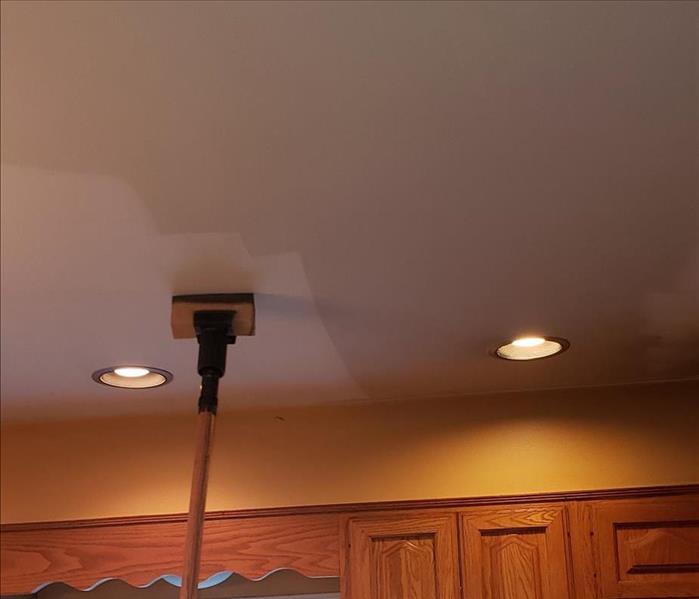 When you need skilled technicians using professional cleaning agents and tools for fire damage restoration in Great Neck--call SERVPRO
When you need skilled technicians using professional cleaning agents and tools for fire damage restoration in Great Neck--call SERVPRO
Why Do Great Neck Homeowners Trust SERVPRO for Fire Damage Restoration?
Fire damage restoration of your Great Neck property involves several activities, from cleaning the smoke and soot residue to deodorization. Hiring professionals like SERVPRO can help you restore your home to its preloss condition, “Like it never even happened.”
SERVPRO techs use various methods to clean residues from surfaces during fire damage restoration of your Great Neck home. While some situations do require the use of chemical cleaning agents, mechanical agitation is sufficient in others. SERVPRO techs use mechanical agitation in cases where a light concentration of non-greasy residue is present on non-porous surfaces. Based on the amount of agitation required, SERVPRO techs use different pieces of equipment.
Mechanical Agitation Equipment That SERVPRO Techs use During House Fire Cleanup in Great Neck
The mechanical agitation process can be classified into mild, medium, and heavy depending on the amount of force offered.
SERVPRO techs use feather dusters, brushes, and compressed air to achieve mild agitation. It is one of the safest mechanical methods to clean almost any kind of surface. However, a gentle agitation is not useful if the amount of soot is heavy or wet.
Dry chemical sponges, cleaning towels, and dusting cloths offer medium agitation. Crumbly Cleaner that SERVPRO techs use on Great Neck properties works by absorbing the residue and falling apart, much like a pencil eraser. It also provides medium agitation.
Roto pads and blast cleaning with sand, baking soda, or dry ice provide a heavy agitation. While these methods are quite effective, they are not useful on delicate surfaces.
SERVPRO techs choose the agitation methods that eliminate the residue as much as possible without harming the surface being cleaned.
If you want assistance with fire damage restoration of your home, call SERVPRO of Great Neck / Port Washington at (516) 767-9600.
Why Is SERVPRO Among the Most Trusted Water Restoration Companies in Manhasset?
11/19/2021 (Permalink)
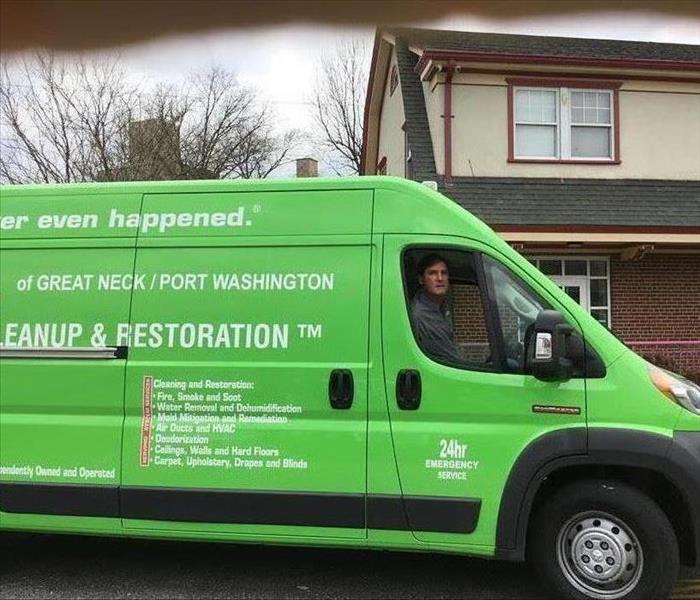 Here is a SERVPRO van and owner/operator responding to a water damaging urgent call in Manhasset
Here is a SERVPRO van and owner/operator responding to a water damaging urgent call in Manhasset
A Quick and Reliable Service Makes SERVPRO Stand Out Among Other Water Restoration Companies in Manhasset
Water damage to commercial property can have disastrous consequences, especially if it is not promptly mitigated. SERVPRO is a leading water restoration company in Manhasset that has saved several businesses and commercial enterprises from the lasting effects of water damage. Our IICRC certified technicians have years of experience and training to deal with any size disaster.
What makes SERVPRO one of the highest-rated water restoration companies in Manhasset is our quick response. After all, We’re Faster To Any Size Disaster. The extent of damage can be controlled if the restorers spring into action as soon as possible. The goal of the water restoration process is to minimize the downtime of your business while ensuring efficiency.
Is Controlled Demolition Always Necessary During Water Damage Restoration of Manhasset Commercial Properties?
SERVPRO techs use several types of drying equipment, including air movers and dehumidifiers, during the restoration of your Manhasset property. However, it is sometimes necessary to perform controlled demolition to access pockets of saturation and remove unsalvageable contaminated materials and components.
Opening assemblies, including walls, stairs, flooring, and voids, can accelerate the rate of drying. If contamination is discovered during the controlled demolition, the unsalvageable material is double-bagged and disposed of according to the regulations.
In some situations, SERVPRO techs might also need to apply biocides to control the growth of microbes after the demolition of assemblies.
Whether SERVPRO techs need to perform a controlled demo or apply biocides, nothing is done without informing and briefing the customer. We also provide safety data sheets (MSDS) of all products used during the restoration process.
Call SERVPRO of Great Neck / Port Washington at (516) 767-9600; Our techs are available 24/7 to answer your calls.
SERVPRO Can Save Great Neck Properties from Long-Term Effects of Flood Damage
11/9/2021 (Permalink)
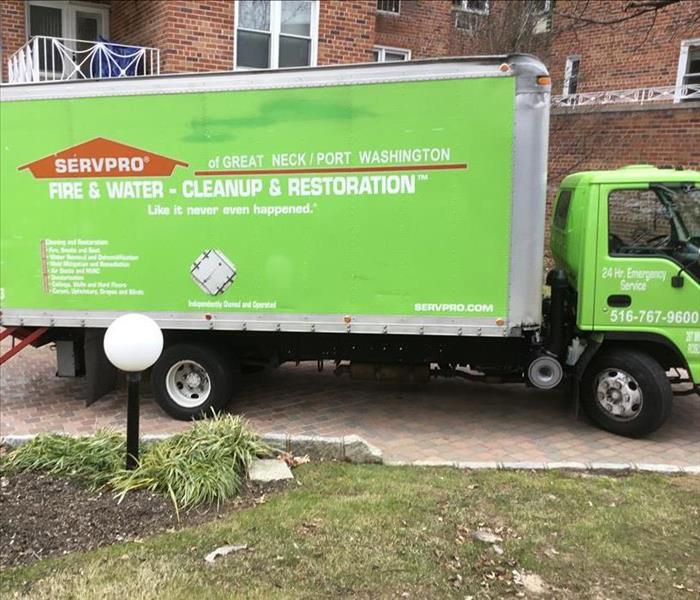 Our SERVPRO Green Fleet carries many air movers and dehumidifiers to mitigate the storm damage to Great Neck properties
Our SERVPRO Green Fleet carries many air movers and dehumidifiers to mitigate the storm damage to Great Neck properties
Great Neck Homeowners Rely on SERVPRO for Flood Damage Restoration after a Storm
Hiring professional restorers like SERVPRO to handle flood damage at your Great Neck property can save it from long-term effects. Professionals have the necessary tools and equipment to restore your property quickly without compromising safety. Professional restoration greatly diminishes the chance of secondary damage that can be costly to repair.
SERVPRO techs prioritize drying during the restoration of flood damage to your Great Neck home. If drying is fast and efficient, it is less likely that the moisture can interact with the building materials and cause any lasting damage. Rapid drying also ensures that there is less chance of microbial contamination. While SERVPRO techs employ several pieces of equipment to speed up the drying process, air movers are the most useful pieces of equipment in their arsenal.
How do SERVPRO Techs use Air Movers During Flood Restoration of Your Great Neck Property?
Air movers remove the layer of humid and cool air in close contact with the wet surfaces and replace it with warmer and drier air. The increase in airflow speeds up the rate of evaporation. Best drying rates are seen when air movers are used in conjunction with dehumidifying equipment.
While SERVPRO techs use several air movers to dry flood-damaged Great Neck properties, they are often rated according to their efficiencies. Typically, the air movers that SERVPRO uses are rated in CFM (cubic feet per minute). The CFM rating indicated the airflow volume in cubic feet that the given air mover can supply in a minute.
Sometimes, the air movers are also rated according to the velocity of air they can generate in feet per minute (FPM).
Call SERVPRO of Great Neck / Port Washington at (516) 767-9600; our technicians are available 24/7.
Overcoming Smoke Damage to Manhasset Homes After a Fire
10/26/2021 (Permalink)
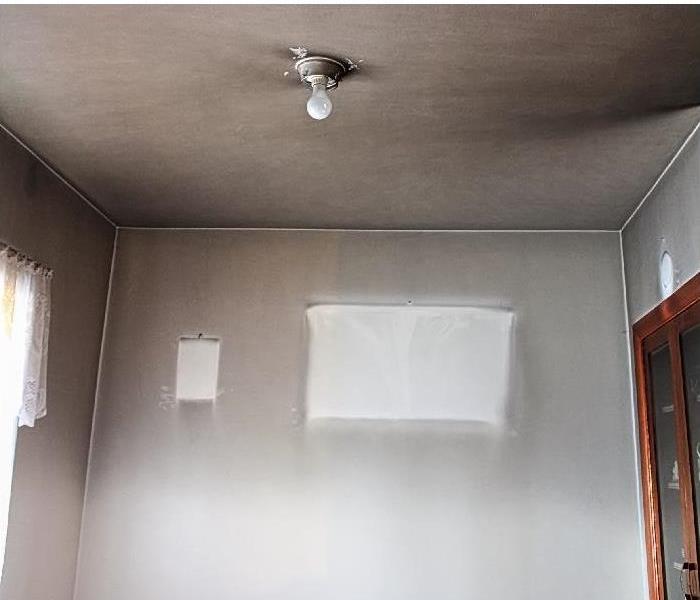 No mater the size of the fire, smoke and soot can cause damage far from the blaze.
No mater the size of the fire, smoke and soot can cause damage far from the blaze.
Experienced Restoration Professionals are Ready 24/7 to Help with Post-Fire Recovery of Manhasset Homes
While the fire that your home experiences can be destructive, lingering effects created by smoke damage can create issues of their own. Our fast responding technicians have mitigation strategies to overcome smoke damage; however it impacts your property.
Improving Indoor Air Quality
Smoke damage can be a focal point of fire damage restoration in Manhasset homes. Getting emergency services started as soon as possible can be critical to protecting the property and its contents. One such action is reducing the presence of airborne contaminants and solids, often completed with the placement of HEPA air scrubbers.
Removing Soils and Smoke Residues
Overcoming soot and smoke damage can be one of the most significant obstacles our fire restoration professionals face when working in a damaged home. Partial combustion can create soot particles that adhere to surfaces and come to rest on horizontal planes. Depending on the affected material, we have multiple cleaning approaches, such as:
- Wet cleaning
- Chem sponges
- Media blasting
- Controlled demolition
Removing Harsh Odors from the House
Smoke damage can often be in the form of harsh odors spread throughout the property. The troublesome aspect of noxious smells is their ability to move far beyond the damaged area to impact other rooms of the house through avenues like the HVAC system. We rely on reduction techniques to limit the severity of odors before full deodorization practices begin.
Smoke damage presents itself in multiple ways after a fire. When these damaging facts are present, we have experienced technicians capable of helping mitigate loss and remove soot and smoke residues where they are found. Our SERVPRO of Great Neck / Port Washington team is available 24/7 at (516) 767-9600.
Is Professional Water Restoration Sensible for Great Neck Homes?
10/19/2021 (Permalink)
 We are equipped to dry your water damaged home. Call us today!
We are equipped to dry your water damaged home. Call us today!
With a Finite Restoration Timeline, Professional Recovery for Water-Damaged Great Neck Properties is Worthwhile
There is a sense of urgency with any water damage event that could occur, even more with substantial emergencies like burst pipes or appliance ruptures. We have a team ready to respond immediately to showcase some of the many reasons professional restoration is cost-effective and efficient.
Emergency Services to Help the Property
Choosing water restoration companies for Great Neck water-damaged homes allows skilled professionals of our SERVPRO team to start emergency services as soon as we arrive. From relocating contents to beginning water removal services, swift action can make a difference in the length and cost of restoration.
Thorough Drying and Moisture Monitoring
After water damage incidents, the drying and cleaning up processes can be among the most intricate and thorough actions required for a compromised property. Missing moisture pockets during the drying process can allow for secondary effects like mold growth to occur. We rely on advanced moisture tracking equipment to monitor drying progress like:
- Thermal imagery (infrared)
- Moisture meters
- Hygrometers
Full-Service Damage Repair Solutions
Another advantage to choosing SERVPRO is our general contractor license. Because many water damage incidents threaten structural integrity like burst pipes or ceiling leaks, we can provide needed demolition and build-back services.
While you might not always think every situation requires professional restoration services, this approach has multiple benefits when water damage exists in your home. As widespread and overwhelming as these conditions can become, we have experienced professionals ready to mobilize 24/7 to help when you need it. You can reach our SERVPRO of Great Neck / Port Washington team today at (516) 767-9600.
What Materials Get Affected by Mold Damage in Great Neck Homes?
10/12/2021 (Permalink)
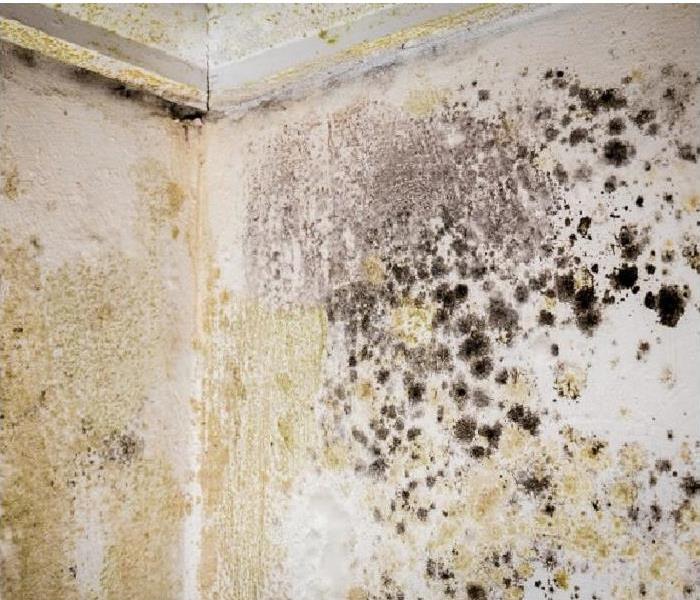 Mold can quickly spread throughout your home. Call SERVPRO for your mold remediation needs.
Mold can quickly spread throughout your home. Call SERVPRO for your mold remediation needs.
Organic Matter can Host Mold Colonies in Great Neck Properties and Ruin Materials Without Fast Remediation Solutions
Understanding what to expect from mold damage in your home can help those who might underestimate the presence of these organisms. When mold spreads through a property, many types of organic materials can become hosts.
Mold Inspections Identify Targeted Materials
Specific materials could be impacted by mold damage in your Great Neck home. Some of these include:
- Drywall – Drywall is among the most common building materials for wall systems. This sheetrock can be particularly susceptible to hosting mold colonies.
- Carpets – Carpeted floors are an everyday staple in many modern homes, and these fibrous materials are capable of supporting mold colonies when moisture becomes a threat.
- Hardwood – Wood accents like trim, cabinets, and flooring can support mold organisms when these colonies continue to spread in a damaged area.
- Fabrics – Cloth and fabrics are present in drapes, clothing, and upholstery. All of these materials can support mold colonies and absorb effects like harsh odors.
Content Relocation and Cleaning Services
The impact of the mold on your personal belongings and furniture also needs considering. In many cases, homeowners believe these items to be as important as the property's structural integrity, so this becomes a focal point for responding remediators to protect these items when possible. Often, this means relocating contents to our nearby facility for cleaning and safekeeping until mold removal completes.
Understanding how certain building materials and your contents in the house can become affected by migrating mold damage is essential to convey the urgency of remediation. Our professionals can respond fast when you believe mold damage exists with thorough inspections and mitigative strategies to reduce loss. Our SERVPRO of Great Neck / Port Washington team is available anytime you need it at (516) 767-9600.
What Water Restoration Companies Can Manhasset Businesses Call for Cleanup?
9/29/2021 (Permalink)
 We're Faster To Any Size Disaster, arrive with well-stocked vans and skilled techs to keep your business open after a water damaging incident--SERVPRO
We're Faster To Any Size Disaster, arrive with well-stocked vans and skilled techs to keep your business open after a water damaging incident--SERVPRO
Water Restoration Companies Like SERVPRO Support Manhasset Entrepreneurs with Fast-Responding Cleanup from Highly-Trained Techs
Water restoration companies in Manhasset strive to be three things: always available, staffed by well-trained technicians, and packed with the necessary equipment to meet–and exceed–restoration industry best practices. These qualities are crucial for minimizing commercial downtime for businesses, which can impact local jobs.
SERVPRO is among the water restoration companies in Manhasset that can confidently say that it provides all three services. SERVPRO’s 24/7 service, commitment to thorough staff education, and cutting-edge technologies work in tandem to save businesses while minimizing damage to assets and structures. Restoration focuses on structural safety while preventing further damage caused by moisture exposure.
SERVPRO Water Damage Drying Salvages Commercial Wall Cavities
Whether a pipe leak affects an office, store, or warehouse, these leaks are commonly found inside wall cavities. SERVPRO takes several steps to combat water leaks, such as:
- Cutting out unsalvageable drywall or drilling small holes in walls. Vinyl baseboards may require removal to access wall cavities more easily, but they can be reinstalled after mitigation
- Drying wall cavities typically entails pushing air into holes at a 45-degree angle. This positioning allows air to “bounce” off of walls and pull moisture out of surfaces.
- Directly forcing air into wall cavities at a 90-degree angle can have the opposite effect, and instead, push moisture into porous surfaces like wall studs or insulation
- Low-grain refrigerant (LGR) dehumidifiers collect moisture from axial or centrifugal air movers for disposal in a treated sewer
SERVPRO of Great Neck / Port Washington can be reached at (516) 767-9600 for emergency-response commercial remediation at any time of the day or night.
What Can Great Neck Homeowners Use to Remove Flood Damage Odors?
9/22/2021 (Permalink)
 Need flood and odor cleanup in your Great Neck home? Here is your company of choice--SERVPRO--"Like it never even happened."
Need flood and odor cleanup in your Great Neck home? Here is your company of choice--SERVPRO--"Like it never even happened."
SERVPRO Odor Control Technicians Utilize Commercial-Grade Tools to Eliminate Great Neck Flood Damage Malodors
Flood damage can be disastrous for residential properties, not just because of the potential risks inherent in water exposure. Microbial growth and other contaminants brought in by floodwaters can quickly fill Great Neck homes with unpleasant odors and debris that require professional remediation to clean while keeping home occupants safe.
Certified SERVPRO technicians render flood damage cleanup for Great Neck homes within hours of initial contact. This comprehensive, emergency-response service handles standing water, water damage, stains, and debris left behind by ground floods that impact residential properties.
Performing Odor Control After Flooding
Flood damage often leaves behind unpleasant odors, and not just from microbes or moisture exposure. Sewage, pests, and chemical residues can all impart malodors that require remediation.
- While flood damage typically does not entail lingering standing water, SERVPRO technicians can remove the remaining water with extraction units, submersible pumps, or wet vacuums
- Extracting moisture, making flood cuts above sections of wet sheetrock, and drying flooring are all crucial to controlling odors even before deodorization begins
- SERVPRO Odor Control Technicians (OCTs) can mitigate odors with devices like hydroxyl or ozone generators, solvent-based deodorizers dispensed with pump sprayers or fogging units, scented granules, odor counteractant beads
- Properties are aired out before and after deodorization with high-powered box fans that circulate over 3,000 cubic feet of air per minute
Property owners can call (516) 767-9600 for mitigation services from SERVPRO of Great Neck / Port Washington 24/7.
Why Does Fire Damage Leave Dark Stains on Great Neck Home Furniture?
9/13/2021 (Permalink)
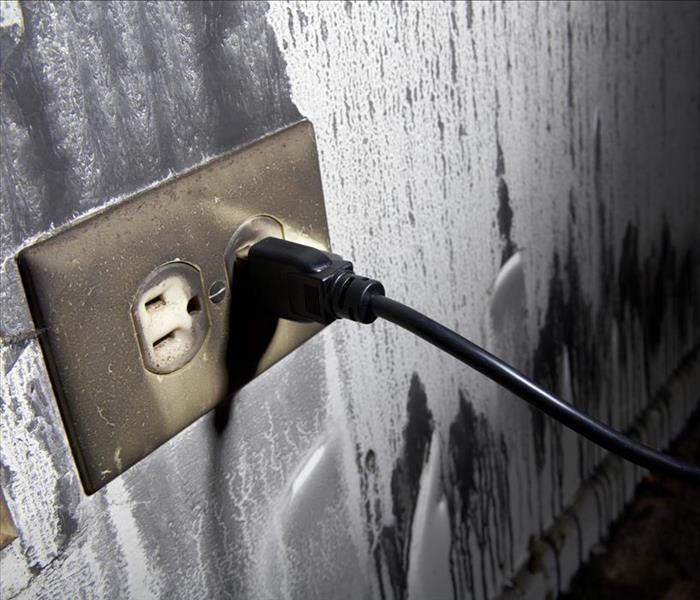 Cleaning soot and fire damaged fabrics or porous surfaces in Great Neck is best left to SERVPRO
Cleaning soot and fire damaged fabrics or porous surfaces in Great Neck is best left to SERVPRO
Great Neck SERVPRO Fire Damage Restoration Mitigates Soot and Smoke Stains
Home fires impact Great Neck homeowners’ property in many ways ranging from hard-to-remove soot stains to strong malodors. Fire suppression efforts can worsen soot penetration by exposing soot to water, which can corrode metals on the property.
Certified SERVPRO fire damage cleanup preserves Great Neck homes by carefully removing soot and soils. SERVPRO’s restoration-focused mitigation minimizes structure and contents damages where possible per Institute of Inspection, Cleaning and Restoration Certification (IICRC) standards.
SERVPRO’s Fire and Soot Residue Cleanup for Fabrics, Fibers, and Furniture
SERVPRO professionals address fire-damaged fibers and upholstery with careful precision that renders many surfaces restorable.
- While mattresses can be left largely unscathed by soot exposure due to layers of bedding absorbing smoke particles, box springs may sustain stains or odors from smoke. These residues can also stick to mattress and box spring ticking
- Inexpensive lampshades are more cost-effective to replace than to repair after fire exposure. However, with careful wet cleaning or solvent-based dry cleaning, more expensive lampshades are often salvageable
- Upholstery care strategies differ greatly based on the materials affected. This process typically starts with pre-cleaning and removal of dry soils. After that:
- Light to moderate damages can often be mitigated with dry solvents or vacuuming with HEPA-filter vacuums
- Heavier soils from wet smoke or long-term exposure on colorfast fabrics can be cleaned with a one-percent chlorine bleach solution as a last resort
Property owners can call SERVPRO of Great Neck / Port Washington at (516) 767-9600 for “Like it never even happened,” restoration services.
How Can SERVPRO’s Water Damage Mitigation Protect Your Great Neck Business?
8/29/2021 (Permalink)
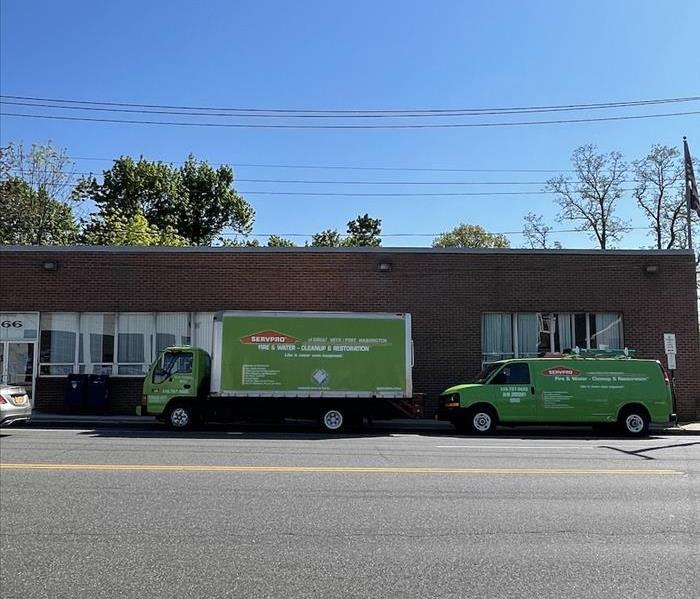 Water damage to your business is very costly. Call SERVPRO for all the commercial restoration services needed for your property.
Water damage to your business is very costly. Call SERVPRO for all the commercial restoration services needed for your property.
Our Water Damage Mitigation Services Protect Your Business in Several Ways.
When your shop, restaurant, hotel, or other Great Neck business suffers a water leak, it could cause substantial long-term damage. The key to avoiding the most serious issues related to these situations is quickly enlisting the assistance of a highly-skilled water damage mitigation service.
One of the most skilled and experienced water damage mitigation companies in Great Neck is SERVPRO. For over thirteen years, our technicians have effectively done just about every type of leak impact assuagement imaginable. These efforts have helped area businesses avert the worst leak-related water damage, which has saved them a great deal of time and money.
A Few of the Ways SERVPRO can Protect Your Business From the Worst Water Leak Effects are by:
- Expertly locating ceiling leaks and other insidious, hidden water sources that could do catastrophic damage over time if allowed to persist
- Providing emergency water damage services like repairing burst pipes and performing other pressing water damage repairs
- Preventing serious water-related damage that results from long-term standing water covering structural elements and household contents
- Quickly bringing moisture levels in the air, structural elements, and furnishings to normal levels so that microbial growths are prevented or limited
- Treating impacted materials with professional-grade antimicrobials to prevent ongoing future damage like dry rot and mold growths
- Deodorizing your facilities with EPA-approved deodorants so that your business remains pleasant for customers and employees
Through all of these various means, SERVPRO’s water damage remediation team can often mitigate the damage of even the worst leaks and return your commercial site to operating condition in record time.
So, if your business ever requires water damage mitigation, do not hesitate to call your helpful neighbors at SERVPRO of Great Neck/Port Washington. We are always ready for your call at (516) 767-9600.
Why Is SERVPRO One of the Best Mold Removal Services in Manhasset?
8/19/2021 (Permalink)
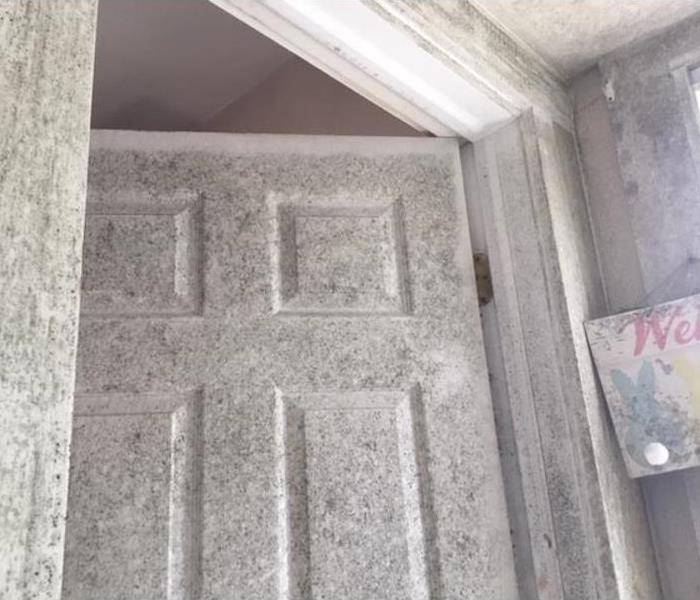 SERVPRO uses the latest technology and equipment for every mold remediation project. Call now for fast and immediate service.
SERVPRO uses the latest technology and equipment for every mold remediation project. Call now for fast and immediate service.
SERVPRO Is One of the Best Mold Remediators in Manhasset for Several Reasons.
When mold growths appear in your Manhasset home, you need help from an experienced mold damage cleanup firm with the knowledge and tools to get the job done right. Moreover, you want to hire a nearby company that can swiftly complete its work to limit potential damages.
With over thirteen years of experience performing mold removal work in Manhasset, SERVPRO is easily one of the area’s most expert mold remediators. Also, our team of mold specialists is near your residence and can generally be onsite within four hours of your initial call. Some of the other particular characteristics that make us better than other mold services are:
- Our technicians are trained and certified by the Institute of Inspection, Cleaning and Restoration Certification in applied microbial remediation, carpet cleaning, applied structural drying, water damage restoration, and odor control
- We have extensive experience in mold inspection, basement mold remediation, bathroom mold removal, attic mold removal, and black mold damage repairs
- Company workers carry with them sophisticated inspection equipment capable of locating sites most favorable for mold growth and measuring the specific moisture levels in an area
- We have all the latest technology and tools to effectively dry interior air, treat potential microbial threats, and professionally eliminate persistent fire-related odors
So, as you can see, SERVPRO has everything necessary to handle most mold cleanup and restoration jobs. Moreover, we have a proven track record of successfully dealing with everything from the most simple to the most severe mold-related cases.
Considering all this, remember that SERVPRO of Great Neck/Port Washington is always here to help whenever you need mold removal services. Call us anytime at (516) 767-9600 for assistance.
Fire Damage Restoration on a Great Neck Homes
8/12/2021 (Permalink)
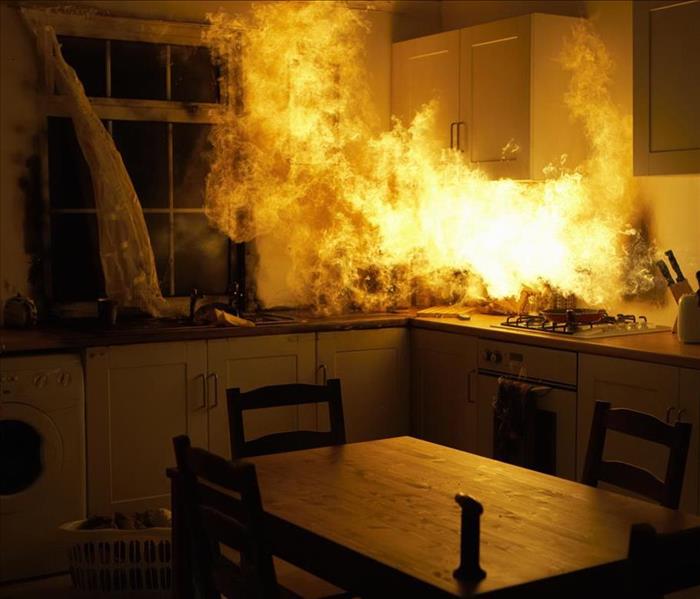 The aftermath of a fire is very devastating. SERVPRO technicians are trained and experienced in fire damage restoration of any size.
The aftermath of a fire is very devastating. SERVPRO technicians are trained and experienced in fire damage restoration of any size.
Residential Fire Damage Restoration Involves Many Important Steps.
In the aftermath of a house fire, Great Neck residents are usually eager to begin the fire cleanup and restoration process. They are often overwhelmed by the destruction of the event and unsure of exactly what must be done. This situation is why the assistance of expert fire remediators is necessary.
While fire damage restoration on your Great Neck residence may seem like an insurmountable task, there are quality services like SERVPRO of Great Neck / Port Washington that know what must be done. In our more than thirteen years of helping local homeowners, we have successfully performed house fire cleanup jobs, smoke remediation work, and full fire damage restoration on their fire-damaged homes. As a result, our highly skilled technicians know all the crucial steps in restoring a fire-impacted residence to its pre-fire state.
The Necessary Steps in CleanUp and Restoring Fire-Damaged Homes are:
- Clearing away smoke-filled air and making interior environments safe by employing state-of-the-art air movers, air scrubbers, ozone machines, and other advanced air-cleaning equipment
- Sanitizing HVAC ductwork and preventing the further spread of smoke particles with high-tech HVAC cleaning systems
- Using wet, dry, abrasive, and innovative methods to remove fire-related residues and clean impacted surfaces around affected homes
- Treating smoke-impacted areas and surfaces with foggers using commercial-grade deodorants
- Performing minor-to-extensive reconstructive work, which could include everything from minor repairs to complete reconstructions, on parts of homes affected by a fire
Once all of these measures have been taken, residences are usually returned to their pre-fire state, and it is often difficult to even notice that a fire has ever occurred.
With that said, if your home ever experiences a fire, rest assured that nearby fire damage restoration help is available. Call your friendly SERVPRO of Great Neck/Port Washington at (516) 767-9600 for assistance.
What Do Water Mitigation Services for a Manhasset Home Entail?
7/29/2021 (Permalink)
 Don't let a ceiling leak in your Manhasset home upset you, just call SERVPRO
Don't let a ceiling leak in your Manhasset home upset you, just call SERVPRO
Manhasset Homeowners Should Expect Industry-Grade Equipment for their Water Remediation Needs
Water damage restoration services are not one-size-fits-all. Even though the basic steps involving water cleanup and water removal services are common to all water damage repairs, each situation warrants a plan tailored to its needs. Enlisting the help of a certified water restoration crew is the first step to a successful intervention.
Your certified water mitigation crew in Manhasset is available by calling SERVPRO and inviting its staff into your home. Our training and experience prepare us to handle damage due to a recent burst pipe or ceiling leak or tackle water damage repairs from erosion over time. Whatever the case is in your home, we offer the latest equipment and techniques recommended by the restoration industry best practices.
It is not uncommon for SERVPRO clients to find themselves in difficult situations because they failed to recognize the early warning signs of water damage. Aside from the evident presence of a leak or puddle, other telltale signs point to excess humidity. Some of those signs might include-
- Musty odor which you detect as you enter your home or inside closets or bedrooms
- Buckling or cupping of your hardwood floors which expand when air moisture levels fluctuate beyond normal readings
- Bubbling or brown spots on ceilings might indicate an attic leak and a higher concentration of humidity
- An inexplicably elevated water bill can also point to a consistent and long-lasting water leak that needs attention
SERVPRO of Great Neck/Port Washington provides water removal services and helps you sort through any necessary water damage repairs. Call us at (516) 767-9600 and invite us to leave your home “Like it never even happened.”
Heavy Storms May Cause Flood Damage to Great Neck Homes
7/22/2021 (Permalink)
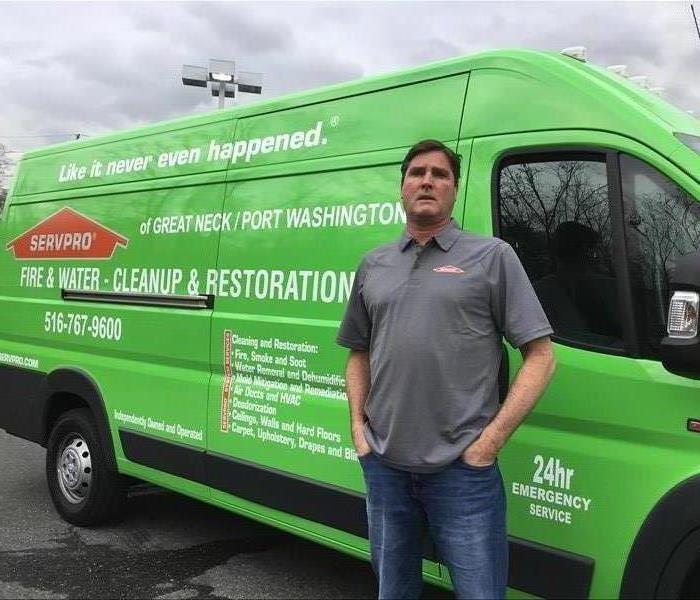 Need help with flooding in Great Neck? Here is Dan the owner/operator of your local SERVPRO, We're Faster To Any Size Disaster
Need help with flooding in Great Neck? Here is Dan the owner/operator of your local SERVPRO, We're Faster To Any Size Disaster
Basement Flooding in Great Neck from Stormwater Can Bring Significant Problems to Homeowner
The past few years have shown Great Neck residents that storms can wreak havoc when you least expect it. Even some unsuspecting rains can become the culprit behind basement flooding or window leaks, leaving your home exposed to the elements and the consequences of water damage. To assess your home's damage and make a sensible water clean-up plan, contact a professional water restoration team.
SERVPRO serves the Great Neck community facing flood damage with the latest in water restoration equipment and techniques. Our trained staff handles tough situations where access and timing may be of concern, and we work around the clock to improve our response time. Upon arrival, our team inspects your property and verifies the site's safety while identifying problem areas and potential threats. We develop an action plan targeted to your needs with facts and data and include removing debris, water extraction, drying, and disinfection.
Fast Negative Effects of Flooding
Our SERVPRO clients often show surprise by how quickly stormwater and excess humidity allow a musty smell to settle upon their homes. As part of our process, we tackle the deodorizing of your property with agents that go well beyond masking the odor. Instead, we seek to kill and neutralize smell particles by using equipment such as ozone machines, hydroxyl generators, foggers, and air scrubbers.
SERVPRO of Great Neck/Port Washington is your team of allies when the weather strikes and brings danger into your home. Call us at (516) 767-9600 and let our experts give you the best the water restoration industry has to offer. Whether you need sewage cleanup or water damage repairs, we are here to help.
Great Neck Homes are Susceptible to Water Damage
7/12/2021 (Permalink)
 Help has arrived--The SERVPRO Team is ready to cleanup water damage in Great Neck
Help has arrived--The SERVPRO Team is ready to cleanup water damage in Great Neck
For Water Restoration in the Great Neck Area, SERVPRO is Ready to Help
Water restoration in a Great Neck home sounds like a long, tedious project, but that isn’t always the case. Homes of all ages and sizes can suffer water damage thanks to a ceiling leak, a burst pipe, or a broken appliance. Regardless of the origin of your problem, delegating the water damage repairs to a professional team is always sound advice.
The professional water restoration team in Great Neck, ready and equipped to handle emergencies of all sizes, is SERVPRO. Our technicians are trained and certified by the Institute of Inspection, Cleaning and Restoration Certification (IICRC), an independent entity that sets standards in the restoration industry. Our training, along with our field experience, sets us apart and prepares us to handle water emergencies of all sizes.
Many homeowners wonder if water removal is something they can handle on their own, and some well-intentioned ones go as far as renting equipment for water extraction.
Although removing standing water is a pivotal step in the process, it is not the only one, and you may risk leaving risk factors unresolved, which can later escalate into problems like mold.
To avoid those complications, SERVPRO takes a multi-pronged approach to water damage remediation, including-
- Water extraction- specialized equipment to remove the water, such as pumps, help us get rid of excess water in your home and belongings. If the volume warrants it, we can even connect to local sewers to dispose of it.
- Monitoring- tools like infrared moisture meters inform us of our progress and keep us working until target measurements are achieved. Our highly sensitive equipment takes out the guesswork from what we do and bases our decisions on sound scientific principles.
- Drying- water removal does not necessarily imply that humidity levels are back to normal. We use dehumidifiers, air movers, and desiccants until the job is done to finish drying your property.
Contacting SERVPRO of Great Neck/Port Washington at (516) 767-9600 is one of the best decisions you will ever make. Let our team of experts help you in your time of need and work for you until your home looks "Like it never even happened."
Mold Found in Great Neck Restaurant’s Wine Cellar
6/23/2021 (Permalink)
 Mold spreads quickly if the environment is humid. Don’t let a mold infestation damage the wines in your restaurant’s cellar. Contact team SERVPRO.
Mold spreads quickly if the environment is humid. Don’t let a mold infestation damage the wines in your restaurant’s cellar. Contact team SERVPRO.
SERVPRO Has Experienced Mold Remediation Specialists Who Can Provide Mold Remediation in Great Neck
Mold in an eatery can be disastrous. In a wine cellar, it can quickly spread to the labels and corks of the wine bottles. This means a loss of business and inventory if left untreated.
Can SERVPRO Stop the Spread of Mold?
If you have discovered mold in your restaurant’s wine cellar or other storage area of your establishment, it should have you heading to the phone immediately. You want a professional mold remediation company in Great Neck with the training and experience to deal with the problem. Our technicians have all of that, plus the right tools to remove the mold safely. Keep in mind; there are mold spores everywhere, so mold can never get removed 100%. What we can remove is the environment that fosters fungal growth. Our mold remediation process can include:
- Non-porous material – Material such as metal, glass, and plastic are considered non-porous and can usually be cleaned. If the surface is dry, we use HEPA vacuuming. Damp wiping with a cleaning solution gets used if the above is not appropriate.
- Porous material – Drywall, carpet, fabric, or insulation are examples of this. If mold has developed on them, they need to be removed and disposed of properly.
- Semi-porous – Concrete and wood are semi-porous. Wire brushing, damp wiping, and other abrasive methods are used to clean impacted surfaces.
If you need help with mold removal or black mold damage repairs, contact SERVPRO of Great Neck / Port Washington at (516) 767-9600.
Can Documents & Books Be Salvaged After Burst Pipes Flood a Home Office in Manhasset?
6/18/2021 (Permalink)
 When a burst pipe situation occurs in your home office, any time delay becomes an issue. Contact our certified SERVPRO team for remediation.
When a burst pipe situation occurs in your home office, any time delay becomes an issue. Contact our certified SERVPRO team for remediation.
SERVPRO’s Documentation Restoration Experts Can Often Restore Important Documents with Unique Water Removal Techniques in Manhasset
When burst pipes send gallons of water flowing into a Manhasset home office, books and papers can become waterlogged. Most people think everything of this nature is ruined and unsalvageable.
Does Everything Wet Need to be Thrown Out?
Immediate water removal is necessary in order to save as much as possible. The assumption that documents and papers must be thrown out when saturated is a false one. SERVPRO can often restore the following content:
- Books & magazines
- Photographs – film, microfiche, and negatives
- Maps & blueprints
- Paper documents
- Parchment
- X-rays
Restoring Your Memories & Important Documents
When a water intrusion occurs, it is not just ordinary papers that can become wet. It is your memories, work information, or vital documents such as birth and marriage certificates. Our IICRC technicians employ the required steps to restore mementos and essential documents. This can include the following process:
- Evaluating the items and ascertaining the correct cleaning methods
- Vacuum freeze-drying can be done immediately to prevent further damage.
- Gamma irradiation for sterilization if needed.
- Air drying and dehumidification.
- Using a computerized inventory system to digitize documents.
- Deodorizing, rejacketing, and other specialty procedures.
Please keep in mind, pictures and papers are never restored to preloss condition. There will be evidence of water damage such as staining, but they can be saved many times. Contact SERVPRO of Great Neck / Port Washington at (516) 767-9600 for water damage remediation.
Are SERVPRO Techs Trained to Deal with Storm Damage in Manhasset?
6/13/2021 (Permalink)
 Flooding can bring many inches of water into your home. Contact SERVPRO for a custom plan of flood damage remediation that will work for you.
Flooding can bring many inches of water into your home. Contact SERVPRO for a custom plan of flood damage remediation that will work for you.
Our Techs Have the Proper Training to Mitigate Flood Damage in Manhasset
Seasonal storms bring heavy rain, strong winds, and severe flooding to New York cities and towns. SERVPRO is available 24/7 to mitigate the havoc caused by heavy storms.
SERVPRO Technicians Go Through Extensive Training
To provide the proper flood damage mitigation in Manhasset, our techs undergo several levels of intense training. They can scope a scene and put together a plan of action quickly. Our Green Team undergo the following:
- Institute of Inspection, Cleaning and Restoration Certification – This certification is earned by training that all cleaning and restoration companies should undergo.
- Initial Franchise Training – Provides the needed experience through hands-on training.
- Employee Certification Training – Upholstery cleaning, water restoration techniques, and carpet cleaning are taught during this course.
- Continuing Education & E-Learning – Our staff undergoes ongoing training to stay on top of the latest technology and advanced restoration and cleaning methods.
Professional Flood Damage Restoration Services
Whenever floodwaters enter a home, there are immediate risks to individuals, the structure, and the content. Floodwater is considered a Level III contaminated water, or black water, and is filled with everything from dead bodies to harmful bacteria. Our flood restoration services include:
- Emergency services – water damage safety comes first
- Tarping a leaking roof from storms
- Basement flooding cleanup
- Sewage cleanup
- Water damage repairs
SERVPRO of Great Neck / Port Washington can provide everything you need to restore your home after a flood hits. Contact us at (516) 767-9600 for more information.
We Are Available 24/7 In Manhasset For All Your Restoration Needs
5/26/2021 (Permalink)
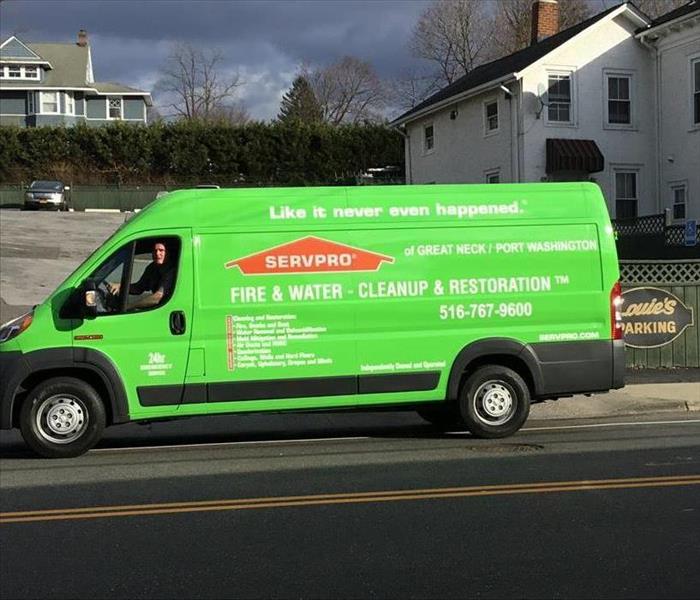 Adequate restoration services for fire damage are unacceptable. SERVPRO will have your home back to preloss condition A.S.A.P., call now for the help
Adequate restoration services for fire damage are unacceptable. SERVPRO will have your home back to preloss condition A.S.A.P., call now for the help
Move-Out Procedures Used To Tackle Fire Damage In Your Manhasset Home
Dealing with fire on your Manhasset property can be grueling for anyone. However, it is a time that you should be worrying about your family, not about whether or not your restoration company can supply you with adequate services. You want to work with a company that helps make the entire process successful and far less stressful.
On occasion, fire damage in your Manhasset area home can be severe enough to warrant moving contents to a safe, clean, controlled environment. The primary tasks involved in a move-out procedure performed by our team fall into six phases. We communicate clearly and consistently throughout the process, helping you understand each phase.
SERVPRO technicians conduct an initial scope and estimate to determine the production staff and supplies required to complete the move-out process. The scope also assists in reaching an agreement between all parties (Insurance Adjuster, Restorer, and You) about what should happen to restore specific items.
At SERVPRO, the most time-consuming part of any move-out involves hours spent inventorying, packing, and moving contents to a warehouse or storage area. We use an organized approach during this phase to help with efficiency, accuracy, and safety.
Our team sorts items into two distinct categories during the packing and inventory process;
- Clean Items - Restorable contents that require cleaning and return packaging.
- Claim Items - Contents that are not restorable, often replaced by insurance.
- Movers and packers take precautions against causing additional fire damage while moving contents from your home to the storage facility. There are specific packing procedures for transporting lamps and shades, glass shelves, mattresses, pictures, paintings, dishware, and essential documents.
Once at the storage facility, SERVPRO teams clean, deodorize, and restore move-out items using an orderly assembly-line approach. Each item receives significant attention and a unique solution depending on the type of material and amount of exposure.
After cleaning and inspecting move-out contents, we make arrangements to return items after completing any construction and restoration services on the structure. We make every effort to accomplish these tasks in a timely, efficient manner, allowing you to return to your home as soon as possible.
Call SERVPRO of Great Neck / Port Washington 24-hours a day, 7-days a week, to access full-service fire damage solutions throughout the area. (516) 767-9600
Call SERVPRO for Water Damage Mitigation with Rapid Removal and Drying
5/18/2021 (Permalink)
 A burst pipe in your home will cause havoc if not recognized quickly enough. SERVPRO has the manpower and equipment for any size water damage job.
A burst pipe in your home will cause havoc if not recognized quickly enough. SERVPRO has the manpower and equipment for any size water damage job.
When Water Damage Hits Your Great Neck Home -- Do This!
Not all water damage is catastrophic, but any excess moisture in your home can lead to many types of problems if not dealt with quickly. A water line leak in an upstairs bathroom, even if stopped right away, can lead to wet carpet in the hallway or nearby bedroom. Even worse, water seeping down into the first-floor ceiling.
If you find yourself with any type of water damage in Great Neck, no matter how minor or significant, the professionals at SERVPRO are here to help restore your home. We're Faster To Any Size Disaster. It is not always as simple as soaking up the spilled water with a towel.
If the water came from a water line, it is most likely clear, clean water needing removal. If the water is gray or black, in cases of contaminated water coming from a toilet overflow, the cleanup is different. Carpet and padding are removed in situations with contamination.
In most instances like this, with a clean water spill, you do not have to lose your carpet. In-place drying is an option, as long as there is no structural damage and no evidence of mold growth. In-place drying is ideal because there's less disruption to the home, and the carpet does not need to be completely pulled up. Some furniture may be relocated to a dry area or wax paper or blocks of wood or styrene placed under the legs.
The first step to drying the carpet is extracting all excess water. A truck mount extractor has the required strength to pull the most water out of your carpet and pads for large volumes of liquid. Typically, portable extractors and vacuums can capture most of the errant water. After extraction, technicians check the padding by gently pulling up a corner of the carpet to confirm no moisture. If they find moisture, they continue to pass over the wet areas. Monitoring to achieve the drying goals of the fibers is achieved with moisture meters and Thermo hygrometers.
Even minimal water leaks create excess moisture in the air. SERVPRO technicians, following IICRC guidelines and best practices, make sure the ambient moisture in your home is between forty to fifty percent through the use of our state-of-the-art equipment. Air movers ensure quicker water evaporation while our dehumidifiers condense water vapors to bring the ambient moisture down to optimal levels.
SERVPRO of Great Neck / Port Washington is here to assist you with water damage 24 hours a day, 7 days a week. Call us at (516) 767 -7600, so our team can make it, "Like it never even happened."
Does SERVPRO Complete Mold Inspections, Remediation, and Removal in Great Neck?
5/13/2021 (Permalink)
 Mold remediation by SERVPRO is second to none. Our technicians are trained and experienced in all phases of mold remediation, from start to finish.
Mold remediation by SERVPRO is second to none. Our technicians are trained and experienced in all phases of mold remediation, from start to finish.
Can SERVPRO Remove Black Mold from Attics in Great Neck Commercial Buildings?
Mold spores can be found everywhere, and they thrive in dark warm areas with moisture present and organic food sources. Often, older commercial buildings will experience small leaks in the roof, allowing moisture to enter attics and other unknown spaces unknown to the owner. These areas are a prime area for mold infestations to occur.
SERVPRO provides mold remediation services in commercial properties in the Great Neck area. If you notice a strong, musty odor, there is a good chance that a mold colony is thriving somewhere in your building. All mold, whether it is black or some other color, can cause health effects.
If you notice a musty odor or observe mold, call SERVPRO immediately. We can dispatch our team in less than 4 hours, 24/7, and complete a mold inspection. Once we have observed the mold colony, our team can develop a plan for mold removal. Mold is easily removed from hard nonporous surfaces; however, the mold may have penetrated porous materials, which must be removed.
SERVPRO can help commercial companies manage:
- Mold inspections
- Mold removal
- Black mold damage repairs.
Call SERVPRO of Great Neck / Port Washington for mold remediation in Great Neck and surrounding areas. We can help 24/7. Call (516) 767-9600.
Floodwater can Cause Permanent Damage to your Great Neck Home
4/29/2021 (Permalink)
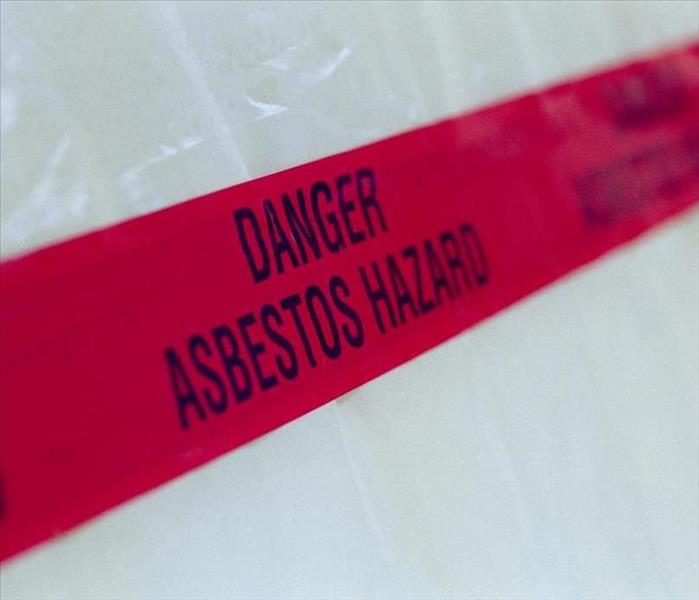 Surprise asbestos abatement may complicate flood and water damage cleanup and removal in Great Neck--SERVPRO can help
Surprise asbestos abatement may complicate flood and water damage cleanup and removal in Great Neck--SERVPRO can help
Call SERVPRO Immediately for Emergency Services Following Storm Damage to your Home in Great Neck
People typically look forward to the spring and summer months when flowers bloom, and we can enjoy outdoor activities. Sometimes, however, storms and showers threaten to ruin our leisure time by partially flooding our homes in Great Neck and leaving a trail of debris in their wake.
For flood restoration and water damage remediation, SERVPRO is your best resource.
Flood damage in Great Neck does not have to be overwhelming when you call upon our team of experts. SERVPRO focuses on continuously educating our staff, bringing the latest in water removal services to you. When floodwaters are the issue, we take as many precautions as we would for sewage cleanup jobs. Personal protective equipment and physical barriers established throughout your home help us avoid cross-contamination and the corresponding water damage escalation. Some of the hazards we assess upon arriving at your home include-
- Structural hazards result from prolonged exposure to water which may weaken the integrity of your home. Particleboard and drywall are susceptible to water, but so are other structural elements, including the home’s foundation.
- Hazardous materials such as asbestos and lead-based paint can be present in some dwellings. At SERVPRO, we coordinate with any necessary parties to mitigate the hazard and abide by environmental guidelines and regulations.
- Chemical hazards can also be present thanks to floodwater itself or the water restoration process's cleaning solutions.
SERVPRO of Great Neck/Port Washington is here to help with emergency services when there is water damage. Call us at (516) 767-9600 and let us leave your home “Like it never even happened.”
Smoke Remediation in a Great Neck Home Requires Specialized Equipment
4/23/2021 (Permalink)
 Great Neck Property Owners Breathe a Sigh of Relief when SERVPRO Arrives for House Fire Cleanup and Restoration
Great Neck Property Owners Breathe a Sigh of Relief when SERVPRO Arrives for House Fire Cleanup and Restoration
SERVPRO has the Latest in Techniques and Equipment to Restore Homes in Great Neck
You may feel smoke damage in your home even when the fire does not occur within your walls. If you live in a multi-family unit or apartment building, smoke may travel through the ventilation system and invade your space with its offending smell. If the flames burn in your property, your need for fire and smoke damage restoration and cleanup may be more significant.
SERVPRO specializes in fire damage restoration in Great Neck. When fire-damaged homes need cleanup, many property owners fail to recognize that each surface requires a plan tailored to its characteristics. The EPA-approved solutions we use can be abrasive to some materials, and our certified team of experts operates accordingly. Agitation helps us dislodge residue and facilitate its removal. Some examples of agitation techniques include-
- Dry cleaning sponges- the friction and porosity of the sponge attracts loose soil on a surface. Although not recommended for greasy residue, it is ideal for the remains of dry smoke.
- Compressed air- the air pressure helps us blast air and dislodge particles from crevices and edges. Our SERVPRO team regulates the strength of the compressed air to protect the surfaces and items being cleaned.
- Abrasive powders- as the name implies, these are abrasive and need to be used carefully. This type of solution is applied and removed as suggested by industry best practices and only on surfaces that can withstand their strength.
When you contact the professional team of SERVPRO of Great Neck/Port Washington at (516) 767-9600, you gain access to specialized products and equipment. Our team is ready to manage your fire restoration needs with complete restoration and loss mitigation as our goal.
Basement Flooding of Manhasset Homes can be Dangerous when Left Unattended
4/18/2021 (Permalink)
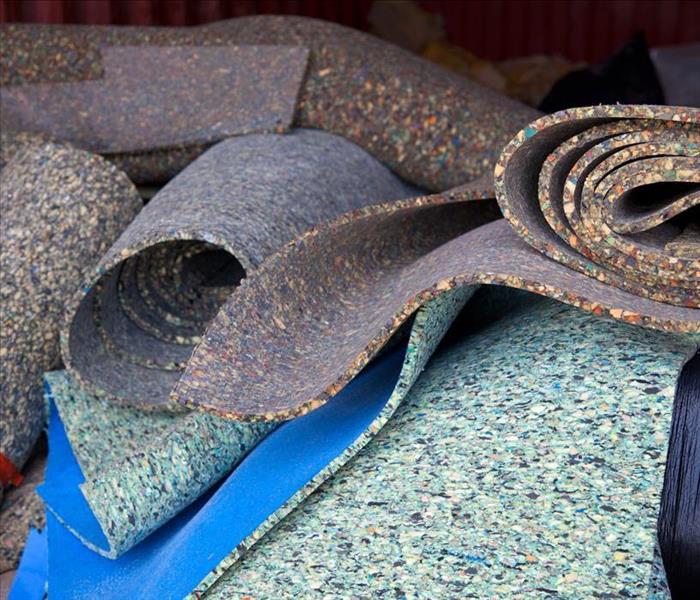 SERVPRO can restore or replace carpet padding after a water leak in a Manhasset home. We have the equipment.
SERVPRO can restore or replace carpet padding after a water leak in a Manhasset home. We have the equipment.
Entrust the Water Damage Restoration of your Manhasset Home to SERVPRO
Burst pipes and ceiling leaks can cause severe water damage in a Manhasset home, and it is not uncommon for homeowners to be unaware of the issue until it escalates. When water damage repairs are needed, relying on family and friends for help is not enough. Instead, call a professionally certified crew of experts to assess the situation and help establish a course of action and mitigate the damage.
In Manhasset, where water damage can happen due to weather factors and some homes' age, SERVPRO is ready to help. Close to Manhattan, many of the families who live in town take advantage of public transportation to commute to their jobs in the city. However, they get to enjoy the numerous green spaces available for leisure once they return home. Munsey Park, Shelter Rock, and North Hills all invite residents and visitors to enjoy the outdoors.
Not surprisingly, homeowners in Manhasset would rather spend their time in one of the town’s notable shopping areas instead of navigating the intricacies of water damage restoration.
Restoration can be achieved by calling SERVPRO and letting us take charge. Our staff is ready around the clock to meet your water clean-up needs by applying the latest best practices in our industry. When our fleet arrives, you can see for yourself that our equipment is suited for jobs of all sizes, including the extraction of water in large volumes as well as smaller amounts. Furthermore, the careful documentation we keep can be helpful when communicating with your insurance company.
Addressing Floors with Water Damage
It is not surprising that water settles on flooring materials whenever a pipe bursts or there is a leaking roof. Our first instinct may be to rent a heavy-duty wet-dry vacuum and extract any standing water. As sensible as this seems, extraction is not enough. At SERVPRO, we have specialized equipment such as drying mats, handheld extractor wands, and injecti-dry devices to restore your floors and carpet while maintaining a balanced humidity level. Some of the risks for your floors when there is excess moisture include-
- Delamination- when water causes the backing of your carpet to separate, that is called delamination. The latex that holds your flooring material's primary and secondary backing deteriorates significantly in water incidents, especially if it is of poor quality. Improper extraction or folding of the carpet can also cause delamination.
- Compromised Padding- padding may break when wet, making its replacement both necessary and cost-efficient. When our SERVPRO crew looks at the padding, we can make a recommendation based on our expertise. The average homeowner or repair person may not realize the extent of the issue because they lack the proper equipment to gauge the saturation level.
- Warping- tile floors may appear dry if the grout and joints were installed correctly. However, even a tiny crack in a tile or grouting may allow the subfloor to soak up water and eventually loosen up the tiles and joints. Our staff monitors moisture in the floor continuously to assess the drying process's progress and avoid complications.
SERVPRO of Great Neck/Port Washington provides much more than drying solutions. We leverage technology to restore your home, even the areas you did not think had been affected. Call us at (516) 767-9600 for a comprehensive assessment of your needs.
Floodwater Can Cause Permanent Damage to Your Great Neck Home
4/18/2021 (Permalink)
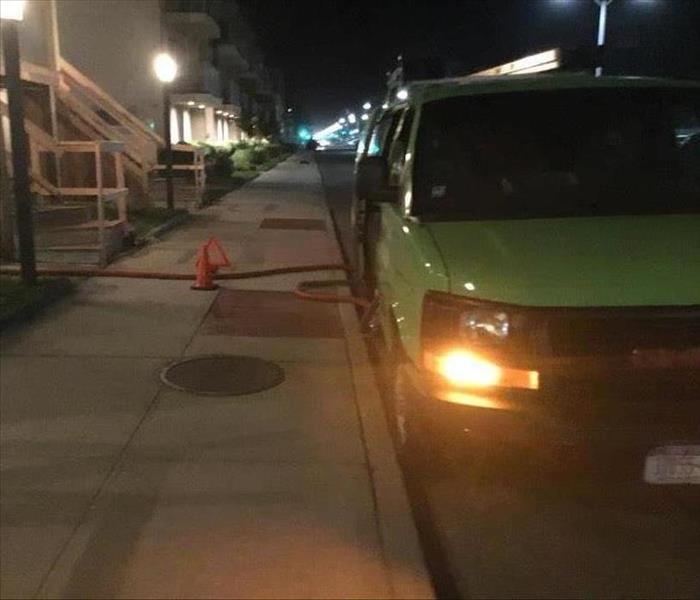 SERVPRO promises to arrive swiftly for emergency flood services in Great Neck--even in the dead of night, we can help 24/7.
SERVPRO promises to arrive swiftly for emergency flood services in Great Neck--even in the dead of night, we can help 24/7.
Call SERVPRO Immediately for Emergency Services Following Storm Damage to your Home in Great Neck
People typically look forward to the spring and summer months when flowers bloom, and we can enjoy outdoor activities. Sometimes, however, storms and showers threaten to ruin our leisure time by partially flooding our homes in Great Neck and leaving a trail of debris in their wake.
For flood restoration and water damage remediation, SERVPRO is your best resource.
Flood damage in Great Neck does not have to be overwhelming when you call upon our team of experts. SERVPRO focuses on continuously educating our staff, bringing the latest in water removal services to you. When floodwaters are the issue, we take as many precautions as we would for sewage cleanup jobs. Personal protective equipment and physical barriers established throughout your home help us avoid cross-contamination and the corresponding water damage escalation. Some of the hazards we assess upon arriving at your home include-
- Structural hazards result from prolonged exposure to water which may weaken the integrity of your home. Particleboard and drywall are susceptible to water, but so are other structural elements, including the home’s foundation.
- Hazardous materials such as asbestos and lead-based paint can be present in some dwellings. At SERVPRO, we coordinate with any necessary parties to mitigate the hazard and abide by environmental guidelines and regulations.
- Chemical hazards can also be present thanks to floodwater itself or the water restoration process's cleaning solutions.
SERVPRO of Great Neck/Port Washington is here to help with emergency services when there is water damage. Call us at (516) 767-9600 and let us leave your home “Like it never even happened.”
What Steps Are Vital For Safe Mold Remediation?
3/22/2021 (Permalink)
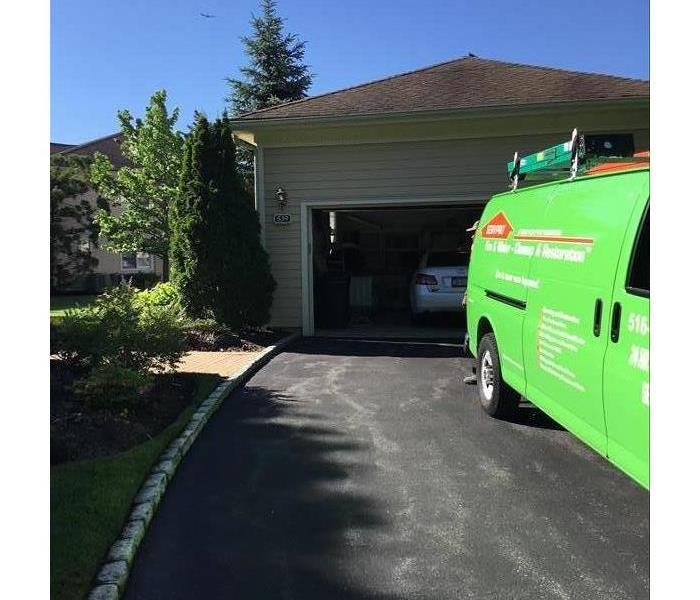 Mold removal in your home is very discouraging. Let The team of professionals at SERVPRO take care of the job for you.
Mold removal in your home is very discouraging. Let The team of professionals at SERVPRO take care of the job for you.
SERVPRO Helps Execute Mold Removal from Manhasset Properties Safely
Although microbial development spikes when there is excess moisture in a structure, it takes more than drying the building to eliminate mold. Some of the steps necessary for the removal can present various risks, including spreading residues all over the property or exposing the house occupants.
The desire for safe mold remediation in Manhasset is attainable if the team handling the process takes precautions like:
- Proper disposal of wastes removed from the structure
- Use of appropriate cleaning products
- Setting up containment barriers and using negative air pressure
Mold remediation involves removing various materials such as heavily infested porous materials since cleaning cannot address the problem entirely. When our SERVPRO technicians remove such materials, we use heavy-duty plastic bags to hold them before we can dispose of them properly.
Removing moldy residues from non-porous surfaces such as metal, glass, or plastic requires damp wiping. Using the right cleaning agent eases the work involved. Our SERVPRO technicians use antimicrobial ingredients products to help kill spores, thus ensuring long-term results after the remediation.
SERVPRO of Great Neck / Port Washington has completed mold remediation successfully for several years. Call us at (516) 767-9600 for assistance if your home is affected.
What Determines The Time It Takes To Complete Water Removal?
3/15/2021 (Permalink)
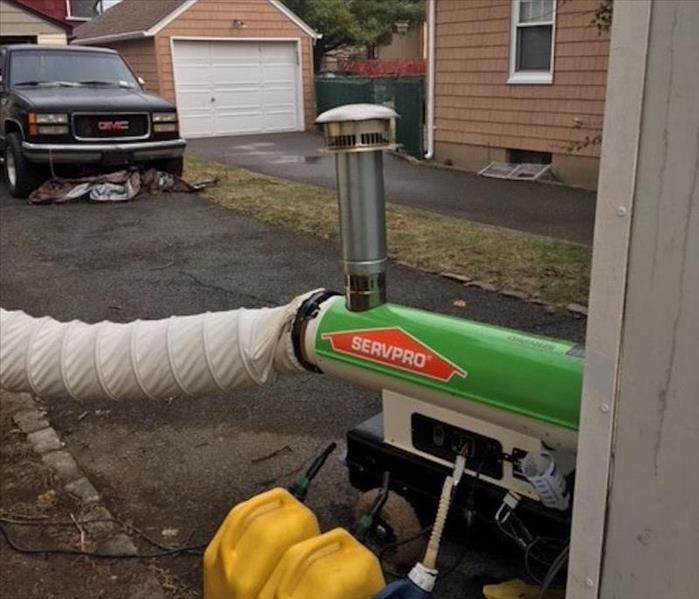 Water restoration to your property is a job for SERVPRO. They specialize in water restoration services of any size.
Water restoration to your property is a job for SERVPRO. They specialize in water restoration services of any size.
SERVPRO Makes Various Calculations to Estimate Timelines When Renovating Great Neck Properties
Before embarking on water removal from your property, you might want to know how long the processes involved are likely to take for reasons such as arranging alternative accommodation. Professional restorers can provide accurate estimates.
The time taken to complete water removal from Great Neck properties depends on the amount of water involved, the types of materials affected, and the resources used to manage the removal. Professionals derive an estimate by making calculations based on these aspects. Our SERVPRO technicians:
- Estimate the amount of moisture by checking room dimensions
- Calculate the setup of air movers and dehumidifiers
- Consider the drying system
Our SERVPRO IICRC certified technicians also help set the right drying goals because effective removal must be completed in good time to avoid secondary problems. For instance, if materials remain wet for over 48 hours, mold can develop, complicating the renovation. We can overcome such problems by using unique drying techniques, thus quickening drying. For instance, positioning air movers at a 45-degree angle against walls ensures that air bounces off the walls, thus moving moisture away faster.
SERVPRO of Great Neck / Port Washington optimizes water removal for faster results. Call us at (516) 767-9600 for assistance.
How effective is Fire Damage Restoration in Saving Property?
3/8/2021 (Permalink)
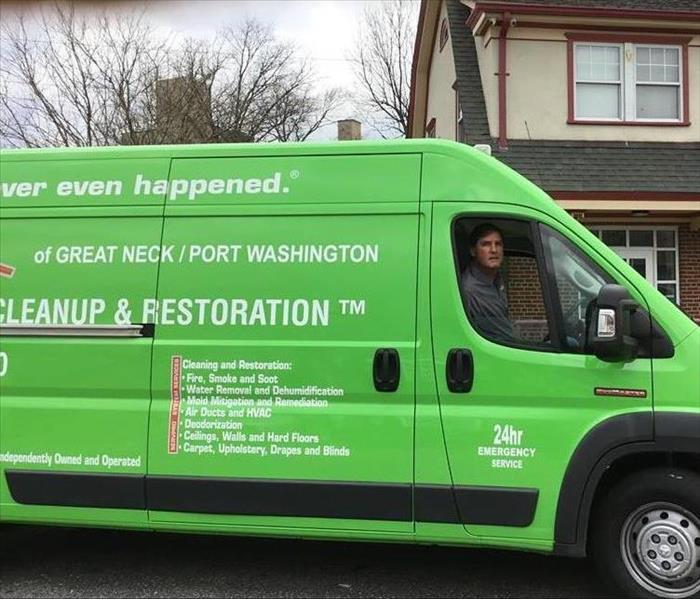 Fire damage to your home is no DIY project. Call the pros at SERVPRO and let their IICRC certified techs handle the job for you.
Fire damage to your home is no DIY project. Call the pros at SERVPRO and let their IICRC certified techs handle the job for you.
SERVPRO Helps Manage All aspects of Smoke and Fire Restoration in Great Neck to Ensure a Positive Outcome
Nine villages and a couple of unincorporated communities combine to make up Great Neck city in Long Island, New York. The area has undergone various changes over the years since it was founded as an agricultural community mainly consisting of orchards and farmlands. In the early days, commercial activities were centered around one section - Middle Neck Road, which runs from Great Neck Plaza to Kings Point. Long-time residents still call this area 'the village.'
The Shift To Real Estate
The major shift from agriculture to real estate occurred starting from the 1800s, fuelled by the construction of the Long Island Railroad and the telephone development, which made it easy for New Yorkers to shift from the city without losing the connection. Several wealthy and famous people such as J.P Morgan, George Dodge, and Walter Chrysler acquired properties in the area, making it attractive to other people too. The addition of more railway lines such as the Flushing Northside Railroad and the widening and paving of Queens Boulevard brought in a flood of investors.
The Originals of the Mixed Real Estate Profile
Most areas have different types of real estate developments, mostly because of the owners' differing preferences. However, in Great Neck, the differences can be traced back to how the area developed. Housing in the area can be loosely classified into three categories:
- High-end real estate
- Single-family homes
- Condos and Co-op housing
At the onset of the construction boom, wealthy investors flocked into the area to set up high-end properties such as English-style homes with ornate windows, wide fireplaces, and elaborate gardens. However, for these wealthy builders to maintain their homes, they needed help, so immigrants and local laborers were brought in, which led to the construction of simple, one or two-story homes.
The Great Depression had an impact on the real estate development trends in Great Neck. For instance, the hardship stalled many significant developments, including the Great Neck Plaza, incorporated in 1930. The Federal Housing Association intervened to give a boost to the area by providing loans for low-cost apartments, which led to the introduction of condos such as the Wyngate residential complex that was launched in 1936.
Many of the older buildings in the area are considered historical landmarks, although many are torn down from time to time to pave the way for new constructions. Great Neck Village tries to preserve these buildings by offering owners tax breaks.
How SERVPRO Helps Preserve Homes Affected by Fire Damage in Great Neck
Fire incidents pose a significant threat to all types of homes in the area. However, tearing down every structure affected by fires is not always feasible. Opting to clean up and restore the structure is the better response.
In case you are afraid the restoration might be costlier than you expect, you can involve a professional restorer to help with estimates and manage the restoration process. SERVPRO takes various steps to ensure the right outcome, including:
- Testing to locate all smoke residues
- Inspecting materials and estimating the restoration costs
- Handling subcontractors
- Working with insurance adjusters
SERVPRO of Great Neck / Port Washington has extensive experience handling fire damage incidents in homes, thus equipping us with the skills to manage renovation processes conveniently. Call us at (516) 767-9600.
What Steps Are Vital For Safe Mold Remediation?
3/8/2021 (Permalink)
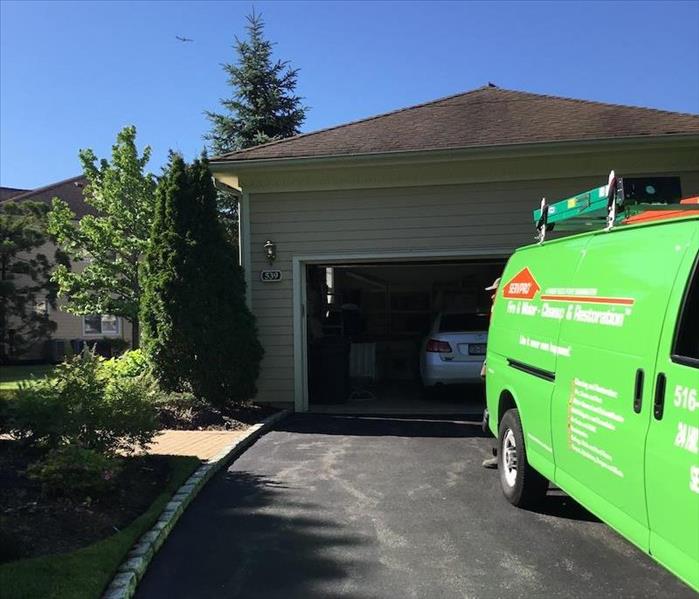 Mold removal in your home is very discouraging. Let The team of professionals at SERVPRO take care of the job for you.
Mold removal in your home is very discouraging. Let The team of professionals at SERVPRO take care of the job for you.
SERVPRO Helps Execute Mold Removal from Manhasset Properties Safely
Although microbial development spikes when there is excess moisture in a structure, it takes more than drying the building to eliminate mold. Some of the steps necessary for the removal can present various risks, including spreading residues all over the property or exposing the house occupants.
The desire for safe mold remediation in Manhasset is attainable if the team handling the process takes precautions like:
- Proper disposal of wastes removed from the structure
- Use of appropriate cleaning products
- Setting up containment barriers and using negative air pressure
Mold remediation involves removing various materials such as heavily infested porous materials since cleaning cannot address the problem entirely. When our SERVPRO technicians remove such materials, we use heavy-duty plastic bags to hold them before we can dispose of them properly.
Removing moldy residues from non-porous surfaces such as metal, glass, or plastic requires damp wiping. Using the right cleaning agent eases the work involved. Our SERVPRO technicians use antimicrobial ingredients products to help kill spores, thus ensuring long-term results after the remediation.
SERVPRO of Great Neck / Port Washington has completed mold remediation successfully for several years. Call us at (516) 767-9600 for assistance if your home is affected.
Managing the Risks of Flood Damage in Great Neck
2/26/2021 (Permalink)
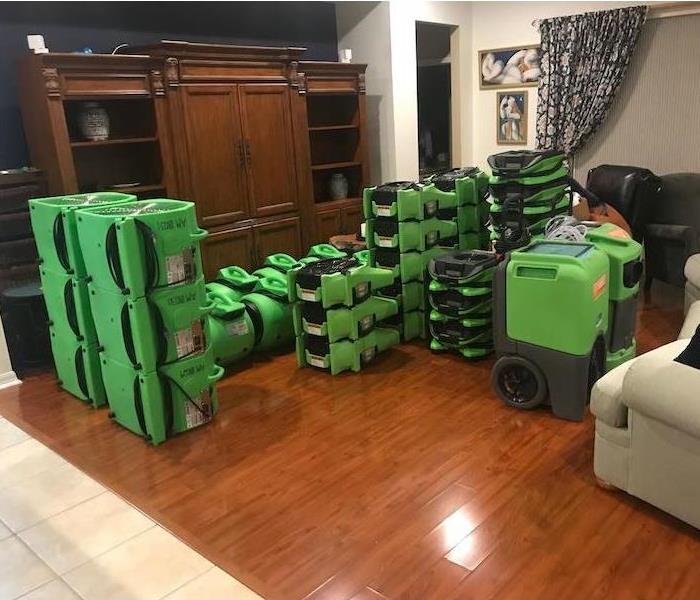 We understand how seriously flood water can impact your property.. No matter when you make the call, we have technicians who can assist you.
We understand how seriously flood water can impact your property.. No matter when you make the call, we have technicians who can assist you.
SERVPRO Helps Great Neck Property Owners Manage Direct and Secondary Risks
Flooding after storm incidents is associated with various risks, including immediate damage to the structure or contents and heavy contamination. However, the passage of time can create secondary issues, compounding the risk to occupants or the people doing the restoration.
Proper management of a flood damage site in Great Neck helps mitigate various risks if done correctly. Appropriate moisture management is one of the primary ways to minimize secondary risks from flooding. For instance, it is easier to curtail mold growth through moisture management. Drying wet floor surfaces also helps minimize the chances of slip and fall accidents.
SERVPRO takes different steps to manage flooding loss sites, including
- Creating physical barriers by boarding up openings
- Setting up warning signs indicating hazards such as slippery floors
- Spraying EPA registered disinfectants directly into the water pooling in the house
By limiting access to affected areas and using chemical agents such as phenols and quaternaries to destroy up to 99% of microorganisms, we can maintain safety at the loss site.
SERVPRO of Great Neck / Port Washington has qualified technicians who can help you address any issues that arise after flood damage. Call us at (516) 767-9600 to help.
Do Building Materials Influence the Outcome of Water Mitigation?
2/19/2021 (Permalink)
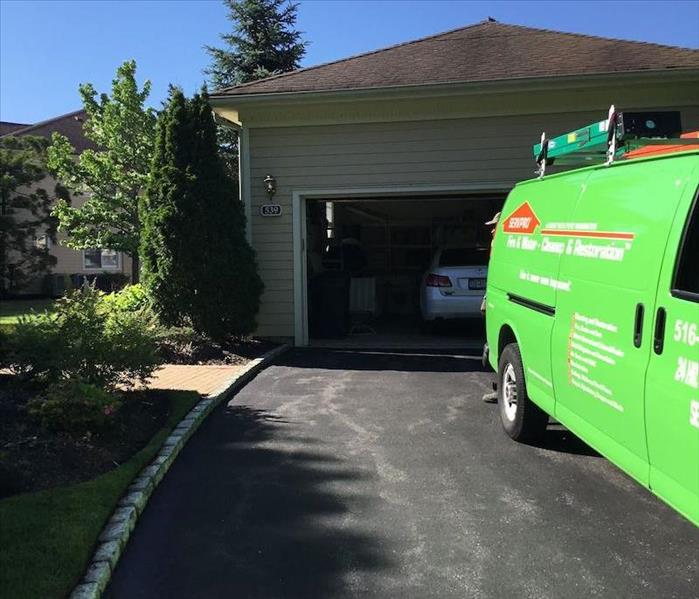 SERVPRO has the experienced technicians with the equipment and expertise your home needs after a water catastrophe. Give us a call right away.
SERVPRO has the experienced technicians with the equipment and expertise your home needs after a water catastrophe. Give us a call right away.
SERVPRO's Superior Understanding of Materials Helps When Restoring Roslyn Properties
When moisture accumulates in unwanted areas of your home, there is a need to take steps to remedy the situation. The outcome mainly depends on the kind of remedial measures taken and the timing of such actions. However, the type of materials that make up the structure might also be impacted.
Diverse characteristics of building materials can influence the water mitigation processes Roslyn properties require or the outcome when standard remedial procedures are applied. For instance, if a building has a significant percentage of porous materials, moisture is likely to spread further. The good thing is that such materials release moisture fast, so drying processes are likely to bear fruit faster. Our SERVPRO technicians evaluate your property to establish:
- The permeance factor in most materials
- Whether there are hygroscopic materials
- The equilibrium moisture content of wooden materials in the structure
The information helps determine the level of drying necessary to achieve standard dryness. For wood materials, the moisture content should be around 7.7% to 11% if the relative humidity inside the house is about 40% to 60%. In the case of hygroscopic materials that absorb moisture from the air, our SERVPRO technicians strive for balanced evaporation and dehumidification during drying.
SERVPRO of Great Neck / Port Washington handles water mitigation conveniently. Call us at (516) 767-9600.
How likely is Business Recovery after Flood Damage?
2/9/2021 (Permalink)
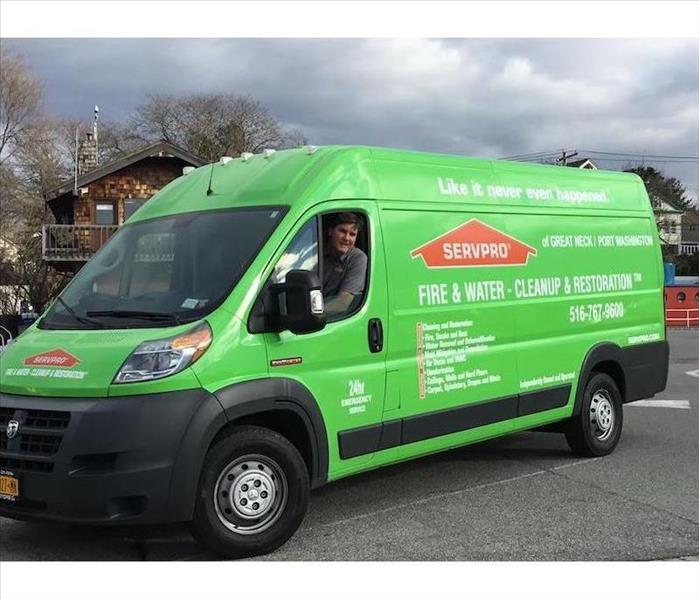 SERVPRO works to provide Fast and Efficient Water Damage Cleanup and Restoration to Your Commercial Property.
SERVPRO works to provide Fast and Efficient Water Damage Cleanup and Restoration to Your Commercial Property.
SERVPRO Handles All Restoration Aspects to Help Great Neck Businesses after Flooding
Many who have visited or lived in Great Neck love it's easy commute to Manhattan. This convenience can be attributed to its train station, which also serves as a hub for Nassau Inter-County Express buses. Great Neck Village is part of North Hempstead town, Nassau County in Los Angeles. The term Great Neck is also used to refer to the entire north shore peninsula and the area extending to Lake Success.
Mattinecock Native Americans originally inhabited the area before the English, and the Dutch settlers arrived in the mid-17th century. They primarily relied on fishing and trading with others for their sustenance. They even named the area Menhaden-Ock because of the significant supply of fish in the area. The name later evolved to Madman's Neck when pilgrims landed in Saddle Rock before settling on the name Great Neck.
After the arrival of European settlers, farming was introduced in the area. The settlers planted crops and kept animals such as cattle. In the late 1800s, the area started transforming into a commuter town after the establishment of the New York and Flushing Railroad.
Areas of Interest in Great Neck
Apart from the transportation convenience, there are other fascinating aspects of the area, including landmarks, parks, museums, and eateries. The most notable ones include:
- Sands Point Preserve Conservancy
The 216-acre park has a significant outdoor space with scenic trails and direct access to the beach and historic mansions. It preserves the grandeur and elegance which defined the Gold Coast years of the early 20th century when affluent Americans built mansions on massive estates that mostly served as their summer retreats. The conservancy offers year-round cultural and educational programs, mansion tours, seasonal celebrations, and fitness activities.
The park offers easy access to the beach along Manhasset Bay. It also has several outdoor activity resources, including a community pool with water slides, playgrounds, and athletic fields. There are also covered areas that are perfect for family activities, such as picnics.
The perfectly landscaped park offers convenient green spaces for general relaxation or for kids to play. For art lovers, the tree-made totems by the artist Ken Packie are a real gem.
The children's amusement center is great for events such as birthdays. It offers various inflatable resources for kids' entertainment. Apart from hosting birthday parties, kids can also enjoy group outings, open jump sessions, and other kid-focused events.
How SERVPRO Helps Businesses Recover from Flooding Incidents
Flooding causes many damages and disruptions, whether it affects an amusement joint or regular business premises. If not correctly handled, such incidents cause many businesses to close down. Seeking assistance from a professional restoration company such as SERVPRO is one way to guarantee a positive outcome.
SERVPRO effectively handles the human, technical aspects of the restoration easing the burden for the business owner. For instance, we provide highly trained technicians who have a better understanding of the flooding incident's implications. For example, our technicians know that if no action is taken within 48 hours, mold is likely to develop, complicating the problem further. Some of the benefits of using our restoration teams include:
- Faster extraction of standing water
- Thorough cleaning of the premises using mechanical and chemical resources
- Proper deodorization to eliminate all odors
SERVPRO of Great Neck / Port Washington has sufficient experience handling flood damage restoration. Call us at (516) 767-9600 for immediate assistance.
Winter Water Sports in Great Neck Take Place from February Onwards
1/25/2021 (Permalink)
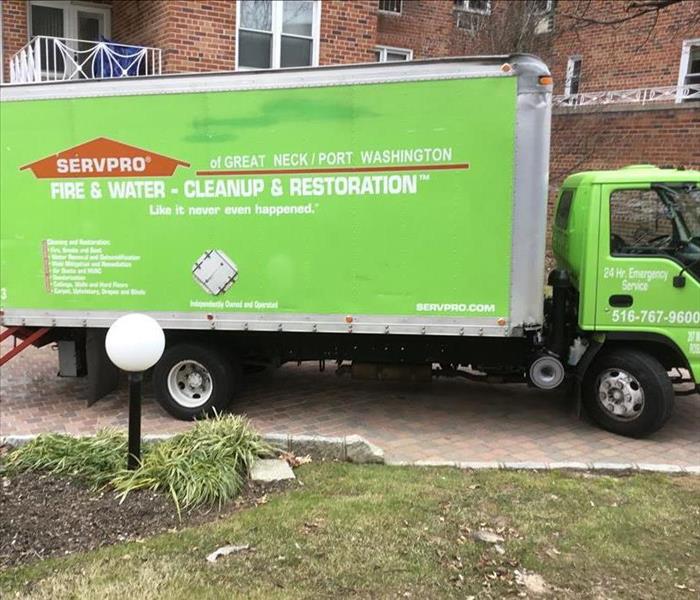 SERVPRO box trucks are stocked with fire damage equipment mitigation to quickly restore your Great Neck property
SERVPRO box trucks are stocked with fire damage equipment mitigation to quickly restore your Great Neck property
Great Neck's Waterways are an Excellent Place to Pickup a New Skill this Winter
Two bodies of water surround Great Neck. The Atlantic Ocean on the eastern side of Long Island provides waves and beaches, while the western Long Island Sound is ideal for windsurfing and jet-skiing. Watersports NYC is located on Stepping Stone park providing residents and visitors with both the equipment and training they need. The instructors are knowledgeable of the surrounding area and are qualified to teach from beginner through to advanced levels. Flyboarding is among the specialties here, which is a relatively new water sport invented in 2012. The equipment uses hydro jets to push riders above the water. While it may look complicated, the learning time is around five to ten minutes to get a fundamental skill requisite. The local independent company supports group bookings, gift bookings, and individuals.
- Stepping Stone Park is located on the Northern Shore of Long Island.
- Flyboarding instructors have both safety and technical training certificates.
- Bookings can be made online or through their website.
A house fire can cause significant deteriorating damage to your home and contents. Contact SERVPRO of Great Neck / Port Washington at (516) 494-3869.
Boat Tours to Manhasset Lighthouse Resume this January
1/18/2021 (Permalink)
Tours to the Stepping Stone Lighthouse to Experience a Unique Piece of Manhasset History
The Stepping Stone Lighthouse on Manhasset Bay first opened in 1877 and is a fantastic example of the Victorian architecture that was once common-place on the North Shore. The lighthouse, which sits between Great Neck and City Island, is opening up for public tours for the first time, with members of the Long Island Historical Society providing an in-depth explanation and account of its history. Tours leave from the Stepping Stone pier and provide glimpses of the famous Gold Coast Mansions that are a feature of the region. Each time lasts around seventy-five minutes, covering King's Point, Forts Skyler, and Totten before passing by the famous lighthouse. Efforts to restore the structure are underway, with the estimated restoration costs expected to be around $4 million.
The tour services are run non-profit by the Long Island Historical Society.
Departures are available both morning and afternoon.
Fundraising for restorations is being gathered through sponsorship and local government efforts.
A water intrusion event can have a lasting impact on your property. Contact SERVPRO of Great Neck / Port Washington at (516)494-3869.
Manhasset Residents Use Licensed Restoration Professionals to Recover their Belongings after Flooding
1/11/2021 (Permalink)
 Manhasset homeowners know to call SERVPRO for flood damage mitigation and rescue of possessions
Manhasset homeowners know to call SERVPRO for flood damage mitigation and rescue of possessions
SERVPRO Provides Round the Clock Flood Restoration for the Manhasset Region
The New York City Metropolitan area covers a vast strip of the eastern coast with Manhasset, of Nassau County, being incorporated into the region. The hamlet of Manhasset is among a collection of small towns that make up the northern border of Long Island. Widely regarded as a bedroom community, this little set of villages offers close transportation links to New York City while maintaining a quieter residential feel. The region's population first began to experience rapid growth with the arrival of the Long Island railway service in 1898. The infrastructure connecting Long Island to inner New York was essential to the rising population. However, the trading outpost's importance during the industrial revolution also saw a diverse mixture of people come to settle on the northern coast of Long Island. The region has become popular in modern culture, with many films and books set along the gold coast, an affluent part of the East Coast that offers unique post-modern architecture and prestigious residents.
The gold coast region was a popular holiday destination for the rich and famous during the twentieth century. The convenience afforded by proximity to the city resulted in significant land investment that has since made up some of Manhasset's neighborhoods and villages. Munsey Park was owned by newspaper editor Frank A. Munsey who purchased over 663 acres of grounds in and around Manhasset. His death, and lack of heirs, meant that the Munsey Estate passed over to the Metropolitan Museum of Art. Other wealthy landowners in the region include the Vanderbilts, who owned an estate of 100 acres. Much like Munsey Park, many of these grounds were redeveloped or turned into smaller communities and villages. The names these regions carry is a testament to the original owners of the vast swathes of land on the northern shore of Long Island. Other neighborhoods include North Hills, owned by New York Herald Publisher John Hay Whitney, Flower Hill, and Greentree. Some gold coast estates are still intact today, with nearly a quarter of Manhasset lands remaining under private ownership.
- The building of the Long Island railway was an essential piece of infrastructure to the town's growth. The distance from Manhasset to Manhattan is roughly 19.5 miles. The Long Island Railroad takes around thirty minutes to reach Manhattan. The railway's arrival led to many publishers, bankers, and celebrities moving to the North Shore of Long Island.
- The gold coast is a moniker describing the vast estates that were common on Long Island. In the early twentieth century, successful business people and traders would construct holiday estates that sometimes stretched over 600 acres. Today, regular gold coast mansion tours can be taken by boat from Manhasset Bay.
- The Americana Manhasset is an alfresco shopping center that was initially built in the fifties. As the neighborhoods have developed, this shopping center has become famous for its sale of premium goods. Current occupants and retail outlets of Long Island's Miracle Mile include Ralph Lauren, Prada, Chanel, and Georgio Armani.
Visiting Manhasset and the Gold Coast
The North Shore of Long Island is world-renowned for its wealth and lavish properties. The Gold Coast resulted from the vast amounts of wealth produced by the second industrial revolution in 1890, often referred to as the gilded era. During this period, over five hundred mansions were erected along the gold coast.
- The Caumsett State Historic Park Preserve and the Nassau County Museum of Art were formerly gold coast mansions owned by Marshall Field and Henry Clay Frick. The two owners had wealth in US steel companies and department stores.
- Other stunning mansions in the region include the Planting Fields Arboretum State Historical Park and The Sand Points Preserve. Many of these iconic builds allow public access through the grounds and for tours.
- At one point, the Vanderbilt family-owned over 400 acres of land along the Northern Shore of Long Island. On 180 Little Neck Road is the Vanderbilt Museum & Planetarium, built in the Spanish revival style that is commonplace in this area.
- Beaches in the area are well renowned for their pristine sands and fishing opportunities. Among the highlights is the Daniel R. Davis Preserve on Mount Sinai-Coram Road and Cedar Beach. Manhasset Bay also features a stunning promenade with restaurants, water taxis, and bars lining the waterfront.
SERVPRO Can Help Manhasset Resident Recover their Home and Belongings after Flooding
Flooding can be the result of extreme weather conditions or internal plumbing issues. The consequence of flooding can be dramatic, with large bodies of water affected both the structural integrity of your home as well as its contents and fixtures. To prevent damages associated with flooding, it is essential to contact a professional restoration service as quickly as possible. The impact of water exposure becomes more extreme the longer that your home is exposed. SERVPRO operates a twenty-four-hour restoration service that focuses on reducing losses caused by water damage and recovering salvageable items. Our teamwork quickly from the moment they arrive to assess your home and ensure that it remains safe and secure. If you are to relocate temporarily due to flooding, our crew chiefs can stay in contact with you throughout service to minimize stress and inconvenience.
- Technicians can secure your property after flooding by boarding up broken windows and doors or fitting water-proof tarpaulins over damaged roofing. We can guard your home throughout the restoration.
- Water mitigation focuses on reducing the typical losses associated with water damage. Our team uses advanced drying techniques alongside industrial extraction equipment to ensure that losses are kept to a minimum.
- Regular pre-testing and monitoring ensure that the restoration method is as efficient as possible. Reducing the time it takes to dry the home can minimize inconvenience and secondary damages like mold growth.
A flooded property can be hazardous and cause extensive damage to your possessions and fittings. Contact SERVPRO of Great Neck / Port Washington at (516) 469-3937 for assistance.
Boat Tours to Manhasset Lighthouse Resume this January
1/11/2021 (Permalink)
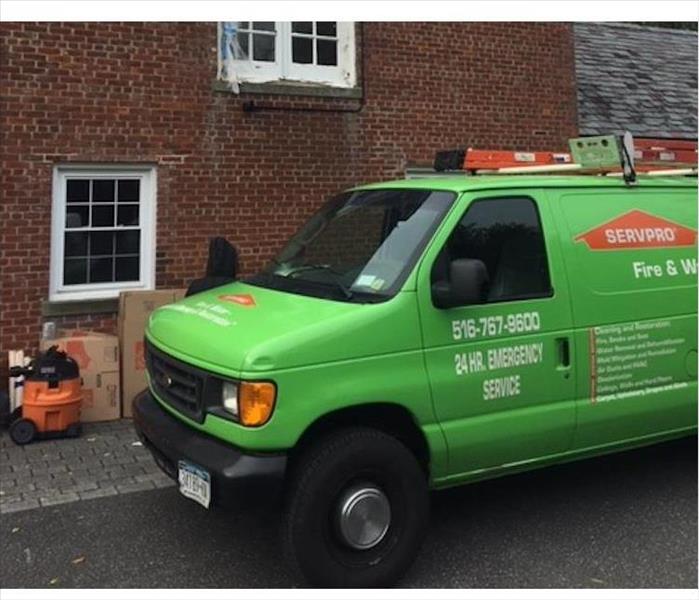 SERVPRO is your beacon for commercial water removal in Manhasset
SERVPRO is your beacon for commercial water removal in Manhasset
Tours to the Stepping Stone Lighthouse to Experience a Unique Piece of Manhasset History
The Stepping Stone Lighthouse on Manhasset Bay first opened in 1877 and is a fantastic example of the Victorian architecture that was once common-place on the North Shore. The lighthouse, which sits between Great Neck and City Island, is opening up for public tours for the first time, with members of the Long Island Historical Society providing an in-depth explanation and account of its history. Tours leave from the Stepping Stone pier and provide glimpses of the famous Gold Coast Mansions that are a feature of the region. Each time lasts around seventy-five minutes, covering King's Point, Forts Skyler, and Totten before passing by the famous lighthouse. Efforts to restore the structure are underway, with the estimated restoration costs expected to be around $4 million.
The tour services are run non-profit by the Long Island Historical Society.
Departures are available both morning and afternoon.
Fundraising for restorations is being gathered through sponsorship and local government efforts.
A water intrusion event can have a lasting impact on your property. Contact SERVPRO of Great Neck / Port Washington at (516)494-3869.
Take a Water Taxi From Port Washington For Unforgettable Winter Views of Manhasset Bay.
12/21/2020 (Permalink)
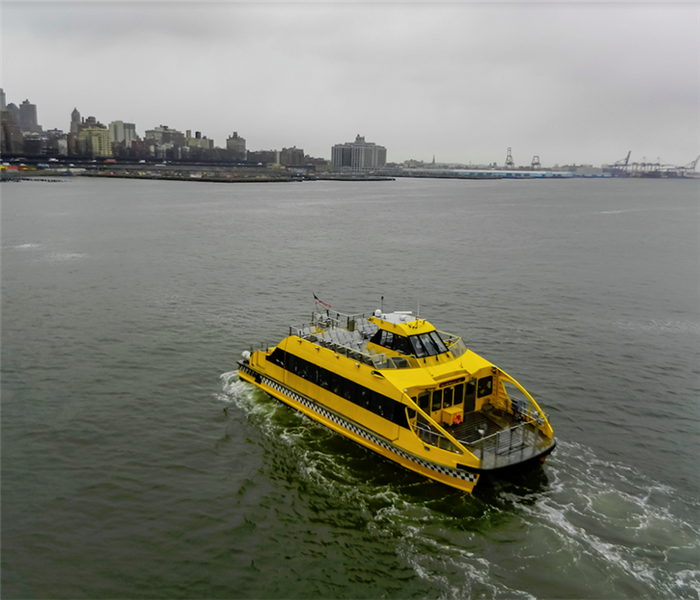 SERVPRO is looking forward to seeing the sights on Manhasset Bay!
SERVPRO is looking forward to seeing the sights on Manhasset Bay!
Manhasset Bay is an Idyllic Marina and Boardwalk, Which is Best-Viewed by Water Taxi.
The Port Washington Water Taxi was set up nearly 20 years ago by local Matt Meyran. The laid back ambiance of viewing the bay from the water has proven to be a massive hit with tourists and residents who, surprisingly, do not often go on the water. The trip runs from 8 am till midnight during the weekend and until 10 pm on weekdays. Tours can last anywhere from fifteen to ninety minutes long and are available through December and January. Highlights include wildlife, which provides for Dolphins, Turtles, and Osprey. Equally impressive are the views of the Execution LightHouse. Water Taxi passengers can even stay the night at the lighthouse, which starts at 300 dollars per room.
- The Execution Rocks Lighthouse is registered as a historically significant structure and is undergoing restoration works.
- The City Island Restaurant Tour takes passengers from Manhasset Bay to City Island for a unique dining experience.
- For views of the Gold Coast and its influence on writer Fitzgerald the Great Gatsby Tour is available by boat throughout December.
Property fires can occur by leaving a stove unattended or due to appliance malfunctions. Contact SERVPRO of Great Neck / Port Washington at (516) 767-9600 for expert restoration of your home and contents.
Manhassett Residents Prepare for Season's Festivities this Winter with the Nutcracker Ballet.
12/18/2020 (Permalink)
 It will be exciting to see the community enjoying the amazing performances this December!
It will be exciting to see the community enjoying the amazing performances this December!
Ballet Long Island is Putting Together a Festive Treat for Manhassett Residents for Two Nights this December.
As far as festive occasions go, the Nutcracker Ballet comes in high on any list. The magical experience created by Marius Petipa and enacted to a score from Tchaikovsky is reimagined this winter by Ballet Long Island. The two-night event takes place on the weekend of December 18th on Pond Road. Evening shows and Matinees are available for residents of Manhassett who want to enjoy this iconic Christmas-themed ballet. The ballet is suitable for all ages, with concessions available for senior citizens and kids. Tickets are booked in advance by calling (631) 737-1964 or through the box office of the Ballet Long Island building on Pond Road.
- The professional ballet company was founded in 1985 and continues to deliver affordable ballet for residents of Manhassett and broader Long Island.
- Arts in the education program are a core part of Ballet Long Island's mission statement, with apprentice and trainee programs available for aspiring dancers.
- Much of the income is through donations and membership, more details of which can be found on their site.
Controlling losses after water intrusion can help you to recover your home quicker with less expense. Contact SERVPRO of Great Neck / Port Washington at (516) 767-9600.
Ice Rink Opens for Great Neck Residents this Winter
11/25/2020 (Permalink)
 Get your ice skates out, and go enjoy the community activities this season. SERVPRO of Great Neck / Port Washington looks forward to the season.
Get your ice skates out, and go enjoy the community activities this season. SERVPRO of Great Neck / Port Washington looks forward to the season.
The Andrew Stergiopoulos Ice Rink Offers Public Sessions to Great Neck Residents this Winter.
On Arrandale Avenue, Great Neck is the Andrew Stergiopoulos ice rink. As part of the Great Neck Park District, this enclosed rink offers hockey, private tuition and opens to the public during the winter for outdoor ice skating. They run a unique Snow Plow Sam course for young children to get used to the ice in a safe, supervised environment. But residents of any age can take up some of the numerous freestyle, hockey, and therapeutic programs on offer throughout the winter. Their skating school receives endorsements from national enterprises like U.S. Figure Skating and U.S. Speed Skating.
- Annual registration fees for joining this local, Great Neck ice rink are $20, not including skate rentals.
- Classes run for five weeks with a limit of 5 students per class to ensure safe supervision.
- Skaters are encouraged to progress at their level before moving up to the more advanced classes.
Many businesses this year could risk temporary closure as a result of water intrusion. Contact SERVPRO of Great Neck / Port Washington at (516) 219-9674.
Get Fit and Flexible with Yoga Classes this Winter in Manhasset.
11/18/2020 (Permalink)
 SERVPRO of Great Neck / Port Washington is supportive of mental and physical health, go out this winter and take a few classes.
SERVPRO of Great Neck / Port Washington is supportive of mental and physical health, go out this winter and take a few classes.
As Manhasset Residents Gear Up for Cold Weather, Know Yoga on Plandome Road Offers Beginner, Intermediate and Expert Classes.
Know Yoga, Know Bliss is an independent studio in Manhasset originally started by Marc Altheim. For many active people, stiffness can be a real issue, especially after sports. The natural breathing rhythms and positions of Yoga can help to ease pressure points in the body while providing a perfect way to set up your day or evening. Classes run from late November through the year and can be booked online. Enrolment is continually evolving, with residents able to sign-up online and select from beginner to expert classes. Morning classes are available for those looking to flex before work.
- Beginner classes start at the apprentice level and welcome all-comers. The fundamental breathing rhythms and basic positions are covered in the apprentice class.
- Vinyasa flow is a popular offshoot of traditional Yoga, which uses high tempos and rhythms to create both a stretch and workout.
- Get friends and relatives a fantastic gift this year by booking Yoga classes in advance and allowing them to take it up in their own time.
Heavy rainfall and snow in the winter months can result in flooding of your basement. Contact SERVPRO of Great Neck / Port Washington at (516) 219-9674 now.
Fire and Smoke Cleanup Can Be a Challenge for Great Neck Residents.
11/13/2020 (Permalink)
 SERVPRO of Great Neck / Port Washington values their work and their community. Call SERVPRO when it comes to fire damage.
SERVPRO of Great Neck / Port Washington values their work and their community. Call SERVPRO when it comes to fire damage.
SERVPRO of Great Neck / Port Washington has the Experience and Expertise to Neutralize Smoke Odors and Remove Fire Residues from your Home.
Great Neck Village is one of the oldest settlements in the United States, dating back to 1644. It is a part of Nassau County and partners with nine other unique villages on Long Island. This small village's importance lies in its status as a business and commerce destination throughout the late 19th and early 20th centuries. With business booming, it quickly developed into a thriving community. The construction of the New York City Washington Line saw a real-estate boom and the population of this "old village" more than tripled between 1922 and 1960. The rising population saw more areas incorporated into Great Neck Village, including Vista Hill, Strathmore, and Baker Hill.
The village of Great Neck has been called home by several American luminaries, including J.P. Morgan and Walter Chrysler, who lived on Long Island. However, the writer Fitzgerald best captured the community of this New York City outpost in his seminal work The Great Gatsby- the 'West Egg' in the novel is based on King's Point, one of the more affluent neighborhoods in the Old Village. Fitzgerald and his wife took up residence in Great Neck on Gateway Drive, and it was here that he penned the world-famous novel. During the warmer months, a Great Gatsby Boat Tour can be picked up from the bay. Politically, Long Island is equally as crucial as it is to business and literary circles with Eleanor Roosevelt heading the UN commission of human rights at Great Neck's Lake Success. The nine villages that make up Great Neck have around 40,000 people, including heads of multinational corporations, political figures, and business leaders.
- Long Island is just seven miles away from the USTA Billie Jean King National Tennis Center, with many spectators of the US open staying in Great neck Village during the tournament.
- The Nassau County Museum of Art has 145 acres of grounds and was established as a cultural center for contemporary and traditional art pieces and located on Roslyn Harbor.
- The Belmont Park Racetrack features two racing schedules each year. The triple crown challenges the most demanding course, the Belmont Stakes, takes place here each year.
- Rare wildlife, including Osprey, Trailing Arbutus, and Pixie Moss, can be observed by taking a trip to the nearby Connetquot River State Park Preserve on High Route 27.
- The Gold Coast Mansions along West Gate Drive are among the most iconic in the US. Regular tours past the homes of Theodore Roosevelt, Jackson Pollock, and Walt Whitman are readily available to visitors of Great Neck.
Shopping in Great Neck Plaza
The shopping district of Great Neck has an international reputation with some of the finest fashion brands, boutiques, and furniture stores waiting to be explored along the promenade. Just off South Middle Neck Road, this plaza features over 250 unique shops and fashion outlets. Proximity to Manhattan ensures that Long Island retains a cutting edge when it comes to fashion choices. Garden on Old Country Road stands out as one of the highlights for finding a wealth of options and stores. Once you are finished shopping at some of the best-branded outlets in the world, you can head to the village's beaches, golf courses, or historical sites.
The beaches of Great Neck and Long Island
The beaches of Long Island and Great Neck have a unique character that has made them a central attraction for visitors worldwide. Typically characterized by their white sands and pretty wooden promenades, there are many beach-front restaurants, bars, and boardwalks to explore. Many of these beaches have won annual awards and feature volleyball, surfing schools, paddling, and swimming classes.
- Jones Beach State Park is a barrier island with a 6.5 mile stretch of white sand facing the Atlantic Ocean. Jones Beach features two massive bathhouses as well as iconic mosaics that run along the Central Mall Walkway. An amphitheater plays music and performance during the summer months.
- Coopers Beach came in third place on a list of the United States' best beaches this year, rising one spot from the previous two years when it finished fourth. This gold coast beach is exclusive, with guests having to apply for non-resident passes to visit.
- East Hampton Main Beach on Ocean Avenue included a harbor and was rated as one of the US's top ten beaches. This quiet getaway is immaculate and an excellent example of the fair, white sands that characterize the gold coast.
SERVPRO Provides Expert Fire and Smoke Damage Cleanup to Great Neck Residents All Year Round.
The common causes of property fires are malfunctioning appliances, electrical malfunctions, or human errors, such as leaving a stove unattended. While most house fires are controlled quickly, even a small fire can cause significant cosmetic damage to property. The movement of smoke through a structure occurs rapidly when materials combust while microscopic odors can permeate soft fabrics and cracks and crevices. Often the process of restoring a property requires careful pre-testing to avoid causing damage through the application of cleaning agents, especially in properties with sensitive fabrics or materials. SERVPRO technicians have extensive experience assessing a property and putting in place a practical game-plan to return it to its pre loss condition.
- Our services include stripping and refinishing valuable features such as hardwood floors, which may become damaged by high temperatures or falling soots.
- Odor Control Technicians can mobilize advanced deodorizing equipment and fumigate properties to tackle unwanted burnt odors that may persist after a fire.
- In-depth knowledge of material building assemblies and installation can help technicians perform efficient cleanup of fire debris and soiling after a home emergency.
- Our specialty services include the restoration of artwork, electronics (exteriors), or valuable ornaments available at the property owner's request.
Fires can cause damage to home or contents even after the flames are extinguished. Contact SERVPRO of Great Neck / Port Washington at (516) 219-9674 for urgent assistance.
Why Is It Harmful to Allow Water to Evaporate Naturally?
10/30/2020 (Permalink)
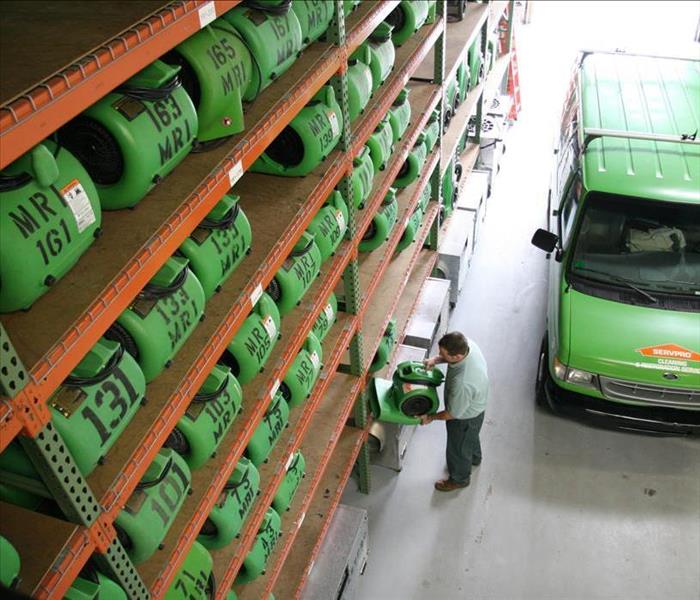 Call in the professionals for water cleanup, to avoid additional water loss in your home. Our SERVPRO technicians are available 24/7.
Call in the professionals for water cleanup, to avoid additional water loss in your home. Our SERVPRO technicians are available 24/7.
Quickly removing water damage helps reduce secondary damage.
This question is often asked by our clients in Manhasset, trying to decide if the water leaked onto floors and inside cupboards can just be allowed to dry naturally. Of course, they will mop up as much water as possible, but they cannot get into those difficult to reach areas, and soaked carpeting can take a week or more to dry on its own.
SERVPRO provides water mitigation services in Manhasset and surrounding areas. We also provide water restoration, fire, and storm cleanup and restoration services. Our team has been living and working in the area since 2007.
There are several reasons homeowners should plan to remove water and moisture as rapidly as possible. They include:
Mold infestations can begin to form within 24 to 48 hours of the initial water spill
Water penetrates particle board and pressed wood veneers causing permanent swelling and damage
Water also penetrates hardwood floors causing swelling and cupping of the hardwood planks
Carpets may delaminate, causing ripples, leading to trips and falls
We strongly recommend that all water, moisture, and humidity should be removed as soon as possible to mitigate further damage.
Why Does SERVPRO Use Dehumidifiers and Air Movers?
Our SERVPRO team evaluates every situation and implements a plan to remove the water and moisture from your home. Often we use vacuums to remove surface water, water extractors on carpets, and vacuum wands to reach difficult areas. However, there can remain a high amount of moisture in porous materials touched by the water. We use dehumidifiers and air movers to reduce the moisture levels further to dry the impacted area completely.
Dehumidifiers are placed in the room or rooms to dry the air
We position air movers to push dry air over damp materials and into cavities
Dry air absorbs moisture from carpeting, hard to reach areas, and from porous materials.
Call SERVPRO of Great Neck / Port Washington (516) 767-9600 for help with water mitigation and restoration of your home.
What Are Some Common Reasons for Home Flooding?
10/16/2020 (Permalink)
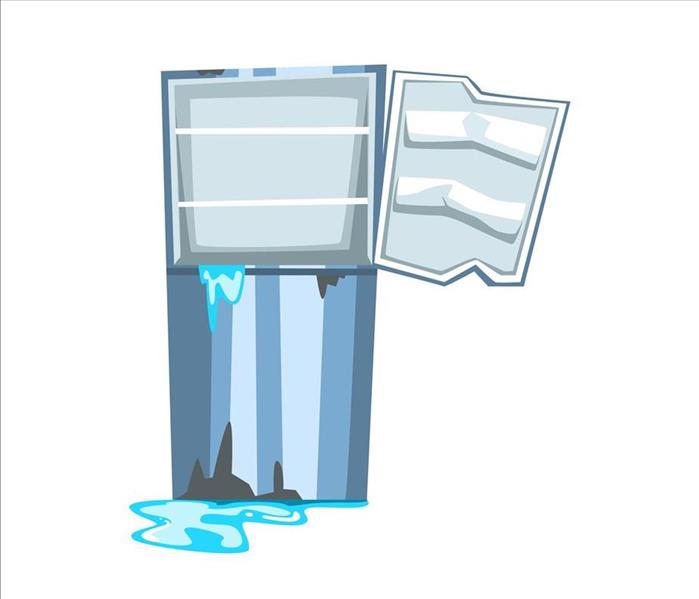 Faulty appliances can quickly cause water damage in your home. Call the professionals at SERVPRO today for assistance.
Faulty appliances can quickly cause water damage in your home. Call the professionals at SERVPRO today for assistance.
Knowing the Common Cause of Water Intrusions in Great Neck Homes Allows Owners to Be Proactive in Preventing Them.
SERVPRO takes calls every day that involve water intrusion, and many of those calls deal with leaks of some kind. We see the same type of problems again and again. The average Great Neck residence loses up to 14% of the water delivered to the home through leaks. Dripping faucets and malfunctioning toilets account for up to 22 gallons of lost water every day. While homeowners cannot prevent every problem that leads to water loss, there are things you can do to prevent many problems.
Are Appliances a Major Concern?
Household appliances that are improperly connected or ones that malfunction accounts for a large number of calls to our SERVPRO office. Washing machines, dishwashers, water heaters, and refrigerators with ice makers are all potential sources for water spills. Maintaining these appliances can prevent them from leaking or breaking down and the need for water extraction services in Great Neck. Steps homeowners can take include:
- Inspecting hoses regularly for cracks or weak areas. Check for kinks in the lines.
- Check for loose connections or worn out parts.
- Consider replacing rubber hoses with stainless steel hoses for durability.
- Make sure appliances with hoses are the correct distance away from the wall.
- Install a water detection device that lets you know when leaks occur.
- Have your water heater inspected annually.
Broken Pipes are a Common Issue
In minutes gallons of water can come pouring into your home from a burst pipe. This is another situation SERVPRO technicians often see. Tips that you may have a leaking pipe can be water pooling, damp cabinet walls or floors in the kitchen, or water stains on walls and ceilings. These are all signs that there is a problem that needs addressing before it becomes something much worse. Everyone in the home should know where your main water shut off valve is in case of an emergency.
Outside Issues Can Cause Inside Damage
Another typical cause of water damage inside the home is poor drainage on the property. This allows water to seep into the structure and can ruin walls, flooring, and fixtures. If you have standing water on the grounds and near your house, consider having a plumber come in. It may seem costly upfront, but it can save you in the long run.
One of the ways water damage is prevented on the outside of the residence is with the installation of rain gutters. Most homes have them, but if they do not get cleaned regularly, they are useless. If your rain gutters are full of leaves and debris, they are not going to divert the water away from the house. Instead, you could end up needing water extraction.
If I Have a Problem, How Quick Can SERVPRO Respond?
SERVPRO has a team ready to hit the road as quickly as possible once a call is received. Fast mitigation is the key to preventing secondary damage and restoring a home in a timely manner. You should not wait to call a professional water extraction company.
Once our technicians arrive, they get started immediately doing a detailed scope of the residence. This allows the project manager to ascertain the cause, if unknown, and the extent of the damage. He can then put a plan of action together for mitigation. Depending on the level of water damage, the technicians:
- Remove standing water with various water extraction tools such as submersible pumps, portable pumps, rovers, and wands.
- Search for hidden moisture with the aid of moisture meters, sensors, and probes.
- Use industrial fans, air movers, and dehumidifiers to restore the home to optimal relative humidity levels.
- Inspect structural elements and use controlled demolition if necessary, to assist in drying.
- Clean and restore impacted content. This can take place on-site or off-site, depending on the circumstance.
- Disinfect and sanitize with EPA-registered products.
SERVPRO crews use advanced technology and the latest restoration methods to leave your home, “Like it never even happened.” We use professional-grade equipment and tools that allow us to handle any size water cleanup. SERVPRO’s water restoration technicians (WRT) work around the clock to ensure our customers get the best possible service.
Any water intrusion means a disruption to your home and daily routine. As homeowners, we understand what this can mean to you. We also understand the damage water can do the longer it sits. Materials break down, and the need for replacement increases. Both of these reasons are why we strive to get your residence back to normal as quickly as we can.
Contact SERVPRO of Great Neck / Port Washington at (516) 767-9600 for professional water extraction service. We’re Faster To Any Size Disaster.
How is Flood Damage Measured in Manhasset?
9/26/2020 (Permalink)
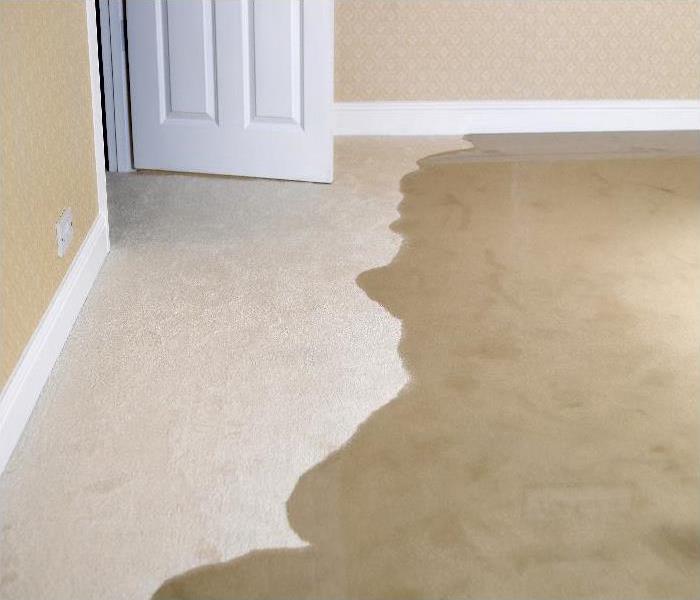 Ascertaining the extent of harm is essential to understanding what equipment and techniques we need to use in your property.
Ascertaining the extent of harm is essential to understanding what equipment and techniques we need to use in your property.
SERVPRO Flood Damage Technicians Can Scope a Property with Flood Damage to Perform Mitigation and Restoration of your Manhasset Residence.
How is an estimate produced for flood recovery?
As a restoration service, we work closely with the adjuster, who produces your insurance estimate for the structure and contents of your Manhasset home. The extent harm caused by a property can vary greatly depending on the length of exposure, the type of flooding, and the construction materials. The process of scoping locates water intrusion in your home. Scoping also assesses how far water has absorbed into materials. These measurements provide us with the ability to plan how much and what equipment we need to restore your home. Our first job is in tracking floodwaters through your home using measuring equipment.
What materials can absorb large amounts of floodwater?
- Hardwoods which can lead to warping
- Drywall, insulation, and other standard building materials
- Thicker fabrics like fitted carpets as well as carpet pads
What types of equipment are useful for scoping a flooded property?
Broadly speaking, the key tools in flood damage recovery of your Manhasset home are measuring tools. Some of these tools have sharp probes that are used to pierce the surface of a material. Usually, these tools are for semi-porous materials like wood that have a low evaporation threshold. Probing tools may also be used on inconspicuous areas of flooring to assess the extent of water migration. Other measuring equipment includes sensors which generate surface temperature readings. These readings can then be assessed to ascertain moisture migration. The final tools for scoping are imaging tools. These can provide access to previously hidden parts of the home like wall cavities.
What measuring devices do I need to measure Flood Damage?
- Moisture sensors
- Moisture meters
- Thermal Imaging Cameras
- Thermal Hygrometers
Ascertaining the extent of harm is essential to understanding what equipment and techniques we need to use in your property. Contact SERVPRO of Great Neck / Port Washington at (516) 767-9600.
Why Is The Type Of Soot Important When Planning Fire Damage Restoration?
9/17/2020 (Permalink)
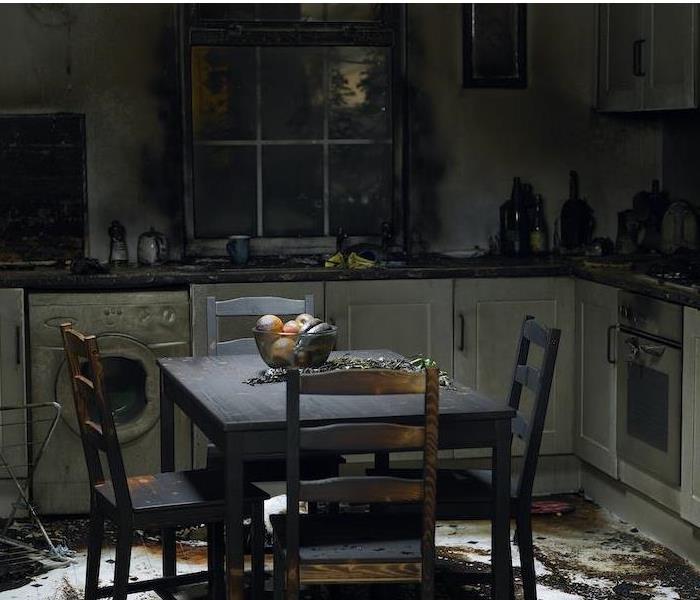 SERVPRO Removes the Soot and Smoke--"Like it never even happened."
SERVPRO Removes the Soot and Smoke--"Like it never even happened."
Great Neck Homeowners Are Looking For Thorough Fire Damage Recovery.
People living in Great Neck understand the importance of fire safety in the home. After all, a disaster is often costly to recover from, and means dealing with insurance, upheaval, and loss.
Unfortunately, a disaster can still happen, no matter how careful you are. If you need fire damage restoration in Great Neck, you need a service that understands the fire theory and the impact of soot damage.
What is soot?
Soot is the residue left over after the incomplete burning of organic materials. Soot is composed mostly of carbon but may also contain traces of metal, chemicals, and dust. Soot can circulate and coat many unaffected rooms after a small, isolated house fire. The cleanup of these residues can be extremely difficult, especially if the correct tools and products are not used.
Cleaning away soot is a significant part of fire restoration, as it looks unsightly and often smells terrible.
Are there different kinds of soot?
There are several different kinds of soot, including:
- Dry soot, which forms when organic materials burn fast and hot
- Wet soot, which begins when plastics and rubbers burn in a slowly smoldering fire
- Protein soot, which starts when proteins (such as meat) burn in a fire, or even through overcooking
Why is understanding soot significant in fire restoration?
Different types of soot require different cleaning methods, which is why a thorough analysis is an integral part of fire damage remediation.
- Dry soot produces the lightest particles, which are relatively easy to brush or vacuum away from surfaces
- Wet soot produces a sticky residue which smears over surfaces and has a pungent odor
- Protein soot residues are harder to see, but cling hard to surfaces and have a particularly noxious smell
Although dry soot is easier to wipe away, the fire's higher temperature can mean more extensive damage to surfaces. Protein soot often forms during a kitchen fire, and so SERVPRO technicians must be extra mindful about electrical appliance safety.
How can SERVPRO help?
Our technicians use a range of cleaning techniques to get rid of soot. Depending on the situation, we can choose between dry and wet cleaning, vacuuming, abrasion, spot cleaning, or even baking soda blasting to remove soot from surfaces. We also deodorize your home afterward, to get rid of lingering smoky smells.
For help with fire damage restoration, call SERVPRO of Great Neck / Port Washington at (516) 767-9600.
My Roslyn House Flooded After a Washing Machine Leak – Do I Need Professional Help?
9/12/2020 (Permalink)
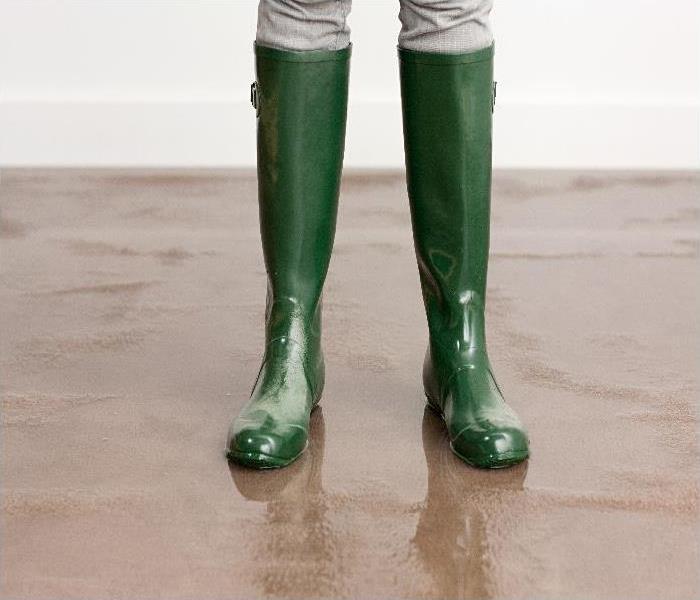 Contact SERVPRO of Great Neck / Port Washington at (516) 767-9600 for quality water cleanup restoration service.
Contact SERVPRO of Great Neck / Port Washington at (516) 767-9600 for quality water cleanup restoration service.
It is Best to Leave Water Damage Cleanup to the Professionals After a Major Water Intrusion in Your Roslyn Home
Residential flooding can be a result of many things. In this case, the washing machine developed a leak while the residents were out of the house. They came home to a flooded downstairs. It was time to call in a professional water restoration company in Roslyn.
Can I Clean It Up Myself?
It might seem like doing the water cleanup yourself in your Roslyn home would save you money. After all, you own a shop vac. There are plenty of YouTube videos and DIY pages that can provide all the information you need, right? It seems great, but the truth is that you need professional help. SERVPRO has expert technicians who are well-trained and understand what each situation calls for when it comes to water damage. There are several reasons not to attempt the water cleanup on your own but to leave it to a qualified company. These include:
• Insurance Company – For the damage and cleanup to be covered by your insurance company, they may require a professional assessment. They often want certified companies like SERVPRO involved in the restoration to back up claims.
• Safety – Safety first is crucial. Certified specialists know what to look for when it comes to safety issues involving water. It could include electrical concerns, contaminated water, or compromised structural components.
• Industrial Equipment – Your shop vac isn’t going to cut it. The cleanup process involved with household flooding needs industrial equipment beyond what the average homeowner possesses.
• Efficiency – Our teams come in, do a scope, and get to work. Immediate water mitigation is required. A homeowner cannot work as fast and as efficiently as a professional crew. This is a problem with DIY cleanup. It takes a long time, and the longer the water sits, the more comprehensive the secondary damage.
By hiring SERVPRO to mitigate the water damage, you save time and money. Speed is of the essence. You need that water removed from your home fast. We have the extraction equipment to pull gallons of water from your home quickly. We’re Faster to Any Size Disaster.
Should I Hire an IICRC Certified Company?
When you work with a business that has Institute of Inspection Cleaning and Restoration Certification (IICRC) certified technicians, you can trust the job to get done to industry standards. At SERVPRO, our technicians are not only IICRC certified but have extensive training in other areas as well. Our techs are qualified and have the experience to deal with emergency water mitigation, such as your washer flooding your living quarters. They are experts in the field of:
• Water extraction & cleanup
• Drying techniques
• Content management
• Restoration
What is the First Step Once I Call SERVPRO?
Once you make the call, our Green Team is on its way to you. We know how necessary it is to get your home back to normal. Our goal is as little disruption to your life as possible. A situation like this is stressful, and we relieve you of the stress of worrying about things getting done right. You can trust your home and everything in it to our crews.
In this home, the washing machine was in the hall across from the bathroom. This resulted in water flowing into the bathroom, living room, and a guest bedroom. Because the living room carpet soaked up a good bit of the moisture, it prevented the water from reaching the kitchen. When our team arrives at a water cleanup scene, they provide any emergency mitigation needed, such as locating the source of the water flow or making sure there are no electrical issues.
What Happens Next?
The technicians perform a scope to ascertain what needs addressing in your specific circumstances. Not every job requires the same procedure. They then work on extracting the water from carpets, floors, and walls. Powerful truck-mounted pumps may get used. We also have portable pumps and industrial strength water vacs. Moisture sensors and infrared cameras are used to look for hidden moisture. We then move on to drying out the impacted areas. Industrial strength air movers, fans, and dehumidifiers are put to use in the correct ratio to dry your home as quickly as possible. Water intrusion can leave bad odors, and deodorizing is part of the water cleanup if necessary. We use EPA approved cleaning products to sanitize all surfaces.
What About My Furniture and Other Things?
If the content can be cleaned on-site, we do that. If it isn’t possible to clean the items on-site, we provide pack-out services. The content gets moved to our warehouse for cleaning. Depending on the extent of the flooding and water damage involved, we can restore:
• Flooring and carpeting
• Wood items and furniture
• Upholstered items
• Linens, drapes, and clothing
• Household goods
• Books, papers, and documents
SERVPRO puts everything into restoring your home and returning it to you, “Like it never even happened.” We are available 24/7 because we know disaster does not wait for a convenient time. If your home has experienced flooding, we have experienced IICRC certified professionals to provide the water cleanup mitigation necessary.
Contact SERVPRO of Great Neck / Port Washington at (516) 767-9600 for quality water cleanup restoration service.
How Can I Prevent Mold Growth In My Great Neck Restaurant?
8/29/2020 (Permalink)
 Mold growth in your eatery can put you out of business. Contact SERVPRO for mold damage remediation services to get your eatery up and running.
Mold growth in your eatery can put you out of business. Contact SERVPRO for mold damage remediation services to get your eatery up and running.
Inhibiting Mold Growth with Precautionary Measures is the Best Course of Action
Cleanliness is critical in any commercial enterprise, but even more so when it comes to the food industries. Mold can develop anywhere there is moisture. An extensive mold infestation means the possibility of the Great Neck restaurant being closed while mitigation takes place.
Is Mold Really in the Air?
Mold spores are everywhere, indoors, and outdoors. The spores are microscopic, and no one can avoid them. The spores themselves are not the problem. The problem comes when the spores connect with moisture. They can then spread rapidly, damaging your building and the content within. Mold can cause health effects. Qualified technicians should handle mold remediation in your Great Neck eatery.
What Precautionary Measures Can I Take?
Preventing mold growth involves being proactive. It is much simpler to prevent the spread than to stop it. Here are some ways your restaurant can prevent mold:
- Schedule routine cleaning.
- Throw garbage out on a regular basis.
- Check for water intrusions such as leaks often.
- Inspect food for mold before allowing it in the kitchen.
- Seal open containers properly.
- Inspect for visible signs of mold regularly.
- Monitor humidity levels.
- Keep the kitchen clean and dry.
Professional Mold Remediation
The best course of action whenever you think there is a mold problem is to hire professionals. SERVPRO has qualified Applied Microbial Remediation Technicians (AMRT) who can diagnose the problem. They then implement the correct measures to clean your restaurant correctly. Our team uses advanced technology and equipment to detect and remove mold. Some of the methods we use are:
- Soda blasting and dry ice blasting
- Surface cleaning
- Sanding
- Antimicrobial and antifungal applications
- Controlled demolition
Do not let mold put you out of business. Proper remediation can have your restaurant serving up your customer’s favorite meals in no time. Contact SERVPRO of Great Neck / Port Washington at (516) 767-9600 for all your mold remediation needs.
Click here for more information about Great Neck.
Can a Fire in a Single Room Affect the Entire Great Neck Home?
8/16/2020 (Permalink)
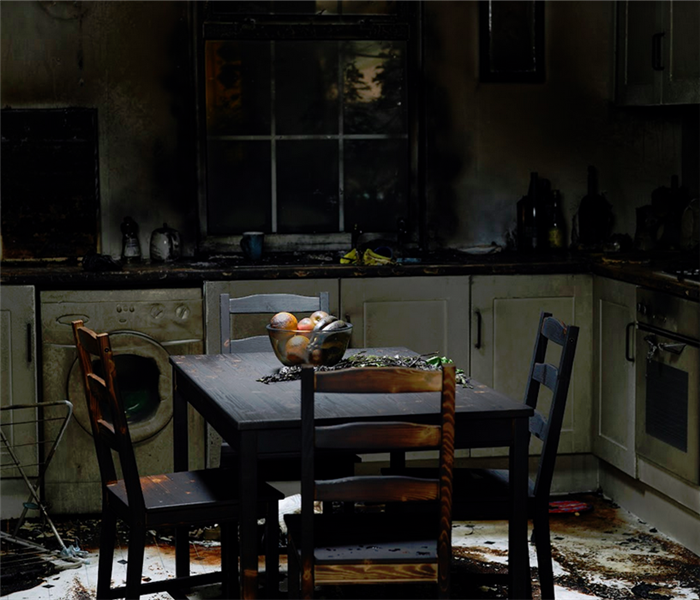 Fire damage can spread through your home very quickly. Contact SERVPRO for fire damage remediation services.
Fire damage can spread through your home very quickly. Contact SERVPRO for fire damage remediation services.
SERVPRO technicians have the training and equipment to determine the actual scale of the cleanup needed in your Great Neck home
Even though the kitchen fire got put out before the flames had a chance to spread throughout the Great Neck home, there can be significant problems throughout the house in regards to odor, smoke damage and soot can travel via the ductwork and foot traffic to all areas of the home. Until it gets professionally mitigated, the problems remain in the house, that is why it is crucial for outsourcing the cleanup rather than trying to tackle it on your own.
Why is Fire Damage From Burned Plastic So Hard to Remove?
A homeowner that left a plastic container on their stove without realizing the burner was on. This caused a large amount of smoke and fire damage throughout their Great Neck home. The homeowner brought in SERVPRO to handle the cleanup and restoration.
When plastic burns in a fire, it causes multiple issues such as:
- The release of pungent, toxic fumes containing hazards such as dioxins and furans that are dangerous to breathe
- The burning process also causes a thick layer of hard-to-remove soot
- Although SERVPRO techs have multiple cleaning agents and methods for removal of melted plastic, it may be impossible to get off some surfaces causing the item it melted on to get discarded
- The fumes can spread creating odor issues over a widespread area
Common Fire Damage Actions in a Kitchen
The kitchen is the hub of activity in most homes, and even a small scale fire can create a large amount of damage in your Great Neck home. SERVPRO technicians see the following issues frequently:
- Smoke damage on the walls
- Soot corrosion on chrome and metal faucets unless cleaned quickly
- Fire odor distributed throughout the home via the ductwork
- Controlled demolition to remove charred building materials
- Removal of debris
- Extraction of water
The removal of the smoke damage in the area the fire occurred within can take different forms. SERVPRO technicians test the smoke residues as well as the surface getting cleaned to ensure the correct method gets chosen. Some cleaning agents have chemical components that can bleach surfaces or remove finishes, so tests are crucial for the best outcome.
Air quality is another concern during the cleanup post-fire. The techs use machines known as air scrubbers to capture airborne particulates that are harmful to breathe as well as odor-causing. The techs wear respirators along with protective clothing to keep them safe as they turn around the damage in the home.
Cleaning stations are another frequently seen part of the cleanup process. As articles in the fire-zone get found, and they get determined to have restoration potential, the items get brought to established cleaning areas outside the work-site. The technicians operating these areas inspect the item and choose the cleaning method that will benefit it most. For example, a molded resin candlestick may have survived the fire just fine, but it got covered in soot in the process. The techs can use techniques such as immersion cleaning to get every bit of residue off the item and get it ready to reuse in the home.
The need for repairs or reconstruction of portions of the home is not unusual. Unfortunately, when sheetrock wicks water or has charring - the deteriorated part requires removal. In some severe cases, the walls can get stripped down to the studs with the insulation removed. Before any rebuilding can occur within the home, odor control applications need to get performed to remove both airborne and embedded odorous particulate. If the HVAC ran post-fire, the ductwork might also need cleaning. Once the technicians have successfully neutralized odors, they inspect the property to ensure no lingering smoke odors remain.
Even with the professional equipment that the technicians have access to, multiple methods may get applied. In cases of walls that remained intact but odor control methods did not work, the use of a sealant can seal in any remaining fire scents and give the wall a clean slate to get primed and painted with zero reminders of the fire.
As a final step, the SERVPRO crew chief goes over the actions taken throughout the home with the homeowner or adjuster to be sure that they are pleased with the job performed by the technicians.
SERVPRO of Great Neck / Port Washington at (516) 767-9600 is ready to help local property owners with the cleanup and restoration from any size fire damage. The certified technicians are available 24/7 to return your home back to normal as soon as possible.
How Does a Pack-Out of Flood-Damaged Contents Enhance Flooding Recovery In My House?
8/3/2020 (Permalink)
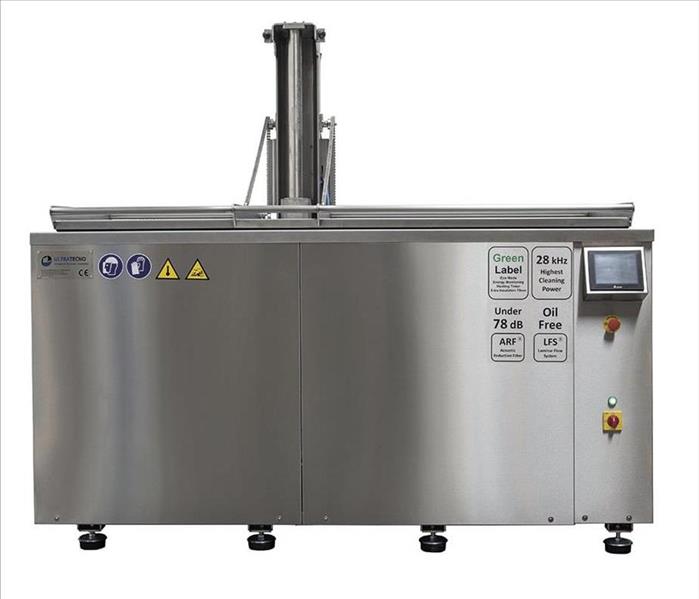 SERVPRO Provides Pack-Outs and Ultrasonic Cleaning to Rescue Our Manhasset Neighbors Precious Possessions
SERVPRO Provides Pack-Outs and Ultrasonic Cleaning to Rescue Our Manhasset Neighbors Precious Possessions
SERVPRO Has a Long List of Highly-Effective and Research-Based Strategies Available to Mitigate Both Structural and Contents Flood Damage for Manhasset Area Residents
Flooding that follows storm damage in your Manhasset house creates a chaotic situation, complicated if the flooded space has living areas or contains stored items. When the professionals arrive to start containing and extracting the water, their efforts can be impeded by the furnishings, household goods, and personal possessions in the space. We recommend consideration of a whole or partial pack-out of contents as a flood mitigation method.
How Can I Be Sure My Personal Property Is Secure During a Pack-Out?
We understand that our residential customers struggle with a feeling of control loss when struggling with flood damage in Manhasset. Relinquishing the responsibility of packing up and transporting items to members of our production facility team is a decision you make with confidence. Our Contents Claim Inventory Service (CCIS) uses a mix of written lists, digital photography, and barcoding to document the condition and location of the items.
How Are the Packed-Out Items Processed?
If your property has a secure, dry space large enough to store the affected contents, SERVPRO might move them to that staging area. The on-site team tasked with the flooded spaces in your home can focus on extraction, cleaning, disinfecting, and structural drying without needing to move items constantly. Humidity levels inside your home are easier to control without the added load of moisture from the contents. We can take all or selected things to our production space for specialized interventions including:
- Small chamber drying, disinfection, and deodorization
- Freeze-drying for wet papers and photos
- Immersion and ultrasonic tanks for cleaning of durable, non-porous items
- Industrial washing and drying systems for textiles and soft items
Take advantage of the different opportunities SERVPRO of Great Neck / Port Washington offers residential customers to recover effectively from flood damage. Contact us day or night at (516) 767-9600 for evaluation by an experienced project manager.
A Water Intrusion Incident Has Happened in My Property. How do I Restore the Affected Areas?
7/21/2020 (Permalink)
 SERVPRO professionals are trained to handle all types of water damage.
SERVPRO professionals are trained to handle all types of water damage.
Call SERVPRO’s Team of Technicians to Provide Water Damage Restoration in Your Manhasset Property.
After a water intrusion incident, restoring a property to its pre-damage state often involves water removal, decontamination, drying, and odor removal. It is vital to act fast by working with reliable restoration experts in Manhasset, like SERVPRO technicians.
Why should I act fast?
Performing water damage restoration in your Manhasset home as soon as you can is critical. The sitting water and moisture can create a perfect environment for bacteria and mold growth. Some parts of the affected property may require to be rebuilt. Valuable materials such as carpet and pad, as well as drywall that have absorbed water, can get damaged beyond repair. By contacting professionals immediately after the incident, you can avoid these costly repairs.
How do you restore homes?
We repair and restore water-damaged properties to return them to their normal condition. Our restorers usually complete water damage mitigation before water damage restoration. The goal of water damage mitigation is to prevent further water damage from affecting the structures and contents of a building. Some of the things we can do during the water damage mitigation process include:
Removing ruined materials like flooring and drywall as well as furniture from the affected areas.
Cleaning and disinfecting salvageable items.
Extracting water using pumps.
Drying the home using air movers and dehumidifiers.
After the water damage mitigation process, our technicians concentrate on reconstructing or rebuilding a home through a variety of applications. The goal of the water damage restoration process is to help you recover from all damage. The steps we can take to restore your home largely depend on the severity of the water loss. Some typical water damage restoration services include:
Eradicating mold.
Replacing ruined flooring and walls.
Conducting moisture and humidity testing to ensure all issues are resolved.
How do you dry the affected areas?
Using our advanced equipment, we can take the shortest time possible to dry the affected areas. Our SERVPRO technicians can use several air movers to speed up the drying process. At times, we use portable heaters to increase the temperature in a home. Drying takes place faster when a room is heated better 70 to 90 degrees Fahrenheit because hot air holds more moisture. Our team uses dehumidifiers to remove moisture.
What about the odor in my property?
Odors can make a property inhabitable. Odors may persist depending on the intensity of the water damage. Our technicians can use air filtration devices to remove odors. These devices contain HEPA filters that can remove the airborne particles from the air, leaving your property feeling and smelling fresh.
Water damage can leave you and your family devastated. Contact SERVPRO of Great Neck / Port Washington at (516) 767-9600 for effective restoration services.
See more about Manhasset.
What Causes Water Spots On The Ceiling of My Manhasset Restaurant?
7/17/2020 (Permalink)
 Let SERVPRO keep your Manhasset restaurant up and running after a water loss.
Let SERVPRO keep your Manhasset restaurant up and running after a water loss.
SERVPRO Can Help Perform Water Damage Restoration in Your Manhasset Restaurant Eliminating Any Stains
The main reason people visit your restaurant is to sample the cuisine and other services that you offer. However, other aspects such as the ambience can influence such visits, especially if they can get similar services at other restaurants within the Manhasset area. One thing that can ruin the ambiance at your restaurant is the development of water stains on the ceiling. Various water-related issues can cause such spots to appear, ruining the general atmosphere at your facility. Stains are more of a nuisance than an impediment to business, but it is best to fix them.
How do the stains form?
Whenever brownish or dark patches appear on the ceiling, it is a sign of underlying moisture issues. However, before deciding what water damage restoration procedures your Manhasset restaurant requires, it is essential to understand the underlying problem fully. The colored patches on the ceiling can signify:
- A roof leak
- Leaks in plumbing lines or HVAC ducts
- Condensation of moisture from various sources
- Mold growth
- Ghosting
Although all the problems are moisture-related, the steps necessary to ensure complete elimination of the problem can vary. You may think that the solution is to apply a fresh coat of paint to conceal the unsightly patches. However, cosmetic solutions such as painting over the surface or replacing the ceiling panels without addressing the root cause of the problem might only offer a short reprieve. You should also note that the staining is the least of your worries since beneath the surface, the excess moisture might eat into the materials diminishing their structural strength.
I know the cause of the staining, what next?
Unlike a stain on a fabric such as a carpet or curtains that you can remove by cleaning, you have to take several steps to restore the ceiling surface to its preloss state once water stains form. Our SERVPRO technicians can help complete all the necessary restoration steps, making any staining disappear, "Like it never even happened." We can locate leaks on the roof or plumbing networks within the property and help you find a building contractor or plumber to fix the damaged sections.
After addressing the source of the water ruining the ceiling, we can proceed to fix the deterioration that manifests as browning on the ceiling surface. The ceiling is an assembly of different materials, considering it hides power cables, ducts, and lighting fixtures, which can complicate the restoration process. Technicians might need to perform some demolition to remove damaged materials, especially when rot or mold is involved. Drying the area may also be necessary if the stain was the result of a continuous leak. Directing airflow to the area helps improve evaporation rates, thus speeding up the drying rate.
How do I restore the finishing of a stained ceiling patch?
The refinishing process of a ceiling after it is stained by water intrusion must address several issues, including:
- Removing flaking paint
- Blocking or neutralizing stain remnants
- Matching the new paint with the existing color shade
Refinishing the damaged area involves the application of a fresh coat of paint, or replacing some ceiling panels. The new materials must match the texture and tone of color in the surrounding areas for a uniform look. When repainting the area, a couple of precautions are necessary, including removing any flaked paint to ensure a smooth finish after repainting. Removing traces of the existing stains is also crucial since they can show through the fresh coat of paint once it dries.
Our SERVPRO technicians take different steps to accomplish the intended goal. We use abrasives such as wire brushes or sandpaper to remove all loose paint flakes and the discoloration caused by water. In case the surface is smooth, we clean the area with a bleaching agent to remove the browning, ensuring that stains do not show after repainting the area. In the case of a colored ceiling, we use oxygen bleach instead of the regular chlorine bleaching agents.
Finally, we can paint the ceiling to restore the ambiance your customers are used to. Matching the repaired area to the rest of the ceiling is crucial; otherwise, you would end up with a patch of a different color, which is no better than a stained ceiling. We can repaint the entire ceiling if it is not very big. Alternatively, we ensure that the paint we use to repaint the areas is the exact hue as the rest of the surrounding areas.
Timely water damage restoration can help prevent major problems at your business premises. Call SERVPRO of Great Neck / Port Washington at (516) 767-9600 to assist. We're Faster To Any Size Disaster.
My Manhasset Home Flooded, What Are Some Things I Can Do to Facilitate Drying?
6/17/2020 (Permalink)
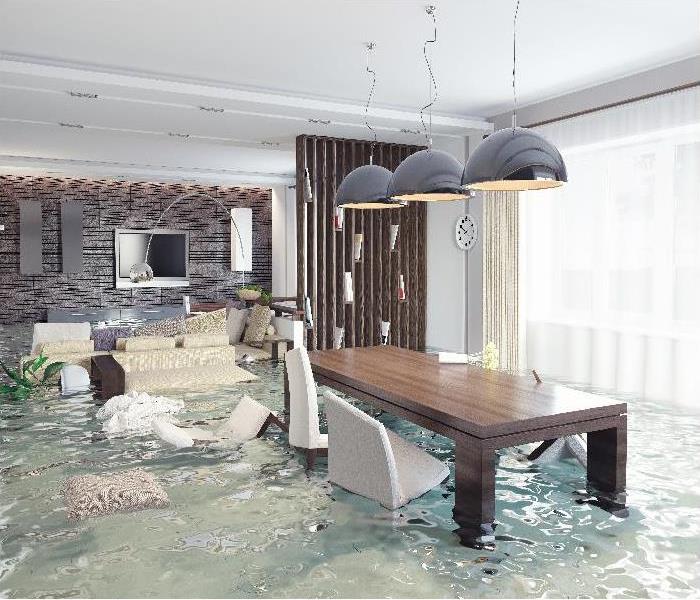 To speak with a member of our emergency response team, contact SERVPRO.
To speak with a member of our emergency response team, contact SERVPRO.
You Can Use Environmental Factors and Drying Science to Help Dry Your Manhasset Home
As a resident of Manhasset, you are no stranger to storms and flooding, but that does not make the disaster at hand easier to overcome. While you wait for the professional restoration specialists at SERVPRO to arrive and begin drying and cleaning your home, there are some things you can do to aid in speeding up the process. For example, if the air outside is warm and dry compared to the air inside, you may want to open windows to help push some of the moist air out of your home—this an open drying system.
What Are Some Things That DO NOT Help with Drying? SERVPRO Technicians are Mindful of Some Situations That Hinder the Drying Process.
Flood damage in Manhasset requires you to take quick action, but you also need to be mindful of some potential mistakes. If the weather outside is hot and humid or unpredictable, you probably want to avoid an open drying system. In this case, running your HVAC system can help facilitate air movement. Still, to adequately dehumidify the home, you need professional equipment to ensure no secondary damage, such as mold growth.
What are Some Common-Sense Things to Remember About Drying My Home?
You can harness nature's equilibrium to help the drying process by remembering that:
• Wet goes to dry; eventually, water evaporates as the humid air moves toward the dry air, so it has the same humidity level.
• Hot air facilitates drying more than cold air; the hot air moves toward the cold air.
• High and low-pressure air meet in the middle to equalize and facilitate drying.
To speak with a member of our emergency response team, contact SERVPRO of Great Neck / Port Washington at (516) 767-9600. We’re Faster to Any Size Disaster.
What Are the Necessary Tools to Clean Up After a Fire?
6/8/2020 (Permalink)
 Contact SERVPRO for fire damage restoration services.
Contact SERVPRO for fire damage restoration services.
Fire Restoration is Best Left to Professionals, So Call SERVPRO to Address the Damage to Your Manhasset Home
There are countless reasons to call in the help of trained restoration technicians after a fire in your Manhasset home. For example, smoke and soot bring on foul odors that linger past the fire-loss zone and call for specialized techniques to rid your interior of them. Additionally, the only way you can ensure you salvage the most materials and belongings is by having specialized cleaning methods and the industry's best products today. SERVPRO comes to each fire restoration job, ready to work with all of the latest advancements in the field.
How Do My Furnishings, Walls, and Ceilings Get Cleaned?
When you call us for help with fire restoration in Manhasset, we arrive with our Green Fleet loaded with all of the equipment and proper cleaning agents to handle the job. To determine the best measures for cleaning your interior, we test surfaces covered in smoke residue. This allows us to match the right cleaning techniques and products for optimum results.
Anytime a homeowner tries to handle fire-loss with consumer cleaning tools and DIY methods, they run the risk of worsening the damage. Some of the standard, professional-grade equipment that we bring to each fire damage project includes:
- Personal protection equipment (PPE), which protects the crew from harmful irritants, such as soot
- Durable wet-sponges best for working on the removal of wet smoke residue
- Dry-sponges that work to lift away any dry smoke residue on surfaces easily
- Moisture detection tools to help find hidden moisture pockets from the water used to extinguish the flames
- Air scrubber equipment that helps capture the soot particles from the air
- EPA-registered solvents and cleaning solutions to fight smoke odors
What Sets SERVPRO Apart from the Rest?
Once you choose us for your fire damage restoration needs, we send out a team to begin assessing your interior. The crew chief examines each area and records each detail, which allows for the formulation of a tailored plan of action. We use research-based planning to help facilitate the mitigation and remediation steps. Several areas that we address when putting a plan into place include:
- Integrity and safety of any structural materials
- Whether pack-out services are required
- The level of damage within the loss zone, including potential materials that must get treated using controlled demolition methods
- Any residual moisture from water or chemicals used to douse the flames
- What drying or dehumidification equipment, if any and how many, is needed
- What odor-control equipment will work best on the project
What are Pack-Out Services?
There are times when items can be relocated to another room of the home for cleaning, or we will send them to our facility for detailed cleaning. We may also suggest a partial move out, where only some of your contents get moved at any given time. Whatever we decide is best, all of your belongings get logged for your records and to your insurance provider to go with your claim.
Of course, there will be items that can be cleaned on-site, which our technicians will address and handle with care.
What is Done to Address Foul Odors?
A common complaint after a house fire is the strong smell of smoke and charred materials. Without proper techniques, the smoke remains a constant reminder even after other traces of the fire get removed. Handling smoke odors is something that our IICRC-certified technicians at SERVPRO are trained to do. We take measures to contain the fire-loss zone so that mitigation can begin, which includes tarping off the area and covering vents. This helps to keep soot and smoke from getting tracked throughout the home and limit particulates in the air. Whenever soot and smoke residue get into the ducts of your HVAC system, these foul odors can spread throughout each room in your home.
Some of the advanced technology that we bring with us to help battle smoke odors includes:
- Sealants for walls and ductwork that halt odor transmission from soot that has become embedded
- Powerful deodorizing agents
- Hydroxyl generators with UV light technology that help to eliminate odors safely
- Thermal foggers that use chemicals to bind with odor molecules for easy removal.
What Items are a Total Loss?
As mentioned with our pack-out services, we take the time to catalog all items that are handled. Our Contents Claim Inventory Service (CCIS), reports the condition of each item as well as anything that has been discarded. What this service does is establish a chain of custody, which then helps to give you added peace of mind while also helping to expedite your insurance claim. Any items deemed unsalvageable are adequately disposed of according to local guidelines.
To have a team deployed to your home for fire restoration services, call SERVPRO of Great Neck/Port Washington at (516) 767-9600. We are here to make sure that your interior is "Like it never even happened."
What Does It Take to Restore My Home After a Fire?
5/26/2020 (Permalink)
 Let SERVPRO be the company to handle all of your fire damaged home issues in your local Great Neck area.
Let SERVPRO be the company to handle all of your fire damaged home issues in your local Great Neck area.
Call SERVPRO to Return Your Great Neck Home to Its Pre-Loss Condition
The majority of home fires in Great Neck start in the kitchen. The physical damage often remains in that part of the house, but surfaces in other parts of the home can still be covered by soot particles left behind by smoke as the fire cools.
Why SERVPRO? I can wipe down my walls and DIY my kitchen.
Even if the fire damage in your Great Neck home is minor, it still needs professional restoration. Our company has access to chemical cleaners and cleaning equipment not available to homeowners. Our technicians can remove soot from glass coffee tables, wall paneling, upholstered furniture, and even many types of clothing.
Cleaning is great, but what about the burned appliances and scorched tiles?
SERVPRO team members can demolish and remove all burned material without spreading soot into other parts of your home. Specialists can replace everything from linoleum to ceiling panels, install new appliances, and finish everything off with a new coat of paint so your kitchen looks exactly as it did before the fire, “Like it never even happened.”
To learn more about how we can restore your home, call SERVPRO of Great Neck / Port Washington today at (516) 767-9600. We are here for you.
My Area has a High Level of Flood Risk, who can Help in Great Neck?
5/24/2020 (Permalink)
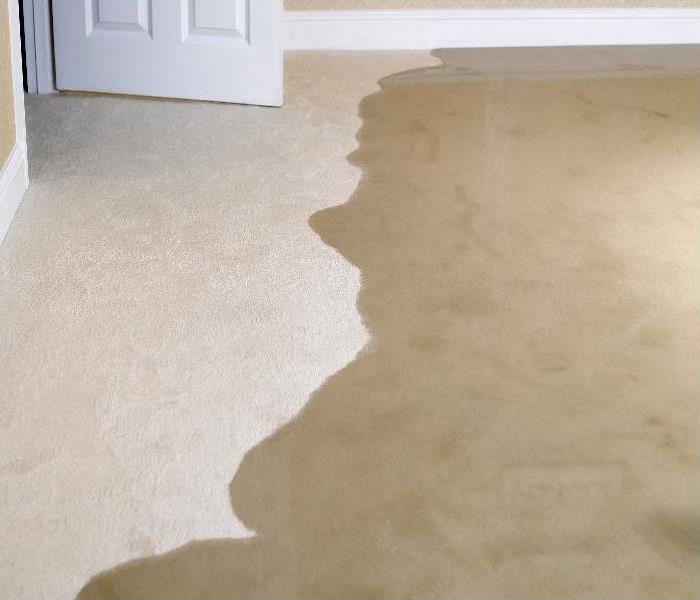 We’re Faster to Any Size Disaster!
We’re Faster to Any Size Disaster!
Flood Damage Restoration In Great Neck
Wisconsin can see up to six inches of rainfall in a single day during some parts of the year. This massive amount of water can overload neighborhood drainage systems, water treatment towers, and Infrastructure. SERVPRO is a local flood recovery provider that can help to drain, clean, and restore your Great Neck home in an emergency.
How can I drain floodwaters from my home with no working sewer points?
Heavy, consistent rainfall can overload the sewer network on your block as well as your residential property. Flood damage in Great Neck as a result of road overflow can present new challenges to homeowners who are trying to rid their homes of standing water. When sewers overload standard sewer points like your sinks, bathrooms, and toilets stop functioning correctly. With many pumping systems relying on a working sewer point to discharge water, it can make draining the property tough. We can bring our truck-mounted wastewater tanks to your property with a capacity of up to one hundred and ten gallons. By attaching the discharge hose to the water tank, we can safely drain your home. Our trucks transport the floodwaters from your home to a wastewater facility for safe disposal.
How can I perform floodwater restoration without access to a clean water supply?
Water treatment facilities are at a high risk of flooding. The result is that neighborhood access to clean water is no longer available, and, in severe cases, your water supply pipes can transport unclean water into your home via the plumbing network. Floodwater restoration involves significant amounts of cleaning to return the home to its original state. After pumping water out of the property, it is not uncommon for homeowners to find their property and possessions coated in silts, debris, mud, raw sewage, or other contaminants. Our technicians can use pressure washers on the exterior of the building alongside truck-mounted cleaning wands for the interior. Thorough disinfecting of the affected area is essential to ensuring your home returns to a sanitary state.
What is the role of an insurance adjuster during flood restoration?
An insurance adjuster inspects the building materials and contents of your home following a flood. The report that they produce passes to a SERVPRO crew chief and helps us to design the restoration procedure. You can list the contents of your home to an insurance adjuster as well as the estimated costs as these form your insurance claim. Our crew chiefs work to a restore over replace mentality when working with an insurance adjuster, which can reduce the time-frame of your property restoration and help you to salvage valuable or sentimental items. Usually, in flood restoration, a technician accompanies a crew chief. We can communicate with you throughout the process to ensure that you stay in the loop regarding restoration in your home. Communication can help to ensure that the restoration does not inconvenience you unnecessarily- this may include prioritizing kitchens or bathrooms so that you can use your property while the restoration is underway.
What should I do if I see potential hazards in the property?
• identify the issue
• communicate to ensure that everyone in the area is aware
• Document the issue
• See what measures can be taken to control the hazard
• perform the necessary control measures
If you spot potential hazards in your property, you can communicate them directly to the crew chief on-site who can then make sure everyone is aware. Controlling hazards can require expertise as well as experience of working on flood restoration projects. If you suspect a hazard of any severity, it is essential to communicate. Some hazards may seem benign but could cause serious injury. Crew chief has the experience to implement proper control methods for potential hazards in the property. These control measures can help to ensure that everyone on the property remains safe.
What equipment do I need to restore my home after flooding?
• Personal Protective Equipment (PPE.)Heavy-duty boots, gloves as well as respiration equipment to prevent inhaling airborne contaminants.
• Water pumps and extractors to remove excess water from the home
• Pressure washing equipment as well as shovels to loosen and remove mud from home
• Cleaning products including solvents and disinfectants
• Construction equipment for removal and reinstallation of contaminated materials in the building.
• Drying and dehumidification equipment
How can I reduce the flood odors in my home?
Odors are noticeable when there is high humidity or the presence of moisture. In some cases, the presence of odors reduces once the cleaning and drying of a flooded property are complete. However, SERVPRO offer full-house fumigation as well as air filtration to restore your indoor air quality to a preloss condition. They are using ultra-low volume (ULV) foggers to fumigate a room or entire property efficiently and can deploy venting fans to exchange indoor and outdoor air. Our comprehensive approach to odor control makes sure that your property feels “Like it never even happened,” after restoration.
If heavy rainfall damages your property, contact SERVPRO of Great Neck / Port Washington at (516) 767-9600.
How Can You Take Water Out of Hardwood Flooring?
5/20/2020 (Permalink)
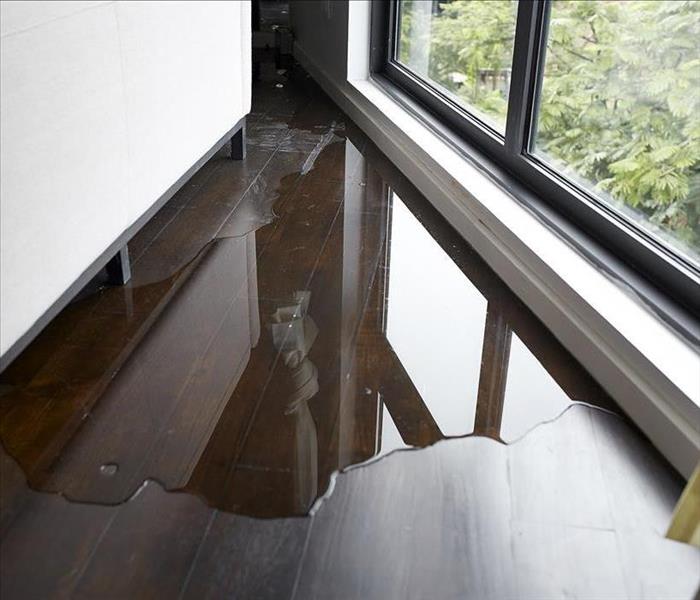 Don't let your flooring become a disaster from the water damage in your Great Neck home. Call SERVPRO to mitigate your water issue.
Don't let your flooring become a disaster from the water damage in your Great Neck home. Call SERVPRO to mitigate your water issue.
Wood planks can absorb water quickly, so our SERVPRO team can recover these materials with effective drying solutions.
The absorption rates of wood flooring vary on the type of wood used to cover the floors of your Great Neck home and the finish on these surfaces. Certain coatings can make planks less sensitive to absorption, but eventually, water penetrates natural hardwoods.
Removing water in your Great Neck home once it penetrates the surface of wood flooring can exceed the capabilities of drying practices.Homeowners can perform on their own. Our team has multiple strategies for removing moisture trapped in planks, and these include floor mat drying systems and centrifugal air movers.
Why Is Wood So Sensitive to Moisture?
Cellulose in natural woods absorbs surface moisture. While our SERVPRO team can address this phenomenon in earlier stages, once water chemically bonds with the wood, the damage is often too severe to restore. There are three primary stages of water exposure to wood:
- Water stays on the surface
- Water penetrates wood planks but has not bonded
- Moisture alters the appearance of the wood floors
Saturated wood flooring can be costly to replace, but our SERVPRO of Great Neck / Port Washington team has effective water removal tactics to help. Give us a call at (516) 767-9600.
What Happens to My Great Neck House in a Flash Flood?
5/20/2020 (Permalink)
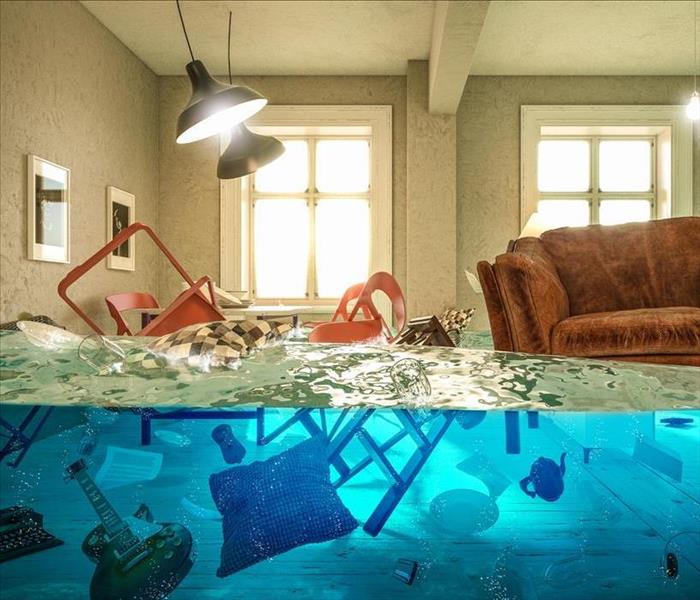 Having flooding issues in your Great Neck home? Call SERVPRO to extract the water using specialized machines to make your home better than ever.
Having flooding issues in your Great Neck home? Call SERVPRO to extract the water using specialized machines to make your home better than ever.
Damage can occur quickly in a natural disaster, so our SERVPRO team responds fast to begin extraction, drying, and cleaning.
Flash flooding can be a monumental disaster for Great Neck homes, especially when the property gets completely caught off-guard. Penetrating water requires the attention of water restoration professionals on our roster as well as our experienced, licensed residential contractors.
Flood damage to Great Neck homes can often be the worst in the basement areas, with pooling water at times as deep as several feet. With many potential health hazards, including shocks, live animals, and contaminants, removing the water and the muck should get handled by experienced professionals like our SERVPRO team.
What Tools Can Remove Standing Water in the Basement?
Before muck-out, content management, or even structural repairs can be successfully implemented, and standing water must get removed. We have multiple extractors that can handle this task, and we choose them based on the severity of the situation and the location of damaged areas. Some of our options include:
- Gas-powered trash pumps
- Truck-mounted extractors
- Wet vacuums
Flooding can be destructive, but our SERVPRO of Great Neck / Port Washington team can help with fast extraction and drying solutions. Give us a call at (516) 767-9600.
Certified: SERVPRO Cleaned – a defensive cleaning program
5/20/2020 (Permalink)
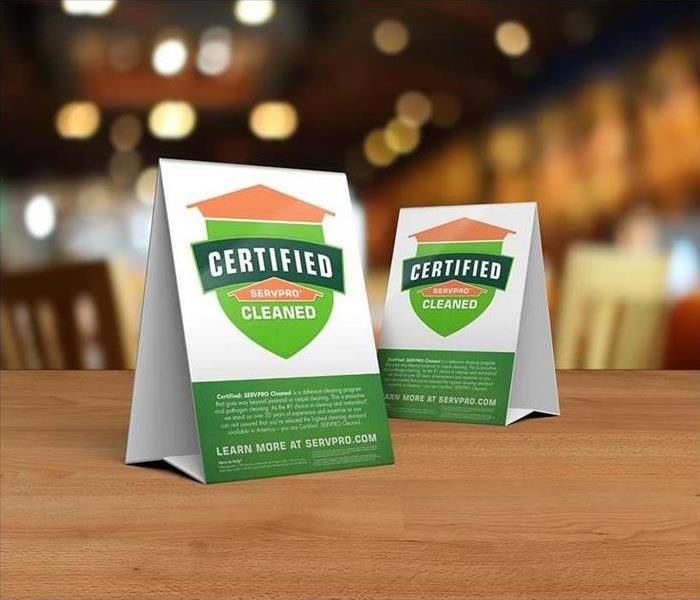 Our defensive cleaning program gives your business a way forward by providing your employees and customers ongoing safety and assuredness.
Our defensive cleaning program gives your business a way forward by providing your employees and customers ongoing safety and assuredness.
Let us help you get back to business
As our communities re-open in Great Neck, we’re all moving back toward a new kind of normal. The expectations of visitors, customers, and employees who come into our establishments have evolved, and staying safe and well is a top concern. The global COVID-19 pandemic has changed what it means to be clean, and we’ve developed a program to help your business meet the new higher standard of clean that is now expected.
Certified: SERVPRO Cleaned is a defensive cleaning program we’re offering to businesses and commercial locations to address the current COVID-19 pandemic. This proactive viral pathogen cleaning program goes well beyond janitorial or carpet cleaning. By choosing Certified: SERVPRO Cleaned, you, your employees, your customers, and your community can rest assured that you’ve selected a higher cleaning standard – you are Certified: SERVPRO Cleaned.
Extensive training and specialized products
As the #1 choice in cleanup and restoration*, we stand on more than 50 years of experience and expertise to help your business become Certified: SERVPRO Cleaned. Beyond fire & water, SERVPRO professionals are trained and experienced in biohazard decontamination and chemical spills – always adhering to the cleaning and decontamination standards set by the Centers for Disease Control and Prevention and local authorities.
From formulating and creating our proprietary cleaning products, like SERVPROXIDE, at our headquarters in Gallatin, TN, to taking the utmost care while disinfecting, we will ensure you and your business are set up to inspire consumer confidence as the economy continues to reopen.
3 C’s – Consult, Clean, and Certify
When the stakes are this high, you want a partner who has developed an industry leading, proprietary training program, cleaning solutions, and remediation processes over decades. We’ve cleaned up some of the most challenging biohazards imaginable. Certified: SERVPRO Cleaned reflects our unique experiences and capabilities. The program is grounded with our unique 3 C’s: Consult, Clean, and Certify.
- Consult – Every business is different, which is why you’ll be assigned a Cleaning Protocol Consultant who understands your business and will create a cleaning program to meet your specific needs. This program will be developed based on your business type, size of space, amount of high frequency touchpoints, foot traffic and congestion points.
- Clean – Based on your specific business needs, your location will undergo a thorough, deep clean, using exclusive cleaning products, according to protocols set forth by the CDC. Our employees have years of experience, and we will go beyond the scope of work that regular janitorial staff perform. Cleanup procedures generally include cleaning of porous and non-porous surfaces, disinfecting of non-porous surfaces, cleaning and disinfecting of equipment, tools, and/or supplies used for cleanup process, and disposal of hazardous materials. In the event of a suspected or confirmed COVID-19 event, we will be there cleaning within 24 hours to ensure you get back to business as quickly as possible.
- Certify - Once your business location has been Certified: SERVPRO Cleaned, you will gain access to proprietary signage, digital emblems, and other collateral that communicates that you’ve selected a higher standard of clean available to help protect your employees and customers. And because we add the day, month, and year to that proprietary stamp of clean, your guests will know that not only did you choose Certified: SERVPRO Cleaned, but that your location is being cleaned regularly at this standard.
Call today for a Certified: SERVPRO Cleaned consultation
We’re Here to Help – 24 hours a day, seven days a week – until life is back to normal in the communities we all call home.
Call SERVPRO of Great Neck / Port Washington today at (516) 767-9600 for your Certified: SERVPRO Cleaned consultation.
* #1 Choice in cleanup & restoration based Commercial Attitude & Usage Tracking study. Polling 816 commercial business decision makers on first choice for future needs related to cleanup & restoration work. Study conducted by C&R Research: October 2019
Certified: SERVPRO Cleaned means professionally trained SERVPRO franchises perform the requested cleaning, sanitizing and disinfection services according to proprietary SERVPRO protocols and recognized industry and CDC standards with EPA approved cleaning products to deliver a SERVPRO certified cleaning experience. Each SERVPRO franchise is independently owned and operated.
What Can I Do About the Flood Damage in My Great Neck Jewelry Boutique?
5/10/2020 (Permalink)
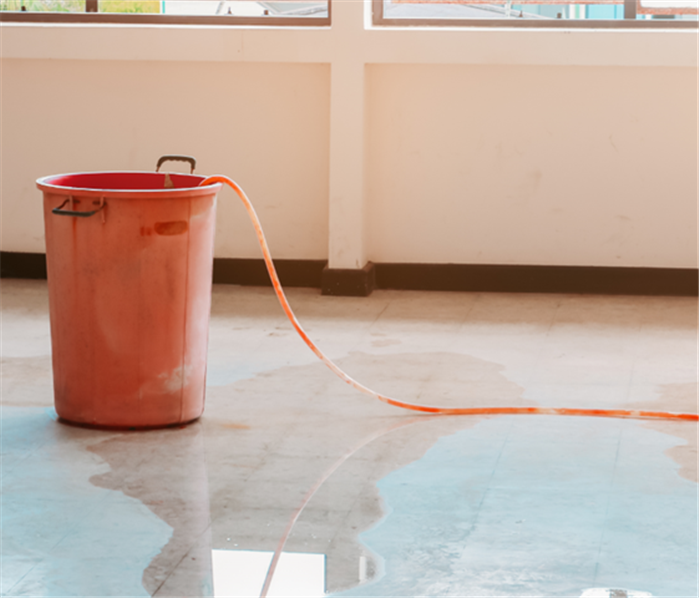 If your business was in the path of a flood, call SERVPRO to remediate the damage. We are available 24/7 to take your call.
If your business was in the path of a flood, call SERVPRO to remediate the damage. We are available 24/7 to take your call.
SERVPRO of Great Neck Can Remediate the Flood Damage in Your Jewelry Boutique!
It can be terrifying to own a business that has just suffered flood damage. Imagine that an intense thunderstorm uprooted a city-planted tree and sent it right through the front display of your shop. With a hole in your window, it's easy for water to drip into your shop and cause damage inside.
Getting professional help for your flood-damaged Great Neck jewelry boutique is the best thing you can do for your store. Allowing any water-based damage to sit unattended could cause massive damages inside of your shop, especially since it is exposed to the elements in this scenario.
What Can SERVPRO Do Once We Arrive?
As soon as our flood damage technicians arrive at your shop, we can begin the remediation. Our techs can:
- Remove the tree from inside of your shop
- Board up the broken windows in front of the shop
- Remove excess water with the appropriate equipment
Our SERVPRO techs can use extractors and wet/dry vacuums to remove excess water, as well as shards of broken glass from the floor of your shop. From there, we can begin to set up drying equipment and then help you get in contact with a contractor who can rebuild any structural damage.
What About My Inventory? What If I Have Lost Merchandise?
SERVPRO can help you take inventory of damaged or lost merchandise so you can make an insurance claim. Furthermore, we can help you:
- Box up any merchandise that needs to be stored during remediation
- Move out any furniture, shelving, or racks that need to be moved
- Help you get an insurance claim in order
Always remember, when your business has been hit with sudden damage, reach out for the help of professionals. Here at SERVPRO, we can provide you fast service, no matter what time you need it.
Call SERVPRO of Great Neck / Port Washington for flood damage remediation services by phoning (516) 767-9600 today! Day, night, weekend, or weekday, we can help you.
Click here for more information about Great Neck.
Can I Paint Over Fire Residue??
5/9/2020 (Permalink)
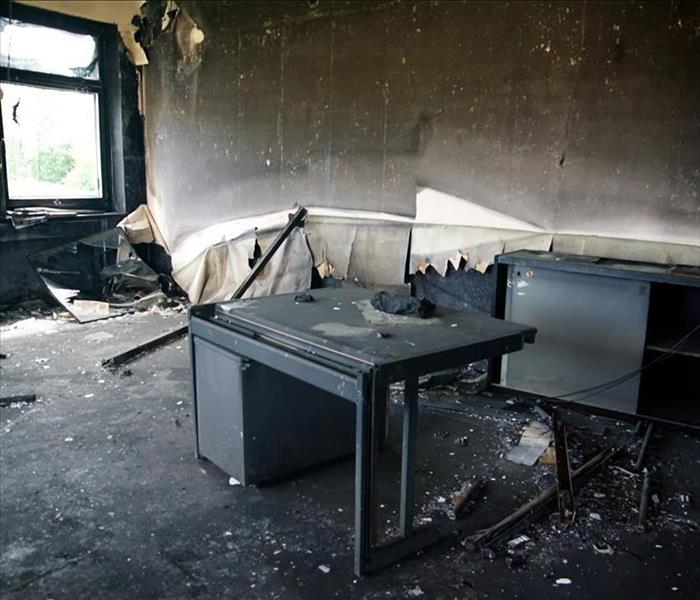 Are you trying to figure out who can take care of the fire damage in your Great Neck home? Call SERVPRO!
Are you trying to figure out who can take care of the fire damage in your Great Neck home? Call SERVPRO!
Do Not Paint Over Smoke and Soot Left Behind in Your Great Neck Residence
Whether you live in Great Neck or elsewhere, your home is not immune to catching on fire. Even a small kitchen fire can result in residual smoke and soot that fills your entire home. Although painting over it sounds like a great idea, it is best to clean the area thoroughly before getting your paintbrush.
For professional fire damage restoration in Great Neck, call our SERVPRO team for help. Our technicians are certified in water and fire restoration, and we apply our knowledge to your situation. We intend to leave your home in mint condition while protecting your personal belongings and minimizing your costs.
Do soap and water eliminate soot?
When you call our SERVPRO team, you will realize that there are many ways to clean smoke and soot depending on their origin and how it presents in your home. Organic and inorganic materials have different burn patterns and settle onto your walls and furniture in different ways. Our staff takes a look at your situation and cleans your walls accordingly. Sometimes our cleaning is enough and others it serves as preparation for a fresh coat of paint. Some techniques available to us include-
- Dry cleaning sponge
- Wet cleaning
- Peroxide active cleaning
SERVPRO of Great Neck/Port Washington is your ally. Call us at (516) 767-9600, whether you live in Manhasset or Roslyn and let us leave your home, "Like it never even happened."
Is Everything Lost After Sprinklers Go Off in My Business??
5/9/2020 (Permalink)
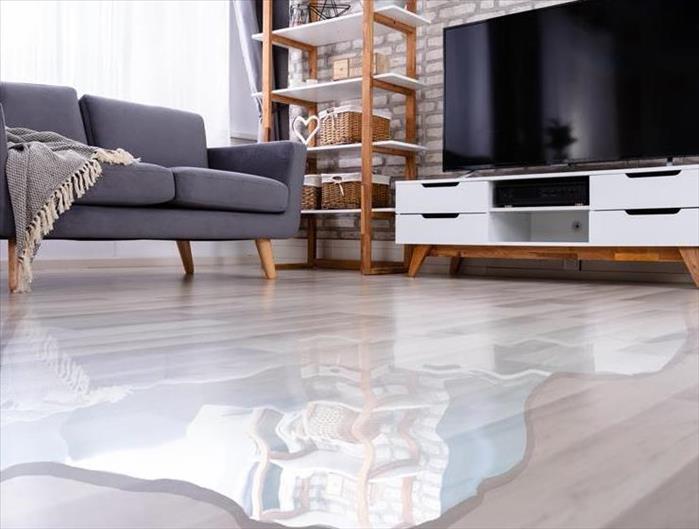 SERVPRO can be rid of your water damage issue in your Great Neck home.
SERVPRO can be rid of your water damage issue in your Great Neck home.
Not Everything Is Lost if you Call a Professional Crew when Your Great Neck Business Is Soaking Wet.
It is not uncommon for a sprinkler system to go off in your business. Malfunction, or a small fire next door, could trigger a deluge in your offices in Great Neck, soaking computers, inventory, furniture, and documents. Before you give up on it all, call a professional water restoration service to explore your options.
Great Neck business owners with water damage can rely on SERVPRO for our expert advice. We are also business owners and understand the importance of resuming normal operations as soon as possible. Call our 24/7 hotline and allow entry to our team so we may begin a thorough assessment of the situation. The quicker we isolate the damaged area, the more we keep the damage at bay.
Can I save soaking wet documents?
Most of what we own is replaceable, but there are documents, computers, and files that need our SERVPRO technicians can treat and restore. Protecting those priceless items may warrant our specialized document restoration services. We apply the principle of sublimation to your wet paper products as we seek to restore them by applying one of the following techniques-
SERVPRO of Great Neck/ Port Washington can help restore your business and your irreplaceable documents. Call us at (516) 767-9600, whether your business is in Manhasset or Roslyn. Together, we can leave your place, "Like it never even happened."
How Do I Remove Water from My Basement Floor?
4/21/2020 (Permalink)
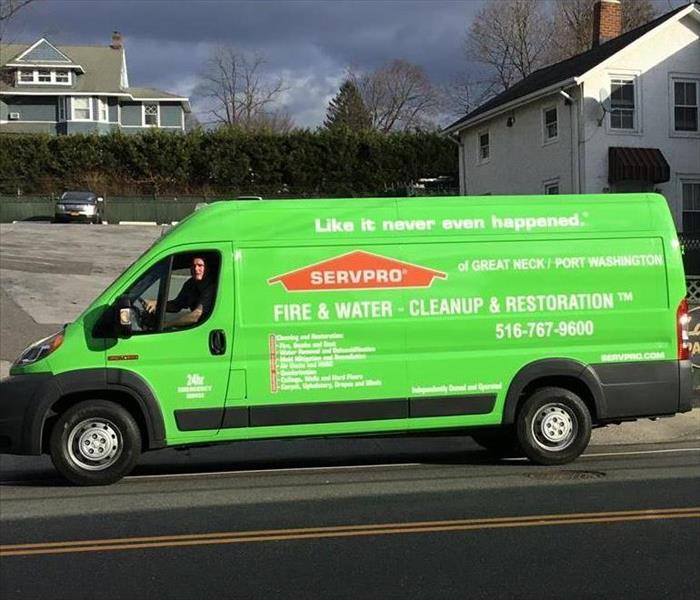 Storm Damaged Properties in Great Neck--from the Basement to the Roof--Get Help from SERVPRO
Storm Damaged Properties in Great Neck--from the Basement to the Roof--Get Help from SERVPRO
SERVPRO Has Powerful Extractors, Drying Tools, and Reconstruction Techniques to Dry Your Great Neck Basement and Prevent Future Flooding.
Basements can be a hotspot for water damage and groundwater infiltration, so addressing standing water or penetrating moisture should be a priority for homeowners living in Great Neck. Permanent solutions are critical in these situations, or this destructive situation has an opening to occur again and again.
Cleaning up after flooding or basement water removal for Great Neck homes hinges on the fast response of our qualified technicians. Because we are ready to help in these emergencies 24/7, we can reach most loss incidents within hours of the first notice of loss. Because you are speaking to a real person and not a recording when you call the emergency line, we can begin compiling essential details about your disaster quickly, so we have the right tools and personnel en route.
What Mitigation Steps Must Happen Right After Flooding?
Mitigation is vital for your home and its contents because this phase is exclusively designed to reduce losses for the property. From the moment that our team first arrives at your house, we have to get specific tasks started quickly to ensure that we can slow the migration of flooding effects and begin the essential extraction of the flooded basement level. These fundamental processes include:
Water Removal
• Extraction is one of the critical elements of flood recovery and must occur before almost any other mitigation step. To access areas for cleaning or even controlled demolition, standing water must get entirely removed. This process occurs through the use of powerful extraction tools like our submersible pumps and wet vacuums.
Muck-Out
• Cleaning out debris, mud, and other solids that can come in with heavier flooding from the outside is also a vital component to protecting your property. Shoveling out the muck from a natural flooding situation can reduce the possibility of bacterial threats and other contaminants, not to mention, prevent exposed contents from becoming irreparably damaged.
Controlled Demolition
• Many flooding scenarios require controlled demolition. Removing overly compromised portions of structural elements prevents collapse and worse conditions later on. Our SERVPRO contractors can focus on what areas need removal based on a thorough inspection. Early controlled demolition can help to reduce widespread reconstruction later.
How Can SERVPRO Dry My Flooded Basement?
Drying out the lower level of your home is a situation that requires our professionals to utilize cutting edge equipment and staples of drying sciences. By finding the ideal balance of humidity, temperature, and airflow, we can maximize evaporation and restoration in damp and moist areas like the basement of your flooded home. Some of the key tools and devices for drying out floodwater are:
• While often compared with fans, these units have a more direct and beneficial purpose in the drying of your home. Centrifugal air movers, for example, target-specific portions of water-damaged structural elements and contents to protect them from requiring replacement or discarding.
• Dehumidifiers
• Because regulating the relative humidity in the house is a vital element in the drying science balance required to overcome flooding threats in a basement; we set desiccants and low-grain refrigerant (LGR) units throughout the property to keep up with the evaporative effects of properly positioned air movers.
• Portable Electric Heaters
• Electric heaters that we bring to job sites are multi-purpose. Their immediate use can regulate an elevated temperature to increase evaporation rates of damaged structural components and the environment. We can also utilize these portable heaters to warm structures when flooding disrupts available power.
Is Contamination a Threat After Natural Flooding?
Natural flooding is a situation that is always assumed to introduce contaminants to your home. Because our technicians cannot account for the path of the water reaching your home, it must then get assumed that it has come into contact with potential bacteria, viral pathogens, and chemicals. We treat natural flooding in the same way we do sewage backups with our biohazard cleaning team.
What Are Long-Term Solutions to Prevent Flooding?
Cleaning and drying up flood damage in your basement is critical, but it is only a final step when the valid provisions have gotten taken to prevent recurrences from moving forward. Long-term construction solutions and repairs can entirely prevent the penetration of floodwater so that your basement can stay dry and usable after the restoration completes. By installing new equipment or repairing a damaged block wall, we can reduce moisture penetration and prevent a recurrence of flooding. Some of the most common techniques include:
• Hydraulic Cement
• Masonry Repair
• Permanent Dehumidifier
When you discover floodwater in your basement, it is a situation that you want to address as soon as you can. We strive to provide fast and efficient service from extraction to drying and repairs. Give our SERVPRO of Great Neck / Port Washington team a call today at (516) 767-9600.
How Do You Stay Safe While Recovering From a Kitchen Fire?
4/14/2020 (Permalink)
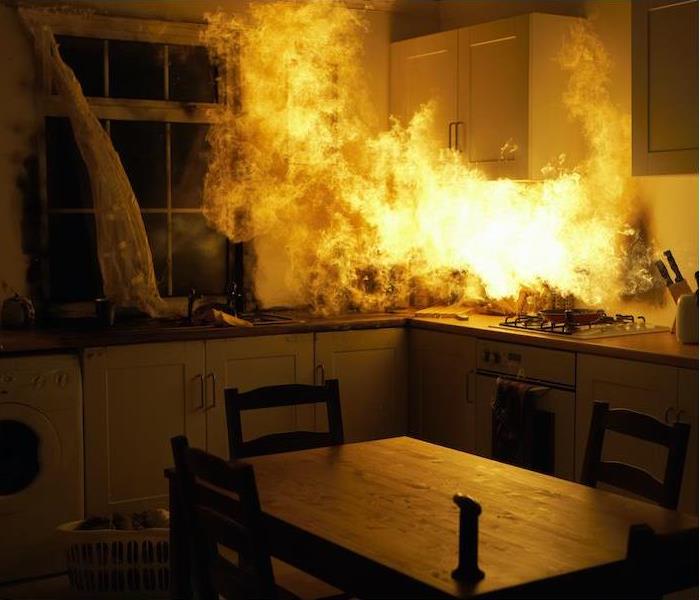 Homeowners have to deal with many things which may include fire damage. Contact SERVPRO right away.
Homeowners have to deal with many things which may include fire damage. Contact SERVPRO right away.
Rely On the Safety Procedures SERVPRO Uses for Manhasset Homeowners
Safety is an essential issue after any fire damage, but kitchen fires pose especially unique and difficult challenges. The problems include possible structural damage, safe kitchen access, and electrical hazards, and having the help of trained professionals is critical to avoid being overwhelmed.
What initial steps are necessary to make the kitchen safe after fire damage in your Manhasset Home?
A thorough, professional assessment should be performed as soon as possible after the fire. Three significant issues must be addressed immediately:
o Identify unsafe areas and safe areas
o Secure and organize the worksite
o Cleaning protocols and debris disposal
What procedures are used to ensure kitchen safety before the recovery work starts?
SERVER professionals know how to separate safe and unsafe areas, and part of that process includes pinpointing structural issues that may be dangerous. Safe cleanup procedures are also spelled out, along with the steps necessary to remove hazardous debris. Charred debris sometimes produces foul odors and can be especially dangerous, so special procedures may occasionally be required to remove it.
Precisely what safety hazards must be addressed specifically?
o Electrical hazards and lighting issues
o Potential problems for at-risk individuals
o Using PPE
How are electrical issues handled?
Restoring electrical service is a priority, but dangerous hazards must be accounted for and eliminated as part of the process. These include damaged wiring and power cords, along with the complete verification of all circuits. Ground Fault Circuit Interrupters are used to do this if moisture is present.
What about the safety of homeowners and workers?
Slip-and-fall accidents and injuries are common after a kitchen fire, but this can be prevented by identifying slick surfaces and dangerous obstacles. SERVPRO professionals have experience using protective gear while working, and they know how to implement special procedures to protect at-risk residents who have health or mobility issues.
Turn to SERVPRO of Great Neck/Port Washington to stay safe while kitchen fire issues are being addressed. Call us at (516) 767-9600 for an assessment.
Find out more about Manhasset.
We Act Fast In Great Neck After A Water Loss
4/1/2020 (Permalink)
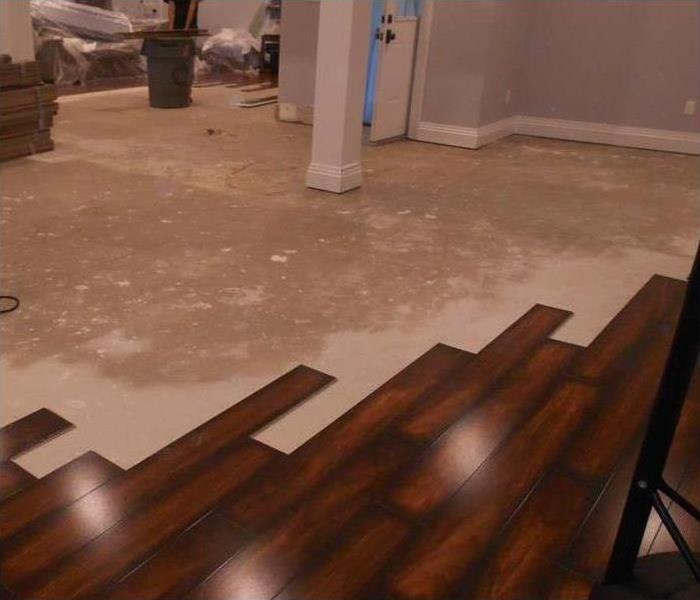 We pulled up the laminate to get the moisture out quickly and avoid any additional damage or mold growth in this home.
We pulled up the laminate to get the moisture out quickly and avoid any additional damage or mold growth in this home.
Prompt Action Can Save the Wood Flooring in Your Great Neck Home After Water Damage
Whenever you have beautiful hardwood flooring in your home, any water loss event calls for immediate response to help lessen the damage. Whether the water originates from a broken pipe under your kitchen sink or a faulty appliance, our team at SERVPRO knows how to address the problem promptly. The faster that you call us to assess the damage and get started on the cleanup, the easier it is for us to make it “Like it never even happened.”
Water damage in Great Neck is something that we are well-versed in at SERVPRO. With a quick response and professional methods for cleaning and restoring your interior, we can salvage your wood flooring. We put a plan of action in place that allows us to control things like the temperature, humidity, and airflow throughout your home to keep the flooring from warping while inhibiting mold and mildew growth.
Extraction
Upon arrival at your home, our skilled technicians assess the water damage and any of the remaining surface water. We extract water from the surface of your hardwood floors, using portable extractors with wand attachments that allow us to reach tighter spaces. Any moisture that remains on the surface after this step evaporates with the help of dry, warm air flowing throughout the space.
Addressing Water Under the Surface
If there is free water that has not yet bonded with the molecules of your wood flooring, we then take care of removing it. While free water is a bit more challenging to remove, our SERVPRO technicians utilize air movers that help create beneficial airflow that glides over the wet floors. Our team uses a unique formula to decide the right temperature and humidity ratio so that we have the ultimate combination of airflow and dehumidification.
For bound water that has been absorbed into your hardwood flooring and fully bonded with the molecules of the wood, we apply heat with the help of portable heaters. Drying mats strategically placed on the floor helps to create strong suction that pulls up water that is then released either as water or vapor. Once fully dry, our SERVPRO team thoroughly cleans and disinfects the space to inhibit mold growth and the onset of foul odors.
Do you need help with addressing water damage to your hardwood flooring? Call our team at SERVPRO of Great Neck/Port Washington at (516) 767-9600, and we will send out a team as quickly as possible for an assessment of your needs.
See more about Great Neck.
Enjoy the Benefits of Water Damage Expertise When You Call SERVPRO in Great Neck
3/18/2020 (Permalink)
 SERVPRO Teams are available around the clock to assist you.
SERVPRO Teams are available around the clock to assist you.
Our Experienced Technicians Know Exactly How To Help
No matter the level of devastation, any water loss incident creates water damage that must be addressed promptly. Countless benefits come from hiring trained restoration professionals, and we want you to know how we can help here at SERVPRO. Whether you have had a pipe burst or your washing machine leaked water throughout your laundry room, we have the experience and equipment to get the job completed quickly and efficiently.
When it comes to any water damage in Great Neck, our skilled technicians come to your property promptly to begin the assessment portion of the process. We understand how crucial it is that you are back in your home after the loss, so we formulate a plan using our proven methods and equipment.
Water Cleanup
We execute a great deal of water loss projects at SERVPRO, for both homes and businesses. An extensive amount of time and training goes into ensuring our technicians are ready to perform each job efficiently. Every professional receives certification as a Water Restoration Technician (WRT) via the Institute of Inspection, Cleaning, and Restoration Certification (IICRC).
Further training often comes in the form of:
- Carpet Cleaning Technician (CCT)
- Commercial Drying Specialist (CDS)
- Applied Structural Drying (ASD)
- Odor Control Technician (OCT)
- Applied Microbial Remediation Technician (AMRT)
SERVPRO technicians utilize DryBook Software, which allows us to strategically plan out drying goals based on the standards set forth by the restoration industry. It also allows us to document every step of the water damage restoration process so that we can monitor everything in real-time.
We also come fully equipped for each job with equipment made for effective water extraction and drying. Our trucks are loaded with pumps and wet-vacuums, along with air movers, dehumidifiers, and all of the products for disinfection to thwart mold growth.
Preventing Mold Growth
Water loss and flooding incidents pose a threat to homes in the area if proper precautions are not implemented to prevent mold and mildew growth. SERVPRO technicians have been trained to look for signs of mold, but we work first and foremost to keep it from festering, to begin with. The onset of mold can start within 48 hours from the water damage, with excessive moisture and humid conditions providing the ideal climate for growth. We work diligently to dry your interior, followed by the application of specialized disinfectants to inhibit mold and mildew.
You do not have to worry when you call SERVPRO of Great Neck/Port Washington to your side in the event of water damage. Contact our team at (516) 767-9600, and we will send out a team to make it “Like it never even happened.”
Learn more about Great Neck.
We Get You Back In Business In Great Neck After A Fire
3/9/2020 (Permalink)
 We have the state of the art equipment to restore your home after a fire disaster. Call us right away to prevent further damage.
We have the state of the art equipment to restore your home after a fire disaster. Call us right away to prevent further damage.
SERVPRO Helps Reopen Drive-Through Faster after Commercial Fire Damage Incident in Great Neck
A night fire that started at around 3 AM left widespread damages at a local drive-through in Great Neck. Once the smoke cleared and the management had the chance to scope the loss site, it became clear that reopening the facility would take time. Rough estimates put the reopening date at least a couple of months away, although an earlier date would have been preferred. They relayed their concerns to SERVPRO, and we set out to help them expedite the recovery process.
Commercial fire damage incidents in Great Neck can present unique challenges depending on how each incident unfolds. The fire at the drive-through had damaged the entire store's inventory and left substantial damages to several sections of the structure, including the trusses, roof, and interior sections. The trusses and parts of the roof needed a replacement while the other parts of the structure required thorough cleaning to remove soot and other smoke residues.
Stopping further deterioration of the property was one of the steps we could take to improve the turnaround time. Our SERVPRO technicians removed the severely fire damaged trusses and other roof materials. We then set up a roof tarp before boarding up other sections of the property to help secure it and keep off weather elements.
An intense fire, like the one that affected the drive-through, burns all kinds of materials, including natural and synthetic ones leaving massive smoke deposits on surfaces such as walls. Our SERVPRO technicians spared no efforts cleaning the affected areas. We rely on different techniques, including the use of heavy-duty cleaning agents, thorough agitation, and heat to dislodge residues from surfaces removing all traces of the fire, "Like it never even happened."
Various types of debris had accumulated the loss site from the inventory and building materials consumed by the fire, necessitating collection, and disposal. Our team incorporates the management of such debris with other aspects of the restoration. We brought trashcans on wheels and heavy-duty plastic bags to facilitate the collection and sorting of the debris, allowing quicker and proper disposal.
Fire damage can lead to an extended closure of your business. Call SERVPRO of Great Neck / Port Washington at (516) 767-9600 to assist. We are available 24/7.
See more about Great Neck.
Flood Damage In Great Neck
3/8/2020 (Permalink)
 For 24/7 assistance, contact SERVPRO of Great Neck / Port Washington at (516) 767-9600.
For 24/7 assistance, contact SERVPRO of Great Neck / Port Washington at (516) 767-9600.
Flood Damage in Your Great Neck Home
Long Island residents are no strangers to flash flooding and the implications following a flood. After the floodwaters recede, there is a mess that requires extensive clean-up. The materials and structure need cleaning as well as the contents within the home.
While you begin the restoration process after flood damage in your Great Neck home, the contents may require offsite cleaning and deodorization after a flood so that they are not exposed to any secondary damage such as dangerous mold infestations.
SERVPRO removes impacted contents for storage into the offsite, secure warehouse so that your valuables appropriate care depending on the level of soil and the specific item. Upon arrival, contents go to a staging area for sorting, inventory, and labeling. Each of your items has a label that travels with it from start to finish to make sure everything returns to your home in a timely fashion. At the time of removal, it is essential to point out RUSH or ASAP items that you need back quickly for your life to function smoothly. These items are cleaned and returned first.
After the staging area, your items move to the cleaning area. Restoration specialists separate anything contaminated with category 2 or 3 water or by pests to ensure that no cross-contamination occurs. Typically there is a cleaning room that holds professional cleaning products, a sink, and has good lighting to promote thorough cleaning and folding of laundry. Tables are typically raised so technicians can comfortably stand while they work. The cleaning room may have one large station or several stations.
There is also an ultrasonic cleaning and processing room. Ultrasonic cleaning is an advanced type of cleaning that uses ultrasonic waves to agitate a fluid, either water or cleaning solvent, to remove soil from the item. The waves generate thousands of microscopic bubbles that burst, and the water pressure acts as a pressure washer to gently remove soiling.
The cleaning and deodorizing process begin after technicians move items to the cleaning areas. During the cleaning process, technicians carefully document the process and then repack the items quickly after technicians finish cleaning them, so they do not need recleaning. Technicians make appointments with specialty restorers like furniture refinishers, electronics restorers, and dry cleaners as required. Once everything is clean, and in the preloss condition, it is returned to the resident.
For 24/7 assistance, contact SERVPRO of Great Neck / Port Washington at (516) 767-9600.
For more about Great Neck click here.
How SERVPRO Removes Water From Great Neck Homes
2/11/2020 (Permalink)
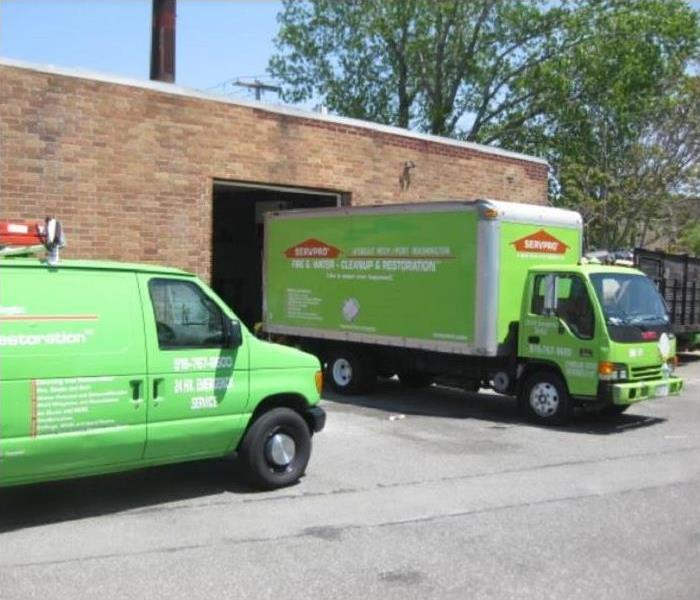 Day or night, SERVPRO is always on call to handle your water damage emergencies!
Day or night, SERVPRO is always on call to handle your water damage emergencies!
Expediting Water Removal from an Affected Great Neck Property
When you discover a water spill in your property, there is no time to waste. Starting the removal process immediately and completing it fast helps in many ways, including making the property habitable again and reducing the percentage of secondary damages that develop. SERVPRO helps expedite water removal in many ways.
The quickest way to address water removal from affected Great Neck properties is to extract it before it soaks into materials around the property. Removal of surface water requires the right pump, which can provide the right lift and volume capacity. It should also be convenient to handle, especially if different parts of the property are affected. Our SERVPRO teams have access to a wide variety of extraction equipment, including submersible pumps, truck-mounted extractors, portable extractors, and dry wet vacs, among others. Therefore, we can choose the most appropriate for your property.
After removing all surface water, there is a need to address any moisture left in contents or building materials fast. Dehumidifiers help with such removal. They work by pulling water vapor from the air, thus increasing the evaporation from wet materials. Our SERVPRO technicians expedite the process by choosing high-efficiency dehumidifiers such as the low grain variety, especially in the final stages of drying when other types are less efficient. We also modify conditions at the loss site by increasing air movements and temperature to improve efficiency. Increasing air movements also increase the evaporation rate while higher temperatures help the air hold more moisture expediting the removal process.
Sometimes convenient water removal is hampered by contents, which obstructs the movement of restoration crews or prevents proper usage of removal equipment. Our SERVPRO crews perform partial or complete move-outs creating the necessary room for fast water removal. For partial move-outs, we identify a dry location within the same building to act as temporary storage for your contents.
One way to reduce damages caused by water loss incidents is to complete the removal process fast. Call SERVPRO of Great Neck / Port Washington at (516) 767-9600 to help. We're Faster To Any Size Disaster.
More about Great Neck.
Content Management for Manhasset Stores After Water Loss
12/15/2019 (Permalink)
 Let SERVPRO walk you through your content management for your Manhasset water loss.
Let SERVPRO walk you through your content management for your Manhasset water loss.
Water loss in your Manhasset business can get tricky, let us help you.
As a store owner, you are all too familiar with maintaining a nearly constant inventory and stock status for your Manhasset shop. This information is valuable after a water loss incident, as things might not get moved to an area that makes taking stock challenging. It also can help with determining your total loss after an emergency when our SERVPRO team first arrives to begin scoping the job to complete.
As a business owner, you regularly reinvest into the items that you sell from your location, which can make a need for water removal in Manhasset stores destructive to your bottom line. Our professionals can work to establish an efficient plan that addresses present standing water and excessive moisture on surfaces and in materials that can threaten the stock of the store. Emergency services often include content management, which can remove at-risk items and inventory from the main store floor to a safe location elsewhere on site or our facility nearby for safekeeping.
We always anticipate a need to transport items and stock from your store to our facility, and that is why we bring all the necessary boxing and packing supplies to move products safely. Items get earmarked in the initial inspection phase for removal and storage to prevent rising waters in the main store area from affecting clothing, trinkets, and jewelry of your fashion-forward establishment.
Moving back these items is as coordinated as their careful removal from the damaged areas of your store. Days before we have scheduled to return removed contents to your store, our SERVPRO technicians stage all of these items to ensure that no last-minute problems exist. We inspect for lingering moisture, staining, or any other concern that could devalue any product.
Water damages and severe threats like standing water can quickly cripple your small business. Our SERVPRO of Great Neck / Port Washington team can assess the risks to the inventory of your shop and determine the best approach to protect them. Whenever you need help after a water loss incident, let our professionals assist you by calling (516) 767-9600.
To find out more about Manhasset, click here.
Why SERVPRO is Your First Choice for Water Removal in Manhasset
12/10/2019 (Permalink)
 Need water removal services? We've got you covered! We have the equipment and expertise to get the job done.
Need water removal services? We've got you covered! We have the equipment and expertise to get the job done.
Expediting Water Removal from Affected Manhasset Homes
Water is an excellent utility with unlimited uses around the house, but when it spills, it triggers many problems, so there is a need for fast removal. Although you may have every intention to resolve the situation fast, issues such as lack of equipment and unpreparedness can cause delays. As a professional water damage restorer, SERVPRO helps in many ways to expedite the process.
On-time arrival
Water removal from Manhasset properties requires immediate coordinated effort for a positive outcome. So, any delays in the arrival of personnel or equipment at the loss site can have a negative impact. Our fully kitted SERVPRO crews commit to arriving at your property within 4 hours after learning about the loss because a timely arrival is part of our strategy.
Setting up Maximum Equipment Units
When water spreads out all over a property, performing removal procedures from a single point at a time can delay the process. Our SERVPRO crews have access to a wide variety of water extraction and drying equipment, which we capitalize on by setting them up units in different parts of the property. For example, we have enough air moving units to set one up in every room affected by the water loss. We also use more than one dehumidifier to quicken and balance the drying process.
Using Techniques that Speed the Process
Various items in the house can absorb and hold the water the spills. Alternatively, the water finds a way into concealed areas such as subfloors, wall cavities, cabinets, and other hard to reach areas. Such outcomes can prolong the process, especially when we need to teardown or move contents in the process. Our SERVPRO technicians use specialized techniques that quicken the process. For example, in carpeted areas, we can do in-place drying and use weighted water extraction equipment. For the water in concealed areas, we can use cavity-drying equipment. Such procedures eliminate the need to tear down and rebuild wet areas.
Fast water removal has many benefits, apart from restoring the property faster. Call SERVPRO of Great Neck / Port Washington at (516) 767-9600 to help. We’re Faster To Any Size Disaster.
More about Manhasset.
Why We Utilize Flood Cuts for Water Damage Restoration in Great Neck
10/22/2019 (Permalink)
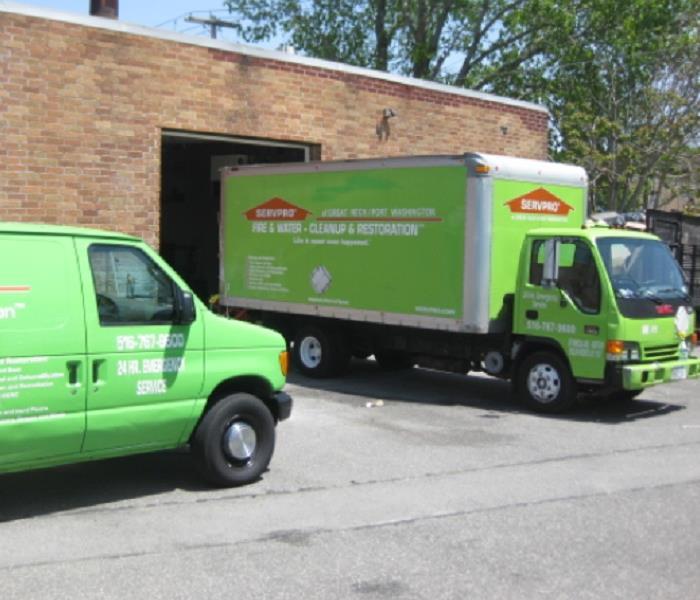 Our Green Fleet is always equipped and manned for emergency restoration,
Our Green Fleet is always equipped and manned for emergency restoration,
Flood Cuts Help Structural Drying in Great Neck Homes
With sophisticated drying tools and approaches, our professionals are always working to excel and to make restoration more efficient for our Great Neck customers. Identifying the extent of the problem and the best approaches to overcome these risks is vital to this mission. Knowing how to maximize our results and the effectiveness of our equipment can often mean the use of controlled demolition and similar intricate tasks.
Flood cuts are a method of reaching structural cavities and drying up water damage in Great Neck homes without more considerable demolition. This practice has our professionals establishing a dryline on sheetrock and wallboard to determine the absorption of moisture and dampness from the base of the wall up. With moisture meters, we can detect how far the water has wicked from the baseboard. Once we have this line of where the moisture stops, we can mark it out and get our licensed contractors in for controlled removal of this saturated drywall.
By not removing the entire panels of drywall, we can save our customers money on replacement material and the time necessary to install and finish these surfaces. Before reconstruction begins, we must thoroughly dry the structural cavity that has now become exposed by the removal of the sheetrock. Depending on the height of the damage line, we have both high and low profile air movers.
In instances where drywall removal is not necessary, and the water damage has not reached a critical point for the material, our positive pressure systems like the InjectiDry machine can work instead. This unit forces heated air throughout the structural cavity to dry the damage without requiring the removal of any construction materials.
You might not always understand why controlled demolition needs to occur in your home, but it is often a more direct path to drying out damaged areas before they can become catalysts for mold and microbial growth. No matter how severe water damage in your residence might be, you can count on our SERVPRO of Great Neck / Port Washington team to make it “Like it never even happened.” Give us a call anytime at (516) 767-9600.
More about Great Neck.
Little Known Ways to Rid Yourself of Commercial Water Damage in Manhasset
10/19/2019 (Permalink)
 Don’t let your theater succumb to commercial water damage. Call SERVPRO today.
Don’t let your theater succumb to commercial water damage. Call SERVPRO today.
Avoid Closure of Your Manhasset Theaters with Professional Water Damage Mitigation and Remediation
When water intrudes into your Manhasset multiplex, fast and efficient mitigation and remediation not only preserves the structural components of your commercial building. They also ensure any closure is brief or limited to a defined space. Disappointed customers who look forward to date night or a family outing need assurance that the crisis is temporary. Otherwise, they might seek other venues for their viewing pleasure. Our highly-qualified team can help.
Snack Bar, Ahoy!
Before the matinee, your staff working the opening shift discovered water damage at the Manhasset movies. A leak in an ice machine spread meltwater across a terrazzo floor to carpeting in the arcade. Fast action on our part permits the show to go on, with our crew preventing continued migration of the fluids and planning for the evacuation of the remaining standing water before structural drying.
Impressive Inventory of Water Removal Equipment
Our Institute of Inspection, Cleaning and Restoration Certification (IICRC)-trained project managers and technicians are well-rehearsed in water removal and applied drying theory. SERVPRO’s supporting cast consists of commercial-grade submersible pumps, portable and truck-mounted extractors, and high-efficiency drying equipment. All the tools needed to remove the water arrive with our technicians on our signature green trucks, immediately available to implement all phases of our project plan.
In-Place Drying of Carpeting Minimizes Disruption
When an expanse of carpeting absorbs water SERVPRO often considers removing the water and completing drying without removal. We start by using wanded extractors to limit or mitigate further spread. Then we switch to weighted machinery to force the remaining water out of the carpet fabric and padding. Our technicians add their body weight to press more water out. Each pass of the extractor completes with care to prevent stretching or tearing of the carpet fabric. We inspect for signs of delamination as we extract, avoiding actions that cause the carpet to separate from its backing.
Thorough Extraction Speeds Drying
Taking the time to extract as much liquid water as possible significantly shortens carpet drying time. SERVPRO technicians know secondary damage, such as mold growth, takes hold if moisture levels are not normalized within 24 to 48 hours of the water loss. We position air movers, heaters, and dehumidifiers to dry out the carpet, considering removing and replacing the padding to improve the outcome.
SERVPRO of Great Neck / Port Washington has the trained workforce and specialized equipment to return your water-damaged commercial building to “Like it never even happened.” Call us day or night at (516) 767-9600 to schedule an assessment and project planning session.
Click here to learn more about the city of Manhasset.
Great Neck Storm-Related Flood Damage Requires Professional Assistance
10/11/2019 (Permalink)
 Flood damage in your Great Neck home, SERVPRO will keep you above water.
Flood damage in your Great Neck home, SERVPRO will keep you above water.
We know the damage a flood can do to your Great Neck home, let us help.
As climate change increases and extreme weather patterns continue to challenge residents of Great Neck, the potential for storm-related flooding also climbs. The six-month hurricane season time frame from June to November exposes North Shore communities to a broad array of risks. The coastal movement of high winds and torrential rains accelerate overland flooding and storm surge. Exterior damage to your home also permits vast quantities of water to enter and harm building materials and contents.
Powerful and Efficient Water Removal Equipment a Must
In theory, Great Neck flood damage could be addressed by a homeowner. Unfortunately, no matter how diligent and motivated you are, without commercial grade water extraction tools, it simply takes too long to extract the floodwaters. Within hours of a water loss, the majority of structural components begin to disintegrate and degrade. Drywall crumbles, wood warps, metals rust, and laminates separate. As the structure deteriorates, the moisture spurs secondary damage, such as mold growth. Our crews are scalable, with many hands completing tasks and activities quickly. Every one of our service vehicles stocks multiple pumps, extractors, and the entire range of air movers, heaters, and dehumidifiers needed to mitigate and remediate flood damage fast.
Contaminated Water Needs Expert Management
The water flowing into your home during and after a significant storm is, by definition, contaminated. As water gathers on the ground and the pavement, it picks up dirt, industrial waste, deceased animals and insects, and chemicals, among other contaminants. Overwhelmed sanitary sewers force human waste back into your home. The SERVPRO crew is familiar with how to categorize and then appropriately manage dirty water safely, following local regulations. We contain it and dispose of it legally, protecting both your family and the general public.
Salty Storm Surge
Storm surge increases the salt and other mineral contamination of floodwaters. When assessing your home’s damage, we account for the complications of saltwater. SERVPRO crews consider flushing with fresh water to prevent delignification, a process where organic cells lose their structure due to hypersalinity. The weakening of wooden structures otherwise is possible. Long term damage to building materials like concrete is also possible if salt levels are high, and we fail to adapt our approach.
SERVPRO of Great Neck / Port Washington has the trained technicians and equipment to respond quickly and efficiently to help recover from weather-related flooding. Call us at (516) 767-9600 as soon as practical after the storm.
If you would like to know more about Great Neck, click here.
Packout Services
6/24/2019 (Permalink)
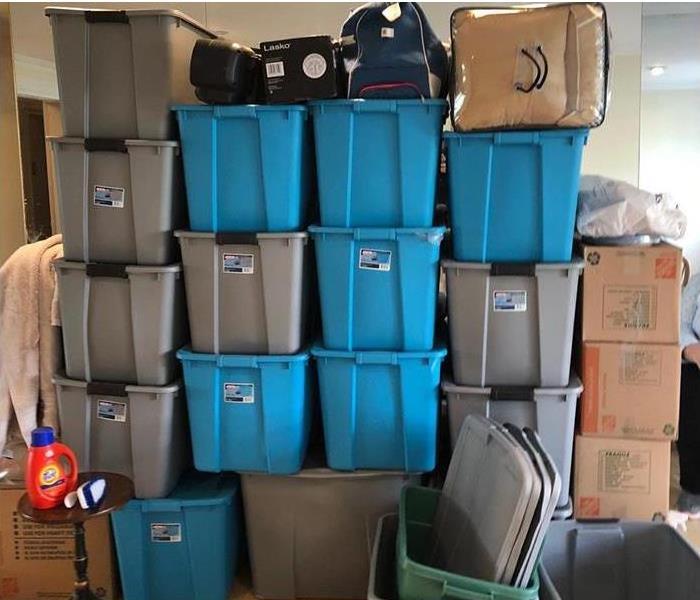 packout in progress
packout in progress
If you need to pack out items for a renovation, restoration, construction move etc., SERVPRO of Great Neck/Port Washington is here for you!
We do inventorying and pack outs all the time for loss jobs, and can do yours too - whether delivering to a storage facility, an onsite temporary trailer or portable storage unit, or our own facilities.
Packing out an entire home, office or business is a huge job. We've had years of experience and the project doesn't scare us - we've got it down to a science.
When you are ready to bring back your boxes, we'll return them when you've scheduled them. We can help categorize and inventory possessions as well as label so they all are returned to the correct spaces.
Containment During Procedures
6/24/2019 (Permalink)
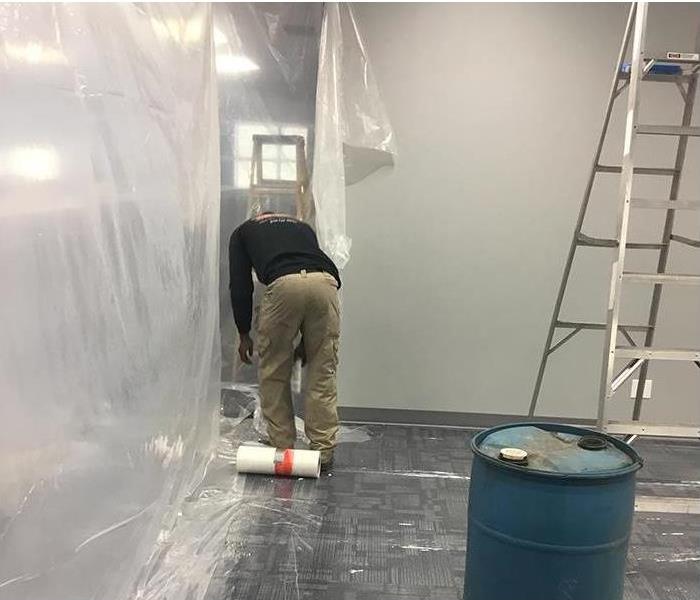 Containment in progress
Containment in progress
At SERVPRO of Great Neck/Port Washington, we know that business goes on even when there is a problem. Every minute down is dollars lost. We do our best to optimize that experience when we are on site.
Here is an example of containment being set - when we seal off areas undergoing work from other areas in use by company employees so there is no transfer of dust, mist or spores.
We have a variety of barriers and drop walls that we install and seal, and in certain situations like mold will use pressure so that contaminants don't transfer out of the affected areas.
We are skilled and experienced in these procedures and have many satisfied clients who were able to maintain daily operations even as we were on site for them. Call us to inquire! 516-767-9600
Older Homes and Fire Damage Replacements
6/21/2019 (Permalink)
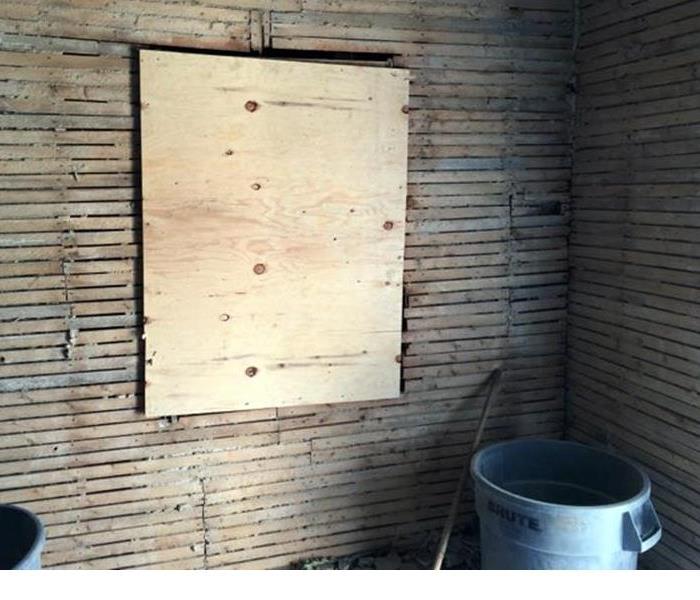 Plaster and Lathe in Historic Older Home after Fire Damage
Plaster and Lathe in Historic Older Home after Fire Damage
In the fires and other events that we see at SERVPRO of Great Neck/Port Washington, older historic homes often require substantial attention and often pieces are irreplaceable. Even when they are replaceable, you may find your insurer will not cover an exact replacement.
Those with plaster and lathe tend to have lots of dry flammable wood, and the plaster layers are not so amenable to repairs and patching like modern drywall. Damage to plaster and lathe may require a complete gut and renovation of a room or home.
Often other details affected such as columns, inlaid flooring, plaster ornamental details, ceiling medallions, door, window, crown and baseboard trim, and more will not receive exact or even like replacements from your insurer.
You might be surprised to find that your insurer will allow only standard replacements for columns and molding, not the fancy plaster and wood decorative pieces you have cherished. You may opt for basic coverage and pay out of pocket for the difference, should an event occur, pay more, or your insurer may have other options for you.
It is wise to consider what your expectations are when first arranging for homeowners insurance and have that discussion before selecting your policy.
Extreme Water Damage
6/21/2019 (Permalink)
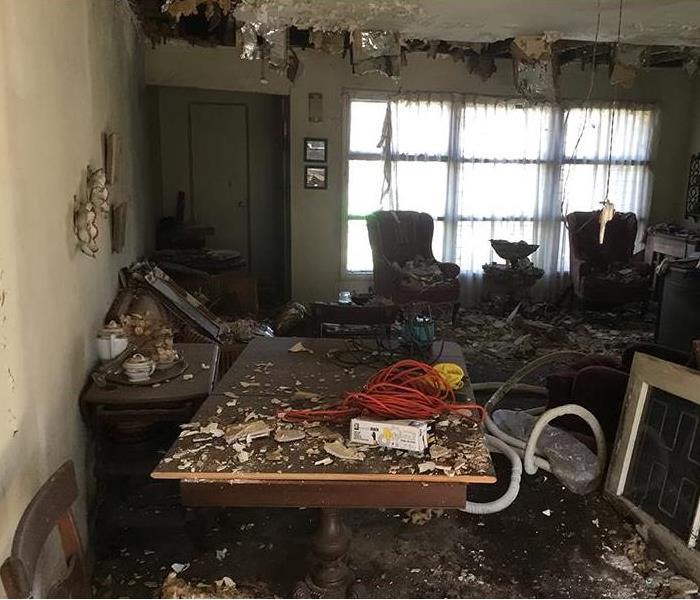 Extreme Water Damage
Extreme Water Damage
Water damage can be minor, major and catastrophic. It seeps into areas you can't see or reach, and it destroys materials and possessions in it's path. At SERVPRO of Great Neck/Port Washington, we've seen all degrees.
Here, we'll walk you through a major case. Water pouring from above has collapsed ceilings, you'll see insulation and ceiling drywall covering rooms. Buckled walls and hardwood floors, caused microbial growth (mold) to take root. Books, photos, art and chairs, couches and carpeting are destroyed, wood furniture begins to swell and veneers pop, finishes get cloudy and delaminate. Electrical wiring in the ceiling and walls are compromised. This is now not a livable space.
SERVPRO will come in and removed all of the damaged materials and strip the spaces so contractor ready to refurbish - after intensive drying, cleaning, moisture reduction and mold prevention measures are taken.
Water in School District Buildings
6/21/2019 (Permalink)
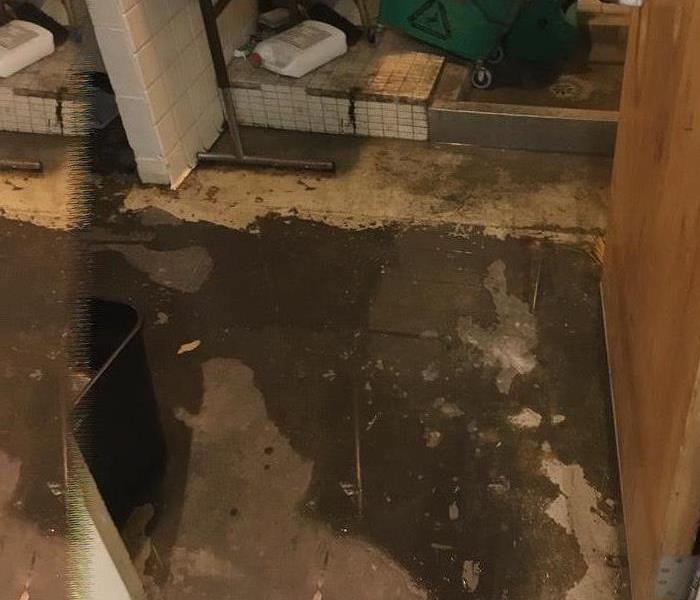 remnants of a flood in a LI school district
remnants of a flood in a LI school district
Water damage to a school district in session can be an emergency. SERVPRO of Great Neck/Port Washington is up for the job! We know that schools have state mandates for how many days in open and in session they need to have, and disruptions due to unforseen events can be a problem.
We are up for the job, securing the area and prioritizing areas so that public areas open to children are ready as soon as possible. Utility and mechanical areas that pose a danger are also prioritized. In the end, all spaces will be cleaned and restored.
We'd like for you to know that we've had plenty of large loss experience, and have the capabilities to handle your school, college, library, church or other commercial or industrial space professionally and deftly. Call us at 516-767-9600
Cleaning out Excessive Clutter for Hoarders
6/21/2019 (Permalink)
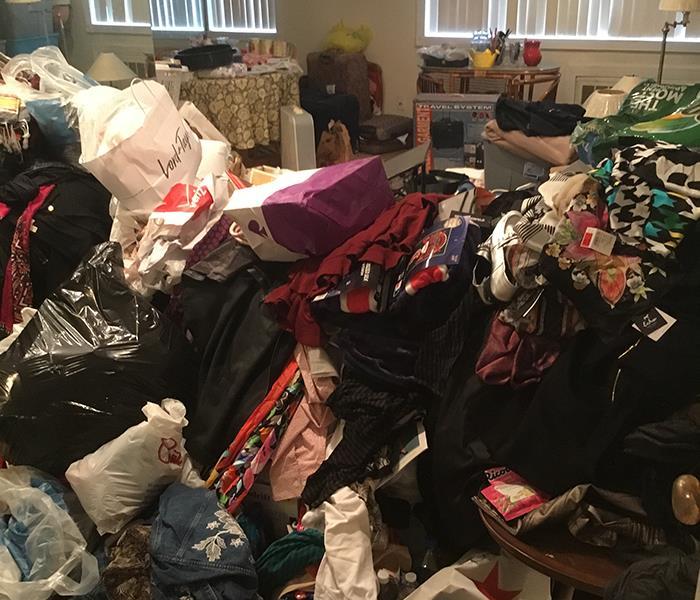 cleaning out clutter
cleaning out clutter
We've truly seen and cleaned it all. Did you know that SERVPRO of Great Neck/Port Washington does big cleaning? When excessive clutter or hoarding is an issue - we can help you with a monumental task efficiently and compassionately. Often this is a high pressure situation where the client is being forced by either apartment management or the fire marshal.
At times hoarders will request their possessions be moved entirely to storage facilities. This creates a cycle where the empty space refills but the client is paying ongoing storage fees that they'll never get out from.
We recommend they choose to keep absolute essentials, and let go the items like never opened items still in boxes and bags, old expired papers, magazines and food as well as collections of clothing and collectibles that don't suit you, fit you or help you. Valuables can be sold, used items donated, and broken, soiled or trash items will be discarded.
Black Sewage Contaminated Water Damage Must Have Proper Restoration
6/23/2018 (Permalink)
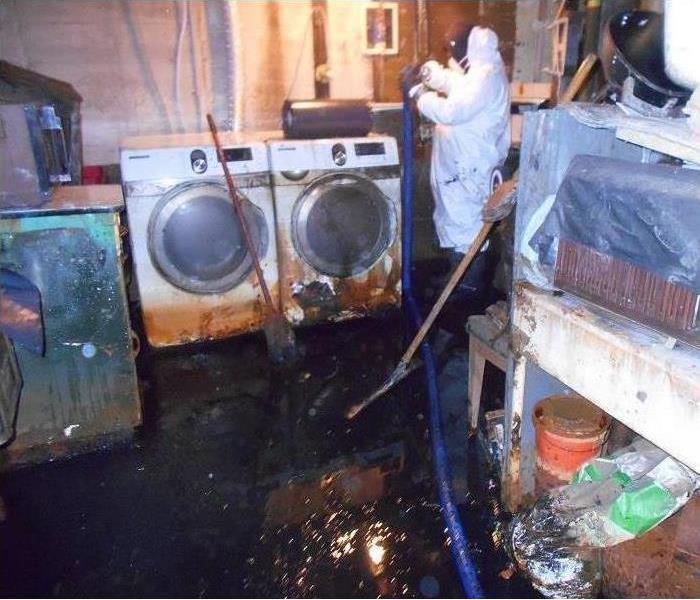 Hoarding situations and sewage/black water losses can be restored
Hoarding situations and sewage/black water losses can be restored
This job came to us in the fall and is one of the more extreme and tragic cases we have experienced. The elderly homeowner frail was a hoarder suffering mental health issues.
Months earlier the sewage line had blown, flooding a packed basement with raw sewage, swimming in pathogens.
Due to the homeowner's frail condition and distress about the situation, they closed the door and ignored it. Delays cause even greater damage but in our line of work this is a situation that we've experienced more often than you'd imagine.
The sewage line was not fixed during this time, the wet contaminated water and solids permeated all porous surfaces and caused damage to non-porous surfaced, just from exposure. You can see the effects to the washer and dryer.
In this situation, the contents become a hazard and must be carefully removed and discarded because of microbial and mold growth. Extensive antimicrobial were used in cleaning, and air scrubbers placed to ensure that the structure was clean and safe once more.
Fire Destroys Tenant's Apartment and Primary Residence
6/23/2018 (Permalink)
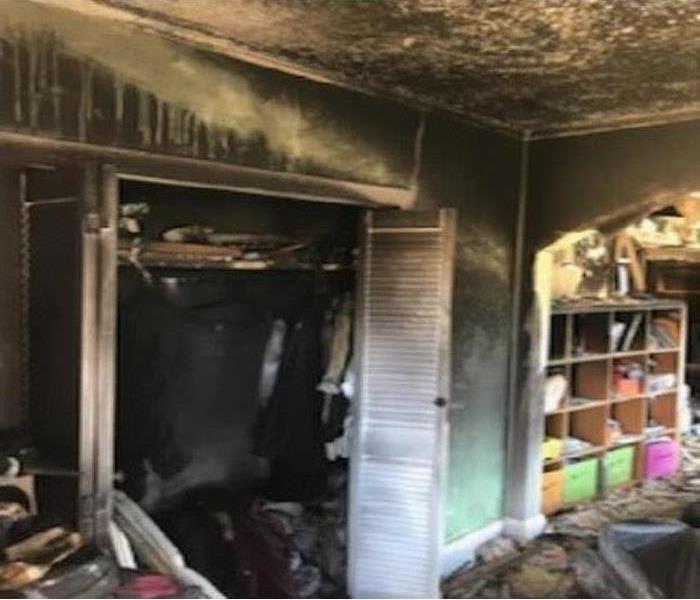 Apartment fire damages entire home.
Apartment fire damages entire home.
When you have a tenant in a basement or attached apartment, make sure that you have ample and proper fire safety detection equipment - namely, smoke detectors throughout your unit and theirs.
Luckily in this fire no one was injured, but the apartment as you see was a total loss, the contents were destroyed. The source of this fire is under investigation but originated in the apartment. However, the smoke damage permeated the owner unit as well, which had extensive amounts of antiques and collectibles, the owner's business. The entire home had to undergo restoration.
As a homeowner and landlord safe egress, properly maintained utilities, and fire detection equipment is a primary responsibility.
As a tenant, you should make sure smoke detectors are present, know your egress escape points, and make sure that you create no potential fire hazards. Additionally, make sure you have renter’s insurance with fire coverage, don't expect the homeowner's insurance to cover your own belongings.
Fire Safety Week is in October, but it is never too soon to do a fire safety check in your own home!
Fire and Smoke Damage When You Have Valuable Antiques, Art and Collectibles
6/23/2018 (Permalink)
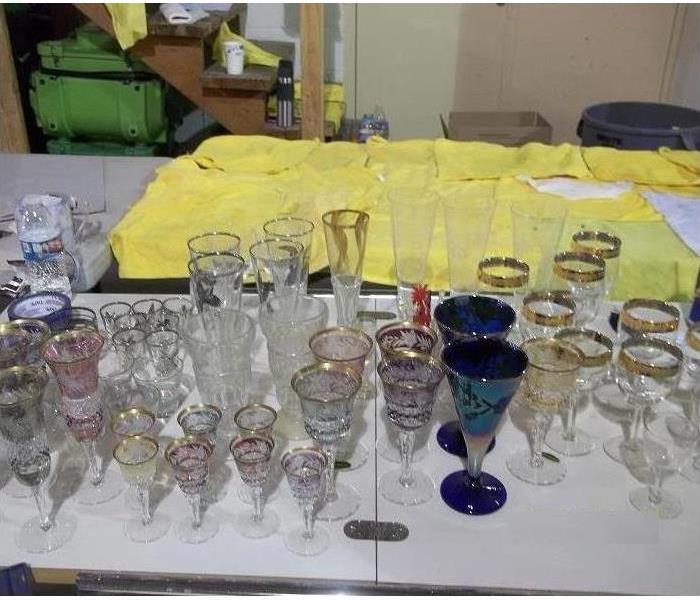 Fire and Smoke Damaged Collectibles Can Often Be Restored!
Fire and Smoke Damaged Collectibles Can Often Be Restored!
A fire is a devastating event, no question - but one particularly more complicated when you have valuables that are irreplaceable affected.
At SERVPRO of Great Neck/Port Washington we often encounter property owners with unique situations of all types. The matter of valuables is one worth addressing because of their monetary value and irreplaceable nature.
While you can safeguard the value end with special insurance coverage, be sure to make and keep a digital file in the cloud and in a safe deposit box with a complete inventory list with adequate invoices, bills of sale, dates of purchase/acquisition, provenance records, descriptions, valuations and photographs.
Make sure your homeowners policy agent knows that you have valuables that need coverage, don't assume your policy covers all.
If there is a fire, call in SERVPRO as soon as possible to ensure that restoration can begin on anything salvageable. We restore whatever can be saved and also will provide an inventory list of losses for your insurance claim.
We're here for you, 24/7.
Restoration After Utility Water Damage
6/23/2018 (Permalink)
 This utility area suffered water damage after the equipment failed.
This utility area suffered water damage after the equipment failed.
When boilers/hot water heaters blow, it can create quite an unexpected mess through the surrounding areas. Often, we find that homeowners have accumulated content on the floor, often papers, photos, clothing and toys in cardboard boxes - which get saturated as it wicks in the moisture.
For precious or vital papers that must be saved, SERVPRO has the ability to dry them out through a special freeze-drying technique at one of our out of state facilities. After packaging them up we send them off. While they may not appear perfect as before, the moisture is completely removed, and the documents can be kept or scanned. Preventing mold growth through boxes of papers and photos will avoid mold growth down the road.
Ask your local SERVPRO professional about document restoration after water damage!
When Storms or Floods hit Long Island, SERVPRO of Great Neck/Port Washington is ready!
6/21/2018 (Permalink)
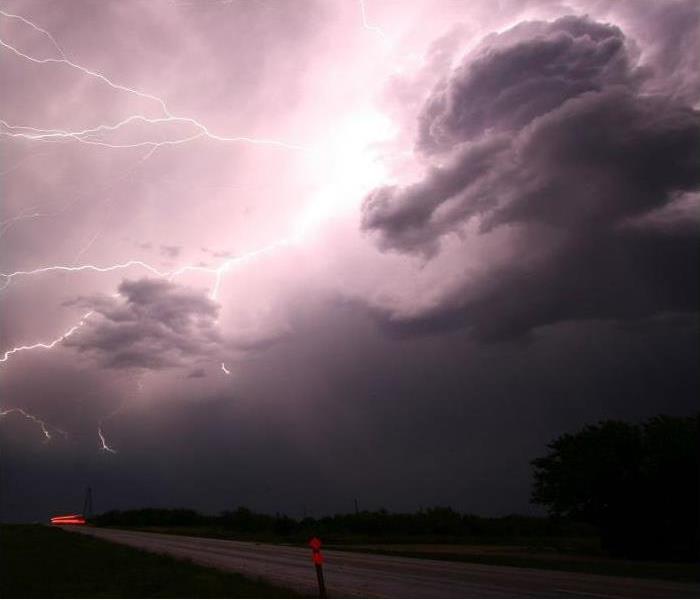 Our highly trained crews are ready to respond 24/7 to storm or flood damage in Long Island.
Our highly trained crews are ready to respond 24/7 to storm or flood damage in Long Island.
SERVPRO of Great Neck/Port Washington specializes in storm and flood damage restoration. Our crews are highly trained and we use specialized equipment to restore your property to its pre-storm condition.
Faster Response
Since we are locally owned and operated, we are able to respond quicker with the right resources, which is extremely important. A fast response lessens the damage, limits further damage, and reduces the restoration cost.
Resources to Handle Floods and Storms
When storms hit Long island, we can scale our resources to handle a large storm or flooding disaster. We can access equipment and personnel from a network of 1,650 Franchises across the country and elite Disaster Recovery Teams that are strategically located throughout the United States.
Have Storm or Flood Damage? Call Us Today 516-767-9600.
Tips to detect Mold
6/7/2018 (Permalink)
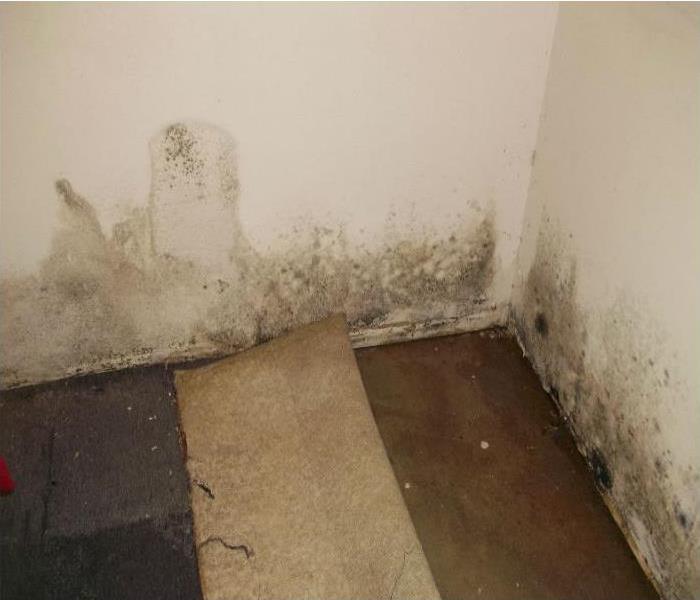 Mold found in drywall.
Mold found in drywall.
If there are ongoing moisture problems in your home or building it is important to be alert for presence of visible mold, strong musty odors which may indicate mold is present, or any evidence of past moisture problems that might have caused mold growth. If you see any of the following signs below contact a certified mold testing company.
- Mold smell
- Visible mold grown
- Water leaks, water instruction or past flooding.
Mold can be found behind walls, in the basement, under carpet, in damp areas of the house, surrounding roof leaks or in area that experiences high humidity.
The only way to accurately assess the amount of mold in your home is to test for it. The three main types of test for mold are:
- Air Testing
- Surface Testing
- Bulk Testing
Contact your local SERVPRO to have the pleasure to assist and guide you to asset the problem before it spreads to other areas.
Damage after a Storm in a Flood Zone
6/7/2018 (Permalink)
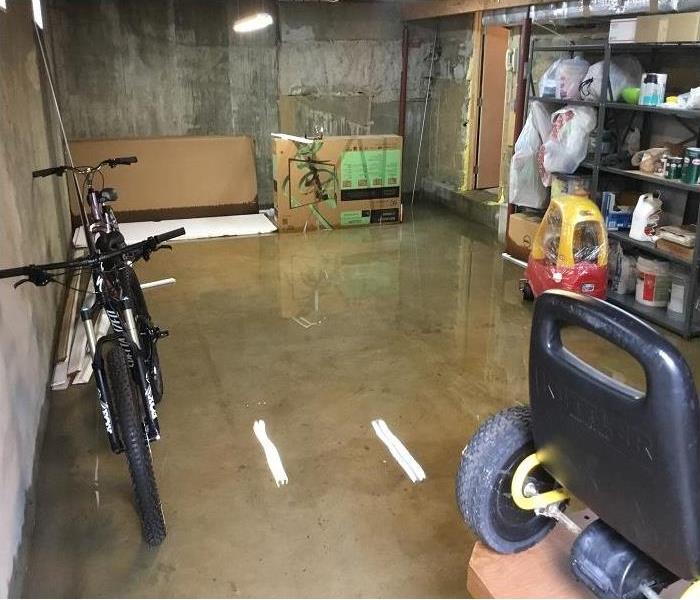 Flooded basement after a Storm in Freeport, New York
Flooded basement after a Storm in Freeport, New York
During violent storms Freeport, NY is one area that is prone to flooding. Extensive rain often leaks into your home from the outside, this basement in Freeport, NY was flooded due to a storm.
There are three major types of water (Clean water, gray water and black water, which might include external flooding) In this special case this basement was flooded with black water that contains pathogenic agents and is grossly unsanitary. Floods can completely inundate your home or business causing a lot of damage to the structure and contents.
SERVPRO of Great Neck/Port Washington was brought in to assess the damages in the property, our crew quickly assisted removing standing water from the area, along with assorting content to determinate which content was salvageable, after removing the affected content we cleaned and disinfected the area and proceeded to set up special drying equipment.
SERVPRO of Great Neck/Port Washington has the experience, equipment and products necessary to handle any type of water damage.
SERVPRO of Great Neck/Port Washington is Ready to Resolve Any Water Damage Situation
6/7/2018 (Permalink)
 Photo of a flooded basement in Long Island, NY.
Photo of a flooded basement in Long Island, NY.
Water damage to your residence can appear in a many forms, in a multitude of ways. Not all water emergencies require extraction but, in this situation, this finished basement living room area was flooded with water which was caused by an over flooded toilet.
Regardless of the severity of the damages SERVPRO of Great Neck/Port Washington is ready to handle even the most difficult of tasks, our SERVPRO technicians will ensure that every effect of the water incident will be resolved accordingly.
Overcoming water damage in your home residence or property is concerning and will require professionalism and expertise that our SERVPRO of Great Neck/Port Washington technicians have, count on us if you ever in need of our services. Call us at (516)767-9600.
SERVPRO of Great Neck/Port Washington is Ready for any Fire Damage Situation
6/7/2018 (Permalink)
Massive fire damage to your property is compounded with additional damage from water, smoke odors & soot, whether from the fire department in order to put out the fire and of course rainy whether.
In the even of a property fire SERVPRO of Great Neck/Port Washington will ensure the property is secure, by assessing the damage and address all health and safety issues and concerns. Our trained technicians will remove damage content or if its necessary storage salvageable content. We will mitigate the water damage, deodorize smoke odors, clean and restore surfaces. We have special equipment to remove odor and soot from surfaces.
SERVPRO of Great Neck/Port Washington will leave the property prepare for the restoration/construction phase. We are dedicated to help you during a stressful time. Contact us if you experience fire damage at 516-767-9600.
2018 Hurricane Season Predictions
6/6/2018 (Permalink)
 Satellite NOAA photo
Satellite NOAA photo
Satellite image by NOAANOAA has predicted a normal to above normal season for the 2018 Atlantic hurricane season this year, which occurs from June 1 through November 30.
What is normal? This prediction indicates the Atlantic coast could see 10-16 named storms, 5-9 of which could be hurricanes. Of those, 1-4 could result in major hurricanes with winds of 111 mph or higher. These major hurricanes could be categories 3, 4 or 5 and can create significant damage and destruction.
Doing as many preventative steps as you can before storm season has begun can help to minimize your damages and losses. Trim any trees and branches that are heavy, dead, or a threat to personal property, electric wires or a structure. Round up any loose items that could become airborne. Secure and fasten down large items that must remain but could become airborne or move in flooding.
Make hurricane shutters cutting plywood to fit all windows and doors, secure all rolling overhead garage doors from inside, make sure all drains, gutters and downspouts are clear and drain away from the property.
Use proper personal safety. If there is a regional evacuation - secure your property and evacuate. If warnings instruct you to remain off the roads, do so. Flash floods are very dangerous and very unpredictable. SERVPRO of Great Neck/Port Washington is here to help clean up any storm damage.
Smoke alarms are vital in saving lives and property and proper use and installation is critical.
6/5/2018 (Permalink)
Smoke alarms are vital in saving lives and property and proper use and installation is critical.
In New York, the NYS Department of State Division of Code Enforcement and Administration has specific requirements for existing residential installations: RCNYS section 317.1.1 require single and multiple-station smoke alarms to be located as follows:
1. On the ceiling or wall outside of each separate sleeping area in the immediate vicinity of bedrooms.
2. In each room used for sleeping purposes.
3. In each story within a dwelling unit, including basements and cellars but not including crawl spaces and uninhabitable attics.
In dwellings or dwelling units with split levels and without an intervening door between the adjacent levels, a smoke alarm installed on the upper level shall suffice for the adjacent lower level provided that the lower level is less than one full story below the upper level.
6 Steps to Prevent Carpet Mold After Water Damage
6/5/2018 (Permalink)
Reprinted by angieslist.com
The best way to keep mold from spreading is to act fast when you know water is present.
1. Remove water as quickly as possibleUse a wet/dry vacuum to clean up as much water as soon as possible. These machines are the most effective tools for removing water and can be rented or provided by water damage remediation companies that specialize in repairing residential flood damage.2. Use fans to speed up carpet drying process
It can take several days for fans to completely dry a water-damaged area. The good news is that they also help circulate fresh air.
3. Use a dehumidfier to dry out the room
These machines remove excessive moisture, which makes the air feel cooler and limits mold and mildew growth. Any equipment that helps dry out the air and the ground will speed up the drying time for your damaged floors and coverings.
4. Steam clean carpet and flooring
Steam clean all carpets to properly sanitize and deodorize. Typically, water-damaged carpet padding must be replaced.
Replacing just the padding is much less expensive than having to re-carpet your entire home.
5. Sanitize walls and baseboards
Anything touched by storm water should be sanitized. Clean all walls, hard-surface floors and other household surfaces.
6. Check furniture
Look for water damage and remove furniture from wet flooring.
Water damage can easily be hidden underneath rugs or carpet, so be sure to give your home a thorough inspection if you suspect water damage.
Cleaning water-soaked carpets and floors is difficult under any conditions, but in the aftermath of a storm or flood, contamination by mud, silt, sewage and mildew, can compound the problem. The Institute for Inspection Cleaning and Restoration Certification recommends that in such cases, a certified mold restoration service provider should evaluate water damage and remove mold.
Kitchen Fire Prevention Tips
6/4/2018 (Permalink)
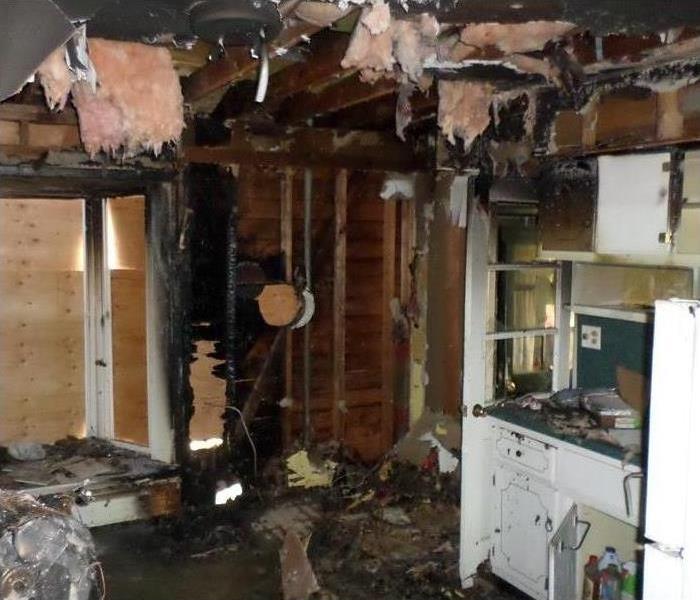 The aftermath of a kitchen fire.
The aftermath of a kitchen fire.
We've all done it - put something on the stove and got busy elsewhere in the house - completely forgetting that we were cooking until we smell something acrid and burning. In some cases, maybe you've actually gone outside or on an errand.
Kitchen fires travel fast and knowing some tips to extinguish them could reduce the risk of injury and damage.
Tip #1: Never throw water on a kitchen fire. It seems counter to what you'd intuitively do, but water on a grease fire will act as an accelerant and the fire will flash and spread rapidly.
Tip #2: Keep a kitchen rated fire extinguisher in an easily accessible cabinet and install a smoke detector in the far end of the kitchen (not so close to the stove that regular use sets it off).
Tip #3: With a stove fire, dampen and wring out a kitchen towel, then toss it over the flames to smother it.
Tip #4: Cook pots should have the handles turned in, so toddlers cannot grab and tip them.
Tip #5: Use a timer and set an alert on your mobile phone if you plan to leave the room so you don't forget you were cooking.
Professional Commercial Cleaning Services
5/31/2018 (Permalink)
When an unexpected disaster has occurred in your commercial building, our team at SERVPRO of Great Neck/Port Washington, arrives with all the equipment and cleaning products necessary to get the job done.
SERVPRO of Great Neck/Port Washington, with more than 10 years of experience in the industry we assure and guarantee our customers an excellent service, along with our ability to handle any cleaning problem with the highest level of professionalism. We understand that every business has their special cleaning needs and requirements, we can develop a plan identifying the proper cleaning procedures which will facilitate a positive working environment for your business by eliminating mold, standing water, bacteria, damaged drywall, tiles floors, wooden floors, resolving pipe bursts by cleaning left over standing and many more.
By identifying issues such as standing water or the presence of mold or mildew, we can immediately take a plan into action which will resolve the problem quickly and correctly. We understand the importance of keeping your business clean for safety and health, our goal is to help you maintain your business clean, sanitary and safer for your employees, visitors or customers alike, especially those particularly health-related businesses.
Water Leaks Can Disrupt Your Business Operations
5/30/2018 (Permalink)
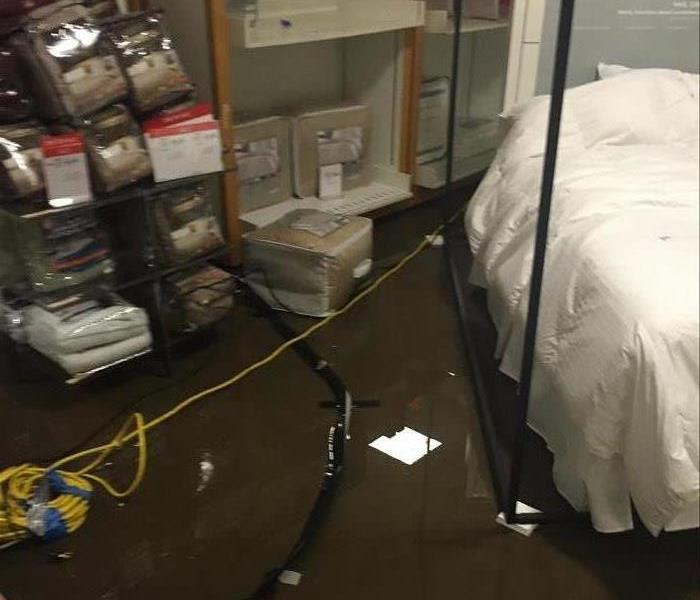 This is what we found in this popular retailers bedding section - note electricity and water are dangerous
This is what we found in this popular retailers bedding section - note electricity and water are dangerous
You've got one.... A ceiling tile, or two - or ten that have a stain from above. A stain that changes and gets bigger after storms or for no reason. That leak that is there but being ignored has the potential to interrupt your business and cause significant damage.
We've encountered many a building in the Great Neck, Roslyn, Port Washington and Manhasset areas that have suffered a sudden and significant deluge of water. Often the area of impact was not anticipated, as pipes are tucked out of sight behind drop ceilings that absorb small leaks. When there is overflow we have seen massive losses on the warehouse floor, out on retail floors where thousands of dollars of new merchandise is damaged and rendered unsaleable.
Drop ceilings suddenly much heavier from the weight of water collapse onto the office or sales floor - and businesses have to close until the area is safe, cleaned up, and merchandise replaced.
How can you avoid interruption? Pay attention to the small leaks and water spots. Have periodic inspections by a master plumbing contractor. Avoid snow and ice buildups where water can pool and leak.
Should leaks happen, or worse - SERVPRO of Great Neck/Port Washington is here for you, to make it "Like it never even happened."
Commercial Storm Damage - Long Island, NY
5/29/2018 (Permalink)
 Commercial Storm Damage - Long Island, NY
Commercial Storm Damage - Long Island, NY
Storm damage to a commercial building that cannot have downtime needs to be mitigated quickly - often while occupied and with operations underway. SERVPRO of Great Neck/Port Washington works under all types of constraints and needs.
This building suffered water damage from damaged roofing during a storm. The property was cleaned and restored quickly, allowing the staff to get back to work with minimal disruption. Often we have conducted overnight remediation, to avoid any disruption to the company business and to make sure the space is back up and running.
Our work is guaranteed, and our entire crew is trained, professional, and dedicated to providing excellent services and treating your office or facility with respect.
We are always here to help our customers 24/7.
Clean Soot and Grease After a Fire Damage
5/29/2018 (Permalink)
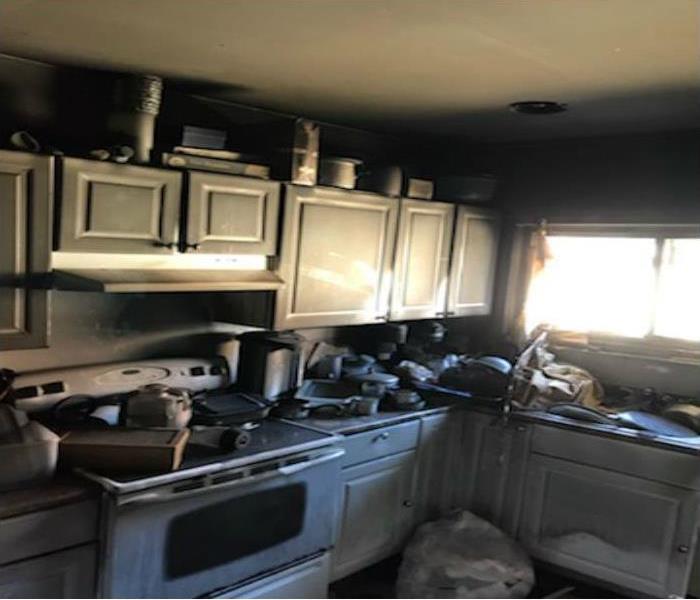 Kitchen with a lot of soot and grease are notoriously difficult to clean up.
Kitchen with a lot of soot and grease are notoriously difficult to clean up.
SERVPRO of Great Neck/Port Washington is trained to help you to cleaning your house or property after a fire. Soot and grease are notoriously difficult to clean up, and it needs to be done quickly to prevent secondary damage. you also find residue of grease and soot in the walls, ceiling, appliances, and other areas you might not be able to access, such as behind the walls, cabinets.
We have all the equipment and services necessary to handle even the most difficult task. Our professionals can identify the proper cleaning procedures, have all the necessary equipment to remove the odor from the property and knows how to properly remove kitchen cabinets without causing further damage.
In situations of a lot of soot and grease its necessary to have a quick clean up response that will also help to prevent getting your items permanently staining from soot. SERVPRO of Great Neck/Port Washington is available to help 24/7.
Hurricane Season 2018
5/29/2018 (Permalink)
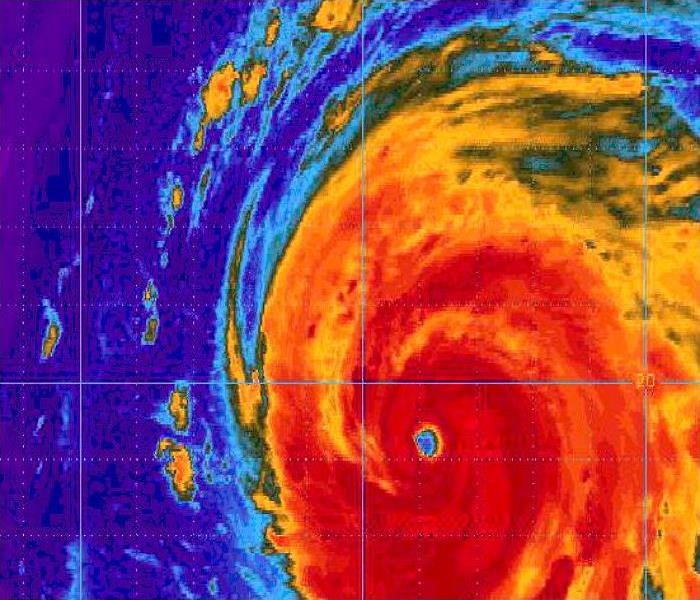 Hurricane season 2018
Hurricane season 2018
Reprinted by Patch.com
It's far too early to say if another Sandy is headed to New York City in 2018, but early predictions are that this year's hurricane season is going to be an active one.
The National Oceanic and Atmospheric Administration is predicting a "near or above normal" hurricane outlook. In releasing the annual Atlantic outlook Thursday, officials said they anticipate 10 to 16 named storms with winds of 39 mph or higher. Of those, five to nine could become hurricanes, including one to four major hurricanes with winds of 111 mph or higher.
"We're predicting 10 to 16 tropical storms. The average is 12," explained lead hurricane season forecaster Gerry Bell with NOAA's Climate Prediction Center. "We're expecting a near average season which means a lot of storms forming in the Atlantic."
Bell said the forecast has a 70 percent probability of occurrence. "We would expect our range of hurricanes to be correct 70 percent of the time and they are," he explained.
An average hurricane season produces 12 named storms, of which six become hurricanes – including three major hurricanes.
Emergency Maintenance Services for Business
5/29/2018 (Permalink)
As an emergency services company, we at SERVPRO of Great Neck/Port Washington get all kinds of calls for a staggering amount of reasons, at all hours. When there is an urgent need for immediate service, we get right to it. Our regular commercial clients get VIP service to make it right.
We have a long list of commercial buildings we have serviced, from banks and hospitals to schools and municipal buildings. We are here to get you back to business as soon as possible, with as little disruption as possible. This is not often easy when you've suffered a massive flood or fire, but our motto is, "Like It Never Even Happened" for a reason!
If you have a business or commercial facility, put our phone number in your cell phone 516-767-9600 and know that we take calls 24/7 with immediate response for urgent cases. We are here for you, every day.
Commercial Building Suffers Sewage Biohazard Event
5/25/2018 (Permalink)
This commercial building had a sewage backup from the toilets, all over the floor, that as you see in the photo. This is a serious situation, as raw sewage is full of harmful and hazardous waste. Containing excrement, debris, micro-organisms such as coliform, fecal coliform, escherichia coliform and enteroccocus.
Dangers of coming into contact with raw sewage include E. coli, Hepatitis, Weil's disease, and more. This is why it is so important to have trained professionals do the cleanup.
Simply inhaling the fumes of sewage backup can be hazardous - as the air sewage can be contaminated and by breathing in, you can can inhale toxins. Even inhaling infected dust can be very dangerous.
Walking through infected areas are very dangerous particularly without any PPE and preventative measures. You can very easily transmit hazardous toxic matter on your feet and shoes, even if you don't see anything. These are microbial hazards - not detectable with the naked eye. By walking through an affected area into an unaffected area - you have now contaminated that clean area. Discard whatever shoes and clothes have touched the affected area and l eave the sewage cleanups to us! Call 516-767-9600
SERVPRO of Great Neck/ Port Washington have your back in Commercial Fire Damage
5/25/2018 (Permalink)
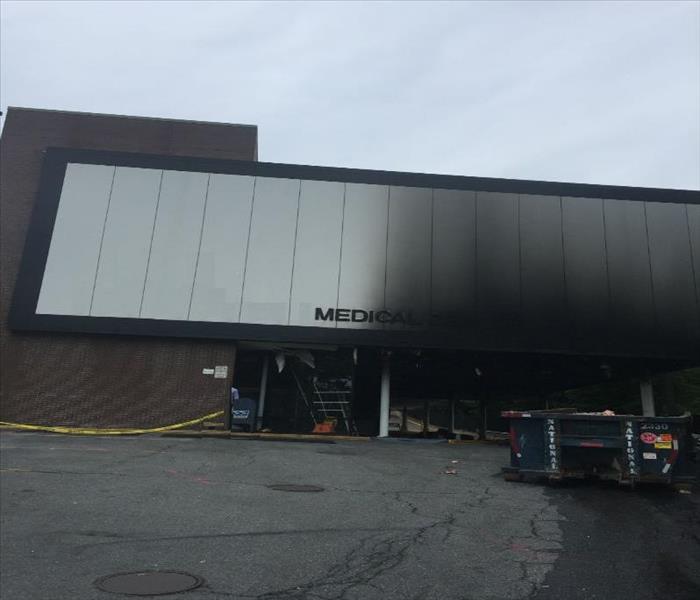 Commercial Fire Damage
Commercial Fire Damage
No one wants to think about their commercial building suffering a fire. Fire damage events at commercial properties present their own unique defiancé and can be very stressful and tense. We understand the importance of getting your commercial property up and running as fast as possible.
Smoke contains many toxic and corrosive chemicals compounds. This can be worse depending of what type of business is conducted on the premises. In this particular case it was a Medical building, making it necessary to implement extreme care measures at the time of restoration.
You contact our team, we bring 10 years of experience with commercial property damage with us. We have the necessary resources to handle any job, large or small. We quickly determinate the extent of the damage & assess the situation, isolate the damaged area, and start work immediately.
If your commercial property experiences a fire damage event call us at 516-767-9600.
Mold Stains Successfully Removed With a Cleaning By SERVPRO of Great Neck/Port Washington
5/25/2018 (Permalink)
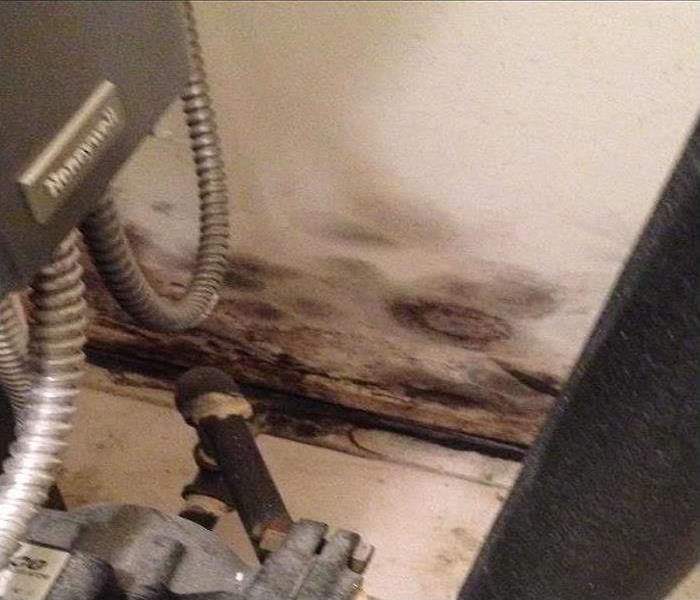 You don't have to live with mold - call SERVPRO of Great Neck/Port Washington
You don't have to live with mold - call SERVPRO of Great Neck/Port Washington
Often when homeowners try to clean mold on their own, they are left with unsightly black mold stains on wood and other materials - they have changed the stain, and often made it worse. Frequently out of despair, they will splash around straight or diluted bleach that quite often creates even more damage and is a hazard. Bleach does not kill off mold, that is a false rumor that has managed to perpetuate itself. It is not true but there is a hope and a better way!
When you call in SERVPRO of Great Neck/Port Washington, your job is handled by trained professionals who are using the most effective products and equipment available. Our mold treatments have amazing results! Don't lose property value because mold is growing or staining wood and drywall - we can help. We can stop the mold and banish the staining.
We have seen consistently amazing results with our restorations products and techniques - which is why SERVPRO has grown to over 1700 locations, nationwide! Insurers love us as restoration usually cost a lot less than replacing, we are expert at restoration and cleanup after fire, water or even mold events - so remember our name.
Tips for Mold Prevention
5/24/2018 (Permalink)
Best way to prevent mold growth in your place is by controlling the moisture. Put in practice these advice can help you to prevent mold growth.
- Keep indoor humidity levels low. (Ideally between 30% - 50%)
- Using fans can help with ventilation, also can improve and control indoor air quality.
- Try to keep the laundry room and kitchen area vented to the outdoors when possible.
- During humid seasons try to reduce moisture buildup using an air conditioner or air dehumidifier.
- Water problems, leaks or other structures that lead to moisture buildup, should be identified and repairs as son as possible to prevent further damage to the interior of your home or business. Thus, keeping low humidity levels will persevere your ceilings, walls and floors.
keep in mind controlling moisture is the key to preventing mold growth.
Manhasset, NY Mold Removal and Remediation | SERVPRO of Great Neck/Port Washington
5/24/2018 (Permalink)
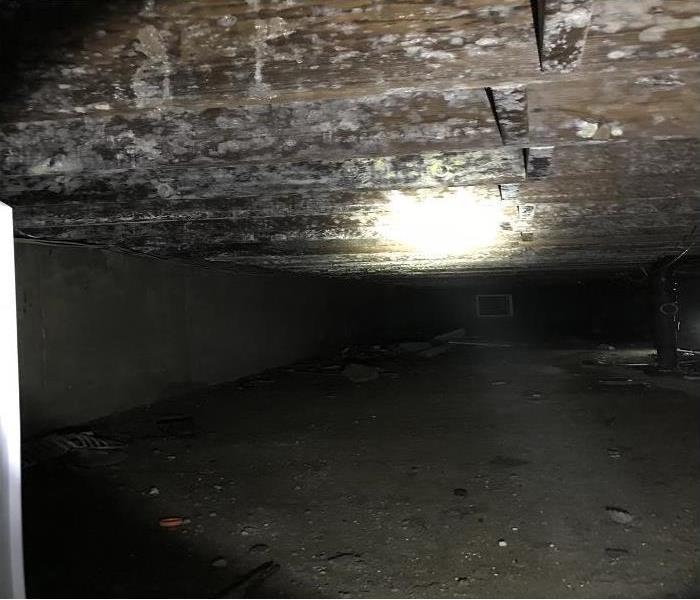 Mold started in the attic and was ignored until it progressed to lower floors - don't ignore the signs!
Mold started in the attic and was ignored until it progressed to lower floors - don't ignore the signs!
Mold can produce allergens and irritants and has the potential to cause other health effects. Mold can spread quickly through your Manhasset, New York home or business in as little as 48 hours. If you suspect that your home or business has a mold problem from what you see or by odors that won't go away, give our office a call before it progresses any further.
If mold is found, we have the training equipment, and expertise to remediate. Depending the extent of mold found on an initial visual inspection, it may be necessary to have environmental testing done by an independent environmental hygienist. If so, we then follow their protocol for the remediation.
It's important to be attentive when mold is suspected as it can continue to grow and damage your property. Learn more about mold and what to do until help arrives by reviewing these mold damage tips. SERVPRO of Great Neck/Port Washington has a crew professionally trained to help in situations involving mold.
Secondary Fire Damage – Water, Soot and Smoke
5/24/2018 (Permalink)
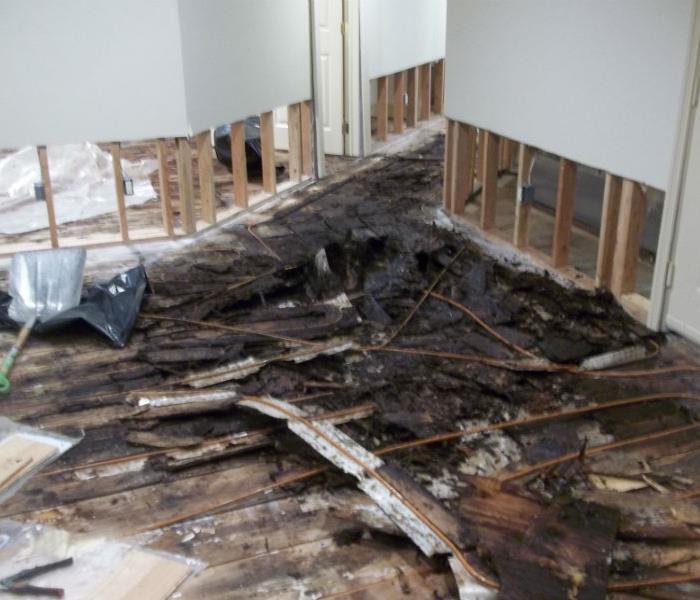 Fire damage can result in secondary damages
Fire damage can result in secondary damages
Secondary damage in areas of homes and buildings isn't what you think about after a fire but areas not burned in a fire are often affected.
Smoke and soot can work their way into nooks and crannies on all floors - not stopped by doors. It may not be immediately obvious as all surfaces may be coated. Water damage from the fire can cause lots of losses by damaging furnishings, building materials, electrical or mechanical systems and personal belongings.
In this house fire, water in a room not directly burned has caused extensive damage. Additionally, soot and ash coat everything and every surface, and smoke odor as well. Many things may seem as if totally destroyed. Restoration and cleaning of some soft items and hard surface items are sometimes possible.
SERVPRO has special document drying chambers for completely drying out important irreplaceable papers and books that have become water damaged in a fire or flood.
Hidden Water Lurking Under Your Kitchen Counters
5/24/2018 (Permalink)
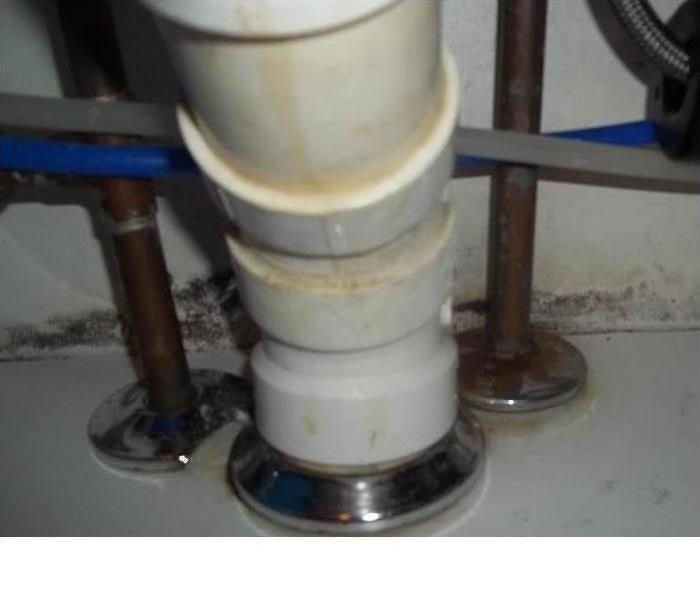 Mold damage under a sink in a Long Island, NY kitchen
Mold damage under a sink in a Long Island, NY kitchen
The area under the kitchen sink and the dishwasher are often the ones we see on jobs! They conceal water problems as they aren't out in the open and may be obscured by pots and pan, dishes and dry goods. But when they leak, if the situation is not corrected quickly, things can progress and mold can start to grow.
This kitchen sink pipe had a leak that did subsequently result in mold growth, so SERVPRO of Great Neck/Port Washington was called in to remediate. We are trained and certified for Mold in New York State, and have antimicrobials and cleaning techniques that can resolve the problem and prevent any further growth. We make it "Like it never even happened." Think you have a mold problem here on Long Island? Give us a call! 516-767-9600
Most Commonly Used Drying Equipment With Water Damage Restoration
5/23/2018 (Permalink)
 Air movers - affectionately called snails!
Air movers - affectionately called snails!
Commonly used equipment includes:
- Air Movers: Used to accelerate air flow and evaporation of moisture from materials for restorative drying.
- Dehumidifiers: Used to reduce moisture levels, accelerate the drying process in water restoration
- Floor Drying System: These are high-pressure air mover mats, used during water restoration to dry hardwood floors. This system draws evaporated moisture out of damages areas and creates a vacuum seal on mats to move air from the subfloor to the surface.
- Air Scrubbers: used for cleaning and controlling air quality in restorations.
- Hygrometers: Moisture meters used to detect or monitor moisture in most building materials.
- Submersible pumps: drains standing water from any surface - ideal for flooded basements, farm use, draining standing water from swimming pools, fountains, flooded basements, etc.
- Extractors: usually used for water extraction from carpet and hard surfaces.
A successfully water damage restoration always begins once the standing water has been removed - though it may not be visible in puddles. Nevertheless, there are specific methods used for each and every situation.
Above Average Precipitation For Winter 2017-2018 Can Cause Water Damage
11/17/2017 (Permalink)
 snowy winter predicted
snowy winter predicted
The Farmers' Almanac has long been what people look to forecast what the upcoming seasons will look like - we at SERVPRO of Great Neck/Port Washington always review what the Farmers' Almanac predictions are so that we have an idea of what lies ahead.
Recently they released their long range predictions for the coming winter season. For our area here on Long Island, New York we will experience above normal precipitation with a "cold and snowy" season. We can expect a good amount of snow along with cold temperatures, which can lead to ice damming, roof leaks, backed up gutters, and basement leaks.
The Farmers' Almanac has said they are also "red-flagging the 2018 dates of January 20-23, February 4-7 & 16-19, and March 1-3 & 20-23 along the Atlantic Seaboard for some heavy precipitation."
With a cold winter on the horizon, take measures to winterize and prepare now.
Snow and Ice Dams on Your Roof
11/17/2017 (Permalink)
 Ice dams on roof
Ice dams on roof
Ice dams are common in our region. Sometimes they are caused by blocked gutters and spouts and often on the roof. The heat in your attic melts the underside of snow that has accumulated on the roof. That water trickles to the eaves where it freezes and grows into a larger and larger ice mound. Water can work it's way inside your roof and attic creating a lot of damage before it is discovered, often resulting in secondary mold damage.
How to deal with an ice dam? knock off what you safely can with a broom or shovel. While not recommended to use rock salt on your roof (it causes structural and material damage), calcium choloride is an option - your local home improvement retailer should have several options for you that will allow you to easily create a channel for water to run off the roof.
If water has made it's way into your attic, SERVPRO of Great Neck/Port Washington is here to help!
Sudden Rains Cause Flash Flooding Woes On Long Island
8/18/2017 (Permalink)
 August 2017 Flash Flooding On Long Island, NY
August 2017 Flash Flooding On Long Island, NY
Sudden rains today on Long Island on this August day caught many by surprise - businesses and homes were suddenly awash with water and our phones began to light up. Often when the water intrusion is from ground level and underground from the rain itself, the rain activity needs to stop before we can mitigate and dry - though we can pump to keep waters from rising. When water floods from above from a roof leak, we also cannot dry until the rain has ceased. In the interim we do whatever we can to staunch the flow - from simple buckets and barrels to installing ceiling redirects to keep the water from landing where you don't want it - and remove standing water to keep damage to a minimum.
Storm Damage to Assisted Living Facilities Are No Problem for SERVPRO of Great Neck/Port Washington!
6/20/2017 (Permalink)
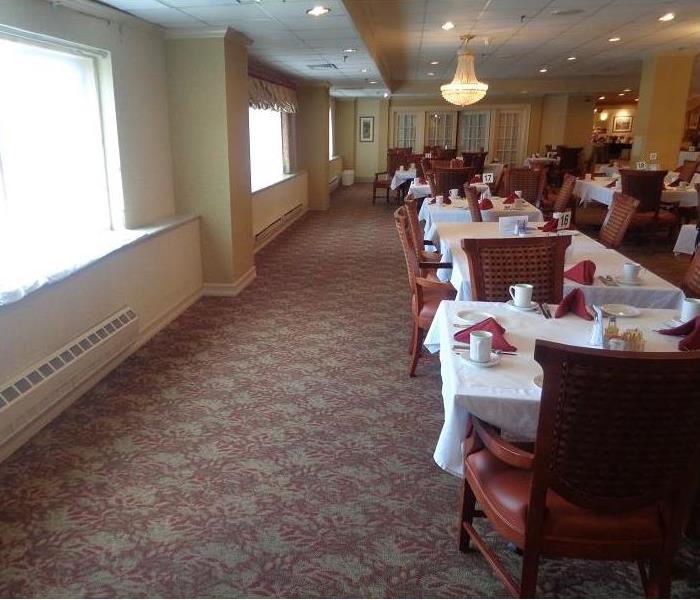 Common Areas - Dining Room, Assisted Living Facility
Common Areas - Dining Room, Assisted Living Facility
When spring rains come to Long Island, coastal flooding in low lying areas are expected, but often buildings under construction or renovation can be caught unawares and then run the risk of varying degrees of damage.
This assisted-living facility in Glen Cove, NY has been under renovation with extensive construction to the roof under way. The force and flow of the water for a recent storm proved to be too much for temporary measures to be able to deflect the water.
Rain entered the roof and flowed down into the common areas which stayed operational during the entire process. SERVPRO of Great Neck/Port Washington was able to dry out the building to the delight of the residents and staff, who were able to resume activities.
SERVPRO of Great Neck/Port Washington to conduct 3-Credit Insurance Mold
4/18/2017 (Permalink)
 CE Class Understanding Mold for Property Insurers
CE Class Understanding Mold for Property Insurers
SERVPRO of Great Neck/Port Washington is hosting a free 3-credit New York Continuing Education Course for Insurance Professionals with NYS Insurance Licences BR, PC & C3.
Mold is a big concern that directly affects the insurance community and involves third-party liability issues for property owners, builders, sellers, related service industries & institutions.
The course will be held in Syosset, at a lecture theater courtesy of our event partner, EisnerAmper - accountants & advisors.
SERVPRO of Great Neck/Port Washington's course comes with a light breakfast, available in the lobby between 8:15am-8:30am.
Preregistration is required - seats are limited. Please email barbara@SERVPROofgreatneck.com for the online registration link and details.
Happy Spring From SERVPRO of Great Neck/Port Washington! Don't let odors get you down
3/23/2017 (Permalink)
Spring has just arrived here on Long Island, NY and we at SERVPRO of Great Neck/Port Washington couldn't be happier!
Spring is all about new growth, clean new starts! So when LI clients call us about smells and odors, we are happy to help bring spring freshness back, no matter what the season or the reason!
Quick fixes and topical sprays only work on temporary odors - odors maybe from something that was just cooked or from a project or activity that you just did. They last a few minutes to a few hours.
Long lasting odors have settled in to stay at times because the conditions that caused the odor still exist and at times because the substance have settled deeply into the fibers and materials - leaving microscopic residue on surfaces and in hard-to-reach places. You may even have found that once you've cleaned a spot over and over, the odor keeps coming back despite all of your efforts.
SERVPRO of Great Neck/Port Washington knows that bad odors long term can be annoying, unpleasant and at times unhealthy. We are here to help!
Depending on the nature, source and type of the odor, we have techniques, products and equipment that our teams of trained professionals can implement to clean and destroy those odors for good! Odors may be from smoke/soot from fire, cigarettes/cigars, food smells, pet odors, garbage and hording, decomposing materials or animals, mold, spoiled food, raw sewage and more.
Remember SERVPRO of Great Neck/Port Washington - we will make it "Like it never even happened."
SERVPRO of Great Neck/Port Washington Runs Winter Series
3/17/2017 (Permalink)
 Heather Hamilton, Business Development
Heather Hamilton, Business Development
Our own Heather Hamilton of SERVPRO of Great Neck/Port Washington? ran the 2017 #LongIsland #WinterRunSeries - we are so proud!
#NaturalHeritageTrust NY State Parks & Historic Sites
WALK 97.5 K-98.3 103.1 MAX FM 94.3 The SHARK
1100 WHLI Runner's Edge New Living Magazine
#NewYorkStateParksRecreationandHistoricPreservation
#NYSParks #Run #Race #WinterSeries
SERVPRO of Great Neck/Port Washington Partners with LI's Habitat for Humanity
3/17/2017 (Permalink)
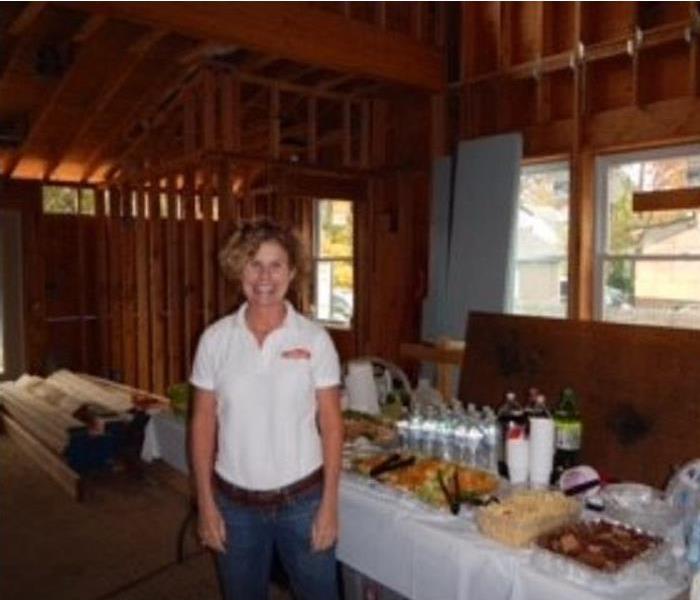 Heather Hamilton, Business Development
Heather Hamilton, Business Development
We were delighted to provide lunch recently to the hardworking volunteers at Habitat for Humanity - Nassau County! Brookies (Brownie-cookies), home cooked chili, a mountain of wraps and more to fortify them as they work on this home in Roosevelt, NY.
SERVPRO of Great Neck/Port Washington Feeds Habitat For Humanity Volunteers Again!
3/17/2017 (Permalink)
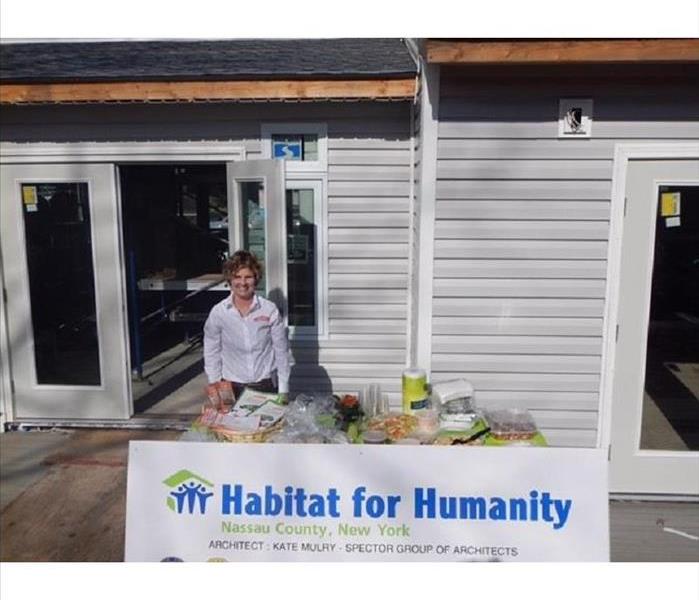 Heather Hamilton, Business Development
Heather Hamilton, Business Development
SERVPRO of Great Neck/Port Washington was delighted to be invited back provide a big lunch spread January 25th, 2017 to the hardworking volunteers at Habitat for Humanity - Nassau County!
The lunch was organized and orchestrated by SERVPRO's Heather Hamilton, who does the company's business development.
Brookies (brownie-cookies), home cooked soup, pasta salad, a mountain of mouth-watering wraps, fresh garden salad and more were the feast of the day for the hardworking group which includes recruiters from U.S. armed forces!
The home is located in Roosevelt, NY and is special: The house - unique to Habitat houses, is ALL GREEN - it is zero energy, and has solar power, so it will make as much energy as it uses and will reclaim all the water it uses to water the yard.
Thank you to Tom Baccarella- Director of Operations and Pavneet Kaur - Office Manager for Habitat of Humanity Nassau County, who we worked with on this event. SERVPRO of Great Neck/Port Washington is delighted to support Habitat for Humanity in their continued efforts to put people in homes.
Visit their Facebook page: https://www.facebook.com/HabitatNassau/ Habitat for Humanity - Nassau County and website http://www.habitatnassau.org/
#HabitatForHumanity #RooseveltNY #SERVPRO #Volunteer#NassauCounty #HabitatForHumanityNassauCounty #allgreen#zeroenergy #solarpower #solar #green #usbgc #construction
Hospital Fire - Statistical Information
2/16/2017 (Permalink)
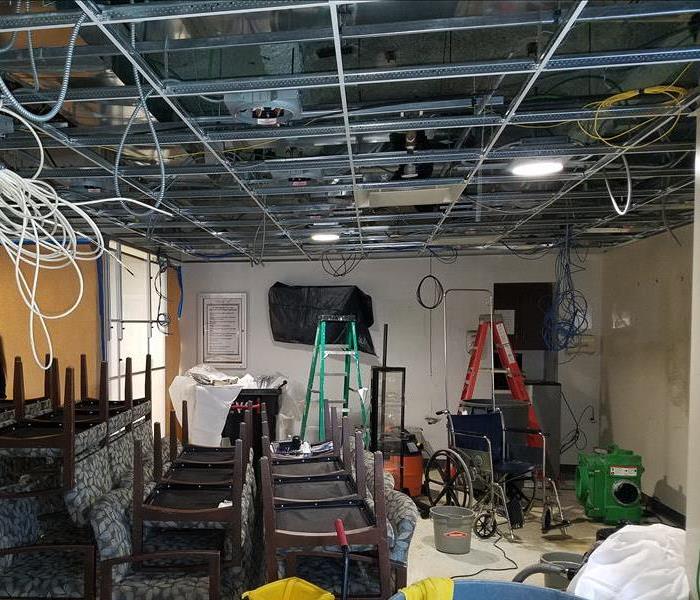 Hospital Electrical Fire
Hospital Electrical Fire
The NFPA (National Fire Protection Association), the leading resource on fire, electrical and related hazards reported recently that while structure fires in health care facilities has followed a steady downward trend over the past decade, cooking was the leading cause in 65% of all fire property damage (specifically in health care facilities), followed by electrical distribution and lighting equipment - causing 34% of health care fire property damage. To a far lesser extent, other causes include intentionally set fires (16%), heating equipment (5%), smoking materials (5%) and clothing dryers (4%).
U.S. fire departments respond to more than 5,600 health care structure fires each year.
Mold is a Hidden Hazard
2/16/2017 (Permalink)
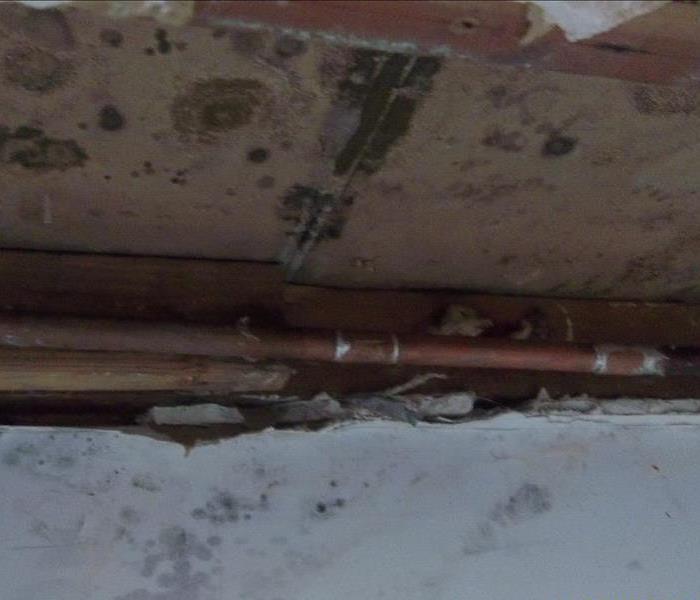 mold - Great Neck, NY
mold - Great Neck, NY
Mold grows as a result of humidity, presence of mold spores (that occur and exist naturally) and a food source of organic material.
In this home, mold was present in dark and hard to see areas but the effects were noticeable for the homeowners. They called SERVPRO of Great Neck/Port Washington to come and do mold remediation and we were able to successfully remove all the contaminated and affected materials, and bring the readings down to normal levels through our SERVPRO protocols that involve cleaning not only the materials and structure but filtering the air as well, removing both mold and moisture.
When the remediation is done, independent environmental testing will show that the remediation was successful.
If you suspect you have mold, give us a call at 516-767-9600.
Children's Facility Suffers Water Damage
2/16/2017 (Permalink)
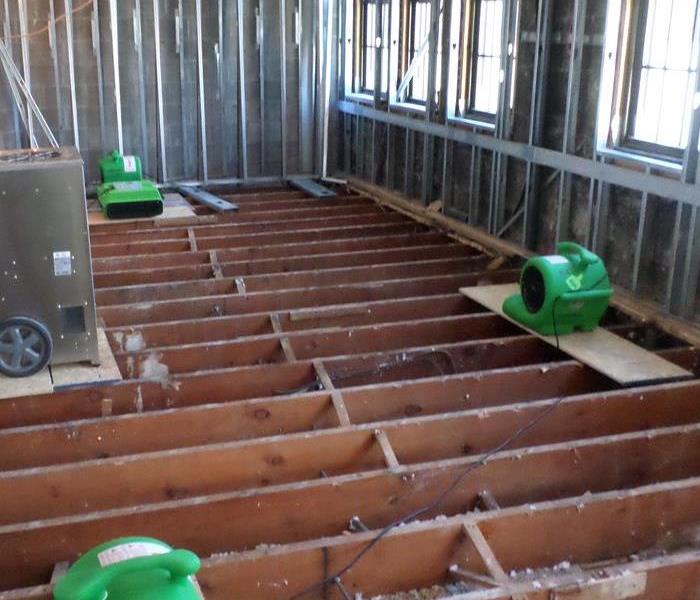 3rd floor water situation
3rd floor water situation
This facility had suffered water damage on multiple floors from a roof that leaked through a storm. SERVPRO of Great Neck/Port Washington was called in to mitigate the water and restore the building.
Water was saturating carpeting, plywood sub-floors, drywall, and some mechanical systems in areas that the children are present and areas they are not.
We came in, extracted the water, cut out and removed the drywall that was affected, removed moisture from the air and filtered the air, with the goal of drying out the space so that they could resume the childcare services.
In situations where water enters from above like this, multiple floors can be affected as water runs down through walls and openings. It is always wise to have a licensed electrical contractor come in to make sure that the electrical systems are not damaged or compromised.
We are here for any water, fire, mold, sewage situation! Call us at 516-767-9600 for cleanup & restoration.
Water Damage to Former Supermarket
2/16/2017 (Permalink)
 flooded supermarket site
flooded supermarket site
This empty supermarket was unfortunately flooded, with water throughout the building. SERVPRO of Great Neck/Port Washington was called in to do cleanup and restoration.
Had this been a operational store with food as well as the existing fixtures, things would have been far more catastrophic, as much of the food would likely be not safe to eat.
We extracted all of the water, and began to dry out the building. Always have a licensed electrical contractor sign off on your electrical systems after water comes in contact.
We successfully completed the job, as we have with countless other Supermarkets on Long Island. If you are a facility or store manager, keep our number on your speed dial - we are here for you 24/7 to help make your water/fire/mold/sewage problem like it never even happened!
Storm Damaged Home Gyms - Can You Use the Equipment?
1/27/2017 (Permalink)
 home gym gets flooded
home gym gets flooded
When Hurricane Irene hit Long Island, this home gym suffered when water poured through a hole in the roof, filling this lower level fitness room.
SERVPRO of Great Neck/Port Washington removed wallboard and carpet, drying out the space. But when this happens to you, what is safe to reuse and what is not?
If equipment has no electrical components and is not porous or rusted, it very likely is salvageable - like rubber coated dumbells, kettleballs, bands and machinery that operate by cables and weights. If equipment has electrical components that have touched or been exposed to water or excessive moisture, it may still operate. However, that does not mean it is safe to use as degraded electrical components can cause a fire or shock later on down the road. They need to be inspected by a licensed electrician or replaced.
Make sure when discarding anything that is electrically damaged that you cut off the cord short to the unit so that it doesn't get repurposed by someone on garbage pickup day.
Storm Damage from Hurricane Irene Causes Secondary Damage
1/27/2017 (Permalink)
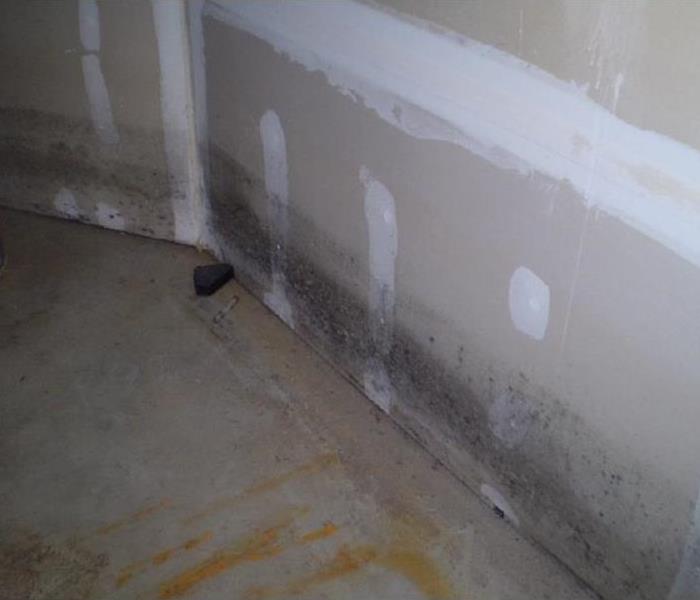 Hurricane Irene Damage
Hurricane Irene Damage
This home was hit by Hurricane Irene and experienced significant water intrusion and flooding. In the high humidity, the moisture was slow to dissipate and mold began to grow.
When the homeowners realized the problem was getting worse, they called us! We came in to do cleanup and restoration, drying out the home and removing all of the affected building materials. When water enters a structure, the quicker it is dried out the less mold or chance of mold you will have. We are equipped with industrial quality equipment to get you back to "like it never happened" fast!
SERVPRO teams can be onsite within hours, ready to extract and pump out water and set up air movers and equipment to dry out open and enclosed areas, with the goal of reducing your moisture levels quickly to levels that do not support mold. SERVPRO of Great Neck/Port Washington is here for you, 24/7. Call: 516-767-9600
Hurricane Damage Destroy Interiors Too
1/27/2017 (Permalink)
This home suffered extensive hurricane damage to interior walls, ceilings and floors that experienced water intrusion, and subsequently mold.
When water is held within wall spaces or even in drywall or carpet and the moisture in the air has a high humidity level the drying will be slow if at all. When the air is filled, there is nowhere for retained water to go.
The wall you see was very wet and could not dry - the drywall and wall coverings needed to be removed and the interior stud space needed to be dried out before it was restored.
When a home or commercial building need help, look no further than your local SERVPRO of Great Neck/Port Washington. We are here for you, 24 hours a day, 7 days a week. Call 516-767-9600
Is There Mold Lurking Behind Your Filing Cabinets?
1/27/2017 (Permalink)
 Mold lurking behind filing cabinets.
Mold lurking behind filing cabinets.
We get mold calls on a daily basis - Long Island is a humid environment, from the eastern most tip of Suffolk County to the west- Nassau County, Brooklyn, Queens and Staten Island. When your building gets damp and the conditions and humidity are right you can have mold growth.
Mold can permanently damage documents and books, clothing, furnishings, and personal effects - and can cause health effects for humans and animals. Left unabated, it will continue to spread and destroy things. Bleach and other remedies may remove discoloration but do not kill the live mold - what you thought you removed will return.
At SERVPRO of Great Neck/Port Washington, we have been trained and certified by the IICRC in Mold. We follow protocol in mold remediation and use anti-microbial agents that will destroy the mold. Call us at 516-767-9600
Do you have the leaky office blues?
1/20/2017 (Permalink)
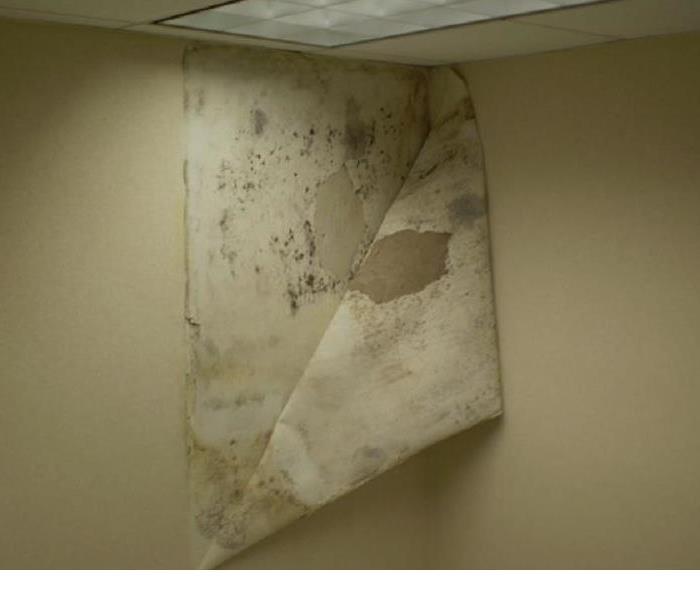 Wet walls from leak above causes mold
Wet walls from leak above causes mold
When commercial buildings have leaky roofs, ceilings and pipes that flow down inside walls such as our client here unfortunately had happen, there is little hope the water will dry out on it's own.
Here on Long Island, New York there is relatively high humidity - when moisture levels in the air are very saturated, there is little chance that things will dry out on their own without intervention.
In this case, the wall covering glued backing has provided a food source for mold growth - with the addition of the water, it has become an active situation. This is a problem that is only going to get larger and costlier if left alone. You can see the moisture and mold have caused the glue to let go and the wall coverings are peeling away from the wall.
Make it a point to walk your building with every season change to inspect the roof, exterior walls, and the interior to keep a visual on any possible future water sources. Vigilance is valuable.
It's hard to find a tenant for a molding space!
1/20/2017 (Permalink)
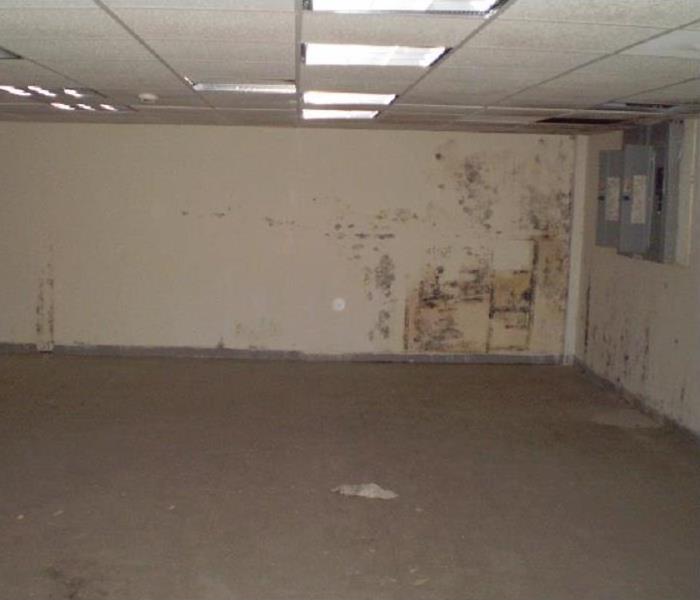 moldy commercial space
moldy commercial space
When you own or manage commercial properties like this one here on Long Island, NY from time to time you may encounter a mold issue. When a unit is vacant, it is unwise and unprofitable to let the situation remain.
A moldy building is not appealing to prospective tenants and will send them running. Receiving clients in an office space with the telltale musty odor is bad for business and bad for health.
Employees health is at risk when the indoor air quality is poor - particularly when it has progressed to this stage, as shown in the photo.
For retailers, stocking merchandise in a moldy building is a risky venture as mold can damage the items or packaging rendering them unsaleable.
Have mold in your building? Call SERVPRO of Great Neck/Port Washington for service.
Note that if you have over 10 square feet of mold, NYS mandates you have an independent environmental hygienist to inspect the property, test for mold and provide a report before your remediation can begin. They will also retest at the end of your remediation to ensure that levels have been reduced to normal. We follow their recommendations in their report.
Water Damage in Hospitals, Medical and Healthcare Facilities
1/19/2017 (Permalink)
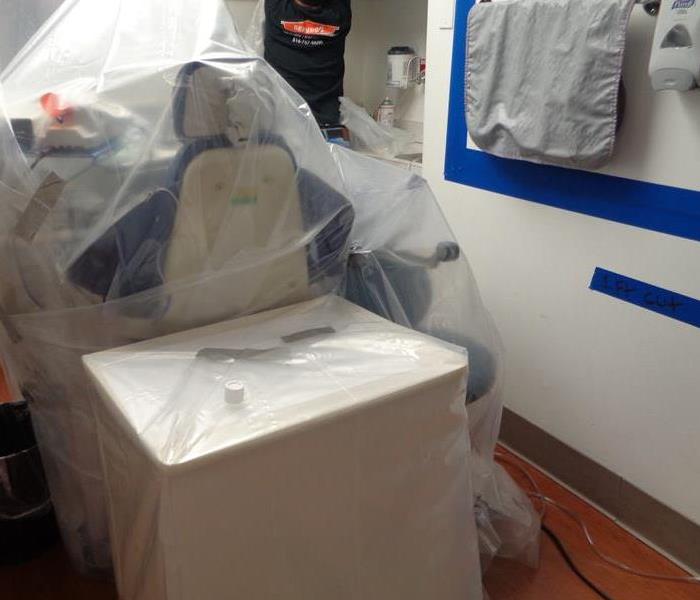 Water Damage in Hospitals, Medical and Healthcare Facilities
Water Damage in Hospitals, Medical and Healthcare Facilities
Water events at Long Island and NYC facilities are of great concern when you have tens and hundreds of thousands of dollars worth of sensitive medical equipment and critical documents. Unfortunately, we've seen a lot get damaged in Nassau County, Suffolk County, Brooklyn, Queens and New York City that was avoidable.
This healthcare facility had extensive water damage and unfortunately many pieces of electronic diagnostic and treatment tools as well as computers were in the line of fire.
These are the best ways to proactively protect your equipment from water damage:
- Make sure you know where overhead pipes are located if you have drop ceilings this is helpful - and if possible, keep equipment on the opposite side of the room
- If units in your building are vacant and freezing temperatures are coming , DO make sure the building's facility management has the heat turned on in those units - a pipe break from a freeze at the other end of the building can affect your unit if their pipes cross through your unit. If you are on a slab, this happens.
- If equipment has no choice but to be located underneath pipes, use water catch systems that are designed to hide up in the drop ceiling and divert water away
- Emergency water diversion systems can also be installed outside of the ceiling - helpful when you don't have a drop ceiling but do have a leak - though they are visible. These are not ideal for permanent placement and are not pretty, but they help keep your equipment and documents dry when you can't move everything and water is flowing where you don't want it. These are used frequently in warehouses with known leaks.
Can my belongings survive a water damage?
1/19/2017 (Permalink)
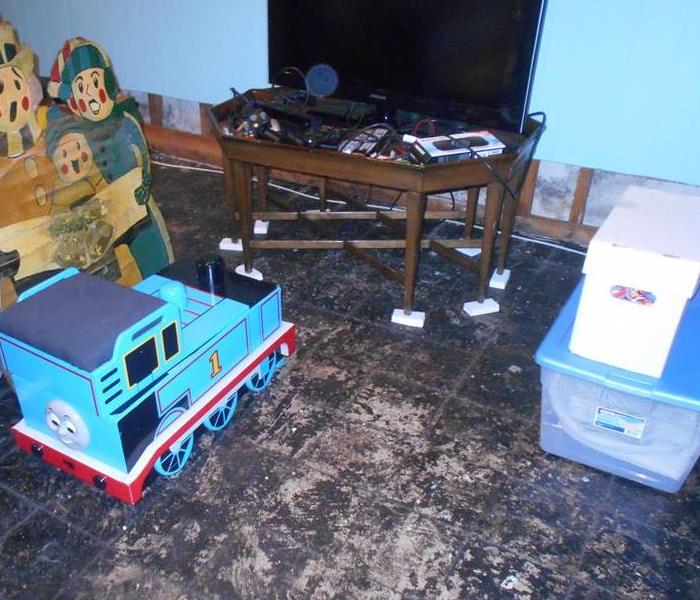 Water damage
Water damage
House floods on Long Island can happen from natural environmental or weather conditions or mechanical failure - but either way, your stuff ends up soaked. What happens next?
At SERVPRO of Great Neck/Port Washington, we know you have irreplaceable mementos and family pieces as well as furnishings, photos and important documents that you need to keep and maintain. If you haven't protected them by storing in watertight plastic containers, we will do our best to salvage and restore your contents.
With a lot of clear and grey water damage a lot of your contents might be salvageable.
If bio hazard contamination is in play - be it from medical waste issues, crime scenes, infectious disease or raw sewage exposure it is generally necessary for us to rapidly discard those items for your safety - especially if they are paper, fabric or of other porous material that cannot be adequately cleaned and sterilized.
Small numbers of documents that are needed but damaged are best captured by photo then discarded. we do have the ability to dry large amounts of clear and grey water damaged documents, books and photos in huge drying chambers through our corporate facility. They will appear water damaged, no longer perfect - but will be dry.
Habitat for Humanity
12/2/2016 (Permalink)
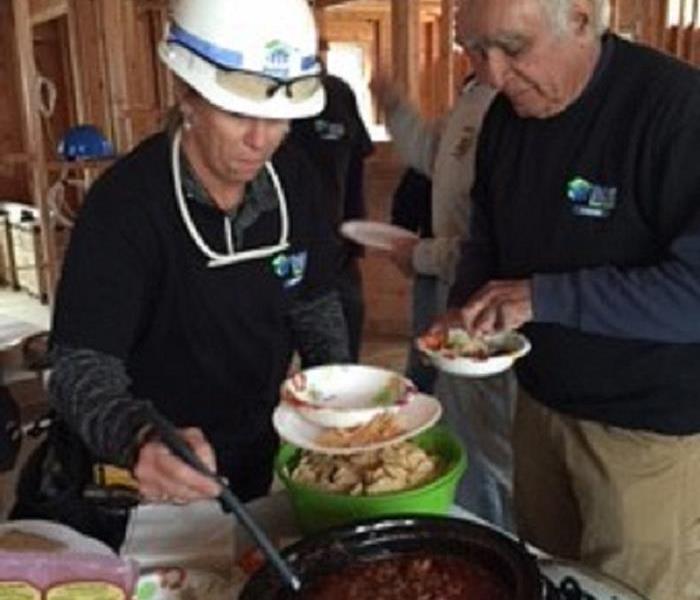 Lunch for Habitat Volunteers
Lunch for Habitat Volunteers
SERVPRO of Great Neck/Port Washington was delighted to provide a big lunch spread in November to the hardworking volunteers at Habitat for Humanity - Nassau County! Organized and orchestrated by SERVPRO's Heather Hamilton, brookies (brownie-cookies), home cooked chili, a mountain of mouth watering wraps and more were on hand to nourish and fortify these fine men and women as they work on this home in Roosevelt, NY.
We are happy to support Habitat for Humanity in their continuing efforts. They always need volunteers and lunch donation from companies, just like we did! You can learn more about the projects and needs on the Nassau County, Long Island, New York chapter's local website, http://www.habitatnassau.org/. Contact them today to see how you or your company can get involved.
SERVPRO of Great Neck/Port Washington Cleans Up Water
11/15/2016 (Permalink)
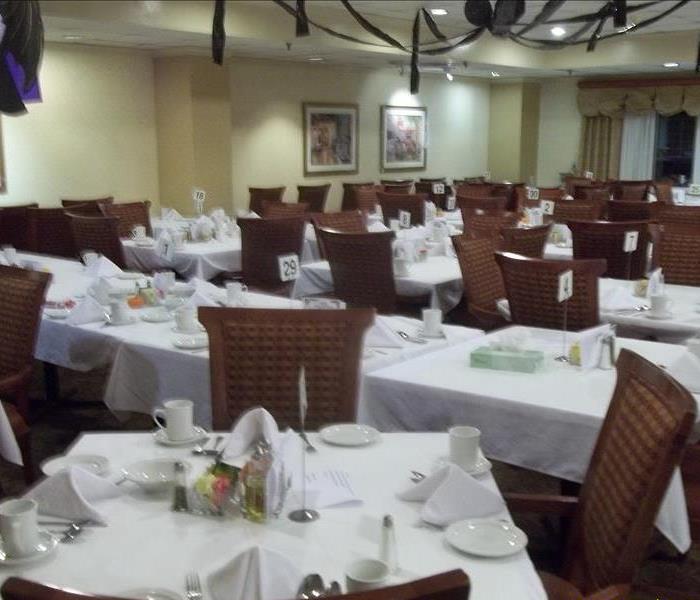 The Assisted Living facility's dining room is back up and running.
The Assisted Living facility's dining room is back up and running.
SERVPRO of Great Neck/Port Washington gets calls 24/7 - and we respond quickly. One such call was an Assisted Living Facility that had been undergoing extensive roof reconstruction. The weekend was approaching and the out of state contractor needed to keep the dining room dry as untimely rainstorms had caused a small puddling. Fortunately he had secured our company at the first sign of trouble. When consecutive storms created a dramatically bigger problem in a very short while later flooding the dining room and creating damage to the ceiling and walls, we were able to get there and manage the problem, drying out the room so that the residents could use the room and the contractor was able to finish off the roof construction so that no further water entered the structure.
SERVPRO of Great Neck/Port Washington Runs For the USMC & Warriors
11/15/2016 (Permalink)
 Dog Tags Swing in the Breeze at the 4 Mile Run
Dog Tags Swing in the Breeze at the 4 Mile Run
SERVPRO of Great Neck/Port Washington Business Development Manager recently ran the 4-mile Wounded Warrior event on Long Island, New York. Veteran's events are one of our favorites to participate in, as so many in our office have loved ones who are and were in the military protecting our country. The Joseph J. Boccia Run is organized by the USMC (United States Marine Corp) and is one in a series of runs designed to call attention to the plight of our Veterans and to raise funds to have a positive impact on their lives.
We look forward to more way that our office can volunteer and participate in causes that help our nation's Veteran population. It is very gratifying to give back to those that have protected our country.
SERVPRO of Great Neck/Port Washington Runs 10K for Warriors
11/15/2016 (Permalink)
 SERVPRO of Great Neck Supports the Cow Harbor Warrior Organization
SERVPRO of Great Neck Supports the Cow Harbor Warrior Organization
SERVPRO of Great Neck/Port Washington's Heather Hamilton ran for the Warriors recently, at the famous Cow Harbor 10K run starting in Northport, NY. We participate in many many Veterans causes as our way of giving back to the community. Heather herself is a highly accomplished runner and athlete so it was a natural fit. With parents who were both Veterans, the cause is close to Heather's heart as well. Raising awareness to the many needs of Long Island's Veterans is necessary to get the aid and legislation needed to properly care for them as the age. The Cow Harbor Warrior organization has donated over $235,000 to veteran organizations since it was launched in 2012. The organization says that "they focus to advance the wellbeing of injured veterans or veterans in need including: The Wounded Warriors Project, the Semper Fi Fund, Disabled American Veterans Transportation Network (DAV TN), Paws of War, the Northport VA Medical Center and others."
SERVPRO of Great Neck/Port Washington contributes to Pancreatic Cancer Research Walk
11/15/2016 (Permalink)
 Logo of the Lustgarten Foundation, organizer of the Pancreatic Cancer Research Walk
Logo of the Lustgarten Foundation, organizer of the Pancreatic Cancer Research Walk
SERVPRO of Great Neck/Port Washington raised $400 for the 2016 Long Island Pancreatic Cancer Research Walk in honor of a recently passed dear friend of one of our SERVPRO team members. Pancreatic cancer spreads silently and frighteningly swift - merely a few weeks after diagnosis, he was gone. We were set to walk in the event and had created a team, but the park cancelled it that morning due to high dangerous winds. We must find a cure so we were happy to be able to raise funds even if we were unable to walk this year. Our office does a lot of walks, runs, and Veterans cause based outreach - we touch our surrounding community with causes dear to our hearts and heavy on our minds.
SERVPRO of Great Neck/Port Washington helps Habitat for Humanity of Nassau County (LI, NY)
11/15/2016 (Permalink)
SERVPRO of Great Neck/Port Washington (Long Island, NY) was delighted to provide lunch Wednesday November 9th to the hardworking volunteers at Habitat for Humanity - Nassau County! Brookies (Brownie-cookies), home cooked chili, a mountain of wraps and more was brought to tables overflowing with delicious food to fortify and nourish them as they work hard on this home in Roosevelt, NY that will soon go to a deserving family. Habitat for Humanity is a wonderful volunteer group of people both in the construction field and those with no construction experience - who come together for the good of the community to provide wonderful homes to deserving families, Veterans and so forth. Our Business Development Manager, Heather Hamilton was on hand to set up and spend time with the hardworking volunteers!
Hoarding Clean Outs Give A Fresh Start
8/26/2016 (Permalink)
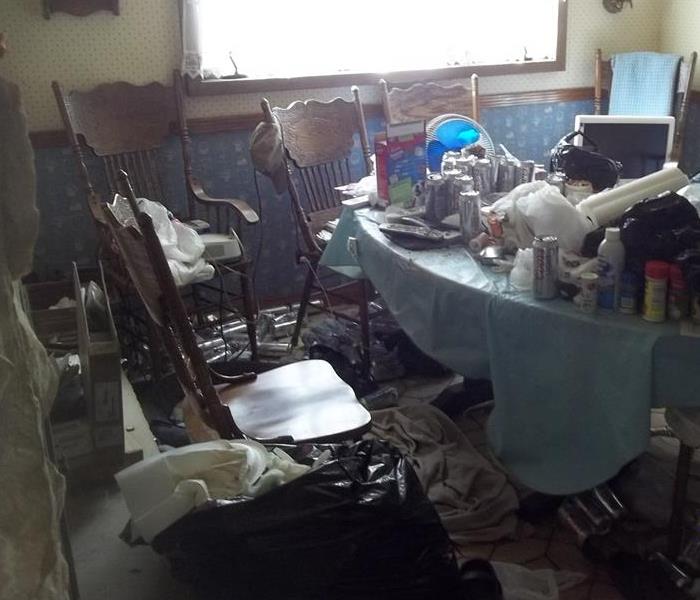 Clutter can lead to hoarding.
Clutter can lead to hoarding.
You'd probably be very surprised at the number of jobs we get for cleaning out homes where an occupant has developed a hoarding disorder, through various events.
Often, the occupant has been a victim of stressors in their life. The stress manifestation in these cases we have seen have come from PTSD, Post Traumatic Stress Disorder from military service; anxiety issues; and depression from a loss of some kind - of a job, a death, a divorce; and other times from mental illness.
SERVPRO of Great Neck/Port Washington has seen many of these cases. We get the calls generally when the hoarding is discovered and the occupant is in immediate peril of losing their home - either being condemned or losing their lease, or some other imminent peril - like another household member is critically ill and needs to come home to a clean and safe environment.
People who hoard are terribly embarrassed by their situation and are often apologetic on the initial call. They have found it has become more than just they can manage. At the same time, they are anxious that a team will be in their space, cleaning and moving their "stuff". Hoarding is a health hazard, particularly if it involves pets, has attracted rodents and insects, involves hypodermic syringes, or involves animal or human waste. People do live in these terrible conditions - often with other family members and children. These conditions need to be corrected in order to have a healthy household.
At SERVPRO of Great Neck/Port Washington, we remove trash, move items to storage facilities or discard, clean and sanitize. The result is not just a clean space - it usually has a dramatic uplifting effect on these clients. We get multiple calls after these jobs in particular are completed - from overjoyed people who feel freed of their chains in a way and are marveling at how different and clean their home now is. Many say that they plan to maintain their spaces, and with their raised spirits, we hope that they do. We are happy to have helped by giving them a fresh start.
If you or someone you know is ready for a clean out, in the Long Island, NYC area, SERVPRO of Great Neck/Port Washington is here to help. Call us at 516-767-9600
It's The Water That You Don't See That Is The Danger
8/26/2016 (Permalink)
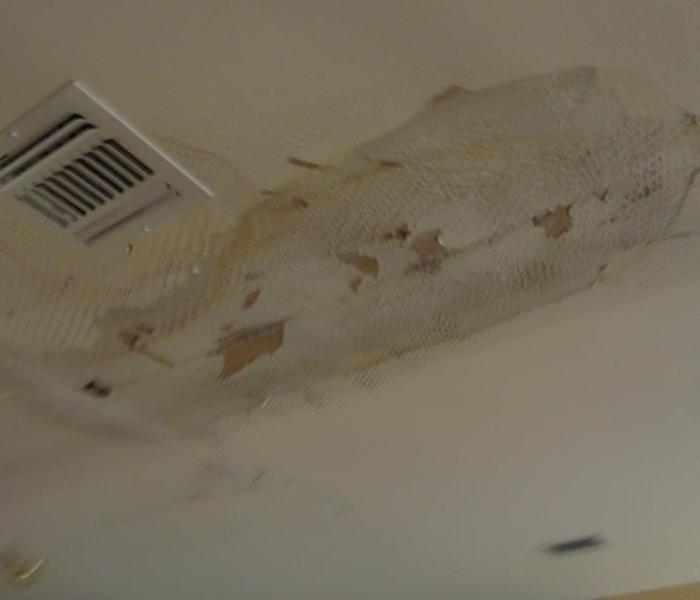 Long Island, NY water damage - ceiling leaks can cause tremendous damage if ignored.
Long Island, NY water damage - ceiling leaks can cause tremendous damage if ignored.
The key to avoiding a costly restoration is to eliminate water issues before they become a threat. Time and timeliness matters. A simple fix that goes unattended may progress to an out of control problem that could result in tens of thousands of dollars of losses to your home or business or even create hazards.
SERVPRO of Great Neck/Port Washington professionals have the training, experience and equipment to mitigate any water situation. If water issues go on for too long particularly inside of walls, secondary damages can become problem if mold has begun to grow.
Take care of small leaks as soon as detected.
Call our SERVPRO team to rapidly dry & disinfect your structure.
Warped wet wood floors? We have a remedy for that!
Mold is a health hazard - SERVPRO teams are highly trained in re
Residual odors? We have various ways of removing odors created by a variety of sources.
Allow SERVPRO of Great Neck/Port Washington to help with your water situation.
Join TEAM SERVPRO of Great Neck/Port Washington for the “Out of the Darkness” Suicide Prevention Walk 10/23/16
8/25/2016 (Permalink)
 Out of The Darkness logo
Out of The Darkness logo
SERVPRO of Great Neck/Port Washington joins the community of nearly 250k people walking in hundreds of cities across the country, in support of the American Foundation for Suicide Prevention's (AFSP) mission to save lives and bring hope to those affected by suicide.
The Long Island "Out of the Darkness" Suicide Prevention Walk takes place in Wantagh, NY on Sunday, Oct. 23rd. Team SERVPRO of Great Neck/Port Washington has been formed, under team Captain, Heather Hamilton. The company invites the community to join the team and participate. Non-walkers can support the SERVPRO of Great Neck/Port Washington team with donations.
Team Captain, Heather Hamilton is also the Business Development Manager for SERVPRO of Great Neck/Port Washington. As an avid volunteer, she has worked with Mental Health Associations all over the country in an effort to raise awareness of the pro-activeness that is needed in order to save and rehabilitate lives. Many who join the team have friends or family that have been touched by suicide, and they walk in support and to raise awareness.
All donations are 100% tax deductible and will help bring AFSP one step closer to achieving their bold goal to reduce the suicide rate 20% by 2025. To register for the team or donate visit them on the AFSP website: http://tinyurl.com/TEAM-SERVPRO-GREAT-NECK To donate, choose any member of the team listed - all the participants’ donations raised goes toward our team goal.
SERVPRO of Great Neck/Port Washington is a national emergency restoration company specializing in Water, Fire and Mold for Commercial and Residential clients and cleaning for Sewage Backups, Smoke & Soot, Biohazard/Crime Scene, Post-Construction and Hoarding. SERVPRO’s excellent reputation makes them the most recommended emergency restoration company by the insurance industry for their services, on over 600 insurance carrier preferred lists. SERVPRO offers 24/7 emergency service, call 516-767-9600.
When Storms or Floods hit Long Island, SERVPRO is ready!
5/20/2016 (Permalink)
SERVPRO of Great Neck/Port Washington specializes in storm and flood damage restoration. Our crews are highly trained and we use specialized equipment to restore your property to its pre-storm condition.
Faster Response
Since we are locally owned and operated, we are able to respond quicker with the right resources, which is extremely important. A fast response lessens the damage, limits further damage, and reduces the restoration cost.
Resources to Handle Floods and Storms
When storms hit Long Island, New York, we can scale our resources to handle a large storm or flooding disaster. We can access equipment and personnel from a network of 1,650 Franchises across the country and elite Disaster Recovery Teams (View our Storm Response info) that are strategically located throughout the United States.
Have Storm or Flood Damage? Call Us Today 516-767-9600
Does Your Long Island Home or Business Have A Mold Problem?
5/20/2016 (Permalink)
 On Long Island, New York, mold can spread through a building in as little as 48 hours.
On Long Island, New York, mold can spread through a building in as little as 48 hours.
Microscopic mold spores naturally occur almost everywhere, both outdoors and indoors. This makes it impossible to remove all mold from a home or business. Therefore, mold remediation reduces the mold spore count back to its natural or baseline level. Some restoration businesses advertise “mold removal” and even guarantee to remove all mold, which is a fallacy. Consider the following mold facts:
- Mold is present almost everywhere, indoors and outdoors.
- Mold spores are microscopic and float along in the air and may enter your home through windows, doors, or AC/heating systems or even hitch a ride indoors on your clothing or a pet.
- Mold spores thrive on moisture. Mold spores can quickly grow into colonies when exposed to water. These colonies may produce allergens and irritants.
- Before mold remediation can begin, any sources of water or moisture must be addressed. Otherwise, the mold may return.
- Mold often produces a strong, musty odor and can lead you to possible mold problem areas.
- Even higher-than-normal indoor humidity can support mold growth. Keep indoor humidity below 45 percent.
If your home or business has a mold problem, SERVPRO of Great Neck/Port Washington can inspect and assess your property and use our specialized training, equipment, and expertise to remediate your mold infestation.
If You See Signs of Mold, Call Us Today – 516-767-9600
April Showers Bring....Floods and Sewage BackUps
4/12/2016 (Permalink)
Early spring rainfall has the potential to become a flooding risk factor. Once ground waters rise to the point that the soil becomes fully saturated, it leaves nowhere for excess water to go.
This can occur anywhere, including low to moderate flood risk areas - as saturated soil can cause catastrophic situations with septic systems.
SERVPRO of Great Neck/Port Washington understands the stress and worry that comes with a fire or water damage and the disruption it causes your life and home or business. Our goal is to help minimize the interruption to your life and quickly make it "Like it never even happened" by restoring your property back to pre-loss condition, ready for your contractor to refinish if demolition was a part of your service. SERVPRO is on over 400 insurers referral lists - we are a name you can trust.
SERVPRO of Great Neck/Port Washington specializes in the cleanup and restoration of residential and commercial property after a fire, smoke or water damage. SERVPRO of Great Neck/Port Washington can also mitigate mold and mildew from your home or business, remove odors, and dry out documents and books that have been water damaged.
Our staff is highly trained in property damage restoration. From initial and ongoing training at SERVPRO’s corporate training facility to regular IICRC-industry certification, rest assured our staff is equipped with the knowledge to restore your property. With a nationwide system of qualified franchises, no damage is too large or too small for SERVPRO of Great Neck/Port Washington.
If you would like to schedule service for your home or business, please call today 516-767-9600!
Have an Emergency? Don't delay - waiting can make your loss larger. For priority service, call us 24/7 at 516-767-9600.
Serving you since 1967, SERVPRO is the cleaning and restoration brand you know and trust.
Call SERVPRO of Great Neck/Port Washington for Mold Remediation
3/10/2016 (Permalink)
 When you have water damage, don't wait - call 516-767-9600 before mold sets in and creates a bigger problem!
When you have water damage, don't wait - call 516-767-9600 before mold sets in and creates a bigger problem!
Don't let mold take over your home or building! We are here to help.
<b>SERVPRO of Great Neck/Port Washington<b> understands the stress and worry that comes with a fire or water damage and the disruption it causes your life and home or business. Our goal is to help minimize the interruption to your life and quickly make it "Like it never even happened" by restoring your property back to pre-loss condition, ready for your contractor to refinish if demolition was a part of your service. SERVPRO is on over 400 insurers referral lists - we are a name you can trust.
<b>SERVPRO of Great Neck/Port Washington<b> specializes in the cleanup and restoration of residential and commercial property after a fire, smoke or water damage. <b>SERVPRO of Great Neck/Port Washington<b> can also mitigate mold and mildew from your home or business, remove odors, and dry out documents and books that have been water damaged.
Our staff is highly trained in property damage restoration. From initial and ongoing training at SERVPRO’s corporate training facility to regular IICRC-industry certification, rest assured our staff is equipped with the knowledge to restore your property. With a nationwide system of qualified franchises, no damage is too large or too small for <b>SERVPRO of Great Neck/Port Washington<b>.
If you would like to schedule service for your home or business, please call today 516-767-9600!
<b>Have an Emergency? <b> Don't delay - waiting can make your loss larger. For priority service, call us 24/7 at 516-767-9600.
Serving you since 1967, SERVPRO is the cleaning and restoration brand you know and trust.
FREE Continuing Education Class - Nov. 18th, 2015
9/22/2015 (Permalink)
REGISTER: Call 516-767-9600 SERVPRO of Great Neck/Port Washington to reserve a space - seating is limited.
WHAT: "WATER DAMAGE: RISK, DIAGNOSIS & MITIGATION"
This is a FREE Continuing Education/CE Class (credits for licenses listed below). Includes a free breakfast!
COST: FREE - courtesy of SERVPRO of Great Neck/Port Washington
WHEN: Wednesday, November 18th, 2015 from 9:00am-12:00pm
WHERE: EisnerAmper; 6900 Jericho Turnpike; Syosset, NY 11791 (Theatre Level) - Space hosted by EisnerAmper.
WHO: Anyone may attend but CE credits are for Insurance Professionals, Real Estate Professionals, & Home Inspectors (see details below). We welcome Property Managers, Facility Managers, Architects, Building Owners, & more.
Water intrusion makes up 90% of insurance claims and is the root of all mold. This class will focus on HIDDEN WATER. It’s what your eyes don’t see that causes the most trouble.
This class is for Insurance Professionals, Real Estate Professionals, Home Inspectors, Property Managers, Facility Managers, Architects, Building Owners, & more (continuing education credits apply to only to the fields listed below - but anyone may attend.)
New York State Continuing Education/CE Credit Class (Free): Presented by: Robkat, Inc. - Provider # NYPO-100256 Sponsored by: SERVPRO® of Great Neck/Port Washington
• REAL ESTATE Course Approval: M9104 (3 credit hrs)
• INSURANCE Course Approval: #NYCR-236338 (3 credit hrs)*
Note: Insurance Licensees eligible for credit*: BR, PC, C3, PA
• HOME INSPECTOR Course Approval: L-0102 (2 credit hours)
This Class Will Cover:
• Causes, effects, and costs of excessive moisture on structures, contents, and health
• Action steps & emergency tips that property owners/mangers can take to keep damage and costs to a minimum
• How fast action in handling water loss claims will save money and property
• Unwanted consequences of water damage during the real estate sales process
• Potential real estate agent liabilities associated with microbial growth (mold) and excessive moisture
• How contaminated water and claims including sewer backflows are handled
• Procedures professional mitigation companies utilize to detect, mitigate, and document water losses
• State-of-the-art equipment used in mitigating water damage and restorative techniques for documents, electronics, & art
• How water damage mitigation is documented to reduce future liability and meet disclosure requirements
• The significance of water damage for property-casualty insurers & what clients experience
• Excessive moisture detection methods and instrumentation
• Moisture tolerances of wood, drywall, and other hydroscopic materials
• Industry and insurance accepted mitigation and documentation
• How Disaster Planning & Emergency Response Plans (ERP’s) can mitigate water damage, cost, and disruption
Hurricane Danny 2015
8/20/2015 (Permalink)
Hurricane Danny formed a few days ago as a Tropical Storm and has progressed to Hurricane status while offshore. Danny is the first official hurricane for the Atlantic region for 2015 - so we are watching it's trajectory closely to see if it will make landfall and if it will travel up to Long Island, NY.
We recommend getting the free Hurricane Tracker app by the American Red Cross from you mobile device's app store. Get updates and be informed of current hurricane info in real time.
#HurricaneDanny #2015 #LongIsland #NY #NewYork
Our Top 30 Hurricane Preparedness Tips For Facilities & Properties
7/14/2015 (Permalink)
#1 Check and secure items on roofs (antennas, fans, turbines, covers, HVAC units), yards, and in open vehicles to prevent items from going airborne or suffering flood damage.
#2 Have clean up/board up materials and PPE Personal Protective Equipment on hand - including protective eyewear, gloves, respirators, dust masks, hammer, nails, drill, screws, plywood, furring items that can become strips, ladder, heavy duty plastic sheeting (4mm or thicker), brooms, mops, pails, trash bags - note that we offer 24/7 board up/clean up service if needed
#3 Distribute an emergency contact list for all staff or tenants and let everyone know in advance how communication will occur
#4 Develop emergency staff assignments to predetermine chain of command - who will perform what, where, and how
#5 Minimize flood losses - relocate critical systems above flood levels and move at risk items - interior equipment, furnishings, or documents to higher or safer locations - as much as 90% of property damage caused by all natural disasters is a result of flooding
#6 Make sure any flood prone areas are clear of electrical hazards that could energize water and injure someone
#7 Ensure all emergency lighting is operational
#8 Brace and secure any roll up doors
#9 Have emergency contact numbers for your local police, fire, rescue, area hospitals, and your insurance agents
#10 Do a risk assessment - identify potential threats to your building due to your location and environment - periodically walk and photograph your facility and vital contents for your insurance adjustor, backing up off-site
#11 Have mobile devices charged at all times and have a power plan for extended outages
#12 The FCC recommends limiting non-emergency calls that congest and overwhelm networks during crisis - text instead
#13 Make sure interior building emergency exit paths are clear and doors are not blocked, locked, or chained
#14 Review your company's Disaster Management Plan, they are often required by OSHA for employees (who has a free eTool) - and contact us to do a free Emergency Ready Profile for your building
#15 Shut off non-essential electrical equipment and protect vital digital data, equipment, and software programs with UPS - Uninterruptible Power Supply
#16 Trim all trees and bushes to make them more wind resistant
#17 Have generators maintained regularly, and keep adequate fresh fuel on hand
#18 Make sure all or key members of staff know how and where to turn off the main power, switch boxes, water, gas, and equipment in emergencies (this info is detailed in our ERP)
#19 Notify your key suppliers, vendors, shippers, customers, and contractors if there is a disruption in your area or an alternate plan, and even if you were not affected - as they may be concerned if the event is in the media
#20 If you have critical vendors that you use, see if they have a disaster plan and contingencies should they experience a disruption themselves so your operations are not affected
#21 Review your insurance policies to determine what disasters you have coverage for and what is not covered, seek out supplemental insurance if necessary
#22 Keep staff first aid training current - know who has medical or volunteer firefighter and EMT training
#23 Have alternative space arrangements in place or at least in mind if you need to operate the business elsewhere if your facility is temporarily disabled
#24 Back up your data, 30% of all businesses that back up their data now do so because they have lost data before
#25 Sign up for emergency alerts and apps to your cell phone
#26 Develop and maintain an evacuation plan for your facility, conducting periodic drills for staff
#27 Create a security procedure for a damaged facility to control access in order to protect property and assets
#28 Check water supply for contamination after an event
#29 Make sure any hazardous materials are safely contained
#30 Have a go-to list of qualified professionals to use for the inspection of the building's stability, systems, and equipment (including air safety and electrical) after an event to ensure all are safe and operational for employees to return and use
SERVPRO of Great Neck – Port Washington is located on Long Island, in New York.
Northeast in Deep Freeze as Record Low Temps are Set
2/20/2015 (Permalink)
PHILADELPHIA — Arctic air and bitterly cold wind is moving across the Northeast, plunging temperatures into record low single digits, accompanied by subzero wind chills.
The National Weather Service says Friday’s extreme weather brought record low temperatures from western Pennsylvania to New York City and on into Connecticut, forcing a number of school closures
In western Pennsylvania, temperatures dipped to minus 18 in New Castle, minus 15 in Butler and 6 below zero in Pittsburgh — all records.
At Newark Liberty International Airport in New Jersey it was 1 degree Friday, beating the record of 5 set in 1936. Trenton’s temperature fell to zero and beat the low of 6 set in 1936. In sections of the state, wind chills reached 10 to 20 degrees below zero.
In New York City’s Central Park, the temperature hit a record 2 degrees, beating the previous low of 7 in 1950.
Preventing and Thawing Frozen Pipes
2/16/2015 (Permalink)
Reprinted from www.redcross.org
Being prepared and informed may help you to avoid the messy and often expensive issue of frozen pipes. The American Red Cross provides information and suggestions around how to prevent water pipes in the home from freezing, and how to thaw them if they do freeze.
Why Pipe Freezing is a Problem
Water has a unique property in that it expands as it freezes. This expansion puts tremendous pressure on whatever is containing it, including metal or plastic pipes. No matter the "strength" of a container, expanding water can cause pipes to break. Pipes that freeze most frequently are those that are exposed to severe cold, like outdoor hose bibs, swimming pool supply lines, water sprinkler lines, and water supply pipes in unheated interior areas like basements and crawl spaces, attics, garages, or kitchen cabinets. Pipes that run against exterior walls that have little or no insulation are also subject to freezing. Before the onset of cold weather, prevent freezing of these water supply lines and pipes by following these recommendations:- Drain water from swimming pool and water sprinkler supply lines following manufacturer's or installer's directions. Do not put antifreeze in these lines unless directed. Antifreeze is environmentally harmful, and is dangerous to humans, pets, wildlife, and landscaping.
- Remove, drain, and store hoses used outdoors. Close inside valves supplying outdoor hose bibs. Open the outside hose bibs to allow water to drain. Keep the outside valve open so that any water remaining in the pipe can expand without causing the pipe to break.
- Check around the home for other areas where water supply lines are located in unheated areas. Look in the basement, crawl space, attic, garage, and under kitchen and bathroom cabinets. Both hot and cold water pipes in these areas should be insulated.
- Consider installing specific products made to insulate water pipes like a "pipe sleeve" or installing UL-listed "heat tape," "heat cable," or similar materials on exposed water pipes. Newspaper can provide some degree of insulation and protection to exposed pipes – even ¼” of newspaper can provide significant protection in areas that usually do not have frequent or prolonged temperatures below freezing.
During Cold Weather, Take Preventative Action - Keep garage doors closed if there are water supply lines in the garage.
- Open kitchen and bathroom cabinet doors to allow warmer air to circulate around the plumbing. Be sure to move any harmful cleaners and household chemicals up out of the reach of children.
- When the weather is very cold outside, let the cold water drip from the faucet served by exposed pipes. Running water through the pipe - even at a trickle - helps prevent pipes from freezing.
- Keep the thermostat set to the same temperature both during the day and at night. By temporarily suspending the use of lower nighttime temperatures, you may incur a higher heating bill, but you can prevent a much more costly repair job if pipes freeze and burst.
- If you will be going away during cold weather, leave the heat on in your home, set to a temperature no lower than 55° F.
- If you turn on a faucet and only a trickle comes out, suspect a frozen pipe. Likely places for frozen pipes include against exterior walls or where your water service enters your home through the foundation.
- Keep the faucet open. As you treat the frozen pipe and the frozen area begins to melt, water will begin to flow through the frozen area. Running water through the pipe will help melt ice in the pipe.
- Apply heat to the section of pipe using an electric heating pad wrapped around the pipe, an electric hair dryer, a portable space heater (kept away from flammable materials), or by wrapping pipes with towels soaked in hot water. Do not use a blowtorch, kerosene or propane heater, charcoal stove, or other open flame device.
- Apply heat until full water pressure is restored. If you are unable to locate the frozen area, if the frozen area is not accessible, or if you can not thaw the pipe, call a licensed plumber.
- Check all other faucets in your home to find out if you have additional frozen pipes. If one pipe freezes, others may freeze, too.
- Consider relocating exposed pipes to provide increased protection from freezing.
- Pipes can be relocated by a professional if the home is remodeled.
- Add insulation to attics, basements and crawl spaces. Insulation will maintain higher temperatures in these areas.
- For more information, please contact a licensed plumber or building professional.
SERVPRO of Great Neck Port Washington - Proud Sponsor of the 2015 LIREG Cast Iron Chefs Event!
2/13/2015 (Permalink)
https://www.facebook.com/media/set/?set=a.939409876078789.1073741853.579489118737535&type=3&uploaded=88
Tips to Managing Frigid Weather
2/13/2015 (Permalink)
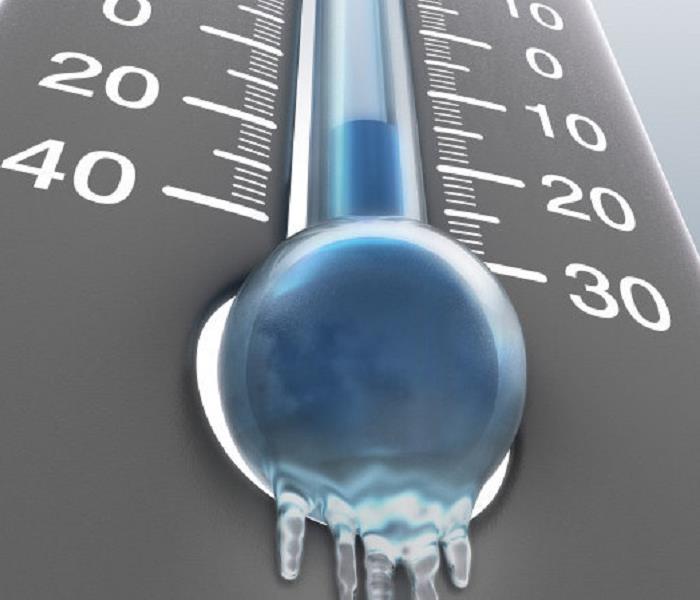
Frigid weather is blasting the Tri-State Area, which means it is dangerous outside. Residents are urged to protect themselves and help others who may be at increased risk of health problems.
Tips to stay safe
--Stay indoors as much as possible
--Report any loss of heat or hot water to property managers immediately, and call 311 or your local authorities.
--If your home lacks heat, get to a warm place tonight if you can and wear extra layers of dry, loose-fitting clothing, hats and gloves to help stay warm.
--Never use a gas stove to heat your home.
--Never use a kerosene or propane space heater, charcoal or gas grill, or generator indoors or near the home.
--If a carbon monoxide detector goes off in your home, call 911, quickly open a nearby window, and go outside for fresh air immediately.
--When outdoors, wear warm clothing and cover exposed skin. Use multiple layers to maintain warmth.
--Seniors should take extra care outdoors to avoid slips and falls from icy conditions.
--Check on neighbors, friends, relatives and clients (if you are a service provider).
--If you need a prescription filled, do so today before the arrival of the snow and dangerously cold temperatures.
Check on Neighbors, Friends, Relatives and Clients
--Home visiting and social service agencies should activate their cold emergency plans, and reach out in advance to their clients to make sure they're aware of the cold and snow.
--If you are concerned about someone on the street who may be homeless and in need of assistance, call 311 or local authorities and ask for the Mobile Outreach Response Team. The Department of Homeless Services will send an outreach team to the location to assess the individual's condition and take appropriate action.
--If your building is cold, check on your neighbors. If you know someone who is vulnerable and lacking heat, help them get to warm places and notify the building manager and/or call 311 or your local utility to get heat restored. If you see someone with signs of hypothermia such as confusion, shivering, slurred speech, drowsiness call 911 for help and help the person get warm while waiting for help.
--Landlords and building managers should check their building systems to ensure heat, and check on vulnerable people.
Health problems resulting from prolonged exposure to cold include hypothermia, frostbite and exacerbation of chronic heart and lung conditions. Here are the signs and symptoms of hypothermia and frostbite:
--Hypothermia is a life-threatening condition where the body temperature is abnormally low. Symptoms may include shivering, slurred speech, sluggishness, drowsiness, unusual behavior, confusion, dizziness, and shallow breathing. Some people, such as infants, seniors, and those with chronic diseases and substance abuse problems can get sick quicker. Check on friends, relatives, and neighbors who may need assistance to ensure they are adequately protected from the cold.
--Frostbite is a serious injury to a body part frozen from exposure to the cold. It most often affects extremities like fingers and toes or exposed areas such as ears or parts of the face. Redness and pain may be the first warning of frostbite. Other symptoms include numbness or skin that appears pale, firm, or waxy.
Provide first aid
--If you suspect a person is suffering from frostbite or hypothermia, call 911 to get medical help.
--While waiting for assistance to arrive, help the person get warm by getting them to a warm place if possible, removing any damp clothing and covering them with warm blankets.
What to Do if You Lose Heat or Hot Water at Home
Take these measures to trap existing warm air and safely stay warm until heat returns, including:
--Insulate your home as much as possible. Hang blankets over windows and doorways and stay in a well-insulated room while the heat is out.
--Dress warmly. Wear hats, scarves, gloves, and layered clothing.
--If you have a well maintained working fireplace and use it for heat and light, but be sure to keep the damper open for ventilation. Never use a fireplace without a screen.
--If the cold persists and your heat is not restored call family, neighbors, or friends to see if you can stay with them.
--Do not use your oven or fuel-burning space heaters to heat your home. These can release carbon monoxide, a deadly gas that you cannot see or smell.
--Open your faucets to a steady drip so pipes do not freeze.
Safe Home Heating Tips
Improper use of portable heating equipment can lead to fire or dangerous levels of carbon monoxide. Take precautions to ensure you are heating your home safely.
Fire safety tips:
--Make sure you have a working smoke alarm in every room. Test them at least once a month and change the batteries twice a year.
--Use only portable heating equipment that is approved for indoor use. Space heaters are temporary heating devices and should only be used for a limited time each day.
--Keep combustible materials, including furniture, drapes, and carpeting at least three feet away from the heat source. Never drape clothes over a space heater to dry them.
--Never leave children alone in the room where a space heater is running. Always keep an eye on heating equipment. Turn it off when you are unable to closely monitor it.
--Plug space heaters directly into a wall outlet. Never use an extension cord or power strip. Do not plug anything else into the same outlet when the space heater is in use. Do not use space heaters with frayed or damaged cords.
--If you are going to use an electric blanket, only use one that is less than 10 years old from the date of purchase. Also avoid tucking the electric blanket in at the sides of the bed. Only purchase blankets with an automatic safety shut-off.
Carbon monoxide safety tips:
--Carbon monoxide comes from the burning of fuel. Therefore, make sure all fuel-burning devices such as furnaces, boilers, hot water heaters, and clothes dryers are properly vented to the outdoors and operating properly. If you are not sure, contact a professional to inspect and make necessary repairs.
--Make sure you have a working carbon monoxide detector. Most homes and residential buildings in New York City are required by law to have carbon monoxide detectors installed near all sleeping areas. Owners are responsible for installing approved carbon monoxide detectors. Occupants are responsible for keeping and maintaining the carbon monoxide detectors in good repair.
--If you have a working fireplace keep chimneys clean and clear of debris.
--Never heat your home with a gas stove or oven, charcoal barbecue grill, or kerosene, propane, or oil-burning heaters.
--The symptoms of carbon monoxide poisoning are non-specific and include headache, nausea, vomiting, dizziness, sleepiness, trouble breathing, and loss of consciousness. Severe poisonings may result in permanent injury or death.
If you suspect carbon monoxide poisoning, call 911, get the victim to fresh air immediately, and open windows.
If You Need Emergency Heating Assistance
The Human Resources Administration (HRA) administers the federal Home Energy Assistance Program (HEAP), which provides low-income people with emergency heating assistance. Eligible residents will receive a payment for fuel delivery, or HRA will arrange for fuel delivery or boiler repair. Emergency assistance is given to those who qualify only once per heating season. Call 311 for more information.
Homeless Outreach
The Department of Homeless Services (DHS) continues to use its Cold Weather Emergency Procedure, called Code Blue, to protect unsheltered individuals, who are more at risk for exposure deaths during the cold winter months.
Outreach workers are on the streets 24 hours a day, seven days a week and are trained to:
--Identify and regularly monitor individuals who may be at risk during cold weather.
--Engage at-risk individuals and persuade them to voluntarily come indoors.
During a Code Blue Cold Weather Emergency, housing options for the homeless include the following:
Shelters: During a Code Blue, homeless adults can access any shelter location for single individuals. Beds are available system-wide to accommodate anyone brought in by outreach teams or walk-ins.
Drop-in centers: All drop-in centers are open 24 hours a day when Code Blue procedures are in effect, taking in as many as people as possible for the duration of inclement weather. Drop-in staff also can make arrangements for homeless individuals at other citywide facilities.
Safe havens and stabilization beds: Chronically homeless individuals may be transported to these low-threshold housing options where they may go directly from the street to a bed.
Winter Maintenance Tips
2/11/2015 (Permalink)
Winter Weather Tips
You worked hard this past holiday season; your house guests are gone, the decorations have all been packed away and you’re settling into the New Year. For those who live in an area of the country with a nice, warm climate, their Winter preparations mean putting on a sweater at night or taking that extra minute to jump into the pool! However, for those of us who live in the “hearty” Northeast where temperatures dip and snow begins to fall, there are cold weather preparations that will not only keep your home and property safe, but may also save you a few dollars.
Clean It - Start the winter with a clean furnace - a cleaner furnace can save up to 5% of fuels costs over the course of the year compared to a dirty one. And with this season’s lower than expected oil prices, filling up your tank will be more affordable.
Avoid ice damming by keeping gutters clear of leaves, sticks and other debris to ensure melting snow can drain properly. If the snow refreezes, it can lead to water damage inside your home or possibly even a roof collapse.
Seal It – Keep cold air out and warm air in this winter. Grab a tube of caulk and take a walk around your home to seal any openings around windows, doors, vents and electrical wires. Also sealing any openings will prevent mice from sneaking in to enjoy your warm winter air!
Remove hoses, turn off outside water and tighten outside faucets as pipes can burst if water in the pipe freezes. And during a deep freeze, remembering to drip your inside faucets ever so slightly will greatly eliminate the risk of inside pipes bursting.
Check It – Check smoke detectors, fire alarms, carbon monoxide detectors and flashlights to ensure they are operating properly. Have extra batteries on hand and replace if necessary.
Keep a cache of candles on hand but when in use keep the flame away from flammable items and never leave them unattended. Same goes for a portable space heater!
Store It – Having a supply of warm blankets in the linen closet, bottled water in the pantry and ice melting compound in the garage is always a good idea. And keeping a small bucket of sand and a shovel handy inside your home will be most helpful . . . especially if Old Man Winter brings a foot of snow to your door!
How to prevent roof ice dams, other winter weather home damage
2/9/2015 (Permalink)
Roof ice dams:
• clean debris, snow and ice from gutters and down spouts.
• Use a roof rake to clear snow from your roof.
• Make sure your attic is sufficiently insulated and ventilated. Maintaining airflow from under the eaves of soffit area through roof vents helps prevent ice dams. Click here for insulation guidelines.
Prevent frozen pipes:
• if you leave for several days, don't turn your heat down all the way. You also can drain and shut off the water supply (except indoor sprinkler systems).
• Insulate pipes, especially those near outer walls, in crawl spaces, or in the attic. You also can add special heat tape or thermostat-controlled cables to pipes.
• Use caulk or insulation to seal air leaks near electrical wiring, dryer vents and pipes.
• Disconnect garden hoses shut off and drain pipes leading to outside faucets.
• Keep a trickle of warm water running overnight from a faucet near an exterior wall.
• Open all cabinet doors under sinks.
If you discover frozen pipes, Fremont Insurance recommends you shut off the water, call a plumber and your insurance agent, and be aware of potential electric shock in and around standing water. Don't try to thaw a frozen pipe with an open flame or torch.
We Couldn't Be Prouder! Another Great Customer Testimonial - Please Read
2/5/2015 (Permalink)
Capital One Bank
170 Tulip Avenue
Floral Park NY 11001
February 4, 2015
Having been in the Property Management business for the past 15 years, I have seen my fair share of issues; from fires, to floods, to mold, etc. Each situation is unique and requires a different approach to remediation. Working for a financial institution, I can tell you that the need for a speedy resolution is as important as the need for a thorough one. After a disaster, not only do we need to re-open as quickly as possible to serve our clients, we are responsible for providing a safe, healthy environment for all associates, and that is where SERVPRO comes in.
I have had the pleasure of working with Debbie Rashti and Dan Wallace on several occasions. The first was when one of our bank branches experienced several severe leaks as the result of negligence from a neighboring business. After performing an indoor air quality test, it was determined that a highly dangerous form of mold was growing in our ceiling and inside the walls. On a Thursday morning, we reached out to SERVPRO for assistance. Within 24 hours, Debbie and Dan had a team mobilized and ready to work around the clock for the next 72 hours in order to rid our branch of this toxic substance and make it ready to safely re open to customers on a Monday morning, with a favorable air quality test. The task was performed seamlessly and with such organization, that one would never be able to tell on that Monday morning, that just a day before, the space had been filled with a massive team, opening ceilings and walls to perform such a detailed remediation.
Another instance that will forever stand out in my mind is the days that followed the devastation of Hurricane Sandy in October of 2012. Capital One had more than 10 branches that suffered significant damage as a result of the storm, making them unable to open for business. In addition to mere loss of electricity, some of our locations suffered from significant flooding and one in particular, from fuel oil contamination, when an oil tank broke apart in the basement as a result of massive flooding.
The day after the storm, Dan Wallace began touring with Capital One Property and Project Managers, myself included, in order to survey these badly damaged locations and determine what was needed to re-open. Once each survey was completed, Dan wasted no time putting a team together to begin remediation. Dan took total control of, what at first seemed like an impossible task, and set a clear, organized plan in motion. With SERVPRO’s expertise, organization and professionalism, Capital One was able to open many of its damaged sites, within days and weeks, rather than months, as was the case with many neighboring businesses.
I can’t possibly give the team at SERVPRO the proper amount of praise they deserve. They have been, and will continue to be an asset to Capital One Bank and many other organizations time and time again. SERVPRO is amazing.
Facility Manager
Jones Lang LaSalle for Capital One Bank
Homeowners Insurance Rates: How Does Your State Compare?
2/3/2015 (Permalink)
Reprinted from PropertyCasualty 360
NAIC 2012 annual homeowners insurance report shows it’s about location first.
The most important factor when buying real estate is location, and as you might expect, it’s a significant factor in establishing rates for homeowners insurance as well. What is the average premium for a house worth $300,000 in Georgia compared to one in neighboring Alabama or Florida? What’s the average nationwide?
Panelists at the Property/Casualty Insurance Joint Industry Forum 2015 on Jan. 13 acknowledged downward pressure on rates, especially for homeowners policies because they aren’t seeing much growth in new home sales. With that trend in mind, if you’re pricing policies and renewals in different locations, it’s helpful to know what the most recent data on the cost of homeowners policies shows.
The National Association of Insurance Commissioners (NAIC) released its 2012 Homeowners Insurance Report on Jan. 20, providing detailed data on market distribution and the average cost by policy form and insurance amount of homeowners insurance across the U.S. The report provides countrywide and state-specific premium and exposure information for standard noncommercial dwelling fire insurance and for homeowners insurance package policies (HO-1, HO-2, HO-3, HO-5 and HO-8), tenant policy HO-4, and condominium/cooperative unit owner’s policy HO-6.
The 2012 report, available for free download on the NAIC website, includes some interesting statistics as well as detailed charts.
In 2012, homeowners owner-occupied policy exposures accounted for 76.8% of overall exposures countrywide.Tenant and condominium policy exposures accounted for 21.3% of the total, while dwelling fire exposure made up the remaining 1.9%.Approximately 53.2% of policies sold in Washington, D.C. in 2012 were tenant or condo/co-op policies, reflecting the high level of urbanization.Here are several key factors affecting the cost of insurance that also were identified in the report.
Geographic areas. Generally, the more densely populated the location, the higher the real estate values and construction costs. You’ll also find relatively higher real estate values in vacation and retirement areas.Construction costs. The type of residence, the availability of building materials, local climate and building regulations all affect construction costs. Premiums also reflect higher expected repair costs for designs intended to reduce structural damages from earthquakes or hurricanes, for example.Degree of exposure to catastrophe. Homeowners insurance premiums also are affected by the degree of exposure to catastrophes, for example, a waterfront property exposed to hurricanes or a mountaintop property exposed to brush and forest fires. According to the Property Claims Services unit of the Insurance Services Office, an event is a catastrophe if it results in insured losses that total $25 million or more.Stricter building codes. After major catastrophes like Hurricane Katrina or Superstorm Sandy many state and local governments enact stricter building codes in an attempt to minimize damage and losses from future catastrophes.Economic factors. Such economic factors as inflation increase the amount of insurance premiums over time. Interest rates and inflation can affect not only the value of the real estate and building but also the price of the insured contents.These factors as well as others listed in the report can result in wide variations in premiums, not only by region or state, but on local levels as well. It pays to shop around, and consult your agent or broker for the best policy for your location.
Is Your Home Office Covered by Your Homeowners Insurance? Here's What You Need to Know
1/29/2015 (Permalink)
Reprinted from PropertyCasualty360
Have you become an entrepreneur over the last year, running a home-based business? Or do you sell home products like make-up or plastic storage containers for extra income? If so, are you aware that your standard homeowners insurance policy may leave you with coverage gaps?
As Diane W. Richardson, CPCU, points out in the Home-Based Business Coverage Guide ((c)2015, National Underwriter Co.), there are both property and liability business exposures that most standard policies don’t address as well as low limits on coverage.
For example, most homeowners policies limit the amount of coverage available for property on the insured premises used primarily for business purposes. According to Richardson, the unendorsed Insurance Services Office (ISO) homeowners 2011 program provides only $2,500 for business property on the premises and $500 for business property away from the residence premises. The American Association of Insurance Services (AAIS) 2008 program limits are $2,500 and $250, respectively. When you add up the cost of your computer, all-in-one printer, fax and scanner, tablet, modem and router, telephone system, desk, filing cabinet, office supplies and software, you could easily exceed $2,500. And your smartphone by itself could cost more than $500 to replace.
Other structures
If you operate your business out of your garage or barn, you’ll need coverage for “other structures.” Homeowners policies vary in what coverage they provide for such structures, depending on whether they are used for storage of business property or actively used to conduct business.
Liability exposure
The ISO homeowners form 2011 excludes any activities “engaged in for money” for which you don’t earn more than $2,000 in the 12-months preceding the policy period from the definition of “business.” This limitation puts most home-based business owners within the “trade, profession or occupation engaged in on a full, part-time or occasional category” and so without coverage, Richardson explains.
Richardson also points out that there are potential gaps in coverage, depending on the business, which may include liability from a violation of any intellectual property laws, infringement of a copyright or trademark for anything on a Web site, errors and omissions exposures, or employers liability and workers’ compensation. In some situations, you may need specialized coverage—for example, professional liability insurance for attorneys or accountants. Richardson believes that, generally, the coverages of the ISO and AAIS forms are adequate—at least as a start, before you speak with your agent or broker.
Business income
What would happen if you couldn’t work out of your home office—if it’s destroyed by fire or you have no power for several days due to an ice storm? You would have no coverage for the loss of your business income without appropriately endorsing the homeowner form. Depending on the size of your business, you may have to purchase a businessowners or commercial policy with business interruption coverage. If your business takes over your home to the point at which you’ve converted all the rooms to offices and moved to another residence, then you’ll definitely need commercial coverage.
Exclusions from property coverage
Remember that your home-based business is attached to your homeowners coverage and is subject to the same exclusions. If your home isn’t covered by flood insurance, for example, neither is your business, Richardson explains. It’s also important to understand that the ISO and AAIS forms list different named perils, open perils, and exclusions. Richardson cites the example of sinkhole collapse as a named peril in the AAIS form but not in the ISO form. Both forms exclude coverage for any loss resulting from criminal or fraudulent acts.
The policies also include exclusions from liability coverage, for instance, an employer’s liability for injury to employees or bodily injury or property damage from pollution caused or created by the business. The AAIS form specifically excludes coverage of injury or damage of electronic data and computer failure.
Terms and conditions
The ISO and AAIS forms also include conditions on your homeowners declaration that apply to property losses under your home-based business insurance coverage, whether the property belongs to your business or to someone else. For example, if you repair computers or furniture for customers at your home, ask your broker whether damage to the customer’s property is covered. If so, you also should ask how the value of the property is calculated and how any potential loss will be settled.
Telecommuters
If you telecommute or work remotely for an employer, the insurance issues for a home office are even more complicated. For example, you may be covered under your homeowners policy for property you own, such as your desk and filing cabinets, but your employer may be covered for loss to company-owned property such as your computer or smartphone. If a delivery person slips on icy steps at your home while making a business-related delivery in this situation, your employer’s policy might cover, your homeowners policy might cover, or you could find yourself in the middle between the two carriers, both of which may initially deny the claim. If you serve a customer coffee in your kitchen—not your office—after a business meeting, and the customer is burned by hot coffee, there may be a question of shared liability because the kitchen isn’t officially business space.
If you do work remotely, be sure to check your homeowners policy and ask your employer to confirm what the terms and conditions of its policies are, or you may find that neither policy covers a loss.
The Year in Disasters: A Look Back at 2014's 7 Most Catastrophic Events
1/27/2015 (Permalink)
Life was good in 2014.
For example, we saw a continuation of the previous year's relatively low overall catastrophic damage totals, according to CoreLogic's "Natural Hazard Risk" analysis report, which provides a summary and analysis of the most significant natural disasters of the year.
The U.S. has not experienced a single natural hazard that cost in the tens of billions of dollars since Superstorm Sandy ravaged parts of the East Coast in 2012.
However, calling 2014 a "quiet" year is not entirely accurate, as locally devastating events can wreak major destruction and drive losses. Late summer flooding caused widespread damage in Detroit and Phoenix, an April tornado outbreak killed dozens in the south and destroyed more than 400 homes, and an August earthquake in Napa Valley had a $2 billion impact on the wine industry.
Below and on the following pages, CoreLogic details 2014's most catastrophic events.
Hurricanes
The 2014 hurricane season was the second consecutive year of low tropical storm and hurricane activity in the Atlantic Ocean. Last year, there were only eight named North Atlantic storms, six of which became hurricanes. And of those six, just two developed into a major hurricane (those that are Category 3 or larger).
Hurricane Arthur, the first named storm of the season, struck North Carolina on July 3. Because of its slow-moving path toward the north-northeast, its damage was relatively minor and primarily restricted to power outages and flooding.
"No other tropical storms or hurricanes caused damage or had any appreciable effect along the Gulf and Atlantic coasts of the U.S. in 2014," the report states.
The report authors hypothesized that the high levels of wind shear in the Atlantic, and stable temperature and moisture conditions impeded hurricane development.
Flooding
Damage attributed to flooding in 2014 was below average, totaling $4.2 billion in losses for the year (the long-term historical average in the U.S. is $5.3 billion).
These events weren't limited to one area of the U.S. in 2014, but the largest property losses took place in larger metropolitan areas. Urban damage due to flash flood events causes substantial property loss, as a city storm water system is connected to the sewer. Flash floods quickly overwhelm these storm water drains and cause sewers to backup into property basements, the report says.
On Aug. 11, the Detroit Metro Airport received 4.57 inches of rainfall, which is the second-heaviest single day of rainfall on record in Michigan. The flooding caused more than $1.1 billion in damage and affected 118,000 homes and businesses in the area.
Just two days later, 13.27 inches of rain fell over the course of one day at Long Island's MacArthur Airport in Islip, N.Y., which surpassed the estimated 7 inches of rainfall that occurred during Superstorm Sandy and also set a one-day record for the state.
And on Sept. 8, the Phoenix metro area experienced a record-setting 3.29 inches of rainfall, which caused widespread property damage due to Phoenix's relatively flat landscape.
Hail
Despite frequent hail storms, 2014 will go down as quiet for claims activity. Last year's hail covered the largest geographic area in the past decade, but nearly 62% of the total hail fall was sized at less than one inch in diameter, and 96% was sized at less than 1.5 inches. For the largest hail sizes (greater than 3 inches), last year ranked lowest on record for the past nine years.
Knowing accurate hail sizes is just as important as knowing where hail occurred when considering loss, CoreLogic reports. "Widespread hail fall does not always coincide with widespread areas of larger, more severe hail."
Tornadoes
Based on data through August 2014, just 720 tornadoes were verified through the National Weather Service's Storm Prediction Center. Even if every storm report from September through the end of the year was processed and verified, the potential total would be 848, CoreLogic reports, which makes 2014 comparable to the two previous years in terms of total tornadoes and well below busier years like 2008 and 2011.
But a low tornado count does not guarantee an absence of severe physical damage or loss of life. On April 27, residents of Mayflower and Vilonia, Ark., suffered through an EF4 tornado that destroyed between 400-500 homes and claimed 16 lives. The following day also brought severe weather conditions, damaged property and loss of life to Tennessee, Georgia, Alabama and Mississippi.
Sinkholes
Although Florida is the state most well-known for sinkhole events, it was Kentucky that experienced the most newsworthy event in 2014. In February, a sinkhole opened underneath the floor of the National Corvette Museum in Bowling Green. Eight cars fell into the hole, and the cost to repair the facility was estimated at more than $3 million.
Wildfires
"The 2014 wildfire season was a series of contradictions," CoreLogic reports. "California had more wildfire activity than ever before, but little property loss or damage."
Despite drought conditions, which contribute to wildfire growth, 2014 saw the second-fewest number of fires and the lowest wildfire acreage loss in the past 10 years. One possible explanation for the lack of wildfire damage could be that response and suppression efforts were quick, extensive and successful, CoreLogic hypothesizes. Contributing to this theory? Large-scale airplane and helicopter mobilization efforts are effective, but expensive. In California, the response to wildfire activity depleted the state's entire wildfire response budget in the first three months of the fiscal year.
Increased public awareness and community mitigation efforts also contributed to the reduction in wildfire damage. The installation of fire-resistant roofing and siding material, vent screens and other methods have proven to be effective against home ignitions.
Still, 2014 was not without loss. A total of 45,468 fires occurred as of October 2014, consuming 3.4 million acres of land. The largest fire of the year ravaged eastern Oregon in July when the Buzzard Complex Fire burned through nearly 400,000 acres. In July, the largest fire in Washington state history (Carlton Complex Fire) covered 256,000 acres and destroyed 322 homes.
Earthquakes
The U.S. Geological Survey (USGS) estimates that several million earthquakes occur in the world each year, but many go undetected because they hit remote areas or have small magnitudes. The National Earthquake Center locates about 50 earthquakes per day, or about 20,000 each year.
In the U.S., California, unsurprisingly, was in the spotlight in 2014. A 6.8 magnitude temblor shook Humboldt County, located in the northwest part of the state on March 9, followed by a 4.4 earthquake in the Los Angeles area on March 17. SoCal wasn't spared, as yet another quake occurred on March 28 in the L.A. vicinity. CoreLogic estimates that damages from these three events were minimal.
However, the Golden State experienced its worst seismic event of the year when a 6.8 magnitude earthquake hit Napa Valley on August. 24, causing $2.1 billion in damage.
"Geologically, the San Francisco Bay region is underlain by many softer soils, commonly referred to as bay mud. Historically, it has been observed that softer soils amplify ground motions and contribute to a disproportionate amount of damage," CoreLogic reports.
This event primarily caused commercial losses, damaging a number of historic buildings in downtown Napa. Business interruption losses were also a major concern, due to the heavy reliance on tourism in the region. Non-structural damage, such as broken wine bottles and barrels, as well as substantial sprinkler leakage, was observed.
Away from California, the USGS reports that the rate of earthquakes in Oklahoma has increased by about 50% since October 2013. According to the organization, 580 earthquakes of 3.0 magnitude or higher happened in Oklahoma and Kansas in 2014, as compared to the years of 1978-2008, where only two 3.0 tremor events happened annually. The USGS reports that the increase coincides with the injection of wastewater in deep disposal wells.
Homeowner Insurance Rates: How Does Your State Compare?
1/22/2015 (Permalink)
Reprinted from PropertyCasualty360
NAIC 2012 annual homeowner insurance report shows it’s about location first.
The most important factor when buying real estate is location, and as you might expect, it’s a significant factor in establishing rates for homeowners insurance as well. What is the average premium for a house worth $300,000 in Georgia compared to one in neighboring Alabama or Florida? What’s the average nationwide?
Panelists at the Property/Casualty Insurance Joint Industry Forum 2015 on Jan. 13 acknowledged downward pressure on rates, especially for homeowner policies because they aren’t seeing much growth in new home sales. With that trend in mind, if you’re pricing policies and renewals in different locations, it’s helpful to know what the most recent data on the cost of homeowner policies shows.
The National Association of Insurance Commissioners (NAIC) released its 2012 Homeowners Insurance Report on Jan. 20, providing detailed data on market distribution and the average cost by policy form and insurance amount of homeowners insurance across the U.S. The report provides countrywide and state-specific premium and exposure information for standard noncommercial dwelling fire insurance and for homeowner insurance package policies (HO-1, HO-2, HO-3, HO-5 and HO-8), tenant policy HO-4, and condominium/cooperative unit owner’s policy HO-6.
The 2012 report includes some interesting statistics:
In 2012, homeowner owner-occupied policy exposures accounted for 76.8% of overall exposures countrywide.Tenant and condominium policy exposures accounted for 21.3% of the total, while dwelling fire exposure made up the remaining 1.9%.Approximately 53.2% of policies sold in Washington, D.C. in 2012 were tenant or condo/co-op policies, reflecting the high level of urbanization.Here are several key factors affecting the cost of insurance that also were identified in the report.
Geographic areas. Generally, the more densely populated the location, the higher the real estate values and construction costs. You’ll also find relatively higher real estate values in vacation and retirement areas.Construction costs. The type of residence, the availability of building materials, local climate and building regulations all affect construction costs. Premiums also reflect higher expected repair costs for designs intended to reduce structural damages from earthquakes or hurricanes, for example.Degree of exposure to catastrophe. Homeowners insurance premiums also are affected by the degree of exposure to catastrophes, for example, a waterfront property exposed to hurricanes or a mountaintop property exposed to brush and forest fires. According to the Property Claims Services unit of the Insurance Services Office, an event is a catastrophe if it results in insured losses that total $25 million or more.Stricter building codes. After major catastrophes like Hurricane Katrina or Superstorm Sandy many state and local governments enact stricter building codes in an attempt to minimize damage and losses from future catastrophes.Economic factors. Such economic factors as inflation increase the amount of insurance premiums over time. Interest rates and inflation can affect not only the value of the real estate and building but also the price of the insured contents.These factors as well as others listed in the report can result in wide variations in premiums, not only by region or state, but on local levels as well. It pays to shop around, and consult your agent or broker for the best policy for your location.
Insurance via Internet Is Squeezing Agents
1/19/2015 (Permalink)
Reprinted from The New York Times
To the list of jobs threatened by the Internet, add one more: insurance agent.
Technology start-ups, and companies from the insurance industry, are introducing websites that sell or promote a range of insurance including auto, homeowners and small commercial policies. These portals, which promise savings by showing consumers many price quotes so they do not have to shop site by site, are putting pressure on insurance agents, who collect 10 percent or more of their policyholders’ payments.
Online insurance comparison is still a nascent business, and it has yet to make a dent in the armies of intermediaries that are the backbone of the trade. But people in the industry and Silicon Valley say it is only a matter of time. Even Google is getting involved.
“There are 40,000 agencies in the U.S., and you could absolutely imagine them shrinking by a quarter, and the ones that are left will deal with more complicated needs and more affluent customers,” said Ellen Carney, an analyst who covers insurance for Forrester Research.
The idea of selling insurance online is not new. Lately, though, the boring but lucrative trade has been attracting big names. The most recent is Google.
Its Google Compare auto insurance site (basically a search engine for auto insurance prices) has been operating in Britain for two years, and Google is working on something similar for the United States. Google is licensed to sell insurance in about half of the states, according to research by Ms. Carney.
Google has formed a partnership with Comparenow, an American auto insurance comparison site owned by Admiral Group, a British car insurance company that has operated a European price-comparison site for more than a decade. The venture will give Google access to insurers in Comparenow’s network.
Admiral Group introduced Comparenow about a year ago. Not long after, Overstock.com, a retailer, started selling auto and other forms of insurance.
Then there is Walmart, which does not sell insurance but recently formed a partnership with AutoInsurance.com. The insurer leases space in Walmarts, giving it access to the 140 million people who shop there each week.
These companies are joining start-ups like CoverHound, a San Francisco company that allows consumers to compare and buy auto insurance online, and PolicyGenius, a Brooklyn company that sells products including life, renters and pet insurance.
Some companies, like CoverHound and PolicyGenius, are online insurance agencies. Others, like Comparenow, send traffic to insurers and get a finder’s fee whenever someone buys a policy. But in all cases, they are pressing Main Street agents by automating the process and showing insurers’ prices side by side.
“A lot of people are waking up to the fact that it’s a massive industry, it’s old-fashioned, they still use human agents and the commissions are pretty big,” said Jennifer Fitzgerald, the founder and chief executive of PolicyGenius. “It’s ripe for — I hate to use the word — disruption.”
Insurance is a fat target. In 2013, insurers wrote $481 billion in premiums for property and casualty insurance, which consists of mostly auto, home and commercial insurance, according to the Insurance Information Institute, an industry group. That would place a rough estimate of agents’ commissions — including commissions to small-time agents as well as to brokers who sell large commercial policies — at $50 billion.
And while it might seem like an odd match for Google, whose projects include driverless cars, delivery drones and a pill to detect cancer, the key to insurance is having lots of data about people’s backgrounds and habits, which is perhaps the company’s greatest strength.
“They have a ton of data on where people drive, how people drive,” said Jon McNeill, chief executive of Enservio, a Needham, Mass., company that makes claims-processing software. “It’s the holy grail of being able to price auto insurance correctly.”
In the decades before the search engine, insurance companies used on-the-ground agents to extend their reach from financial centers to towns and neighborhoods across America. Now that power has shifted to the Internet. People have become conditioned to entering reams of personal data into a computer, and companies are better at processing it.
Robert P. Hartwig, president of the Insurance Information Institute, says rumors of the insurance agent’s death have been greatly exaggerated. Online insurance shopping is already a crowded space, which in addition to comparison portals includes the powerful marketing arms of companies like Geico and Progressive. These businesses do not just advertise insurance, but provide it too.
“Even if they go through Google or another portal, they still end up at an insurance agency or company at some point,” Mr. Hartwig said. “I think the agency model has a lot more consistency than many people give it credit for.”
D. J. Rodrian, a second-generation owner of Rodrian Insurance in Brookfield, Wis., is at least paying attention. “It should worry any agent when a megacompany like Google, with all the personal information that they have about people, is getting into your industry,” he said.
While Mr. Rodrian said he was not worried about going out of business, he said his most vulnerable customers were the quarter or so of policyholders who carry only auto insurance. Many of his other clients have comprehensive policies that are woven into everything they own, which makes them far less likely to leave.
“Consumers don’t have a great understanding of insurance,” Mr. Rodrian said. “They don’t find it an interesting thing to educate themselves about. They do get comfort in the advice of a professional.”
And, of course, just because something is possible does not mean consumers will embrace it.
Overstock offers auto and homeowners insurance, as well as commercial policies for small businesses, such as a liability policy for a ballet studio. Patrick Byrne, the company’s chief executive, says it has not done very well: While customers who go all the way through the process are very likely to buy a policy, many are unwilling to even begin the application.
Mr. Byrne said his company has sold only a few thousand policies since introducing its insurance business nine months ago, or “the equivalent of a small-town brokerage.” “It hasn’t done a whole lot of business,” he said. “But if the whole industry moves this way, it could.”
Technology companies are not the first to try to cut intermediaries out of insurance sales. That distinction belongs to the insurance trade itself, which spends billions of dollars a year on direct advertising to consumers. Behind those clever Geico television commercials involving geckos and cave men is a pitch that goes: If you buy from us instead of an agent, we will give you a discount.
That offer has worked. The direct sales channel accounted for 28 percent of United States auto insurance sales in 2012, roughly double the level in 1995, according to A. M. Best, an Oldwick, N.J., credit rating agency focused on the insurance industry.
Big insurers, having spent billions in advertising dollars to convince consumers that their insurance is cheaper than the other companies, may not embrace the comparison model. But insurance industry specialists suspect that, over time, they may have little choice.
They contend that the vast reach of search engines, combined with cheap processing power that lets even tiny companies run extensive background checks, will erode the advantage of large-scale advertising.
“As comparison begins to take off, the little guys will get exposure to consumers that they could never get on their own,” said Andrew Rose, chief executive of Comparenow.
It's Official: Earth has Warmest Year on Record in 2014
1/19/2015 (Permalink)
Reprinted from Newsday
Long Islanders who lived through last winter's recurring deep-dive Arctic dips may find it hard to believe that, globally, 2014 was the warmest year since records started being kept, back in 1880. Both NASA and the National Oceanic and Atmospheric Administration according to analyses report that Friday.
Globally, the average combined land and sea surface temperature of 58.24 was 1.24 degrees above the 20th century average and was the highest on record, NOAA said.
"This is the latest in a series of warm years, in a series of warm decades," said Gavin Schmidt, director of NASA's Goddard Institute of Space Studies.
"While the ranking of individual years can be affected by chaotic weather patterns," he said, "the long-term trends are attributable to drivers of climate change that right now are dominated by human emissions of greenhouse gases."
In 2014, Long Island was "a little on the warm side" and certainly not "record-breaking," said Jessica Spaccio, a climatologist with the Northeast Regional Climate Center based at Cornell University.
Last year's average temperature for the Island, which makes up the bulk of NOAA's New York Coastal Climate Division 4, was 52 degrees, making it the 33rd-warmest year since 1895, when records started being kept. The average yearly temperature, based on data since 1895, is 51.2, she said.
Long Island MacArthur Airport saw a 2014 average temperature of 52.5, making it the 14th-warmest year since 1984, when data started being kept, she said. The airport's December temperature, 39.6, ranks at ninth warmest for the month.
Of course, this is one small region of a planet, she said, that has been seeing an ongoing trend of being warmer than average.
Last year's heat was driven by record warmth in the world's oceans that didn't just break old marks: It shattered them. Record warmth spread across far eastern Russia, the western part of the United States, interior South America, much of Europe, northern Africa and parts of Australia.
"Every continent had some aspect of record high temperatures" in 2014, said Tom Karl, director of NOAA's National Climatic Data Center.
Nine of the 10 hottest years in NOAA global records have occurred since 2000. The odds of this happening at random are about 650 million to 1, according to University of South Carolina statistician John Grego. Two other statisticians confirmed his calculations.
SERVPRO® celebrates 6th Consecutive Year on Entrepreneur’s Top 10 Franchise List
1/15/2015 (Permalink)
Cleanup and restoration franchiser stands strong in the #7 position in the 2015 Franchise 500 ranking
SERVPRO®, a cleanup and restoration franchise company, maintains its hold on the No.7 spot overall – out of a group of 927 franchises that qualified for inclusion in the list – in the recently announced 2015 Franchise 500 rankings* from Entrepreneur magazine.
This recognition marks the 12th consecutive year SERVPRO has earned a spot on the magazine’s list in its own industry – Restoration Services.
Entrepreneur magazine’s Franchise 500 selection process** uses “objective, quantifiable measures of a franchise operation” to help would-be entrepreneurs identify franchise investment opportunities. Some of the important factors considered by Entrepreneur in developing the list each year are “financial strength and stability, growth rate and size of the system.”
SERVPRO of Great Neck Port Washington specializes in fire and water cleanup and restoration services, helping both commerical and residential customers recover from property damage emergencies and represents the ongoing brand leadership for restoration services in Great Neck/Port Washington/Roslyn and surrounding communities.
For more information about SERVPRO of Great Neck Port Washington, visit our website www.SERVPROofgreatneck.com or contact us 24/7 at 516-767-9600.
About SERVPRO®
Founded in 1967, the SERVPRO® Franchise System is a national leader and provider of fire and water cleanup and restoration services and mold mitigation and remediation. SERVPRO’s professional services network of nearly 1,700 individually owned and operated Franchises responds to property damage emergencies ranging from small individual disasters to multi-million dollar losses. Providing coverage in the United States and Canada, the SERVPRO System has established relationships with major insurance companies and commercial clients, as well as individual homeowners.
*http://www.entrepreneur.com/franchise500/index.html
**http://www.entrepreneur.com/franchises/franchise500/about.html
Warmup Awaits Midwest, East During Mid-January
1/14/2015 (Permalink)
By Alex Sosnowski, Expert Senior Meteorologist, AccuWeather.com
Despite some pockets of cold air in the Midwest and East into the middle of this week, the wheels of change are in the works for a mild weather pattern for the middle of January.
A storm brought a reinforcing shot of cold air during the early part of the week for the Central and Eastern states. However, the jet stream is about to lock out arctic cold for the third week of the month in all but the upper Great Lakes to northern New England.
The jet stream is a high-speed river of air high above the ground that guides storms and air masses along across the globe.
According to Paul Pastelok, AccuWeather.com chief long-range meteorologist, "During the next week or so, the jet stream will set up in such a way as to keep arctic air bottled up across central and northern Canada and will allow mild Pacific air to flow from west to east across much of the United States."
Pastelok stated that there will still be some sneaky cold that skirts the northeastern states at times and that people in this area should not expect temperatures to be warm for the entire middle part of the month.
High temperatures may average 5 to 10 degrees Fahrenheit above normal in the northern tier states for a few days into next week, compared to the consistent 10 to 20 degree below normal temperatures during the first full week of January.
In areas from Chicago to Boston and New York City, this will translate to multiple days with highs in the upper 30s F to 40s F. In areas from Dallas to Atlanta, the upcoming pattern will bring highs in the 50s and 60s on at least several days. From Minneapolis to Buffalo, New York, highs will reach or exceed the freezing mark for a couple of days or more.
The last area to warm up, or the area that shows the most resistance to the warmup will be northern Michigan, upstate New York and northern New England.
Temperatures to Moderate This Week
A frigid pattern brought a shivering end to last week but the weather pattern is now in transition this week.
The cold air that poured into the East will continue to depart through the remainder of the week. Pockets of cold air will be more stubborn to leave where there is a large snowpack on the ground. During the second half of the week, the pattern will feature near-normal temperatures most days in most locations from the Midwest to the East and South.
When Will Arctic Air Return?
The expanding warmup forecast does not mean that winter is over.
"We expect much colder air to expand southward and then eastward during the fourth week in the month," Pastelok said.
Snow Versus Ice, Rain Just a Matter of Timing
Thus far this winter, cold air and storms have remained out of sync to get a major snowfall in the Interstate-95 corridor of the Northeast.
"Storm systems pushing into the Southwestern states have caused an area of high pressure to bulge northward in the Caribbean and southwest Atlantic," Pastelok said.
This has forced stronger storms to track toward the Great Lakes and weaker storms to limp off the southern Atlantic coast.
"In order for there to be be more substantial snow and ice in the coastal mid-Atlantic and southern New England, we would need cold air to come in and hold its ground as a storm is approaching, rather than give up like we have been seeing," Pastelok added.
All it would take is one or two storms to come along with just the right amount of cold air in place for locations in the mid-Atlantic and southeastern New England to receive near-average snowfall for the season.
The development of a storm along the Atlantic coast on Sunday will have to be watched for the possibility of rain and snow. Another system could bring snow to part of the Midwest and Northeast around the middle of next week as cold air begins to settle southward again.
Snowfall thus far from Washington, D.C., to New York City and Boston has averaged 25 to 50 percent of normal this winter.
10 Risk Factors for Homeowners Insurance Policies
1/9/2015 (Permalink)
Reprinted from PropertyCasualty 360
Customers buy insurance to minimize their risk and make them whole should a covered loss occur. What many may not understand is that a number of factors can cause their premiums to skyrocket before a covered peril even occurs. Adjusters and claims managers handling the ensuing claims also need to be aware of these possible red flags and their impact on any settlements.
An up-to-date home inventory complete with photos can be a major asset to any claim. Encourage owners to take a digital tour of every room to record furniture, electronics, antiques, works of art, family heirlooms and other irreplaceable items in the home. After a fire or major flood, it can be difficult to identify valuable items from their pre-loss condition.
The photos and a detailed inventory should be stored off-site in a safe deposit box or other secure location and copies provided to the insurance agent to ensure they are added to the appropriate policy. Keeping them on the computer at home won’t help if the computer is destroyed in a fire or stolen in a robbery.
A similar tour of the outside of the home can capture possible risks like trees near the house, foundation issues or possible roofing problems, as well as assets like copper gutters and other aftermarket finishes that add value to the home.
According to the Insurance Information Institute (I.I.I.), in 2012, 97.6% of the claims filed involved property damage, including theft, and jewelry was the top claims category under homeowners policies in 2011. From 2008-2012, I.I.I. says 7.3% of insured homes had a claim and the average loss was $8,255.
Here are 10 factors (not in any particular order) that can make a homeowner’s property a greater risk to insure:
Pets - Not every dog is man’s best friend and some insurers don’t take kindly to all breeds. Owning a German shepherd, Great Dane, Siberian Husky, Doberman, Rottweiler, Pit Bull, Akita or any other dog that could be considered aggressive could raise insurance rates. “This isn’t only limited to dogs, as exotic animals such as tigers, monkeys and others may cause rates to be high, if you can even get insurance,” says insurance expert Chris Tidball.
Bad credit score - Insurers will look to see if a homeowner has paid her bills on time and check credit scores. A lower number could result in higher premiums.
Location, location, location - Just like in real estate, the location of the home really does matter. Owners of homes located in Tornado Alley, along coastal Florida (or any coast for that matter), in a hurricane-prone state or in an area known for sinkholes can expect to pay more for homeowners' coverage.
Trampolines - Although exercise is important, some exercise equipment can impact insurance rates. Trampolines result in approximately 92,000 hospital visits each year. Parents frequently are unaware that they cause spinal injuries, fractures and head injuries. Most injuries are not caused by children flying off the trampoline, but because one child lands on another when they are jumping or they try something silly like riding a bike and jumping. Doctors recommend that only one child at a time be on a trampoline with adequate supervision
Swimming pools - Another source of higher homeowner insurance rates involves swimming pools. According to Parents magazine, drowning takes more than 1,000 lives a year and more than half of these events take place in the children’s own home and one-third take place in the homes of friends and relatives.
Fire concerns - Location also matters when it comes to fire stations. Living too far away from the local fire hall or a fire hydrant could raise insurance rates. Of course, a neighbor’s pool could be a source of water in an emergency, as well as a nearby pond.
Poor maintenance - Owners who don’t keep up with their home maintenance may see their rates raised or their homeowners insurance cancelled altogether. Leaky roofs, old hot water heaters, dripping pipes and poor water seals are just some of the items to watch out for. In 2012, 17.5% of the losses claimed were related to water damage and freezing pipes.
Weather preparations - Being ill-prepared for bad weather can also impact homeowners insurance rates. “In some states such as Florida, a homeowner can have a qualified wind inspection that demonstrates the ability of the insured structure to withstand certain force winds, which can result in a discount,” explains Tidball.
Claim frequency - Insureds who make multiple claims may be viewed as a higher risk and charged accordingly. Damage from a burst pipe, a tree that lands on the roof, or a kitchen fire on the same property will raise a red flag and cause insurers to take a closer look.
Neighborhood crime - “Living in a high crime area has been tied to an increase in certain types of claims, such as robbery,” says Tidball. “Rates will be assessed accordingly.” Approximately one in 190 insured homes have a property damage claim related to theft each year according to the I.I.I. And, based on I.I.I. figures from 2011, rates for homeowners insurance are highest in Florida, Texas, Louisiana, Mississippi, and Oklahoma. Idaho, Oregon, Utah, Wisconsin and Washington have the lowest rates.
They tried what? You'll never believe these 5 nutty claims stories
1/7/2015 (Permalink)
Reprinted from Property Casualty 360
Like emergency room doctors, cops and priests in the confessional booth, insurance people are being asked to clean up the messes that people make--and worse, they’re expected to pay for them.
It’s little wonder that veteran insurance people can get a bit jaded. When it comes to claims--and human nature--they have seen everything.
We spoke with several long-time insurance professionals about the weirdest claims they’ve come across in their careers. Here are some of the strangest.
1. The case of the vanishing gold bars
Claims consultant Chris Tidball has worked for P&C carriers for more than 20 years, in roles ranging from claims adjusting to management. The client whom he recalls as the “biggest nut” was Walter A., who presented a claim for a stolen van that was carrying $500,000 in gold bars, which, of course, he wanted covered as well. “Imagine our shock when the van turned up burned to a crisp and all the gold was missing.” Walter would personally come to the office every morning at 8 a.m. to demand his check—a ritual that continued for around 90 days. “He would come in and get belligerent, then would feign having a heart attack, asking us to help him find his nitro pills. He was truly certifiable.”
2. The case of the gypsy curse
Another Tidball tale involves a gypsy who roamed around Southern California. This gypsy had a van that he reported stolen that, like Walter’s, contained lots of valuable “stuff,” which the gypsy could somehow never describe beyond saying it was important. When Tidball told him he had to deny the claim (which was “complete and utter B.S.”) the case went to trial. During an examination under oath, the gypsy pointed a magician’s wand at Tidball and started speaking a strange language in an attempt to cast a curse on the insurance man.
3. The case of the cruising cat ladies
Steve Schroeder, vice president of NFP, has been in the property-casualty business for almost 25 years, on both the broker and carrier side. One of his most memorable claims cases involved a trucking-company client that had a claim filed against a driver. The claimant alleged the truck hit a station wagon and injured the driver and her passenger. The truck driver insisted that it wasn’t his fault; the vehicle had appeared out of nowhere. Investigating state police and SIU personnel found no truck skid marks, but several dead cats on the highway at the accident site. It turned out the women, whose station wagon had been loaded with cats, had been literally driving in circles in the rural area – first in the southbound lane, then crossing the embankment and heading north. When the truck driver T-boned the station wagon, several cats flew out the vehicle’s windows and were killed. The claim was pulled.
4. The case of the soaked survivalists
Schroeder recalls another case where the elderly owners of an older but newly renovated home made a $350,000 water-damage claim after heavy rains and an inadequate sump pump ruined what they described as thousands of “valuable items” in their storage area. After a closer investigation by the claims adjuster, it turned out the storage area was actually a bomb shelter dating back to the Cold War era that the couple kept secret from family and friends. Stuffed in this shelter were thousands of meticulously arranged items set aside for an apocalypse—soap, toothpaste, canned goods and more. The owners claimed these items were worth hundreds of thousands of dollars, even though most of the items were useless. The ins
5. The case of the conniving construction workers
Schroeder recalls a contractor client that filed a claim involving the death of a foreman on the building site of an eight-story apartment complex. A team of four had been loading a huge pipe onto the top floor of the structure when the foreman fell and was killed. His three coworkers all insisted that the crane operator was at fault, although the operator denied this. The claim went to mediation and was set to settle for $3.2 million. All parties were at the meeting and ready to sign the paperwork when the foreman’s widow whispered to Schroeder that she had to speak with him immediately. After going to a private room, she told Schroeder that she wanted all of the settlement money to be placed into a structured settlement for her two children, ages 2 and 4. It turned out that her deceased husband was not well liked by the crew, two of which had proposed marriage to the widow, knowing the death settlement would make her a millionaire. However, the police could not prove foul play so the case had to settle.urer ended up paying around $200,000 to settle the claim.
Trash Can Still Be Treasure When Properly Restored
1/5/2015 (Permalink)
Adjusters didn’t always think about how many items could be easily restored for a reasonable cost. With their eyes opened to the ease and benefits of restoration, they would be amazed at how frequently salvageable items are tossed away as trash. When items like furniture, cabinets, millwork, fireplace mantles, and hardwood floors can be repaired and restored, insurers can save money over complete replacement and owners are usually thrilled that their treasure has been restored.
Adjusters who know about the expertise available and benefits of repair and restoration over replacement can effectively boost their bottom line and have more satisfied clients. The education process includes learning the options… it’s not just furniture that can be restored, but dinged walls from moving, spills, puppy chews, scratched leather, chair caning, cabinets and more. If ever in doubt about whether it can be fixed, simply ask.
Customers are typically overjoyed when we can restore a family heirloom because we all know you just can’t put a price on sentimental, one-of-a-kind items. When adjusters call to see if there’s anything we can do to save a treasure from the trash, usually the answer is “yes.”
Happy New Year!
12/31/2014 (Permalink)
Best Wishes from Your Friends at SERVPRO of Great Neck Port Washington!
A Recap of Long Island's Year in Weather
12/31/2014 (Permalink)
Reprinted from Newsday
Record rainfall on one August day this year may not have had an Islandwide impact, but it stands out to meteorologists as one for the textbooks, as well as the top of Long Island's 2014 weather highlights list.
"Meteorologically, it was almost unbelievable . . . I'm still amazed," Jeffrey Tongue, National Weather Service meteorologist, said of the 13.57 inches of rain that fell at Long Island MacArthur Airport Aug. 12-13. The deluge broke the state's previous 24-hour record of 11.6 inches falling in Tannersville when Tropical Storm Irene swept through in 2011.
That torrent headlined a 2014 that also included the dramatic temperature swings of January and February and a stretch of snowstorms that seemingly would not end, along with a mild summer that did not see any 90-degree days.
As for that 24-hour August rainfall -- deemed a 200-year storm event by the Northeast Regional Climate Center -- 5.34 inches alone fell from 5 to 6 a.m. on Aug. 13 at the airport, followed by another 4.37 inches the following hour, according to the climate center. They may have come back to back, but each is considered a 500-year event, said Jessica Spaccio, a climatologist with the center, based at Cornell University. That means that hourly rainfall of such magnitude would be expected just once in a 500-year period.
Working the morning shift that day was David Stark, a weather service meteorologist based in Upton, who knew significant rain was coming as the weather service had been issuing flash flood watches and warnings. But when he saw the magnitude, he thought, "Whoa. Is this really happening?"
At play, Stark said, was the convergence of several factors -- an atmosphere "loaded with moisture," along with mechanisms, including a micro-scale low pressure area,that lifted up the warm, moist air, which was then wrung out over central Long Island, where the whole system had stalled.
The result was "a traffic nightmare," he said -- flooded streets, stranded motorists, full-to-partial closures of major roadways, as well as flooded yards and basements and the opening up of various sinkholes. Impacted primarily was a diagonal strip from the southwestern tip of Suffolk up to around the Coram area, he said.
Affecting the entire Island and over a much longer time frame was a pattern early in the year of frigid days, some wide temperature swings and, at one point, snowstorms coming through like clockwork every few days.
January's snowfall at the airport amounted to 25.2 inches, a far cry from the norm of 6.7 inches, according to weather service data, with February seeing 24.5 inches compared with the 7.1 inch norm.
Since 1984, Long Island's weather records for the airport in Ronkonkoma have been kept by the weather service. From 1949 to 1983, the records were maintained by the Brookhaven National Laboratory in Upton.
January alone saw 16 new daily records -- mostly for snowfall, low temperatures and lowest maximum temperatures, as well as one for a daily high. The airport saw a temperature plunge from 55 degrees on the morning of Jan. 6 to just 7 degrees some 24 hours later, the weather service said. Then in February, there were six snowfalls between the 3rd and the 18th alone. It was "a very active wintry pattern," Stark said.
It was also the year that news outlets discovered -- and in some cases hyped -- the term "polar vortex," which is a staple of meteorologists' vocabulary, referring to the orientation of the jet stream. When the jet stream dips south, polar air comes along with it, he said. "It took us a little by surprise" that the term "became such a thing," Stark said.
During the summer, hot weather lovers had a little disappointment when the airport did not record one day that hit 90 or above. The last time that the mercury crossed that threshold was July 20, 2013, making this stretch the second longest run of no-90-degree days in the past 30 years.
The record 90s-free period lasted nearly two years, from July 6, 2003, to June 13, 2005, the regional climate center said.
To beat that record, the temperature would need to stay below 90 through June 30, 2015.
6 Reasons Why Catastrophe Plans Fail
12/29/2014 (Permalink)
By Gregg T. Golson
Catastrophe (CAT) plans, like strategic plans, tend to be crafted in offices far away from the adjusters who will implement them. These voluminous, dust-covered binders sit comatose, only to be revived when an actual catastrophe looms.
Failed CAT plans have costly and long-term consequences including interest on late claims payments, unnecessary claims cleanup teams, loss of goodwill, lack of retention of insureds, litigation costs, unfavorable court decisions, and potential bad-faith or punitive damages.
Let's review the problems and potential risks of all these concerns.
CAT plans that aren't scalable fail.
Long gone are CAT plans that can rely on 2,500 staff waiting idly for the next event. Failed CAT plans can force highly-skilled adjusters into set-for-failure management positions that they’re generally untrained for and loathe.
Smart companies plan for scalability depending on CAT size and type, including recent storms and general storm severity. They use geographic information systems to predict claim volume and severity.
In this age of smartphones, phablets, tablets and social media, insurers still rely on traditional communication methods. Smart companies enlist tools to seek out data from social media sites for claims reporting and ongoing claims communication.
CAT plans that don't prepare adjusters for a storm fail.
Failed CAT plans rely on TPAs or independent adjuster partners to “go handle the storm” with little direction and/or control over quality or expense.
Smart companies train year-round for storms and build pre-event relationships with vendors such as engineering firms, tree-cutters and hotels.
William C. Bracken, PE, president of Bracken Engineering, says his most popular training topic for insurers involves state building codes. “Trained adjusters who understand building code basics are better prepared to identify and properly deal with legitimate code upgrades.”
CAT plans that aren't adaptable fail.
Failed CAT plans don't consider contingencies like the second storm of the season or lack of infrastructure for connectivity to Internet-based claims systems. Failed plans don't address state-level statutes for timely contact/follow-up or claims payments within certain time limits.
Smart companies remain adaptable after a storm has made landfall.
Paul Neilson, vice president of claims at Heritage Property and Casualty Insurance, says no CAT response is ever the same. “We have to be cognizant of bottlenecks that can develop while handling high volumes of claims and be flexible enough to promptly respond with the proper resources.”
CAT plans that aren't coordinated fail.
Failed CAT plans lack coordination between insurers and their TPAs or IA firm partners, leading to duplication of efforts, bottlenecks and adjuster burnout.
The CEO of Crawford's U.S. Property & Casualty business, David Repinski, states that without clear alignment there is a lack of clarity about the role they will play. “Will we be the first wave or secondary to their adjusters? Will we be one of many providers? When insurers communicate to us our role pre-event, we have a successful partnership.”
Smart companies begin coordination months before storm season, have post-event debriefs to memorialize what worked, what didn't and then implement improvements.
CAT plans that don't empower adjusters fail.
Failed CAT plans take weeks for adjusters to “earn” adequate authority to pay claims. If an adjuster isn't empowered to make decisions, then the insureds get frustrated and claims remain open.
Smart companies understand they get more from the behavior they reward. When they reward only cycle time they may get shorter cycle times, but more reopened claims.
CAT plans that aren't sustainable fail.
Failed CAT plans are sustainable only for the CAT of the season, but not for subsequent storms since the needed adjusters are working the prior storm. Failed CAT plans depend on constant sources of power, connectivity and close-to-storm housing.
Smart companies test systems and call-centers to pre-determine maximum claims levels for all CAT-related departments to reaffirm CAT readiness. Smart companies have fallback plans ready when plan “A” doesn't work.
The best CAT plans are always flexible, prepare the staff, are coordinated efforts, empower adjusters to make decisions and are sustainable.
Top 3 Costliest Winter Weather Claims and More!
12/19/2014 (Permalink)
Living in the Northeast, many homeowners may dislike the cold and think snow is a major inconvenience.
The frigid temperatures and heavy snowfall in cold-weather states, along with wind and hail storms in other areas, can cause damage to homes, and in many instances result in homeowners needing to file an insurance claim.
The Hartford recently analyzed homeowner claims data from the last five full winters (December to March) and conducted an online survey of 184 of its property adjusters to find out what are the costliest winter claims. The analysis also determined the five most common winter weather claims and the top five U.S. states for winter weather claims.
Here are the top 3:
3. Tree collapse (Average Claim Cost: $6,000)
Trees in the western U.S. are generally larger than in other parts of the country and claims in this area average more than $10,000. By comparison, tree collapse claims range on average from $3,000 to $5,000 in the northeast, midwest, and south.
The Hartford recommends regularly assessing the trees and other vegetation on your property. Weakened tree limbs can easily come down in windy weather, so the company suggests maintaining and trimming trees near the home that could fall on the house, other buildings or vehicles, before storm season.
2. Hail damage (Average Claim Cost: $10,000)
In the south, it is three times more common than in other areas. Roof damage from hail is more likely at the end of winter and can lead to claims that average $10,000.
Claims for hail damage are often filed late because the damage isn’t always easy to see. After a large hail storm, a homeowner may want to consider hiring a professional to examine the roof if they’re not able to safely inspect it. Filing an insurance claim as soon as damage is noticed allows the insurance company to start working with the homeowner sooner to minimize the damage.
1. Frozen pipes (Average Claim Cost: $18,000)
According to The Hartford, the costliest cold weather claim is frozen pipes.
While most common in the northeast and midwest, frozen pipes happen in all areas of the country and average about $18,000 per claim.
The Hartford’s adjusters recommend learning where the water shut-off is before you're faced with a frozen pipe or water leak. If damage occurs from a water leak or frozen pipe, a homeowner may need to find a service company to help clean up the mess, which may help save money and prevent further damage.
To help homeowners prepare for the worst winter can throw at them, The Hartford suggests the following tips:
- Perform seasonal maintenance: Have the heating system serviced on an annual basis, including testing to make sure the heat is working throughout the home. It’s also important to insulate any pipes that are susceptible to freezing and unhook hoses from outdoor faucets.
- Prepare for winter storms: Move vehicles off the street and/or away from large tree limbs. Have the snow blower serviced. Become familiar with how to trip the manual release on overhead garage door openers and have shovels ready ahead of the storm.
- Stock up on supplies: In the event of an extended power outage, have bottled water and non-perishable foods, clothing and blankets, batteries and flashlights. It’s also helpful to have a supply of rock salt, other ice melt or sand, in case the stores run out during a storm.
Half of The Hartford's adjusters surveyed say they begin preparing their own homes for winter at the end of summer, around Labor Day. Another 45% said they start as soon as the first cold front hits. Only 4% said they wait for a specific storm warning.
In the event that a customer does need to file an insurance claim after winter storm damage, The Hartford's adjusters recommend homeowners avoid making the most common claim filing mistakes: Not trying to mitigate or limit damage while waiting for an adjuster to arrive, waiting to file a claim, and throwing away items without taking an inventory or capturing documentation.
SERVPRO Industries makes Entrepreneur Magazine's Top 10 Franchises of 2015!
12/17/2014 (Permalink)
SERVPRO of Great Neck Port Washington says thank you to those of you who call on us in times of need and helped to make SERVPRO Industries the #7 Ranked Franchise in the country!
Please visit www.entrepreneur.com at the link below to read all about us!
http://entm.ag/1wFPHSY
Calling All Landlords: Be Sure Snow Removal is Done Right!
12/17/2014 (Permalink)
By Rosalie L. Donlon
Winter officially starts on Dec. 21, but many areas of the country have already dealt with several feet of snow and ice.
This kind weather can be especially troublesome for landlords. When those areas aren’t cleared well, the landlord may face claims from tenants who fall on slippery sidewalks.
For example, there was once a woman who worked in a building in Chicago that had stairs leading to its entrance. One winter morning on her way to work, the woman found that the stairway, normally wide enough to accommodate three people walking abreast, had only been shoveled in the center of the stairs, creating a path about the width of a shovel. The stairs also contained patches of impacted snow on the shoveled portions caused by other people walking on the stairs. Toward the sides of the stairway, in the unshoveled portions, the snow was about a foot deep. The woman slipped on the top step of the stairway, fell down the remaining steps and was injured.
In her lawsuit against the landlord of the building, the woman claimed that:
It was the landlord’s duty to exercise ordinary care to keep the stairway and entrance in reasonably safe condition;The landlord’s employees negligently shoveled ice and snow from the entrance and stairway leaving more than half still covered; andThe landlord knew or should have known about the dangerous condition.The court found that under Illinois law, the landlord owes no duty to the tenants to remove "natural accumulations of snow and ice from common areas, such as the stairway, that remain under its control." In this case, the court said, “Although no independent duty exists upon a landlord to shovel a natural accumulation of snow on his property, liability can arise from the negligent performance of a voluntary undertaking.” By voluntarily shoveling a path on the stairway, the landlord then obligated itself to clear the snow with reasonable care. The evidence showed that the handrail was inaccessible from the shoveled path, and the woman had slipped on the step on which snow had accumulated. According to the court, there was a question of fact whether an accessible handrail would have prevented the woman from falling or helped her when she did start to fall.
What’s a landlord to do? The obligation to clear sidewalks after a snowstorm and within a certain time limit—24 hours after the snow stops in some places—is regulated by local law in most cases. Commercial landlords and tenants should check the terms of their leases and be sure they’re clear on who is responsible for snow removal. If it’s your responsibility, be sure to do it right or face potential lawsuits from people who might slip.
What Are You Missing? The 5 Types of Property Coverage Brokers Overlook
12/15/2014 (Permalink)
By Rosalie L. Donlon
Brokers do a great job for their customers, but sometimes they overlook certain coverages, said Jerry Milton, CIC in a recent Insurance Agents & Brokers Power Hour webinar. This could lead to a claim called “failure to recommend,” he explained, and increased liability for the agent or broker in case of a loss.
Here are five property coverages that brokers may fail to recommend for their business customers;
Mistake 1: Failing to insure to 100% value and request agreed value
A building worth $1 million could be subject to coinsurance of 80%, for example, leading to a limit of $800,000. What happens at the time of loss if the building has an actual value of $1.2 million because of improvements and additions? The building owner is out $200,000.
Milton’s advice: “Always push for 100% value and request agreed value, which will suspend the coinsurance.”
Mistake 2: Allowing the tenant to insure a building
If the tenant is the named insured and the building owner is added as an additional insured, Milton explains, the owner could be excluded for any loss if the tenant, its partners, members, officers or managers commits a dishonest act, such as arson for instance. The dishonest acts could leave the building owner with no coverage.
It’s much better, Milton says, for the building owner to carry the insurance and build it into the tenant’s rent.
Mistake 3: Failing to recommend building glass coverage
Generally, a tenant is responsible for any building glass breakage, Milton points out, but the tenant’s commercial property policy covering business property doesn’t include building items, like glass. Even though the owner is insuring the building, it’s important for the agent to recommend a building glass endorsement to the tenant’s policy.
Mistake 4: Failing to cover improvements and betterments adequately
Milton explains that improvements and betterments, although made at the tenant’s expense, become part of the building. The improvements are included in the definition of “building” in the owner’s commercial property policy and also are included in the definition of “business personal property” in the tenant’s commercial property policy.
Who insures? Because the improvements usually are attached to the property and increase the value of the building, Milton recommends that the owner increase its insurance to cover any improvements.
Mistake 5: Failure to advise the insured about the occupancy and vacancy issues with builder’s risk policies.
“Occupancy in whole or in part voids the policy,” Milton says. But building owners don’t like vacant buildings. Carriers may give the insured permission to occupy parts of the building as construction is completed, moving in floor by floor, with an endorsement and an additional premium. But this permission is usually only good for 90 days, and may need to be renewed as construction is completed.
A related issue is the question of vacancy. “If the building is less than 31% occupied for customary operations, it’s considered vacant,” explains Milton. In the current economic times, tenants may move out leaving a building at less than 31% occupied, but still partially rented. The broker renews the policy without knowing whether the building is fully occupied or not; however, if the building is considered vacant for more than 60 days, the owner will lose coverage. In that case, the policy may not pay for any loss caused by vandalism or sprinkler leakage, for example, and other covered losses are reduced by 15%.
Homeowners Take Note! Holiday Fire Risk Increases after Christmas Day
12/11/2014 (Permalink)
Most homeowners are aware that holiday decorations should be used with care. Each year, statistics tell the story of the fire danger resulting from frayed wires, proximity to heat sources, and lights left on unattended. But SERVPRO of Great Neck Port Washington wants local homeowners to know that the danger of fire cause by holiday decorating, and by Christmas trees specifically, actually increases after the holiday. Research from the National Fire Protection Association (NFPA)* says that, while four out of five Christmas tree fires happen in December and January, the 10 days with the highest average number of fires were all after Christmas Day.
For many families, preparing for the holiday season is a very busy time. Come December 26, it’s tempting to relax; stop watering the Christmas tree, replacing bulbs in outdoor lights or tucking indoor garlands back into place. Dry greens, open sockets and decorations that slip dangerously close to light sockets or fireplaces can all increase the risk of fire in the days after the Christmas holiday.
The American Christmas Tree Association** (quoting Nielsen research) says Americans purchased 21.6 million live Christmas trees in 2011. That number is significant because, according to the NFPA, Christmas trees remain the number one culprit in holiday fires. 43 percent of Christmas tree fires happen in December, but January is close behind, claiming 39 percent – numbers that demonstrate the danger of allowing Christmas trees to dry out during and after the holiday season. Tragically, Christmas tree fires are particularly deadly, claiming on average one life in every 40 fires compared to an average of one death per 142 total reported home fires.
SERVPRO of Great Neck Port Washington encourages homeowners who choose to decorate with live Christmas trees to be diligent about watering their trees both before and after the holidays. If a Christmas tree dries out, it only takes a single spark from a fireplace, a candle flame or carelessly held cigarette to turn a holiday celebration into a tragedy.
As the holiday season moves into full swing, SERVPRO of Great Neck Port Washington reminds homeowners to take precautions based on a clear understanding of the potential danger to help prevent holiday traditions from turning into a holiday nightmare. For more information about fire and water damage restoration services, please visit www.SERVPROgreatneckportwashington.com.
Tips to Protect Your Home From Rodents and the Winter Season
12/8/2014 (Permalink)
According to USA TODAY, the repeat of last years’ extremely cold and snowy weather east of the Rockies is probably not going to happen but the typical colder winter air and precipitation is still expected. The time has come to protect your home from damage and insurance claims. Here are some tips to begin the process.
According to a recent press release, Chicago holds the top stop for more rats than any other city and fall is the prime time for rodents to seek shelter before the winter arrives. It only takes a hole the size of a quarter for a rat to squeeze inside and a hole the size of a dime for mice.
Orkin recommends the following tips to help prevent rodents around the home:
· Regularly inspect the home – inside and outside – for rodent droppings, rub marks or burrows.
· Seal all cracks and gaps around utility penetrations larger than 1/4 of an inch, as well as install weather stripping at the bottom of exterior doors.
· Trim overgrown branches, plants and bushes near the home, and consider keeping a 2-foot barrier between any landscaping and the home.
· Store all food (including pet food) and garbage properly in sealed containers both indoors and outdoors.
· Remove all pet bowls after animals are finished eating, and remove pet waste from the lawn promptly.
· Contact a pest professional for assistance managing rodents, as these pests can be dangerous and difficult to control.
So once your home is protected from rodents, then it’s time to make sure you tune up your heating system. This will include a cleaning and inspection of carbon monoxide leakage. Carbon monoxide detectors should also be checked and replaced if necessary.
Clean out gutters as the leaves clog and check that they are in decent shape. Otherwise clogged gutters create ice dams on your roof. While the ladder is up, scan your roof for any broken shingles. If you belong to a home association, find out what is their responsibility to winterize your home.
Check to make sure your wood burning fireplace and chimney flue is clear of debris. According to the National Fire Protection Association, this is the second leading cause of house fires.
Caulk cracks around windows and doors to eliminate drafts. Water resistant caulk works well outside of buildings. Add weather stripping to doors and windows.
Install storm windows, if you have them or plastic wrap on the inside of the windows. Fitting the plastic wrap correctly with tape and shrink drying with a hair dryer really does make a difference in drafts and heating bills.
Make sure driveways are fixed if potholes and cracks have caused damage.
Wrap exposed pipes with foam insulation or pipe wrap.
Always have an emergency kit well-stocked.
Most homeowner policies will not pay for damage due to poor maintenance. If the collapse of a roof, for example, is caused by the weight of ice and snow, damage to buildings is typically covered, subject to your policy limits for this type of damage. Structures that are not buildings, such as fences, swimming pools or septic tanks, aren’t covered if winter weather causes them to collapse.
Damage from a leaking roof is usually covered, subject to the limits of your policy. If a storm has damaged the roof, the related roof repair is also typically covered. However, if the leak results from worn or poorly installed roofing or flashing, only the resulting interior damage is covered
Hurricane Season Largely Passed Long Island By
12/5/2014 (Permalink)
Reprinted by Newsday.com
Long Island got a welcome pass this season from hurricane activity, with the only minor impact being ripple effects from the fringes of Hurricane Arthur, which tracked well to the east on the Fourth of July.
Indeed, overall it "will be remembered as a relatively quiet season," as was predicted, according to the National Oceanic and Atmospheric Administration in a wrap-up of the Atlantic season that started June 1 and ended Sunday.
Arthur came the closest to the Island, "but no direct impacts were felt other than larger waves, higher surf, higher rip current activity, and prolonged rain through the day," said John Murray, a National Weather Service meteorologist based in Upton.
In all, there were eight named storms -- from Arthur in July to Hanna in October -- with seven to 12 predicted in the August outlook from NOAA's Climate Prediction Center.
Six of those storms became hurricanes, with three to six predicted. Of them, two became major, category 3 or up -- Edouard in September and Gonzalo in October -- with zero to two predicted.
That's compared to the seasonal average of 12 named storms, six becoming hurricanes with three of them becoming major, according to the National Hurricane Center.
As for an average hurricane season locally, "it's hard to say what normal is," Murray said, "since tropical storms and hurricanes are generally rare for Long Island . . . it's hard to quantify."
This year was quiet, he said, and "you can have multiple quiet years." Some years the area might be impacted to varying degrees by remnants of passing storms, and at some point there's a direct or nearby hit, such as that of Irene in late August 2011. And, of course, October 2012 brought "the very large impacts of post-tropical cyclone Sandy."
With that kind of variation, "each season bears watching," he said. As for this year, "a combination of atmospheric conditions" helped suppress hurricane development, including "very strong vertical wind shear, combined with increased atmospheric stability, stronger sinking motion and drier air across the tropical Atlantic," said Gerry Bell, the prediction center's lead hurricane forecaster. "Also, the West African monsoon was near to below average, making it more difficult for African easterly waves to develop."
"Fortunately, much of the U.S. coastline was spared this year with only one landfalling hurricane along the East Coast," said Louis Uccellini, director of NOAA's National Weather Service and a Bethpage native.
"Nevertheless," he said, "we know that's not always going to be the case."
Insurance Losses From Winter Storms in 2014 Likely to Reach $2.5 Billion
12/3/2014 (Permalink)
Reprinted from the Consumer Insurance Guide
With an arctic cold surge and heavy snow accumulations in large parts of the United States last week, potential hazards exist for homeowners and drivers alike, according to the Insurance Information Institute (I.I.I.).
A repeat of this past winter’s deep freeze is possible. All that cold, ice and snow translates into frozen pipes, collapsed roofs, auto accidents and slip-and-fall injuries. In fact, insurance data give us another way to describe just how cold last winter was and how cold it’s likely to be this year.
“Severe winter weather is the third-largest cause of insured catastrophe losses, after hurricanes and tornadoes,” said Dr. Robert Hartwig, president of the I.I.I. and an economist. “Losses from snow, ice, freezing and related causes averaged $1.2 billion annually over the past twenty years,” he said. “This year insured losses from severe winter events will be at least double that amount, likely exceeding $2.5 billion by year’s end, making 2014 the fourth costliest year on record for winter storm losses,” Hartwig added.
“Winter storm claims, including those associated with freezing and ice damage, accounted for 6.4 percent of all insured catastrophe losses between 1994 and 2013, placing it third behind hurricanes and tropical storms (41 percent) and tornadoes (36 percent) as the costliest natural disasters,” Dr. Hartwig said, adding that 2013 winter losses totaled $1.8 billion.
This year it’s even worse. Even before cold and snow once again gripped much of the nation this month, Munich Re reported there were already 11 winter storms and cold waves occurring in the January through March period, causing 84 fatalities and an estimated $2.4 billion in insured losses. In fact, the Polar Vortex event that took place January 5-8 caused freezing, wind, ice and snow in 17 states and cost nearly $1.7 billion in insured losses, according to Property Claims Service for Verisk Insurance Solutions.
Indeed, in the first quarter of 2014 the Eastern U.S. experienced its coldest winter in over a decade, according to Munich Re. And America as a whole is experiencing its coldest November since 1976, Weather Bell models noted.
Auto claims always spike in the winter, thanks to snowy, icy roads but this past winter was worse. According to data from Verisk’s Insurance Services Office, 42 states saw auto insurance claims rise in the first quarter of 2014, compared with a year earlier. Several upper Midwest states (Illinois, Minnesota, Indiana and Michigan) saw collision claims rise over 20 percent. Countrywide, claim frequency rose 8.5 percent from a year earlier.
The effects spilled over into the workplace. Winter-related slip-and-fall claims at Midwestern workplaces doubled in 2013-2014 from the previous year, according to Accident Fund Insurance Company of America and United Heartland, specialists in workers compensation insurance. Such accidents represent 29 percent of all workers compensation claims.
Driving on snow and ice:
Keep a good distance between yourself and the vehicle ahead. Periodically, keep an eye on your rearview window.
Even if daylight, during snow storms, keep your headlights on during the day but do avoid bright lights at night.
Allow plenty of time to get to your destination.
Make sure your cellphone is charged and an emergency driving kit with a flash light and batteries are in working order.
Reduce your speed and avoid sudden stops.
Make sure your gas tank is full.
Cruise control should not be activated if roads are icy.
Make sure your gas tank is full or at least above a half a tank.
Keep your tires properly inflated.
Protect your home:
Add insulation to pipes on outside walls that are at risk to freeze
Make sure smoke and carbon monoxide detectors are working
Check your trees and see what needs to be removed as far as weak limbs that can cause real damage to your home
Any major home improvements, new pipes, wiring, roofing, and other safety measures may qualify you for home insurance discounts up to 20% reduction.
SERVPRO of Great Neck Port Washington: Another Great Customer Testimonial!
12/2/2014 (Permalink)
Another Great Customer Testimonial!
Best Wishes To You This Thanksgiving Day
11/24/2014 (Permalink)
"Thanksgiving, after all, is a word of action."
Wishing You and Your Family a Harvest of Good Times on this
Special Day.
Climatologist: 30-Year Cold Spell Strikes Earth
11/21/2014 (Permalink)
By Clayton B. Reid
With nasty cold fronts thrusting an icy and early winter across the continental U.S. — along with last winter described by USA Today as "one of the snowiest, coldest, most miserable on record" — climatologist John L. Casey thinks the weather pattern is here to stay for decades to come.
In fact, Casey, a former space shuttle engineer and NASA consultant, is out with the provocative book "Dark Winter: How the Sun Is Causing a 30-Year Cold Spell," which warns that a radical shift in global climate is underway, and that Al Gore and other environmentalists have it completely wrong.
The earth, he says, is cooling, and cooling fast. And unless the scientific community and political leaders act soon, cold, dark days are ahead.
Casey says the evidence is clear that the earth is rapidly growing colder because of diminished solar activity. He says trends indicate we could be headed for colder temperatures similar to those seen in the late 1700s and early 1800s when the sun went into a "solar minimum" — a phenomenon with significantly reduced solar activity, including solar flares and sunspots. If he's right, that would be very bad news.
"Dark Winter" posits that a 30-year period of cold has already begun. Frigid temperatures and the food shortages that inevitably result could lead to riots and chaos.
Casey tells Newsmax, "All you have to do is trust natural cycles and follow the facts, and that leads you to the inevitable conclusion that the sun controls the climate, and that a new cold era has begun."
Casey is president of the Space and Science Research Corp., an Orlando, Fla., climate research firm.
His new book debunks global warming orthodoxy. For more than a decade, he reports, the planet's oceans have been cooling. And since 2007, the atmospheric temperature has been cooling as well.
"The data is pretty solid," Casey says. "If you look at the 100-year global temperature chart, you look at the steep drop-off we've had since 2007. It's the steepest drop in global temperatures in the last hundred years."
So how can the media and scientific elites make a case for global warming when it's actually cooling?
Casey suggests climate-change theorists have simply wedded themselves to the wrong theory — namely, that global temperatures respond to the level of greenhouse gases in the atmosphere.
Any scientist suggesting otherwise is castigated as a heretic, though there are other prominent scientists who support Casey.
Noted Russian astrophysicist Habibullo I. Abdussamatov has argued that a new mini-ice age has begun, though Casey doesn't go that far.
He does agree with Abdussamatov that the real driver of global climate is solar activity, namely sunspots. These correspond to shifts in global temperature with a greater than 90 percent accuracy, he says.
The environmental left focuses instead on ever-rising greenhouse emissions, suggesting nature is just taking a bit of a breather before the upward march in temperatures ineluctably resumes.
"There are two fundamental flaws with that," Casey says. "No. 1, the greenhouse-gas theory, and the global climate models that they produced, never permitted a pause. As long as CO2 levels were going up, the only thing that could happen was global temperatures could go up. That has not happened. "No. 2, there could absolutely be no cooling, much less a pause. And yet we've been cooling for 11 years now."
The recent polar vortex that sent temperatures across the Midwest plunging to sub-zero records is not an aberration, Casey says. If "Dark Winter" is right, that means the nation is busily preparing for the wrong calamity.
"We don't have 10 years," Casey warns. "We've squandered during President Obama's administration eight years ... and we didn't have eight years to squander." The worst of the cooling cycle, Casey predicts, will hit in the late 2020s and the early 2030s. Food riots will break out, demand for heating oil will spike, and the failure of the corn crop will put the squeeze on ethanol. He even predicts the United States will ban agricultural exports to feed its own citizens.
When Casey developed his theories in 2007, he emerged with several predictions.
Rising temperatures would begin to reverse themselves within three years. The sun would enter a phase of reduced activity he called "solar hibernation." And oceanic and atmospheric temperatures would enter a long decline.
So far, all of Casey's predictions have come true. He says, "My theory tells you when it will be cold ... and it is the cold that kills."
Casey also suggests that a long-term cold spell will have dire effects on the earth's geology.
As air and ocean temperatures cool, the earth's crust begins changing, leading to more volcanic activity and earthquakes. Casey notes that the worst earthquake to strike the continental U.S. in modern times was in 1812 in New Madrid, Missouri — during the last great solar minimum.
The climate changes also will affect human activity and may be a prelude to revolutionary politics. He says the French Revolution took place at the beginning of the last solar minimum in 1789.
"It could be one of the reasons Putin is so eager to get Ukraine," Casey says. "For many decades before Ukraine became independent, it was the primary source of wheat for the Soviet Union during cold weather times. Putin must have the wheat of Ukraine for the new cold era."
Casey has a worried look as he talks about the revelations in "Dark Winter."
"There is no human on earth, much less here in the U.S., who has experienced the depth and duration of cold we're about to experience — it's that serious," he says.
Preventing and Thawing Frozen Pipes
11/19/2014 (Permalink)
Provided by The Red Cross
Being prepared and informed may help you to avoid the messy and often expensive issue of frozen pipes. The American Red Cross provides information and suggestions around how to prevent water pipes in the home from freezing, and how to thaw them if they do freeze.
Why Pipe Freezing is a Problem
Water has a unique property in that it expands as it freezes. This expansion puts tremendous pressure on whatever is containing it, including metal or plastic pipes. No matter the "strength" of a container, expanding water can cause pipes to break. Pipes that freeze most frequently are those that are exposed to severe cold, like outdoor hose bibs, swimming pool supply lines, water sprinkler lines, and water supply pipes in unheated interior areas like basements and crawl spaces, attics, garages, or kitchen cabinets. Pipes that run against exterior walls that have little or no insulation are also subject to freezing.
Preventing Frozen Pipes
Before the onset of cold weather, prevent freezing of these water supply lines and pipes by following these recommendations:
Drain water from swimming pool and water sprinkler supply lines following manufacturer's or installer's directions. Do not put antifreeze in these lines unless directed. Antifreeze is environmentally harmful, and is dangerous to humans, pets, wildlife, and landscaping.Remove, drain, and store hoses used outdoors. Close inside valves supplying outdoor hose bibs. Open the outside hose bibs to allow water to drain. Keep the outside valve open so that any water remaining in the pipe can expand without causing the pipe to break.Check around the home for other areas where water supply lines are located in unheated areas. Look in the basement, crawl space, attic, garage, and under kitchen and bathroom cabinets. Both hot and cold water pipes in these areas should be insulated. Consider installing specific products made to insulate water pipes like a "pipe sleeve" or installing UL-listed "heat tape," "heat cable," or similar materials on exposed water pipes. Newspaper can provide some degree of insulation and protection to exposed pipes – even ¼” of newspaper can provide significant protection in areas that usually do not have frequent or prolonged temperatures below freezing.During Cold Weather, Take Preventative Action
Keep garage doors closed if there are water supply lines in the garage.Open kitchen and bathroom cabinet doors to allow warmer air to circulate around the plumbing. Be sure to move any harmful cleaners and household chemicals up out of the reach of children.When the weather is very cold outside, let the cold water drip from the faucet served by exposed pipes. Running water through the pipe - even at a trickle - helps prevent pipes from freezing.Keep the thermostat set to the same temperature both during the day and at night. By temporarily suspending the use of lower nighttime temperatures, you may incur a higher heating bill, but you can prevent a much more costly repair job if pipes freeze and burst.If you will be going away during cold weather, leave the heat on in your home, set to a temperature no lower than 55° F. To Thaw Frozen Pipes
If you turn on a faucet and only a trickle comes out, suspect a frozen pipe. Likely places for frozen pipes include against exterior walls or where your water service enters your home through the foundation.Keep the faucet open. As you treat the frozen pipe and the frozen area begins to melt, water will begin to flow through the frozen area. Running water through the pipe will help melt ice in the pipe.Apply heat to the section of pipe using an electric heating pad wrapped around the pipe, an electric hair dryer, a portable space heater (kept away from flammable materials), or by wrapping pipes with towels soaked in hot water. Do not use a blowtorch, kerosene or propane heater, charcoal stove, or other open flame device.Apply heat until full water pressure is restored. If you are unable to locate the frozen area, if the frozen area is not accessible, or if you can not thaw the pipe, call a licensed plumber.Check all other faucets in your home to find out if you have additional frozen pipes. If one pipe freezes, others may freeze, too.
Harsh Cold to Freeze Northeast, Set Records in South
11/17/2014 (Permalink)
The coldest air since last winter is set to move over the Plains and the East during the first half of the new week.
The core of the cold air will focus over the northern Plains and the Great Lakes through at least Wednesday with overnight lows dipping down into the teens, and even the single digits in some normally colder spots.
Bone-chilling nights will be followed up by frigid days with highs struggling to reach the 20-degree mark over the regions on Monday and Tuesday. Some locations are forecast to stay below 20 F until Wednesday afternoon, including Minneapolis. Minnesota. Temperatures this low can make it dangerous for outdoors activities if you are not wearing the proper clothing.
While much of the Northeast will escape the cold on Monday, the arctic air is expected to move into the region by Tuesday.
Highs temperatures from Washington, D.C., through New York City are forecast to stay near or below freezing on Tuesday, levels that would be considered below normal even during the heart of winter.
A biting wind from the northwest will make it feel even colder with AccuWeather.com RealFeel® staying in the teens throughout the day along the I-95 corridor.
A significant lake-effect snow event will set up downwind of the Great Lakes as the arctic air blows over the comparatively warm waters of the lakes.
The stage is set for feet of snow to pileup in some communities downwind of the Great Lakes. In some cases, the heaviest snow squalls in these areas can produce thunder and lightning.
Gusty winds will blow around the fresh snow, creating large drifts and near-blizzard conditions at times. Such hazardous conditions will set up in Buffalo, New York, and Erie, Pennsylvania, for a time.
As a result, travel can become extremely difficult, making some roads impassible for days.
This arctic outbreak will not only be limited to the northern Plains, Midwest and Northeast, but will reach into the Deep South.
Record lows will be challenged on multiple occasions through midweek from eastern Texas to the Carolinas with lows near freezing along much of the Gulf Coast.
Parts of northern Florida may even have their first freeze of the season as lows dip down into the 20s in cities such as Jacksonville and Tallahassee.
However, highs from Atlanta, Georgia, to Albany, New York, and westward through Aberdeen, South Dakota, will remain below normal until at least the weekend.
Winter Maintenance Tips
11/14/2014 (Permalink)
Before the temperature dips and the snow begins to fall, think ahead and take steps to get your home ready for winter weather.
Inside The Home
Have your furnace or boiler checked and serviced by a licensed contractor at least once a year, preferably before the heating season begins.
Clean or replace the furnace filter, if necessary.
Have your fuel tanks filled and keep an eye on levels throughout the winter.
Set your heat no lower than 55 degrees – the temperature inside the walls where water piping is located is colder than the living spaces; open doors to unoccupied rooms to keep an even temperature throughout the house.
Maintain your wood-burning or pellet stoves according to the manufacturer's instructions.
Have your chimney checked and serviced by a licensed contractor at least once a year to guard against chimney fires.
Check smoke detectors, fire alarms and carbon monoxide detectors and replace batteries to ensure they are operating properly.
Check for water leaks and fix problems immediately; wrap water piping in UL-Listed heat tape and insulate if it is exposed in unheated areas such as garages, crawl spaces or attics. Use only thermostatically controlled heat tape if your water piping is plastic and follow the manufacturer's installation instructions.
Add extra insulation in the attic to guard against ice dams. If too much heat escapes into the attic, it can warm the ice and snow on the roof. When it refreezes, it can cause an ice dam, which can lead to water damage inside your home or possibly even a roof collapse.
Learn how to shut off your water and know where your pipes are located in case they do freeze; you may be able to prevent water damage.
Add weather stripping around doors and caulk windows to guard against drafts and heat loss.
Remove screens from windows, and install storm windows.
Outside The House
Trim trees and remove dead branches so they do not damage your home or injure someone if they fall because of ice, snow or wind.
Keep gutters clear of leaves, sticks and other debris to ensure melting snow can drain properly. Make sure downspouts direct water away from the foundation.
Repair steps and handrails to make them safer in the ice and snow.
Make sure you have snow shovels and a roof rake on hand.
Have your snow blower serviced and any necessary repairs made.
Stock your ice melting compound to melt ice on walkways.
Have your generator serviced if you have one.
Keep fuel for snow blowers and generators in approved safety containers and away from heat or flame producing devices.
Here Are The Top 10 Myths in Insurance
11/12/2014 (Permalink)
This article originally appeared on Insure.com.
Something about insurance are known to be true. Customers pay a premium, sometimes have to pay a set deductible, and the insurer pays out in certain situations. But there are plenty of myths out there surrounding the insurance business.When shopping for a policy, however, those misunderstandings can be costly for clients.
In an effort to better understand the misconceptions that surround the insurance industry, Insure.com recently surveyed 2,000 U.S. adults and asked them whether a series of 10 insurance statements were true or false. They also calculated whether men or women believed each myth more often.
Read on to see what they found...
Myth 1: "I should buy insurance coverage for my house based on its real estate market value"
52% think it’s true (among those who said it's true, 45% were women, 55% were men).Tip: Buy coverage based on the costs to reconstruct the home. Imagine your home being leveled by fire or a tornado – this is a worst-case scenario that you want to insure for. In many areas of the country, rebuilding costs are quite different from real estate market value. In areas with a weak housing market, it might cost more to rebuild your house than what you could sell it for. And don’t include the value of the land in your coverage amount. An insurance agent can help calculate rebuilding costs.Myth 2: "Red cars cost more to insure"
46% think its true (52% women, 48% men).Tip: Car color doesn’t affect insurance rates and insurance companies don’t use it in their calculation of rates.Myth 3: "If I cause a crash with extensive damage to others, my auto insurance company can cancel me immediately"
44% think its true (50% women, 50% men).Tip: Most states have laws that prohibit insurers from canceling you mid-term due to a claim. If the insurer doesn’t want your business, they generally have to wait until your policy period is up and then they can send you a notice of nonrenewal. However, you can be canceled at any time for not paying your premiums.Myth 4: "Small cars are the cheapest to insure"
40% think its true (42% women, 58% menTip: Small and mid-size SUVs and minivans are the cheapest to insure. In the 2014 model year, the Jeep Wrangler Sport is the least expensive vehicle to insure, according to Insure.com’s study of rates. Small cars do not have the cheapest rates because they are often chosen by younger, inexperienced drivers who submit more claims. Also, injury claims are higher from small cars, which lack the weight and protection offered by larger vehicles.Myth 5: "The Affordable Care Act (also called Obamacare) allows health insurance companies to base rates on medical conditions such as high blood pressure, heart disease and cancer"
36% think its true (42% women, 58% men).Tip: The Affordable Care Act prohibits health insurance companies from basing rates on pre-existing conditions. Nor can health insurers charge different amounts for men and women.Myth 6: "Comprehensive auto insurance covers everything and anything"
•32% think its true (41% women, 59% men).
•Tip: If we could go back in time, we should never name it “comprehensive coverage.” Even “non-accident specific-problem coverage” would be less confusing to car insurance buyers. Comprehensive coverage pays for certain problems such as car theft, storm damage, animal collisions and vandalism.
Myth 7: "Thieves prefer to steal new cars"
•29% think its true (42% women, 58% men).
•Tip: Older cars are more valued among thieves because the market for their parts is bigger. If you want to cover car theft, buy comprehensive coverage.
Myth 8: "If my friend borrows my car and crashes it, their insurance will pay for damage"
•25% think its true (48% women, 52% men).
•Tip: Handing your car keys to a friend or relative is like handing them your insurance future. If they cause damage, the claim goes on your auto insurance policy and can affect your rates for years to come. And they probably won’t offer to chip in.
Myth 9: "The Affordable Care Act requires me to take the health insurance plan offered by my employer"
•19% think its true (41% women, 59% men).
•Tip: The Affordable Care Act requires almost all Americans to buy a health plan but doesn’t say where you must get it. If you don’t have access to health insurance through work or a spouse’s employer, mark your calendar for the open enrollment period for 2015 individual health insurance, which starts on Nov. 15, 2014.
Myth 10: "Out-of-state speeding tickets can't follow you home"
•13% think its true (34% women, 66% men).
•Tip: Those tickets can follow you, and can affect your car insurance rates. This myth had the biggest disparity between men and women among the survey questions, with far more men believing they could get away with speeding in another state.
Freedom Is Never Free - Thank You to Our Veterans
11/11/2014 (Permalink)
"Patriotism is easy to understand in America - it means looking out for yourself by looking out for your country." - Calvin Coolidge
SERVPRO of Great Neck / Port Washington: Another Great Customer Testimonal!
11/10/2014 (Permalink)
Once again I wish to express my thanks and my satisfaction with the timely, professional and courteous services provided by your staff.
Aaron and the men working with him were on time, thorough and efficient in their work. They have made my reconstruction work much easier as we begin to recover from the overflow in our home.
Gratefully,
John Case
Arctic Outbreak to Bring Coldest Air of Season; Subzero Temperatures Possible
11/10/2014 (Permalink)
A taste of mid-winter is in store for a large swath of the nation this week. Arctic air has begun spilling into the north-central U.S., and it will bring the coldest air by far of this young fall-winter season to much of the central and eastern U.S.
The cold this time will last longer and will be more widespread than other cold surges we have seen so far this season. By the end of the week, more than two-thirds of the U.S. will see below-average temperatures, and some areas could drop below zero during this cold snap.
The cold front has already begun its plunge. Colder temperatures arrived in Montana and the Dakotas late Sunday and will spread across more of the Plains Monday. Judith Basin and Porphyry, Montana dipped below zero early Monday morning. Subzero wind chills plunged as far south as Casper, Wyoming.
The cold front is expected to reach the Northeast by Thursday, with the brunt of the cold first being felt by Friday. High temperatures won't likely top 50 degrees Thursday in Washington, D.C. The last time that happened was on March 26. New York City may see its first freeze sometime late this week and Boston may also drop to 32 degrees, which last occurred on April 18. While the worst of the cold will remain in the nation's heartland, chilly daytime highs in the 30s and 40s will linger in the I-95 corridor through next week.
The large expanse of cold air will allow any storm systems crossing the country to bring the potential for wintry weather:
- One area of low pressure could bring a rain/snow mix to parts of the Mid-Atlantic and Northeast late in the week. Snow, if any, should be light.
- A second system could bring snow and ice much farther south this weekend. This wintry weather could spread to parts of the East Coast by early next week, but it's too early to be confident in any details.
New Map Can Track Hurricane Flooding From Florida to Maine
11/7/2014 (Permalink)
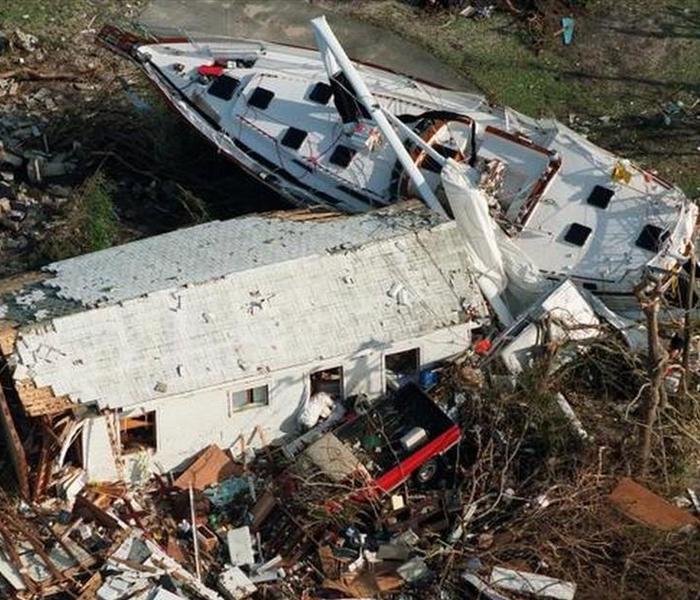 Storm surge from Hurricane Andrew swept cars, boats, and houses inland in South Miami-Dade County in 1992.
Storm surge from Hurricane Andrew swept cars, boats, and houses inland in South Miami-Dade County in 1992.
With about 22 million people vulnerable to dangerous hurricane storm surges, forecasters have long struggled over how to issue warnings, especially in low-lying Florida, where waters can rise far inland.
Now they have an interactive map that tracks flooding not only by location, but storm strength.
Published Thursday, the map for the first time links the coast from Texas to Maine, said Brian Zachary, a National Hurricane Center storm surge specialist. Forecasters used thousands of hypothetical hurricanes and factored in local coastal topography along with levees, canals and other structures to determine flooding.
In Florida, they found that about 40 percent of the population could face flooding in a powerful storm.
“Storm surge isn’t just, ‘I live on the coast. OK, I’m vulnerable,’” Zachary said. “It can go 10, 15 or 30 miles inland.”
The maps are an improvement on the disconnected grids forecasters had previously used that sometimes left the public confused. The new map lets users choose the strength size, then zoom in and out of locations, tracking flooding, which is measured at three, six and nine feet above ground.
Not surprisingly, only a narrow ribbon of coast south of downtown Miami is expected to flood in a Category 1 storm. But jump to a Category 5 hurricane and the south end of the county, including Kendall, Cutler Bay, Homestead, Florida City and all of the Everglades, would sit under six to nine feet of water. Under the same scenario farther north, the central part of the county stretches like a chain of ragged keys, with dry land forming a narrow corridor around Southwest Eighth Street between Miami and West Miami. The northern half of Miami-Dade and northern Broward County fare much better.
The map arrives just as a mostly quiet Atlantic hurricane season winds down. Rather than wait until next year, Zachary said forecasters decided to release it now to give residents more time to study it and contact local emergency managers for information on evacuation plans.
“This is for the general public to look at and say, ‘OK, I’m in a storm surge area and what should I do?’” Zachary said.
Prepping for Winter
11/5/2014 (Permalink)
For those who live in a nice warm climate that doesn't shift for the seasons, the coming of winter brings significantly fewer chores. However, those who live in changing climates can save some money by completing a few pre-winter chores.
Clean It
Starting the winter with a clean furnace will save fuel costs during the cold months. Make an appointment now to have your furnace or oil burner serviced before it starts working overtime during the cold weather. A cleaner furnace can save up to 5% of fuel costs over the course of the year compared to a dirty one.
Get out the ladder and the washrag and clean your spot lights. If your home has outdoor lighting, it has dust and dirt on its light globes. Clean them off now before the winter weather comes and they'll burn brighter all winter long when the days are shorter and the nights seem darker.
Seal It
Look over your home and make sure that cold air stays out and warm air stays in. Grab a tube of caulk as you take the walk and seal any openings around windows, doors, vents, and electrical wires. You'll also want to seal any openings to prevent mice from sneaking in to enjoy your warm winter air.
While walking around your home, tighten outside faucets and remove hoses. These could burst if the water in the pipe freezes. If possible, turn off the water to the faucet and let it open. That will guarantee that any remaining water drips out before the cold sets in.
Trim It
During ice storms, branches are pulled down by the weight of the ice. Before the winter arrives check for any dangerously low branches. If it looks like it might fall onto a car or a structure, consider trimming it before the ice brings it down. If you'd rather leave the branches intact, then take note of them and when the ice does arrive make a trip outside to knock some of the weight off the branch.
Cover It
Winter weather is hard on almost everything. If it fits in a shed or garage, then keep it there for the winter. If not, cover it with a tarp and tie it securely. Grills, patio chairs, and even garden statues can use protection from the ice and snow.
Plants are especially susceptible to the cold air that's anticipated. For newly planted shrubs, wrap them in burlap to protect them from the wind. If the wind really whips through a section of your property that has smaller plants, consider making a burlap windbreak by driving tall stakes into the ground and stapling burlap to each to make a "wall" in front of the plants.
When heavy ice, snow, or fallen branches come down, smaller plants are often crushed. Establish the location of these plants now and protect them from the onslaught. For a quick and efficient element of structural protection, try pushing a few tomato cages over tender plants. The cages will keep fallen branches off the plants, and they'll eliminate ice build-up from pulling stems to dangerous angles. Use the cages that are coming off your tomatoes now and then re-designate them in the spring to their original use.
Forecasters Hit The Mark on 2014 Atlantic Hurricane Season- El Nino among factors that results in fewer hurricanes
11/3/2014 (Permalink)
NEW ORLEANS —Philip Klotzbach and William Gray, the hurricane season forecasting team out of Colorado State and the National Oceanic and Atmospheric Administration got this hurricane season right. Both forecast a below-average or near-average hurricane season. That’s what we've had so far;
Two tropical storms (Dolly and Fay), four hurricanes (Arthur, Bertha, Cristobal and Fay) and two major hurricanes (Edouard and Gonzaolo.) The average is 12 storms, six hurricanes and three intense.
The reason less activity was forecast: El Nino was likely to develop. Remember El Nino is the warm water in the east tropical Pacific Ocean that causes strong upper-level winds that take the tops off of developing systems.
El Nino didn't develop. There were some other reasons, too, like cooler Atlantic water temperatures, wind shear and stronger trade winds.
The major players this year: dry Saharan dust, wind shear and strong upper-level lows. I can remember looking at the Atlantic Basin this summer and just seeing, dry sinking air. It was amazing!
Tropical systems need warm, moist air, warm sea surface temperatures, light winds aloft, converging surface winds and an area of rain and storms. That did not happen much this year.
What’s interesting is to see where the storms developed and then moved. From looking at the tracks, we obviously had the Atlantic high in the east Atlantic. We also had all those unusual July and August cold fronts moving off the East Coast of the United States protecting us from storms.
Hurricane Arthur is the only tropical system that hit the U.S., causing a wind gust of 101 mph at Cape Lookout, North Carolina. Arthur moved over the outer banks of North Carolina on July 4.
Bermuda got a double dose of trouble. First it was Hurricane Faye with winds of 80 mph, then a week later the eye of Gonzalo moved right over the island with winds of 110 mph.
It’s like Bermuda was the needle in the haystack. Just over 15 miles long and a mile and a half wide, two hurricanes found Bermuda in the middle of the Atlantic Ocean.
Tropical Storm Dolly moved onshore near Tampico and caused heavy rain. Tropical Storm Hanna hit the Honduras-Nicaragua boarder and caused heavy rain there. The Gulf Coast so far this year has been lucky.
Hurricane season ends Nov. 30. It can’t come soon enough!
Daylight Savings Time Reminder
10/31/2014 (Permalink)
Daylight Savings Time -By Phyllis McGinley
In spring when maple buds are red,
We turn the clock an hour ahead;
Which means, each April that arrives,
We lose an hour out of our lives.
Who cares? When autumn birds in flocks Fly southward, back we turn the clocks, And so regain a lovely thing
That missing hour we lost in spring.
A Friendly Reminder - Turn Your Clocks Back One Hour Before You Go To Sleep on Saturday, November 1.
They Covered What? You'll Never Believe These 11 Home Insurance Reimbursement Stories
10/29/2014 (Permalink)
By Tim Sprinkle
Home insurance coverage doesn't end at the structure itself. Furniture, rugs, clothes ... everything within the home is covered as well. And that's where things get interesting. When it comes to homeowner’s insurance claims, it's rarely a straightforward case of covered or not covered. Insurers often have to make judgement calls on reimbursements when faced with wildly unique situations. Insure.com recently gathered some of the more incredible homeowners insurance claims stories. Check out their top 10 below.
1. Eaten jewelry
"Although animals are typically excluded from coverage, I had a case where a dog allegedly ate a piece of jewelry and the insurance company wanted to buy the dog at an unbelievably high price. The insurance company claimed a right to salvage of the jewelry in the dog. This is typical to some property, like a car, if they pay for the value of the car," says Chip Merlin, president of Merlin Law Group in Tampa, Fla.
“After the owner refused, the insurance company continued in its claim that the dog with jewelry in it was salvage and demanded the dog be turned over. I don't know for certain what they were planning to do with the dog, but the insurer quickly backed down after a phone call from me. They paid for the lost jewelry, which may or may not have been sitting in the poor dog's stomach."
2. A relocated wedding
"Under the ‘loss of use’ coverage, an insured was supposed to have a wedding in their back yard for their daughter but because of a fire, they had to move it to a hotel. We ended up claiming the increased cost for having it at a hotel," recalls Diane M. Swerling, principal at Swerling Milton Winnick Public Insurance Adjusters Inc. in Wellesley Hills, Mass.
3. Interior designer fees
"Consumers might not know that they can ask for decorator fees, which are covered if the insured did use a decorator before,” says Dick Burr, director of claims at Young Adjustment Co. in Philadelphia. ”This can be quite a big expense that will be incurred again once repairs have been made, so we have requested reimbursement for interior design fees several times."
4. Beanie Babies
"People have asked for just about anything,” says Burr. “At one time, someone asked for $30,000 worth of Beanie Babies. We collected; however, today's new policies restrict that. We now have to deal with hoarders. That is another world when you walk in and there is nowhere to walk."
5. A dump truck
"We once got a full-size construction grade dump truck covered under personal property because it was not registered for the road and the person legitimately used it to move firewood to and from his wood-burning stove,” says Greg Raab, manager at Adjusters International in Utica, N.Y. “Per policy language, it was covered, just like ATVs or lawn mowers that are used for property maintenance would be."
6. Spoiled wine
Ron Reitz, a public insurance adjuster and president of Quality Claims Management Corp. in San Diego, recalls, "We had an interesting wine loss. The wine was heated to an approximate temperature of 85 degrees for a period of 10 days after a backup and overflow of a sewage pipe caused flooding and other damage.” The repair crew used heat to speed up the drying process.
“Of course the effect of heat on wine is not good. We had a challenging time convincing the insurer of the magnitude of the loss since we were essentially arguing the value was gone because the wine could not be sold in a secondary market and it was prematurely aged, but in the end, the client did get reimbursed."
7. Imported olive oil
"Expensive cooking ingredients such as imported olive oil are covered at full value, as long as the homeowner is not running a business out of the home (i.e. catering, etc.). So if you're shopping at Whole Foods, we recommend that you keep your receipts,” says Raab.
8. Pairs or sets
Losing one item in a pair or set doesn’t mean you have to live with a mismatched set.
"If one of a pair gets damaged, then both have to be replaced. I've seen this used to claim custom-made lanterns, antique candlesticks, etc.,” says Reitz. “I had a client who had some beautiful lighting on the walkway of their house. The lanterns were original and hard to replace, but one of them was damaged in a storm. Well, you can't just go out and buy one more, so the insurance company had to pay to replace both of them.”
9. Bug-repelling basement
"Years ago a client had a house fire at their 500-acre horse farm. He had pesticide stored in the basement before the fire. After the fire, I noticed that swarms of flies would come in to the basement and die almost immediately,” recalls Ronald Papa of National Fire Adjustment Co. in Amherst, N.Y. “We had experts from Cornell University examine the site. Although the shelf life of this chemical was only supposed to be six weeks, it turned out that when it was heated by the fire and it dissolved into the concrete, it remained potent for months. This was also toxic to humans. As a result, the house had to be demolished and rebuilt from the basement up."
10. Marijuana
"Our client thought of himself as a green thumb and took to growing marijuana plants in his attic. One day, the lamps got too hot, caught fire and took the whole home with them,” says Raizner. “The illegal plants were discovered after the blaze and the insurance company refused to pay for damages. Our client was charged in the incident but was able to plead the case down to a misdemeanor. The insurance policy [excluded] coverage for damage that resulted from the commission of a felony, so while they were a bit irked, the insurance company agreed to pay and the case was settled."
11. Security
"Security service for your damaged home is covered under building coverage,” says Burr. “These services can help keep out looters who may steal items and cause further damage to the property. The insurance company usually pays for this so it can be very beneficial to use these services."
Hurricane Sandy: After Two Years, $13.6 billion, FEMA Continues N.Y. Recovery
10/24/2014 (Permalink)
Reprinted from FEMA
NEW YORK—Since Hurricane Sandy made landfall Oct. 29, 2012, FEMA, in partnership with the federal family and state and local governments, has been on the scene helping individuals, government entities and eligible non-profits as New York recovers from the storm’s devastation.
FEMA has funded more than 3,500 Public Assistance projects including repairing and restoring hospitals, schools, transit venues, waterways, parks, beaches, marinas, water treatment plants and public buildings. A roster of services has been restored, including utilities critical to everyday life. Billions of federal dollars have been expended during the past two years.
The numbers below tell the story;
2 - It has been two years since Hurricane Sandy struck New York.
$13.6 billion - Total FEMA has already provided to New York.
$1 billion - The dollars given to help survivors get back on their feet with temporary housing assistance, disaster unemployment and other needs assistance.
$3.9 billion - Amount paid by FEMA to 53,288 policyholders for flood claims through its National Flood Insurance Program.
$5.5 billion -Total Public Assistance obligated to communities and certain non-profit organizations to help recover from Hurricane Sandy and includes:
•$620.6 million for debris removal
•$1.22 billion for emergency work
•$3.68 billion for permanent work
$1.7 billion - Added to permanent repair projects to protect against future damage.
$84.7 million- Through the Hazard Mitigation Grant Program to projects throughout the state to protect against future damage.
$1.5 billion - Small Business Administration loans for homeowners and businesses affected by the storm.
Fall Maintenance Tips - Prepare Your Home For Cooler Days Ahead
10/22/2014 (Permalink)
Fall foliage is beautiful, but not when it builds up in your gutters! Take these tips into account during the cool autumn months;
-Have your furnace cleaned and inspected annually by a qualified technician.
-Keep flammable materials, including all lawn and power equipment, away from water heaters and wiring in the basement.
-Insulate water pipes in areas exposed to cold temperatures, and turn up the thermostat during extra cold periods.
-Check for damage to your roof, and clean gutters and downspouts to keep debris from accumulating. (This is especially important during the fall season to keep leaves from building up in gutters.)
-Check and repair caulking around doors and windows that show signs of deterioration.
-Check caulking around showers, bathtubs, sinks and toilet bases; and make repairs as needed.
-Have your chimney cleaned and maintained annually by a professional.
-Clean and/or replace your furnace filter.
-Clean the clothes dryer exhaust duct and space under the dryer. Remove all lint, dust, and pieces of material.
-Check your electrical outlets for potential fire hazards such as frayed wires or loose-fitting plugs. Be sure not to overload electrical outlets, fuse boxes, extension cords or any other power service.
-Keep a multi-purpose fire extinguisher accessible, filled and ready for operation.
-Inspect your smoke detectors. Make sure there is one on each floor of your home. Test them monthly, and change the battery annually or as needed.
Prepare For Polar Vortex, Part II?
10/20/2014 (Permalink)
The Washington Post
If you’re wondering what this winter holds for the Mid-Atlantic, you need not look further than last winter, though not as prolonged, says Accuweather in their winter weather outlook.
“Cold air will surge into the Northeast in late November, but the brunt of the season will hold off until January and February,” they write. “The polar vortex, the culprit responsible for several days of below-zero temperatures last year, will slip down into the region from time to time, delivering blasts of arctic air.”
While this forecast may send shivers down your spine, there’s really something for everyone in the outlook.
Despite the polar plunges, Accuweather forecaster Paul Pastelok says it might not be as bad as the brutal winter of 2013-14, which was as prolonged as it was cold and snowy. The polar vortex may rear its ugly head a few times, but not unseasonably late. “I think, primarily, we’ll see that happening in mid-January into February but again, it’s not going to be the same type of situation as we saw last year, not as persistent,” Pastelok said.
Digging into the wintry details for the D.C. area, Pastelok thinks this season is not going to push in on the Spring months as much as last year, but will probably be colder. “This winter will be around a degree colder on the three month average December through February,” Pastelok said. “March may turn around as far as temperatures this coming year, but a set back possible in April which can be cooler. January still looks like the top month for storms, coldest period mid January through February.”
Of course, the question on everyone’s mind is what about the snow?
“Snowfall was over 30 inches last year,” Pastelok said. “We expect that amount to be nearly cut in half for Washington DC, higher amounts northwest of the District. Probably 15-20 [inches] for the District.” Though to the west of the I-95 corridor, Accuweather forecasts that snowfall amounts could be much higher than normal.
Elsewhere in the U.S., Accuweather is particularly concerned about the lingering warm sea surface temperatures in the Gulf of Mexico, which have not been cooled this year by a tropical cyclone. The warm Gulf water could provide extra fuel for winter storms in the south that could ride up the eastern seaboard.
In the Midwest, Accuweather forecasts winter temperatures to be seven to nine degrees warmer than last year, as well as below-normal snowfall totals. Specifically, they predict that both Chicago and Minneapolis will see below-average snowfall this winter.
Out West, Accuweather is suggesting that this winter’s snowfall will probably be enough to prevent the California drought from getting worse than it already is, but also says that after some December rain in northern California, the season will end up drier than normal.
In the Southwest, the potential for a weak El Nino could fuel higher than normal snowfall amounts. “That moisture source is needed to get above-normal snowfall for the region,” Pastelok said. “I do believe there are going to be periods where moisture gets in there.”
US Winter Forecast: Cold, Snow to Seize Northeast; Wintry Blasts to Slick South
10/17/2014 (Permalink)
By Jillian MacMath, AccuWeather.com Staff Writer
Though parts of the Northeast and mid-Atlantic had a gradual introduction to fall, winter will arrive without delay. Cold air and high snow amounts will define the season.
Farther south, ice storms and snow events will threaten the Tennessee Valley and parts of the southern Plains. Much of the South can prepare for a wet winter, with some severe weather encroaching on Florida.
The northern Plains will be somewhat inconsistent with variable, back-and-forth temperatures and below-normal snowfall. Meanwhile, the drought will persist in the Northwest and northern California and ease slightly farther south.
A breakdown of the AccuWeather.com 2014-2015 U.S. Winter Forecast can be found below.
Cold Northeast, Interior Mid-Atlantic to Yield Snowy Winter Season
After record-shattering temperatures and high snow totals last winter in the Northeast, a similar theme will continue into the 2014-2015 season.
Cold air will surge into the Northeast in late November, but the brunt of the season will hold off until January and February. The polar vortex, the culprit responsible for several days of below-zero temperatures last year, will slip down into the region from time to time, delivering blasts of arctic air.
"I think, primarily, we'll see that happening in mid-January into February but again, it's not going to be the same type of situation as we saw last year, not as persistent," AccuWeather.com Expert Long-Range Forecaster Paul Pastelok said.
"The cold of last season was extreme because it was so persistent. We saw readings that we haven't seen in a long time: 15- to 20-below-zero readings."
In addition to the cold air, a big snow season could be in the offing. Higher-than-normal snow totals are forecast west of the I-95 corridor.
"Places like Harrisburg, down to Hagerstown getting into the mountains, the Appalachians, I think that's where you're going to see your bigger, heavier amounts," Pastelok said.
Philadelphia, which received a whopping 68.9 inches last season, is forecast to close this season with snow totals just above normal. New York City will likely follow suit.
The I-95 corridor and eastward could fall victim to changeover systems, which will provide a messy wintry mix at times.
New Weather Model Will Improve Storm Forecasts
10/15/2014 (Permalink)
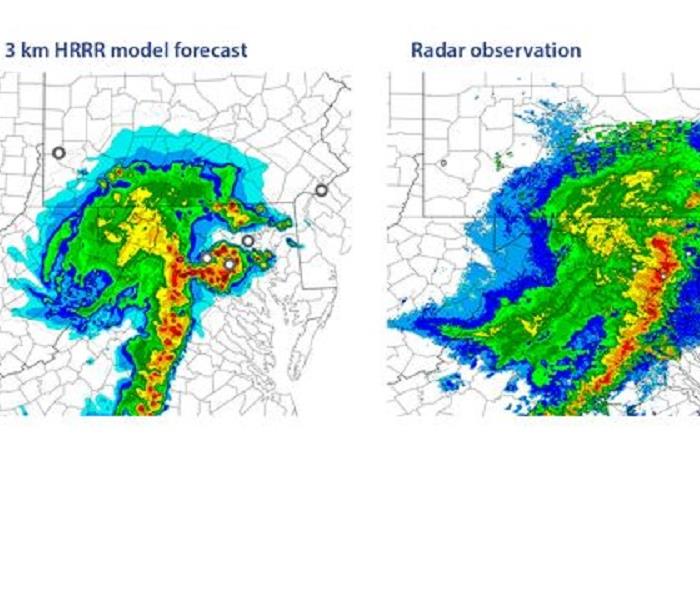 Twelve hours before the Washington, D.C., area experienced severe winds from a derecho, the High-Resolution Rapid Refresh (HRRR) model correctly predi
Twelve hours before the Washington, D.C., area experienced severe winds from a derecho, the High-Resolution Rapid Refresh (HRRR) model correctly predi
By Doyle Rice, USA Today
The National Weather Service put a new weather model into operation, a hyper-local program that promises to improve forecasts and warnings for severe weather. Weather models are complex computer programs that help forecasters analyze and predict the weather.
The weather service says the new one will be able to pinpoint neighborhoods under threat of tornadoes and hail, heavy precipitation that could lead to flash flooding or heavy snowfall -- and warn residents hours before a storm hits.
The High-Resoluton Rapid Refresh weather model is the first to include hourly updates as well as a visual resolution sharp enough to simulate individual thunderstorms, with grid points about 2 miles apart, the National Center for Atmospheric Research says.
The closer together the grid points, the better the chance of accurately predicting where it will rain. The HRRR has four times better resolution than previous weather models.
"HRRR will be updated hourly ... which is what's needed for predicting fast-changing storms and something not done before by the NWS," said Stan Benjamin, a meteorologist with the National Oceanic and Atmospheric Administration's Earth System Research Laboratory.
The model has been used experimentally for four years, including during the 2012 Washington, D.C., derecho -- a severe straight-line windstorm -- which it accurately predicted.
Is the new model all it's cracked up to be? Two scientists not affiliated with the weather service say yes:
"HRRR is a major advance for the National Weather Service and an important one," said Cliff Mass, a meteorologist at the University of Washington. "Large improvements are possible in short-term forecasting ... which we call nowcasting ... and HRRR is a substantial technological advance."
"HRRR is a unique and absolutely great tool for the energy industry, sports venues, transportation companies, etc., with countless applications for people and property affected by weather in the very near term," said meteorologist Ryan Maue of the private forecasting firm WeatherBell.
A caveat from Maue: "This is only one model representation using one set of physics and assumptions. There are countless configurations of the weather model that could generate drastically different forecasts ... As with any weather model, there will be monumental successes and busts."
"The human forecast is not going to be replaced, nor can we rely solely on computer generated forecasts for severe weather warnings or automated warnings," he added.
U.S. East Coast Cities Face Frequent Flooding Due to Climate Change
10/13/2014 (Permalink)
Cities on America’s East Coast could see triple the number of tidal floods by 2030 as sea levels rise.
Dozens of America’s East Coast cities face increasingly routine tidal flooding under climate change, researchers said on Wednesday.
Miami—where the denizens of South Beach are used to sloshing through water at high tide—will deploy new pumps this week to hold back the waters of the King Tides, the highest annual high tides, which are projected to crest at 3.5 feet.
Other cities are going to have to undertake similar measures if they want to avoid soggy streets in the future, the researchers said.
The report, Encroaching Tides: How Sea Level Rise and Tidal Flooding Threaten U.S. East and Gulf Coast Communities over the Next 30 Years, from the Union of Concerned Scientists (UCS), found that most of the towns on America’s East Coast will see triple the number of flooding events by 2030.
By 2045, those towns will see 10 times as many tidal floods—and those floods will seep further inland and last longer, the researchers said.
Many coastal towns already see dozens of small tidal floods every year, typically lasting only a few hours. But the frequency of such events is marching upwards because of sea-level rise, which at some points along the East Coast is more than twice the global average. Some East Coast towns have recorded four times as many flood days as in 1970, the report found.
Washington, D.C., which already experiences flooding from the Potomac river during hurricanes, will see chronic flooding—with 388 occurrences a year by 2045, according to the report.
Annapolis, Maryland; Lewisetta, Virginia; and Wilmington, North Carolina, will see more than 300 tidal floods a year. Miami—which now experiences about six tidal floods a year—will also get wetter.
“Further down the coast, Miami Beach, in 30 years, would experience more than 200 tidal floods a year,” said Erika Spanger-Siegfried, a UCS analyst and co-author of the report. “ Some could affect much of the art-deco historic district of South Beach ... Without serious intervention, frequent flooding will start to disrupt daily life and change the way an area functions.”
The researchers used National Weather Service flood advisories and records from 52 tide gauges in coastal towns from Portland, Maine, to Freeport, Texas, to make their projections.
In nearly all of the towns, tidal floods will be a regular occurrence, they found. By 2030, most of the towns could expect to see flooding in some areas 24 times a year. Some of those towns would see 48 floods a year.
The frequency of those floods will worsen over time, the researchers said. By 2045, half of the towns can expect to see more than 100 tidal floods a year. Nine of those towns would see tidal floods 240 times a year by 2045.
Those cities can also expect to spend more time underwater. By 2045, flood-prone areas of Wilmington, North Carolina, will spend more than 345 hours a year underwater. Baltimore’s Inner Harbor is projected to be underwater for more than 875 hours a year by 2045.
And the floods are also expected to worsen—with deeper waters penetrating further inland and threatening more property, the researchers found.
Atlantic Hurricane Season Weakest So Far Since '83
10/10/2014 (Permalink)
Associated Press
SAN JUAN, Puerto Rico — This year's Atlantic hurricane season is shaping up to be one of the weakest in decades with only five named storms formed in the region so far this year.
That's the fewest named storms formed during a single full season in the Atlantic since 1983, when there were four.
Forecasters have projected another two named Atlantic storms for the rest of the season that ends on Nov. 30. But there are no signs of any new ones spinning off Africa's west coast during what is usually the season's peak period — mid-August to late October.
"We've been very fortunate so far," said Dennis Feltgen, a meteorologist with the Miami-based National Hurricane Center.
"It was expected to be a less than average season, and so far, that's panning out," Feltgen said, noting the peak period is about to end. "It takes a big slide in November."
A typical June-November hurricane season has 12 named storms, nine of them hurricanes and three of those major.
The National Oceanic and Atmospheric Administration, which runs the U.S. Hurricane Center in Miami, in August revised its projection for this year's season, saying it expected only seven to 12 named storms. It originally had projected eight to 13 named storms, including three to six hurricanes.
Of the five named storms so far this year, four grew into hurricanes, one of them major. That one, Hurricane Edouard, barreled through open waters in mid-September, its 115-mph (185-kph) winds generating only strong waves that delighted surfers in the Caribbean and along the U.S. East Coast.
A weaker West African monsoon has caused an increase in wind shear and dry, sinking air, which in turn limited storm development this year, said Gerry Bell, lead seasonal hurricane forecaster for the National Oceanic and Atmospheric Administration's Climate Prediction Center.
"That combination really, really shuts the season down," he said.
Officials with the Caribbean Catastrophe Risk Insurance Facility said no member countries have requested help this year, with no storm or excessive rainfall policies being triggered.
While the Atlantic hurricane season has remained quiet, the Eastern Pacific season has roared this year with 17 named storms, eight of them major hurricanes.
Why Do Leaves Change Color?
10/8/2014 (Permalink)
Fall foliage is one of nature's most beautiful displays, but what makes it happen?
Between late August and early October, people across North America travel hundreds of miles to witness one of Mother Nature’s most beautiful pieces of artwork: fall foliage. A breathtaking natural spectacle, the wild splashes of red, orange, brown and yellow leaves racing up and down rolling hills and lining quaint neighborhoods have a certain homey nostalgia. Some places seem to have a tendency to produce more flamboyant versions of this natural artwork than others, and there's a good reason for it.
Those green leaves that we turn to for shade on hot summer days contain what is called chlorophyll. So much of this pigment is in the leaves that it masks the other pigments. Sunlight is one of the biggest factors in providing chlorophyll, so summer is when green leaves thrive. However, as light diminishes with the approach of autumn, so does the chlorophyll. This allows the other natural pigments, called carotenoids, to steal the show. The carotenoids come in yellow, brown, orange and a variety of hues in between.
There are other colors, however, that appear on leaves that weren't there before, and these are from anthocyanin pigments. Red and orange colors form due to an increase in sugar concentration in plants, typically occurring toward the end of summer. The more anthocyanins present in the leaves, the more burning reds you'll see on your next fall foliage trip.
Colder, northern climates tend to accelerate the process of chlorophyll decomposition. For instance, St. Paul, Minn., sees fall foliage peak in late September, but Tulsa Okla., likely sees it peak in early November. Temperature does affect leaf coloration to some degree, but it is not the determining factor. If it's a sunny autumn in your area, you'll see the brightest fall leaves.
If you live in an area with plenty of autumn sunshine and cool, crisp nights, expect a dazzling show this year. On the other hand, if the clouds just won't quit and the air remains a bit on the mild side, expect a more conservative presentation of duller yellows and browns.
5 quick facts about fall foliage
An increase in carbon-dioxide levels could further delay the onset of fall foliage colors in the coming years.
Leaves of some trees, such as birch, tulip poplar, redbud and hickory, are always yellow in the fall — never red.
Evergreen trees may shed their older leaves, which often turn bright yellow, in spring rather than fall, but they never drop all their leaves at one time. That's why they stay green all year.
The most vivid colors on tree leaves typically can be observed after a succession of very warm sunny days in autumn that in turn give way to cold, but not freezing, nights.
The most varied fall color, as well as the longest-lasting, occurs in areas such as the southern Appalachians, where a dozen or more kinds of trees may change color at slightly different times over the season.
About Fire Prevention Week
10/6/2014 (Permalink)
Since 1922, Fire Prevention Week has been observed on the Sunday through Saturday period in which October 9 falls.
Fire Prevention Week was established to commemorate the Great Chicago Fire, the tragic 1871 conflagration that killed more than 250 people, left 100,000 homeless, destroyed more than 17,400 structures and burned more than 2,000 acres. The fire began on October 8, but continued into and did most of its damage on October 9, 1871.
Commemorating a conflagration
According to popular legend, the fire broke out after a cow - belonging to Mrs. Catherine O'Leary - kicked over a lamp, setting first the barn, then the whole city on fire. Chances are you've heard some version of this story yourself; people have been blaming the Great Chicago Fire on the cow and Mrs. O'Leary, for more than 130 years. But recent research by Chicago historian Robert Cromie has helped to debunk this version of events.
The 'Moo' myth
Like any good story, the 'case of the cow' has some truth to it. The great fire almost certainly started near the barn where Mrs. O'Leary kept her five milking cows. But there is no proof that O'Leary was in the barn when the fire broke out - or that a jumpy cow sparked the blaze. Mrs. O'Leary herself swore that she'd been in bed early that night, and that the cows were also tucked in for the evening.
But if a cow wasn't to blame for the huge fire, what was? Over the years, journalists and historians have offered plenty of theories. Some blamed the blaze on a couple of neighborhood boys who were near the barn sneaking cigarettes. Others believed that a neighbor of the O'Leary's may have started the fire. Some people have speculated that a fiery meteorite may have fallen to earth on October 8, starting several fires that day - in Michigan and Wisconsin, as well as in Chicago.
The biggest blaze that week
While the Great Chicago Fire was the best-known blaze to start during this fiery two-day stretch, it wasn't the biggest. That distinction goes to the Peshtigo Fire, the most devastating forest fire in American history. The fire, which also occurred on October 8th, 1871, and roared through Northeast Wisconsin, burning down 16 towns, killing 1,152 people, and scorching 1.2 million acres before it ended.
Historical accounts of the fire say that the blaze began when several railroad workers clearing land for tracks unintentionally started a brush fire. Before long, the fast-moving flames were whipping through the area 'like a tornado,' some survivors said. It was the small town of Peshtigo, Wisconsin that suffered the worst damage. Within an hour, the entire town had been destroyed.
Nine decades of fire prevention
Those who survived the Chicago and Peshtigo fires never forgot what they'd been through; both blazes produced countless tales of bravery and heroism. But the fires also changed the way that firefighters and public officials thought about fire safety. On the 40th anniversary of the Great Chicago Fire, the Fire Marshals Association of North America (today known as the International Fire Marshals Association), decided that the anniversary of the Great Chicago Fire should henceforth be observed not with festivities, but in a way that would keep the public informed about the importance of fire prevention. The commemoration grew incrementally official over the years.
In 1920, President Woodrow Wilson issued the first National Fire Prevention Day proclamation, and since 1922, Fire Prevention Week has been observed on the Sunday through Saturday period in which October 9 falls. According to the National Archives and Records Administration's Library Information Center, Fire Prevention Week is the longest running public health and safety observance on record. The President of the United States has signed a proclamation proclaiming a national observance during that week every year since 1925.
Farmers Almanac Says . . . Another Frigid and Snowy Winter
10/3/2014 (Permalink)
Winter is coming, and it’s going to be as bitterly cold and snowy as last year’s, according to the 2015 edition of the Farmers’ Almanac, which went on sale this past month.
“Shivery and shovelry are back,” managing editor Sandi Duncan told the AP. “We’re calling for some frigid conditions, bitter conditions.”
The Associated Press reports the guide “forecasts colder-than-normal and wetter-than-usual weather for three-quarters of the country east of the Rocky Mountains.”
The 2014 edition's prediction of a “C-O-L-D” winter was spot-on, given the polar vortex. The editors even correctly called a snowstorm to hit at the same time the Super Bowl was taking place, although fortunately for the players and fans, it swept in hours after the game.
The Farmers’ Almanac has been published every year since 1818, and claims its predictions are accurate around 80% of the time. Those forecasts are based on a secret mathematical formula that reportedly considers factors modern meteorologists don’t pay much attention to, like sunspots, tidal action, and the position of planets.
Flood Safety and Preparedness
10/1/2014 (Permalink)
Flash flooding is a possibility in all 50 states, although people living in flood plains and by rivers or shoreline are uniquely vulnerable to regular flooding. While you may have time to prepare for flooding that builds slowly – such as a river overflowing its banks – flash floods can occur very quickly, and every year, flash flooding is responsible for more deaths than tornadoes, hurricanes or lightning. Here’s what to do before, during and after a flood.
Know emergency flood terms
- Flood watch: Flooding is possible.
- Flash flood watch: Flash flooding is possible.
- Flood warning: Flooding is happening now, or will soon.
Flash flood warning: A flash flood is occurring; seek higher ground (on foot) Making a plan
- An emergency kit is something everyone should have on hand, no matter your locale or the natural disasters your area is vulnerable to. The Federal Emergency Management Agency's Ready.gov can help you build one — with food, water, and essential supplies for 72 hours — fairly easily, as well as teach you where to store it and how to update it. If the idea of making your own kit is too daunting, you can buy an emergency preparedness kit put together by the American Red Cross.
- Plan an evacuation route with your family, and perform regular drills.
- Buy and install sump pumps with back-up power.
- Raise electrical switches, sockets, circuit breakers and wiring at least 12 inches above the highest projected flood elevation for your house.
- Install backflow valves or plugs in drains, toilets and other sewer connections, to keep floodwaters from entering.
- Fuel tanks, if torn free by flood water, can leak contaminants or cause other damage if swept downstream. Make sure fuel tanks are anchored.
If there’s a flood or flash flood watch
- Gather emergency supplies and tune into local media or the NOAA Weather Radio for updates.
- Review emergency plans with the household.
- Fill car with gas and place emergency kit inside car, or make arrangements with others for a ride
- Sanitize sinks and tubs, then fill with clean water. Fill plastic soda bottles and other containers with clean water.
- Bring lawn furniture, trash cans, grills and play equipment inside, or tie down outside.
- Gather medical records, identification cards, insurance cards and other documents, and place inside a waterproof container for transport during evacuation.
- Take livestock and family pets to a safe area (emergency shelters do not accept animals).
- Adjust refrigerator and freezer to the coldest possible temperature in case you lose power for an extended period.
If evacuation is ordered
- Never ignore an evacuation order.
- Take only essentials.
- Turn off utilities at the main power switch, and shut off the gas. Turn off electrical appliances.
- Don’t try to walk through flowing water, as even 6 inches of moving water can knock you down and drowning is the number-one cause of flood deaths.
Driving in a flood
- Don’t drive through a flooded area. You won’t always be able to tell how deep water is. Six inches of water is enough to cause stalling or loss of control. Many vehicles will float in just one foot of water, and two feet of water is enough to carry most vehicles away.
- Don’t drive around a barricade.
- Stick to evacuation routes, and don’t take short cuts.
- If you’re driving at night, be especially cautious.
Weather the storm
- If you aren’t ordered to evacuate, stay tuned to local media for weather updates.
- Even if you are instructed to stay at home, be prepared to evacuate if your house is damaged, of if you receive orders to do so.
When you return home
- Turn off your electricity when you return home.
- Watch for animals and snakes that have been washed out during the flood.
- Look for hazards before you step – flood debris can be dangerous.
- Check for gas leaks before lighting candles or using any open flame.
- Clean everything – including yourself – that has gotten wet. You don’t know what chemicals and other hazards are in the flood water.
- If your power has gone out, never use a generator indoors, because deadly levels of carbon monoxide can build up quickly in small spaces and remain dangerous for hours.
14 Ways to Prepare for Fire Prevention Month
9/29/2014 (Permalink)
Reprinted from SafetySmart.com
Though most of us need a careful balance of caffeine, sleep, food, exercise, and regular installments of our favorite TV shows to get by, fire only needs three elements– heat, fuel, and oxygen — to come to life and wreak more destruction than Gallagher at a farmer’s market. October is National Fire Prevention Month, so there’s no better time than now to evaluate your emergency preparedness. Workplace fires can result in loss of life, loss of jobs, and loss of property. But by taking these 14 precautions, you can make sure that a fire-related emergency is something that you’ll likely never have to worry about. Get ahead of Fire Prevention Month and use this as checklist to evaluate your workplace:
1. Know your fire extinguishers! One size does not fit all – in fact, using the wrong fire extinguisher during an emergency can quickly turn a small flame into a big emergency.
2. Test your smoke alarms. Batteries should be changed at least once a year.
3. Do a fire drill and establish an employee meeting place. Make sure you have emergency plans in place and that all exits are visible and accessible. Also ensure that workers with mobility challenges are assigned a helpful coworker to assist them in the event of an emergency.
4. Check your electrical outlets. Don’t overload electrical circuits.
5. Keep heat producing appliances away from flammable materials – this includes coffee makers, copy machines, and space heaters.
6. Check your electrical cords. If they have been damaged (or give off mild electrical shock), replace them immediately.
7. Make sure you have metal containers available for the disposal and storage of oily rags.
8. Designate safe areas for employees who smoke. Never smoke in storerooms or near chemical storage areas. Make sure that receptacles are available for the safe disposal of cigarettes.
9. If you have equipment that delivers mild electrical shock when energized, don’t use it! Also refrain from using equipment that gives off unusual heat or smells odd. If in doubt have it checked and repaired or replaced.
10. To help prevent fires that occur as a result of arson, lock up your workplace after hours and report suspicious behavior. Never leave combustible material outside of your building.
11. Check for blockages – make sure that clutter isn’t blocking your access to emergency equipment and fire exits. Signs posted on walls and doorways may also be blocked by stacked items. Make sure all emergency signs are visible.
12. Check that your alarm system includes voice communication or sounds, like bells, whistles, or horns. Ensure that your workers are familiar with its sound. Review your alarm system and evacuation plan whenever it is changed.
13. Post reporting instructions and local fire department codes on information boards, common areas, and near telephones.
14. Talk about the importance of sleep and encourage workers not to perform risky jobs while fatigued. It’s much easier to make mistakes when you’re sleep-deprived. You could leave an appliance plugged in, forget to properly store an oily rag, or make a dangerous mistake. Make sure you and your colleagues get the rest you need so you can stay alert at work.
Hurricane Edouard Right Environment for Drone Test
9/26/2014 (Permalink)
MIAMI (AP) — Hurricane Edouard was the perfect environment to test new data-collecting drones because the storm was strong, had a well-defined eye and never threatened land, U.S. government scientists said.
Four drones called Coyotes — shaped like thin missiles with retractable wings — were launched into the hurricane, even as Edouard had 115 mph winds far out in the Atlantic. The drones collected data from parts of the storm that were too low for a hurricane hunter plane to safely fly in.
Researchers had been hoping for this type of hurricane to test the drones' durability.
"The stars lined up," said Joe Cione of the National Oceanic and Atmospheric Administration's Hurricane Research Division in Miami. "It was strong, we knew where it was going, we had a deployment point where we could get in and out easily."
Researchers hope the drones will help them better understand what makes some storms strengthen while others fizzle. Having that information while a storm is still far offshore could help officials better plan for evacuations or storm surge risks.
It was the first time that the drones have been dropped into a hurricane. The 3-foot-long, 7-pound devices stayed in the hurricane for up to an hour, transmitting temperature, pressure and wind observations before falling to the ocean. The drones are covered with sensors and have a small motor on them. They are maneuvered by computer software. They can be used only once.
Scientists also drop canisters filled with electronics to transmit data as they fall to the ocean, but they remain airborne for only a few minutes. Cione said those devices deliver snapshots compared to the lengthy transmissions sent back by the drones.
National Hurricane Center forecasters and other scientists will spend months analyzing the data transmitted by the drones. The preliminary results were potential game changers, Cione said.
One drone followed air currents through the storm. Another drone launched into Edouard's calm eye was directed into the intense eyewall in a maneuver that Cione likened to merging onto a busy highway.
"There's no other device that can do that," he said by phone from Bermuda, where the drone-bearing hurricane hunter flights originated. "It orbited the eyewall, and we've never measured anything like that."
Some technical kinks with the communications systems need to be worked out and funding needs to be secured before the drones can become a regular part of the hurricane hunter operations. Cione hopes to secure funding to test a few more drones next year.
NOAA got a handful of the drones this year to test during the peak of hurricane season, thanks federal funding after Hurricane Sandy.
Polar Vortex to Return Early in the Northeast
9/24/2014 (Permalink)
While the fall will kick off with days of sunshine and temperatures above normal in some of the region's largest cities, including New York City and Philadelphia, the polar vortex may make its return for short, sporadic periods in September.
"The vortex could slip at times, maybe even briefly in September for the Northeast," AccuWeather Lead Long-Range Forecaster Paul Pastelok said. "There could be a significant shot of chilly air that comes across the Great Lakes region and into the interior Northeast sometime in mid- to late-September."
As conditions in northern Canada begin to set up similar to last fall, getting colder and unsettled quickly, it is likely that this pattern could become a source for colder air to make its way down at times into the United States, inducing a drop in temperatures for the interior Northeast during mid-fall.
"Temperatures will not be as extreme in November when compared to last year, but October could be an extreme month," Pastelok said.
After short-lived days of the polar vortex in September, the weather should turn a bit warmer in November as rain ramps up across areas from New York City to Boston and Portland, Maine, as well as the rest of the region.
"We will see some dry weather in the Northeast, barring any tropical systems, in September and October but in November it will get wet," Pastelok said.
Following a soaking November for Northeastern residents, El Niño will make its debut early this winter, fueling early winter snow across the area.
"December could get kind of wild due to the very active southern jet stream that is going to provide the moisture for bigger snowstorms," Pastelok said. "The Northeast could have a couple of big storms in December and early January."
Proud To Share Our 2nd Testimonial From Nat Grid!
9/22/2014 (Permalink)
September 19, 2014
Dear Debbie,
After some years, I would like to take the time out to Thank You and your Team.
I cannot tell you enough how happy with are with your Service. Dan and his staff have constantly impressed us with this cooperation, professionalism and quality of work on every project we have given you.
In addition to the quality, the timeliness and customer service has always been outstanding. I get nothing but wondrous compliments and positive reviews from our employees who have first hand interaction with your team.
Thank You for your commitment, reliability and fine work. We look forward to working together with SERVPRO of Great Neck / Port Washington for years to come.
Keep up the good work and thanks again for all your efforts.
nationalgrid
Facilities Management
Hicksville, NY
SERVPRO Great Neck / Port Washington - The Value of an ERP (Testimonial)
9/19/2014 (Permalink)
September 15, 2014
Thank you for taking the time to pull together an Emergency Profile for each of our buildings in the East Williston School District. I think it was a worthy project and I look forward to keeping it updated each year.
As I mentioned, one of our custodians has been in his building for 25 years. When he plans his retirement, I can rest easy that I have the information that I need to train the new custodian without having to stress. This is a smart feature that I will bring to the attention of my peers when we meet.
I also appreciated reviewing my emergency information with you as I could see that there was some information that was not as up to date as I would like. I like the fact that you will revisit this review with me on a yearly basis. I think it is a good idea.
The fact that I have all of this available to me from my phone and computer is fantastic. Like you said, I can't imagine how I will use it, but in the right circumstances, it can be a game changer. What I still marvel at is that it's free!
Thanks again and I will do my best to share this information with other Directors who have not yet taken advantage of this program. It truly is a no-brainer.
Sincerely, Nicholas W. Fusco Director of Facilities & Operations East Williston School District
What Makes The Seasons Change?
9/18/2014 (Permalink)
Many people look forward to changing seasons: the brilliant colors of fall, gentle snows of winter, fragrant blossoms of spring and sunbathing days of summer. The rhythm of winter to summer and back again is so predictable that few stop to remember why this happens.
While the Earth’s orbit around the sun is a key player in making sure the seasons change, the most important aspect is the tilt of our planet's axis of rotation, which comes to about 23.5 degrees. The tilt is always there, but as Earth makes its laps around the sun, the amount of daylight we receive varies.
So why is the Earth tilted in the first place? Most of our planet's landmass and ice buildup is in the Northern Hemisphere, making it a bit top-heavy. If it weren't for the tilt, our seasons would have very little variation, making fall, winter, spring and summer somewhat one-note.
In a Northern Hemisphere summer, the planet is oriented toward the sun and receives enough solar radiation to thaw out and warm things up. While this is happening, the Southern Hemisphere experiences less solar penetration and colder temperatures, thus inaugurating its winter. Six months later, thanks to the Earth's orbit, the opposite is true. In between these two dominant seasons come spring and autumn, which help serve as a healthy transitional period.
3 quick facts about the changing seasons:
Other planets in our solar system also tilt at various degrees. Uranus rotates almost sideways at 97 degrees and has extreme seasons. The axial tilt on Venus is 177.3 degrees, causing very little variation to the seasons.
Earthquakes can shift the Earth's axis, but only by an infinitesimal proportion.
Earth is decreasing in obliquity, or tilt. An increase in tilt can lead to ice-age conditions, while a decrease in tilt can warm the Earth's surface.
Stay Prepared: Hurricane Season Doesn’t End with Summer
9/15/2014 (Permalink)
Eatontown, N.J. -- Hurricane season officially begins each year on June 1, but unlike firemen’s fairs, cookouts and fun at the beach, the season for hurricanes doesn’t end along with the summer.
As a new school year begins, now may be a good time to check your stock of batteries, bottled water and other emergency supplies that may be needed should New Jersey experience an autumn hurricane.
While storm frequency tends to peak in August and September, hurricane season in the United States extends to November 30, and while the risk of a Thanksgiving storm may seem remote, it could happen.
In 2012, Superstorm Sandy only missed it by a few weeks.
Sandy made landfall in New Jersey as a tropical cyclone on October 29, flooding coastal communities, taking down trees, tearing up infrastructure and demolishing homes and businesses throughout the state. Forty New Jersey residents lost their lives.
Two years later, the ongoing expenses of repair, rebuilding and recovery from Sandy have made it the second costliest storm in United States history after Katrina, an August 29 storm that devastated New Orleans and the Gulf Coast in 2005.
Like Sandy, many of the most destructive storms in United States history have occurred after Labor Day, causing massive loss of life and property damage in the billions.
On September 8, 1900, a category 4 hurricane engulfed Galveston Island, Texas. Storm tides as high as 15 feet swept away homes and businesses, killing an estimated 8,000 people.
On September 18, 1920, a category 4 hurricane bearing the highest sustained winds ever recorded at that time slammed into Miami Beach and downtown Miami. Believing the storm was over, thousands of people emerged from their homes during a half-hour lull at the eye of the storm and were trapped without shelter as it regained its ferocity. Every building in downtown Miami was either damaged or destroyed and hundreds of people were killed. The storm then crossed into the Gulf of Mexico, where it destroyed virtually every pier, vessel and warehouse on the Pensacola coast.
In the end, more than 800 people were reported missing after the storm and though records are incomplete, the Red Cross recorded 373 deaths and 6,381 injuries as a result of the hurricane.
On September 20 and 21, 1938, a fast-moving hurricane struck the Mid-Atlantic and New England with such force that thousands of people were taken by surprise. On Long Island, some 20 people watching an afternoon movie at a local cinema were swept out to sea and drowned. One of the victims was the theater’s projectionist. In downtown Providence, Rhode Island, flood waters rapidly flooded streets, submerging automobiles and street cars as their occupants fled to the high floors of office buildings to escape drowning. The record-breaking storm was responsible for 600 deaths, causing $308 million in damage in the midst of the Great Depression.
On October 14, 1954, Hurricane Hazel made landfall as a Category 4 hurricane near Calabash, North Carolina, inundating the coastline with an 18-foot storm surge on a lunar high tide. When the storm passed, only 5 of 357 buildings in Long Beach, North Carolina were still standing. The Raleigh, North Carolina Weather reported that “all traces of civilization on the immediate waterfront between the state line and Cape Fear were practically annihilated." Nineteen people were killed in North Carolina, with several hundred more injured; 15,000 homes were destroyed and another 39,000 were damaged.
On September 11, 1960, Hurricane Donna barreled across Florida, then traveled east through North Carolina, the Mid-Atlantic states and New England, causing $387 million in damage in the United States and $13 million elsewhere along its path.
Accounts like the ones above illustrate the importance of making a plan to protect your family and property from the potentially devastating effects of a hurricane or tropical storm.
With that in mind, why not take a minute to inventory your emergency supplies and schedule a trip to the store to stock up on items that you may need in an emergency.
The Federal Emergency Management Agency’s website, www.ready.gov, has as wealth of information on how to plan, prepare and protect your family should another disaster like Sandy occur in the coming months.
FEMA's mission is to support our citizens and first responders to ensure that as a nation we work together to build, sustain, and improve our capability to prepare for, protect against, respond to, recover from, and mitigate all hazards.
Be Ready, National Preparedness Month is Here! Series Final - Maintain a Healthy State of Mind
9/12/2014 (Permalink)
September 2014 marks the eleventh annual National Preparedness Month, sponsored by the Federal Emergency Management Agency in the US Department of Homeland Security. One goal of Homeland Security is to educate the public about how to prepare for emergencies, including natural disasters, mass casualties, biological and chemical threats, radiation emergencies, and terrorist attacks.
Everyone has their own ways of dealing with stressful situations. Resilience—the ability to adapt well to life's ups and downs—can help manage stress and feelings of anxiety. Everyone can develop resilience. It involves thoughts and actions that can be learned and practiced over time.
Anyone who experiences a disaster is affected by it, whether directly or indirectly through location, family or friends, or exposure to media coverage of the event.
Even if a disaster, such as a terrorist act, produces little physical damage, it can bring fear, confusion, and uncertainty into daily life. Strong and varied emotional reactions to such an event are natural. People are resilient and able to recover from difficult experiences.
Given the uncontrollable nature of disasters, some people question whether they can take steps to plan for catastrophic events. Actually, we know that the more people prepare for the unexpected, the better they manage these situations.
Be Ready, National Preparedness Month is Here! Series - Part 4 - Understand Quarantine and Isolation
9/11/2014 (Permalink)
September 2014 marks the eleventh annual National Preparedness Month, sponsored by the Federal Emergency Management Agency in the US Department of Homeland Security. One goal of Homeland Security is to educate the public about how to prepare for emergencies, including natural disasters, mass casualties, biological and chemical threats, radiation emergencies, and terrorist attacks.
People can be infected with dangerous diseases in a number of ways. Some germs, like those causing malaria, are passed to humans by animals. Other germs, like those that cause botulism, are carried to people by contaminated food or water. Still others, like the ones causing measles, are passed directly from person to person. These diseases are called "contagious".
Contagious diseases that pose a health risk to people have always existed. While the spread of many of these diseases has been controlled through vaccination and other public health efforts, avian influenza ("bird flu") and terrorist acts worldwide have raised concerns about the possibility of a disease risk. That makes it important for people to understand what can and would be done to protect the public from the spread of dangerous contagious diseases.
The CDC applies the term "quarantine" to more than just people. It also refers to any situation in which a building, conveyance, cargo, or animal might be thought to have been exposed to a dangerous contagious disease agent and is closed off or kept apart from others to prevent disease spread.
The Centers for Disease Control and Prevention (CDC) is the U.S. government agency responsible for identifying, tracking, and controlling the spread of disease. With the help of the CDC, state and local health departments have created emergency preparedness and response plans. In addition to early detection, rapid diagnosis, and treatment with antibiotics or antivirals, these plans use two main traditional strategies —quarantine and isolation— to contain the spread of illness. These are common health care practices to control the spread of a contagious disease by limiting people's exposure to it.
The difference between quarantine and isolation can be summed up like this:
Isolation applies to persons who are known to be ill with a contagious disease.
Quarantine applies to those who have been exposed to a contagious disease but who may or may not become ill.
Definitions
Infectious disease: a disease caused by a microorganism and therefore potentially infinitely transferable to new individuals. May or may not be communicable. Example of non-communicable is disease caused by toxins from food poisoning or infection caused by toxins in the environment, such as tetanus.
Communicable disease: an infectious disease that is contagious and which can be transmitted from one source to another by infectious bacteria or viral organisms.
Contagious disease: a very communicable disease capable of spreading rapidly from one person to another by contact or close proximity.
Be Ready,National Preparedness Month is Here! Series Part 3 - Learn to Shelter in Place
9/10/2014 (Permalink)
September 2014 marks the eleventh annual National Preparedness Month, sponsored by the Federal Emergency Management Agency in the US Department of Homeland Security. One goal of Homeland Security is to educate the public about how to prepare for emergencies, including natural disasters, mass casualties, biological and chemical threats, radiation emergencies, and terrorist attacks.
#3 Learn How to Shelter in Place
"Shelter-in-place" means to take immediate shelter where you are—at home, work, school, or in between. It may also mean "seal the room;" in other words, take steps to prevent outside air from coming in. This is because local authorities may instruct you to "shelter-in-place" if chemical or radiological contaminants are released into the environment. It is important to listen to TV or radio to understand whether the authorities wish you to merely remain indoors or to take additional steps to protect yourself and your family.
How do I prepare?
At home
Choose a room in advance for your shelter. The best room is one with as few windows and doors as possible. A large room, preferably with a water supply, is desirable—something like a master bedroom that is connected to a bathroom.
Contact your workplaces, your children's schools, nursing homes where you may have family and your local town or city officials to find out what their plans are for "shelter-in-place."
Find out when warning systems will be tested. When tested in your area, determine whether you can hear or see sirens and/or warning lights from your home.
Develop your own family emergency plan so that every family member knows what to do. Practice it regularly.
Assemble a disaster supplies kit that includes emergency water and food supplies.
At work
Help ensure that the emergency plan and checklist involves all employees. Volunteers or recruits should be assigned specific duties during an emergency. Alternates should be assigned to each duty.
The shelter kit should be checked on a regular basis. Duct tape and first aid supplies can sometimes disappear when all employees know where the shelter kit is stored. Batteries for the radio and flashlight should be replaced regularly.
In general
Learn CPR, first aid and the use of an automated external defibrillator (AED). (Contact your local American Red Cross chapter for more information.)
How will I know when I need to "shelter-in-place"?
Fire or police department warning procedures could include:
"All-Call" telephoning - an automated system for sending recorded messages, sometimes called "reverse 9-1-1".
Emergency Alert System (EAS) broadcasts on the radio or television.
Outdoor warning sirens or horns.
News media sources - radio, television and cable.
NOAA Weather Radio alerts.
Residential route alerting - messages announced to neighborhoods from vehicles equipped with public address systems.
Facilities that handle potentially dangerous materials, like nuclear power plants, are required to install sirens and other warning systems (flash warning lights) to cover a 10-mile area around the plant
Be Ready, National Preparedness Month is Here! Series Part 2 - Gather Emergency Supplies
9/9/2014 (Permalink)
September 2014 marks the eleventh annual National Preparedness Month, sponsored by the Federal Emergency Management Agency in the US Department of Homeland Security. One goal of Homeland Security is to educate the public about how to prepare for emergencies, including natural disasters, mass casualties, biological and chemical threats, radiation emergencies, and terrorist attacks.
If a disaster strikes your community, you might not have access to food, water, or electricity for some time. Take steps now to put together an emergency supply kit so that you will be prepared in case something happens. You should have emergency kits for your home, office, school, and vehicle. You never know where you will be during an emergency.
Emergency Supply Kit
TIPS
- Consider storing two weeks worth of food supplies. You may be able to use many of the canned goods and dry mixes already in your cupboard.
- Store at least a 3-day supply of water for each member of your family – that means 1 gallon per person per day.
- Don’t forget about pets; they’ll need food and water too.
- Learn where your gas, electric, and water shut-off locations are and how to turn them off.
An emergency supply kit is a collection of basic items that you might need during an emergency. It's good to involve whoever is going to use the kit, including children, in assembling it.
Assemble the following items to create kits to use at your home, office, and school and/or in a vehicle:
- Water—one gallon per person, per day
- Food—nonperishable, easy-to-prepare items
- Flashlight
- Battery powered or hand crank radio (NOAA Weather Radio, if possible)
- Extra batteries
- First aid kit
- Medications (7-day supply), other medical supplies, and medical paperwork (e.g., medication list and pertinent medical information)
- Multipurpose tool (e.g., Swiss army knife)
- Sanitation and personal hygiene items
- Copies of personal documents (e.g., proof of address, deed/lease to home, passports, birth certificates, and insurance policies)
- Cell phone with chargers
- Family and emergency contact information
- Extra cash
- Emergency blanket
- Map(s) of the area
- Extra set of car keys and house keys
- Manual can opener
Special Needs
You may need some additional supplies to meet the needs of all family members, such as children, pets, and those with special medical requirements. Suggested items to help meet additional needs are:
- Medical supplies (e.g., hearing aids with extra batteries, glasses, contact lenses, syringes, or a cane)
- Baby supplies (e.g., bottles, formula, baby food, and diapers)
- Games and activities for children
- Pet supplies (see expanded list below)
Once you’ve gathered your supplies, pack the items in easy-to-carry containers, clearly label the containers, and store them where they are easily accessible. In a disaster situation, you may need access to your emergency supply kit quickly - whether you are sheltering at home or evacuating. Make sure to check expiration dates on food, water, and batteries throughout the year.
Involving Children
Involving children is the first step in helping them know what to do in an emergency. There are many ways children can help.
- Ask them to think of items that they would like to include in an emergency supply kit, such as books or games or nonperishable food items. Ask them to help you remember to keep the kits updated.
- Children can help mark the dates on a calendar for checking emergency supplies. Remember to rotate or replace emergency food and water every six months and replace batteries as necessary.
- Children can also help prepare plans and disaster kits for family pets.
Disaster Supply Checklist for Pets
- Food and water for at least 3 days for each pet; bowls, and a manual can opener.
- Depending on the pet you may need a litter box, paper towels, plastic trash bags, grooming items, and/or household bleach.
- Medications and medical records stored in a waterproof container.
- First aid kit with a pet first aid book.
- Sturdy leash, harness, and carrier to transport pet safely. A carrier should be large enough for the animal to stand comfortably, turn around, and lie down. Your pet may have to stay in the carrier for several hours.
- Pet toys and the pet's bed, if you can easily take it, to reduce stress.
- Current photos and descriptions of your pets to help others identify them in case you and your pets become separated, and to prove that they are yours.
- Information on feeding schedules, medical conditions, behavior problems, and the name and telephone number of your veterinarian in case you have to board your pets or place them in foster care.
Be Ready, National Preparedness Month is Here! Series - Part 1 - Developing a Family Disaster Plan
9/8/2014 (Permalink)
Would you be ready if there were an emergency? Throughout September there will be activities across the country to promote emergency preparedness. More than 3,000 organizations – national, regional, and local public and private organizations – are supporting emergency preparedness efforts and encouraging all Americans to take action.
September 2014 marks the eleventh annual National Preparedness Month, sponsored by the Federal Emergency Management Agency in the US Department of Homeland Security. One goal of Homeland Security is to educate the public about how to prepare for emergencies, including natural disasters, mass casualties, biological and chemical threats, radiation emergencies, and terrorist attacks.
Developing a Family Disaster Plan
Families can cope with disasters by preparing in advance and working together as a team. If something were to happen, how would you contact one another, how would you get to a safe place, and what would you do in different emergency situations? Planning what to do before a disaster strikes provides the best protection for you and your family.
Create a Family Communication Plan
Because you and your family may not be together when a disaster hits, it’s important to create a communication plan to help you and your loved ones connect and get help. Complete a contact card for each family member. Have them keep these cards handy in a wallet, purse, or backpack.
More Tips:
- Identify an out-of-town contact, such as a friend or relative, who family members can call to let them know they are safe. It may be easier to make a long-distance phone call than to call across town, because phone lines can be jammed. An out-of-town contact may be in a better position to communicate among separated family members.
- Teach your family members how to text. It may seem like second nature to some of us, but not everyone texts. During an emergency it’s often easier to get a text message delivered rather than a phone call.
- Subscribe to an Emergency Alert System. Check with your local health department or Emergency Management Agency to see if there is one offered for your area. Post emergency telephone numbers by home phones or save them in your cell phone (fire, police, ambulance, etc.).
- Teach children how and when to call 911 for help.
Study Links Polar Vortex Chills to Melting Sea Ice
9/4/2014 (Permalink)
WASHINGTON (AP) — A new study says that as the world gets warmer, parts of North America, Europe and Asia could see more frequent and stronger visits of cold air as the world gets warmer.
Researchers say that's because of shrinking ice in the seas off Russia. Less ice would let more energy go from the ocean into the air, and that would weaken the atmospheric forces that usually keep cold air trapped in the Arctic.
But at times it escapes and wanders south, bringing with it a bit of Arctic super chill.
That can happen for several reasons, and the new study suggests that one of them occurs when ice in northern seas shrinks, leaving more water uncovered.
Normally, sea ice keeps heat energy from escaping the ocean and entering the atmosphere. When there's less ice, more energy gets into the atmosphere and weakens the jet stream, the high-altitude river of air that usually keeps Arctic air from wandering south, said study co-author Jin-Ho Yoon of the Pacific Northwest National Laboratory in Richland, Washington. So the cold air escapes instead.
That happened relatively infrequently in the 1990s, but since 2000 it has happened nearly every year, according to a study published Tuesday in the journal Nature Communications. A team of scientists from South Korea and United States found that many such cold outbreaks happened a few months after unusually low sea ice levels in the Barents and Kara seas, off Russia.
The study observed historical data and then conducted computer simulations. Both approaches showed the same strong link between shrinking sea ice and cold outbreaks, according to lead author Baek-Min Kim, a research scientist at the Korea Polar Research Institute. A large portion of sea ice melting is driven by man-made climate change from the burning of fossil fuels, Kim wrote in an email.
Sea ice in the Arctic usually hits its low mark in September and that's the crucial time point in terms of this study, said Mark Serreze, director of the National Snow and Ice Data Center in Boulder, Colorado. Levels reached a record low in 2012 and are slightly up this year, but only temporarily, with minimum iceextent still about 40 percent below 1970s levels, he said.
Yoon said that although his study focused on shrinking sea ice, something else was evidently responsible for last year's chilly visit from the polar vortex.
In the past several years, many studies have looked at the accelerated warming in the Arctic and whether it is connected to extreme weather farther south, from heatwaves to Superstorm Sandy. This Arctic-extremes connection is "cutting edge" science that is hotly debated by mainstream climate scientists, Serreze said. Scientists are meeting this week in Seattle to look at the issue even more closely.
Kevin Trenberth, climate analysis chief at the National Center for Atmospheric Research in Boulder, is skeptical about such connections and said he doesn't agree with Yoon's study. His research points more to the Pacific than the Arctic for changes in the jet stream and polar vortex behavior, and he said Yoon'sstudy puts too much stock in an unusual 2012.
But the study was praised by several other scientists who said it does more than show that sea ice melt affects worldwide weather, but demonstrates how it happens, with a specific mechanism.
Katharine Hayhoe, a Texas Tech climate scientist in Lubbock, said the study "provides important insight into the cascading nature of the effects human activities are having on the planet."
SERVPRO of Great Neck / Port Washington - TOP TEN Volume Leader!
9/2/2014 (Permalink)
The Results Are In!
Thank you for making SERVPRO of Great Neck / Port Washington a TOP TEN Volume Leader Franchise (July 2014) for the Southern New England and New York Region!
September is National Preparedness Month
9/2/2014 (Permalink)
Make Plans to Protect Your Family and Property
A few days ago the San Francisco Bay area experienced its strongest earthquake in 25 years, earlier this month Hawaii suffered damage from rare twin tropical storms, and over the course of two days in April, states from Nebraska to North Carolina were impacted by nearly 40 tornadoes. These severe weather events highlight the importance of understanding the types of disasters that are likely to occur and preparing for them.
National Preparedness Month (NPM) starts September 1, 2014, and residents are urged to take action by making an emergency plan for their family and practicing it on a regular basis. Test how you’re doing with natural disaster preparation and financial preparedness.
4 Action Steps for National Preparedness Month
1. Make a Plan Based on Your Hazards
Emergency planners suggest that you discuss the types of hazards such as earthquake, flooding, hurricanes, tornadoes or wildfires that could affect your area. Determine escape routes and establish at least two meeting places. One could be right outside your home in the event of a house fire, but also establish a location outside of your neighborhood in case you cannot return home or if you are asked to evacuate. Be sure to practice your plan twice a year and ensure everyone understands their responsibilities and works together as a team. As part of your plan you should also identify family members and friends you will contact before, during and after a disaster. The Red Cross and FEMA have apps that can help with disaster planning and response.
2. Make a Plan so Your Belongings are Fully Protected
While you’re making plans to protect your family, be sure to have a plan to protect your property too. Insurance is the foundation for keeping a family’s economic safety net strong, so it is vital that you have the right coverage to meet your individual needs. Talk with your agent or insurance company and they can assist you in determining what is right for you. By conducting an annual review of your insurance policy you can help ensure that your home and belongings are fully protected. This review provides you with the opportunity to address potential gaps in coverage. Additionally it enables you to talk with your insurance company or agent, ask questions and gain a better understanding regarding your coverage.
3. Make a Plan to be Prepared for Earthquakes and Floods
Earthquakes and flood can produce catastrophic damage. While the standard homeowners policy does not cover losses that result from earthquakes and floods, you can purchase separate policies that provide coverage for these perils.
4. Make a Plan that Includes Downloading Preparedness Apps and Tools
The Insurance Information Institute has a handy, free app suite that puts everything you need to plan, prepare, respond, and restore in the palm of your hand. The I.I.I. Toolkit features these three indispensable apps:
Know Your Plan™ Mobile App – It helps you, your family, and even your pets prepare to safely get out of harm’s way before trouble starts. Use preloaded checklists to discover key mitigation and preparation steps, or create your own lists from scratch.
Know Your Coverage™ Mobile App – it will help you work out an insurance plan for your needs and budget. Take the interactive quizzes that guide you through key questions to discuss with your insurance professional, and get the peace of mind that comes with knowing you Know Your Coverage™.
Know Your Stuff® - Home Inventory Mobile App – it will help you keep an up-to-date record of your belongings. Just take photos of your belongings and fill in a few key details. Your data automatically syncs with free cloud storage, giving you secure access whenever you want.
Climate Change: Meteorologists Preparing for the Worst
8/27/2014 (Permalink)
Source: AFP World News
Intense aerial turbulence, ice storms and scorching heatwaves, huge ocean waves -- the world's climate experts forecast apocalyptic weather over the coming decades at a conference in Montreal that ended Thursday.
The World Meteorological Organization (WMO) brought together 1,000 specialists to discuss the uncertain future of weather forecasting.
A decade after the entry into force of the Kyoto Protocol, the world's focus has shifted from reducing greenhouse gas emissions linked to warming, to dealing with its consequences.
"It's irreversible and the world's population continues to increase, so we must adapt," said Jennifer Vanos, a professor of atmospheric sciences at Texas Tech University.
Average temperatures have increased 0.47 percent degrees Celsius so far. Scientists have predicted a two-percent rise in average temperatures by 2050.
A one-degree hike translates into seven percent more water vapor in the atmosphere and because evaporation is the driving force behind air currents, more extreme weather events a expected to follow.
"We'll see clouds forming faster and more easily, and more downpours," leading to flash flooding, said Simon Wang, assistant director of the Utah Climate Center.
Broadly speaking, said the American researcher, rising temperatures will have a "multiplying effect on weather events as we know them."
Bone-chilling temperatures that swept across North America last winter will plunge even further, while summer heatwaves and droughts will be hotter and dryer, he added.
For meteorologists, the challenge will be to incorporate this "additional force" into their weather modelling, explained Wang.
To do so, meteorologists will need to use supercomputers to run the increasingly complex algorithms to predict weather.
British researcher Paul Williams studies the impact of climate change on jetstreams using one such computer at Princeton University in New Jersey.
After weeks of calculations, he concluded that climate change amplifies the strength of these narrow bands of predominantly westerly air currents encircling the globe several miles above the earth.
By 2050, he said, airline passengers will experience twice as much in-flight turbulence as a result.
Meanwhile on the high seas, monster waves will await cargo and cruise ships.
"Maritime shipping companies are already running into enormous waves," some as high as 40 meters (130 feet), said Wang, adding that 20 meters (65 feet) high was considered exceptionally high until now.
"This is just the beginning of climate change, because the oceans will have an even greater impact releasing more heat and vapor," he warned.
Melting ice of Greenland could result in a six-meter (200-foot) rise in the world's oceans, though not likely until the next century, said Eric Brun of Meteo-France, citing a study he recently published on climate's impact on ocean levels.
Faced with so much upheaval, Jennifer Vanos said there is an urgency to adapt -- including lifestyle, urban planning -- to this new reality in order to protect populations.
SERVPRO of Great Neck / Port Washington to Present at the Bryant Library in Roslyn New York
8/25/2014 (Permalink)
Deborah Rashti, VP of Sales and Marketing with SERVPRO of Great Neck/Port Washington on Wednesday evening, September 10, 7:30pm at the Bryant Library in Roslyn Village, will present Emergency Planning is Key to a Quick Recovery.
Do you have all your emergency contact information at your fingertips if you require assistance of any kind? Do you have a back up to your computer in the event that your data is compromised? Are you paying lower insurance premiums only to learn that your coverage is inadequate in the face of a major disaster? Between the looming terrorist threats we face as New Yorkers; the active threat of national and international cyber theft; the massive clean-up required from extreme weather as we saw with Sandy; or the real risk we all face in lieu of fire and flooding statistical evidence - this seminar is an excellent resource of information.
Deborah Rashti, has over 7 years of experience on the restoration side of the Disaster Recovery Business with an impressive list of clients. Having prepared over 70 profiles for many companies, schools and libraries, she has become an expert in the field of emergency preparedness with regard to property damage.
As electronic data is key to retrieving emergency information and insurance coverage paramount to getting back to the business of setting up your home or office, Ms. Rashti will be joined by 3rd generation insurance professional and Roslyn resident, Richard Levine, President of MRL Insurance, a 60 year old family business in Great Neck, to discuss the property insurance side of this spectrum. Special thanks to contributor and Roslyn Chamber of Commerce member Harun Hassouni, President and owner of CMIT Solutions of North Nassau in Roslyn, specializing in disaster recovery planning, business continuity and archiving solutions for small and medium businesses.
Refreshments will be served and there will be ample time for speakers to take questions from the audience.
For more information about SERVPRO® of Great Neck/Port Washington, please contact (516) 767-9600 or visit www.servproofgreatneck.com.
About SERVPRO®
Founded in 1967, the SERVPRO® Franchise System is a national leader and provider of fire and water cleanup and restoration services and mold mitigation and remediation. SERVPRO’s professional services network of more than 1,600 individually owned and operated Franchises responds to property damage emergencies ranging from small individual disasters to multi-million dollar large-loss events. Providing coverage in the United States and Canada, the SERVPRO®System has established relationships with major insurance companies and commercial clients, as well as individual homeowners.
10 States Most at Risk of Disaster
8/19/2014 (Permalink)
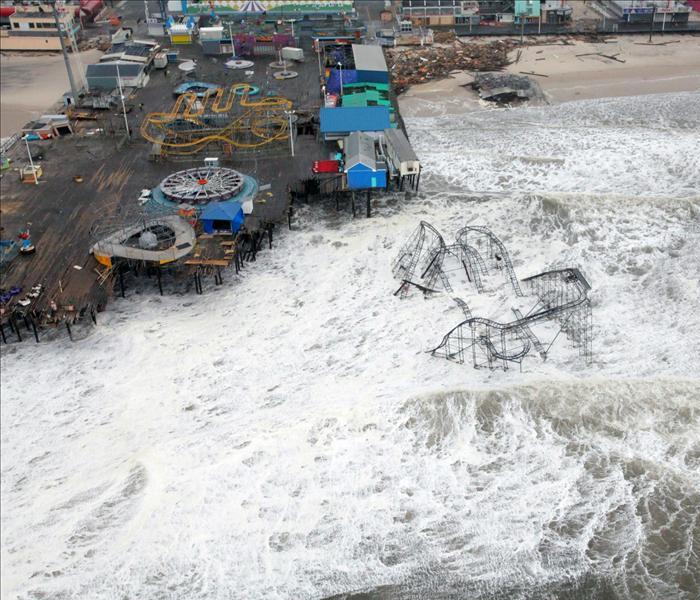 #1 - Iconic Casino Pier Amusement Park, Seaside Park, NJ after Hurricane Sandy.
#1 - Iconic Casino Pier Amusement Park, Seaside Park, NJ after Hurricane Sandy.
States of danger
Disasters can happen anywhere and at any time. But some places experience more than their fair share of floods, tornadoes, hurricanes, winter storms and severe weather -- so much so that certain locales earn frightening nicknames, such as Tornado Alley. No matter where you live, make sure you have the right kinds and necessary amounts of insurance coverage to protect your finances.
So where do these damaging events occur most frequently and severely? Kiplinger.com worked with the National Weather Service to identify the 10 states that have suffered the biggest estimated property losses from disasters over the past eight years
No. 10: Arizona
Estimated property damage (2006-2013): $3.5 billion
Most frequent disasters: thunderstorms, flash floods, drought,dust storms
Weather-related fatalities (2006-2013): 93
Drought conditions have plagued Arizona for the past several years. As a result, the state has seen outbreaks of wildfires, including its largest on record in 2011. The Wallow Fire burned more than 500,000 acres in eastern Arizona. And in 2010 a series of severe thunderstorms produced numerous tornadoes and hail around Phoenix, causing an estimated $2 billion in damage.
Keep in mind that if your home is damaged, you should file a claim only if it’s several hundred dollars more than your insurance deductible. Frequent small claims can lead to a rate hike.
No. 9: Colorado
Estimated property damage (2006-2013): $3.7 billion
Most frequent disasters: winter storms, hail, drought, floods and flash floods
Weather-related fatalities (2006-2013): 70
Record rainfall during September 2013 led to floods that killed nine people and caused widespread destruction in several Colorado cities, according to the National Climatic Data Center. The Centennial State also suffered the most damages among western states where wildfires broke out in the summer of 2012. If you live in a state where wildfires are common, it’s important to know what your homeowners policy covers and the difference between assessed value and actual replacement value. Too many people learn only after a fire that they were underinsured.
No. 8: Louisiana
Estimated property damage (2006-2013): $3.9 billion
Most frequent disasters: thunderstorms, hail, tornadoes, tropical storms, floods and flash floods
Weather-related fatalities (2006-2013): 66
Last year, the Pelican State was at the top of our list, largely because of Hurricane Katrina, which was the costliest disaster in U.S. history. But it drops in the rankings because the 2005 hurricane was not part of our data set this year, which includes events from 2006 to early 2014. However, Louisiana suffered from flooding when Hurricane Isaac hit in 2012. If you live in a flood-prone area, don’t wait until storm clouds gather to buy a flood policy; typically, there’s a 30-day waiting period before premiums take effect.
No. 7: Mississippi
Estimated property damage (2006-2013): $4.3 billion
Most frequent disasters: thunderstorms, hail, tornadoes, floods and flash floods
Weather-related fatalities (2006-2013): 88
Mississippi frequently is hit by tornadoes and severe storms. It also has been in the path of several hurricanes -- most recently Hurricane Isaac in 2012 -- that have caused extensive flooding. Although homeowners insurance covers damage due to wind, it doesn’t cover flood damage. You have to purchase a policy through the National Flood Insurance Program.
No. 6: Oklahoma
Estimated property damage (2006-2013) : $4.5 billion
Most frequent disasters: hail, thunderstorms, tornadoes, drought
Weather-related fatalities (2006-2013): 162
The Sooner State has another moniker: Tornado Alley. A massive EF5 tornado devastated Moore, Oklahoma on May 20, 2013, and the widest tornado on record hit El Reno, Okla., just 11 days later. Severe storms and twisters are so much a part of the state's weather that the National Severe Storms Laboratory and the National Weather Service’s Storm Prediction Center are located here.
Homeowners in tornado-prone states should set aside an emergency fund and take photos of all valuables in preparation for an insurance claim.
No. 5: Alabama
Estimated property damage (2006-2013): $4.9 billion
Most frequent disasters: thunderstorms, hail, tornadoes
Weather-related fatalities (2006-2013): 333
Alabama was hit hard by tornadoes in April 2011, especially in Tuscaloosa and Birmingham, where more than 120 people were killed. In fact, the Yellowhammer State is second only to Oklahoma for the number of EF5 tornadoes (the largest in intensity and area) that have struck there.
No. 4: Missouri
Estimated property damage (2006-2013): $5.0 billion
Most frequent disasters: hail, thunderstorms, winter storms, floods, tornadoes
Weather-related fatalities (2006-2013): 346
Missouri has suffered the most weather-related deaths in the last eight years. The tornado that swept through Joplin on May 22, 2011, was one of the deadliest in U.S. history (158 deaths) and generated $2.2 billion in insurance claims, according to an Insurance Information Institute analysis of data from ISO’s Property Claims Service.
No. 3: Tennessee
Estimated property damage (2006-2013): $5.1 billion
Most frequent disasters: thunderstorms, hail, winter storms, tornadoes
Weather-related fatalities (2006-2013): 224
Severe storms and tornadoes are common in Tennessee, which was among several southern states hit by the historic “super outbreak” of tornadoes in April 2011. The state’s capital, Nashville, suffered an estimated $2 billion in damage due to flooding in May 2010, and Memphis had millions of dollars’ worth of damage when the Mississippi River flooded in the spring of 2011.
No. 2: Texas
Estimated property damage (2006-2013): $23.7 billion
Most frequent disasters: hail, thunderstorms, drought, tornadoes and flash floods
Weather-related fatalities (2006-2013): 313
Severe thunderstorms and tornadoes are nearly as common as tumbleweed in the Lone Star State. Also, cities close to the southern coast, such as Galveston and Houston, are often in the bulls-eye of destructive hurricanes, such as Hurricane Ike in 2008, that gain strength over the Gulf of Mexico. And wildfires -- such as the 2011 Bastrop fire that destroyed more than 1,500 homes -- are common due to extreme heat and drought conditions in the state.
No. 1: New Jersey
Estimated property damage (2006-2013): $26.4 billion
Most frequent disasters: damaging wind, winter storms, floods and flash floods
Weather-related fatalities (2006-2013): 87
New Jersey earns the top spot on this list, in large part due to damage wrought by Sandy -- which had weakened from a hurricane to a post-tropical cyclone by the time it the Jersey Shore -- in October 2012. The state was among the hardest hit by Sandy, which was the second-costliest storm in U.S. history, after Hurricane Katrina. Many homes and businesses were destroyed along the Jersey Shore, and a portion of the Atlantic City Boardwalk washed away. Shortly after Sandy hit, another storm brought wet snow that caused more power outages and damage.
Storm Forecasters Adding Extra Layers to Warnings
8/15/2014 (Permalink)
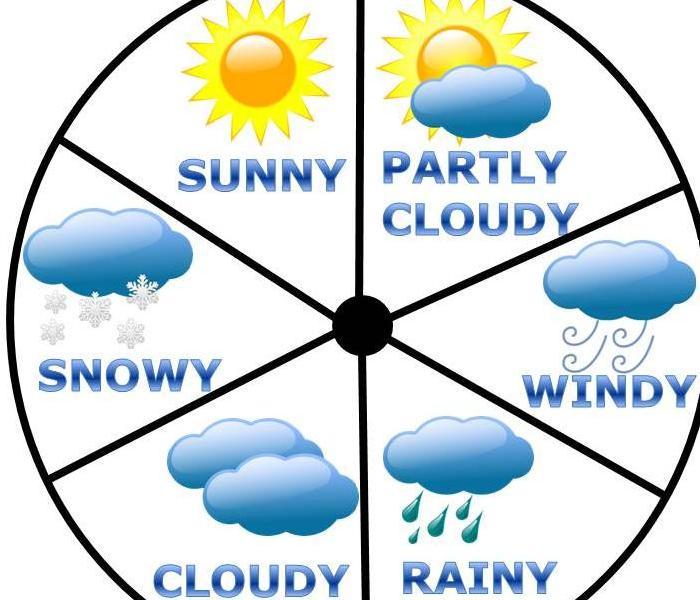
By KELLY P. KISSEL of Associated Press The National Weather Service Storm Prediction Center said Monday it will add two threat levels to its weather outlooks so people aren't surprised by really bad storms on days with just a "slight risk" of tornadoes, hail or high winds. Beginning Oct. 22, forecasters can say whether slight risk days are "enhanced" or "marginal" or just plain "slight." Other categories remain, including "high" and "moderate. The Norman, Oklahoma-based center traditionally targeted local forecasters and broadcasters across the U.S. with their advisories, known as "convective outlooks," but the Internet makes that data available to anyone with a computer and basic scientific knowledge. "We serve a very diverse group," said Greg Carbin, the center's warning coordination meteorologist. "We have a hybrid audience of highly sophisticated decision-makers," ranging from "expert users of weather information" to "the head of the household in those parts of the country that are often targeted by severe weather. The Storm Prediction Center for years classified the risk as high, moderate or slight, "and you can have killer storms in a slight risk," Carbin said. The system now mimics scales for tornado damage, hurricane strength and the former Homeland Security terrorist threat sale It gets us to five categories. Now we have a scheme where we can rank something 1-5," Carbin said. A public comment period drew 700 responses, mostly from individuals, government officials and the media. Around two-thirds said they used the outlooks at least once daily, and 87 percent of them said they liked the idea. Some, however, said extra colors made the map confusing. Carbin said television broadcasters didn't like the term "slight risk," fearing viewers often interpret that as "no risk." He said they were free to develop their own terms. "I don't care if you use 'slight' or 'a 2-out-of-5 chance,' as long as the general understanding of risk is conveyed," he said.
Hurricane? Cyclone? Typhoon? Here's the difference
8/13/2014 (Permalink)
By Seth Borenstein, Associated Press
HURRICANE? CYCLONE? TYPHOON? They're all the same, officially tropical cyclones. But they just use distinctive terms for a storm in different parts of the world. Hurricane is used in the Atlantic, Caribbean Sea, central and northeast Pacific. They are typhoons in the northwest Pacific. In the Bay of Bengal and the Arabia Sea, they are called cyclones. Tropical cyclone is used in the southwest India Ocean; in the southwestern Pacific and southeastern India Ocean they are severe tropical cyclones.
STRENGTH: A storm gets a name and is considered a tropical storm at 39 mph (63 kph). It becomes a hurricane, typhoon, tropical cyclone, or cyclone at 74 mph (119 kph). There are five strength categories, depending on wind speed. The highest category is 5 and that's above 155 mph (249 kph). Australia has a different system for categorizing storm strength.
ROTATION: If they are north of the equator they rotate counterclockwise. If they are south, they rotate clockwise.
SEASON: The Atlantic and central Pacific hurricane seasons are June 1 through Nov. 30. Eastern Pacific: May 15 to Nov. 30; northwestern Pacific season is close to all year, with the most from May to November. The cyclone season in the south Pacific and Australia runs from November to April. The Bay of Bengal has two seasons April to June and September to November.
WHERE IS THE BUSIEST PLACE? The northwestern Pacific where Typhoon Haiyan has just hit. A normal year there involves 27 named storms. Haiyan is the 28th named storm and there has already been a 29th. By comparison the Atlantic averages 11 named storms a year and this year there have been 12, none of them causing major problems.
WHO DECIDES THE NAMES? The lists are maintained by the World Meteorological Organization; the names are ones that are familiar in each region. Names are taken off the list and replaced to avoid confusion if a hurricane causes a lot of damage or deaths. For example, Katrina was retired after it devastated New Orleans in 2005. The Philippines has its own naming system, so Typhoon Haiyan is also being called Yolanda.
HOW DOES EL NINO AFFECT STORMS? During an El Nino — when the central Pacific is warming — there are fewer Atlantic storms. El Ninos shift where storms form, but not the number, for the northwest Pacific and the southwest Pacific. The central Pacific gets more storms during El Nino and the year after. This year has neither an El Nino nor its opposite, a La Nina. It is a neutral year.
Are You Ready for a Major Power Outage? Learn what you should have ready in case the lights go out for an extended period.
8/11/2014 (Permalink)
Have you considered how your life would freeze to a standstill if a general outage cut electric power for more than two or three days? As every summer arrives, it’s a question more and more people ask, because demand for electric power is growing inexorably, and summertime is when the grid always gets strained to the max. Many experts say all it will take is one unusually bad heat wave and a single computer glitch. The last major outage happened in the summer of 2003, and it affected over 55 million people.
Once your cell phone’s battery runs down, how will you recharge it? Think you can run down to the local Starbucks to get some coffee (your coffeemaker is dead, remember) and recharge your laptop, cell phone, tablet, iPod, toothbrush and shaver? Think again. All your neighbors will have descended on that little coffee shop en masse because they’ll be without power too.
Here’s a list of but a few things that go away in the event of a general power outage:
Lights (obviously)
· Heat and cooling — even gas heating requires electricity to pump the air
· Baths and showers — no heat means cold washing (assuming you can get running water)
· Medical support systems
· Food storage — refrigerators and freezers
· Food preparation — microwaves, stoves and ovens (even gas ovens use electricity)
· Food availability — stores need electricity too
· Entertainment — television and radio (not to mention video games)
· Communication — cell towers and Plain Old Telephone Service (POTS) exchanges require electricity
· Gas for your automobile — gas pumps run on electricity
The majority of power outages come in times of temperature stress, i.e., winter or summer, when heating or cooling are drains on the system. They impact you in many ways, some of which are hard to foresee. That’s the bad news. The good news is there are a myriad of ways you can prepare if a massive outage strikes unexpectedly;
Preparation
Food: Have at least a week’s worth of dry food rations stored away, especially high-energy foods, like peanut butter, jelly, crackers, granola bars, and trail mix. Also include some comfort/stress foods: cookies, hard candy, sweetened cereals, lollipops, instant (or pre-ground) coffee, tea bags, and a supply of things like salt, pepper, sugar, etc. Keep a good supply of paper or plastic plates and silverware, as well as a roll or two of paper towels. Oh, and don’t forget a manual can opener.
Water: Store at least 1 gallon of bottled water per day per person, plus more for pets, and powdered foods. When power goes out, water purification systems may not be functioning fully, so don’t rely on tap water until the crisis has passed.
Gas: Make it a habit never to let your vehicles’ gas tanks get below half. When a general power outage strikes, gas pumps die because they run on electricity.
Cash: Keep at least a couple hundred dollars in hard cash handy. Everyone selling you something will not have power for cash registers, scanners, and that type of thing. You’ll be dead in the water if all you have is plastic.
Medication: Ask your pharmacist to keep you a month ahead on your prescriptions for this emergency. If someone in your home is dependent on electric-powered, life-sustaining equipment, remember to include backup power in your evacuation plan. If you are on electrically operated life support systems or special equipment for heart or kidney problems, be sure to notify your utility now, in advance of any outages. They will put you on a list and make sure your power needs are provided for first. Oh, and don’t forget the first-aid kit.
Grill: If you have a patio grill, get a stovetop kettle if you don’t have one. That will allow you to boil water outside. Never use a generator, grill, camp stove or other gasoline, propane, natural gas or charcoal burning devices inside a home, garage, basement, crawlspace or any partially enclosed area. We usually keep a spare full propane tank (although, to be honest, its main purpose is to keep the party going if the previous one runs out while the burgers are on the grill).
Cooler: Get a cheap, large-capacity cooler to store the food caught in the freezer and refrigerator. It’s a good idea to keep a few two-liter bottles filled with water in your freezer — they will keep food cold in a cooler for a long time.
Light: Get a flashlight, candles and lighter (or matches). And be sure to add a supply of batteries. A good option is keeping a half-dozen cheap solar garden stake lights lying around. They’ll charge every day and have enough light to last most of the night. At about $2 per, that’s a cheap, reliable light source.
Trash: Something many people forget is a supply of trash bags and moist towelettes for sanitation needs. If the power outage affects the water supply, you may not have the use of your toilets.
People: Set up an agreement with people about two to three hundred miles away that you can go and stay with. It’s infinitely less stressful to simply get in your car and drive somewhere else where there’s still power so you can wait out the crisis. It will be difficult to call around when the power is out, so it’s best to set up two or three families with whom you have an arrangement where if anyone has a major crisis, they know they’re welcome somewhere else for the duration of the emergency.
Documents: It’s wise to get copies of things like deeds, wills, titles, medication lists, insurance policies, birth certificates, etc. Keep them in the same place as your emergency cash. People who provide aid may require some form of identification, and if the insurance company comes to help, it speeds things up if you have a copy of your policy right there. It’s not a bad idea to keep your computer backups on a portable hard drive and leave it with the emergency supplies.
Chargers: In the event that you go and stay with someone, it’s nice to have a basic set of chargers for your phones, computers and other gadgets together in one place, so you can just grab them and go. Also add a long extension cord with multiple outlets to plug all of those chargers in at the same time. We have a power inverter. Plug it into your car and you have 110V to power just about anything, including a coffee maker. (This of course makes it even more important to not be too low on gas.)
Telephone: Keep a non-cordless, old school telephone around. The plain old telephone service is usually the last to go out. It allows you make phone calls, but it also allows the authorities to get hold of you with reverse 911 calls. Tape the following phone numbers to the bottom of your landline telephone or inside a telephone book:
· Fire department
· Telephone companies
· Utility companies
· Police department
Shutoffs: Find out where each utility shut off is — electricity, water and gas. Know how to turn each off. Have the proper tools to do so, and know where they are located. If you have an automatic garage door, check the instructions or with the manufacturer to learn how to open the door manually (without power). Most automatic garage door openers have a red or yellow knob hanging from a string, which disengages the garage door from the track of the opener.
And, finally, don’t forget to include a few board games. You’ll have a lot of time with little else to do, so you may as well turn the crisis into a fun, bonding experience.
When the outage strikes
First thing is go to a grocery store right away to buy anything you need. Be armed with cash, because their registers and scanners won’t work. They won’t have lights, and they probably will want to sell perishable produce as quickly as possible. Be prepared for crowds, and also be prepared to let others have something too — don’t hog everything for yourself.
If you have a plan in place to go and stay with people who are out of the outage area, pack and go. Expect roads to be congested and traffic lights not to work. Be sure to unplug or shut off everything, because when the power comes back on, there may be surges which can cause damage. Turning off all breakers is usually a quick and easy way to do this.
If you’re staying, unplug/turn off everything, but leave a single light turned on, so you can see when power is restored.
To maintain the refrigerated and frozen foods, keep fridge and freezer openings to a minimum.
Practice living without connected utilities. Do it periodically. You will discover what your real needs are and you’ll learn how to meet them in an emergency.
In winter, allow a small stream of water to run from faucets in order to prevent water pipes from freezing. The American Red Cross advises this action and says, “Running water through the pipe — even at a trickle — helps prevent pipes from freezing.” In frigid weather, if your power is likely to be out for more than a few days, you may want to call your plumber and ask about draining your home’s water pipes so they don’t freeze and burst.
An extended power outage, will be a major emergency, and will cause damage in many ways. However, with some basic and inexpensive preparation, you can keep that damage to a minimum.
What To Do When A Thunderstorm Hits
7/29/2014 (Permalink)
The most common danger associated with thunderstorms is lightning, and with good reason: Lightning is one of the top three storm-related killers in the United States. But thunderstorms create other catastrophic weather events such as tornadoes and flash flooding. Each year, flash flooding is responsible for more deaths than tornadoes, hurricanes or lightning. Here's what to do before, during and after a thunderstorm.
An emergency kit is something everyone should have on hand, no matter your locale or the natural disasters that are possible in your area. The Federal Emergency Management Agency's Ready.gov can help you build a kit — with food, water, and essential supplies for 72 hours — as well as teach you where to store it and how to update it. If the idea of making your own kit is too daunting, you can buy an emergency preparedness kit put together by the American Red Cross. Get rid of rotting trees and branches; secure anything outdoors that could blow into your house and cause damage.
Unplug electronic equipment well before a storm arrives.
Get inside — preferably inside your home, a building or a hard-top automobile.
Shutter windows and secure doors; if shutters are not available, close the blinds or curtains.
Special considerations for lightning
Follow the 30/30 Lightning Safety Rule: If you can't count to 30 before hearing thunder after seeing lightning, go indoors. Stay inside until 30 minutes after you hear the last thunder.
If you are in a forest, find shelter in a low area under a thick growth of small trees.
If you're on open water, get to land and indoors immediately.
In an open area, find a low place such as a valley or ravine, but watch for flash floods from the storm.
If you feel your hair stand on end, lightning is about to strike. Get low to the ground, cover your ears and put your head between your knees.
Weathering the storm
Don't use a corded phone or anything plugged into an outlet. Avoid all contact with electrical equipment.
Stay away from windows and doors. Stay inside.
Don't lean against concrete walls or lie on concrete floors.
Avoid washing your hands, showering or using plumbing for any reason.
If you're on the road, pull over and park. Turn on your emergency blinkers.
After the storm
Don't attempt to drive through a flooded roadway.
If your power has gone out, never use a generator indoors. Deadly levels of carbon monoxide can build up quickly in small spaces and remain dangerous for hours.
Avoid downed power lines and report them to the power company.
Farmers and Gardeners: Prepare Now to Weather the Whims of Mother Nature
7/23/2014 (Permalink)
Commercial farms and home gardens alike present similar challenges when natural disasters are a threat. The flat, open land that crops grow in and animals graze on has few natural defenses against flooding, and any tall buildings on farmland, such as barns and silos, can be vulnerable to lightning strikes. While the average home garden doesn’t have the same scope of a large farm, owners of both can use similar methods to protect their crops, livestock and property from the impact of a natural disaster.
Take a full inventory of everything: livestock, equipment, pesticides, fertilizers, other chemicals and fuel. Animals should be tagged so they can be returned if they get lost or hurt during an incident. Have sandbags and plastic sheeting on hand to cover and protect crops and garden plots in case of flooding. Use wire and rope to secure objects, and lumber and plywood to protect windows. Put a fire extinguisher in every building and vehicle on your property.
Choose a safe, flood-proof location to store extra fuel for tractors and vehicles, food and water for livestock, and a gas-powered generator in case of power failure. Make sure that electrical power to flood-prone machines and structures can be easily turned off. Have hand tools accessible to assist in preparation and recovery.
If you are in a particularly flood-prone area, figure out escape routes for livestock to get to higher ground. Also, keep them out of barns that may flood, as their natural instinct is to seek shelter in a barn during an emergency.
In the aftermath of a disaster, report leaks of any hazardous materials (pesticides, fuel, fertilizer and other chemicals) to authorities.
Check your utilities for signs of damage, and contact your utility company before turning anything back on. Spray surviving livestock with insect repellent to protect against mosquitoes, and have all animals checked for infectious diseases such as pneumonia or foot rot.
Test the soil, especially in smaller gardens and flower beds. It is recommended that flooded areas not be planted again for at least 30 to 60 days. Before replanting, make sure the soil is dry and has been reworked. Salt water can get washed up by waves and storm surge and get into the soil and on plants and trees, causing leaves to brown and damaging roots and buds. The damage salt spray can do to plants can last for several years.
Dispose of any leafy green vegetables and any other crops with edible parts that were touched by flood water. Affected root vegetables can be sanitized for consumption by rinsing them and soaking them in a bleach/water solution.
Missed the Supermoon This Month? The One in August Will Be Even Better
7/21/2014 (Permalink)
Liz Burlingame – Weather.com
Don't fret if work, plans or bad weather prevented you from seeing the super moon this month. It's returning in August, and it promises to be bigger and better, according to astronomers.
The super moon on Aug. 10 will be the second of three consecutive super moons this summer. Stargazers were treated to the first on July 12, and the final show will be Sept. 9.
Super moons, which are also called "perigee moons," take place when the moon becomes full at the same time it's closest to us in its orbit around Earth. As a result, the moon appears bigger and brighter than usual.
The August super moon is slated be the main event of the year, Lorraine Hanlon, associate professor of astronomy at UCD told The Independent. "The moon orbits the earth every 28 days on a slightly rugby-ball sized path," she said. The very closest super moon is called a "proxigee." It happens once every 13 months and 18 days, with the next on Aug. 10.
Though the super moon phenomenon isn't that rare, it can cause a stir when it happens. Social media lit up with moon photos the day after the July 12 event, and media coverage was widespread. NASA says the fascination may come from a poorly understood optical illusion that makes the moon look enormous.
"The illusion occurs when the Moon is near the horizon. For reasons not fully understood by astronomers or psychologists, low-hanging Moons look unnaturally large when they beam through trees, buildings and other foreground objects."
In terms of impact, the super moon will have only a minor effect on Earth. Other than its change in appearance, tides will be larger than usual, Earth sky reports.
The 5 Things Everyone Misunderstands About the Weather
7/17/2014 (Permalink)
By Tim Sprinkle, PropertyCasualty360.com
After centuries of weather forecasting study and research, the human race knows a thing or two about storms. We know that hurricanes and typhoons will spin out of the oceans every summer and ravage certain coastlines. We know that tornadoes will strike thousands of times per year, causing significant localized damage, and we generally know where they will appear and why. We can even predict which years will bring particularly strong weather patterns and what those patterns will mean for farmers, ranchers and others.
But, the truth is, we don't know everything. At least the general population doesn't. In fact, although there is plenty of meteorological research out there for reference, a wide swath of the population clings to a number of weather myths that, although they sound correct, just aren't true. Earlier this month, AccuWeather.com set out to put some of these weather myths to bed by explaining some of the most widespread and misinformed. Click though to learn what you've been doing wrong all these years.
Myth #1: Humid air is heavier than dry air
According to AccuWeather.com meteorologist Steve Wistar, dry air is actually heavier than humid air, despite the fact that it seems like you can "feel" humid air more than dry. "There are more molecules of water in humid air which are lighter than molecules of air," he said in the story.
Myth #2: Tornadoes don't hit cities or mountains
This is just wishful thinking. Why would a city have been built here if it was a common tornado area? Residents of Kansas City, Denver and Oklahoma City might have some opinions on that.
The truth is, although rough terrain and tall buildings do distrupt the circular forces that create tornadoes, they aren't impossible.
Myth #3: Red sky at night, sailor's delight...
Kinda true, kinda not.
The idea behind the classic axiom -- "red sky at night sailor's delight, red sky in morning sailors take warning" -- is that red skies are most common when the atmosphere is dry, meaning that it appears at night when the dry are is to the west. Dry air to the east means a red sky in the morning. Since weather patterns in North America generally move from west to east, this stands up most of the time, but it isn't a guarantee because systems can move in any direction.
Myth #4: Today's cars can drive safely through flood waters
To be honest, I'm not sure how common this myth really is, but it never fails during flood season to see news coverage of at least one driver who was been swept away after trying to drive through minor flood waters. Truth is, as little as two feet of water can float a car.
Myth #5: Lightning doesn't strike the same place twice
Of course it doesn't, right? There is so much space out there for it to strike, why would lightning repeat? But it does, according to AccuWeather. "The Empire State Building gets struck repeatedly [on average of 100 times a year]. It all depends on how much an object sticks up in the sky," Wistar said.
NY Lawmakers Approve Mold Licensing Bill
7/15/2014 (Permalink)
Originally published by Indoor Environment Connections
The New York Legislature has approved legislation that would require the licensure of mold inspection, assessment and remediation specialists and sets minimum work standards for mold inspection, assessment and remediation specialists.
The bill, which has bipartisan support, aims to ensure that only properly trained, licensed professionals can conduct mold assessment, abatement and remediation services.
Applicants for the license must have completed state-approved course work, including training on the appropriate use and care of personal protection equipment as approved by the commissioner of New York’s Department of Health.
If the bill becomes law, an applicant for a license to perform mold remediation will have to submit a financial statement, prepared by an independent auditor or accountant, stating the assets of the applicant. This will be used to determine the financial responsibility of the applicant to perform mold remediation services.
Applicants would also have to submit insurance certificates showing workers' compensation coverage, if required, and liability insurance of at least $50,000.
“A major obstacle to rebuilding after Superstorm Sandy has been the widespread cases of mold affecting Nassau County homes and businesses,” said Assemblyman Harvey Weisenberg, the bill’s sponsor. “Mold removal can be expensive, and it’s important that it’s done right, as it poses a serious public health risk. This bill would require that mold remediation specialists are licensed and qualified to make sure mold is properly removed.”
Mold can cause serious health risks, especially for children and those suffering from asthma. This legislation ensures that only licensed professionals, who have undergone an extensive licensing process, are able to provide mold-related services. “It prevents unscrupulous contractors from taking advantage of those in need, both now and in the future,” Weisenberg said.
“Superstorm Sandy devastated our communities, destroying more than 70,000 homes and businesses in Nassau County,” said Assemblyman Weisenberg. “This legislation will help families move forward because even though we’ve endured great struggles over the past two years, together we can safely re-build our homes.”
The bill has been sent to Gov. Andrew Cuomo for approval. A spokeswoman for the governor said he has not yet declared publicly if he will sign it.
Mid-July Is Looking More Like Mid-September
7/11/2014 (Permalink)
By Eric Holthaus - Slate's Future Tense
Remember the polar vortex? Weather so cold that boiling water froze in midair?
Well buckle up, America. We’re getting another dose of polar air next week, and just in time for what is normally the hottest week of the year.
While next week’s mid-summer cold snap won’t send you rushing for the nearest space heater, its origins are similar to the cold snaps that defined the brutal winter just past.
The same basic large-scale weather pattern has been settled in over North America for months now, and it even has a name: the ridiculouslt resilient ridge. Coupled with the occasional cut-off low pressure center dawdling over the Great Lakes region (next week’s will camp out over Quebec), it’s been a recipe for extreme warmth on the West Coast and colder than average weather out East. On the west side of the Rockies, tropical Pacific air gets funneled northward from around Hawaii toward Alaska while California dries out and roasts; on the other side, cold air from the Yukon cascades southward toward the Midwest and East Coast.
North America’s polar vortex-filled winter was almost certainly overhyped. The polar vortex isn't a new phenomenon, nor was it behind every cold snap of the past six months. According to NOAA, while last winter was below average (by one degree Fahrenheit), winters are warming for virtually every corner of the continental United States (save one corner of southwest Louisiana).
This winter was an aberration, not the rule—a dip in the long-term trend of global warming. Further proof: the first five months of 2014 were collectively the fifth warmest such period globally since records began. This winter was a temporary cold blip in a small corner of the Earth. We just happen to live there.
As for the polar vortex itself, its resonance within the American zeitgeist is proof that sometimes it helps us cope to have something special to blame for all the crazy. For the science purists, there’s a great explainer of the phenomenon by Weather Underground’s Jon Erdman and perhaps an even better one by NASA’s Eric Fetzer. As crazy as it sounds, there's even a line of scientific evidence that connects an increasing frequency of extreme weather events (like the cold snaps of earlier this year) to abnormal shifts in the jet stream caused by melting Arctic sea ice and global warming. It’s a hot topic of debate right now among climate scientists.
As for next week’s weather, polar air will again be spilling southward from the Arctic Ocean. That’ll be good enough to convert what’s typically Chicago’s hottest week of the year to an unseasonably pleasant early Autumn-style respite that will have folks begging for more. Chicago’s forecast high of 72 degrees Fahrenheit next Wednesday is historically much more likely to happen on September 16th than July 16th.
Cooler than normal weather is expected across much of the eastern two-thirds of the country as well, with mild temperatures from Boston to New York City to Washington, though not nearly as dramatic as in the Midwest. All in all, you really can’t ask for much better weather than what’s on offer next week.
Though at some point, enough is enough. A reverse trajectory model shows the air supplying next week’s mid-summer Chicago cold snap is currently (as of Thursday) sitting over Canada’s far North. Let’s hope the atmosphere gets all this out of its system before December. But for now? Long live the polar vortex.
SERVPRO of Great Neck Port Washington: Corporate Customer Testimonial
7/9/2014 (Permalink)
I want to thank you for taking the time to do the Emergency Response Profile for our building in the Port Washington Industrial Park. It helped me comply with my emergency management requirements and I'm more confident now that all my emergency contact information is in one location. Best of all, I don't need to go hunting for this information. It is all within my reach on my cell phone.
Al Reres - Facility Director, Tweezerman International
July Home-Maintenance Checklist
7/9/2014 (Permalink)
MSN - Marilyn Lewis
Take advantage of warm weather while playing or doing chores to also cast a protective eye on your home and landscaping. By paying attention, you’ll learn to spot deterioration or changes before they turn into problems.
Give your Home an Energy Audit
Take an hour to walk around your home with a notepad in hand, taking inventory of gaps and cracks. Experts estimate that you can save 20% on heating and cooling bills by plugging leaks.
Start your inspection inside. Turn off the electricity at the circuit box, then remove switch-plate covers to look for gaps. (Replace them with insulated covers for $3 to $4 each or install foam inserts — also called gaskets — for about 49 cents each. Both can be purchased at hardware stores.) You can insulate phone-jack covers, too.
Next, check the junctures where windows meet walls, walls meet floors and pipes and wires enter the home, plugging gaps with caulk. Other leaky zones include fireplace dampers, mail slots, window-mounted (or wall-mounted) air conditioners, attic doors, baseboards and weather stripping surrounding doors. Look for daylight, feel for drafts and listen for rattles, all clues to escaping heat. Next, check the house from the outside, examining the places where pipes, vents or wiring enter. Examine siding for gaps or damage, paying particular attention to corners where the material joins and where it meets other materials, like chimneys, windows or the foundation. If you'd rather get a professional checkup, call your utility company for referrals. Many utilities even provide rebates for home-energy audits performed by recommended auditors.
Insulate Hot-Water Pipes
Insulate the hot-water pipes in the basement or crawl space to save on heating costs next winter. Snapping foam jackets does insulating pipes - use pre-slit, hollow-core, flexible foam pipe insulation (called "sleeves"), purchased at a hardware store. (Prices vary but, for example, a 6-foot-long piece of foam insulation for half-inch copper pipe might cost less than a dollar.)
When shopping, know your pipe’s diameter to get the correct fit. Exposed pipes pinch your wallet twice: You waste water running it as you wait for it to heat up, and you waste fuel when heat is lost as hot water runs through exposed pipes.
Tip: Slip sleeves on pipes running between the hot-water tank and the wall and also insulate cold-water pipes for the first 3 feet after they enter the house.Clean Patio Furniture
Mix up a bucketful of soapy bleach solution to maintain your patio furniture. Here’s the recipe:
2/3 cup tri sodium phosphate (TSP)1/3 cup laundry soap powderA quart of bleachThree quarts of warm waterRemove cushions before spraying. Launder removable fabric coverings. Use a rag and soft-bristle brush to remove embedded dirt on synthetic coverings, metal and wood furniture. Rinse thoroughly and let dry. Spray wicker furniture with water and protect it with paste wax. Simply shoot the garden hose at resin furniture. To remove rust from metal furniture or bolts use Naval Jelly, available at hardware stores, with a wire brush. Wear rubber gloves and follow directions on the package.
Clean Concrete
Power washers can be dangerous to decks (in the hands of amateurs, they can damage wood), but they’re just the tool for cleaning concrete sidewalks, driveways and patio and pool areas. If your garage or carport floor is marred by oil stains, saturate the area with a solution made from a cup of TSP mixed with a gallon of hot water. (Wear goggles and rubber gloves.) Let the solution soak for a half-hour, then scrub with a stiff-bristled brush. Rinse thoroughly and repeat as necessary.
While washing concrete, watch to ensure that the hard surface directs water away from the home’s foundation. If the concrete sends water toward the foundation, take action. First, inspect around the outside of the foundation for damage, looking for cracks and crumbling. Then check from the inside (go into the basement or crawl space) for water stains and wet soil. If water is getting into the foundation, hire a home inspector or structural engineer to help find a solution. You may need to redirect the drainage by removing or correcting the slope of the concrete. If that’s not feasible, a sump pump could be used to mechanically remove the water. A sump pump’s operation is triggered when water reaches a predetermined level under the home, setting off a floating switch.
Slip 'feet' under Deck Planters
Since standing water rots wood, make certain that water drains directly onto the ground when you water plants in pots and decorative planters on decks. Make drainage room by setting pots on pot “feet” (sold at garden-supply stores that carry pots). Or use pot stands – some have wheels that enable you to move heavy pots. Or for a frugal solution, just prop bricks under the pots, taking care to ensure that they’re stable.
Patch Cracks in Concrete
Inspect concrete for cracks. To patch them, clean the cracked area well with a wire brush and small broom. To repair narrow cracks, use masonry crack filler. It comes in cartridges and can be injected into the crack. For bigger openings, apply vinyl concrete patching compound, smoothing the surface with a putty knife.
Patch Cracks in Asphalt
You can extend the life of an asphalt driveway or path by inspecting it two or three times a year and using a caulking gun and asphalt patching caulk ($5 to $15 a tube) to repair cracks. If you leave cracks, they’ll grow and plants can take root, widening the damage. Squirt the caulk into the cracks and use a disposable putty knife to even the surface. Every five years, treat asphalt to a coat of asphalt sealer ($50-$100 for a five-gallon bucket). Brush it on with a squeegee or push broom.
Prune or Remove Problem Trees
Get a certified arborist to inspect your trees and tell you if any are hazardous. Trees hanging over your roof, rubbing against gutters or dropping loads of leaves and sticks onto the roof should be pruned. Overhanging branches can provide a ladder for rats and squirrels, and diseased or damaged trees may fall on your home in a storm. A typical arborist’s fee is $65 an hour. For pruning or tree removal, call a tree-care service.
Trees can bring up boundary issues. They may straddle the property line between you and your neighbor or the branches from your neighbor’s tree may drop fruit onto your land. Although state tree laws vary, in general you have the right to trim branches on your side of the property line as long as you don’t endanger the life of the tree. If you kill the neighbor’s tree, you are liable. An arborist who understands local laws can be a great mediator between neighbors.
Clean Exhaust Fans
Exhaust fans do a lot of work in your home. In bathrooms, they push out moisture to keep walls and floors dry and prevent the growth of mold. (Be sure to run the fan before taking a bath or shower and keep it running for 15 minutes after you leave the room, so moisture has a chance to clear.) Before you begin cleaning the fan, turn off its power at the circuit-breaker box. Dust the vents on the fan’s cover (do this monthly). Use a screwdriver to remove the cover. Gently clean the inside of the cover and the fan blade with a slightly damp cloth or spray cleaner and a paper towel. Dry and reassemble. Do this twice a year.
In kitchens, exhaust fans vent moisture along with oily fumes. Making sure the electricity is disconnected at the circuit breaker box, start by removing the washable filter from the stove's exhaust fan. You’ll find the fan either in the range between the burners or in a hood over the stove. If the fan can be pulled out, unplug it, remove it and extract the filter. Otherwise, just remove the filter. Put it through the dishwasher or soak it in warm soapy water. Vacuum the opening of the fan, then clean the blades and housing with a cloth and spray cleaner or degreaser.
Mend the Fence
Even the cheapest new fences cost thousands of dollars. Protect your investment by looking for damage and making prompt repairs. Before touring your fence line, mow the grass low so you’ll have good visibility. Watch for signs that dogs have tunneled under the fence. Training and a watchful eye are the best ways to prevent dogs from digging. Otherwise, attaching a 2-foot-wide apron of wire mesh around the inside perimeter of the fence may work.
As you walk the fence, test the strength of the connections by gently tugging posts and slats to ensure they’re well-attached. Check fence posts for signs of rot (poke soft spots in the wood for crumbling or decay). Remove and replace the damaged areas. Keep fences painted or stained to protect the wood. Repaint or stain when the original finish is thin, cracked or peeling. Before painting, hose off and scrub dirty boards, letting them dry thoroughly.
Repel Deer
Deer can demolish hundreds or thousands of dollars of landscaping in an evening or two. There are several things you can do to keep deer away from your investment:
Use deer-proof plantings. Bear in mind that such lists are no guarantee: Deer often eat plants they’re not supposed to like.Install a mini fence or put bird netting around prized plants. Garden stores have these materials and can instruct you how to use them.Spray with a home-made deer repellent. Search online garden forums for recipes for repellents that blend eggs, hot sauce (or cayenne pepper), raw garlic, yogurt or buttermilk and dish soap. Spray every three or four days and after a rain.Purchase one of the better commercial deer repellent sprays. Check with your local garden store or cooperative extension master gardeners for recommendations.
Super Typhoon Neoguri Aims at Japan; U.S. Air Base Wary of Winds
7/7/2014 (Permalink)
NBC News
Japan was bracing for destructive winds and huge waves as a powerful super typhoon described as a "once in decades storm" churned Monday toward the southern islands of Okinawa after sparing the Philippines. Typhoon Neoguri was already gusting at more than 150 mph and may pick up still more power as it moves north, growing into an "extremely intense" storm by Tuesday, the Japan Meteorological Agency said. It was expected to rake the southern Okinawa island chain with heavy rain and powerful winds before making landfall on Kyushu, Japan's westernmost main island.
The storm was not expected to be as strong as Typhoon Haiyan, which killed thousands in the Philippines last year. The JMA said Monday night that it planned to issue an emergency high sea warning for Okinawa Island, host to three-quarters of U.S. military facilities in Japan. The commander at Kadena Air Base, one of the largest U.S. military establishments on Okinawa, earlier warned that damaging winds were expected by early Tuesday. "I can't stress enough how dangerous this typhoon may be when it hits Okinawa," Brigadier General James Hecker wrote on the base's Facebook page on Sunday. "This is not just another typhoon."
SERVPRO of Great Neck Port Washington Wishes You A Safe July 4th Holiday!
7/2/2014 (Permalink)

June to July 4th is National Firework safety month. Some of you are probably laughing and saying are you kidding me? No kidding; firework safety (or lack thereof) is a big problem. The United States Consumer Product Safety Commission (CPSC) states there are about 9,000 to 10,000 people treated a year for firework related injuries. These are the injuries that were reported to hospitals, but this number does not take into account the injuries that are not reported.
A majority of these injuries could have been prevented by using safety measures when handling fireworks. As technology advances so does the ability of fireworks. Today you can have fireworks that display shapes, different colors, words and even designs. In a lot of states consumers can buy fireworks. Out of all the 50 states only 5 do not allow consumers to purchase fireworks for personal use. That is a very small percentage and all of those states that do not allow consumers to purchase fireworks are on the East Coast. Not only does the ability to purchase fireworks vary from state to state, what is actually considered a firework varies as well. Before you do anything or purchase anything make sure you are following your state laws. Just because someone may sell certain fireworks does not guarantee they are allowed.
With the July 4th holiday upon us, read on for tips to a safe celebration!
Basic Fireworks Safety Measures
There are some basic safety measures you should take when using fireworks:
1. Buy fireworks from reliable dealers; buying fireworks from a guy who is selling them from his trunk is not a good idea!
2. Make sure you read all the directions and follow them as well. You are using explosives so it is important you know what you should do.
3. I know this sounds silly but I have to say it; use fireworks outdoors only. People have tried on several occasions to create 'light shows' indoors.
4. Make sure you have water near by, and not just a bucket of water. A garden hose that is hooked up and working well is important as well.
5. Do not allow children to play with fireworks and always have a responsible adult present.
6. Do not try and make your own fireworks, they are very complicated and should be left up to the professionals to make.
7. Do not light multiple fireworks at once; this can be very dangerous because if something goes wrong with more then one, you will be out numbered.
8. Do not point fireworks at people or throw them at people.
9. Do not carry fireworks in your pocket, backpack or purse!
10. When you dispose of fireworks make sure you soak them in a bucket of water first.
11. When you light fireworks eye protection is very important, and make sure all body parts are out of the way.
As a spectator watching fireworks make sure you are far enough away that debris from the firework won't hit you. Also exposed to loud sounds can very be damaging to your hearing, it is best to wear ear protection.
Now Relax and Enjoy!
SERVPRO of Great Neck Port Washington says Celebrate Summer Safely
6/30/2014 (Permalink)
Each year, families and friends across the country enjoy the summer months with barbecues, camping trips, or by cooling off in a pool or lake. In order to enjoy these occasions, it is important to keep safety top of mind to ensure you have fun in the sun.
According to a recent study by the U.S. Consumer Product Safety Commission, nearly 9,600 Americans are injured by fireworks each year. Another 5,000 are injured by charcoal/wood-burning and propane grill fires. A grill should always be supervised when in use. Keep children and pets a safe distance from the grilling area to prevent accidental burns or tipping of the grill.
If you enjoy lounging by the pool or going for a boat ride to cool off from the summer sun, make sure you exercise caution, especially when children are present. Only swim in approved areas and supervise children at all times when near the water.
The summer season should be a time to make memories and enjoy the great outdoors. The following tips, provided by the National Fire Protection Association, will help keep you safe all summer long.
- When using a charcoal grill, only use starter fluids designed for barbecue grills; do not add fluid after coals have been lit.
- When using a gas grill, ensure the hose connection is tight; check hoses for leaks. Applying soapy water to the hoses will easily and safely reveal any leaks.
- Always wear a U.S. Coast Guard-approved PFD (personal floatation device) when boating, jet-skiing, tubing or water-skiing. Air-filled swimming aids, like water wings or inner tubes, are not substitutes for approved PFDs. An adult should always supervise children using these devices.
- Be sure to extinguish all smoking materials and shut down motors and heating devices before fueling a boat. In case of a spill, wipe up fuel and check for fuel leakage and odors.
- When camping, always use a flame retardant tent and set up camp far away from the campfire. Only use flashlights or battery-powered lanterns inside the tent, not liquid-filled heaters or lanterns.
- Always build a campfire down wind from the tent area. Clear vegetation and dig a pit before building your campfire. Always extinguish the fire before going to sleep or leaving the campsite. To extinguish, cover with dirt or pour water over the fire.
- Store liquid fire starter (not gasoline) away from your tent and campfire and only use dry kindling to freshen a campfire.
- Consider leaving firework use to trained professionals. Stay back at least 500 feet from professional fireworks displays.
SERVPRO® Great Neck Port Washington wishes you a safe and happy summer!
Prepare for major 2014 hurricane despite predicted lull: Report
6/27/2014 (Permalink)
Bill Kenealy - Business Insurance
Businesses and insurers need to ready themselves for the possibility of a major hurricane making landfall in 2014 irrespective of projections for an average or below-average hurricane season, reinsurance broker Guy Carpenter & Co. L.L.C said in a report released Wednesday.
The report, “2014 Atlantic Hurricane Season: One Never Truly Knows,” say that while predictive and historical models can provide guidance, landfalls remain a real possibility.
While forecasters predict fewer hurricanes than average in the Atlantic basin for 2014, the correlation between hurricane counts and the number of U.S. landfalls is weak, said James Waller, research meteorologist for Guy Carpenter's GC Analytics division.
“The risk of a landfalling hurricane is a serious threat for any tropical season, regardless of seasonal outlooks for the Atlantic basin at large,” Mr. Waller said in a statement. “Warmer waters in the West Atlantic and Caribbean coupled with the uncertainty surrounding the strength and placement of the impending El Niño, warrant a moment of pause for the 2014 season.”
El Niño fuels uncertainty
Indeed, the report notes that many of the uncertainties in the outlook for 2014 center on the El Niño phenomenon, which is signaled by warmer-than-normal sea-surface temperatures in the tropical East Pacific as well as the cooler-than-normal sea-surface temperatures in the Atlantic Main Development Region, which is bounded by a box from 10-20 degrees north latitude and 20-85 degrees west longitude. A strong El Niño causes large-scale air circulations that enhance wind shear in the Atlantic, the report said, adding that enhanced wind shear is thought to disrupt tropical cyclone formation.
The unresolved questions regarding the strength and placement of this year's El Niño will be telling, the report concludes, noting that some of the most destructive U.S. hurricane landfalls came during weak El Niño years.
“The 2004 season was a weak El Niño year with the warm waters located closer to the Central Pacific,” the report said. “The season produced nine hurricanes and five U.S. landfalls, four of which severely affected Florida in a very impactful season.”
Which natural disaster will likely destroy your home?
6/25/2014 (Permalink)
By Les Christie @CNNMoney
Move to the Deep South and chances are high that disaster will strike your home sooner or later.
Alabama, Georgia and Mississippi boast the dubious distinction of having the highest risk of getting hit by a natural disaster -- whether it be a tornado, earthquake or hurricane, according to RealtyTrac, which analyzed data from the U.S. Geological Survey (USGS) and the National Oceanic and Atmospheric Administration (NOAA) to assess natural disaster risk for more than 3,000 U.S. counties.
In Alabama's Jefferson and Tuscaloosa counties, for example, tornadoes are seven times more likely to occur than the average U.S. county. The last huge tornado, a multi-vortex, hit three years ago causing 64 fatalities and $2.4 billion in damage.
Not only that, but hurricanes are another threat to the region. And that double whammy means premiums for property insurance can be much more expensive. Alabama's average homeowner's policy cost more than $1,100 a year versus a little more than $500 a year for Idaho, where insurance is the cheapest, according to the National Association of Insurance Commissioners.
RealtyTrac reported that 55% of homes in the U.S. are either in "very high" or "high" risk zones.
"The potential risk of a natural disaster may not be the first item on most homebuyer checklists for a dream home, but prudent buyers will certainly take this into consideration," said Daren Blomquist, vice president at RealtyTrac.
As those who lost homes in Superstorm Sandy discovered, one majoSandy hit in 2012, killing 48 people and causing $32 billion in damage in New York State, most of it in New York City's five counties.
People who have rebuilt or bought homes in the hardest hit areas are facing sky-high flood insurance premiums of as much as $10,000 or more.
When buying a home in a hurricane-prone area check out the home's quality of construction and its ability to withstand a storm, said Blomquist.
Houses built in flood zones should bebuilt on pilings high off the ground so storm surge waters can flow beneath without damaging the upper parts of the home.
With homes built in areas with high earthquake activity, like California, pay attention to how the home is framed and what can happen to some architectural details during an earthquake.
There's not too much one can do to withstand a fierce tornado but storm shelters can at least increase the odds of surviving a storm, even if your house does not.
Want to avoid all of these natural disasters altogether? Try moving to Minnesota or Montana. RealtyTrac reported that 23% of homes were located in medium risk counties while 22% were in low or very low risk counties.
Three of the four lowest risk counties are in Minnesota, outside Minneapolis, and on the prairie lands of Montana, around Billings.In these places, the biggest risk may be frost bite or bursting a water pipe.
Bank President Shelters Staff In Vault During Tornado
6/23/2014 (Permalink)
Posted on myfoxphilly.com
PILGER, NE- A bank vault serves as shelter during Nebraska's deadly tornadoes.
Before the tornado hit, there were still people working at the Midwest Bank in Pilger.
President Gene Willer put the eight employees in a bank safe for protection.
Unfortunately, Willer was unable to join them, as he would have to be the one to let them out.
"It locks from the outside and you can't lock it from the inside. And it had to be locked otherwise the tornado would suck the door open. I locked them in the vault and then I went down into the cellar," recalled Willer.
"I get a little emotional about this. I was prepared to die, I thought I was going to die," he began, "we're like a family and I'm the President and I take care of my family. That's all there is to it."
The National Weather Service says an EF4 tornado touched down in Pilger Monday
Damaging more than half of the town.
Debunked: 5 Lightning Myths That Could Kill You
6/20/2014 (Permalink)
By JoNel Aleccia , Senior Health Editor, NBC News
When it comes to staying safe from lightning strikes, everything you think you know is probably wrong.
That’s the word from weather experts, who worry that outdated advice and persistent myths about thunder and lightning storms may be backfiring, putting people in danger instead of protecting them from harm.
Debunking inaccurate beliefs is vital as we head into summer in North America, the peak season for lightning strikes, said John Jensenius, the lightning specialist for the National Oceanic and Atmospheric Administration, or NOAA. “There are things we just simply don’t recommend anymore,” Jensenius said. “People misunderstand them and it puts them in danger."
So far this year, there have been seven lightning deaths in the U.S., including a 32-year-old man found lifeless under a tree Wednesday in Ann Arbor, Michigan. Last year, there were 23 lightning deaths in the U.S., a record low in a nation where the 30-year average is 51 deaths a year.
Here are the most common myths about lightning strikes and safety:
1. Golfers are most at risk of getting hit.Not true. Among the 261 people killed by lightning between 2006 and 2013, fishermen accounted for more than three times as many fatalities as golfers — and camping and boating each chalked up almost twice as many deaths as golf.
2. The "30/30 rule" can keep you safe.
It’s been years since experts relied on the 30/30 rule, which went like this: If it takes less than 30 seconds to hear thunder after seeing a lightning flash, lightning is close enough to pose a threat, go indoors. And, after the storm ends, wait 30 minutes before resuming outdoor activities. Instead, the new advice is just to go inside either a substantial shelter or a hard-topped metal vehicle at the first sound of thunder, Jensenius said. Once there, experts still recommend waiting a half-hour before going back outside. “The general rule that we use is that if you can hear thunder, you’re within striking distance of the storm and you need to go inside right away,” he said.
3. If you’re caught outside, assume the "lightning squat."
“The idea was to squat down low with your two feet together,” Jensenius said. “Some had you putting your hands over your head or your ears, basically to get yourself into a ball.” But that’s also wrong. People are endangered as much by ground lighting as they are by a direct strike. For instance, lightning can hit a tree and then spread along the surface of the earth, Jensenius said. If you’re crouching on the ground, you’re likely to get hit. Again, the best advice is to head to shelter at the first sign of a storm.
4. Just go ahead with your plans during a lightning storm.
The biggest mistake most people make is not being willing to cancel or postpone activities when dangerous weather crops up, Jensenius said. Men, who make up more than 80 percent of lightning fatalities, are notoriously unwilling to postpone a hike or head back to shore on a fishing trip, he noted. But that stubbornness may be a deadly decision. 5. You’ll hear a storm in time to get to safety. People are able to hear thunder from about 10 miles away, Jensenius said. But any number of factors can interfere with the warning. “In many cases you can’t hear it that far because of background noise,” he said. “You won’t hear it if you’re near a highway or in a crowd at a fair or a ball game. And if the wind is blowing, it would muffle the sound.”
Bottom line: Don’t take chances with lightning. The odds of being struck may be one in a million in a given year and one in 10,000 over a lifetime, but it’s better not to be that one.
Mold in Rentals: Landlord Liability, Responsibility, and Prevention
6/18/2014 (Permalink)
Excerpted from an article by Janet Portman, Attorney for NOLO
Mold is one of the newest environmental hazards causing concern among renters. Across the country, tenants have won multimillion-dollar cases against landlords for significant health problems — such as rashes, chronic fatigue, nausea, cognitive losses, hemorrhaging, and asthma — allegedly caused by exposure to “toxic molds” in their building.
If you suspect there is mold in your rental unit, learn what to look for and when your landlord might be liable. Even better, take steps to prevent mold before it becomes a problem—or clean mold up before it does become a problem.
Where Mold Is Found
Mold comes in various colors and shapes. The villains — with names like stachybotrys, penicillium, aspergilus, paecilomyces, and fusarium — are black, white, green, or gray. Some are powdery, others shiny. Some molds look and smell disgusting; others are barely seen — hidden between walls, under floors and ceilings, or in less accessible spots, such as basements and attics.
Mold often grows on water-soaked materials, such as wall paneling, paint, fabric, ceiling tiles, newspapers, or cardboard boxes. Humidity sets up prime growing conditions for mold. Buildings in naturally humid climates of Texas, California, and the Southern U.S. have experienced more mold problems than residences in drier climates. But whatever the climate, mold can grow as long as moisture is present.
Mold and Your Health
Mold is also among the most controversial of environmental hazards. There is considerable debate within the scientific and medical communities about which molds, and what situations, pose serious health risks to people in their homes. There is no debate, however, among tenants who have suffered the consequences of living amidst (and inhaling) mold spores.
Keep in mind, however, that most mold is not harmful to your health — for example, the mold that grows on shower tiles is not dangerous. It takes an expert to know whether a particular mold is harmful or just annoying. And it’s very tricky to find out whether a person who has been exposed to mold has actually inhaled or ingested it. New tests that measure the presence of a particular mold’s DNA in a blood sample are the only way to know for sure whether the mold is present in the body.
Landlord Legal Responsibilities for Tenant Exposure to Mold
With a few exceptions, landlord responsibilities regarding mold have not been clearly spelled out in building codes, ordinances, statutes, or regulations. Below is a discussion of the few states and cities that do have mold laws, and an explanation of how landlords can be held responsible for mold problems even absent specific laws governing mold.
Federal Law on Mold
No federal law sets permissible exposure limits or building tolerance standards for mold in residential buildings.
State Laws on Mold
Only a few states have taken steps toward establishing permissible mold standards. California, Indiana, Maryland, New Jersey, and Texas are among the few that have passed laws aimed at developing guidelines and regulations for mold in indoor air.
For example, California’s “Toxic Mold Protection Act of 2001″ authorizes the state’s Department of Health Services (now called the Department of Health Care Services) to set permissible levels of indoor mold exposure for sensitive populations (like children, or people with compromised immune systems or respiratory problems). The California law also allows the DHCS to develop identification and remediation standards for contractors, owners, and landlords and requires landlords to disclose to current and prospective tenants the presence of any known or suspected mold.
Local Laws on Mold
A few cities have enacted ordinances related to mold. For example:
New York City. Landlords in New York City must follow Department of Health guidelines for indoor air quality.San Francisco. In San Francisco, mold is considered a legal nuisance, putting it into the same category as trash accumulation or an infestation of vermin. Tenants (and local health inspectors) can sue landlords under private and public nuisance laws if they fail to clean up serious problems.Where to Find Information on Mold-Related Laws
For information on mold rules and regulations in your state check with your state department of environmental protection (find yours at the federal EPA website) or your state department of public health (the Centers for Disease Control and Prevention has a list).
To see whether your state is considering mold-related legislation that might affect residential rentals, see the website of the National Conference of State Legislatures and type “mold” into the search box on the home page. Look for the link to the “Environmental Health Legislation Databases Guide,” and once there, filter by “All States” and “Indoor Air Quality—Mold.”
For local mold-related rules, contact your city manager or mayor’s office or local health department. Check out State and Local Government on the Net (www.statelocalgov.net) for finding local governments online.
Mold and the Landlord’s Duty to Maintain Habitable Premises
Even if your state or city doesn’t have specific mold laws, your landlord may still be liable for a mold problem in your rental. Here’s an overview of the issues;
Mold Caused by a Landlord’s Failure to Fix Leaks
Landlords in all states but Arkansas are responsible for maintaining fit and habitable housing and repairing rental property, and this extends to fixing leaking pipes, windows, and roofs — the causes of most molds. If the landlord doesn’t take care of leaks and mold grows as a result, you may be able to hold the landlord responsible if you can convince a judge or jury that the mold has caused a health problem.
Mold Caused by Tenant Behavior
The liability picture changes when mold grows as the result of your own behavior, such as keeping the apartment tightly shut, creating high humidity, or failing to maintain necessary cleanliness. When a tenant’s own negligence is the sole cause of injury, the landlord is not liable.
Mold Clauses in Leases
Some landlords include clauses in the lease that purport to relieve them from any liability resulting from mold growth. At least one court (in Tennessee) has refused to enforce such a clause, ruling that to do so would be against public policy. More cases from other parts of the country are sure to arise as mold litigation makes its way through the courts.
A smart landlord will try to prevent the conditions that lead to the growth of mold — and tenants should be the landlord’s partner in this effort. This approach requires maintaining the structural integrity of the property (the roof, plumbing, and windows), which is the landlord’s job. You can help by preventing mold problems in your home in the first place and promptly reporting problems that need the landlord’s attention.
Summer: Humidity & Mold
6/16/2014 (Permalink)
Originally posted by GeneralAire 4/14/2014
During summer months, temperatures and humidity rise; increasing your chances for mold growth. It is estimated that 10% of the U.S. Population is sensitive to mold and experience allergic reactions, asthma attacks and sinus infections (American College of Allergy, Asthma and Immunology).
The good news: mold can be prevented. The key is moisture control.
Preventing Mold
• Clean moisture spills immediately. Repair leaks. Clean up water damage immediately, as mold starts growing within 24-48 hours.
• Control humidity. Dehumidifiers keep humidity low by removing excess moisture from your home's air. While there are room dehumidifiers, whole home dehumidifiers protect your whole house vs just one room. Humidity below 50% prevents mold growth. Place your dehumidifier:
- in your basement
- in a crawl space
Detecting Mold
• Mold grows in dark, damp spaces. It's commonly found in basements, bathrooms, and crawl spaces. The color can be green, black, blue, orange or purple.
• Be aware mold can also grow in hidden areas, such as behind wall paper, above ceiling tiles and inside cabinets where plumbing fixures are found.
• If you detect mold, take action immediately to remove it and prevent future growth.
Removing and Cleaning Mold
• Clean and remove visible mold with an EPA-registered mold and mildew disinfectant (Moldex disinfectant, Anabec, and BacShield are examples). Bleach is found not to be as effective, as mold spores can re-grow after treatment with bleach.
• If you see mold on drywall, you must remove and replace the drywall.
• If you see what you consider wide-spread mold or suspect it is toxic, contact a mold remediation professional. Toxic mold produces dangerous toxins that can cause neurological symptoms and even death.
• Protect yourself while cleaning the mold with gloves, a face mask and possibly goggles.
Flood Prevention Fraud - Corrupt Venetians were able to Eat the Evidence!
6/12/2014 (Permalink)
Reprinted from a posting in the Daily Telegraph
ITALIAN businessmen accused of bribing politicians in exchange for contracts for a massive flood prevention project in Venice came up with a novel tactic for evading the attention of the police: edible notes.
The businessmen allegedly listed the politicians to whom they were paying millions of pounds in bribes on pieces of edible paper. In the event of a raid by the police, their intention was simply to swallow the evidence.
The revelation, contained in a 712page document compiled by prosecutors after a three-year investigation, added a farcical touch to a scandal that has reinforced the image of Italy as a country in which corruption is endemic among the political and business elite.
A member of the Consorzio Venezia Nuova, the consortium building a 5.6 billion pounds (4.5billion euros) flood barrier for the lagoon city, told a consultant: "Write it on different paper, edible paper. You can swallow it if someone arrives one day. I'm not joking."
The conversation was recorded by police, who wiretapped dozens of politicians, public officials and businessmen during their investigation into the so-called "Moses" project, which involves building giant gates across the three inlets that connect the Venetian lagoon to the Adriatic, the first of which was completed last year.
The notes allegedly documented the politicians who received kickbacks from a 22.5million euros slush fund in return for awarding lucrative construction contracts for the project, which is due to be completed in 2016.
The politicians are accused of using the money to finance their electoral campaigns and for personal gain. On Wednesday Giorgio Orsoni, the centre-Left mayor of Venice, was one of 35 people arrested in connection with the scandal. He is accused of receiving 560,000 euros in illicit payments from the consortium. Giancarlo Galan, an MP ally of Silvio Berlusconi and a former president of the Veneto region, is alleged to have received 1million euros a year in bribes between 2005 and 2011. Both have denied the charges.
Matteo Renzi, the prime minister, said corruption scandals did such grave damage to Italy's reputation that he considered the crime to be "high treason".
SERPVRO of Great Neck / Port Washington: Another Satisfied Customer!
6/9/2014 (Permalink)
Delux Transportation Services, Port Washington, NY
Being a company that operates 24/7 is a challenge in itself. However, when disasters strike, they present an entirely new challenge to continue to provide the highest level of customer service while at the same time trying to recover from such disasters. Thanks to SERVPRO we were able to do just that.
We called SERVPRO after a major fire broke out in the building across from our location. Our office was full of residue from the ash and smoke. Since our office is constantly in use we needed the job done quickly and efficiently to regain a safe and healthy environment for both our employees and our clients.
The quality of service we received was outstanding and we were more than pleased with the services they provided. The SERVPRO team that came was incredibly efficient. Over the course of just a weekend our office was spotless, without any lingering odor or residue to be found. Both employees and clients alike were amazed at how quickly and thoroughly we were able to recover from the fire.
SERVPRO has an excellent cleaning staff, very attentive to details, honest, dependable and very affordable.
SERVPRO of Great Neck/Port Washington - without a question is the best disaster recovery service in Nassau County.
We are very grateful to the entire staff at SERVPRO and although we do not wish any more disasters to arise, we at Delux feel comforted to know that we have a great company like SERVPRO to help us recover.
Andreas Majer, Executive VP
What’s In A Hurricane’s Name?
6/9/2014 (Permalink)
Would more residents of New Orleans have evacuated ahead of Hurricane Katrina in 2005 if it had been named Kurt? A published study suggests they would have, perhaps reducing Katrina's death toll of more than 1,800.
Because people unconsciously think a storm with a female name is less dangerous than one with a masculine name, those in its path are less likely to flee, and are therefore more vulnerable to harm. As a result, strong Atlantic hurricanes with the most feminine names caused an estimated five times more deaths than those with the most masculine names, researchers at the University of Illinois at Urbana-Champaign wrote in Proceedings of the National Academy of Sciences.
When the National Hurricane Center began giving storms human names in 1953 with Alice, it used only women's. The first "male" Atlantic hurricane was Bob, in 1979. Hurricane names currently alternate between male and female. Among those the World Meteorological Organization has chosen for 2014: Dolly, Josephine, and Vicky.
Based on the analysis of Atlantic hurricanes from 1950 to 2012, when 94 made landfall, the researchers found that names of less severe storms didn't matter. Whether people took precautions or not, the death toll was minimal and no different for male and female names. But for strong hurricanes, the more feminine the name - as ranked by volunteers on an 11-point scale - the more people it killed.
When judging a storm's threat, people "appear to be applying their beliefs about how men and women behave," said co-author Sharon Shavitt, a professor of marketing at Illinois. "This makes a female-named hurricane, especially one with a very feminine name such as Belle or Cindy, seem gentler and less violent."
A spokesman for the National Hurricane Center declined to say whether scientists there find this analysis credible. But "whether the name is Sam or Samantha," Dennis Feltgen said, people must heed evacuation orders.
Colorado State Increases Estimate of Named Atlantic Storms For 2014 Season
6/4/2014 (Permalink)
(Bloomberg) -- Colorado State University increased the number of storms it expects to develop during the Atlantic hurricane season to 10 from nine.
The forecast calls for four of those to become hurricanes, one of them a major system, said Phil Klotzbach, lead author of the outlook. In April, his team predicted three hurricanes, with one growing into a major storm.
“We raised the number slightly because El Nino isn’t coming on as strong as we thought,” Klotzbach said by telephone today. “We’re still pretty confident it will be a quiet season.”
Atlantic hurricanes can disrupt U.S. and Mexican natural gas and oil production and affect refineries and agriculture. An estimated $10.6 trillion of insured coastal property in 18 states from Maine to Texas is vulnerable to storm strikes, according to the Insurance Information Institute in New York.
The 30-year average is for the Atlantic to produce 12 storms during the season that runs from June 1 to Nov. 30. Currently, an area of disturbed weather in the Bay of Campeche, in the southern Gulf of Mexico, has a 10% chance in the next five days of becoming the season’s first storm, said the U.S. National Hurricane Center in Miami.
A Hurricane Season Checklist
6/2/2014 (Permalink)
Reprinted from Property Casualty 360
Hurricane season officially started June 1, but National Hurricane Preparedness Week (May 25-31) provided time for home and business owners to take steps to protect their property. While forecasters are predicting a slightly quieter than normal season, one strong storm can disrupt businesses, impact the infrastructure and displace hundreds of residents. The checklists below provide practical steps to take before the summer storm season begins.
Start with an inspection of outside spaces:
Make sure that gutters and downspouts are clear of debris and drain away from the structure.
Landscaping should not allow water to collect next to the foundation of the building. Remove any damaged or low-hanging branches.
Check low-lying areas that are vulnerable to water and ensure that they drain away from any basements or foundations.
Inspect the seals of windows and doors along the frames to check for cracks and ensure they are not compromised in any way. “Windows are one of the four most vulnerable areas in the home,” says Matthew Minerd of Simonton Windows.
Look for items that can become projectiles during heavy winds and move them to a protected area or secure them in some manner.
Companies can take a number of steps to minimize business interruption and protect important records.
Back-up all records and store the back-ups off site.
Have mops, buckets, tarps and a wet/dry vacuum on hand in case of leaks or flooding. Placing tarps over computers and other electronics can minimize damage later.
Store all paper records off of the floor. In the case of a flood or water leak, they can become instant casualties.
Walk through the basement or any offices on a lower level to see what furniture, records or electronics could be compromised or damaged during any flooding, and move them to a higher location or place them in protective containers.
Take a video inventory of each office and its contents for insurance purposes.
It’s easy to become complacent when storms haven’t been a recent threat. In addition to the recommendations above, homeowners should also prepare for hurricanes and summer storms by:
Doing a full inventory of their home(s) and contents – Going room by room with a video camera and taking photos with a digital camera provides a quick inventory of collectibles, works of art, antiques and other irreplaceable items. The inventory should be stored somewhere other than the home.
Collecting insurance policies pertaining to the home and being familiar with what they do and do not cover. Insurance agents can do a review of policy limits and exclusions.
Preparing supplies in case of a power outage or evacuation – stock up on essentials like batteries, bottled water, canned goods, flashlights, etc.
Identifying areas vulnerable to water in and around the house, and clearing all drains.
Planning ahead to move boats, water craft, motorcycles, bicycles, all-terrain vehicles and other modes of transportation in the event of a flood.
Forecasters anticipate a quieter than normal hurricane season for the Atlantic with 11 named storms, five hurricanes and only two that will reach Category 3 or higher. WSI meteorologist Ray Hawthorne says it doesn’t matter how many storms are forecast, only which ones make landfall. “In 1992, Hurricane Andrew was the only storm to make landfall in a year where fewer than average storms were forecast.” Andrew did $26 billion in damage then, which would cost close to $44 billion today or almost equal the damage created by Hurricane Sandy two years ago.
The Value of an ERP - Customer Testimonial
5/30/2014 (Permalink)
The following testimonial was submitted by
Russell Costa, Director of School Facilities and Operations
Valley Stream Union Free School District
I want to thank you for taking the time to do the walkthrough for my district’s Emergency Ready Profile. This profile came in very handy recently. Thank goodness it wasn’t an actual emergency, but it was helpful just the same. I received a phone call from my new night maintainer. He was changing out faucets in the boy’s bathroom and the shutoffs under the sink wouldn’t hold. He called me at home to ask me where the main water shutoff valve was for that section. I quickly remembered the profile and directed him to the Head Custodian’s office where it was on the shelf behind his desk. He was able to look through it and easily find the location of the valve for that wing. He was able to make the necessary repairs, including new shutoff valves.
Although it wasn’t an emergency, the profile certainly came in handy. I can only imagine how well it will work when and hopefully not, we do actually have an emergency. When things are going crazy and people aren’t thinking straight, it is good to have this easy guide.
Once again, thank you.
Russell Costa - Valley Stream School District 30
SERVPRO of Great Neck Port Washington's First Local Government Testimonial!
5/29/2014 (Permalink)
April 2014
To Whom It May Concern,
Our Village had a residential hoarding issue that posed a serious threat to the safety of neighboring residents. The homeowner was elderly and unable to correct the situation due to a lack of resources.
SERVPRO of Great Neck/Port Washington was called in for an estimate, and due to Dave Smollett's vast experience with municipalities, they were able to present a solution that would allow the Village to cover the expense of this clean up via a tax lien that would guarantee our reimbursement when the home is eventually put up for sale.
SERVPRO of Great Neck /Port Washington ws able to secure the bid and they were able to commence immediately. Despite the huge amount of debris that come from his home (6 -30 yard dumpsters), these professionals were able to get the job done within a matter of days.
SERVPRO was not just efficient in their clean up, and creative with a viable solution that made it a win-win for all parties, but they gave this lifelong resident a way to stay in her home for the remainder of her life with dignity.
Sincerely,
Brian Harty, Village Administrator
Village of Farmingdale, New York
Here We Go - Hurricane Season is Upon Us!
5/28/2014 (Permalink)
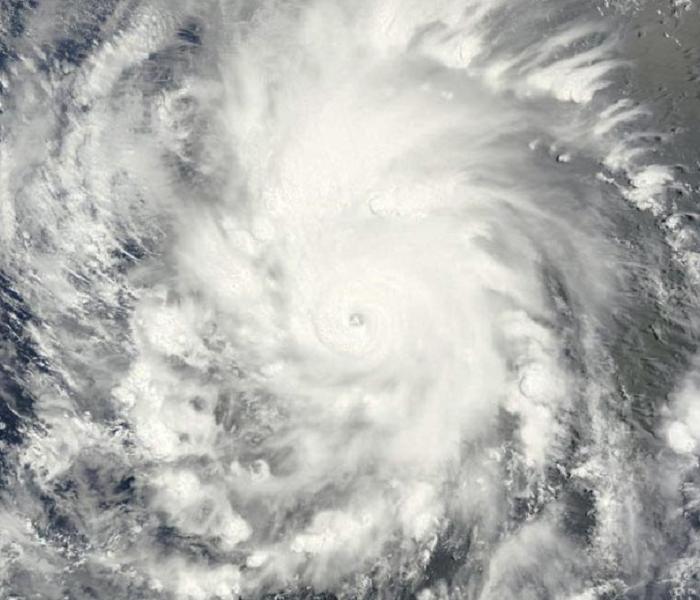 Hurricane Amanda in the eastern Pacific on May 25. Credit: NOAA
Hurricane Amanda in the eastern Pacific on May 25. Credit: NOAA
Hurricane Amanda Just Set an Ominous New Record
The first eastern Pacific hurricane of 2014 set a new intensity record. Here's why we could see even stronger storms before the year is over.
Usually, people living in the United States don't pay much attention to hurricanes in the eastern Pacific, the other basin where megastorms that can affect North America are formed. Mostly, these storms wallop Mexico, or travel harmlessly out to sea. So, given the standard myopia of the media, we rarely hear much about them.
But this year, perhaps, we ought to be paying more attention. The eastern Pacific hurricane season started on May 15, and already, with its first storm, it has set an ominous record. The hurricane in question, named Amanda, spun up south of the Baja California peninsula Thursday, and on Sunday it attained maximum sustained wind speeds of 155 miles per hour—just below Category 5 status. Or as National Hurricane Center forecaster Stacy Stewart put it when the storm reached its peak strength: "Amanda is now the strongest May hurricane on record in the eastern Pacific basin during the satellite era."
This record is notable for two reasons. First of all, even though there remains a great deal of uncertainty and debate about the relationship between hurricanes and global warming, the fact is that in many hurricane basins across the world, new storm intensity records have been set just since the year 2000. Amanda therefore fits into this broader pattern.
Second, there is growing evidence that El Niño conditions—characterized by an eastward shift of warm water across the great Pacific Ocean, with global weather ramifications—are developing in the Pacific right now. The latest forecast from the National Oceanic and Atmospheric Administration now gives us a greater than 65 percent chance that El Niño conditions will develop by this summer.
Beware Those Uninvited Guests at Picnics and Beach Excursions: Thunder and Lightning Can Be Dangerous
5/27/2014 (Permalink)
Reprinted from www.fema.gov
Beach, softball and picnic season offers lots of opportunities for outdoor fun.
Most of us look forward to these sunny day celebrations all year, but unfortunately Mother Nature doesn’t always cooperate.
Most of us have had the experience of being outdoors when we feel the first few drops of rain on our shoulders, hear rumbles of thunder in the sky or spot a flash of lightning in the distance.
Many of us heard as children that it’s possible to gauge how far away thunder and lightning storm is by counting the seconds between the sound of thunder and the appearance of lightning in the sky.
Scientists say that there is truth to that assumption. While the speed of sound changes depending on the temperature and the amount of humidity in the air, it can reasonably be estimated to travel at approximately 1,200 feet per second or approximately one mile in five seconds.
Counting the seconds after you see the first lightning bolt in the sky, you can estimate how far away it is by using this rough measure. If 10 seconds pass before you heard thunder, then the source of the lightning is approximately 2 miles away.
Safety experts advise abiding by the 30/30 lightning rule: Go indoors if, after seeing lightning, you can’t count to 30 before hearing thunder, and stay indoors for 30 minutes after you hear the last clap of thunder.
Remember, lightning is both unpredictable and dangerous. Between 1950 and 2012, lightning killed more than 4,000 Americans.
The top three states for lightning fatalities are Florida, with 468 deaths between 1959 and 2012; Texas, with 215 deaths between 1959 and 2012, and North Carolina, with 194 fatal strikes
While lightning may be less frequent in other states, it is no less deadly when it strikes. From 1959-2012, 74 New Jerseyans were killed by lightning.
The riskiest time of day for lightning strikes is during summer afternoons and evenings.
If you are caught outside during a sudden thunder and lightning event, get inside a building or take shelter in a hard-top (not a convertible) automobile.
Keep in mind that, contrary to common folklore, rubber-soled shoes and rubber tires provide no protection from lightning. It is the steel frame of an automobile that provides some protection, not its rubber tires. Although you may still be at risk of injury inside an automobile, you are safer there than you would be out in the open.
If you are in an open area without shelter, go to a low place such as a ravine or valley. Be alert for flash floods.
If you are in a forest when a storm approaches, seek shelter in a low area under a thick growth of small trees.
If you feel your hair stand on end, which indicates that lightning is about to strike, squat low to the ground on the balls of your feet, put your hands over your ears and put your head between your knees in order to make yourself as small a target as possible. It’s important to minimize your contact with the ground. Do not lie flat on the ground.
Remember: Your chances of being struck by lightning are about 1 in 600,000 – but it does happen.
Before you make plans for the beach, ball game or picnic, check the weather report to see whether there is a Severe Thunderstorm Watch or Severe Thunderstorm Warning for your area.
By taking a few precautions, you can substantially reduce your risk of being injured by lightning and enjoy all that summer has to offer.
For more information about protecting yourself during lightning and thunderstorms, go to www.ready.gov.
Firms Gird For Climate Change
5/23/2014 (Permalink)
Reprinted from The Boston Globe
While little action is expected from Congress on climate change, many businesses in Boston and beyond are taking matters into their own hands, preparing for a warmer world in which severe weather, rising sea levels, and increased flooding threaten property, operations, and earnings.
Developers have moved electrical units from the basements to rooftops of buildings in the Seaport District along Boston Harbor. Utilities in New England have elevated substations several feet above the ground and replaced wooden electrical poles with steel ones that can withstand powerful winds.
Insurance companies, in response to clients, are testing products designed to protect against varied effects of climate change, and providing more coverage against natural disasters. The Hartford insurance company now offers small businesses policies against losses due to widespread power outages, a growing concern as major storms occur more frequently.
"We think the time for debating [climate change] is over," said Ed White, vice president of customer strategy and environmental for National Grid, a British company with its US headquarters in Waltham. "We see it occurring. We've lived through the flooding, we've seen the damage that it had to our communities and our equipment."
Recent evidence has added to these worries. Earlier this month, a federal study warned that the climate in the United States was changing at a faster pace due to the burning of fossil fuels - such as oil, coal, and natural gas - that emit greenhouse gases blamed for rising global temperatures. That has resulted in longer droughts and more wildfires in the West, stronger hurricanes in the South, and degraded air quality in the Midwest, the study by a panel of scientists concluded.
The Northeast, the study found, would be particularly hard hit as climate change accelerates, baked by heat waves and flooded by rising sea levels and torrential downpours.
FM Global, a commercial insurance company based in Rhode Island, is receiving more requests from its clients for climate-related risk analysis and quotes for flood and drought protection, the company said. Businesses are increasingly worried that severe weather could delay shipments or flood buildings, such as data centers that contain expensive equipment and even more valuable corporate and customer information, said Lou Gritzo, a vice president and manager of research for FM Global.
The number of FM Global engineers studying flood issues will soon grow to 15, more than triple the number five years ago. The researchers are doing significantly more testing of flood barriers and other products aimed at keeping water out of doorways and parking lots to determine their effectiveness, with the idea of offering business clients discounts for using the approaches that work.
Before Hurricane Sandy battered the East Coast in 2012, FM Global tested two flood mitigation products per year. Last year, it tested 27, Gritzo said.
In the Southwest and West, Gritzo said, businesses face the opposite problem: water shortages, which scientists say will become more acute as temperatures rise. FM Global is testing fire sprinkler systems that consume less water by misting instead of dousing the flames.
The company is also looking at ways to recycle water use to conduct regular and necessary tests of sprinkler systems to protect against fire.
"We've certainly seen a natural emerging concern from our clients," Gritzo said. "We have a lot of water where we don't necessarily want it and not enough where we need it."
Insurers, too, are concerned about hurricanes, tornadoes, and wildfires occurring more frequently. Three of the top six years for catastrophic insured losses have occurred since 2005 with a combined $142 billion in expenses, according to the Insurance Information Institute, an industry research group that has tracked the costs since 1989.
Data about climate, which was primarily used by federal agencies and insurance companies in the past, is now sought by all types of businesses and organizations, from health care providers to banks to manufacturers, said Kyle Beatty, the president of Verisk Climate. Verisk, headquartered in New Jersey, bought a Lexington climate research firm six years ago in anticipation of growing demand for climate information.
A retailer may want to know the likelihood of major storms downing power lines and triggering blackouts that would close stores, Beatty said. A manufacturer might want to diversify suppliers if a particular contractor is in a flood-prone region.
"The business reaction is to the fact that they're experiencing impacts to their operations and earnings that they haven't in the past, they need strategies to address that," Beatty said.
While corporations are adapting their businesses to more severe weather threats, many have been criticized by environmentalists for doing too little to curb activities that contribute to climate activities. A global survey of business executives in December by the MIT Sloan Management Review found that fewer than half said their companies were taking such steps as improving energy efficiency or cutting pollution to reduce greenhouse gas emissions.
Smaller businesses remain unprepared for a changing climate, said Cynthia McHale, director of insurance programs at Ceres, a Boston-based coalition of investors and environmentalists. Many still don't have the necessary insurance to cover all the potential losses, such as business interruption coverage that can cost hundreds to thousands of dollars.
Getting more information to these companies so they better understand the threat can help, McHale said, but businesses alone can't prepare for the effects of climate change. If coastlines are going to shift and streets turn into canals, governments must be ready to invest in measures such as elevating roadways, building seawalls, and placing utilities underground.
"Ultimately," McHale said, "we're headed to a very different future."
Why This Summer Could Be Hot Hot Hot
5/21/2014 (Permalink)
Summer 2014 is now emerging as an El Niño summer. The climate prediction center has placed the East Coast, Southeast, and West in an area of very hot weather. How hot would it get? Temperatures heading into an El Niño summer would mean 50% more 90+ degree days in places like Boston, Providence, New York City, Philadelphia, Baltimore, and Washington. High humidity will accompany the heat, with at least 25 days exceeding 100 degrees with the afternoon heat index.
This would also mean bad news for West Coast's wildfire season and a continuation of the current drought in California. Relief for CA wouldn't come until December-February, with Southern CA, Southwest, and Southern Rockies getting more relief in the winter vs. Northern California.
The pre-El Niño months of May and early June should definitely see a sign of warmer-than-normal temps in the East and Southeast and West, and the core of summer will bring once we get into the core of summer we'll see an El Niño roaster for the East Coast and South. The confidence is trending up with the forecast, and the latest IPC computer modeling shows a 66% chance of an El Niño this winter.
Models can overplay the warming of the oceans due to climate change and the predicted El Niño could be masked like the one in 2012; however, the law of averages shows it's time for the seven year El Niño itch.
Called a Kelvin Wave, an expanding pool of water now 4-6c above normal on the upper surface water of the Pacific Ocean which gets bigger and bigger. Some experts say it's may rival the Kelvin Wave of 1997-98 - the biggest El Niño of all-time. Why is this wave important? As the surface waters start to warm, the pool of water pushes East against the normal West flow of the Pacific. The true indicator of whether we end up with a weak or moderate El Nino will be how far this huge, warm pool of water travels over the Pacific Ocean the next 2-12 months. If the entire pool of toasty water moves Eastward to the West Coast of Mexico and South America, you set the stage for a potential Pineapple Express. Throw in a moisture-laden jet stream from Hawaii and strong El Nino, and the entire southern half of the United States is wet this winter. On the contrary, if the pool of water stays parked in the Central Pacific you get a weak to moderate El Nino.
If you have summer plans for the beach, or plan on visiting the local lake to cool off, you'll be glad you made that reservation. The areas of the U.S. to see the biggest increase in the heat this summer will be: California, Nevada, Arizona, Utah, Oregon, Texas, Oklahoma, Missouri, Georgia, Virginia, Maryland, Delaware, DC, New Jersey, New York, and Pennsylvania.
Remember Pets When Planning For Emergencies
5/20/2014 (Permalink)
Reprinted from FEMA
For many households, there is an extra element to account for when making plans for disasters – the family pet.
Pets are an important part of many households and their unique needs should be taken into account, as they are particularly vulnerable when a disaster strikes, particularly one that requires evacuation or relocation. They are unlikely to survive on their own if left behind, and if they do, they could run away and be difficult to find afterwards.
“A pet needs the bare necessities during a disaster. These include food for a few days, one gallon per day of water, medical records and medication, and leash and collar,” explained Kathy Johnson, Director of the Bergen County Humane Society. Pets’ basic needs are similar to those of humans:
Water: A minimum of a week’s worth of water for each pet.
Food: A minimum of a week’s worth of food. Keep canned or dried food in airtight containers. Include a manual can opener. Food should be changed every six months.
Shelter: A pet may require a personal carrier or cage, which should be big enough for your pet to stand and move around in.
You can create a pet disaster kit with a first aid kit and pet first aid guide book, which can be bought at any pet store or online. Your pet’s medicine and medical records can be kept in the first aid kit and kept up to date. Other important documentation, such as adoption papers, vaccination records, feeding schedules, behavior issues and your veterinarian’s contact information, should also be kept in a waterproof bag or container.
Not all emergency shelters allow pets, so pet owners need to know what their other options are if they need to evacuate. Ask family and friends that live outside your area if they might be willing to take your pets until you return, or just to check on them if something happens when you are not home. A kennel or your veterinarian’s office could have the resources to board your pet if you have to evacuate.
Another option is hotels and motels that allow pets during emergencies. Some websites that have information on these hotels and motels are: BringFido.com, DogFriendly.com, DogInMySuitcase.com, Pet Friendly Hotels & Motels, PetsWelcome.com and TripsWithPets.com. Call ahead for a reservation as soon as the possibility of evacuation comes up.
Bring a few of your pet’s favorite toys and comfort items to help him stay calm and reduce stress. Have some sanitation items such as cat litter, litter box and scoop, trash bags, newspaper and paper towels. Also consider taking a picture of you with your pet. In case you get separated, you can show what your pet looks like. You will also have proof that it is your pet if he’s found.
Pets should have some form of identification on them. The simplest way is a regular collar tag, which should have the pet’s name, your name, address and phone number on it. A waterproof pouch containing identification information can be attached to the collar.
The other common identification method is a microchip implanted underneath the animal’s skin with all of its information on it. A veterinarian or an animal shelter can perform the procedure, but the chip also has to be registered. For confined animals, such as birds, reptiles and small mammals, identification should be kept on the cage.
Birds, fish, reptiles and amphibians require special care, especially during a disaster. Birds can be transported in a covered carrier and then moved to a regular cage. They should be kept in a quiet area. You will need a plant mister to keep the bird cool, a hot water bottle to heat the cage, materials to line the bottom of the cage, and necessary dietary supplements.
Reptiles can be transported in a cloth sack, such as a pillowcase, or a regular carrier. Upon arrival, immediately transfer the reptile to a secure cage. If possible, have the reptile defecate before transporting by soaking it in a shallow water bath. Also, have a water bowl for soaking, spray bottle for misting, heating pad, appropriate handling supplies, extra bags and newspapers, and dietary supplements.
Fish and amphibians can be transported in watertight plastic bags or ventilated plastic containers. Terrestrial or semi-aquatic amphibians only require a small amount of water. Moistened paper towels, clean foam rubber, or even moss will suffice. Fish and aquatic amphibians need plenty of water. The bag should be at least one-third full, then inflated with air and closed. Using water from your pets’ normal living space will probably reduce physiologic stress. It is recommended to monitor the water, temperature, humidity, lighting, and nutrition while your pet is at the shelter.
All of these animals should be kept away from heavy traffic areas, loud noises, and vibrations. All carriers should be escape-proof. Birds need to be fed and given water on a daily basis. Feed your fish, reptile or amphibian on its regular schedule if you can.
For more information on preparedness for your pets, visit www.ready.gov.
Are Home Warranty's Worth the Money?
5/15/2014 (Permalink)
Many people believe the only good thing about owning a home warranty is that it might help sell your home, but if you're not moving, their protections are limited.
Typically, warranty companies are difficult to deal with. Most require you to use their contractor only; rendering the warranty company only as good as authorized contractors. If the company partners with unlicensed contractors, or contractors with poor Better Business Bureau histories, you could have a mess on your hands. That is, if they even show up.
Consider an alternative: set aside $50 a month in a repair fund. Tap into it instead of a $400 to $600 annual warranty when major things start to fall apart.
Like anything else, you should shop several types of home warranties. Compare the costs, histories and reputations, especially the deductibles and rates-of-response. But also compare them to the cost of starting your own repair fund -- and to the cost of a solid termite contract that includes a repair guarantee.
Testimonial from a Happy Customer! Meet Crew Chief Aron Caracushanky
5/14/2014 (Permalink)
We are writing this letter to highly praise the services that we received from Aron Caracushansky. Even though we met him under the most stressful of circumstances, his outstanding qualities are immediately evidenced.
Aron had total command of our situation, he was completely organized and he took exceptional pride in what he did. He followed through on everything he said that he would do and helped ease the extreme stress that we felt by his capable and calming demeanor.
We feel confident in recommending Aron Caracushansky to anyone. He is not only patient, diligent and dedicated, but also caring and always willing to take the time to discuss and address any of our concerns. We never had to ask Aron more than ONCE for anything!
It becomes so clearly evident how dedicated Mr. Caracushansky is to making sure that everything is done to the best that it can be-“not just done”.
We can state with confidence that the outstanding qualities he has shown will be an asset in any business. You are indeed truly fortunate to have such a special person in your employ.
Eliot & Wendy Cohen
Homeowners
Insured Loss Estimate for April U.S. Storms in Hundreds of Millions
5/13/2014 (Permalink)
By Tim Sprinkle, PropertyCasualty360.com
Now it’s official. April’s thunderstorms were big.
The series of storms that wreaked havoc across much of the United States in April rank as the first billion-dollar economic loss event of 2014 that can be attributed to convective thunderstorms, according to Aon Benfield’s monthly Global Catastrophe Recap report, released Wednesday. At least 39 people were killed by flash flooding and severe weather during the storms, which included nearly 70 confirmed tornadoes across more than 20 states in the Plains, Mississippi Valley, Southeast, Midwest and Mid-Atlantic regions.
Insured losses due to the multi-day outbreak will likely end up in the hundreds of millions of dollars, Aon Benfield said.
“The recent outbreaks of tornadoes, large hail and damaging straight-line winds in the United States have emphasized the importance of historical data analysis for insurers and reinsurers when trying to forecast future losses,” said Adam Podlaha, head of Impact Forecasting with Aon Benfield, in the report.
Widespread damage
And the “big” April storm was just one example.
Aon Benfield also attributed economic losses of $950 million to a large hailstorm that hit the Denton, Texas metro area in April, an event that generated insured losses of about $650 million. That storm also caused widespread damage in parts of the Plains, Midwest and Mississippi Valley.
Homeowners need to stay updated on what policies cover, experts say
5/12/2014 (Permalink)
Owners of the 22 homes submitted badly damaged or destroyed in the Yarnell, Arizona area during recent wildfires have asked the Arizona Department of Insurance to review their claims and coverage limits to verify whether insurers carried out policy terms correctly. For other Arizonans and millions of homeowners across the country, the episode underscores the importance of checking occasionally to make sure you have enough insurance to rebuild after a disaster. Insurers regularly urge customers to review their policies and alert them when buying new furnishings or making improvements that increase the value of a dwelling, but homeowners counter that it's still up to the companies to make sure coverage amounts are accurate.
As the Yarnell case demonstrates, specifying an appropriate rebuilding or "replacement cost" amount isn't easy, especially because building costs can escalate when hundreds of homes get destroyed in a catastrophe.
"Don't get confused by the market value of your house," said Linda Ma, whose two-bedroom house was among 127 destroyed by the blaze, which also caused the deaths of 19 Granite Mountain Hotshot firefighters. A home's market value isn't the same as the cost necessary to rebuild it, she noted.
J. Robert Hunter, director of insurance for the Consumer Federation of America, said underinsurance is a pervasive problem of the sort that doesn't become apparent until after a fire, flood, severe windstorm or other calamity causes heavy damage. "It follows almost any kind of disaster," and even individual fires or other problems, he said.
Policies don't cover the value of land on which homes sit, and foundations probably don't need to be covered either, Hunter said.
Marshall & Swift/Boeckh, a leader in building-cost information, last year estimated that 60 percent of American homes have inadequate insurance, with values understated by an average of 17 percent. That figure has gradually improved from two decades ago, when the company said 73 percent of homes were undervalued by 35 percent, but it still means a lot of people couldn't completely rebuild their dwellings at today's costs for labor, materials and fees.
If you have a mortgage, your lender will require insurance. But if the house is paid off, especially by retirees on a budget, there's a temptation to cut back on coverage — or let it lapse.
Insurers often urge homeowners to make sure they have adequate coverage, but they can't force people to obtain it. Homeowners, in turn, want to minimize their premium payments and often are more than willing to go along with lower home-value estimates.
"People often buy too little insurance, even on purpose," Hunter said. "They don't expect a total loss."Premiums reflect factors including local housing prices, materials costs, competition in the state's insurance market and perceived risks in the area for windstorms, hail, floods, earthquakes and other hazards.
Coverage varies. The most basic form is actual cash-value coverage, which pays a reduced amount for items and structures, reflecting depreciation and wear and tear. Rather than a new couch, you would receive enough money to buy a replacement for the 10-year-old used couch you just lost. Premiums on actual-cash value policies tend to be lower.
Replacement-cost coverage provides more extensive protection, often 25 percent above the dollar limits specified in a policy, said Christopher Hackett, director of personal-lines policies for the Property Casualty Insurers Association of America.
But even replacement-cost might not be enough to rebuild in full. Some insurers offer guaranteed replacement-cost coverage, for a higher premium, that would foot the entire bill of reconstruction. But a lot of insurers don't offer this open-ended protection, or do so only on a grandfathered basis for their longest-standing policyholders, said Hackett.
And there might be other variations, such as coverage that pays to reconstruct a home to current building codes. For example, some cities including Boulder, Colo., require homes to be built using energy-saving features that are more costly, said Nicole Mahrt, a spokeswoman for the PCIAA.
Other factors
Insurance policies can be hard to understand, but it's important to find out whether your coverage is for actual-cash value, replacement cost or something else.
"Most agents steer homeowners away from actual-cash-value policies," Hackett said. "They want you to have a good customer experience if you make a claim."
Standard policies typically insure a house and adjacent structures if any, along with personal belongings. They also usually pay related expenses, such as lodging costs for the household's occupants and pets if they must evacuate or if the home becomes unlivable. That's in addition to personal-liability and medical components that cover accidents and injuries to others at the property.
Other types of coverage, for things such as debris removal or separate structures such as garages, often are based on the policy limits for the main home. So if the dwelling has insufficient coverage, so, too, could these other items.
All that's in addition to trying to estimate the value of furnishings, other personal belongings, carpeting, cabinetry, fixtures and more. Photos are important, but a full inventory also should include receipts, model numbers or styles and other documentation that can bolster a claim.
Surge in demand
A recent general notice mailed by State Farm to some customers warns about the dangers of insuring a home for less than its replacement cost — a scenario that "may result in your having to pay thousands of dollars out of your own pocket to rebuild your home if it is completely destroyed," the notice said.
State Farm and Farmers insured 14 of the 22 Yarnell-area homes for which owners are disputing settlements. First American had two disputed policies, while Allstate, Travelers and a handful of other firms had one each, according to the homeowners group.
"There are times when consumers may undertake remodeling projects, room additions or upgrade furnishings and personal belongings without realizing that these changes may have an impact on the amount it would take to fully replace their homes," Farmers said. "Other situations like having a home office or having a collection of items that support a hobby may also affect the amount of insurance."
State Farm's letter warns about "demand surge" or the tendency of prices to escalate for labor and materials following a disaster such as an earthquake, tornado or hurricane. It's a problem that Yarnell residents have been complaining about.
While cognizant of higher rebuilding expenses in their area, Yarnell homeowners said they mainly see the issue as one where insurance companies offer lowball settlements in the hope that displaced homeowners will accept them.
But insurance officials counter that the incidence of complaints after disasters often is low. For example, New York's Department of Financial Services, in a report published one year after Hurricane Sandy, found that only about 1 percent of homeowners, motorists and business owners in the state who filed claims had lodged complaints up to that point against their insurers.
State Farm's letter encourages homeowners to obtain a current rebuilding-cost estimate from the company, one of its agents or from an independent contractor, architect or real-estate appraiser. That's part of the rub, because homeowners might assume their agents can provide accurate assessments when those estimates, in reality, could fall short.
More-accurate cost estimates would help, but it's also critical for homeowners to make sure they have the right type of policy. For example, homeowners can compile a detailed list of what it would cost to reconstruct their dwellings. But if they stick with actual-cash-value coverage to save money in premiums, they still likely wouldn't receive the entire amount necessary to rebuild. That's why more homeowners need to do a better job perusing their policies and the notices sent periodically by insurers describing updates.
Are you underinsured?
Your homeowners insurance policy might not provide adequate compensation in the event of fire or other disaster. You might be underinsured if:
• Your coverage estimate is based on market prices, which aren't the same as rebuilding costs.
• You haven't included changes or improvements such as a new bathroom, customized kitchen, new flooring or expensive window blinds.
• You live in an outlying area into which laborers and construction materials would need to be imported at added expense.
• You haven't adjusted the coverage value to reflect inflation in materials and labor costs.
• Your home has historical significance or was constructed with unusual building materials.
• You haven't factored in separate structures, added living expenses or landscape-debris removal
Sudden, Swirling Firenado Rises out of Farm Fire
5/9/2014 (Permalink)
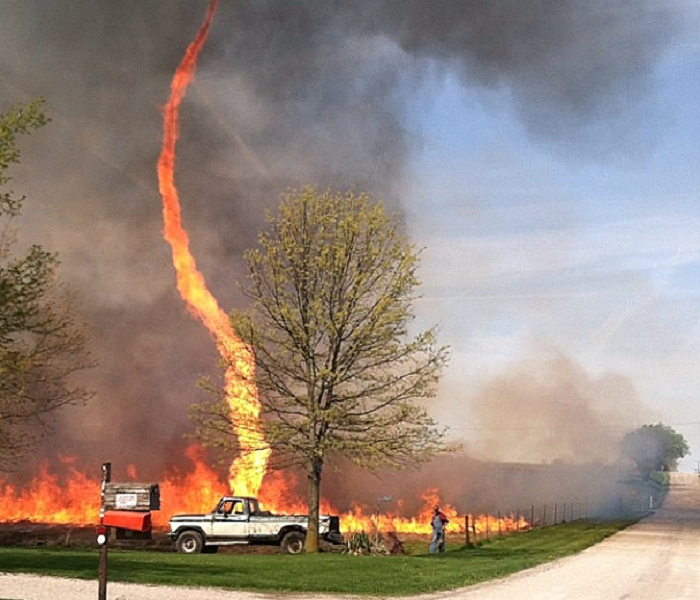 A firenado is spawned on a field in Chillicothe, Mo., the week of April 7, 2014. (Photo/Janae Copelin)
A firenado is spawned on a field in Chillicothe, Mo., the week of April 7, 2014. (Photo/Janae Copelin)
Stunned by the "coolest, scariest thing" she had ever seen, Photographer Janae Copelin caught a snapshot early this week of a rare weather marvel known as a firenado.The whirling "fire-devil" was spawned as a farmer burned off his field in Chillicothe, Missouri.
A swirling rotation of smoke, gas and debris, a firenado is generated when an active fire is swept upwards by strong winds, creating a vortex.
"The heat of the fire rising through the air allows the vortex to strengthen and create the firenado," AccuWeather Meteorologist Eric Leister said. "The firenado can then suck more brush and debris into itself and fuel the fire further."
Firenadoes can be extremely dangerous, as they have the ability to throw burning embers miles away. They are usually between five and 10 stories high and can measure up to 10 feet wide.
While this rarity lasts usually only minutes, the largest firenadoes have been known to create winds topping 100 mph.
Site Pollution Coverage for Medical Facilities
5/7/2014 (Permalink)
By Amanda Duncan, President, PartnerOne Environmental
Healthcare facilities, from large hospital campuses to corner drugstores, face many potential pollution exposures. These exposures are typically excluded from a General Liability and/or Property insurance policy, so it is crucial that this type of insured acquires additional Site Pollution coverage to cover any possible issues. Environmental concerns that can arise from these sites include, but are not limited to:
Storage of chemicals/medicines/biological waste causing bodily injury, property damage, or requiring cleanup
Mold/Legionella resulting from poor indoor air quality, leaks, and equipment damage.Over the road spills of medical waste which could damage nearby property, streams, and wildlife.Leaking storage tanks causing extensive damage onsite and to neighboring property.Non-Owned Disposal Sites; medical waste emanating from a covered non-owned facility.Pollution policies are available in the environmental insurance marketplace that can be tailored to meet the needs of the healthcare industry. These policies provide coverage for on-site cleanup costs and third party bodily injury, property damage, and cleanup as a result of a pollution condition at, on, under, or migrating from a covered location. Coverage is provided for all locations scheduled onto the policy. Coverage for aboveground storage tanks is built into the policy form; underground storage tanks may be added via endorsement. Transportation coverage for medical waste hauled by the insured or by a contracted carrier can be offered, as well as Non-
Owned Disposal Site coverage for the waste disposal. Natural resources damage and Emergency Expenses are additional coverages usually found in a quality policy form. Coverage for Mold and Legionella are common when a product is designed for exposures associated with healthcare facilities.
Target customers who should consider purchasing Site Pollution coverage include: hospitals, physicians’ offices, dental offices, veterinary offices, clinics, drugstores, and imaging centers. Premiums generally start at $3,000 for $1,000,000 policy limits.
Claims Scenarios for Healthcare Facilities:
A fuel oil tank at a medical office leaks, releasing oil into the soil and groundwater and affecting neighboring properties. Local authorities require the hospital to clean up the contamination. The cost for cleanup exceeds $400,000.
A landfill used by a hospital is a source of contamination to a drinking water well located down-gradient from the facility. The hospital is found to be a responsible party as their waste has been disposed of at the landfill for many years. The insured contributes over $100,000 to settle the claim.
A medical waste transporter hired by a doctor’s office overturns and waste is spilled into a stormwater drain, contaminating a nearby stream. The cost of cleanup exceeds the transporter’s policy and as the party responsible for generating the waste, the insured is required to pay the remaining costs associated with the cleanup.
Indoor air quality issues stemming from a damaged air conditioning system in a local hospital sickened several patients in which there were two fatalities and several patients in critical condition. Claims for bodily injury exceeded $1,000,000.
As you can see, pollution exposures can be quite significant for various healthcare facilities and any response to a pollution event can become expensive. However, the environmental insurance marketplace offers several affordably priced, quality solutions, providing these facilities proper coverage and peace of mind.
Protecting Your Property From the Threat of Spring Flooding
5/5/2014 (Permalink)
Reprinted from the Spring 2014 CAI - LI Chapter Newletter
By Deborah Rashti, VP of Marketing for SERVPRO of GN/PW
This was some winter! And the deluge of water that fell from the sky the last day of April was another example of Mother Nature’s wrath. While we count on spring showers to bring us May flowers, we do not take too easily to the flash flooding that sometimes accompanies it. Last month’s mudslide in Washington State that smothered almost an entire community is one of many examples of how dangerous spring flooding can be.
When rainwater overpowers drainage systems, basements are easily susceptible to flooding. Being proactive about keeping our gutter systems clear of debris is one of the simplest ways to minimize this possibility. Depending upon the surrounding landscape, you may need to do this more than a couple of times a year.
Unbenownst to most people, flushing gutters with hose water after removing leaves is a necessary step to make sure debris is completely removed. Since gutters need to hold a tremendous amount of water during heavy rains, the best time to see if they are working properly is 15 minutes after the downpour while it is still raining.
Overflowing gutters near a home’s foundation is not a good thing. While it may not necessarily cause flooding in a basement, this overflow can cause erosion around your foundation that could lead to cracking of walls and ceilings. Adding an additional spout or expanding the width of the spout can easily solve this.
While most of us do not like the esthetics of a spout that extends 10 feet from our home, it really is an excellent way to keep water away. Depressions of soil around the foundation of our home can be a red flag that there is a water problem. Catching this early can make a huge difference in the money you’ll save from avoiding a cleanup from flooding.
Don’t discount the risk of flooding coming from your sprinklers either. Not only do we not want sprinkler heads pointed at our home, but we also do not need more water after a significant rain. Adding more water to an already saturated property is opening yourself up to potential problems. Rain gauges serve an important purpose for our sprinkler systems and having them checked annually is in our best interest.
In the event that water is penetrating our basement from a source that lies below ground level, you will need an experienced waterproofer who has an excellent reputation. This is a tricky problem as hydrostatic pressure can push water through hairline cracks for a multitude of reasons. You need a good diagnostician to identify why the water is coming in and what is needed to correct the problem. Don’t even think about putting your basement back together BEFORE this is worked out.
As with anything, proper maintenance is key to minimizing costly repairs later on. As opposed to pipe breaks, basement’s flooded by rainwater is generally NOT covered by homeowners insurance. The amount of money involved in getting your basement back to pre-existing condition can be costly. Simple steps to maintain your home may require a commitment on your part, but may save you money in the end.
While it is hard to embrace our potential for flooding, keep in mind that much of the country is experiencing severe drought conditions and brush fires are a very real threat to their community. With careful planning, we can mitigate the potential loss of flooding due to heavy rains. Enjoy those spring flowers that we have waited so long to see.
Flood Awareness: Preparing Homes and Businesses For Spring Flooding Season
5/2/2014 (Permalink)
With spring flooding season here, the Property Casualty Insurers Association of America (PCI) is encouraging property and business owners, as well as renters, to prepare for flooding.
“There are many things property owners and renters can do to safeguard their homes, businesses and personal property before spring flooding hits,” said Chris Hackett, PCI’s director, personal lines policy. “Floods are the most common natural disaster in the nation and can be extremely devastating not only to property, but to a household’s finances if proper precautions are not taken. However, with some simple actions such as talking with your insurance agent or company about your insurance coverage options you can be better prepared if a flood occurs.”
First and foremost, PCI urges property owners and renters who do not already have flood insurance to purchase a policy from the National Flood Insurance Program (NFIP) as soon as possible. Basic homeowners and renters policies do not cover flooding. Consult an insurance agent or go to the NFIP website at www.floodsmart.com to find out about purchasing a policy. Understand that there is a 30-day wait upon purchasing a flood policy, so it is important to act before a flood is imminent.
Second, for those who already have flood coverage, policyholders should be sure to review their policies and what they cover, and discuss their coverage with their agents. It is important to keep the agent’s name and contact information in a safe and easily accessible place, and to take an inventory of all personal property. Photograph or videotape items for verification and keep the photos or video footage, as well as finance records or receipts of major purchases, in a safe place, such as a safety deposit box.
The NFIP’s website also recommends the following actions to prepare a home for possible flooding:
- Make sure if there is a sump pump that it is working and install a battery-operated backup.
- Install a water alarm in the basement.
- Clean gutters and downspouts to remove any debris.
- Anchor any fuel tanks.
- Raise electrical switches, sockets, circuit breakers, and wiring at least one foot above the home's projected flood elevation.
- If possible, place appliances such as a furnace, water heater, washer, and dryer on cement blocks at least one foot above the projected flood elevation.
Additionally, the NFIP’s website recommends developing a family emergency plan and a safety kit with basic components such as drinking water, canned food, first aid, blankets, a radio, and a flashlight. Components of emergency planning include posting emergency telephone numbers by the phone; teaching children how to dial 911; planning and practicing an evacuation route with family members; asking an out-of-state relative or friend to be an emergency contact; and preparing a safety plan for any family pets.
“With the proper preparation, property owners and renters can safeguard their families and property, reduce potential damages, and also speed up the recovery process,” Hackett said. “We ask all people who might face spring flooding to take these simple steps starting now, so they can be ready when the time comes.”
PCI is composed of more than 1,000 member companies, representing the broadest cross-section of insurers of any national trade association. PCI members write over $190 billion in annual premium, 40 percent of the nation’s property casualty insurance. Member companies write 46 percent of the U.S. automobile insurance market, 32 percent of the homeowners market, 38 percent of the commercial property and liability market, and 41 percent of the private workers compensation market.
May is National Electrical Safety Month
4/30/2014 (Permalink)
May is National Electrical Safety Month, and SERVPRO of Great Neck / Port Washington is pleased to provide the following information to raise your awareness!
The Electrical Safety Foundation International (ESFI) is dedicated exclusively to promoting electrical safety in the home and the workplace. ESFI proudly sponsors National Electrical Safety Month each May, and engages in public education campaigns throughout the year to prevent electrical fires, injuries, and fatalities.
The most recent statistical data from the National Fire Protection Association indicates an annual average of more than 53,000 electrical home structure fires, claiming more than 450 lives, injuring more than 1,400 people, and causing more than $1.4 billion in property damage. In the workplace, electrical hazards are the cause of another almost 4,000 non-fatal injuries. “Eliminating electrical hazards begins with education and awareness,” says ESFI President Brett Brenner. “National Electrical Safety Month is a time for all of us at home and at work to reexamine our surroundings and determine what steps we can take to prevent the hundreds of deaths, thousands of injuries and billions of dollars in productivity and assets that occur each year because of electrical hazards.”
To help promote electrical safety, ESFI has developed a campaign toolkit that is organized with tools you can use to facilitate an effective electrical safety awareness campaign for your community, organization, customers, and workplace associates.
ESFI’s complimentary 2010 NESM Campaign Toolkit can be downloaded on the foundation’s website at www.electrical-safety.org.
This year’s campaign will focus on one key electrical safety issue during each week in May:
Renovating the Right Way (May 2-8):Whether you are a first-time do-it-yourselfer or a “weekend warrior,” practicing safe habits can reduce your risk when it comes to home electrical work. Use ESFI’s Electrical Safety Workbookto conduct a basic electrical safety audit of your home.
Staying Safe at Work (May 9-15):Use ESFI’s new Office Safety Checklistto perform a basic electrical safety inspection at work and keep your office safe from electrical hazards.
Educating Your Children (May 16-22):Do your children know what it takes to stay safe when it comes to electricity? Visit ESFI’s Kids Corner, a new online resource that features teaching tools and educational resources to teach kids about electrical safety.
Remembering Electrical Safety in the Field (May 23-29):Use ESFI’s Never AssumeSafety Series to give you and your co-workers the right frame of mind when it comes to safety in the workplace. From job planning to arc flash awareness, this one-of-a-kind video program is a must for anyone working with or near electricity!
For more information about ESFI and National Electrical Safety Month, visit www.electrical-safety.org
Protect Your Home No Matter What Insurance Coverage You Have
4/28/2014 (Permalink)
With or without insurance there is a lot you can do to protect your home.
The following tips and safety measures should serve you well when you are concerned about minimizing the risk of suffering from damages, injuries or theft of personal items.
Home protection against water damage
Make sure that outbuildings are properly secured.
Any items located outside should either be brought inside or be also properly secured.Any object of value should be moved to a place where there is no possible flooding.Safeguard your home's climate and electrical systems by raising circuit breakers, switches, wirings and sockets to a minimum of twelve inches above the estimated flood level in the area.Make modifications on water heaters, furnace and other equipment found indoors so it is above the flood level.Modifications should also be done to air-conditioning units, electrical power units and fuel tanks, so that these are above the flood level.Install backflow valves on the home's sewer system so that sewage will not seep back inside the house in case of flooding.For homes that are located in areas that are frequently flooded, the options are:Raising the home to above flood level with the use of columns or piers.Wet proofing the home with the use of vents in its foundation that would direct flood water through or around the building.Dry proofing the home with the application of sealing or coating materials that keep out floodwater Home protection tips against strong winds
Install storm panels and hurricane shutters in windows.
Install braces, hurricane straps in roofs. Also, ensure proper installation of plywood sheathing.Strengthen garage doors.Shut off propane tanks.Have your doors properly reinforced with bolt kits installed in both their top and bottom sections.Consider building a storm shelter in your basement. A storm shelter serves to protect occupants of a home during severe storms and tornadoes. Get the help of a professional when building your storm shelter. A good storm shelter should bear the following features:It has to be anchored well to prevent uplift and being overturned.Its ceiling, door and walls has to be strong to enough to resist falling or flying debris and these must be capable of withstanding strong wind pressure.It has to be stocked with food and medical supplies that will allow its occupants to survive a minimum of three days.It has to have its own stand by power. Home protection tips to prevent burglaries
Living room tips:
Make sure that extension, lamp, phone and other cords do not get in the way of people.
Passageways should be clutter free.Runners and rugs should be secured in place.Furniture and curtains should have a distance of at least one foot from baseboard heaters.Ensure that the fireplace has a screen for catching sparks.Make sure that your chimney undergoes regular inspection and cleaning each year.Have your furnace serviced regularly each year. Kitchen tips:
Make sure that hand, paper towels, curtains and similar objects be kept away from the oven or from burners.
Always check that stove counters and tops are grease free.Microwave, toaster, coffeemaker and other kitchen appliances should be plugged into separate electrical outlets. Bedroom tips
Install a carbon monoxide detector nearby bedrooms.
Have a phone near your bed.Have a lamp near your bed.Bathroom tips
Install a nonskid mat in your shower or bathtub.Install a grab bar in your shower or bathtub.Make sure that the maximum hot water temperature is 120 degreesTips for other areas in the home
Install outdoor lights in entrances.Walkways should be free from holes or cracks.Make sure your home address is printed clearly outside of your home for emergency purposes.Check if there are areas where a guest may trip or slip.Install a smoke alarm.Install a burglar alarm.Have at least one fire extinguisher in your home.Develop a escape plan in case of fire.Check old or frayed electrical cords and replace them immediately.Have important emergency numbers beside your phone or place them on speed dial.Make sure that your main door is made of strong material like metal or solid wood.Install a wide-angle viewer on your main door.Windows that are found in the ground floor should be installed with key operated locks.For windows found in upper floors, make sure that tree branches are not near them to prevent access by would be burglars.Windows located in basements should be permanently secured if these are not in use.Keep the garage door always locked.Doors found in porches and patios should be treated with extra precaution because in many cases these are not in clear view of neighbors.Install yard lights where there can be blind spots or in areas where a person can hide.Install lights that have timers in your home's interiors. This is important whenever the home is left without an occupant. This gives the appearance of the home being occupied.The TV or radio can also be set to turn on or off at specified hours of the day to also give the illusion that the home is not empty.
Start to Twister Season Could be Quietest in a Century
4/25/2014 (Permalink)
By Miguel Llanos
Call it the silver lining in last winter’s polar vortex: This year has so far seen fewer twisters than any similar period in at least six decades and possibly a century or more.
The U.S. has so far seen zero tornado deaths –- the safest start since 2002.
The start of 2014 is definitely the slowest in terms of tornadoes since 1953, when the most detailed database was started, Harold Brooks, a senior researcher at the National Severe Storms Laboratory in Norman, Okla., told NBC News.
Slightly less reliable records dating back to the 1870s suggest “this is likely the slowest start to a tornado season since 1915,” he adds. “1900 is possibly slower and, prior to that, we're looking at the late 1870s and early 1880s for challengers.”
For Greg Forbes, the severe weather guru at The Weather Channel, the most striking data is that the start of 2014 marks “the longest that we have gone at least since 1950” without a tornado at 3 or stronger on the Fujita scale. Tornadoes are rated from 0-5, with 5 being the most powerful.
So how did the Arctic polar vortex play into this? Cold blasts coming down with the upper-level jet stream last winter prevented warm air from coming in off the Gulf of Mexico. That stalled the creation of storms from the clashing of cold and warm weather fronts.
“The cold winter weather systems drove cold, dry air even across the Gulf Coast states such that the instability was not adequate for severe storms even across the Gulf Coast states on most occasions,” said Forbes.
Another way to look at it, said Brooks, is that “the lack of warm, moist air at low levels of the atmosphere have meant there have been fewer than normal thunderstorms this winter and, as a result, fewer than normal tornadoes.”
So is there a chance that 2014 will go down as a season with no twister deaths? The odds are heavily against that: On average, twisters kill about 60 people each year in the U.S., and no year on record has ever been free of tornado deaths.
Moreover, late April and May have traditionally been the more active times for twisters. For Wednesday, areas from northern Nebraska to northern Texas face a “slight risk” of twisters, the Storm Prediction Center warned.
After a slow start in spring, Forbes warned, the jet stream pattern “is beginning to get more favorable” for twisters.
Warmer temperatures boost US economy
4/23/2014 (Permalink)
Associated Press
WASHINGTON — Spring’s thaw is reviving the economy, too.
A recent batch of government and business reports show a U.S. economy emerging from winter’s deep freeze.
Economists had expected growth to accelerate in 2014 after two years of slow and steady improvement. But an unusually bitter winter sent factories, hiring and consumer spending into hibernation.
Now, as temperatures rise, the economy is regaining momentum. Factories are busier. Consumers are spending more. Banks are making more loans to businesses. Companies have bigger plans to invest in plants and equipment. And the improvement appears to be widespread across the country.
“The weather really played havoc. There were ice storms in Georgia. That is not something you see every day,” said Michael Dolega, senior economist at TD Economics. “Now, as Americans have dug themselves out and everything has melted, you’re going to get a bounce back.”
Helping to drive the growth have been recent increases in manufacturing after tumbling in January. Factory production climbed 0.5 percent in March, after a 1.4 percent surge the previous month, the Federal Reserve reported last week. This suggests that manufacturers anticipate that demand from businesses and consumers will increase.
After the winter slowdown, recovering motor vehicle sales have boosted revenue for companies such as Batesville Tool & Die in Batesville, Ind.
“We feel like the auto industry is all the way back from before the recession,” said Jody Fledderman, the company’s president and CEO. “The numbers we see are fully recovered from then. We expect to see 4 to 8 percent increases in the industry overall for the next three or four years.”
Shopping has also recovered along with temperatures. March buying at general merchandise stores, such as Wal-Mart, Target and Macy’s, climbed at the fastest clip in seven years, the Commerce Department said last week.
Making Sure Your Home Is Properly Covered for a Disaster
4/21/2014 (Permalink)
From the Insurance Information Institute
For many people, their home is their greatest asset, so it is crucial to avoid being underinsured. To protect their investment from disasters, homeowners should update their insurance regularly to include improvements, major purchases and increased rebuilding costs.
Since the end of the Great Recession in June 2009, despite the major drop off in construction activity, construction prices have actually risen significantly. Furthermore, after a disaster, materials and labor may become scare, driving repair and rebuilding costs up even further.
To properly insure your home, it is important to ask your insurance agent or company representative four key questions.
1. Do I have enough insurance to rebuild my home?
Your policy needs to cover the cost of rebuilding your home at current construction costs. Unfortunately, some homeowners simply purchase enough insurance protection to satisfy their mortgage lender. Others confuse the real estate value of their home with what it would cost to rebuild it. Quite simply, you should have enough insurance to rebuild your home in the event that it is completely destroyed. Be sure to consider the following:
Replacement Cost
Most policies cover replacement cost for damage to the structure. A replacement cost policy pays for the repair or replacement of damaged property with materials of similar kind and quality.Extended Replacement Cost
This type of policy provides additional insurance coverage of 20 percent or more over the limits in your policy, which can be critical if there is a widespread disaster that pushes up the cost of building materials and labor.Inflation Guard
This coverage automatically adjusts the rebuilding costs of your home to reflect changes in construction costs. Find out if your policy includes this coverage or if you have to purchase it separately.Ordinance or Law coverage
If your home is badly damaged, you may be required to rebuild it to meet new (and often stricter) building codes. Ordinance or law coverage pays a specific amount toward these costs.Water Back-Up
This coverage insures your property for damage from sewer or drain back-up. Most insurers offer it as an add-on to a standard policy.Flood Insurance
Standard home insurance policies provide coverage for disasters such as fire, lightning and hurricanes. They do not include coverage for flood (including flooding from a hurricane). Flood insurance is available through the federal government’s National Flood Insurance Program (www.floodsmart.gov), but can be purchased from the same agent or company representative who provides you with your home or renters insurance. Make sure to purchase flood insurance for the structure of your house, as well as for the contents. Excess Flood Protection, which provides higher limits of coverage than the NFIP in the event of catastrophic loss by flooding, is available from some insurers. Keep in mind that there is a 30-day waiting period before the insurance is valid.
2. Do I have enough insurance to replace all of my possessions?
Most homeowner’s insurance policies provide coverage for your personal possessions for approximately 50 percent to 70 percent of the amount of insurance you have on the structure of your home. So if you have $100,000 worth of coverage on the structure of your home, you would be covered for $50,000 to $70,000 worth of the contents of your home, depending on the policy.
The best way to determine if this is enough coverage is to conduct a home inventory, which details everything you own and the estimated cost to replace these items if they are stolen or destroyed by a disaster. To help with this task, you can download the I.I.I.’s free home inventory software [link]. Remember to keep your home inventory in a safe place, and take it with you if you need to evacuate your home during a disaster.
You can insure your possessions in two ways: by their actual cash value or their replacement cost. Make sure you review with your agent or company representative which type of coverage is best for your particular situation.
Cash Value Policy
This coverage pays the cost of replacing your belongings minus depreciation.Replacement Cost Policy
This coverage reimburses you for the full current cost of replacing your belongings.
To illustrate the difference between the two types of policies, suppose, for example, a fire destroys a 10-year-old television set in your living room. If you have a replacement cost policy for the contents of your home, the insurance company will pay to replace the TV with a comparable new one. If you have an actual cash value policy, it will pay only a small percentage of the cost of a new TV set because the old TV has been used for 10 years and is now worth a lot less than its original cost. Some replacement cost policies specify that the insurance company purchase the new item, as they may be able to purchase at a bulk or special rate. The price of replacement cost coverage is about 10 percent more than that of actual cash value.
3. Do I have enough coverage for additional living expenses?
Coverage for additional living expenses pays the extra costs of temporarily living away from your home if you can't live in it due to an insured disaster such as a hurricane. It covers hotel bills, restaurant meals, transportation and other living expenses incurred while your home is inaccessible or being rebuilt. It is important to note that it covers only those expenses that are over and above your regular living expenses, so it would not cover your mortgage, or regular trips to the grocery store. If you rent out part of your house, this coverage also reimburses you for the rent that you would have collected from your tenant if your home had not been destroyed.
Coverage for additional living expenses differs from company to company. Many policies provide coverage for about 20 percent of the insurance on your house. Some companies will sell you a policy that provides you with an unlimited amount of loss of use coverage, for a limited amount of time.
Make sure you know exactly how much coverage you have for additional living expenses, and whether there is a time limit. If the standard coverage is not adequate, it can generally be increased for an additional premium.
4. Do I have enough insurance to protect my assets?
Although not a key element in disaster planning, it is also important to have adequate liability protection. This covers you against lawsuits for bodily injury or property damage that you or your family members may cause to other people. It also pays for damage caused by pets. Liability insurance pays for both the cost of defending you in court and for any damages a court rules you must pay—up to the limits of your policy. Most homeowners insurance policies provide a minimum of $100,000 worth of liability insurance, but higher amounts are available.
It is important to purchase enough liability insurance to protect your assets. If the standard liability coverage in your homeowners policy is not sufficient, you may need an excess liability, or umbrella, policy, which provides additional coverage over and above what is covered in your home (and auto) insurance policy.
5 Spring Cleaning Ideas to Improve Indoor Air Quality
4/18/2014 (Permalink)
This article was written for UL by Mother Nature Network, 2013
Ah, springtime! Time to throw open the windows and sponge, sweep, swab, squeegee, scour, scrub and scrape your home into a speckless state of perfection. Or, at the very least, it’s probably a wise idea to stash away the snow boots and give the contents of your fridge the seasonal once-over.
Spring cleaning also provides us with the opportunity to zero in on and ideally improve the indoor air quality (IAQ) of our homes. For many, the aim of spring cleaning is to achieve a state of spic and span nirvana that’s capable of knocking the socks off even the most fastidious mother-in-law or anyone else who relishes nothing more than detecting – and gleefully pointing out – spots that, whoops, you “missed.”
To reach this state, we often find ourselves employing products to help give our homes a spotless, mother-in-law-proof glow. Yet at the same time, these same products can compromise indoor air quality and, as a result, our health and overall wellbeing. In fact, air pollutants are two to 10 times higher indoors than they are outdoors. The household cleaners that we spritz and spray during zesty spring cleaning sessions – and throughout the year – are among the culprits.
Below are five suggestions on how to breathe easy and improve the indoor air quality of your home this spring, while also leaving it dirt-free and in apple pie-order.
Eau de nothing: Opt for fragrance-free cleaning products
Nothing says spring like inhaling an invigorating whiff of “alpine meadow” after going to town on the kitchen with a surface cleaner. However, those reassuring scents that signal a state of clean are rather dirty in composition: there are more than 3,000 petroleum-based chemicals used to manufacture fragrances found in household cleaners and other consumer products. Overwhelmingly, these chemicals, often responsible for triggering asthma, allergic reactions and a host of respiratory ailments, are not listed on the product packaging.
So how to avoid? When restocking your arsenal of cleaners and laundry products, opt for unscented/fragrance-free varieties. Or, go with an eco-friendly scented cleaner produced by a company that’s transparent about what exactly goes into each bottle. Generally, the scents found in these products are naturally derived and safer. The Environmental Working Group’s Guide to Healthy Cleaning is a good place to start your reconnaissance work to learn more about cleaning products free of artificial fragrances and other dubious chemicals.
Homemade cleaners: Tried, true and grandmother-approved
Just as swapping out synthetically scented products with fragrance-free alternatives can help to improve indoor air quality, so does concocting your own cleaners. Added bonus? You’ll save a few bucks. There are numerous reliable recipes available for effective DIY household cleaners that employ items that you may already have around the house: baking soda, white vinegar, lemon juice, salt, hydrogen peroxide, and more. And if you’re still hung up on scent, adding certain essential oils not only boost the stain-removing and sanitizing abilities of the cleaners, but also make the proceedings a bit more olfactory-friendly.
And with the cash saved from making your own cleaners using common pantry staples, why not treat yourself to a bunch of fresh-cut flowers that will pretty things up and truly introduce the real smell of spring into your home?
Suck it up: Invest in a HEPA vacuum filter
Is your trusty vacuum cleaner, the most crucial of all spring cleaning tools, about ready to bite the dust instead of suck it up? Use this unfortunate occurrence as an opportunity to invest in a vacuum that harnesses HEPA (High Efficiency Particulate Air) technology.
Although they’re great at removing clumps of dust and dirt, traditional vacuums with standard filters also do a bang-up job of recirculating tiny-teeny fine particles (pollen, animal dander and dust mite feces for example) around your house. This, of course, is bad news for those suffering from asthma and allergies. Vacuums with HEPA filters, however, remove 99.97 percent of allergens of .3 microns. In other words, they suck up pretty much everything. Although more expensive, HEPA vacuums can help to dramatically improve indoor air quality – just be sure to look for true HEPA filter models and not “HEPA-like” models.
Vapor steam cleaners: A multitasking, IAQ-improving powerhouse
Most of us have been there: On our hands and knees with a bucket and bottle of harsh chemical cleaner trying to restore the kitchen floor to its former, sparkling glory. Vacuum cleaner-esque in appearance and Italian in origin, vapor steam cleaners not only de-germ, disinfect and eliminate dirt, mildew, mold spores and a variety of allergens from hard sealed surfaces such as floors, countertops, and tile … many models work their deep cleaning and, most importantly, dust mite-killing magic on upholstered furniture, bedding and carpets as well. Their one not-so-secret nontoxic ingredient: tap water and not very much of it.
Aside from being more effective than noxious chemical cleaning solvents, vapor steam cleaners work fast, zapping household contaminants before there’s any chance of cross-contamination. Plus, as the preferred cleaning tool in hypoallergenic environments, no air quality-compromising fumes or sticky residues are left behind.
Filters, filters, everywhere
To combat poor air quality in your home year-round, a quality air purifier is a solid first line of defense, whether it’s a HEPA model to trap airborne particles or has a carbon filter to eliminate chemicals, odors, and the like. Naturally, no thorough spring-cleaning job would be complete without checking in to see if your air purifier’s filter needs replacement (check with the manufacturer’s recommendations regarding filter replacement or cleaning).
That said, there are other filters and screens around your home in addition to air purifiers that you should remember: furnace filters, air conditioner filters, dryer lint screens, vacuum cleaners, range hood screens, bathroom exhaust fan grilles, etc. And once you’ve finished cleaning or replacing all the filters in your home, why not introduce nature’s preferred pollutant filterer, a houseplant, to your shiny, sparkling and IAQ-improved abode?
New hurricane forecast maps to show flood risk from storm surge
4/16/2014 (Permalink)
 An example of the new experimental storm surge potential flooding map showing the coast near Houston.
An example of the new experimental storm surge potential flooding map showing the coast near Houston.
ORLANDO, Florida (Reuters) - When the Atlantic hurricane season opens June 1, national forecasters will roll out a new feature: color-coded and broadcast-ready maps to graphically show the potential for flooding from storm surges.
"We are not a storm surge savvy nation. Yet storm surge is responsible for over half the deaths in hurricanes. So you can see why we're motivated to try something new," said Jamie Rhome, storm surge specialist for the National Hurricane Center in Miami.
The maps are the result of years of experience and recent polling that found most Americans living on vulnerable coastlines paid too much attention to hurricane wind strength and not enough to storm surge before deciding whether to evacuate ahead of a storm, Rhome said during an interview at this week's National Hurricane Conference in Orlando.
"If they can see the ocean from their house, you've got a fighting chance of convincing them, hey, the ocean could come into your house. But once you get inland just a few blocks, the overall awareness of storm surge drops precipitously," Rhome added.
Superstorm Sandy's devastation of New York and New Jersey in 2012 and Hurricane Ike's landfall near Galveston, Texas in 2008 most recently highlighted the need for greater focus on the flood risk.
"The Northeast, at least at the time, didn't have a whole lot of experience with hurricanes. When we were trying to communicate just how devastating the surge would be, people had a hard time visualizing the water going into Manhattan," Rhome said.
The new maps, which will be issued 48 hours before landfall and updated every six hours, will enable people to see whether their property is likely to flood. Everything about the maps from the colors, backgrounds and legends were tested in focus groups, Rhome said.
The need for greater education is growing along with coastal population densities and rising sea levels.
"It's clear to me this is going to have a positive impact on how people understand their threat," Rhome said. "Whether or not it causes them to take an action is yet to be seen."
The 2014 Atlantic hurricane season is expected to be quieter than normal, with a below-average number of storms and hurricanes, a leading U.S. hurricane forecasting team said last week.
Top 7 ways to save money on your Home Insurance
4/14/2014 (Permalink)
1. Improve your credit score
Insurance providers, not only those who specialize in homeowner's insurance, now give weight to a customer's credit rating when charging the rate on their policies.
Insurers look at the number of claims their clients will file in one year and then price their policies based on how much will be enough to cover the minimum amount of liability. Based on several studies, consumers with low credit scores are more likely to file claims than those with higher scores. Hence, consumers with higher ratings get the better terms and rates.
To get you the better price, the following steps will improve your credit score by as much as 30 points and in as little as 30 days. These tips are recommended by the Budgeting section of The Nest.
Reduce your total outstanding debt.Be on time with payments; always avoid late payments.Ensure that your credit report is error-free. Immediately dispute any discovered error.Put off any new charges on credit cards until the next billing cycle.2. Purchase all your insurance needs from one same company
Many insurers offer package discounts. Rather than buying your auto, home and other policies from separate companies, bundling them up and buying them from one company can save up to thousands of dollars. Being a repeat customer by renewing with the same company should also save you money.
3. Increase your home security and lower your risk
Stronger locks, a burglar alarm system, shatterproof glass, stronger roofing materials, storm shutters, etc. - these not only make your home more secure and disaster proof, they can also qualify you for discounts. Increasing home security means you are a lesser risk in the eyes of the insurer.
4. Opt for paperless billing and payment
Some providers will charge their customers for paper billing and those who send their payment checks via mail. Some offer discounts to customers who opt for automatic deduction on their credit or checking accounts.
5. Update your home
If your home is an old one, updating its features can lower the level of risk that an insurer will attach to the home. Updating wiring and plumbing systems, for example, can get you discounts on your premium. The same applies to home fixtures, appliances and similar objects.
6. Being a senior citizen can get you discounts
Homeowners who are fifty-five years old or older may qualify for discounts on their premiums. Many insurance providers give out discounts to the elderly. There are also companies who offer lower rates to retirees who are likely to spend a great deal of their time in their homes and, hence, would be able to attend to a problem and probably prevent it from causing damage.
7. Make yearly appraisals
Do this not only on the home itself but also on personal items covered by your policy. The value of homes and possessions do change over a period of time. We have witnessed how many homes saw their values take a plunge at the height of the housing crisis. This is why a yearly appraisal is necessary. To reflect the true worth of the items covered by policy.
Will this Hurricane Season be a Bad One? -Colorado State University Predicts Below-Average Activity in 2014
4/11/2014 (Permalink)
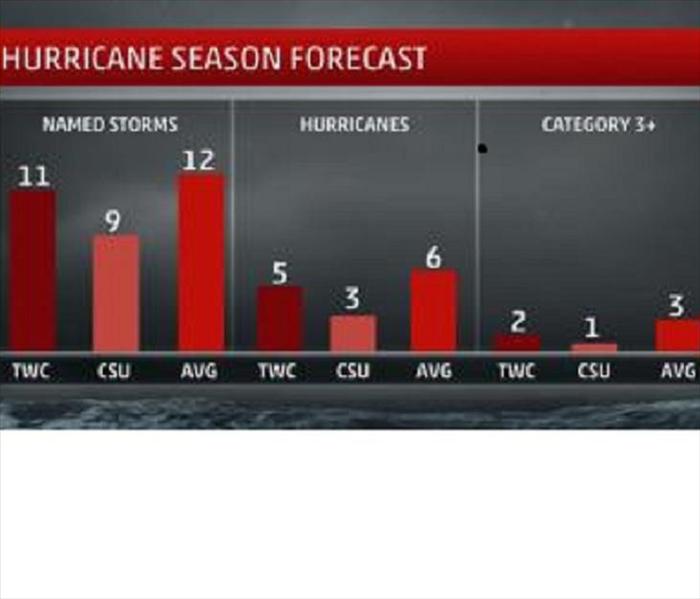 2014 hurricane season forecasts from The Weather Channel (TWC) and Colorado State University (CSU) compared to average (AVG).
2014 hurricane season forecasts from The Weather Channel (TWC) and Colorado State University (CSU) compared to average (AVG).
The 2014 hurricane season is expected to have a below average number of named storms and hurricanes, according to Dr. Phillip J. Klotzbach and Dr. William Gray of Colorado State University (CSU).
In its annual preseason forecast released Thursday, the team expects a total of nine named storms, three hurricanes and one major hurricane (Category 3 or higher) in the Atlantic Ocean basin. This forecast is below the long-term average of 12 named storms, six hurricanes and three major hurricanes each season.
The forecast from CSU calls for fewer named storms and hurricanes than the forecast released by The Weather Channel about two weeks ago. That forecast called for 11 named storms, five hurricanes and two major hurricanes, which is slightly below the long-term averages.
These forecasts cannot predict the details of any potential landfalls. Therefore, residents of the coastal United States should prepare each year no matter the forecast.
Remodeling Your Home? Have You Considered Indoor Air Quality?
4/10/2014 (Permalink)
Too much moisture in a home can lead to mold, mildew, and other biological growth. This in turn can lead to a variety of health effects ranging from more common allergic reactions, to asthma attacks, and hypersensitivity pneumonitis, for example. Excess moisture can be in the form of high relative humidity including humidity generated by people and their activities such as showers, cooking, or drying clothes. Water can also come from plumbing leaks, wet boots, or splashing around sinks. Moisture can travel with infiltrating outdoor air (or exfiltrating indoor air) through the building shell, including the foundation. In addition to health problems, high relative humidity or water that enters building cavities that is not allowed to dry quickly can lead to problems such as rot, structural damage, and premature paint failure.
Methods to control moisture include building an energy-efficient home with proper air-sealing, proper use of vapor barriers and vapor diffusion strategies. The entire building envelope, from the foundation to the roof, should be designed to not only prevent moisture entry, but also to allow any moisture which does enter a means to escape. As mentioned above, people and their activities in a home are big sources of moisture; thus proper ventilation is also important in order to maintain indoor humidity levels within an acceptable range.
Moisture Control Techniques
1. Manage water outside the foundation walls.
The ground around the home's foundation should be graded to slope down and away from the house at a rate of 1/2" to 1" per linear foot to drain surface water away from the house. Water from down spouts should be directed away from the house, discharging at least a few feet from the foundation. Test any underground drains with a hose to make sure they are working properly. Drains that are not working should be repaired or replaced with an elbow discharge described above. Be sure that driveways, sidewalks, and patios slope down and away from foundation walls at 1/4" per linear foot. In extreme cases, you may have to dig out around the foundation and replace the fill with an exterior drain tile and with a good draining material such a clean gravel. Because this can be very expensive in existing homes, you should get a few opinions as to whether this is necessary. In some areas, there may not be enough room outside the dwelling to provide proper drainage - in these cases, it is often recommended that interior drain tile and a sump pump be installed to remove water from basements and crawlspaces. This also can be very expensive.
2. Manage water inside the foundation walls and in the basement or crawl space floor.
If the basement or crawl space has a dirt floor, cover it with 6 mil poly, overlapping edges by at least 12 inches. Seal any cracks or joints in the foundation wall or slab with an elastomeric caulk.
3. Use construction techniques to control water, air movement, vapor diffusion, and condensation. Use construction methods and materials which promote the drying of building assemblies.
Use construction techniques which reduce the likelihood that warm, moist air will come in contact with cold surfaces, leading to condensation, mold growth, and rot. This includes controlling air movement and using vapor barriers on the warm side of walls and roofs. Proper flashing and drainage techniques should be used to keep rainwater out. There are different strategies to achieve this, and the strategies vary widely depending on the climate.
4. Roofs.
It is important that the roof and flashing details and construction effectively keep water out of the house. It is also important that the roof and attic design addresses the issue of moisture in the form of water vapor to avoid condensation in building cavities. There is no single strategy which will work for all houses in all climate conditions. The important considerations are preventing movement of moisture from the warm side to the cold side of the building envelope, and managing moisture which does pass through the envelope to prevent condensation on building materials.
5. Ensure the home is properly ventilated, with at least exhaust fans in the bathroom and kitchen and preferably a mechanical ventilation system designed to ventilate the entire house.
High relative humidity (RH) can lead to problems with mold, dust mites, and other biological pollutants. Using exhaust fans in the bathrooms and kitchen can remove much of the moisture that builds up from everyday activities and help to keep RH below 50%. There are exhaust fans on the market that produce little noise, an important consideration for some people. Another benefit to using kitchen and bathroom exhaust fans is that they can also exhaust odors and pollutants from these rooms. These fans can be part of an active ventilation system for the entire house, and help to reduce humidity levels. Vent bathroom, kitchen, and clothes dryer/laundry room exhausts directly to the outside, not into an attic or other enclosed space.
6. Size Air-Conditioning Equipment correctly.
More is not always better. Incorrectly sized equipment can lead to operational and cost problems. Oversized air conditioning systems can "short-cycle" leading to rapid cooling without reducing indoor humidity levels. This can lead to a variety of problems associated with high relative humidity. Heat gain and heat loss should be determined for each house.
Correct refrigerant charge (not under- or over-charged) and proper maintenance are also necessary for optimum performance of air conditioners.
7. Low Relative Humidity.
Below 30 percent relative humidity, people can be uncomfortable and can suffer from dry mucus membranes which can lead to nosebleeds and infections. In general, low relative humidity is only a problem during the winter months, when the outside air contains very little moisture. It is this dry outside air entering the home through cracks and openings in the building shell that causes the inside air to become dry. The greater the amount of outside air which leaks into the house, the dryer the indoor air becomes. By air-sealing and using energy-efficient construction, uncontrolled air leakage is greatly reduced, a more controlled indoor environment is created, and moisture can be maintained at acceptable levels without the use of a humidifier. Humidifiers require maintenance to avoid becoming breeding grounds for biological contaminants.
Can Severe Weather Ever Be Avoided?
4/7/2014 (Permalink)
(Reprinted in part from AccuWeather.com)
Severe weather can be both fear-inducing and awe-inspiring. The threat to lives and property that occurs during a severe weather event can create panic that lasts well after an event is over, even for people who did not live through the event themselves. People may cope with these fears by trying to find a way to take control of the situation, be it by preparing for an emergency weather event, living in an area where their most-feared weather threat is less likely, or for some, finding a cause of blame when tragedy does strike.
Many times after a dangerous weather event occurs, some will be quick to blame the victims for not doing more to prepare, or even for choosing to live in an area where such events are likely to occur. However, with the United States' widely diverse geography and large population, is there really anywhere a person can live where they can expect to completely stay out of harm's way?
In the 3,794,101 square miles that make up the United States there are over 313.9 million people. To try to live in areas with no severe weather risks is impossible. Even areas that are less likely to see a certain extreme may not be immune. Earthquakes have hit Maryland. New Hampshire has had tornadoes. Snow has fallen in Georgia. Yet when a natural disaster strikes it is common to see comments blaming the victims for "choosing" to live in a location, as if they could have known for sure, as if the decision for where one lives can be entirely determined by an individual, independent of economic factors. Career paths need to be taken into account. With unemployment rates at 7.5 percent with many industries facing higher layoffs than others, not everyone has the option to decline a good job in their field because they are concerned about the weather in an area. Nor is it easy or affordable for people to up and move from a location they may have been born and raised by no choice of their own. So why might people claim to withhold any sympathy from natural disaster victims on the grounds that "it's what they get for living there"?
According to Dr. Rich Carlson, associate head professor of Psychology at the Pennsylvania State University, this may be partly contributed to Fundamental Attribution Error. It is a coping mechanism people may default to when they are afraid.
"People can look at what happens to themselves and know all the factors that lead to it," he said. "But they don't know some details for what may have impacted other people. They end up looking at another's situation and filter it through their own experiences instead and judge accordingly."
Essentially, it is a way for people to comfort themselves when they consider situations they may be afraid of. If they can say that there was a human fault that caused someone to be a victim, than they may be able to justify away their fears by assuring themselves that they won't be a victim because they did not or would make that decision. In the example of living in a severe weather location, the "decision" is to live in that particular area.
Similarly, Carlson explains how the Just World View may explain this mentality.
"People may protect themselves by trying to feel in control," he said.
For those thinking through the lens of the Just World View, in order to feel in control, they believe that the world needs to be just, that things happen for a reason and not at random. If tragedies happen at random than they cannot be controlled, and that thought is frightening to many people. In a Just World View, people may try to justify bad things by convincing themselves that victims had brought it on themselves, so that they may then "play by the rules" and stay safe from a similar occurrence. Carlson stated that people with more fear towards a specific event may be more likely to look for a human error to blame when the event happens. A person who finds tornadoes to be the most frightening kind of weather, for example, may be more likely to say that a tornado victim had it coming for living in central Oklahoma.
Sometimes it is the unknown elements of these types of weather that factor into the level of fear a person may have. Residents of North Carolina may scoff at panicked Northerners facing a potential hurricane, because Carolinians are used to hurricanes and are generally prepared to handle them. The idea of a giant blizzard may make them more uneasy, instead, because they do not have the same level of experience with them. It may seem scarier to think of an earthquake for someone who lives in Tornado Alley, because they may not be aware of the architecture codes that help keep buildings and people safe.
Tragedies happen. With the vast, varied landscape of the U.S., there are many different natural disasters that can affect the people who live here. A person may choose not to live near the coast to avoid hurricanes, but they may put them at a greater risk of tornadoes. People may live in mountains to avoid tornadoes, but it increases their risks for snowstorms or mudslides. Unprecedented snow or rain levels can cause houses near streams or rivers to have flooding that they have never seen before, but it may not be feasible for homeowners to relocate as a precaution. With over three million people living in the U.S., the few areas that may be statistically safer cannot possibly fit everyone. Even then, weather cannot be controlled, and areas that are less likely to be faced with a specific type of weather event may still experience one.
People will likely continue to try and find fault in others when a catastrophe occurs, but that only accomplishes a sense of safety for themselves that may often be unrealistic. To actually feel in control of a weather situation, people should have emergency plans for if a disaster does occur. They can also visit certified and reputable organizations such as the Red Cross to donate to those in need following a natural disaster.
Do you need to keep the tissues close?
4/3/2014 (Permalink)
Winter thaw means it’s time to deal with another beast of weather’s burden: spring allergies. As the temperatures begin to rise and plants begin to blossom, they bring with them the all-too familiar sound of sneezes and sniffles.
Approximately 40 million Americans suffer from seasonal allergies and see a surge of symptoms in spring. “Allergy and asthma patients already have a chronic sensitivity to things like pollen, mold and other airborne allergens, but they can also be more susceptible to rapid changes in temperature and moisture,” Dr. Clifford Bassett, an ambassador for the Asthma and Allergy Foundation of America, said in a statement. “A blending of the winter and spring means these patients are at risk of multiple symptoms simultaneously.”
According to experts, this allergy season will be particularly harsh thanks to the brutal winter weather that preceded it. ”What we’re seeing is the snow cover is starting to melt in surrounding areas, and what that does, that puts mold spores into the air,” Dr. William Reisacher of NewYork-Presbyterian/Weill Cornell Medical Center told NY1. “And many people who are sensitive to mold, and even not sensitive to mold, react when mold spores are high.”
It was March misery in frigid Northern, Eastern USA
4/2/2014 (Permalink)
 Temperature Departures for March 2014
Temperature Departures for March 2014
(Reprinted from USA TODAY )
What spring?
Many parts of the northern and eastern USA took a serious chill pill in March, and several places probably will record one of their 10 coldest Marches.
"Several cities in the Upper Midwest, Great Lakes and northern New England are flirting with a top 10 coldest March," says Weather Channel meteorologist Chris Dolce. "It's a huge turnaround from two years ago in March 2012, when many of these same cities saw their warmest March on record."
Dolce reports that Burlington, Vt., and Caribou, Maine, are seeing their coldest March since weather records began. (Burlington's weather records began in 1884 and Caribou's in 1939, according to the National Weather Service.)
Despite what happens in the final days of the month, both cities are likely to see top 10 coldest Marches.
Other cities that have been unusually frigid in March include Green Bay, Wis. (fourth coldest), Buffalo (fourth), Detroit (sixth) and Chicago (eighth). Most of those cities should remain in the top 10 regardless of temperatures this weekend.
Nationally, according to data from the National Climatic Data Center, 2,071 record low temperatures have been set this month, compared with 242 record high temperatures.
March also has been snowier than average in several locations, including Northern Virginia's Dulles International Airport, which recorded its snowiest winter since records began in 1963. Detroit has seen more than a foot of snow in March, almost double the average.
While the central and eastern USA has been shivering, cities in the Southwest are enjoying an unusually warm month, the weather service reports. Tucson is having its sixth-warmest March (records date to 1895), and Las Vegas is having its seventh warmest (data date to 1937).
March continued a season-long pattern — the frigid central and eastern USA and the mild West. The reason: a persistent ridge of high pressure over the western half of the USA balanced by a trough of low pressure in the East.
"This winter, there was a big blocking ridge of high pressure in the western U.S., all the way up into Canada, and that redirected the flow of the jet stream and allowed that very cold air to come down into the Midwest and Northeast," Weather Channel meteorologist Carl Parker says.
High pressure usually brings clear skies; low pressure brings clouds and precipitation.
Some good news about the chilly March has been the lack of severe storms, including tornadoes. Through the first three weeks of the month, the USA saw four tornadoes, one of the lowest marks on record.
Get Your Pancakes While You Can!
3/28/2014 (Permalink)
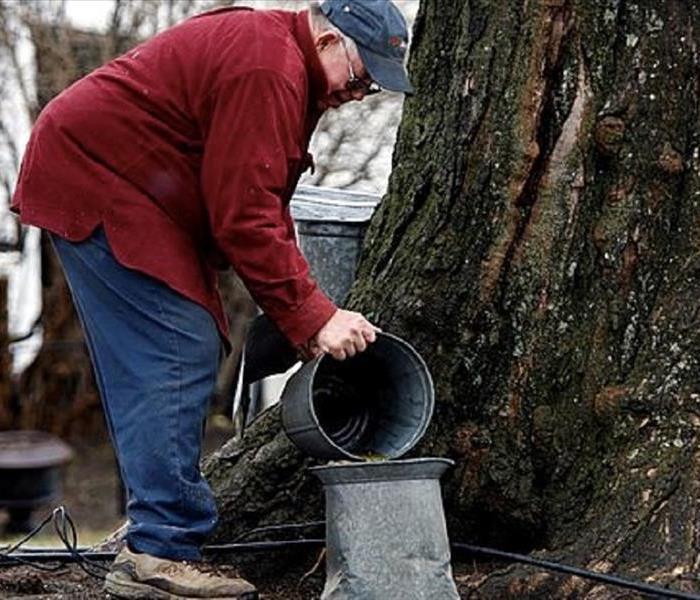 Buckets filled with sap are emptied by 4th generation maple syrup farmer, Ed Jillson in Sabbatus, Maine, at his maple syrup farm.
Buckets filled with sap are emptied by 4th generation maple syrup farmer, Ed Jillson in Sabbatus, Maine, at his maple syrup farm.
Persistent cold postpones maple syrup production in US
Copyright AccuWeather.com
Following one of the coldest winters in decades, the lingering impacts of this year's harsh winter are taking their toll on the maple syrup industry, as Mother Nature has showed no mercy in the month of March for many of the nation's top-producing states.
As the top maple syrup producer for the United States, last year Vermont made more than 1 million gallons of syrup, nearly 40 percent of the total U.S. production, according to the U.S. Department of Agriculture, or USDA.
Last year proved to be an ideal year for the industry, as all states showed an increase in production from 2011. However, this year's cold weather pattern across much of the Midwest and Northeast has halted the start of the tapping period, as a result delaying the start of the sugar season.
Before the start of the sugar season, typically spanning sometime between January and early May, the maple trees must be tapped. "Tapping is done prior to the sugar season which occurs whenever the nights are freezing and the days are thawing in the spring," Owner of Morse Farm Maple Sugarworks in Montpelier, Vt., Burr Morse said. "The optimal weather is nights in the mid-20s, the days in the mid-40s and wind from the west or north."
While nights have been freezing across the prominent maple syrup-producing states, the daytime highs have been problematic since it has been unusually cold. So far this March, temperature departures spanning from Minneapolis to Burlington have all been at least 4 degrees below normal. In Burlington, Vt., departures have been over 9 F colder.
"We normally would be making maple syrup sometime between the beginning of late February or the 10th of March, but it's just been too cold," Co-Owner of the family-owned Sugarbush Farm in Woodstock, Vt., Betsy Luce said.
Other major maple syrup-producing states, including Wisconsin and New York, are also experiencing challenges due to lingering wintry weather.
The outcome of the late cold is the delay in sap flow from the maple trees, and because it takes approximately 40 gallons of sap to make one gallon of pure maple syrup, some farmers are raising concerns not necessarily about the cold but instead the unusual snow pack. "The snow is still packed tight around the trees, normally you need to have it melt a little, so we need to get some warmth to get going," Luce said.
With snow still on the ground, and historically the majority of maple syrup produced in April, farmers can only wait for milder weather. However, the threat of a rapid spring warmup presents yet another worry.
"What we don't want to see is a quick transition from these below-average temperatures to above-average temperatures," Executive Director of the Vermont Maple Sugar Makers' Association Matthew Gordon said. A sudden warmup could cause the maple trees to bud and this will end the sugaring process. "We are somewhat dependent on the weather ahead," Gordon said.
On the other hand, if the weather cooperates with gradual warming during the day and freezing nights, maple syrup producers could experience another year of ample crop.
Scientist Predicted Washington Hillside Failure in 1999
3/27/2014 (Permalink)
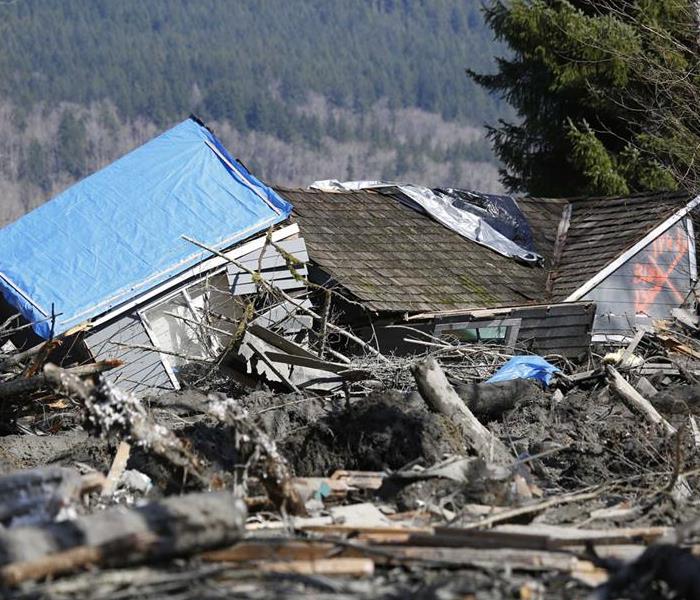 Oso, Washington - March 23, 2014
Oso, Washington - March 23, 2014
A scientist who documented the landslide conditions on a Washington hill that buckled last weekend in a massive mudslide warned in a 1999 report filed with the U.S. Army Corps of Engineers of “the potential for a large catastrophic failure.”
The Seattle Times reports that report was written by Daniel J. Miller and his wife, Lynne Rodgers Miller. Daniel Miller told the newspaper, “We’ve known it would happen at some point.”
Daniel Miller studies land formations and their changes. He also documented the hill’s landslide conditions in a 1997 report for the Washington Department of Ecology and the Tulalip Tribes.
He says he returned to the Snohomish County hill in 2006 within weeks of a landslide that plugged the north fork of the Stillaguamish River and was startled to see new homes being built.
Snohomish County Executive John Lovick and Public Works Director Steve Thomsen said Monday night they were not aware of the 1999 report. Thomsen says a slide of this magnitude is “very difficult to predict.”
Copyright 2014 Associated Press. All rights reserved
Spring Nor'easter: One more storm wallop for East before spring kicks in
3/24/2014 (Permalink)
Copyright © 2014 Heather Tooley
A spring Nor'easter is expected to wallop several states with cold temperatures and falling snow. NBC New York reports March 24 that fall will begin falling Tuesday night. Coastal areas along the Atlantic will see a lot more snow than tri-state areas on Wednesday.
New York City and suburbs located north and west will see snowfall up to an inch while sections of Long Island and Jersey shore could get two inches. Frigid cold and strong winds will also accompany snowfall.
The spring Nor'easter is expected to be the most extreme over the Atlantic Ocean as the storm moves through. By Friday temperatures should rise, hitting the high upper 50s.
As the report, emphasized, since December 2013, 57.4 inches of snow have covered Central Park. It's the city's seventh snowiest winter on record.
A spring Nor'easter is the last thing anyone wants this time of year. The first day of spring was last Thursday and cold temperatures and heavy snowfall is still coming in. Everyone hopes this is the last and final winter cold blast!
SERVPRO of Great Neck Port Washington provides Annual Spring Home Maintenance Tips
3/20/2014 (Permalink)
Home Maintenance Tips provided by State Farm Insurance
Once spring has sprung, take some time to give your home a check-up along with its annual spring-cleaning. Adding these home maintenance tips to your routine can help your house operate more efficiently:
The Water Heater
Look around the base of your water heater for evidence of leaks. The average lifespan of a water heater is 8-12 years. If your water heater is over 5 years old, it should be checked monthly for any leakage or rusting at the bottom. If water leakage or rust is found, the water heater should be replaced. If you live in an area with particularly hard water, you may need to drain your water heater because of the sediment buildup in the tank.
The Basement and Attic
Does your attic or basement smell musty? If you have an attic, check it for leaks from the roof. Inspect the underside of the roof and the insulation closely for any discoloration, deterioration or dirt stains, as the leaking water might have dried up.
Check the basement walls, floor, and trim for water stains or any signs of seepage through the foundation. There are a number of flooding causes; read more about wet basements for preparation. While you’re down there, keep a close eye on your sump pump, making sure it is still in good working order, and has a battery backup in place if necessary.
Wet Basements
Unexpected water in your basement can damage walls and floors, destroy carpeting, ruin furniture and lead – pretty quickly – to mold. And perhaps the most upsetting of all: As basements are so often used for storage, water downstairs can ruin irreplaceable items like photo albums, antiques, and family heirlooms. When you experience a flooded basement for the first time, it’s imperative to determine if the water problems are going to reoccur or if it was a one-time event. Can you safely leave your property downstairs once you’ve got the mess cleaned up? Or does everything need to come upstairs immediately? What’s certain is that if water in your basement is a consistent problem, it’s time to start making decisions. Determining where the water is coming from is essential to solving this problem. What Happened? Beyond observable flooding around your home and in your neighborhood, there are several common sources of water entering basements:
- Surface water running down foundation walls Groundwater in water-saturated soils being pushed into the basement by hydrostatic pressure
- Storm sewer water from the municipal storm sewer system backing up into the home's existing perimeter foundation drain and leaking into the basement
- Sanitary sewer water from a clog in your home’s sewer line, the municipal sewer line, or the combined municipal storm/sanitary sewer system backing up into the home's drain system, causing sewer water to come up through sink drains and floor drains on lower levels
Each source has its own particularities and requires its own course of action. Find out more about your home’s drainage system by consulting a contractor or plumber.
Surface Water
If this is the first instance of water problems in your basement, the first thing to check for is surface water draining down next to the foundations. Water coming in at one location or only at the exterior foundation wall indicates surface water problems. Here are some things to look for once you get outside:
Overflowing Gutters: Leaves
Keeping gutters clean of debris should be a part of every homeowner's routine maintenance program. Depending on the surrounding trees, gutter cleaning may be required a few times a year. Products are also available to prevent leaves from getting into the gutters in the first place.
Overflowing Gutters: Downspouts
You can do a self-check (your gutters must be cleaned out first). After at least 15 minutes of heavy rain, check your gutters. Any water overflowing out of the gutters is running down next to the house foundations. Even if the water is not getting into the basement, it could be eroding soil from under the house footings, which can lead to cracking of walls and ceilings. The easiest solutions to overflowing gutters are to either add another downspout on that run of gutter or to increase the size of the downspout. The best solution between these two is probably adding another downspout; the second downspout can act as a backup if the other gets blocked.
Downspout Distance
Downspouts should extend 10 feet from your home. While many homeowners do not like downspouts extending out this far, 10 feet is the minimum distance needed to discharge water coming off your roof far enough away from the house.
Pavement Slope
Sometimes paving settles over time and water flow can change direction toward the house. If this is the case, the paving should be removed and replaced so it slopes away from the home.
Sealant
Sealant around pavement that abuts the house sometimes cracks over time due to age or incorrect installation. If the sealant is cracked, it must be removed and replaced with new sealant.
Landscape Slope
Does your yard or the land around your home slope away from your home? It should. Look for any depressions in the ground next to the home foundation walls. If any are found, fill in with dirt so the water drains away from the house. Use a clay-type soil that sheds water instead of sandy soil that allows water to soak into the ground.
Irrigation
Avoid placing lawn irrigation next to the house. Make sure the irrigation system includes a working rain gauge so the system does not turn on when there has already been plenty of rain for the plants and lawn.
Controlling Subsurface Groundwater
When the groundwater levels outside the basement rise above the level of the floor, the basement acts like a boat in a pond. If a boat is sitting in water, water will leak in through any open cracks or holes. It works the same way with a basement. Hydrostatic pressure can push water through hairline cracks. Symptoms of this are water coming up through cracks in the basement concrete floor or water coming in at multiple locations. If you have an older house within town and the house has a basement with no sump pump, it is likely the perimeter foundation drain system connects directly into the city storm sewer system. If the level of the basement is below the street level, there is the potential of storm water backing up in the city storm sewer system and being pushed into the perimeter foundation drain system. This can saturate the soils around the house at the basement level with storm water under hydrostatic pressure, causing water to leak in.
Storm Water Backing Up Into Your Home
In many older houses with basements (mostly pre-1980), there is a perimeter foundation drain outside the exterior wall, at the level of the basement floor, next to the footings at the time the house was built. A pipe was usually installed from the perimeter foundation drain to the street where it was connected to the city storm sewer system. This can become a problem as the city storm sewer system becomes too small when more development causes more rain runoff. When this happens, the rainwater in the sewer system can get so high that water flows backwards toward the house. If you believe you have this problem, contact an experienced contractor for advice.
Sanitary Sewer Water Backing Up Into Your Home
During heavy rains, combined sewer systems can become overwhelmed with water. This can cause sewer water to back up in the system and sometimes into homes. Sewer backups can be caused by individual service lines being plugged by grease, waste, tree roots, breaks in pipes or saturated ground. Sewer mains can also be plugged by vandalism or large items dropped down manholes. In order to keep your individual lines clear, you can install backflow preventers that help stop sewer water from flowing backward into the house. Proper maintenance of your individual lines – for example, pouring tree root killer down your toilets once a year – can also go a long way in preventing sewage backups.
SERVPRO of Great Neck Port Washington Welcomes Spring!
3/17/2014 (Permalink)
 New York State Blue Bird
New York State Blue Bird
Spring 2014 begins with the vernal equinox on Thursday, March 20, bringing increasing daylight, warming temperatures, and the rebirth of flora and fauna.
The word equinox is derived from the Latin words meaning “equal night.” Days and nights are approximately equal everywhere and the Sun rises and sets due east and west. At the equinoxes, the tilt of Earth relative to the Sun is zero, which means that Earth’s axis neither points toward nor away from the Sun.
Spring is also the time when worms begin to emerge from the earth, ladybugs land on screen doors, green buds appear, birds chirp, and flowers begin to bloom. The vernal, or spring, equinox signals the beginning of nature’s renewal in the Northern Hemisphere.
Enjoy your day!
Forecasters expect El Nino ocean warming this year, may provide relief for US weather woes
3/14/2014 (Permalink)
(Associated Press reprint, originally published March 06, 2014)
WASHINGTON – Relief may be on the way for a weather-weary United States with the predicted warming of the central Pacific Ocean brewing this year that will likely change weather worldwide. But it won't be for the better everywhere.
The warming, called an El Nino, is expected to lead to fewer Atlantic hurricanes and more rain next winter for drought-stricken California and southern states, and even a milder winter for the nation's frigid northern tier next year, meteorologists say.
While it could be good news to lessen the southwestern U.S. drought and shrink heating bills next winter in the far north, "worldwide it can be quite a different story," said North Carolina State University atmospheric sciences professor Ken Kunkel. "Some areas benefit. Some don't."
Globally, it can mean an even hotter year coming up and billions of dollars in losses for food crops.
The National Oceanic Atmospheric and Administration issued an official El Nino watch Thursday. An El Nino is a warming of the central Pacific once every few years, from a combination of wind and waves in the tropics. It shakes up climate around the world, changing rain and temperature patterns.
Mike Halpert, acting director of NOAA's Climate Prediction Center, says the El Nino warming should develop by this summer, but that there are no guarantees. Although early signs are appearing already a few hundred feet below the ocean surface, meteorologists say an El Nino started to brew in 2012 and then shut down suddenly and unexpectedly.
The flip side of El Nino is called a La Nina, which has a general cooling effect. It has been much more frequent than El Ninos lately, with five La Ninas and two small-to-moderate El Ninos in the past nine years. The last big El Nino was 1997-1998. Neither has appeared since mid-2012. El Ninos are usually strongest from December to April.
Kevin Trenberth, a senior scientist at the National Center for Atmospheric Research, who wasn't part of NOAA's forecast, agreed that an El Nino is brewing.
"This could be a substantial event and I think we're due," Trenberth said. "And I think it could have major consequences."
Halpert said it is too early to say how strong this El Nino will be. The last four have been weak or moderate and those have fewer effects on weather.
Scientific studies have tied El Ninos to farming and fishing problems and to upticks in insect-born disease, such as malaria. Commodity traders even track El Nino cycles. A study by Texas A&M University economics professor Bruce McCarl found the last big El Nino of 1997-1998 cost about $3 billion in agricultural damage.
Trenberth said this El Nino may even push the globe out of a decade-long slowdown in temperature increase, "so suddenly global warming kicks into a whole new level."
Kunkel said if this El Nino is a strong one, global temperatures, probably in 2015, could "be in near record breaking territory."
Halpert, however, says El Ninos can be beneficial, and that the one being forecast is "a perfect case."
After years of dryness and low reservoirs, an El Nino's wet weather would be welcome in places like California, Halpert said.
"If they get too much rain, I think they'd rather have that situation rather than another year of drought," Halpert said. "Sometimes you have to pick your poison."
Australia and South Africa should be dry while parts of South America become dry and parts become wet in an El Nino. Peru suffers the most, getting floods and poorer fishing.
The climate event got the name El Nino, meaning the boy in Spanish, when it was first noticed off the coast of Peru and Ecuador around Christmas time and was named after Christ child, according to Trenberth.
House Passes Homeowner Flood Insurance Affordability Act
3/10/2014 (Permalink)
Targeted News Service
WASHINGTON, March 4 -- Rep. Tom Marino, R-Pa. (10th CD), has issued the following news release:
Today, the U.S. House of Representatives passed H.R. 3370, the Homeowner Flood Insurance Affordability Act, sponsored by Representative Michael Grimm (NY-11). U.S. Representative Tom Marino (PA-10) is one of 237 cosponsors and voted in favor of the legislation, which passed with strong, bipartisan support.
"Millions of Americans are facing dramatically increased flood insurance premiums through no fault of their own, and many low and middle class families are facing foreclosure," Marino said.
"While not perfect, the Homeowner Flood Insurance Affordability Act offers families and storefront owners considerable and immediate relief by repealing the most problematic provisions of Biggert-Waters that have resulted in these dramatically increased premiums, and enacting an alternative that ensures rates are both reasonable and reflective of actuarial risk."
"I am a cosponsor of this legislation not because it is a silver bullet, but because it is a step in the right direction. This bill is a solution for many policyholders in Pennsylvania's10th Congressional District," Marino added.
Specifically, H.R. 3370 repeals certain premium rate increases, restores grandfathered rates, and establishes annual rate increases and surcharges to ensure homeowners are paying rates reflective of what was disclosed at the time they purchased their property. It aims to reach market-based rates; however, it also institutes caps so the jump from prior rates and market rates is a slow, gradual one.
Additionally, the bill requires the Federal Emergency Management Agency (FEMA) to conduct an affordability study and issue a report within two years of the bill's enactment. The report will look at various factors to determine how property owners can maintain affordability if premiums continue to increase and must offer options for enhanced mitigation assistance and means-tested assistance.
"We - Congress - enacted the law that unintentionally resulted in this devastating burden. Now, it is our responsibility to fix it," Marino said.
Marino, who has been leading efforts to repeal the Biggert-Waters Flood Insurance Reform Act of 2012, hosted multiple townhall meetings for affected constituents in recent months and has maintained open lines of communication with key stakeholders, including county officials, insurance agencies, realtors associations, small business owners, and community leaders.
How to Save Before a Big Storm
3/7/2014 (Permalink)
(Reprinted from US News)
By Laura Harder
Remember the tale of the ant and the grasshopper from Aesop's Fables? The wise ant stored up food during the warmer months in preparation for winter, while the lazy grasshopper would only sing in the summer and found himself starving and begging for food come winter. Although the predictable change of seasons may not cause you personally to break the bank -- unless it's the holiday season -- unexpected and severe weather emergencies can quickly leave you in a financial rut.
This week happens to be National Severe Weather Preparedness Week. Although severe winter storms and extreme cold may be what readily comes to mind near the end of a long winter, other hazardous weather such as thunderstorms, lightning, floods, hurricanes, tornadoes, extreme heat and drought are also included.
The National Oceanic and Atmospheric Administration and Federal Emergency Management Agency stress the importance of preparing for severe weather before it strikes. As a frugal shopper, the same strategy applies. Since controlling the weather isn't possible, focus on what you can control: your preparation and finances.
Here are some simple tips to help you save money:
1. Look into tax-free incentives.
Find out if your state has any tax-free holidays for emergency supplies and equipment.
States such as Alabama, Louisiana, and Virginia have severe weather, hurricane or emergency preparedness tax-free weekends. Visit your state's tax department website to see if there are any tax incentives offered in your area, as well as eligible items, which may include portable generators, batteries, cell phone batteries, fire extinguishers, flashlights, duct tape, first aid kits and more. Be aware that qualifying items vary by state and there may be price limits in place.
2. Stockpile non-perishables.
Be sure to stock up your pantry with non-perishables by taking advantage of coupons and store promotions. Make sure you buy enough extra items to avoid the need to buy that item at full price before the next sale comes around. Using this strategy can help you gradually grow your emergency stockpile.
3. Save on water.
Don't want to spend an arm and a leg on bottled water? Simply drink tap water. Studies have shown that tap water may actually have more health benefits than bottled water, contrary to public opinion. To store tap water in preparation for an emergency, use plastic juice containers after cleaning them.
If you still prefer to buy bottled water at the store, wait for sales and promotions on the big name brands and use manufacturer coupons. A different strategy is to simply go for the generic, store-brand water, which can save you a bundle compared to the expensive name-brand at full price. Be sure to compare the unit price among the different water products and packaging. You'll typically save more by buying a gallon of water than a pack of bottled waters.
4. Beat the mad dash to the store.
Be sure to hit the grocery store before the masses. Once you catch wind about even the possibility of severe weather in the news, I recommend getting to the store quickly to grab any supplies that you direly need. You'll have more selection and a better chance of purchasing the least expensive option or brand before the shelves are bare. Do this as early as possible. If you find yourself without much lead time, only go out to the store if you have adequate time and there is not an immediate threat. In other words, don't drive out in the middle of a bad storm or leave your house during a tornado to grab a loaf of bread.
5. Build an emergency kit.
Instead of buying an expensive, pre-assembled emergency kit, create your own by shopping for supplies you'd need in the event of a disaster. At the top of your list is water, at least one gallon of water per person per day, for both drinking and sanitation, as well as a minimum three-day supply of non-perishable food, including canned goods and shelf stable foods.
Make sure you have a flashlight, extra batteries, a first aid kit, moist towelettes, garbage bags, battery-powered or a hand crank radio and other essential items your family will need in the case of an emergency. You can find a complete list of recommended supplies that should be included in a basic disaster supplies kit on ready.gov.
As one of my friends likes to say, "Proper planning prevents poor performance." This applies so well to emergencies and severe weather. To summarize: Have a plan, be the "ant" that stores up for the winter and unexpected storms and save money along the way.
SERVPRO of Great Neck Port Washington asks: It's National Severe Weather Preparedness Week. Are you ready for an emergency?
3/7/2014 (Permalink)
(Reprinted)
By Emily Clark, Safety Editor BLR
March 2-8, 2014, is National Severe Weather Preparedness Week, and OSHA has teamed up with the National Oceanic and Atmospheric Administration (NOAA) to address the hazards that severe weather poses for workers and employees. Is your company prepared for a weather emergency? Keep reading to find out.
To minimize the danger to workers, OSHA and NOAA encourage employers to take the following steps:
•Stay aware of weather forecasts.
•Train workers on workplace severe weather plans.
•Keep emergency supplies, including a battery-operated weather radio, on hand.
•Ensure that workers involved in response and recovery are protected from potential safety and health hazards.
According to NOAA, in 2013, there were seven weather and climate disaster events, resulting in 109 deaths and causing losses exceeding $1 billion per event across the United States. In May 2013 alone, 267 tornadoes occurred across 25 states, including the EF5 tornado that struck Moore, Oklahoma, and caused an estimated $2 billion in property damage.
6 essential emergency preparedness tips
1. Develop an emergency plan and communicate it to your employees. It should include escape procedures and escape route assignments, special procedures for employees who perform or shut down critical plant operations, systems to communicate with and account for all employees after evacuation, rescue and medical duties for employees who perform them, and means for reporting emergencies.
Note that many OSHA standards require employers to develop written emergency action plans (EAPs). If your business is affected by one of these requirements, this article gives you eight tips to help you get started.
2. Designate an emergency response coordinator and a backup coordinator who will be responsible for determining what emergencies may occur and seeking that emergency procedures are developed to address each situation, directing all emergency activities, ensuring that outside emergency services are notified when necessary, and directing the shutdown of company operations when necessary.
3. Form an emergency response team with members who will be trained to use fire extinguishers, administer first aid, follow OSHA’s bloodborne pathogens standard, shut down company operations, control chemical spills, perform search and emergency rescue procedures, and respond to emergencies involving hazardous materials, depending on the specifics of your company’s operations.
4. Keep a copy of important records and files at an off-site, secure location in case original copies are damaged or destroyed. Online cloud storage services may be a good option for some businesses, as these services should not be affected by local weather conditions in your area.
5. Have a disaster supply kit with food, water, and other essentials at your company’s facilities for situations where employees must shelter in place either because travel is unsafe or because they are responsible for maintaining critical operations during an emergency closure. The Federal Emergency Management Administration (FEMA) has a list of what to include in a disaster supply kit at http://ow.ly/ueLF5.
6. Train employees on the details of your emergency plan, including evacuation procedures, alarm systems, shutdown procedures, reporting procedures for personnel, and types of potential emergencies. Also make sure to train employees on any hazards specific to your facility, such as toxic chemicals, fire hazards, and any equipment that may become hazardous in the event of a power failure or other emergency.
Additional information on Severe Weather Preparedness Week is available from OSHA at http://ow.ly/ueIEP and NOAA at http://ow.ly/ueIyp.
For more information on emergency preparedness, see BLR’s Disaster Planning and Response resource center.
Tips to Help Remove an Ice Dam from your Roof (provided by Travelers Insurance)
3/3/2014 (Permalink)
An ice dam has the potential to cause serious damage to both your roof and the inside of your home. It is important to take steps to help protect your home from the risks associated with ice dams.
What is an ice dam?
An ice dam can form when water from melting snow re-freezes at the edge of your roofline. Without roof snow removal, the ice dam may grow large enough to prevent water from draining off the roof. The water can then back up underneath the roof shingles and make its way inside your home.
Immediate steps you can take:
Remove snow from your roof after every storm. Use a roof rake to clear the first three to four feet of snow from your roof immediately after each winter storm to prevent ice dams from forming. While the amount of snow and ice that your roof can handle may vary depending on a number of factors such as the roof type, age and condition of the structure, a good rule of thumb is if there is more than a foot of heavy, wet snow and ice on your roof, you should try to have it removed.
Clear downspouts. An easy way to help snow and ice drain off your roof is to make sure the area around your downspouts is clear. This will make it possible for your gutters to drain when snow does melt. It will also help prevent flooding when the snow and ice melts.
Longer-term prevention:
Ultimately, the best prevention for ice dams is to eliminate the conditions that make it possible for them to form in the first place.
Insulate your attic. Make sure your attic is well insulated to help prevent the melting-and-freezing cycle that causes ice dams to form. Check and seal places where warm air could leak from your house to the attic, including vent pipes, exhaust fans, chimneys, attic hatches and light fixtures.
Install a water-repellant membrane. When replacing a roof, make sure to install a water membrane underneath the shingles. This acts as an extra barrier that helps prevent water from seeping inside the building.
Removing ice dams
Just because an ice dam is present does not necessarily mean water has penetrated the roof membrane. However, it is always best to remove ice dams before they have the opportunity to cause damage. To determine if you have damage, look for water stains or moisture in the attic or around the tops of exterior walls on the top floor.
If you can reach the roof safely, try to knock the ice dam off with a roof rake, or cut a channel through the ice to allow standing water to drain.
If you cannot reach the roof safely, consider hiring a contractor to remove it.
Another method is to fill a nylon stocking with calcium chloride ice melt and place it vertically across the ice dam so that it melts a channel through the dam. If you try this method, make sure you can safely position the ice melt on your roof, and make sure to use calcium chloride, not rock salt. Rock salt will damage your roof. Also be aware that shrubbery and plantings near the gutter or downspout may be damaged.
Look carefully at large icicles. If the icicles are confined to the gutters and there is no water trapped behind them, this does not indicate the presence of an ice dam. However, large icicles can pose a danger to people when they fall off. Try to safely knock the icicles off from the ground, making sure not to stand directly beneath them. If you cannot reach them safely from the ground, consider hiring a contractor to help.
Generally speaking, property owners are responsible for the cost of preventive maintenance. However, each claim is unique, and coverage and claim decisions always require an expert analysis by a licensed Claim professional. Keep in mind that the cost of snow removal is likely to be considerably less than the cost of roof damage or interior property damage caused by water leaks.
SERVPRO of Great Neck Port Washington presents Commercial Client Checklist for Weathering Winter
3/3/2014 (Permalink)
The thaw may be on in some areas, but winter isn't over yet. Prepare yourself with this checklist.
By BOB KHOSROPUR
Note: Bob Khosropur is senior vice president of Mariposa Insurance Services
The polar vortex is an anomalous weather event that can be as devastating as more common natural catastrophes. The Insurance Services Office (ISO) is assigning catastrophe numbers to these events, and the events themselves are causing billions of dollars in commercial property damage. Even if we don’t give the cold a name or a number, cold snaps can bring businesses to their knees.
This year has started out with some exceptionally cold weather, especially in southern states which are not accustomed to prolonged winter weather conditions. The concept of “reasonable care” included in many insurance policies to prevent damage from cold weather has traditionally been interpreted differently in, for example, Florida versus Minnesota. But this year’s extreme conditions are making the meaning have a more equal definition for the whole mainland.
Commercial property comes in many sizes and shapes, with one common feature: they exist to turn a profit. When the property cannot fully function due to a loss, the cares of repair and downtime begin to become the owners’/managers’ new job.
Commercial property ranges from large offices or manufacturing facilities to small duplex rental properties. Whatever the type or size, some of the most commonly experienced damage from severe and sustained cold, snow and ice arises from:
• Freezing and bursting pipes, resulting in water damage to property, records, etc.
•Frozen sprinkler pipes, which can flood rooms and malfunction during a fire
• Inaccessible fire hydrants
• Water or temperature change damaging contents and inventory
• Collapse or partial collapse of roofs due to the weight of snow or ice
• Wind damage to roofs and buildings from fallen trees, branches or flying debris
•Ice damming, which can cause interior water damage
• Loss of revenue (business interruption)
• Injury to guests and employees.
A little preventative action can save your commercial property clients much time and money.
Useful tips to share with your clients to help prevent problems related to harsh winter weather.
• Maintain heat to no less than 45 degrees Fahrenheit throughout unoccupied facilities, including attics and basements. Setting thermometers in various rooms will give you an idea of problem areas which may require additional heat or insulation
• Ensure adequate fuel for your heating system (oil, gas, electric power, backup).
• Sign up for inexpensive systems that alert you via text messaging when the building’s temperature has dropped below a set value. This can help you take immediate action to protect the property, e.g. repair a breach in the building, utilize emergency generators, etc.
•Conduct an annual fall inspection of the shell of your building to ensure there are no gaps letting in the weather.
•Understand how your sprinkler system works and take precautions to drain it, if applicable (dry-pipe style). For wet-pipe systems, ensure that the room heat is adequate, or use heat tape to ensure their warmth.
• Drain the water from all systems and equipment that is not needed in the winter, such as air conditioning units.
•Inspect your roof every year before winter and ensure that it is well sealed, and sheds/drains water properly; gutter and downspout maintenance is a must.
• Remove any branches or trees that can come into contact with the building when heavily laden with ice and snow. Consider having experts remove heavy snow accumulation from your roof(s) as needed to reduce the chance of collapse.
In the event of a loss:
•Contact your agent as soon as possible and explain any emergency action you have taken, or need to take to prevent further damage to the property. They can assist with their knowledge of emergency mitigation vendors.
•Learn how your deductible works early on in the process, especially if you have multiple properties under a single policy.
• Be thorough with the adjuster in showing all the damage and provide documents pertaining to any business interruption claim you may make.
• Keep all receipts and invoices for any emergency or temporary repairs made, and provide this information to the adjuster. Keep records of work you or your staff have done to protect the property from further damage.
• Understand that a "Reservation of Rights," "Non-Waiver Agreement" and "Proof of Loss" are legal documents issued by your carrier, which are necessary to protect your rights and benefits every bit as much as they protect the carrier’s.
SERVPRO® Joins PGA TOUR Official Marketing Partner Program
2/28/2014 (Permalink)

PONTE VEDRA BEACH, Fla. (February 17, 2014) – The PGA TOUR and SERVPRO®, a national leader in property cleanup and restoration, have announced a new four-year official marketing relationship.
By joining the TOUR’s Official Marketing Partner program, SERVPRO receives the designation as “Official Cleanup and Restoration Company of the PGA TOUR and Champions Tour.” SERVPRO will have the opportunity to have a brand presence at tournaments on both Tours and promote its official affiliation using the PGA TOUR and Champions Tour logos.
Based in Gallatin, Tenn., SERVPRO specializes in fire and water cleanup and restoration services, helping both commercial and residential customers recover from property damage emergencies.
“We take great pride in the quality of our sponsors, and SERVPRO is not only recognized as the brand leader in its own industry, but also one of the top franchises in the country,” said Jay Monahan, PGA TOUR Chief Marketing Officer. “We are extremely pleased to announce our new marketing relationship with SERVPRO and look forward to working together to maximize its sponsorship with the PGA TOUR and Champions Tour.”
SERVPRO recently was listed among the Top 10 of Entrepreneur magazine’s Franchise 500 rankings for the fifth consecutive year. Of the 853 companies qualified for the rankings, SERVPRO earned the No. 7 spot overall for 2014 and No. 1 in the cleaning and restoration industry for the 11th consecutive year.
“Our customers and our Franchisees love golf so we are thrilled to be a PGA TOUR Marketing Partner. The PGA TOUR partnership is a perfect way to expand our brand awareness and thank our clients for allowing SERVPRO to help make it ‘Like it never even happened,’” said Sue Steen, CEO of Servpro Industries, Inc.
About SERVPRO
Founded in 1967, the SERVPRO Franchise System is a national leader and provider of fire and water cleanup and restoration services and mold mitigation and remediation. SERVPRO’s professional services network of more than 1,600 individually owned and operated Franchises responds to property damage emergencies ranging from small individual disasters to multi-million dollar large-loss events. Providing coverage in the United States and Canada, the SERVPRO System has established relationships with major insurance companies and commercial clients, as well as individual homeowners. For more information, visit www.servpro.com.
About PGA TOUR
The PGA TOUR is the world’s premier membership organization for touring professional golfers, co-sanctioning more than 130 tournaments on the PGA TOUR, Champions Tour, Web.com Tour, NEC Series-PGA TOUR Latinoamérica, PGA TOUR Canada and PGA TOUR China. The PGA TOUR’s mission is to entertain and inspire its fans, deliver substantial value to its partners, create outlets for volunteers to give back, generate significant charitable and economic impact in the communities in which it plays, and provide financial opportunities for TOUR players. Worldwide, PGA TOUR tournaments are broadcast to more than 1 billion households in 225 countries and territories in 32 languages. Virtually all tournaments are organized as non-profit organizations in order to maximize charitable giving. In 2013, tournaments across all Tours generated more than $133 million for local and national charitable organizations and in early 2014 the TOUR’s all-time charitable contributions surpassed $2 billion.
The PGA TOUR's web site is PGATOUR.COM, the No. 1 site in golf, and the organization is headquartered in Ponte Vedra Beach, FL.
SERVPRO® EARNS FIFTH CONSECUTIVE YEAR ON ENTREPRENEUR'S TOP TEN FRANCHISE LIST
2/28/2014 (Permalink)
Cleanup and restoration franchisor locks in #7 position on prestigious annual ranking
Roslyn Heights, NY- Entrepreneur magazine recently announced its annual Franchise 500 rankings, naming SERVPRO®, a cleanup and restoration franchise company, to its Top 10 list for the fifth consecutive year. Of the 853 companies qualified for the rankings, SERVPRO® earned the No. 7 spot overall and the top spot in its own industry for the 11th consecutive year. According to Entrepreneur, the Franchise 500 selection processis driven by “objective, quantifiable measures of a franchise operation,” with some of the most important factors being “financial strength and stability, growth rate and size of the system.”
“It's an honor and a privilege to be a part of the SERVPRO® Brand in the Great Neck/Port Washington area,” said Daniel Wallace, owner of “SERVPRO® of Great Neck/Port Washington. “As a leading cleaning and restoration Brand in America, we have a responsibility to serve each and every customer with excellence.”
SERVPRO® specializes in fire and water cleanup and restoration services, helping both commercial and residential customers recover from property damage emergencies. From small one room home disasters, to large commercial facilities, or statewide storm response situations, SERVPRO® helps make property damage ‘Like it never even happened’.
“At the end of the day, every SERVPRO® Franchisee is an individual small business owner who lives and works in the community he or she serves,” said Wallace. “When the unexpected happens, local home and business owners know that they can turn to us to help them put their lives back on track as quickly and painlessly as possible. As this year’s Entrepreneur rankings demonstrate again, this is both a responsibility and a privilege that each SERVPRO® Franchisee takes very seriously.”
For more information about SERVPRO® of Great Neck/Port Washington, please contact (516) 767-9600, servpro9497@optonline.net or visit www.servproofgreatneck.com.
SERVPRO Signs On as National Sponsor for American Red Cross “Ready Rating" Program
2/28/2014 (Permalink)
GALLATIN, Tenn. (Grassroots Newswire) – SERVPRO, a disaster recovery and cleanup Franchise System, has signed on as a national sponsor of the American Red Cross Ready Rating™ program, a free, web-based program designed to help businesses, organizations and schools become better prepared for emergencies.
"This partnership just makes perfect sense," said Rick Isaacson, Executive Vice President of Servpro Industries, Inc., "and truly completes the readiness equation for businesses and other property owners. The Red Cross Ready Rating Program allows individuals to assess their readiness for a disaster, so they can take all necessary steps before disaster strikes to protect their property from damage and loss. But, when disaster does strike, knowing what to do and who to call saves time – and fast response is key to minimizing damage and downtime. That’s where SERVPRO’s Emergency READY Program can help. Together, these two programs offer maximum peace of mind to businesses and other organizations."
"Through the generosity of SERVPRO, the Red Cross will help empower workplaces to re-open more quickly after natural or man-made disasters such as water main breaks, medical emergencies, power outages, tornados, floods and hurricanes through the Ready Rating Program," said Tom Heneghan, manager of Business Continuity Programs for Red Cross.
"Up to 40% of businesses never re-open their doors after such disasters; SERVPRO’s partnership will enable more businesses, schools and organizations to become better prepared. We are excited to have SERVPRO join us in community outreach efforts to educate and highlight the importance of community preparedness in neighborhoods across the country."
With the approaching spring season comes the threat of severe weather – such as high winds, downpours, flash flooding, fires caused by lightning strikes and even tornadoes spawned by thunderstorms. SERVPRO urges all property owners to visit the Red Cross Ready Rating website now at readyrating.org to complete a 123-point self-assessment of their level of preparedness for weather-related or other emergencies. Aligned with the federal government's Private Sector Preparedness standards, the Ready Rating assessment offers businesses, organizations and schools access to tools, tips and best practices to help improve their level of preparedness.
Isaacson says key to the program are the following Five Essential Steps to Preparedness – the cornerstones of the Ready Rating program:
1. Commit to Preparedness
2. Conduct a Hazard Vulnerability Assessment
3. Develop an Emergency Response Plan
4. Implement your Emergency Response Plan
5. Help Your Community Get Prepared
"The time to prepare for a disaster is before it happens," said Isaacson. "Taking steps to make your property as secure as possible, then having a plan to deal with the aftermath if disaster does strike is just good business and common sense. Our SERVPRO disaster cleanup specialists can help you create a disaster recovery plan now, specific to your facility, so that – if you need us – we can help you get back in business fast."
SERVPRO specializes in disaster restoration, cleanup and repair services, helping to remediate damage, making it "Like it never even happened," for both commercial and residential customers. For information on readiness resources including SERVPRO’s free Ready Plan Mobile Application, available on all smartphones, please visit www.SERVPRO.com. For more information about the Ready Plan Mobile Application, visit servpro.com/ready.
For more information on the Red Cross Ready Rating program, please visit readyrating.org.
SERVPRO of Great Neck Port Washington Provides Preventive Planning Tips to Community
2/27/2014 (Permalink)
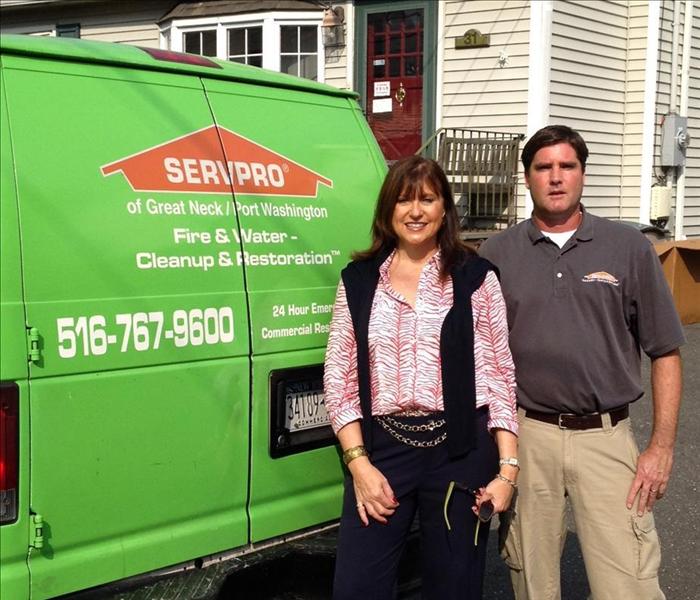 Sandy "veterans": SERVPRO of GNPW Vice President of Marketing Deborah Rashti (l) with Danny Wallace, owner.
Sandy "veterans": SERVPRO of GNPW Vice President of Marketing Deborah Rashti (l) with Danny Wallace, owner.
Below is a reprint of an article which appeared in
The Weekend, November 2013
HURRICANE SANDY: ONE YEAR LATER
Preventative Planning Before Emergencies Arise
By Andy Newman
Deborah Rashti saw far too many instances of extreme devastation, heartbreak and loss caused by Superstorm Sandy last year in her role as vice president for SERVPRO of Great Neck/Port Washington, a company that specializes in storm, flood and disaster restoration, she has several suggestions to help lessen the effects of any future serious weather events.
“Advance planning is key to how you will fare after a disaster,” she said. “Consider taking steps today, before an emergency arises.”
Rashti emphasizes that having a properly assembled “go bag” is prime in importance. “Pick up a blank CD and scan your key documents,” she urged. “Unfortunately today, we’re required to identify who we are, where we live and what we own.”
Help on scanning documents is available, usually at local libraries and insurance offices. She suggested, “You want to scan any document that helps identify who you are, where you live and what you own. Your marriage certificate, your birth certificate, your social security card and any titles to anything that you own whether it’s a car, a motorcycle, a house or a boat are important.”
“Any bank account/checking account numbers and credit card numbers that you have should also be scanned,” she added. “If your house was badly damaged, the Red Cross would come into your community with trucks and these trucks would be equipped with computers that could read that disk. With this information available the Red Cross would then be able to expedite services that they could give you.”
Store the disk in a very safe place. The Servpro executive continued, “Make sure you know where you’re storing it in your house. Store it on a high level in your home. Make extra copies of the disk and put one in a safe deposit box. Remember where you’re storing it because should you need to leave your house immediately, you need to take it with you.” Homeowners should also be sure to seek advice on encrypting the disk’s contents to enhance the security of its information.
There are several suggested lists of essential items to include in a “go bag” and Rashti advises referring to the Red Cross website (www.redcross.org) as a start. “You should have some kind of antibiotic cream packed,” she said, “because you cannot anticipate what kind of hazards you could face outside. You need to have it because the hospitals will be deluged during a crisis and you want to be as independent as possible.
“So you want to have some sort of first aid kit and some heavy gloves, too,” she explained, “because if you need to avoid debris you need to be able to push it away from you without exposing yourself to injury. If you take medication, make plans to have an extra month’s supply on hand. Drugs may not be readily available. As for warm socks and a change of clothing, it doesn’t have to be any special kind. But if you need to go, you need to know that it’s sitting there and waiting.”
Rashti’s own “go bag” contains cans of tuna fish and peanut butter. “Pack food products that are not going to go bad and some water bottles that you can take with you,” she says. “The same thing applies if you have a pet.”
As for her next tip, Rashti said, “I suggested to many people, even before Sandy and Katrina, that you throw a lot of loose change and singles, fives, tens into the bag. You want to be able to go into stores to buy food and, as happened during Sandy, they don’t have a way of making change for you. Some people wound up paying $20.00 for a bagel and coffee because all they had were twenties from the ATM cash machines.
“You really have to think ahead,” she added, switching her focus to long range planning. “You have to have a good relationship with your insurance company or agent. It’s critical. You need a broker who really explains to you what you’re paying for and what that coverage is. I can’t tell you how many people were stunned to find out that they didn’t have coverage that they thought they had. Everyone is usually concerned with paying the least amount for their insurance but when things happen they realize that it’s a very foolish way to look at it.
“Things tend to happen when we’re not home, or at times when there’s no one who can help us,” Rashti cautioned. “It’s always smart to make sure that there’s somebody else (a neighbor, a friend, a relative) who has a key to the house and who definitely checks on the house every once in a while because we get phone calls from neighbors sometimes that there’s a flood in the basement but we can’t get in. As an owner you’re not always going to be at home. The insurance company is not going to cover you if they find that the problem wasn’t taken care of as soon as possible.”
Whether you think our weather patterns are changing for the worse or there just seem to be more and more serious weather events, Rashti agrees that events are frequent. “When you watch the weather station use realize that there’s something going on almost every day,” she pointed out. “Look at the Midwest – tornado alley? This is happening to them all the time. Look at our neighbors in Colorado. Don’t forget what happened with that fertilizer factory in Texas.
“When I joined SERVPRO six years ago we had only 10 branches on Long Island. Now we have 20. We had 1,400 around the country. Now we have 1,600. So you have to question how come a company that only deals in disasters could be growing so fast.”
Despite an increased number of mircobursts, windstorms, hailstorms and tornadoes in this area, Rashti feels that Long Islanders have been relatively lucky. “Until Sandy came along, she said, “we never remember anything like it happening. Some people recall the Level 3 hurricane storm of 1938, but everything east of Glen Cove Road at that time was basically farmland. Any hurricane now that is more than a Level 1 would be horrible, because we are so congested on this island.”
SERVPRO's website (www.servprogreatneckportwashington.com) has an extensive list of tips and suggestions, including advice on what to do to lessen the damage until help arrives.
The Big Freeze: Polar Vortex 2014 takes hold on Long Island
2/25/2014 (Permalink)
 The Polar Vortex 2014 is making this winter one of the costliest in years.
The Polar Vortex 2014 is making this winter one of the costliest in years.
By Deborah Rashti
SERVPRO of Great Neck Port Washington
The Farmer’s Almanac was right on when it predicted that the winter of 2013-2014 would result in “below-normal temperatures and above-normal snowfall.” January has had its share of snow and the bone chilling temperatures that the Polar Vortex brought to our area seem to be staying with us straight into February. The surge in pipe breaks from this deep freeze is making January one of the costliest in years. While taking preventative measures to keep your pipes safe from breaking before winter arrives is always a better idea; there are steps you can still take now that could minimize your exposure to this very real risk.
To start, there are products on the market that could greatly decrease your chances of suffering a pipe break. A water monitor is an excellent investment that shuts down your water main and alerts you to a pipe break on your smart phone. You can be away from home and get the help you need to get this situation under control. This is a must have for snowbirds!
Heat tape insulation is a great way to get supplemental heat to pipes located in unheated areas such as detached garages. There is thermostatically controlled heat tape and heater tape that is plugged into an outlet. The heater tapes work by a built in thermostat. In order to work, the tape must be wrapped between the pipe and the insulation.
Inexpensive foam insulation gives an extra layer of protection to pipes that receive moderate heat such as pipes in crawl spaces with minimal heating. When putting on these insulation sleeves, it is important not to leave gaps that expose the pipe to cold air. These sleeves are available in foam rubber or fiberglass, and plumbing supply stores carry pipe sleeves that feature extra-thick insulation. The added protection is worth the added cost.
Simple things like raising the thermostat during exceptionally cold spells can be a big help when the temperatures plunge. No matter what, never let your thermostat go below 55 degrees. By keeping the thermostat set to the same temperature both during the day and at night, you may incur a higher heating cost, but it will pale in comparison to the repair from a costly pipe burst.
Another simple preventative tip is to keep your cabinets open underneath sinks. This increase in heat flow to plumbing can make all the difference in preventing pipes from freezing. This is a trick that our neighbors well to the North of us have been doing for years. In the event that this plumbing is located on an outer wall, it would also behoove you to have the water running continuously in a trickle to prevent freezing. Again, the cost incurred in this extra water is inconsequential compared to the clean up from a pipe break.
If you are leaving your home for the winter months, consider closing the main water to your home and emptying the water from your pipes by releasing the water from faucets and toilets. This does not take much work to do and it will afford you peace of mind in your absence. Always make sure that a neighbor, family member or friend look in on your property. Owning a home is a big responsibility and it is important to make sure that all is well within your home.
In closing, extreme weather is the pattern that we are in right now. Whether it is from global warming or not, is secondary to taking precautions to protect our pipes from this extreme cold that they are being subjected to. Predictions hold that February will have worse weather than January. If you have not taken preventative measures to protect your pipes from freezing, you still have time. Cleaning up from a pipe break can be extensive and your insurance company will want to know that you did everything you could to minimize your exposure to loss. When it comes right down to it: Your insurance coverage could depend on it.
Developing a Small Business Disaster Recovery Plan
2/24/2014 (Permalink)
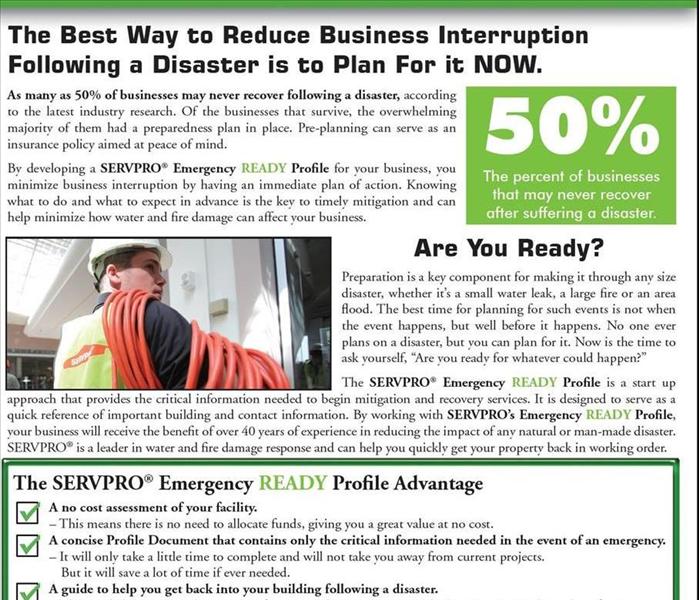 Develop a SERVPRO Emergency Ready Profile Now!
Develop a SERVPRO Emergency Ready Profile Now!
Source: Insurance Information Institute
Businesses that are forced to close down following a disaster run the risk of never being able to open their doors again. While there’s no way to lower the risk of a natural disaster like a hurricane, there are critical measures that can be taken to protect your company’s bottom line from nature’s fury. A disaster plan and adequate insurance are keys to recovery.
Develop a Disaster Recovery Plan
No matter how small or large a business, a business impact analysis should be developed to identify what an operation must do to protect itself in the face of a natural disaster. Large corporations often hire risk managers to handle this task and some companies hire consultants with expertise in disaster planning and recovery to assist them with their plans. But small businesses can do the analysis and planning on their own.
Steps for Developing a Business Recovery Plan
Set up an emergency response plan and train employees how to carry it out. Make sure employees know whom to notify about the disaster and what measures to take to preserve life and limit property losses.Write out each step of the plan and assign responsibilities to employees in clear and simple language. Practice the procedures set out in the emergency response plan with regular, scheduled drills.Compile a list of important phone numbers and addresses. Make sure you can get in touch with key people after the disaster. The list should include local and state emergency management agencies, major clients, contractors, suppliers, realtors, financial institutions, insurance agents and insurance company claim representatives.Decide on a communications strategy to prevent loss of customers. Post notices outside your premises; contact clients by phone, email or regular mail; place a notice in local newspapers.Consider the things you may need initially during the emergency. Do you need a back-up source of power? Do you have a back-up communications system?Human Resources. Protect employees and customers from injury on the premises. Consider the possible impact a disaster will have on your employees’ ability to return to work and how customers can return to your shop or receive goods or services.Physical Resources. Inspect your business’ plant(s) and assess the impact a disaster would have on facilities. Make sure your plans conform to local building code requirements.Business Community. Even if your business escapes a disaster, there is still a risk that it could suffer significant losses due to the inability of suppliers to deliver goods or services or a reduction in customers. Businesses should communicate with their suppliers and markets (especially if they are selling to a business as a supplier) about their disaster preparedness and recovery plans, so that everyone is prepared.Protect Your Building. If you own the structure that houses your business, integrate disaster protection for the building as well as the contents into your plan. Consider the financial impact if your business shuts down as a result of a disaster. What would be the impact for a day, a week or an entire revenue period?Keep Duplicate Records. Back-up computerized data files regularly and store them off-premises. Keep copies of important records and documents in a safe deposit box and make sure they’re up-to-date.Identify critical business activities and the resources needed to support them. If you cannot afford to shut down your operations, even temporarily, determine what you require to run the business at another location.Find alternative facilities, equipment and supplies, and locate qualified contractors. Consider a reciprocity agreement with another business. Try to get an advance commitment from at least one contractor to respond to your needs.Protect computer systems and data. Data storage firms offer offsite backups of computer data that can be updated regularly via high-speed modem or through the Internet.Review Your Insurance Plan
Make sure you have sufficient coverage to pay for the indirect costs of the disaster—the disruption to your business—as well as the cost of repair or rebuilding. Most policies do not cover flood or earthquake damage and you may need to buy separate insurance for these perils. Be sure you understand your policy deductibles and limits.
New additions or improvements should also be reflected in your policy. This includes construction improvement to a property and the addition of new equipment.
For a business, the costs of a disaster can extend beyond the physical damage to the premises, equipment, furniture and other business property. There’s the potential loss of income while the premises are unusable. Your disaster recovery should include a detailed review of your insurance policies to ensure there are no gaps in coverage. Your policy should include business interruption insurance and extra expense insurance. Even if your basic policy covers expenses and loss of net business income, it may not cover income interruptions due to damage that occurs away from your premises, such as to your key customer or supplier or to your utility company. You can generally buy this additional coverage and add it to your existing policy.
Basic Commercial Insurance to Consider
Building Coverage provides coverage up to the insured value of the building if it is destroyed or damaged by wind/hail, or another covered cause of loss. This policy does not cover damage caused by a flood or storm surge nor does it cover losses due to earth movement, such as a landslide or earthquake, unless added by endorsement.Business Personal Property provides coverage for contents and business inventory damaged or destroyed by wind/hail, or another covered cause of loss.Tenants Improvements and Betterments provides coverage for fixtures, alterations, installations, or additions made as part of the building that the insured occupies but does not own, which are acquired and made at the insured's expense.Additional Property Coverage provides for items such as fences, pools or awnings at the insured location. Coverage limits vary by type of additional property.Business Income provides coverage for lost revenue and normal operating expenses if the place of business becomes uninhabitable after a loss during the time repairs are being made.Extra Expense provides coverage for the extra expenses incurred, such as temporary relocation or leasing of business equipment, to avoid or minimize the suspension of operations during the time that repairs are being completed to the normal place of business.Ordinance or Law provides coverage to rebuild or repair the building in compliance with the most recent local building codes.




 24/7 Emergency Service
24/7 Emergency Service























































































































